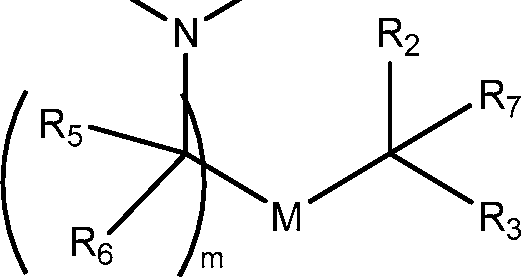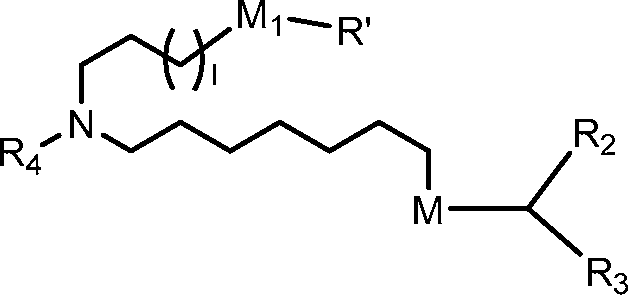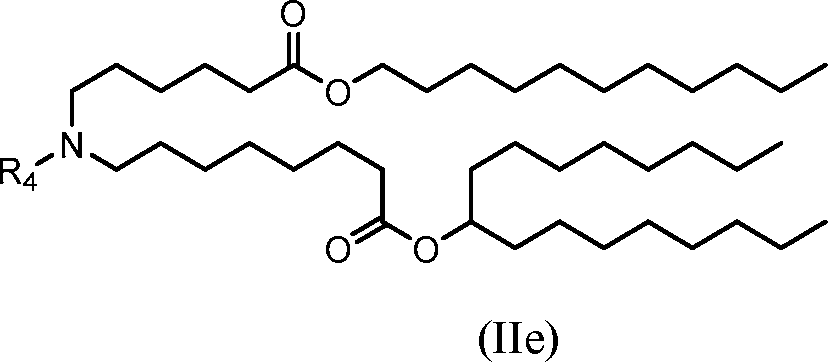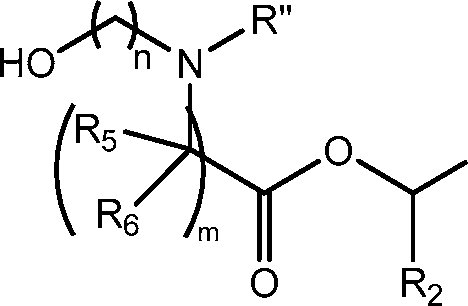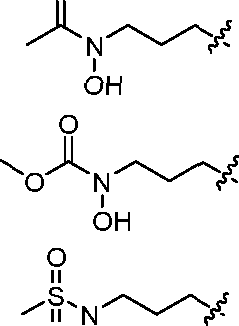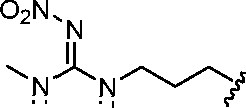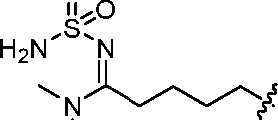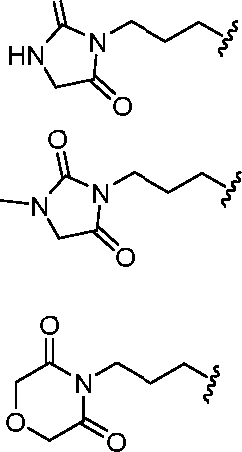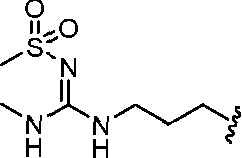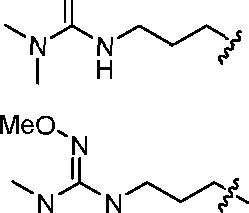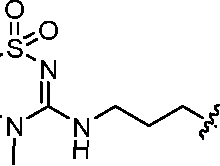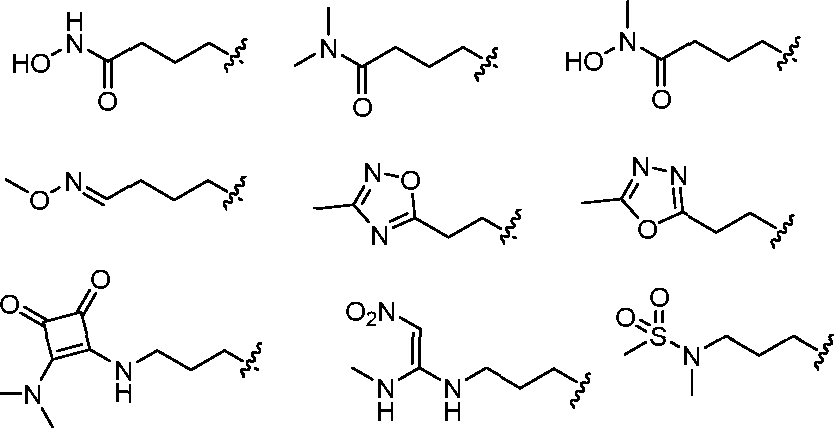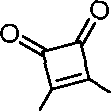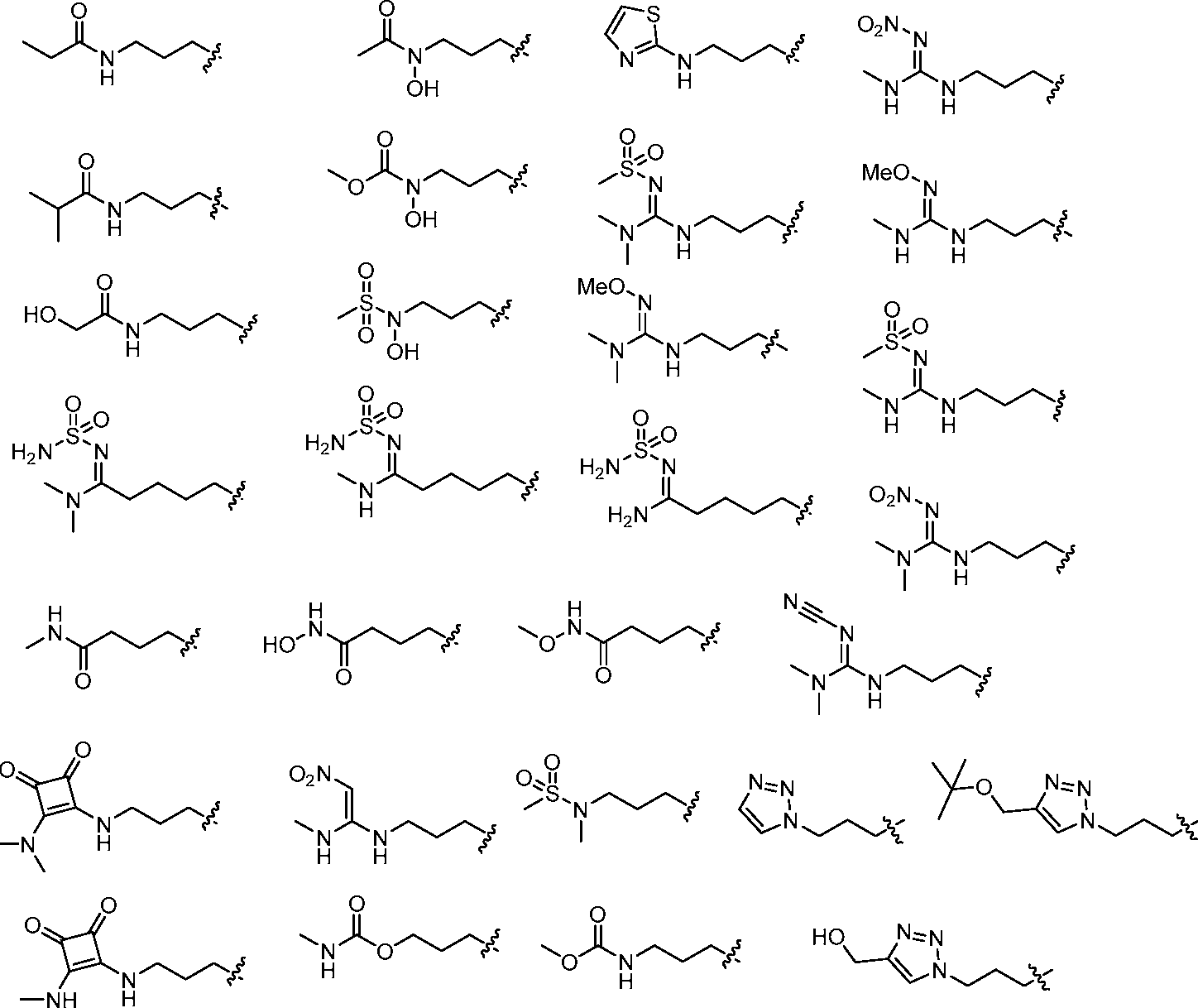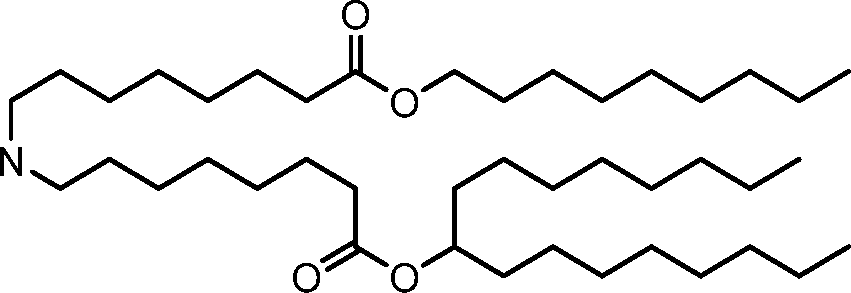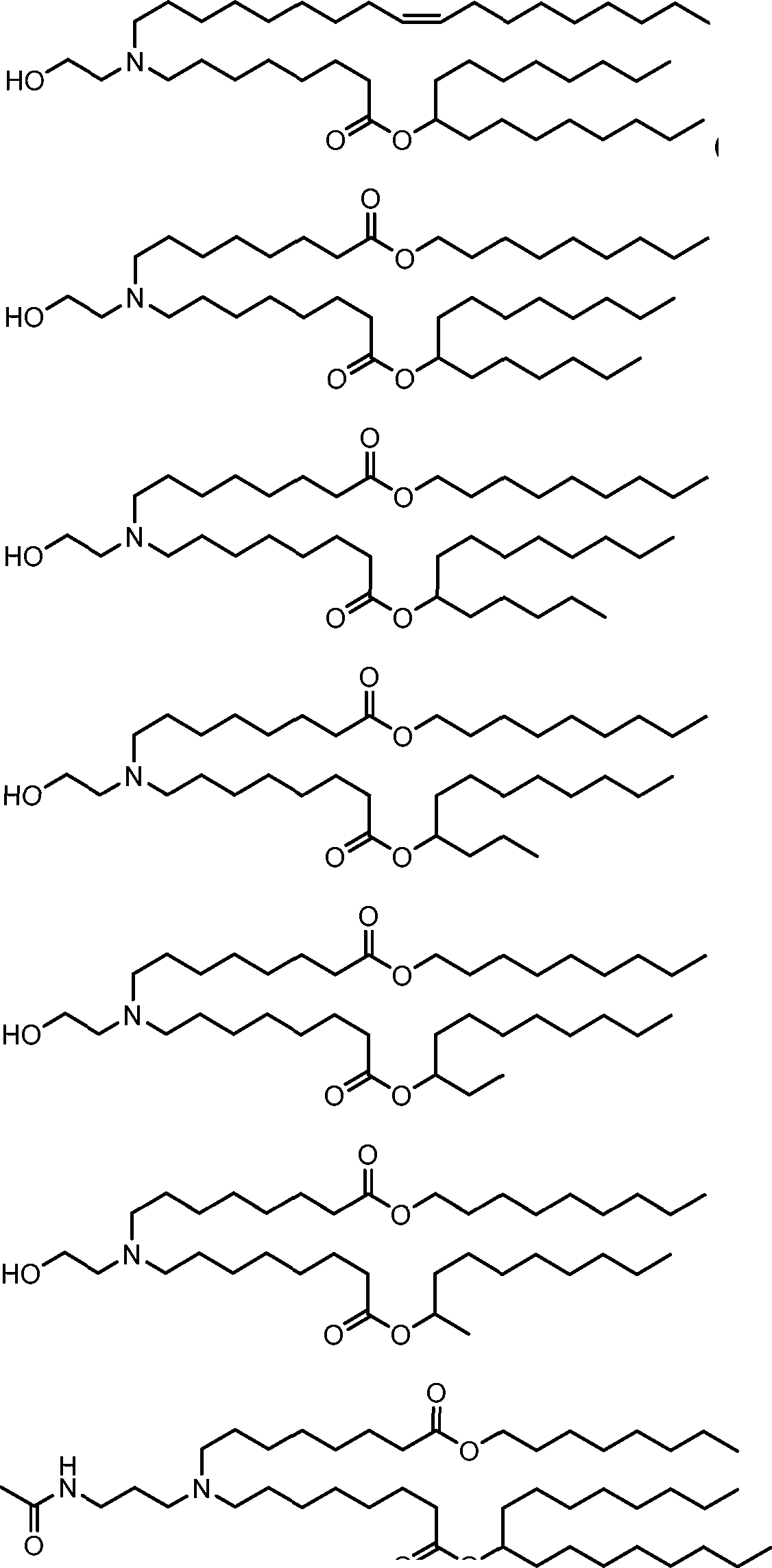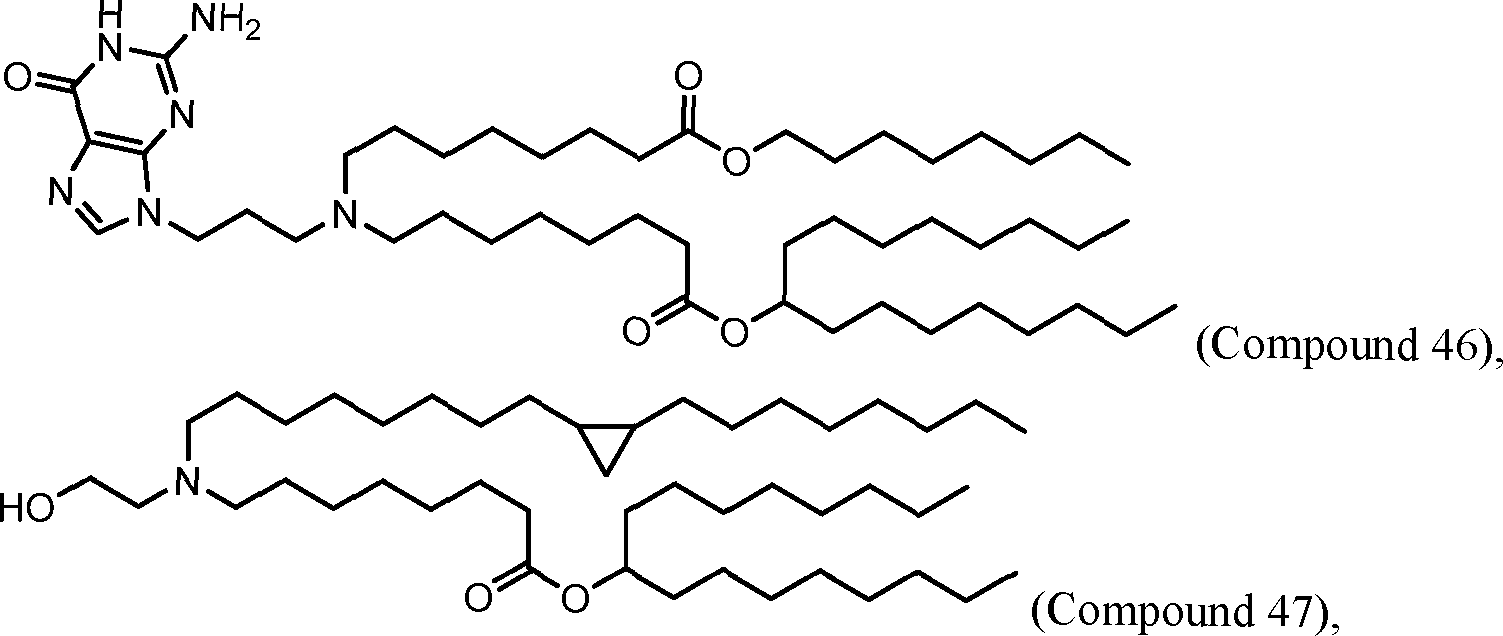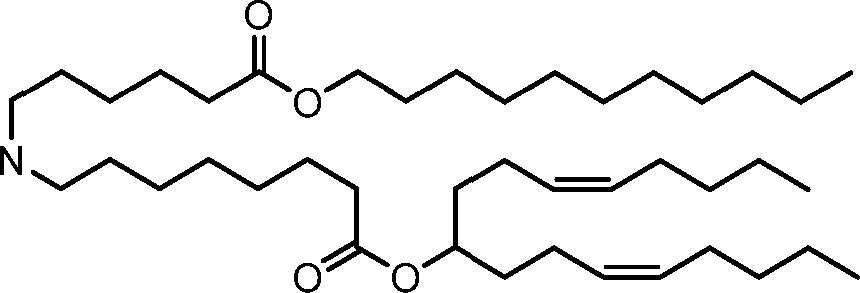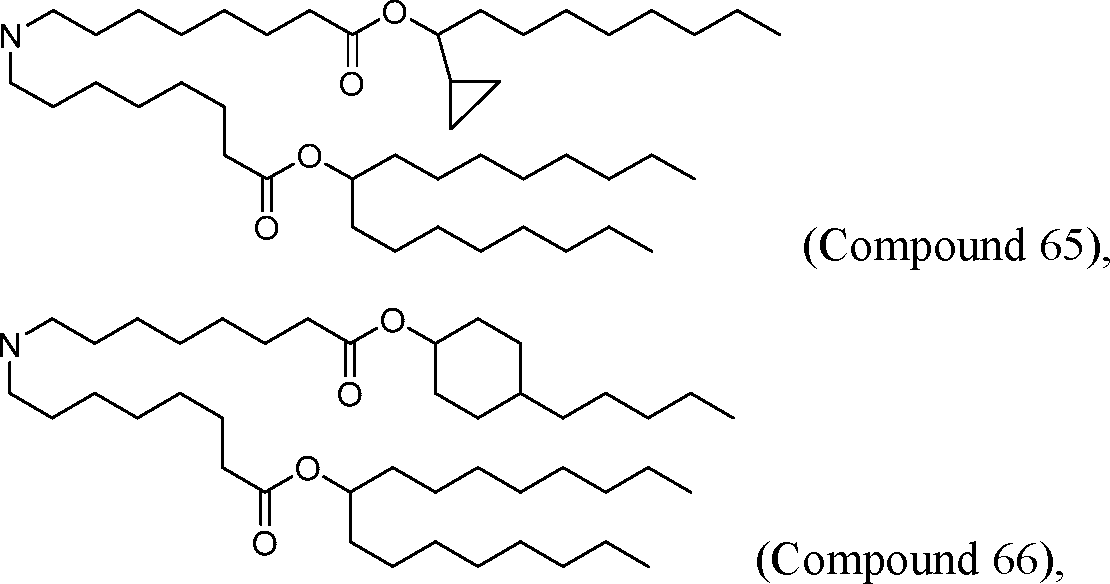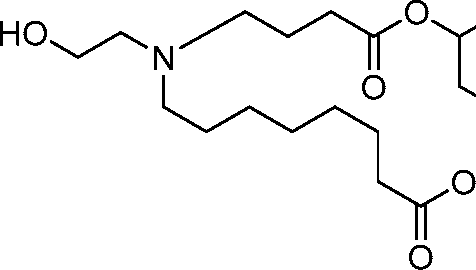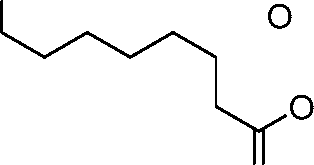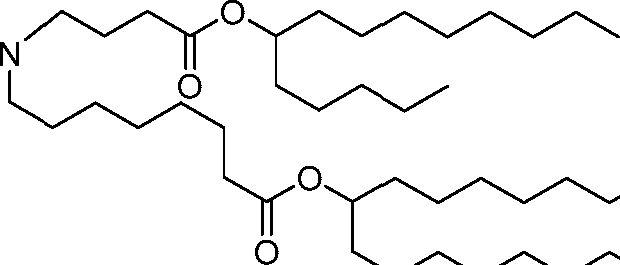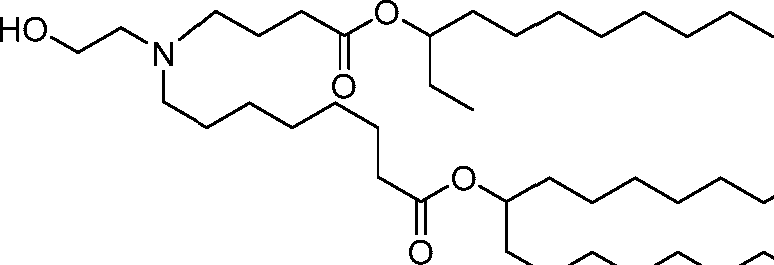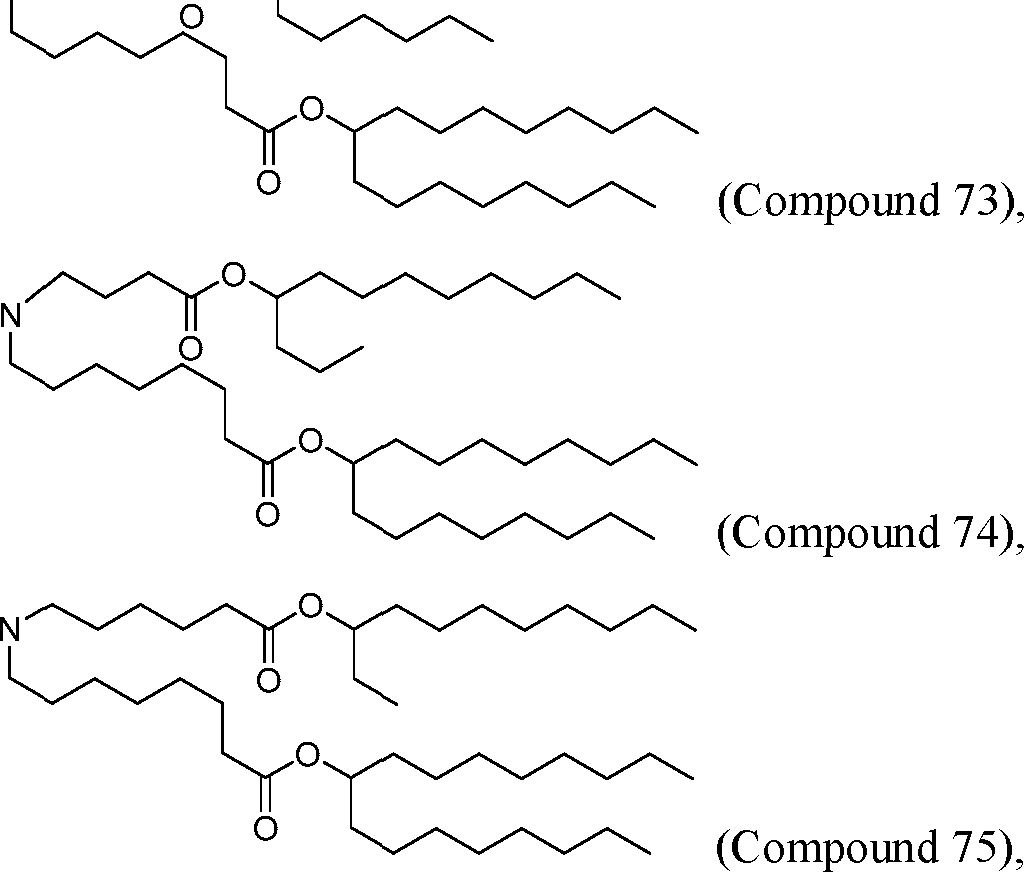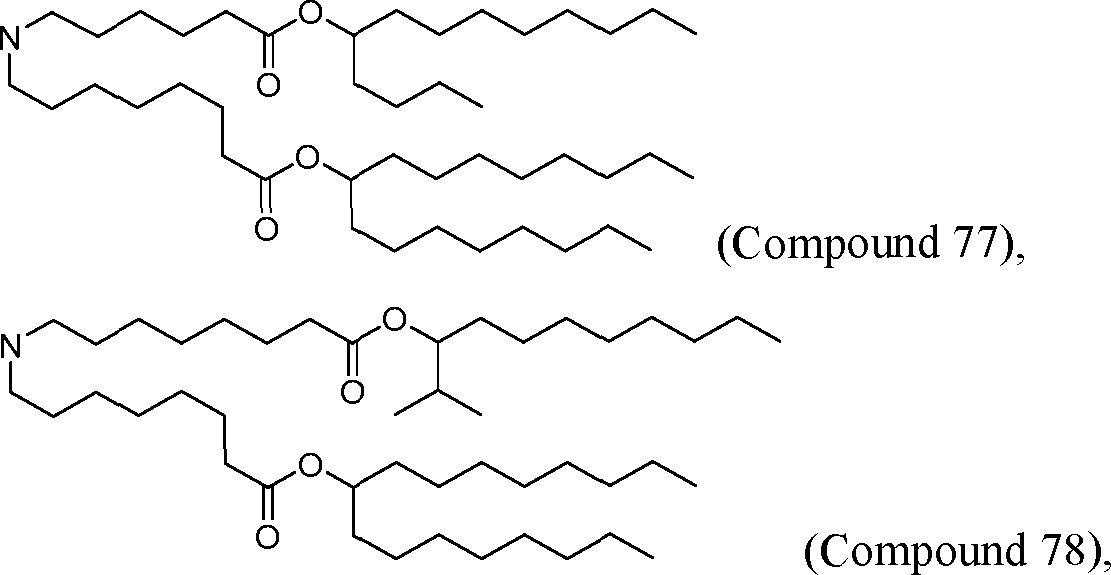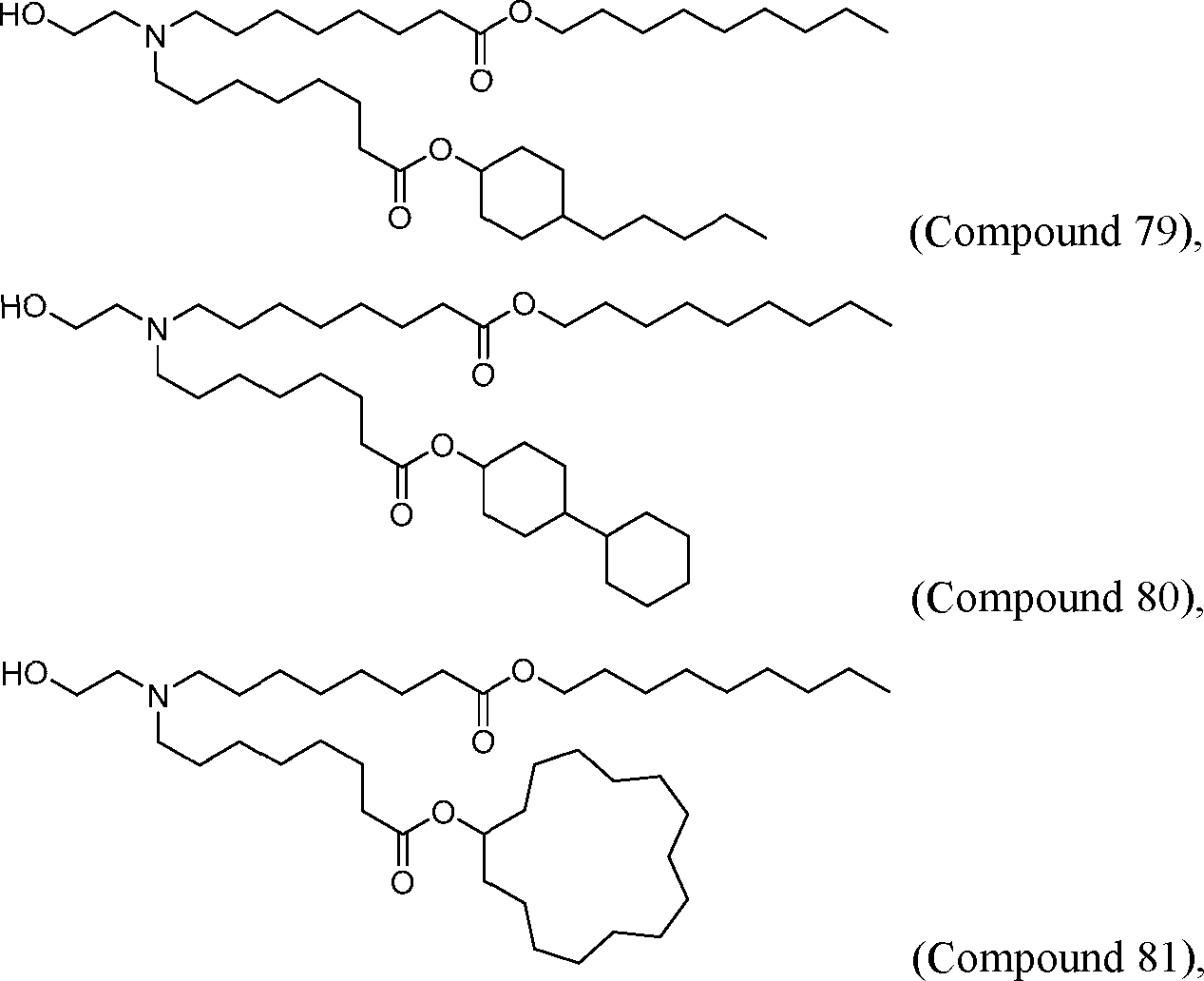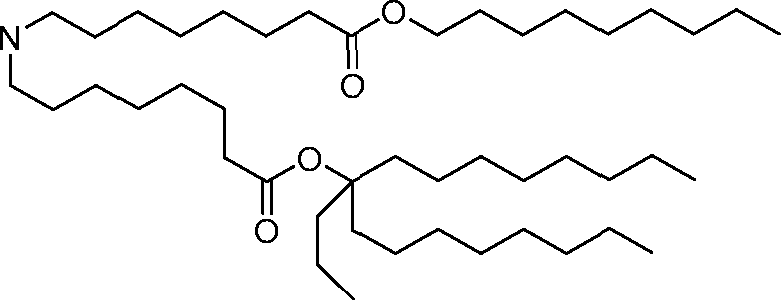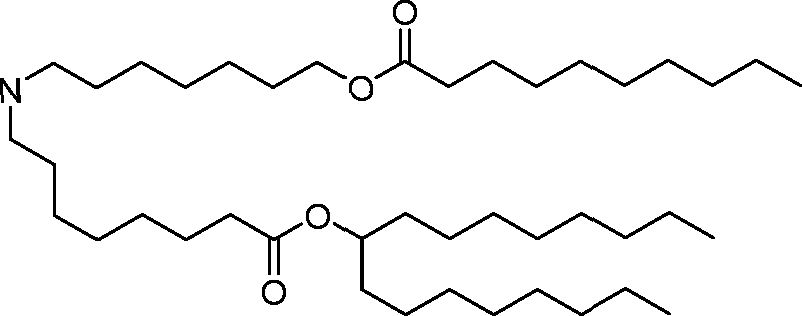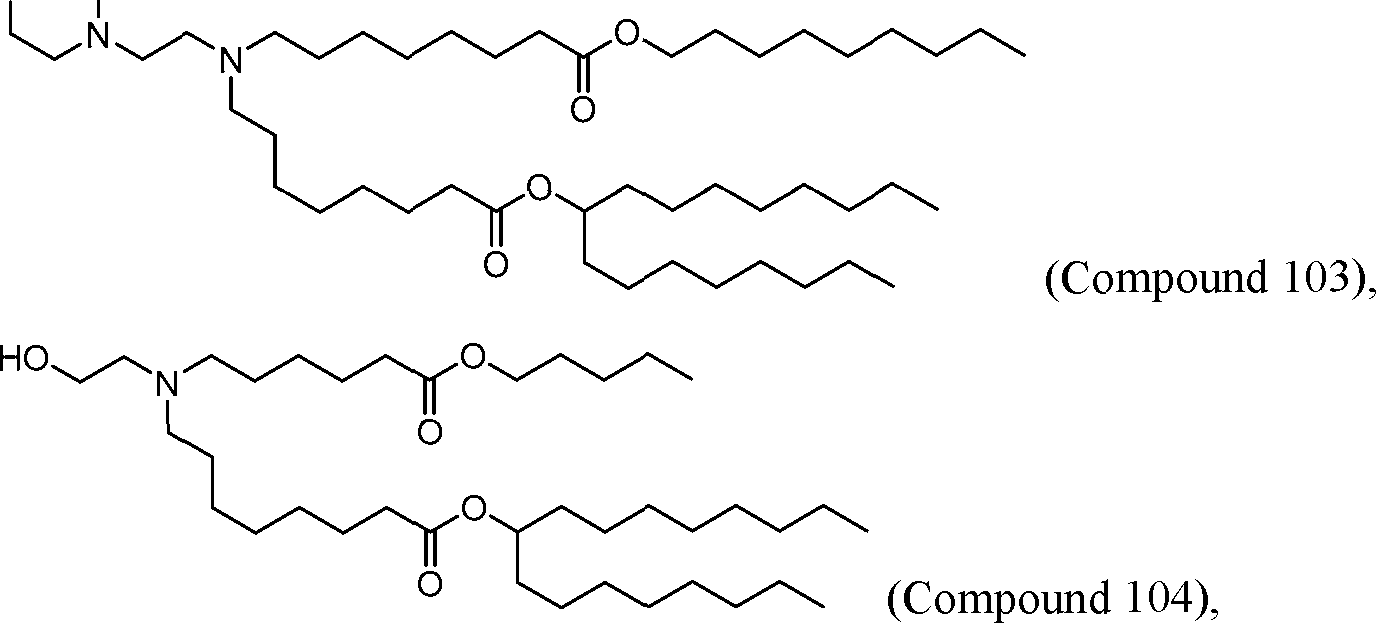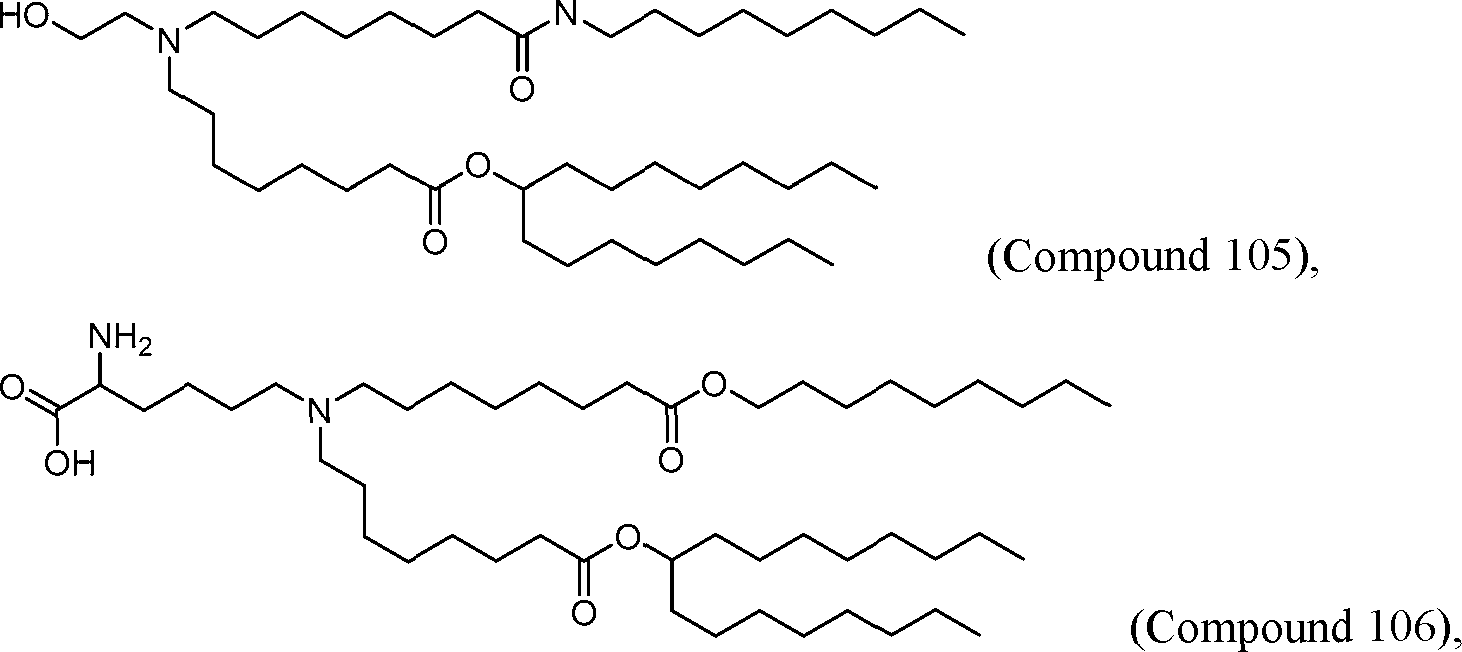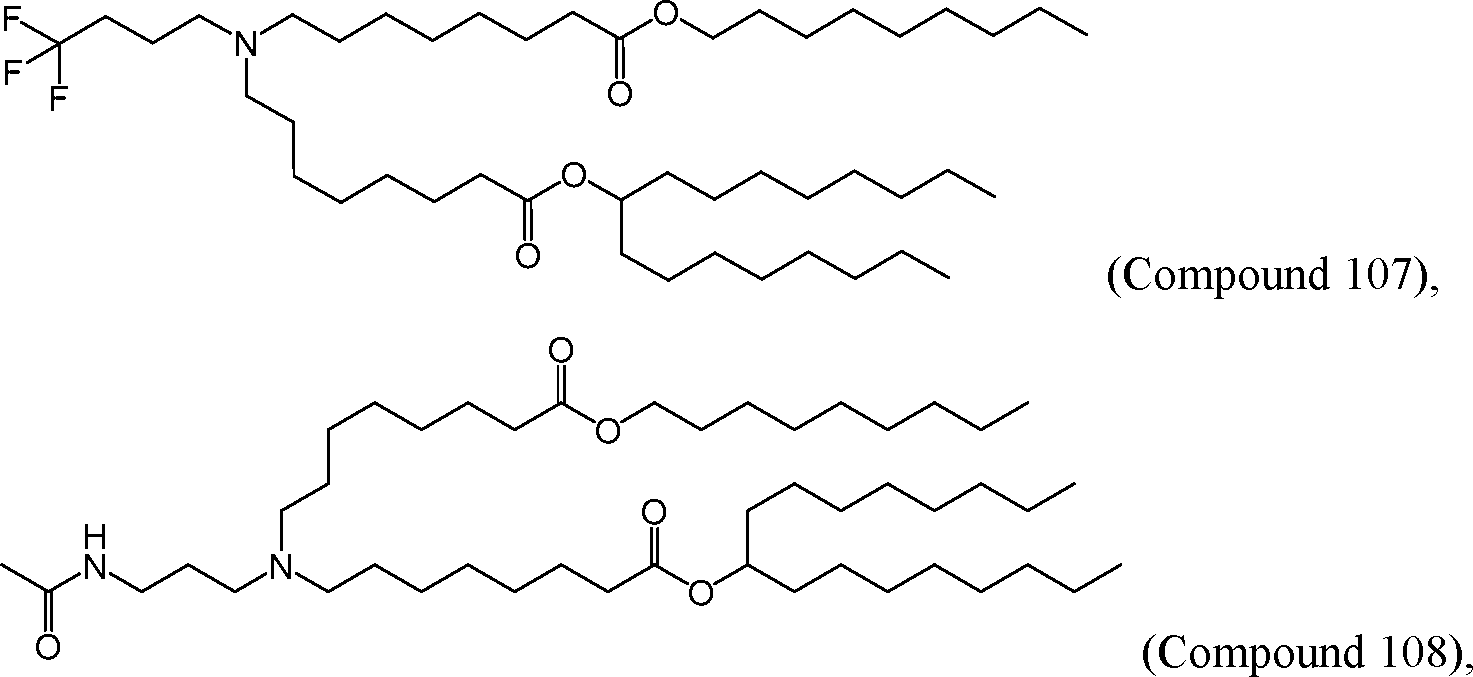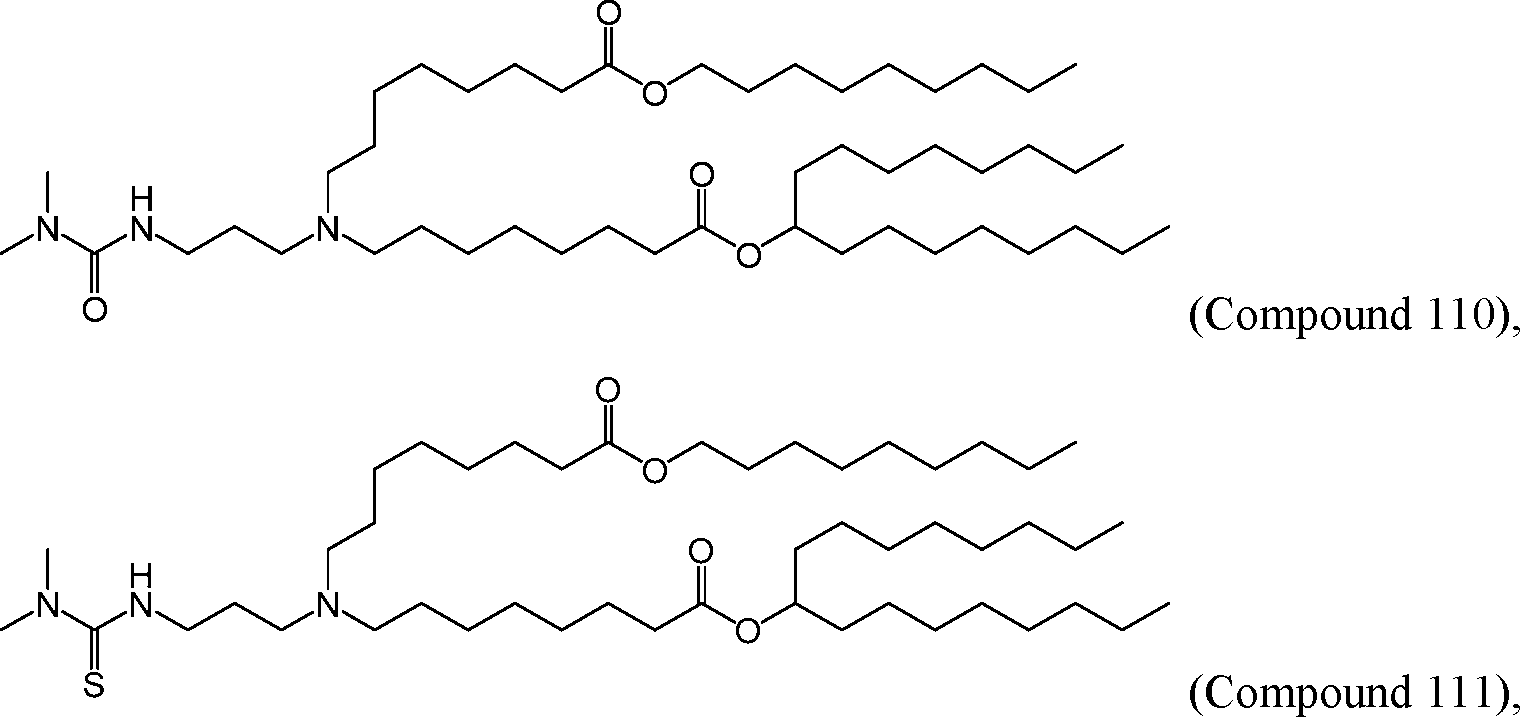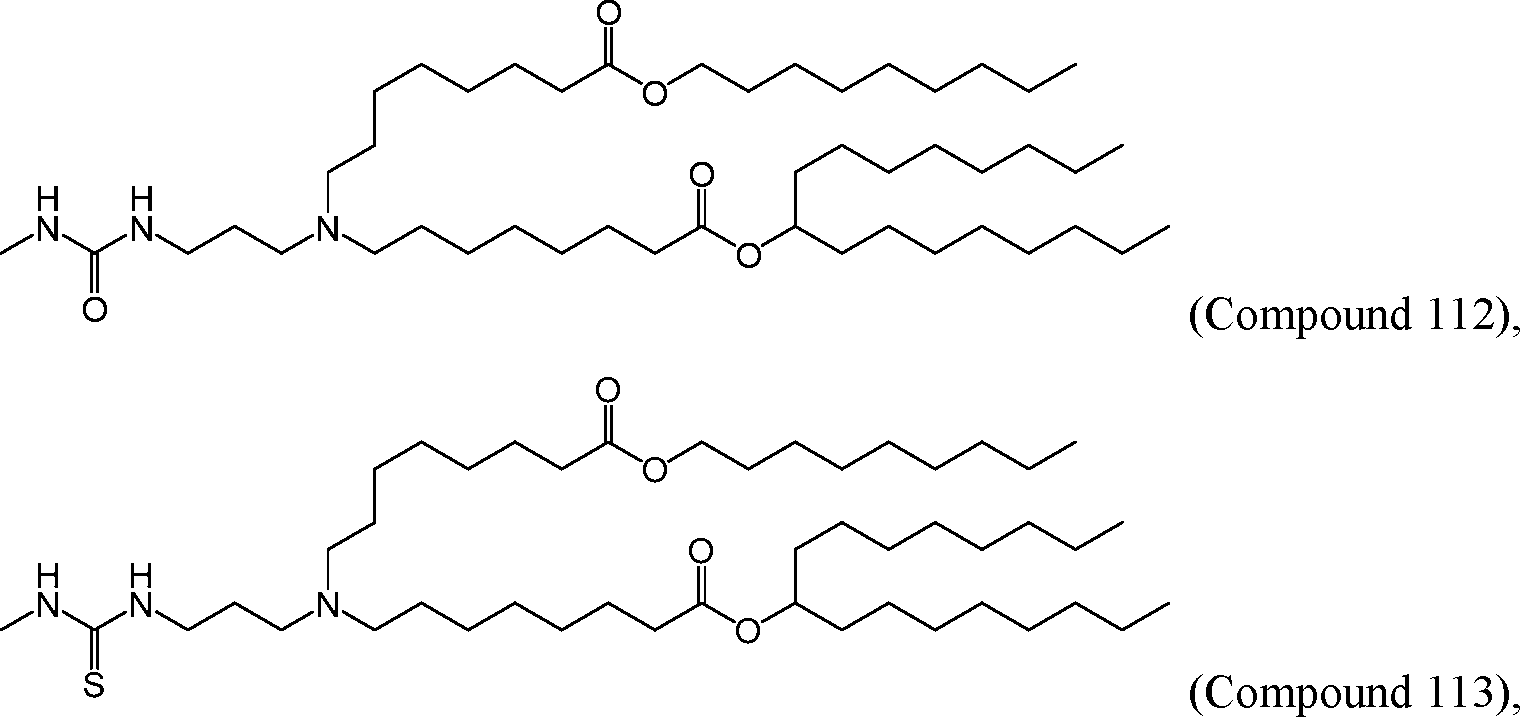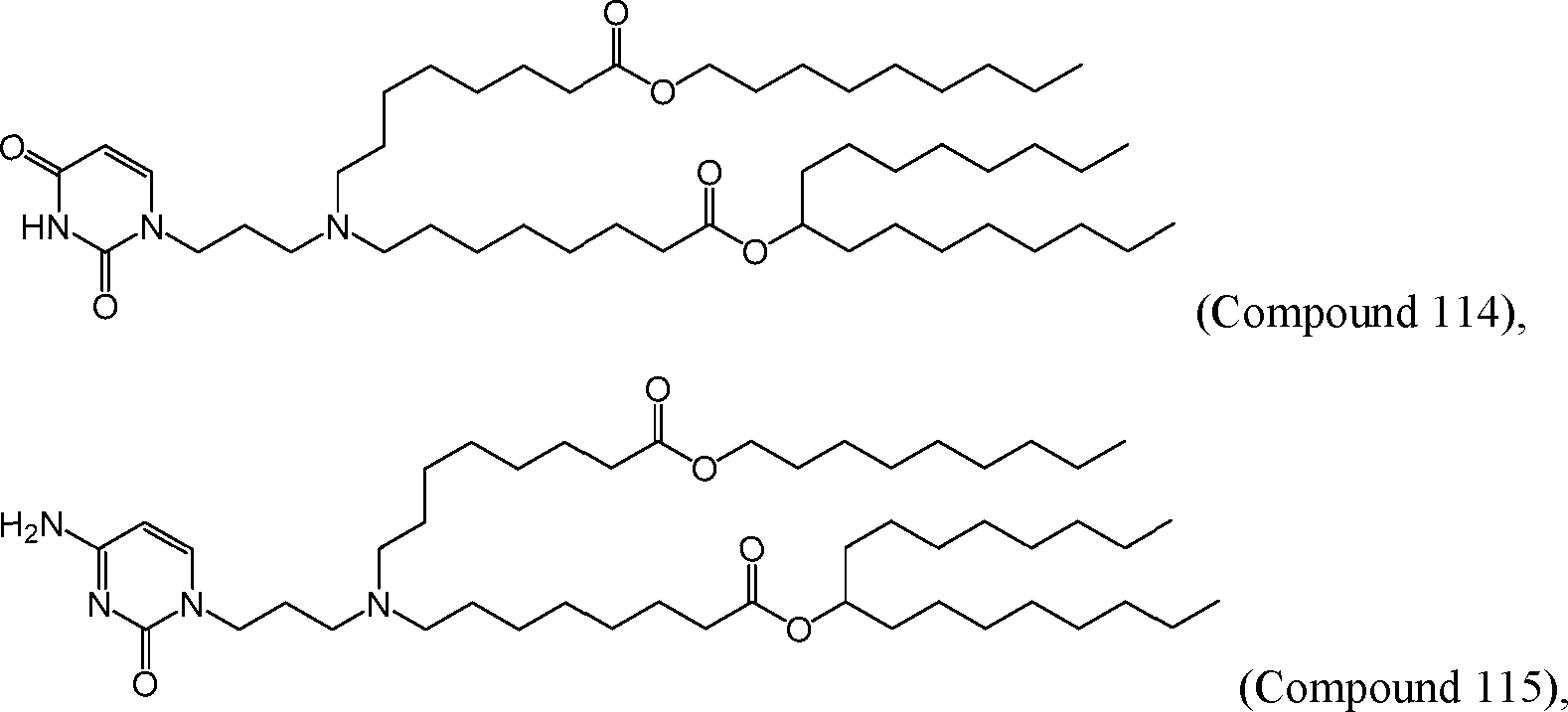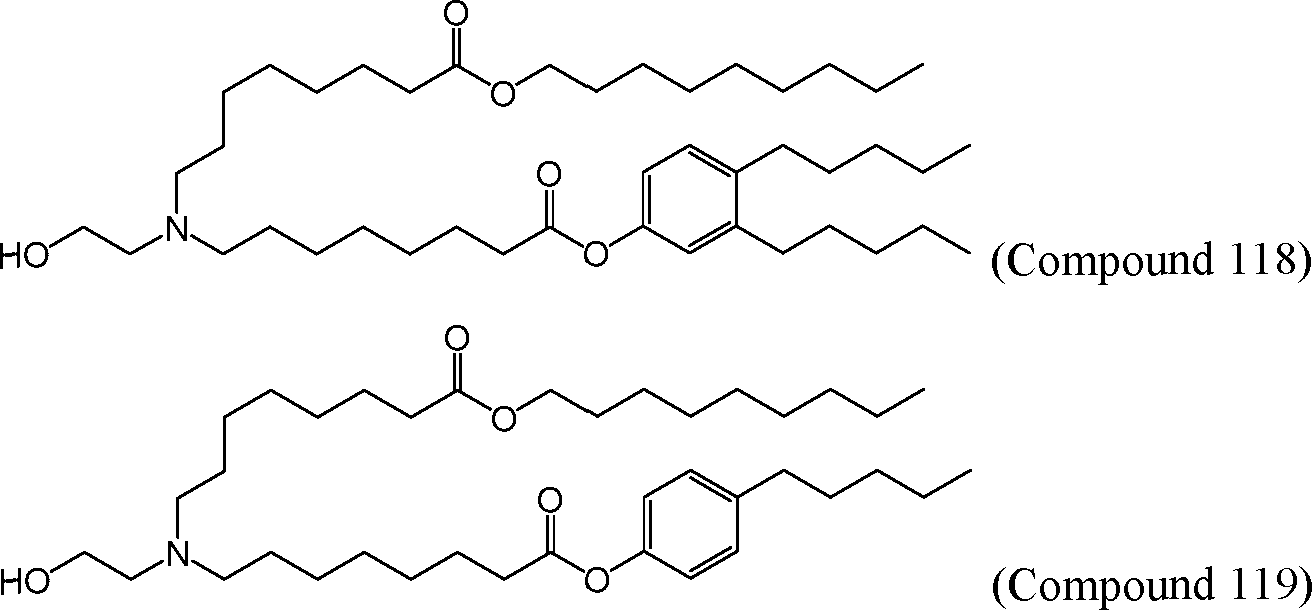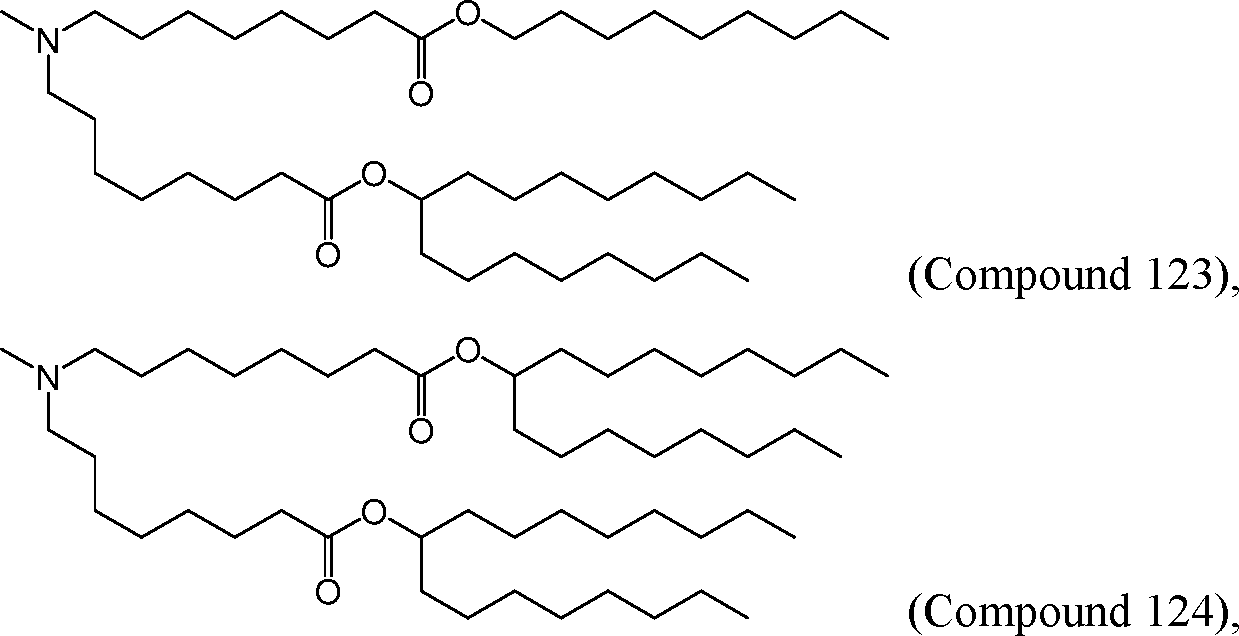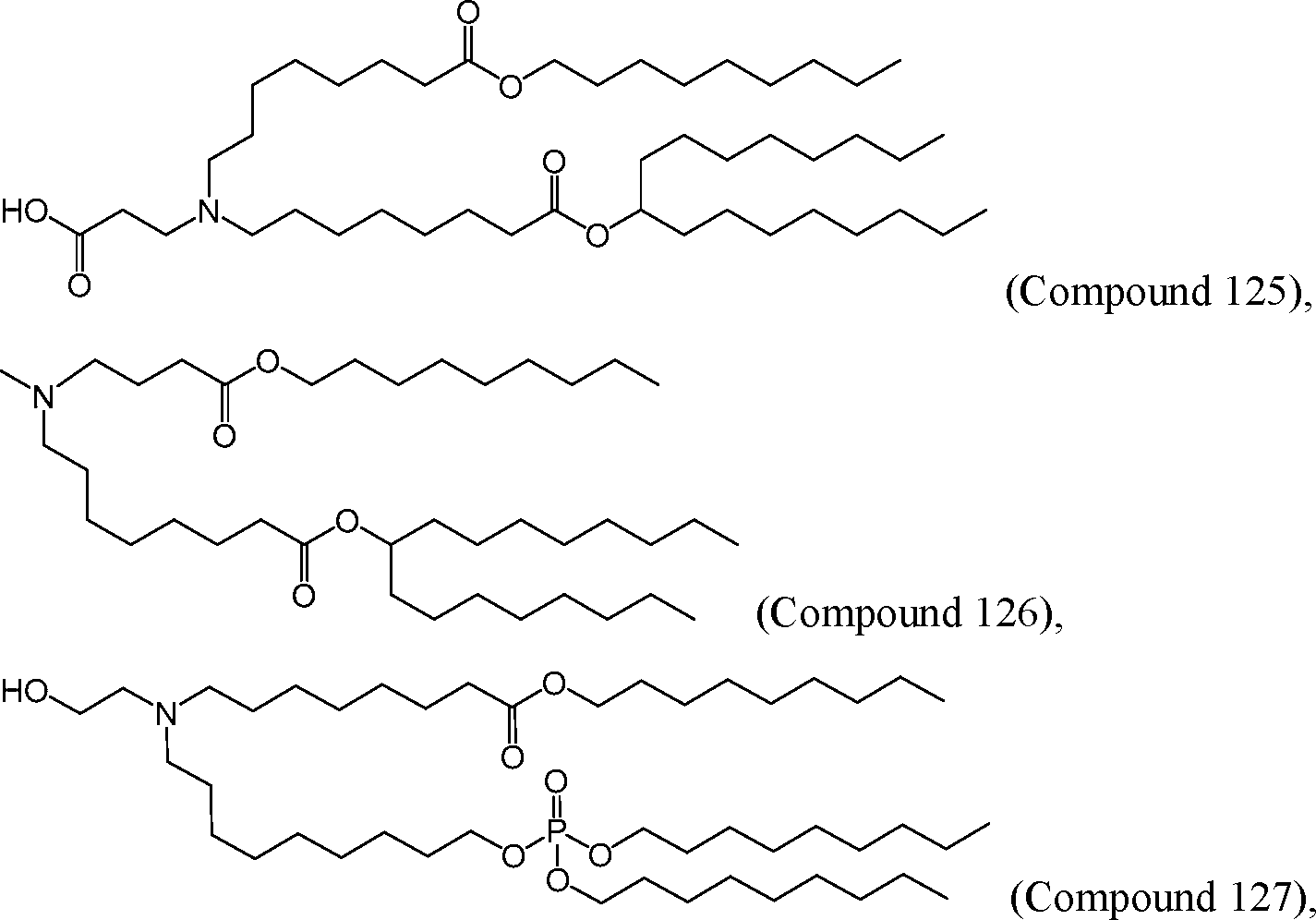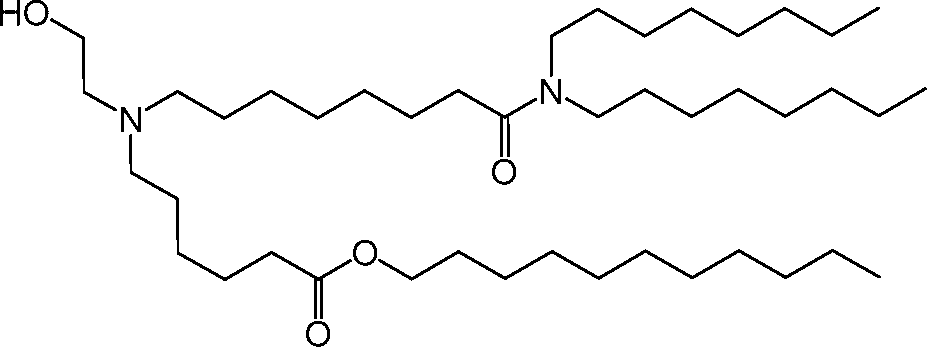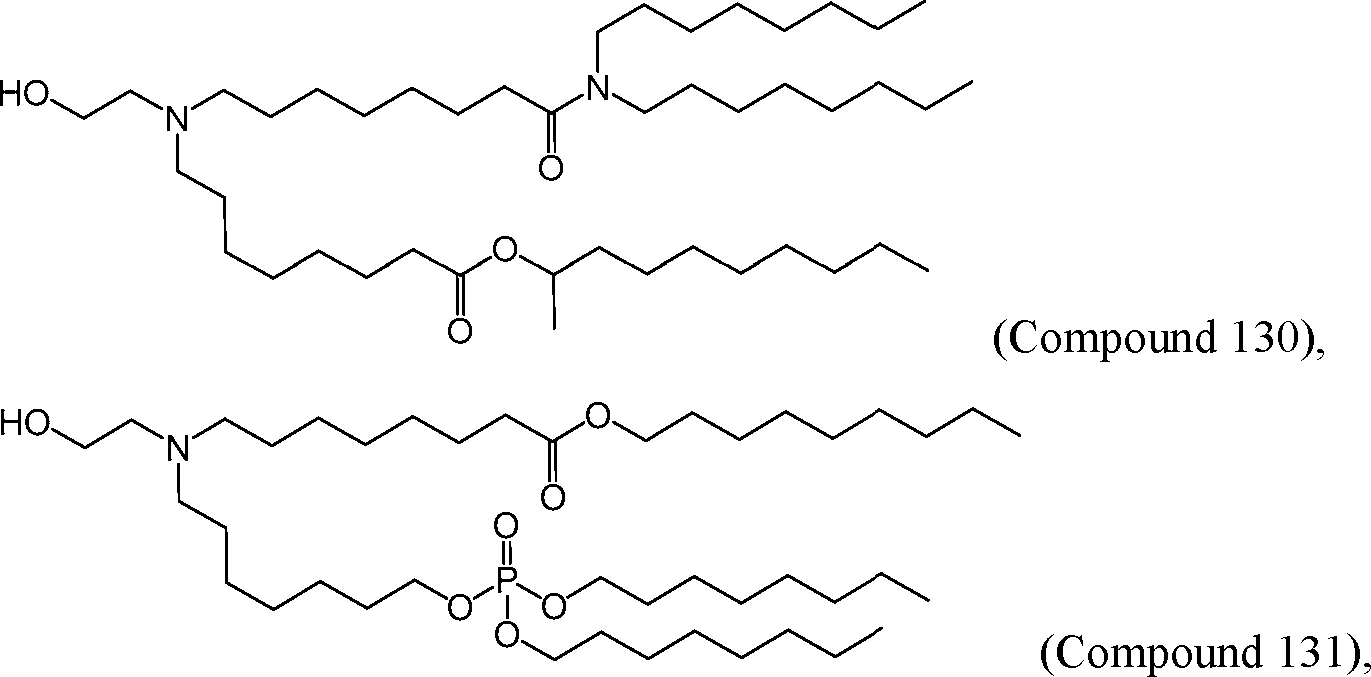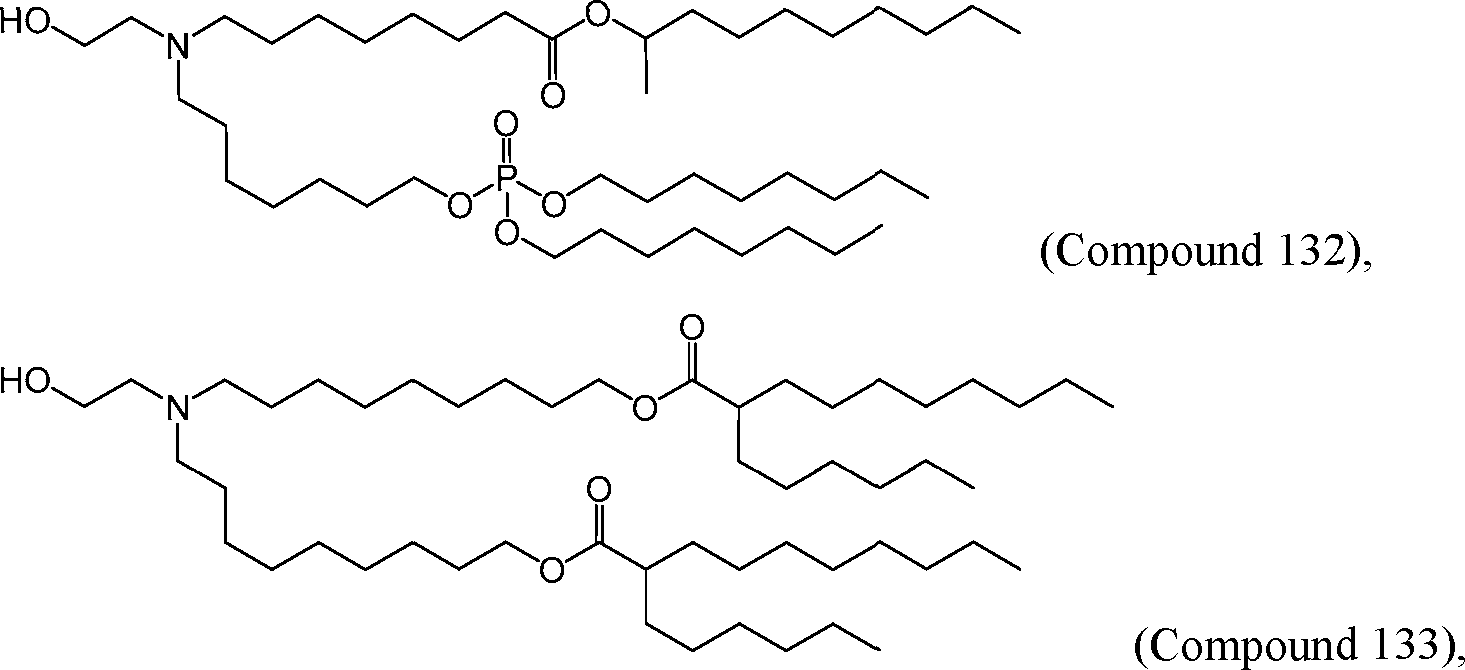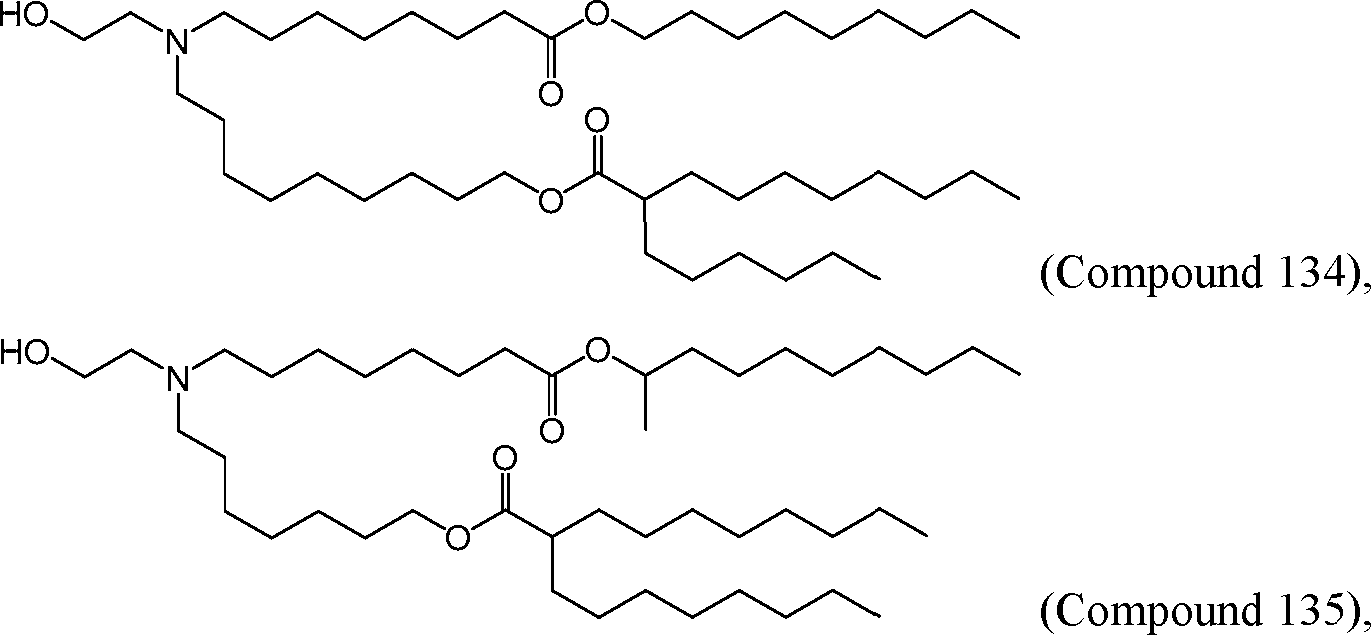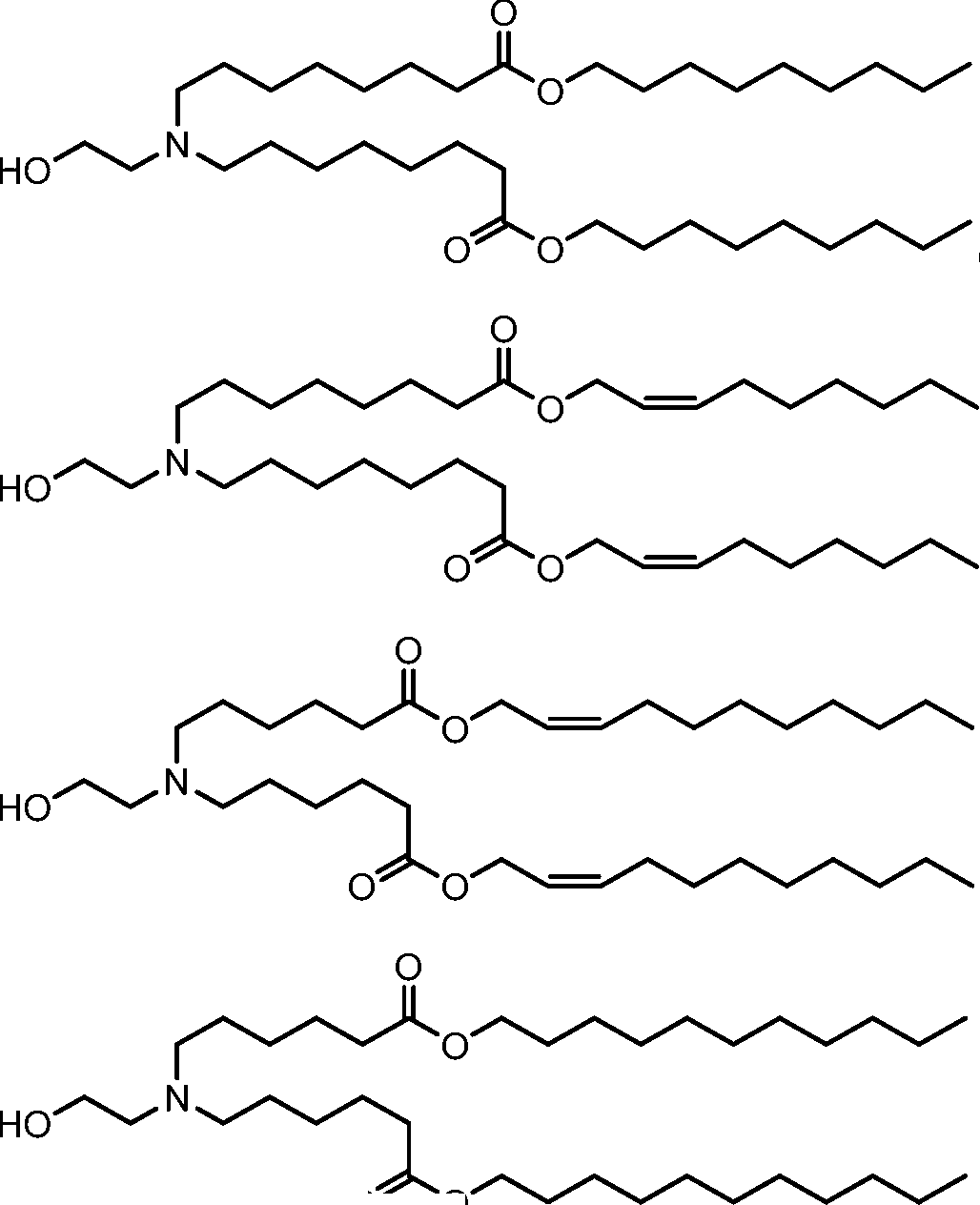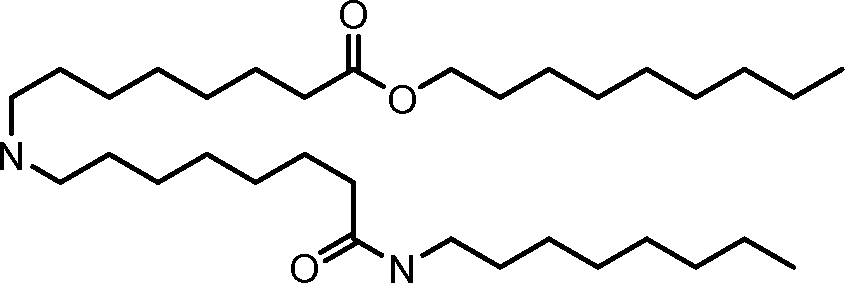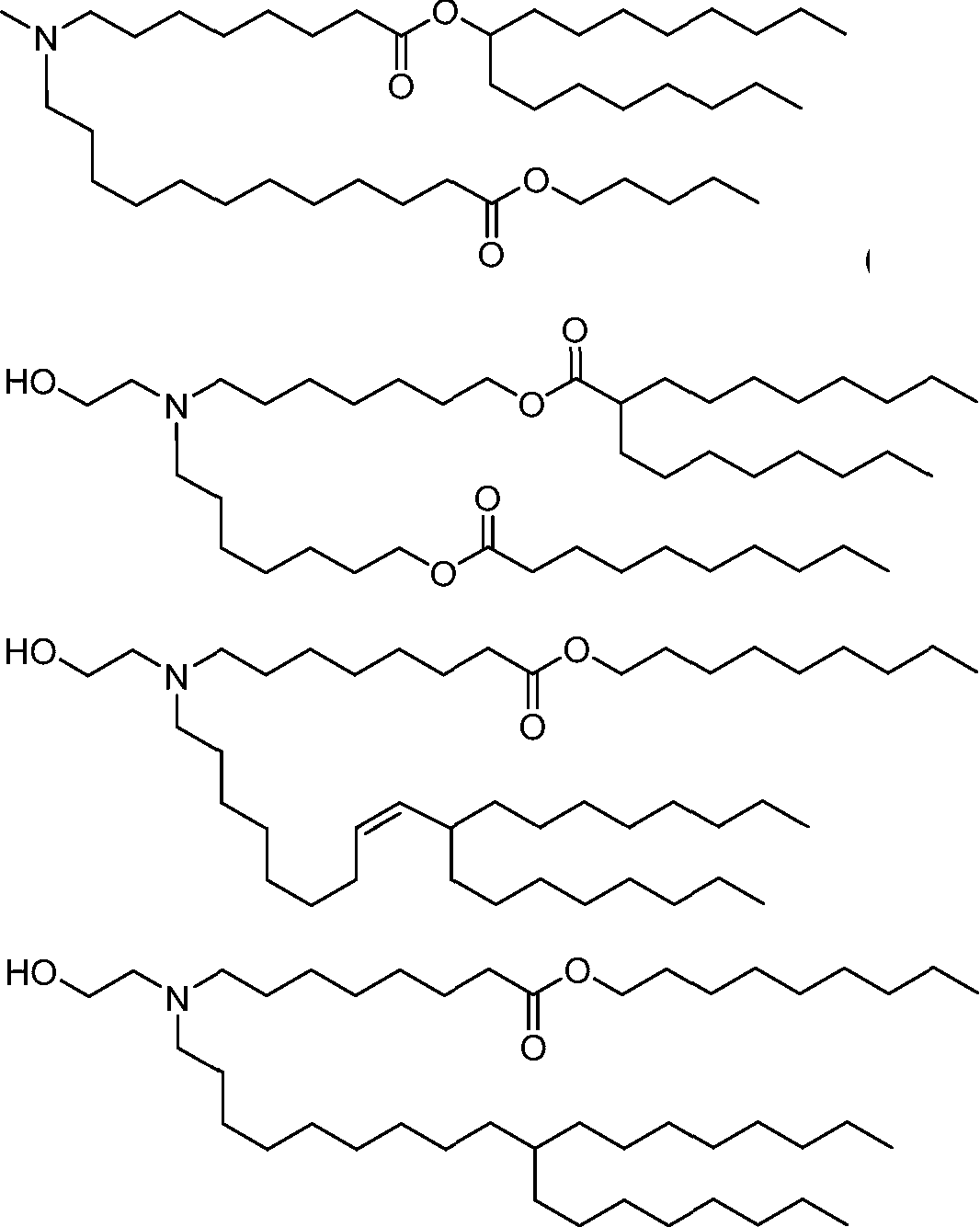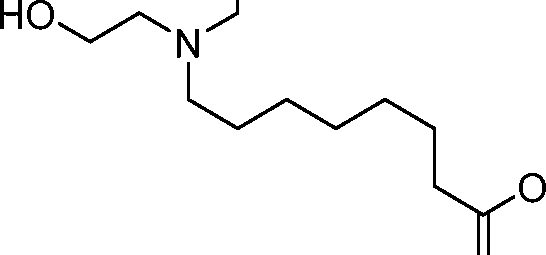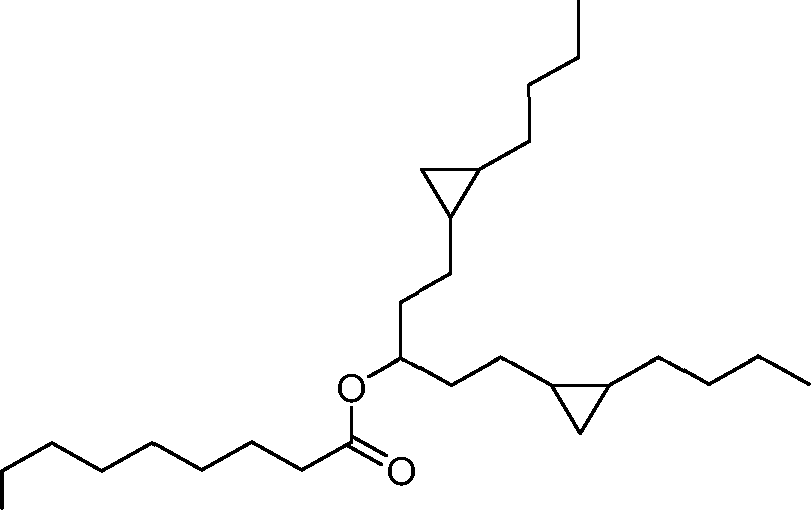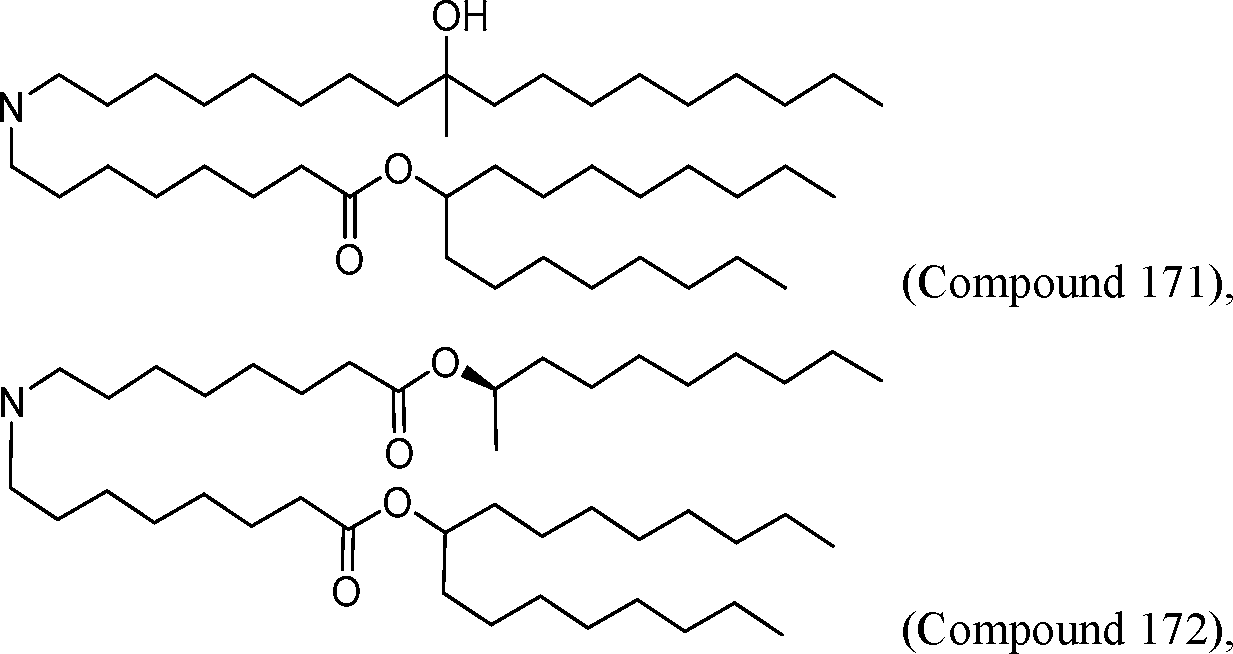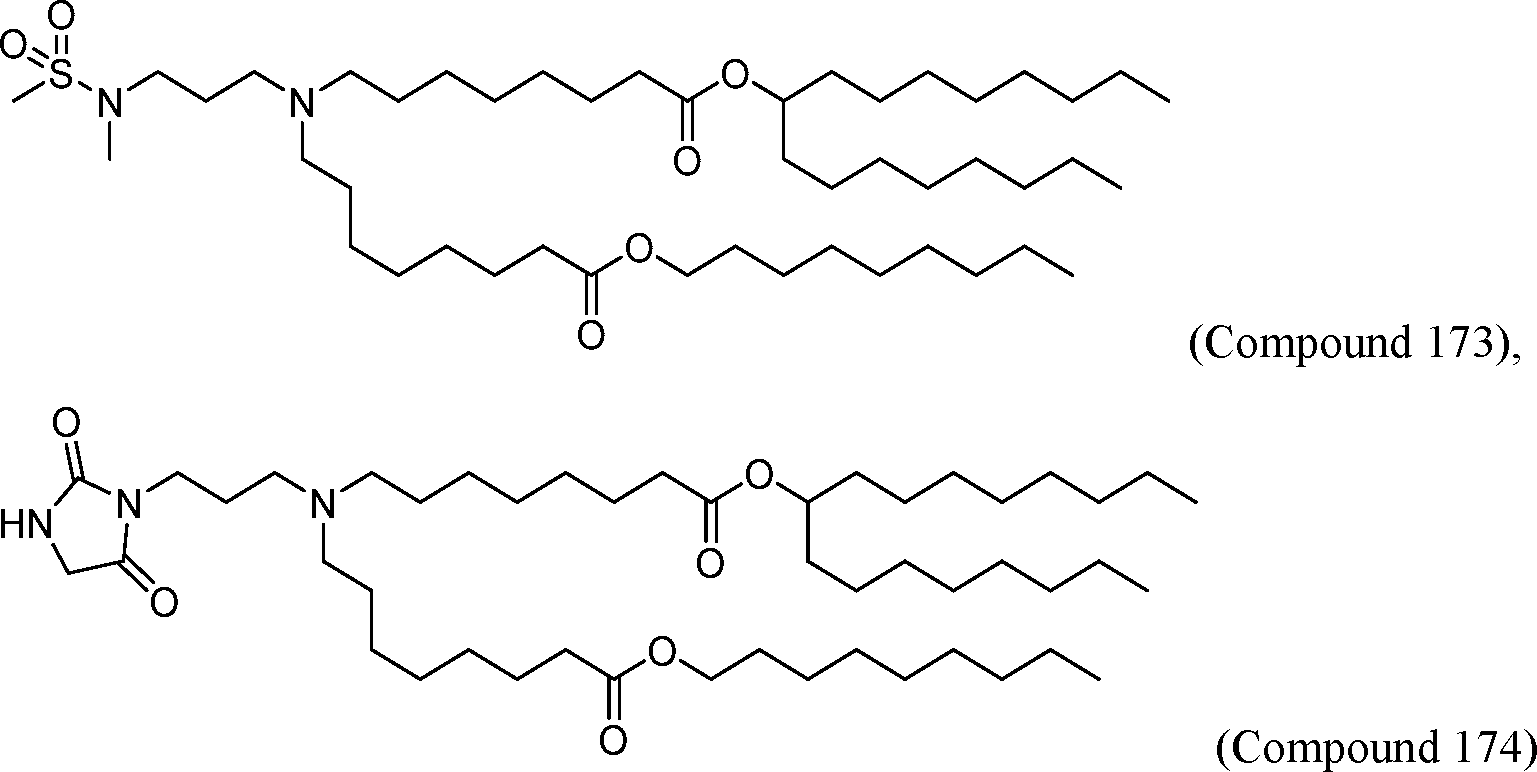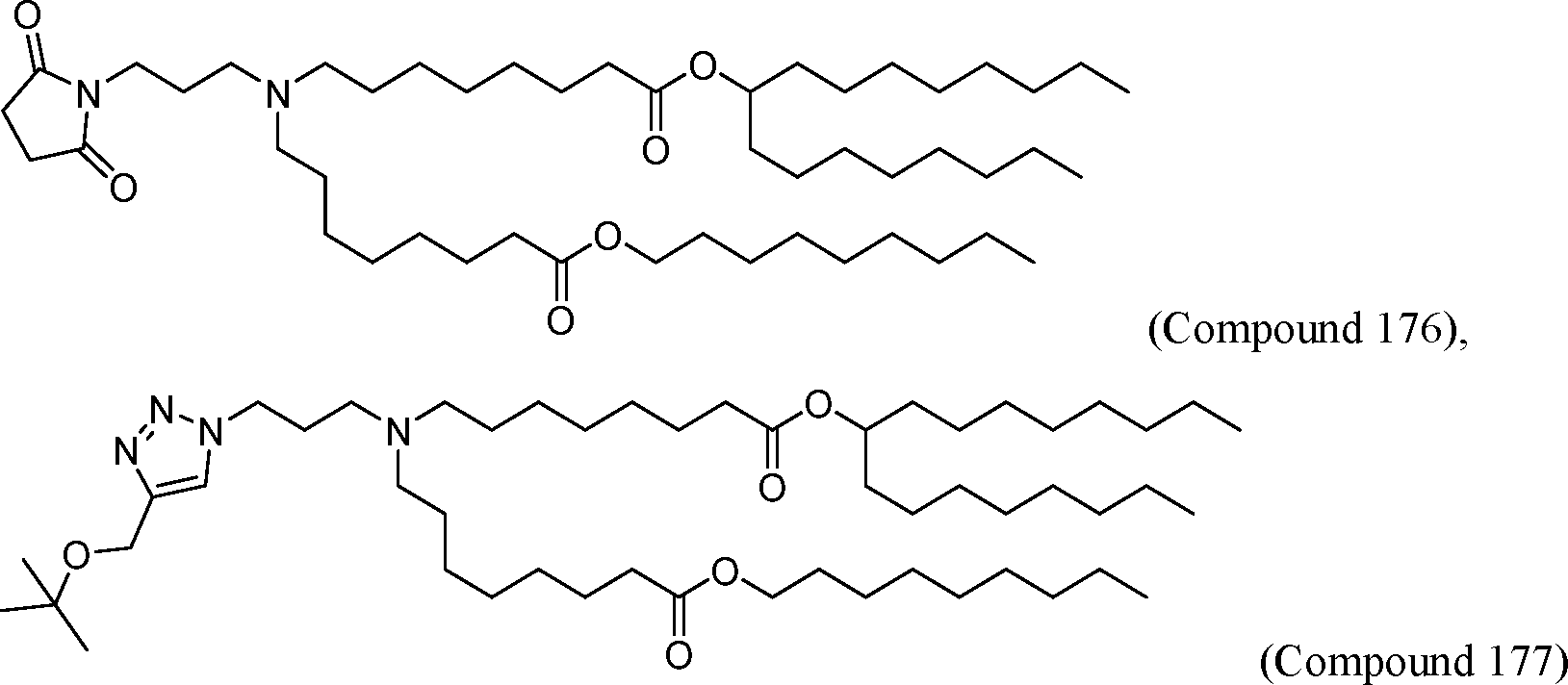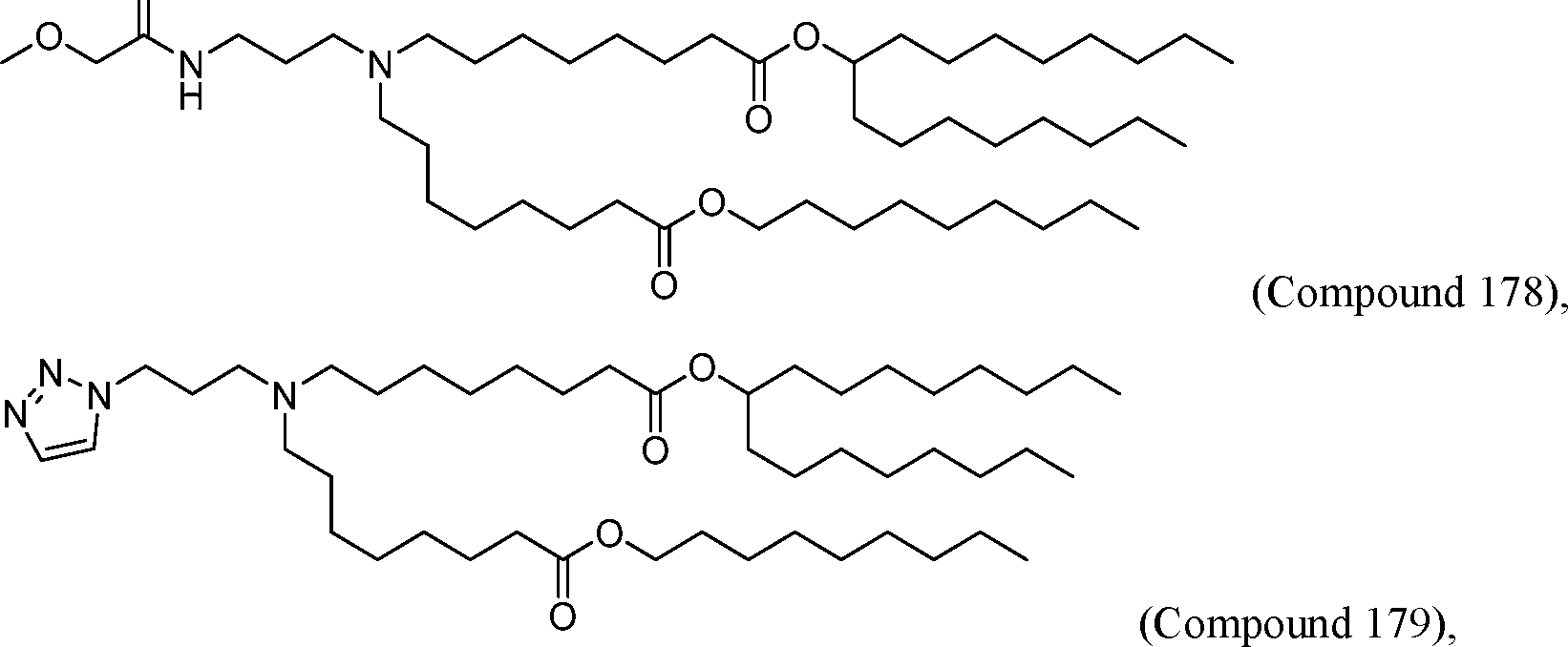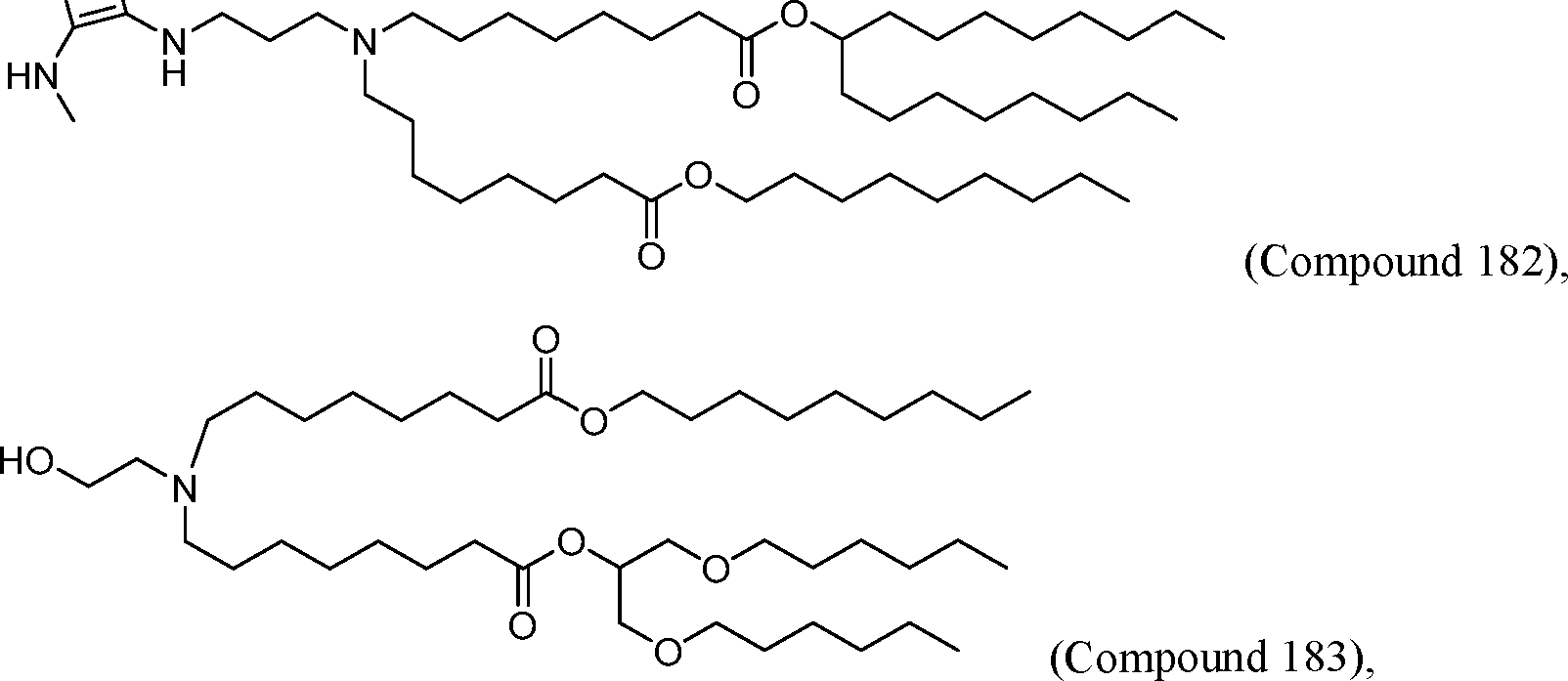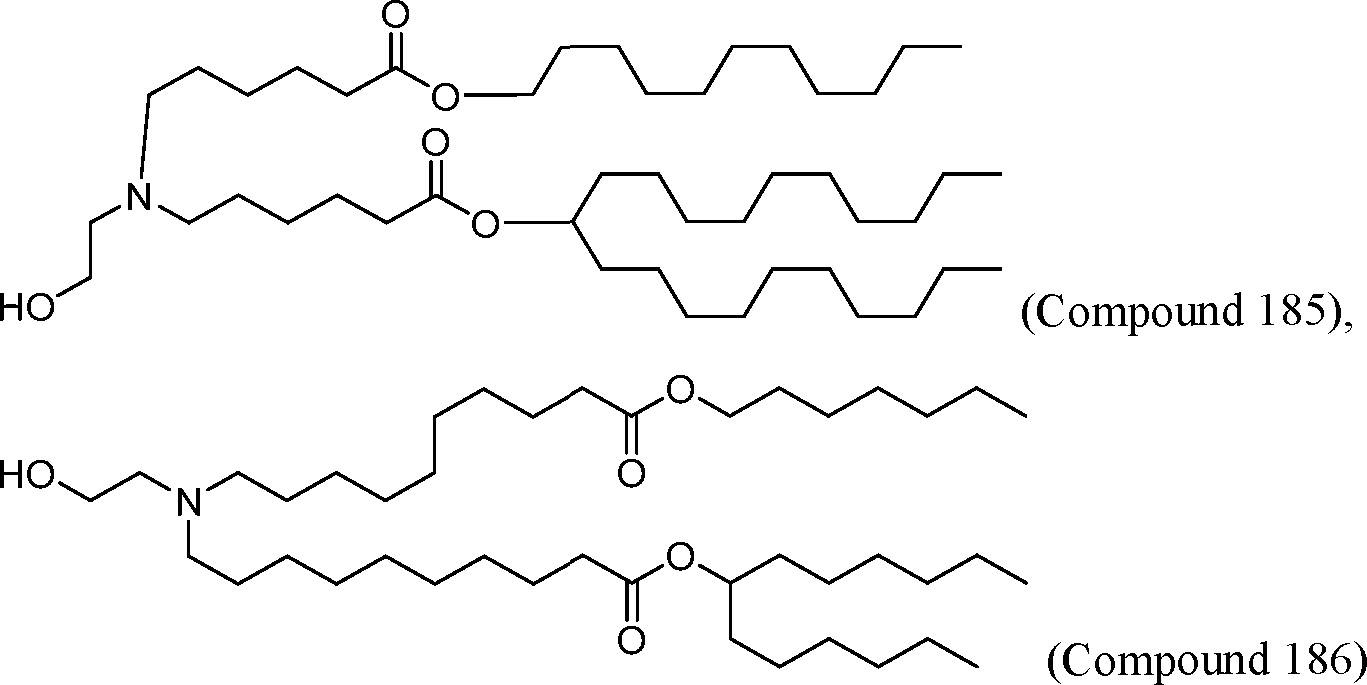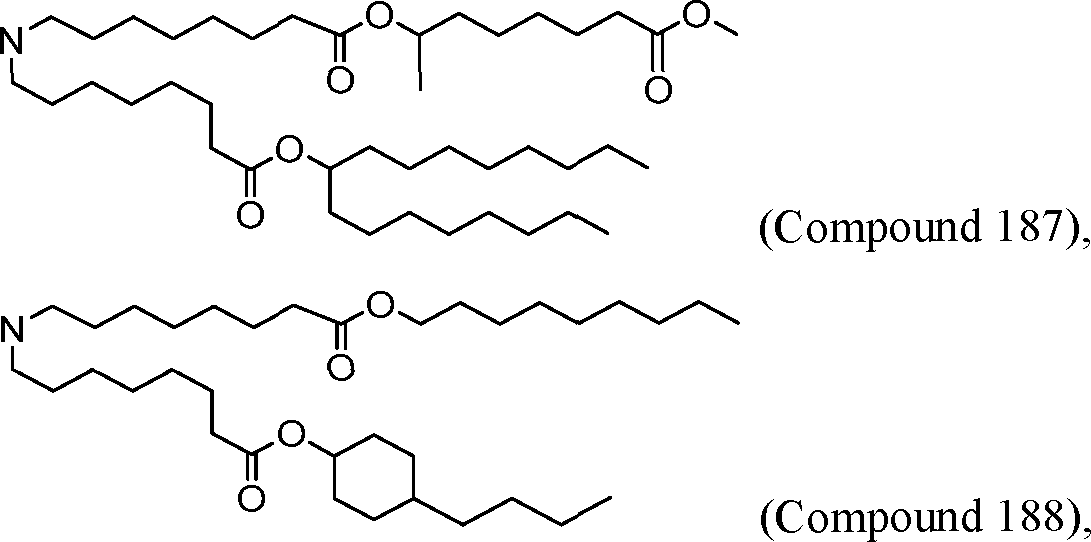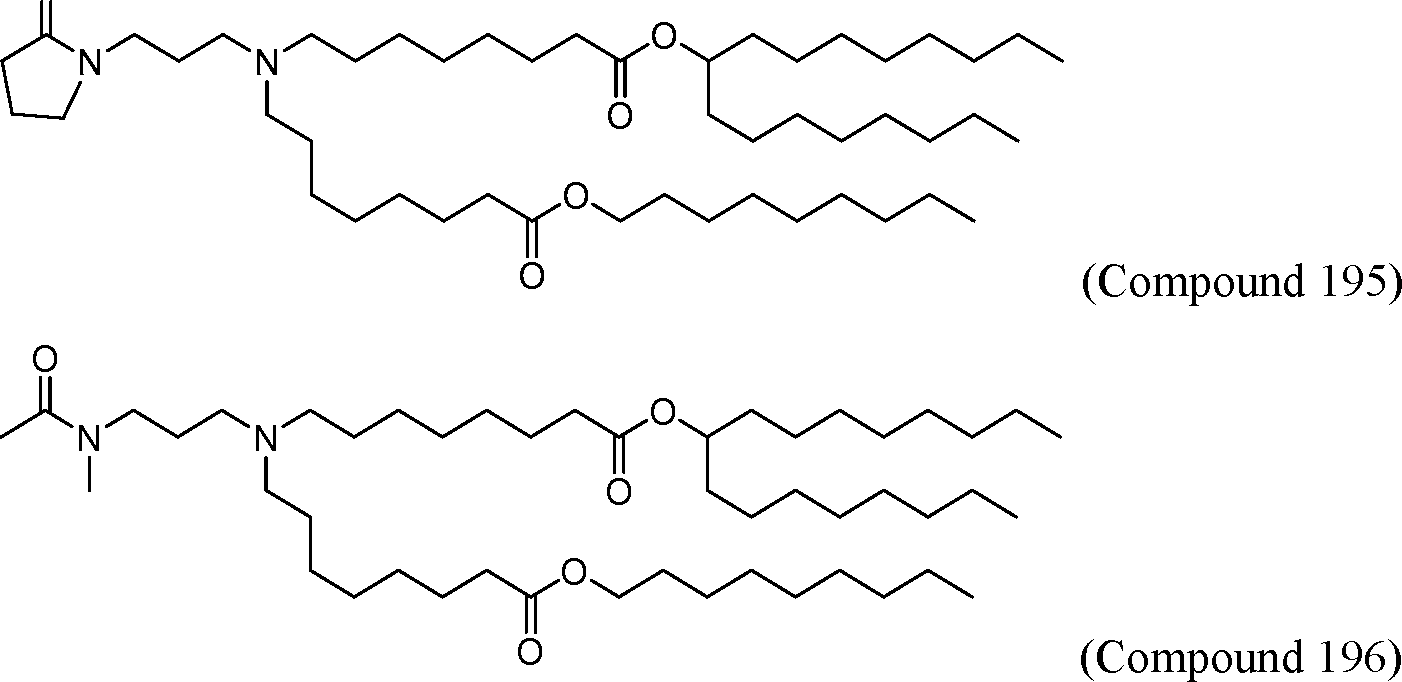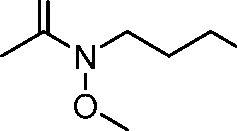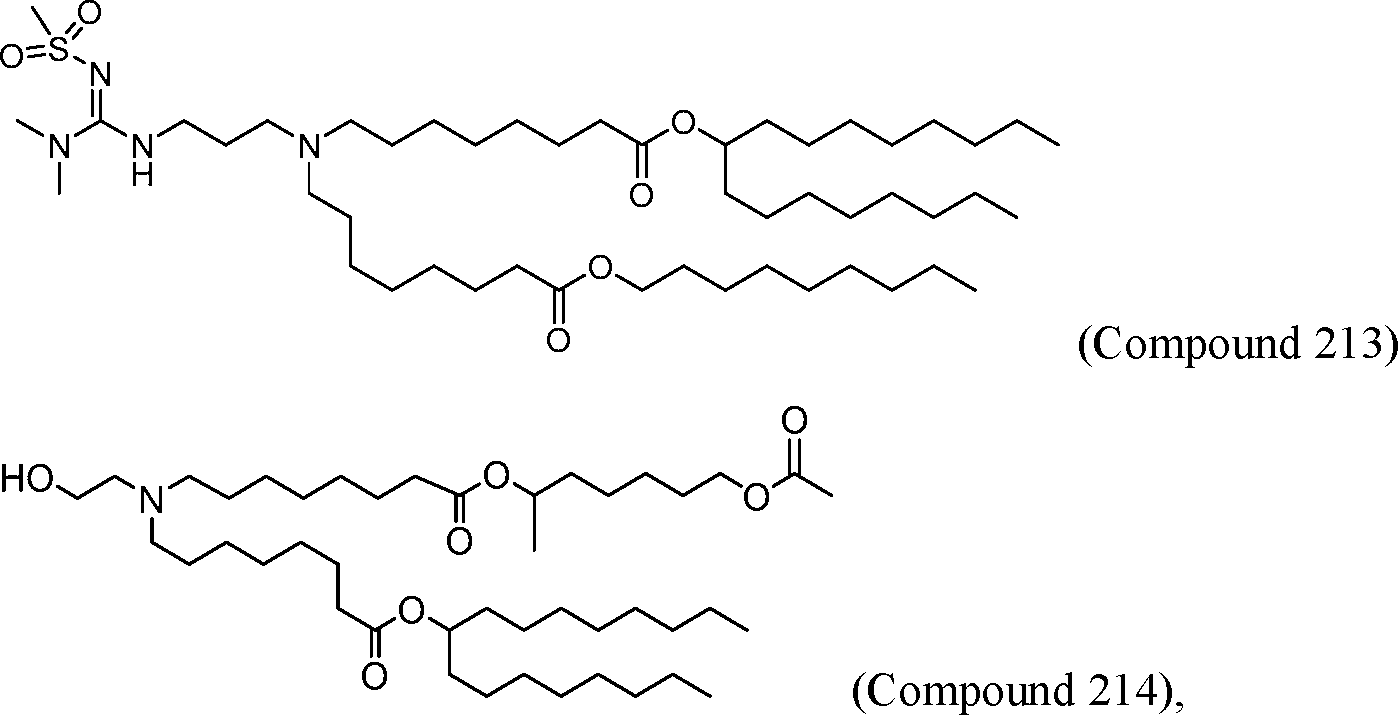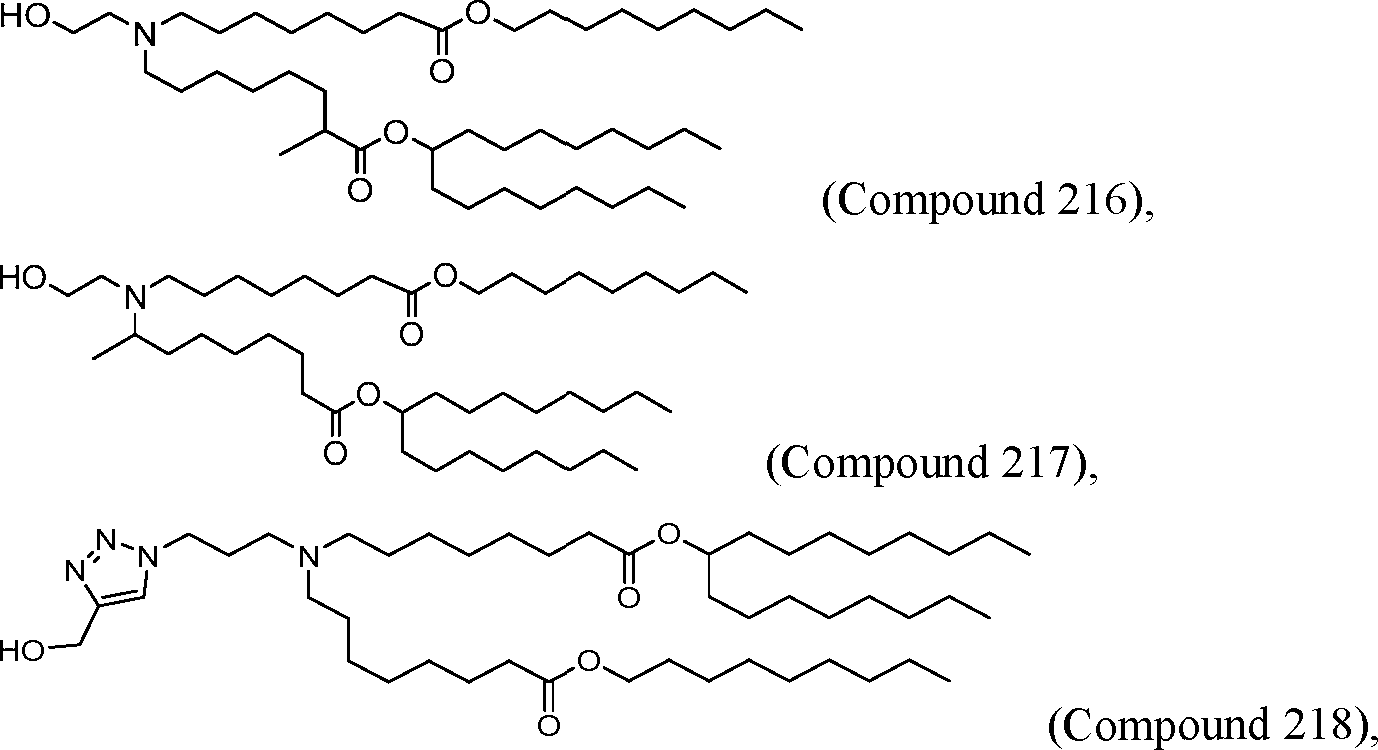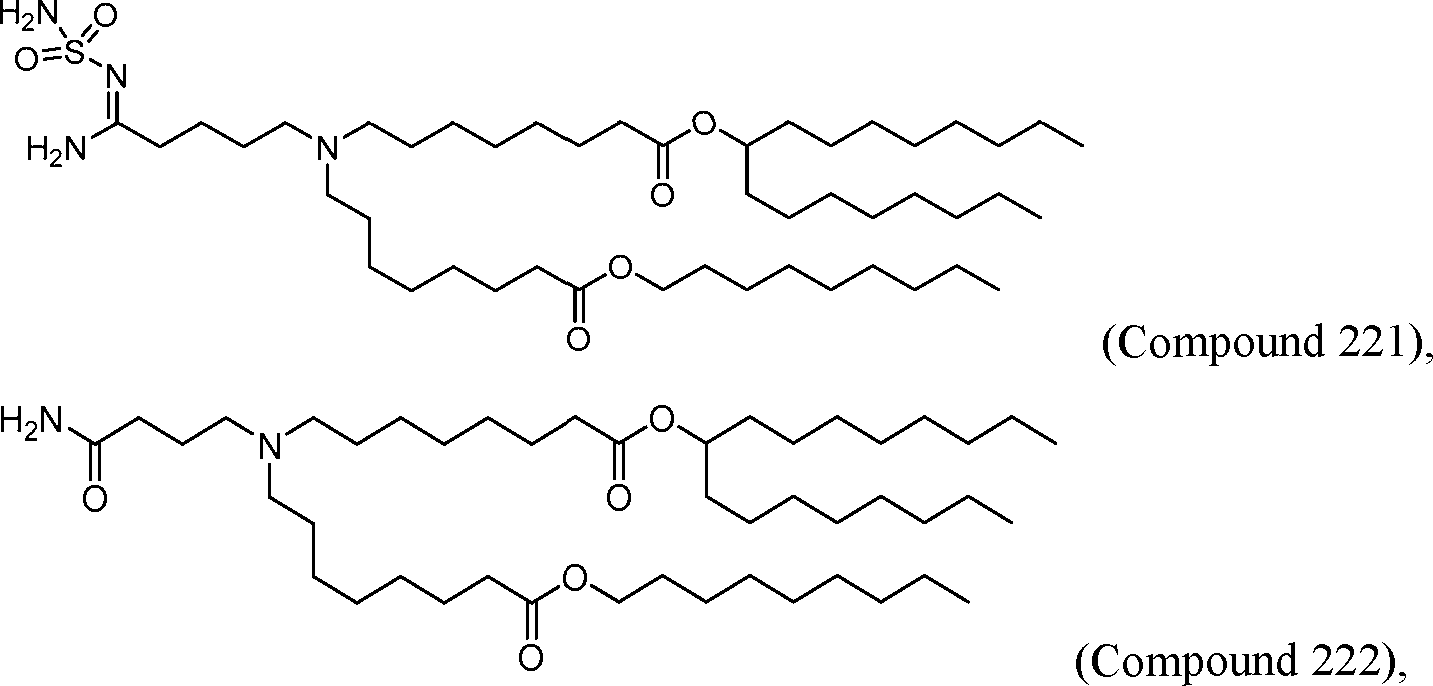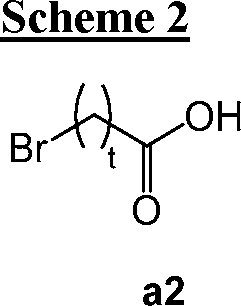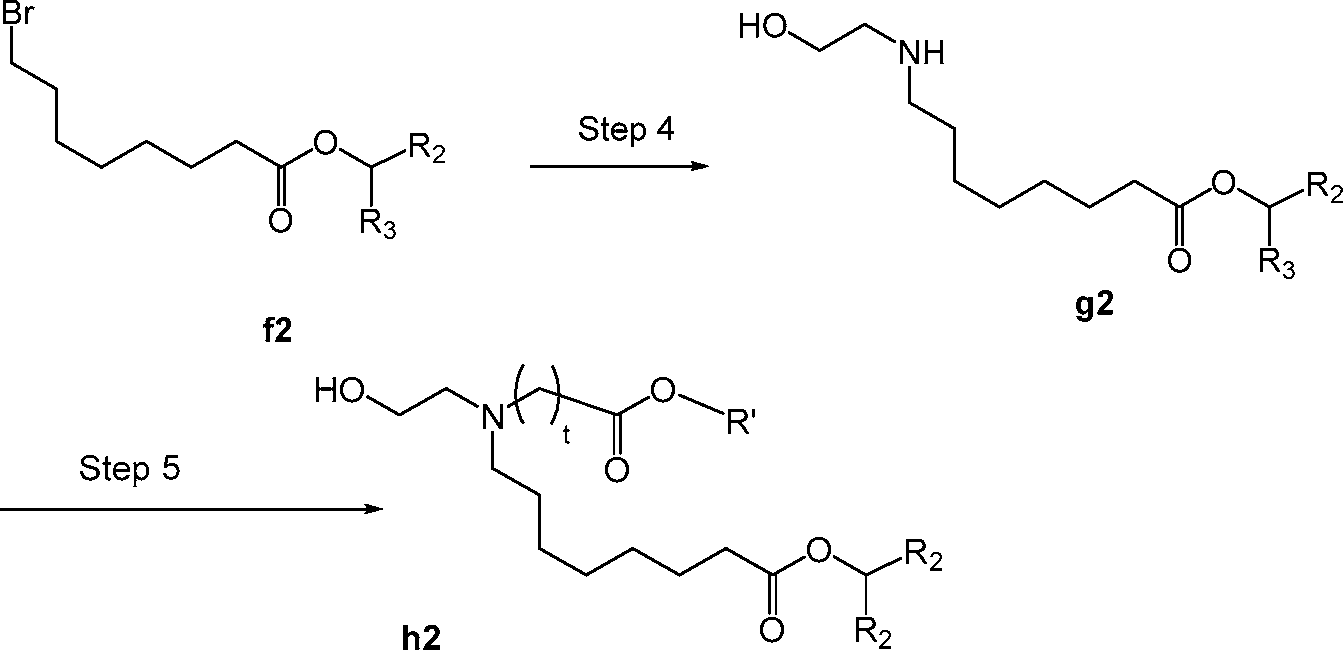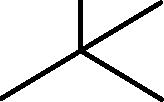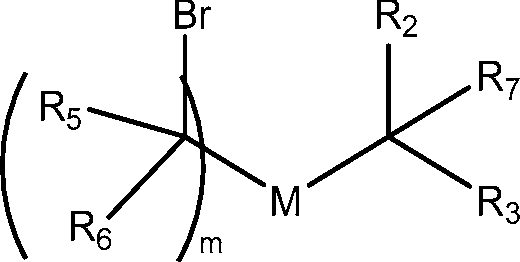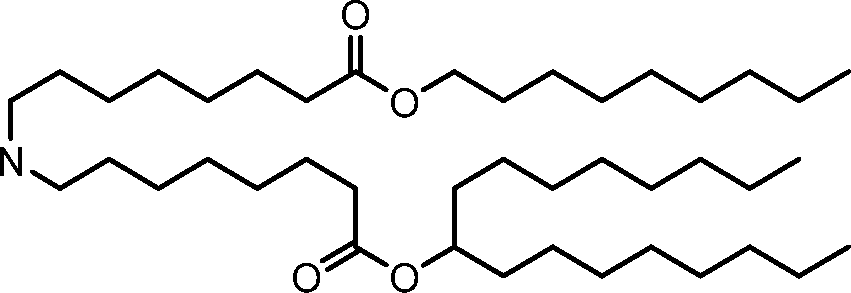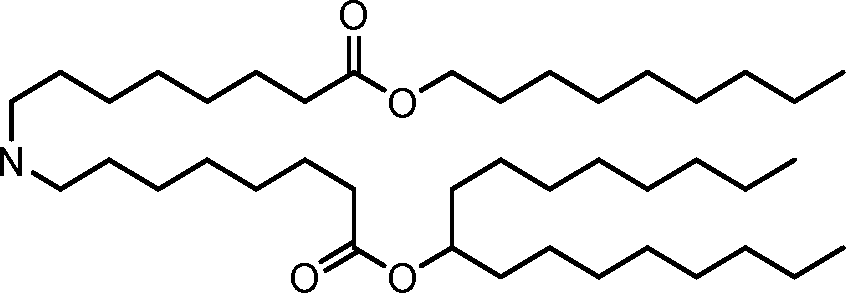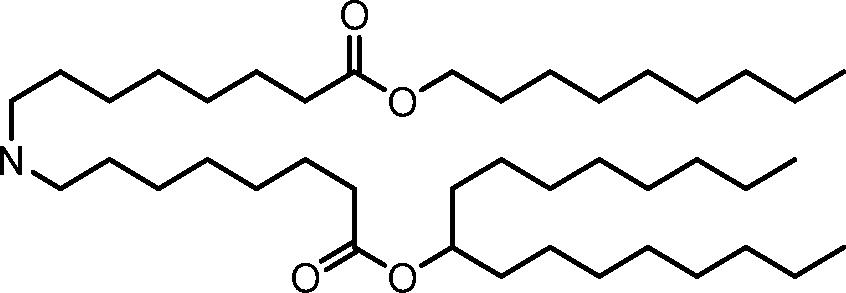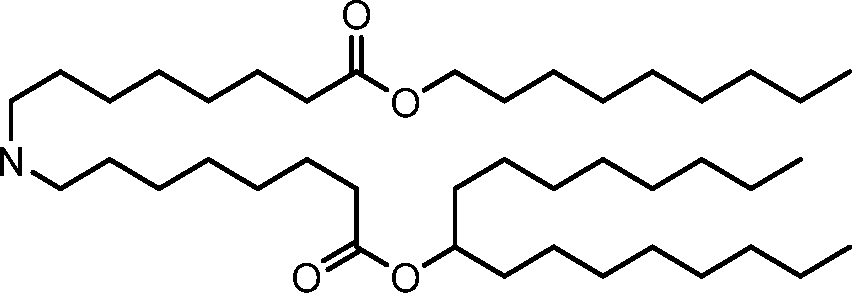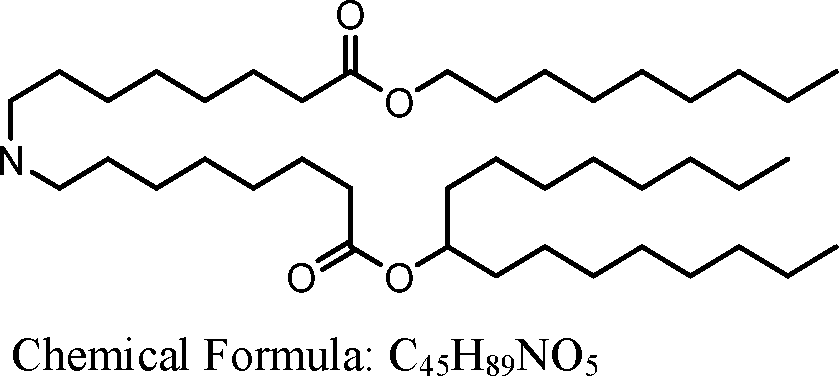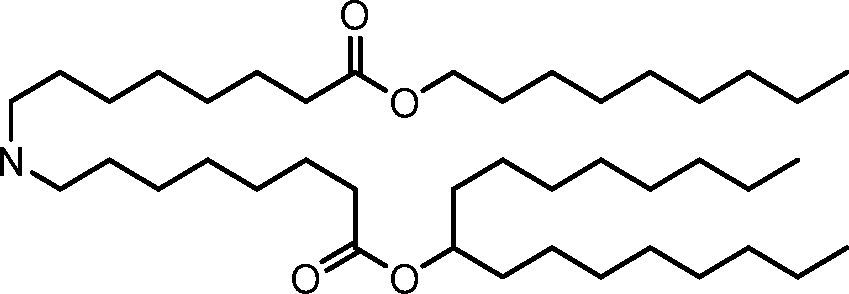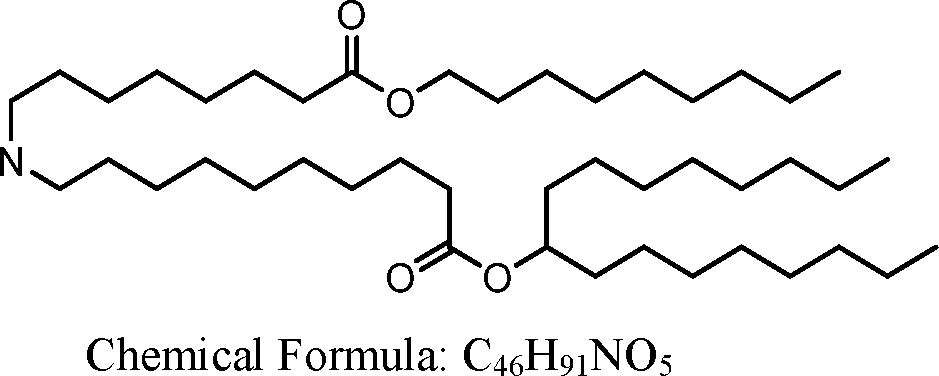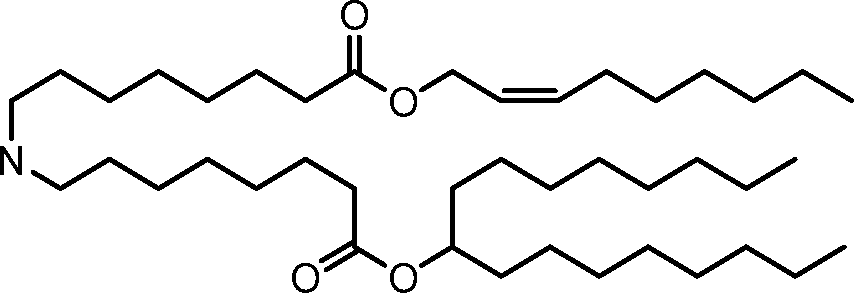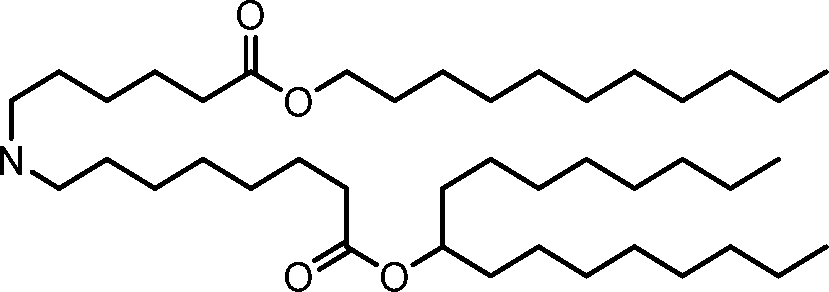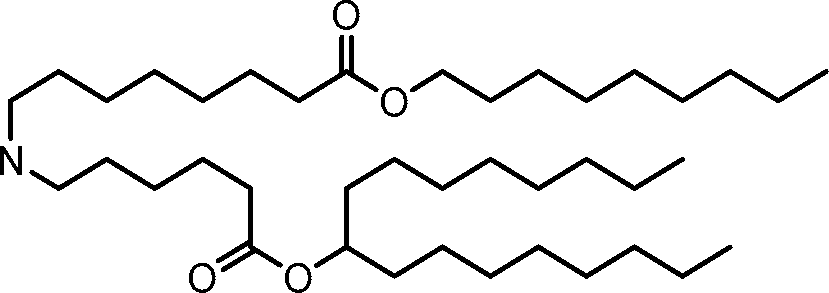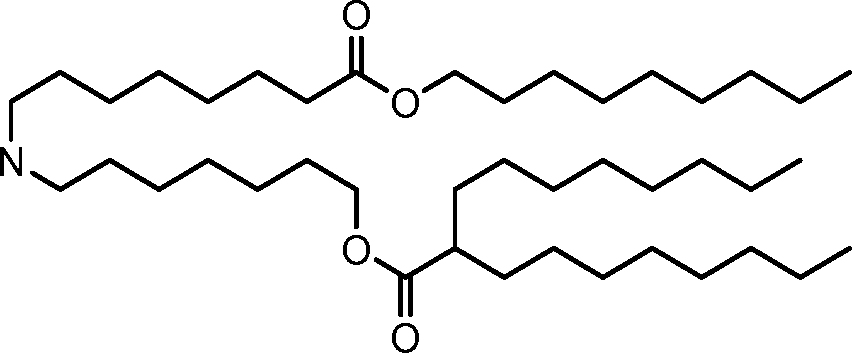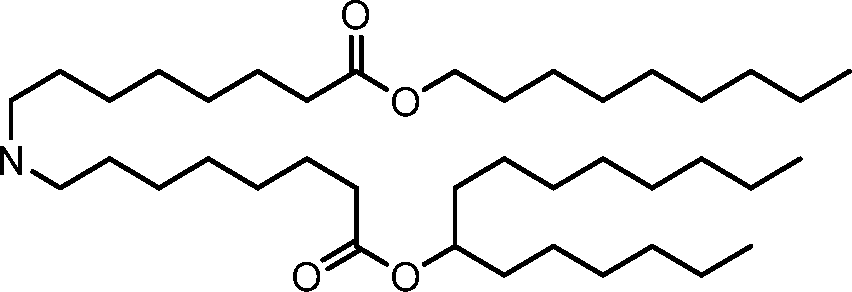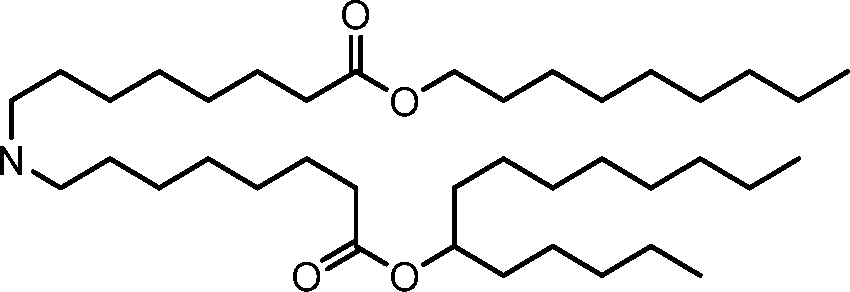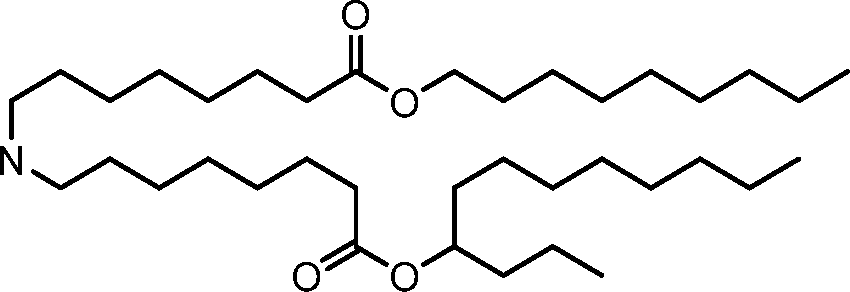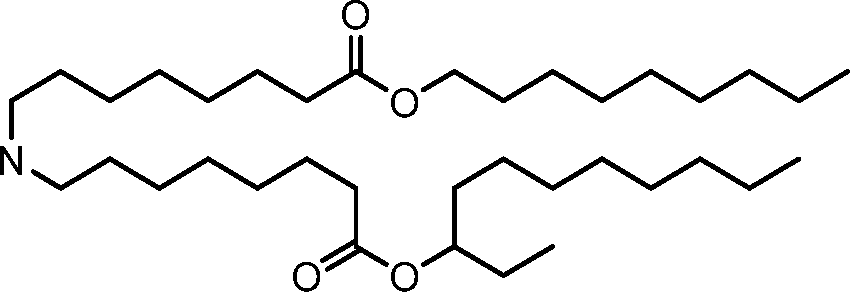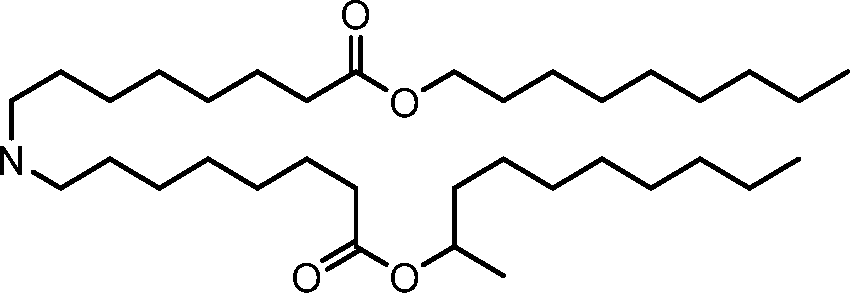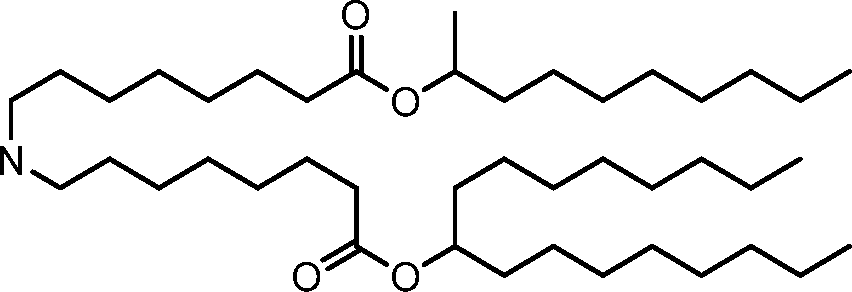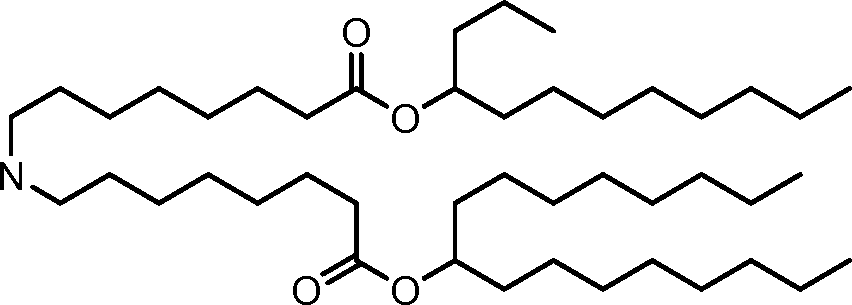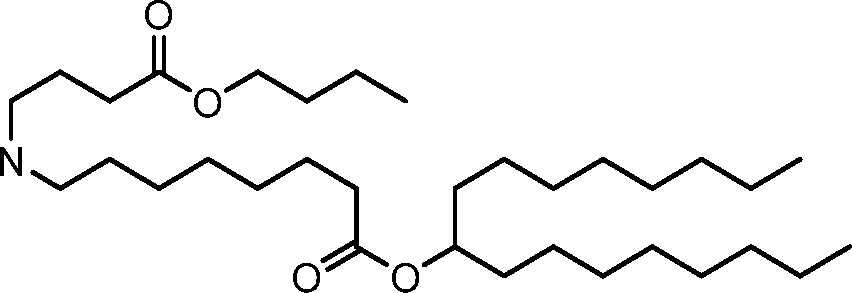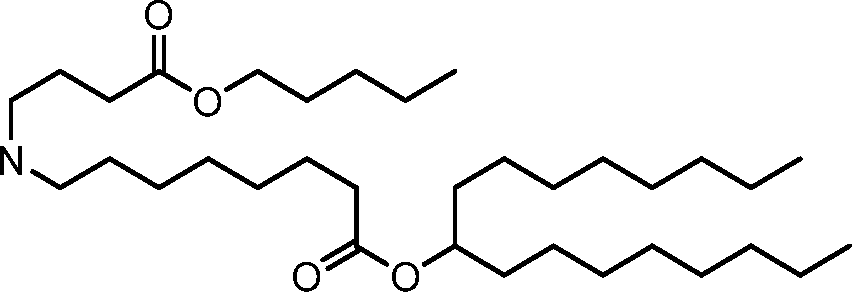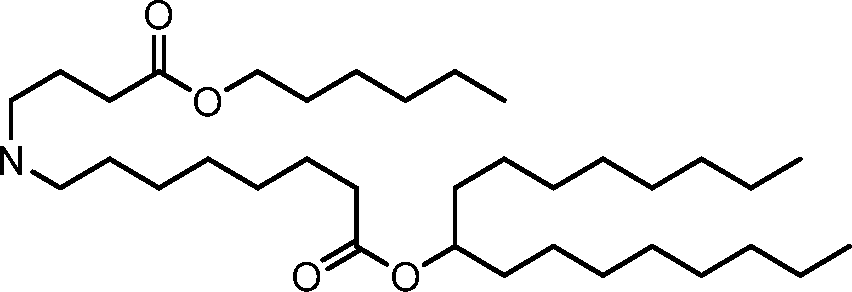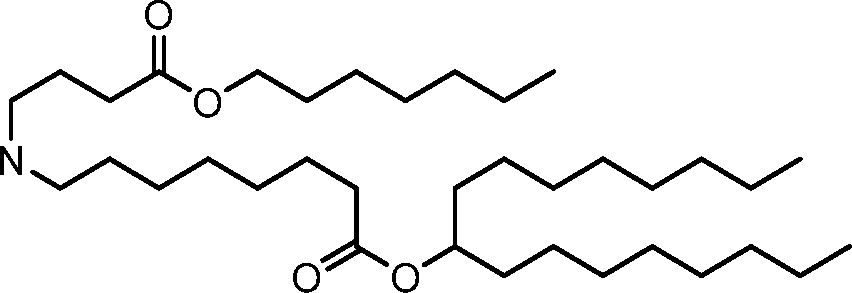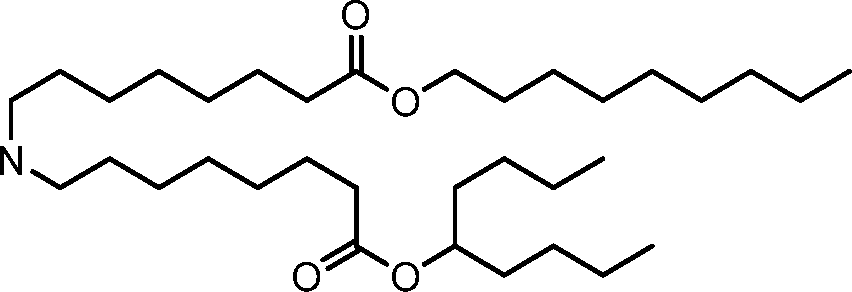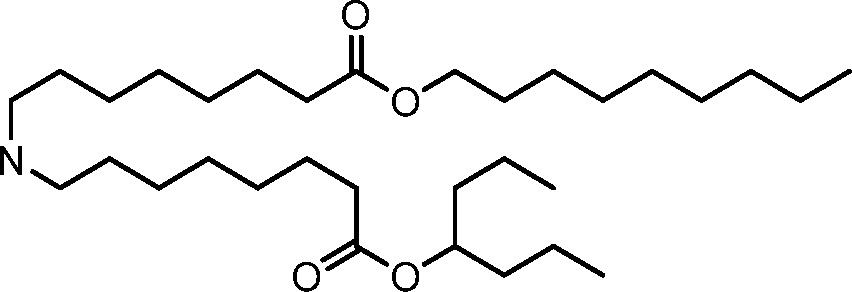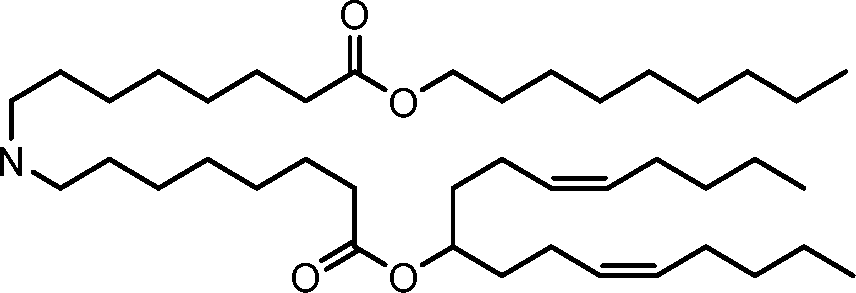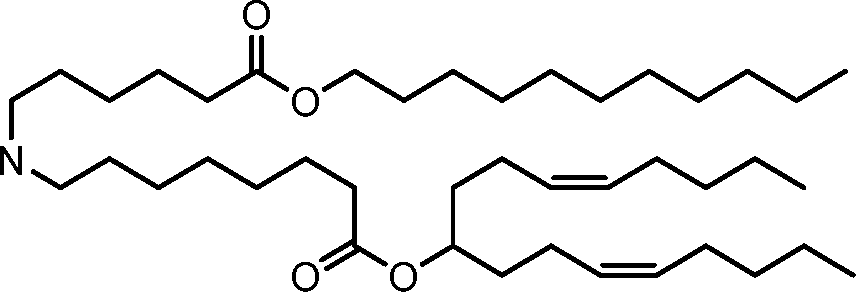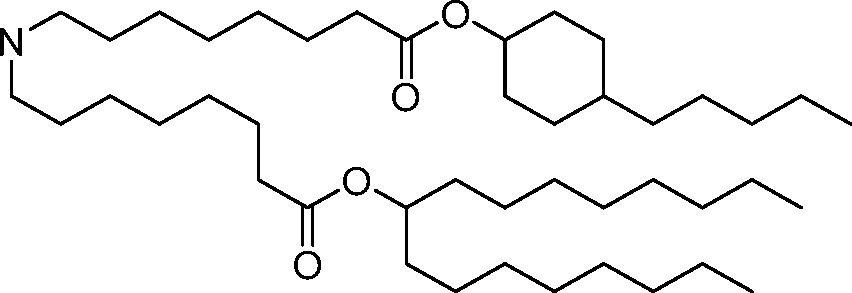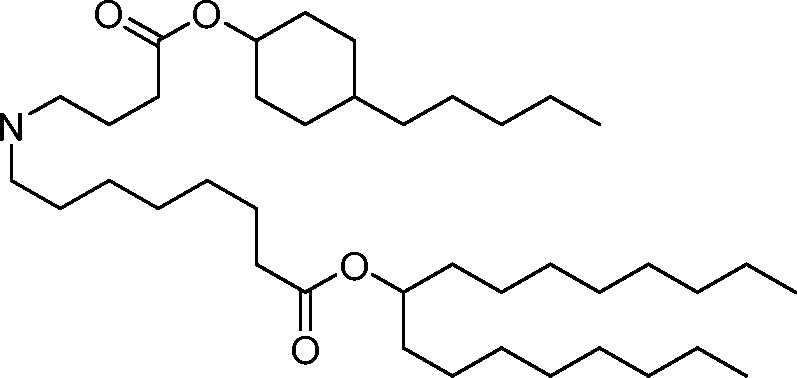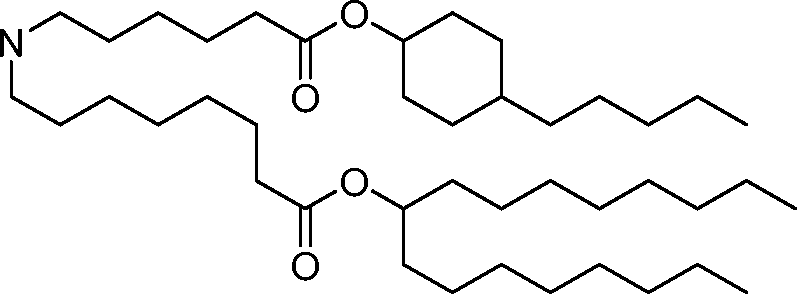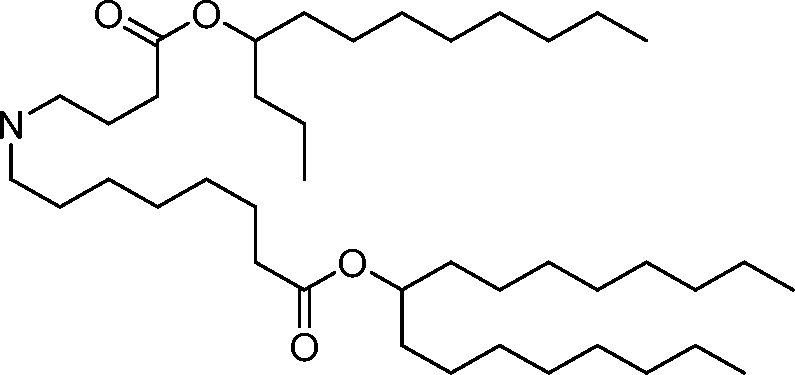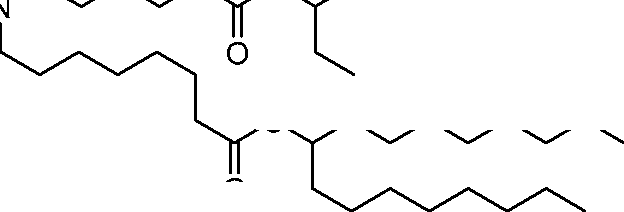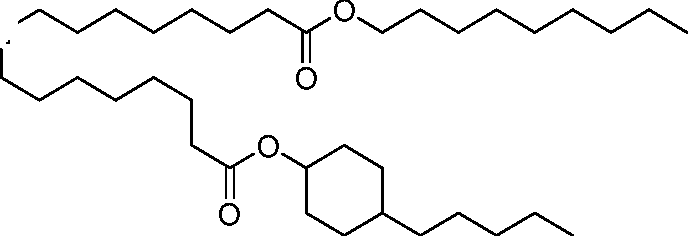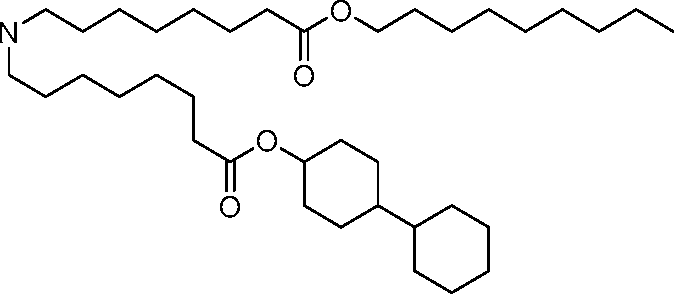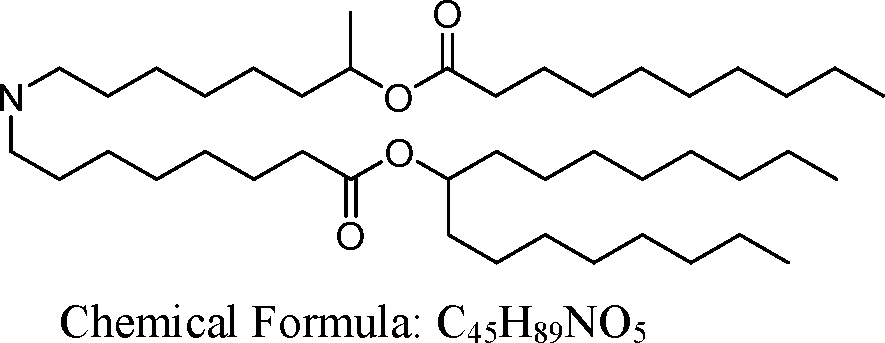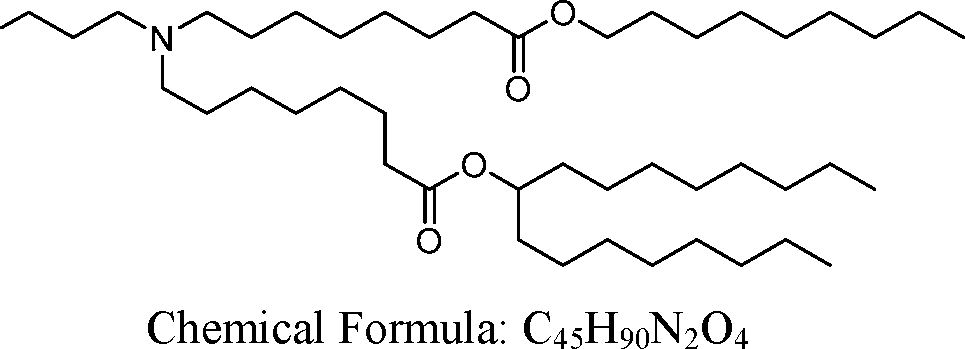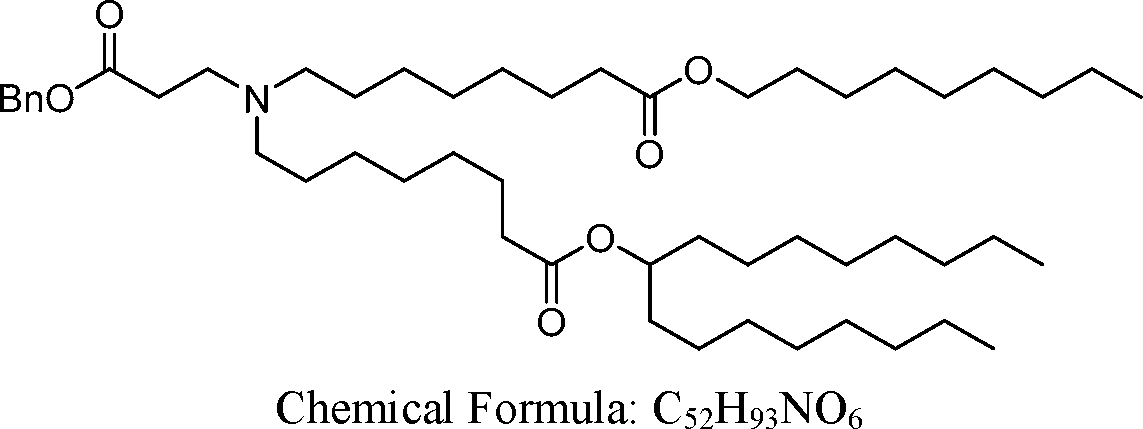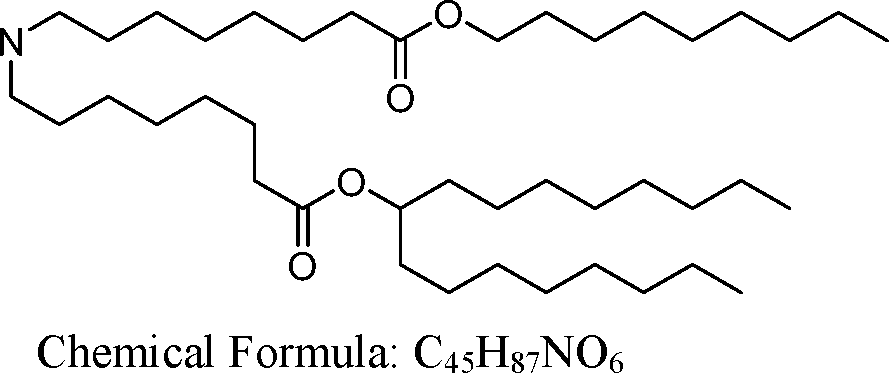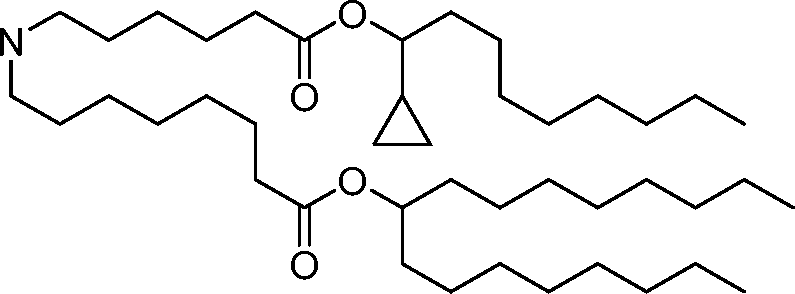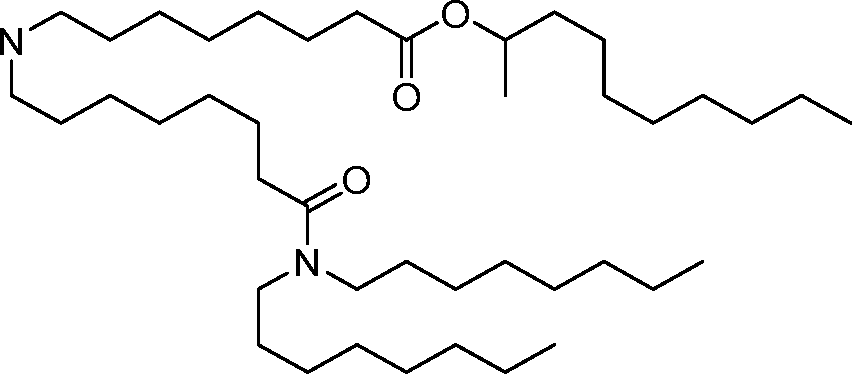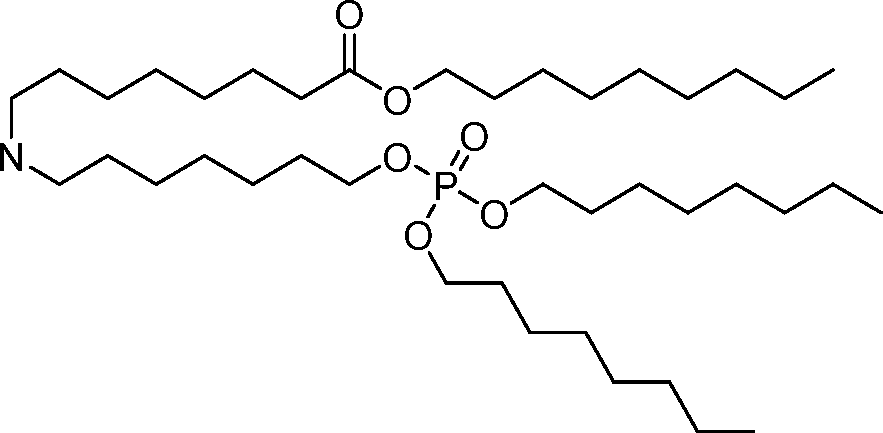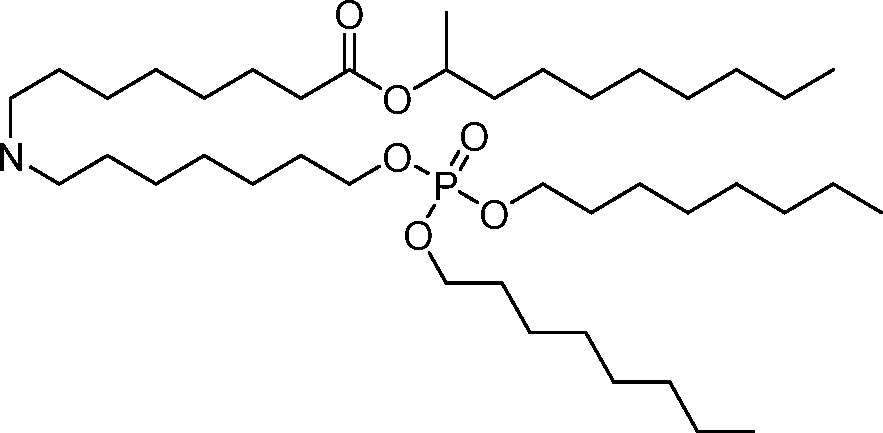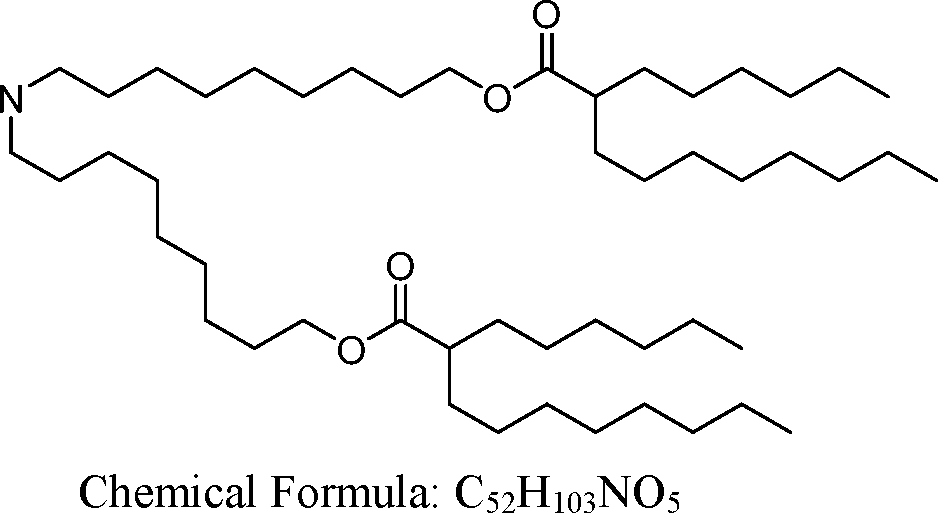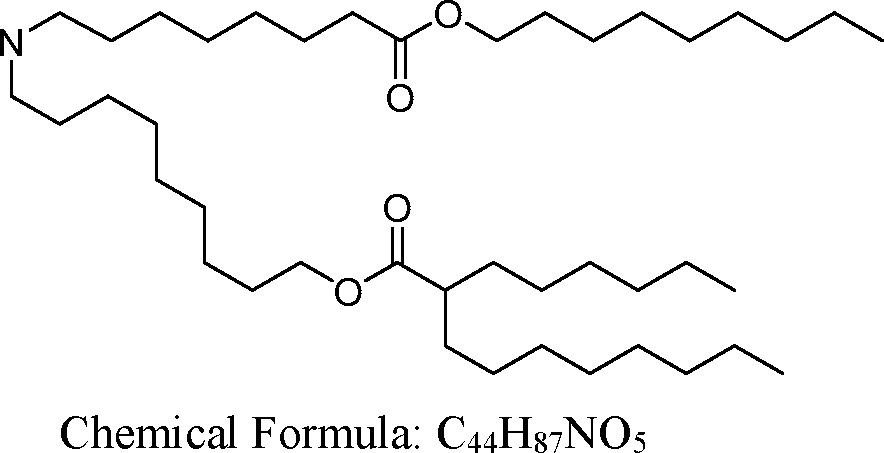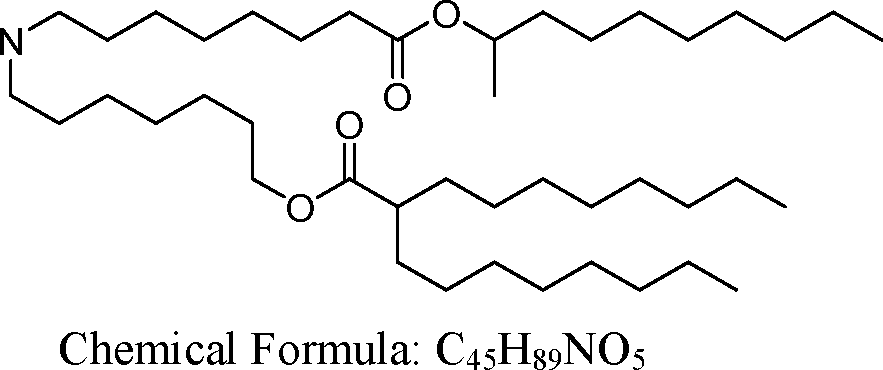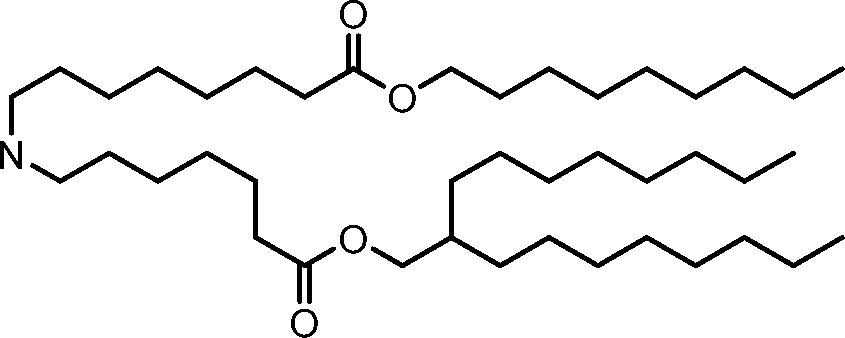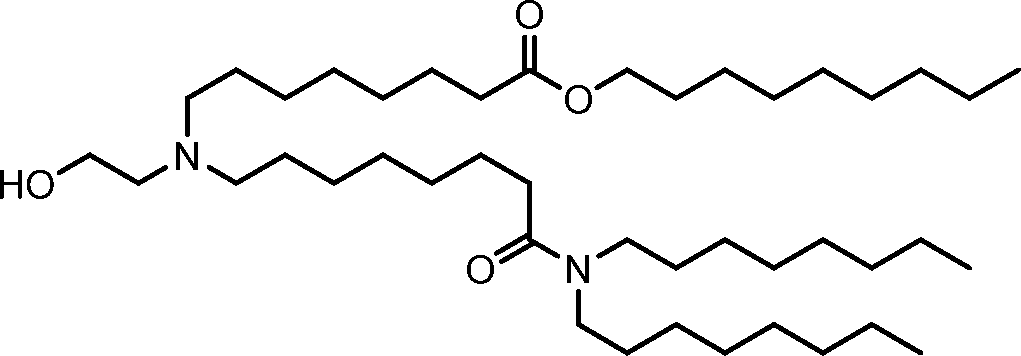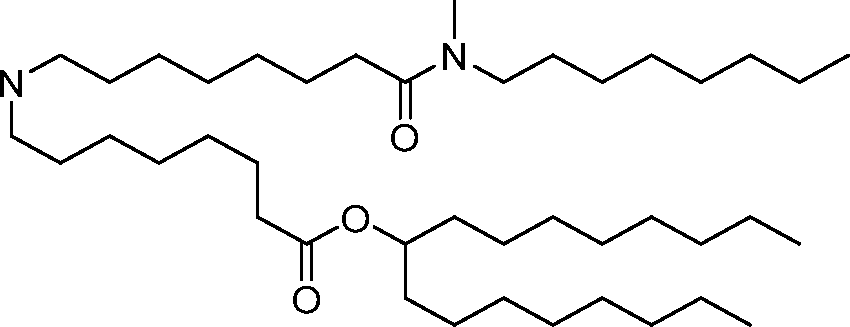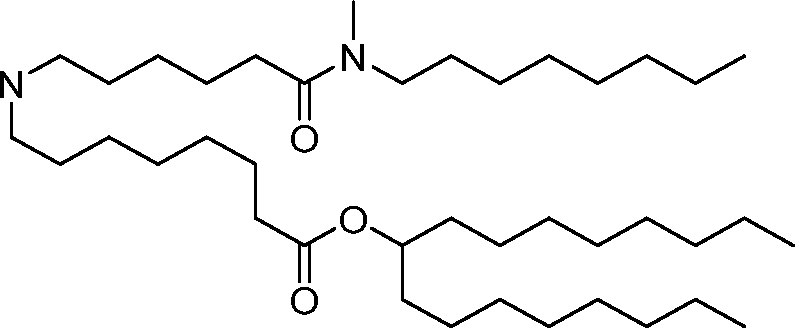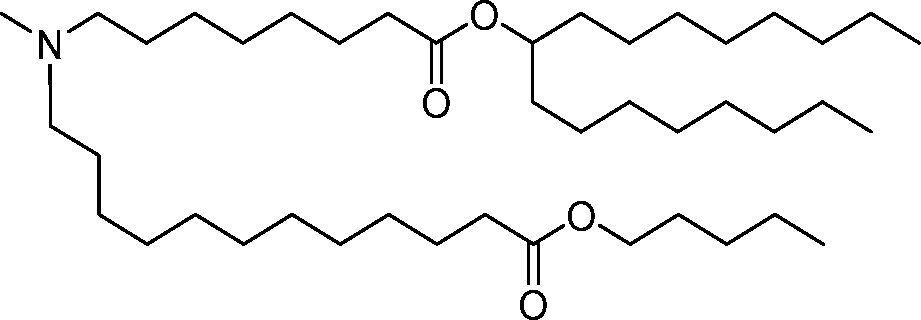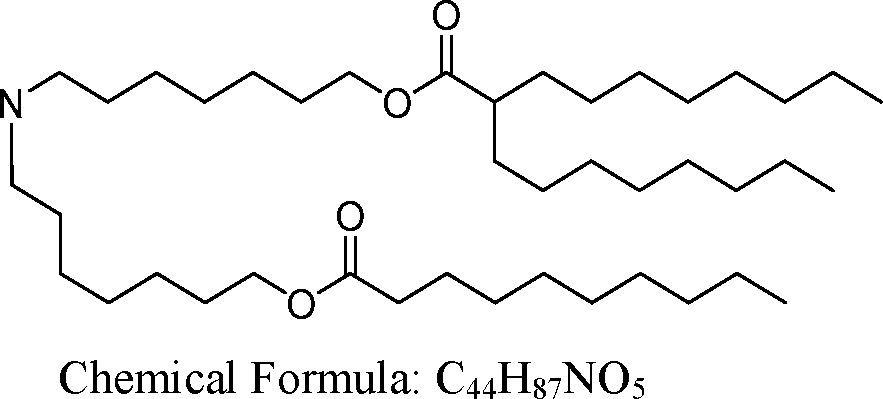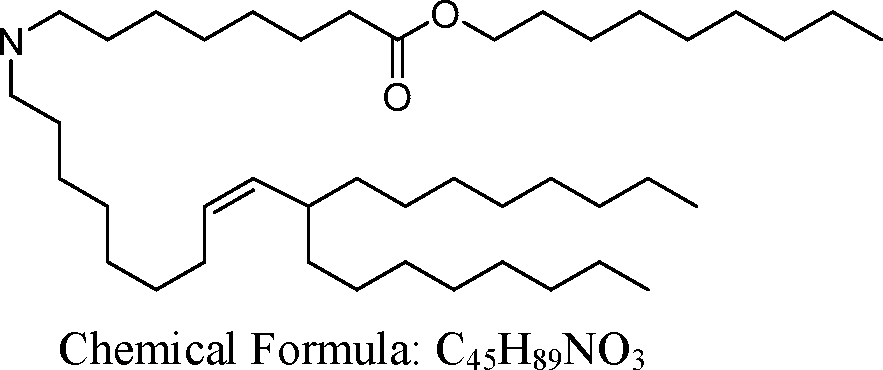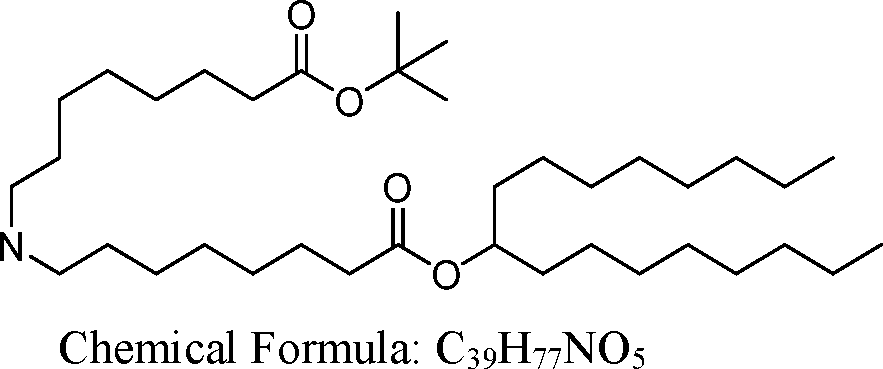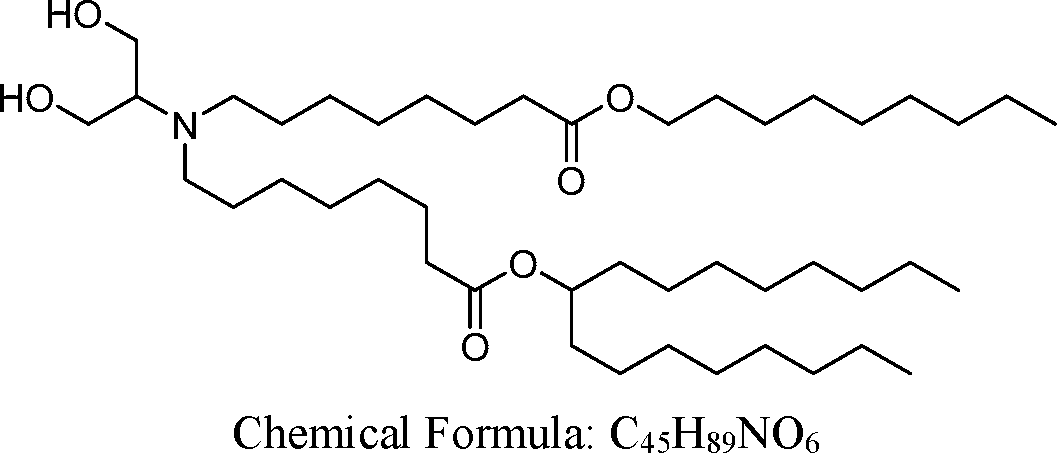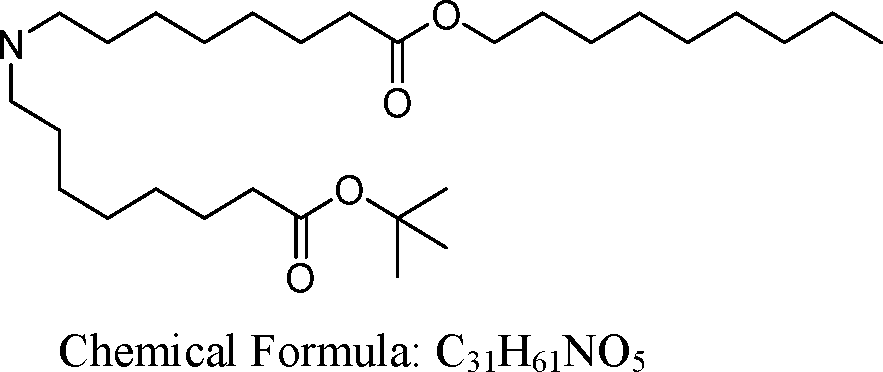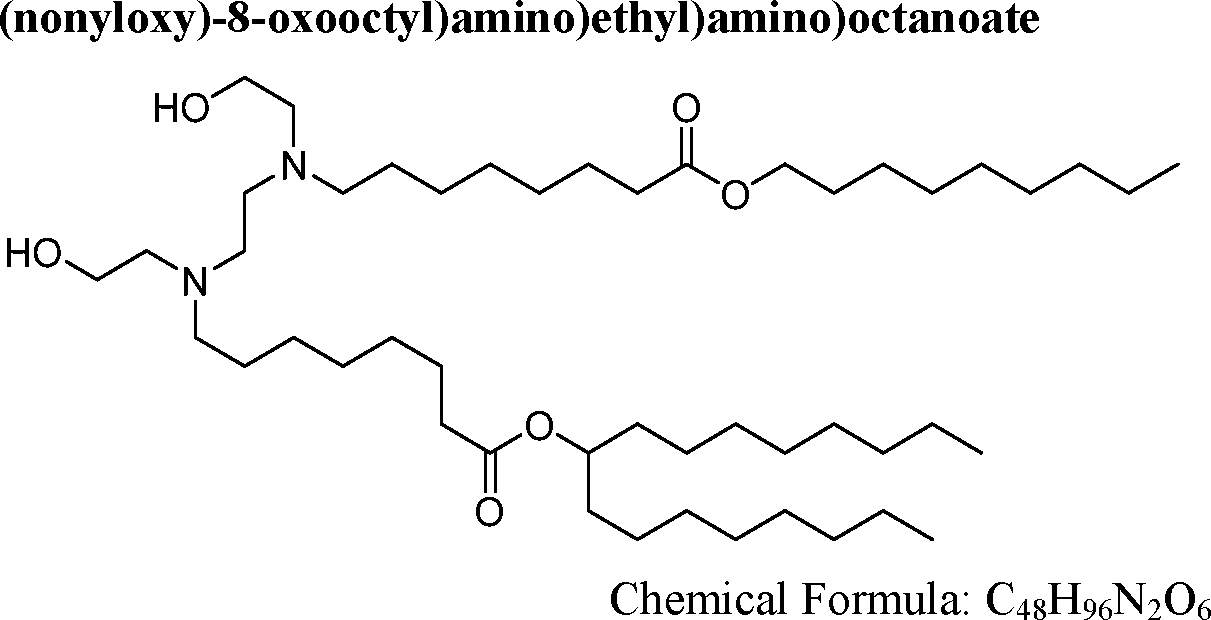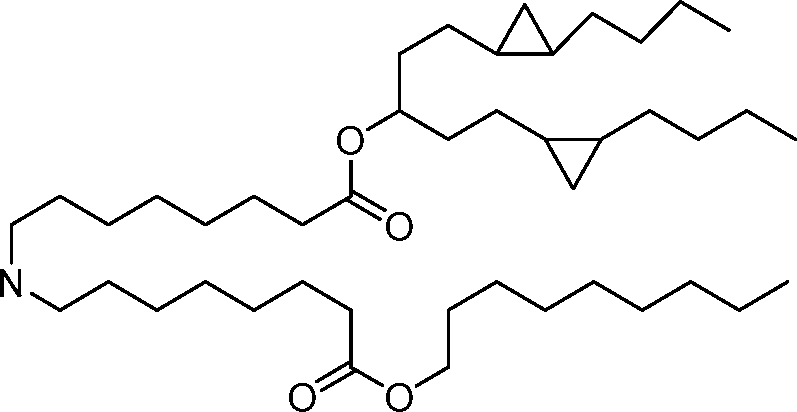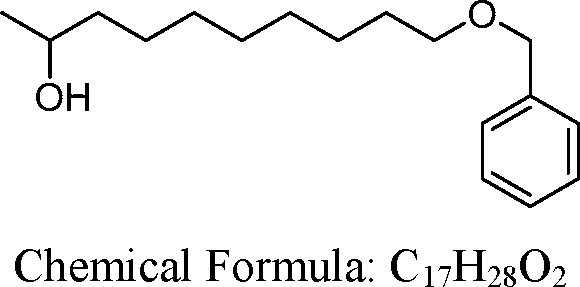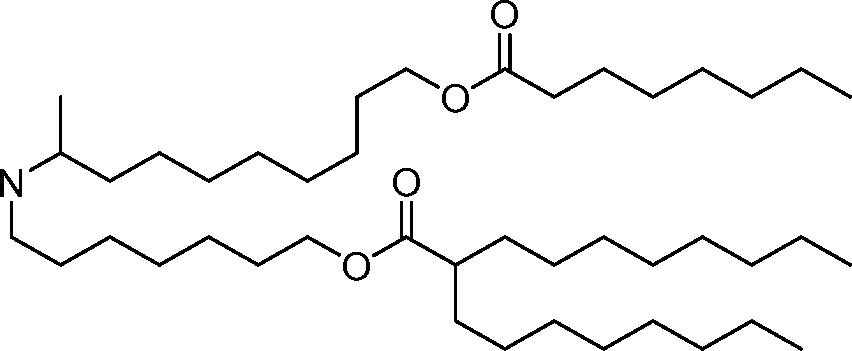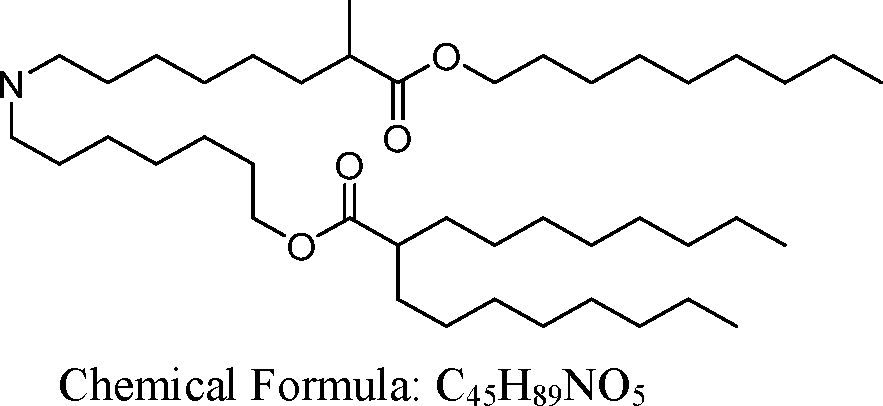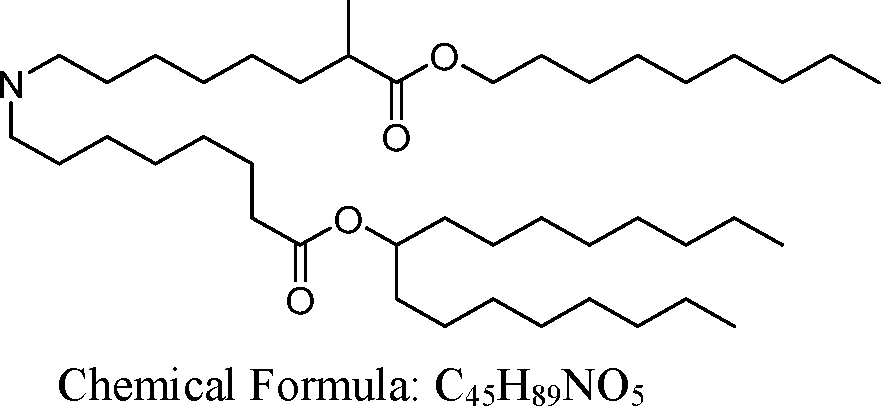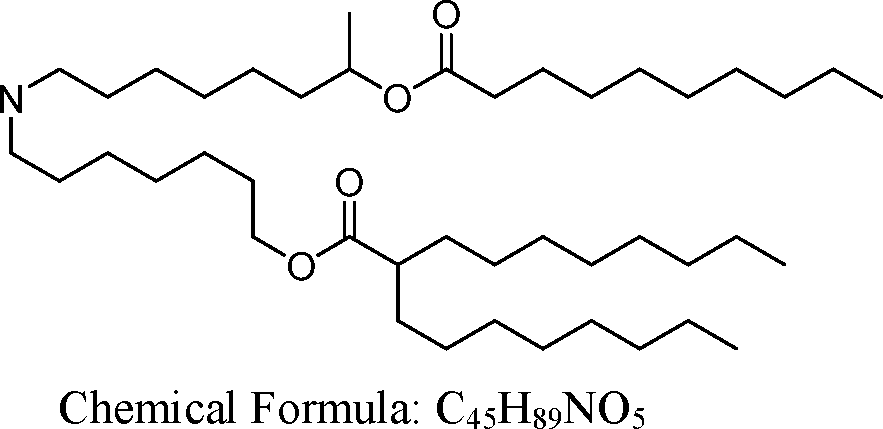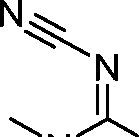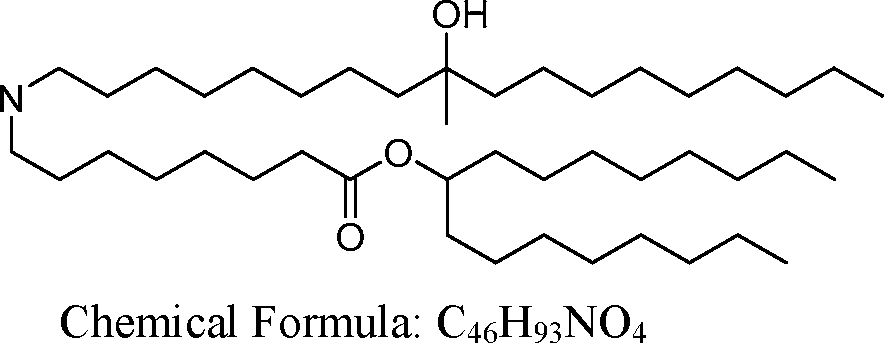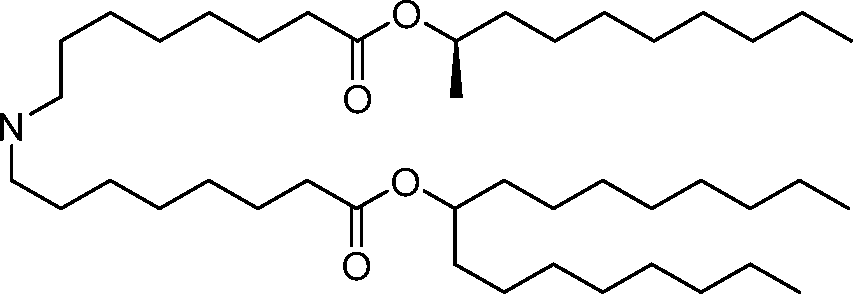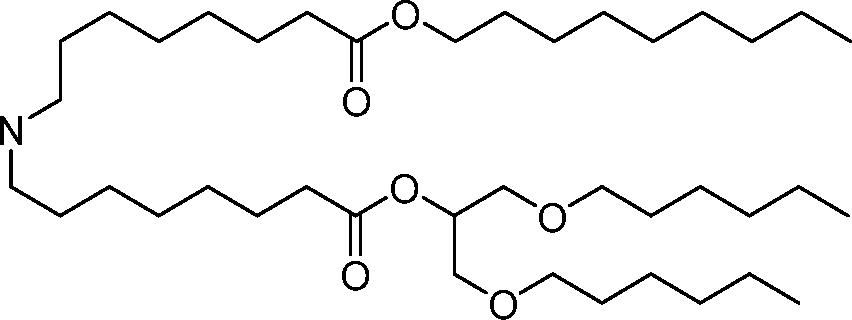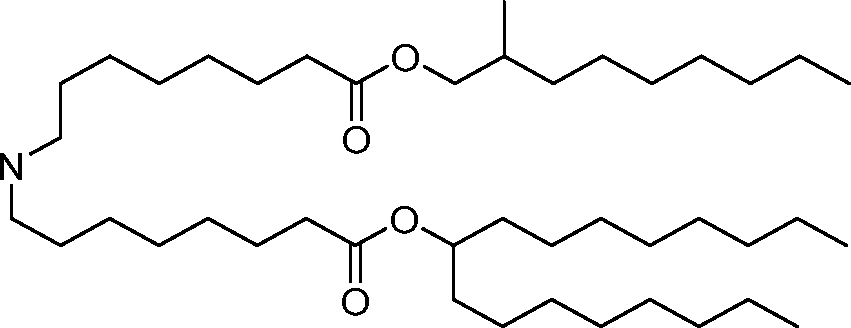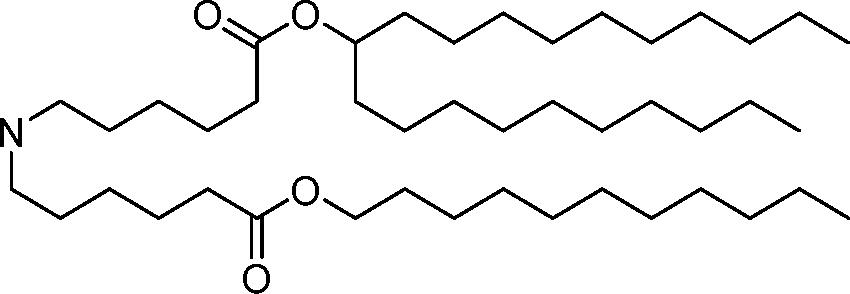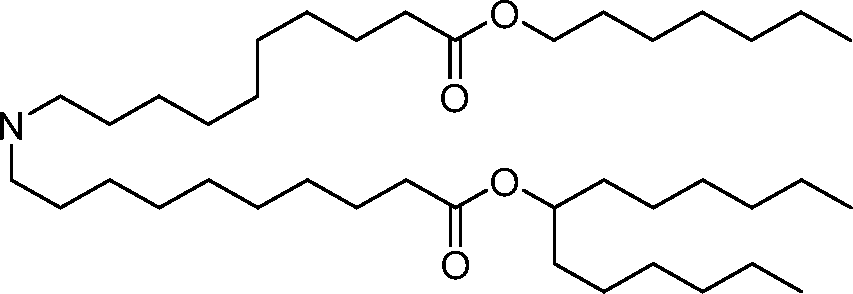AU2016324310A1 - Compounds and compositions for intracellular delivery of therapeutic agents - Google Patents
Compounds and compositions for intracellular delivery of therapeutic agents Download PDFInfo
- Publication number
- AU2016324310A1 AU2016324310A1 AU2016324310A AU2016324310A AU2016324310A1 AU 2016324310 A1 AU2016324310 A1 AU 2016324310A1 AU 2016324310 A AU2016324310 A AU 2016324310A AU 2016324310 A AU2016324310 A AU 2016324310A AU 2016324310 A1 AU2016324310 A1 AU 2016324310A1
- Authority
- AU
- Australia
- Prior art keywords
- compound
- alkyl
- group
- nanoparticle composition
- pct
- Prior art date
- Legal status (The legal status is an assumption and is not a legal conclusion. Google has not performed a legal analysis and makes no representation as to the accuracy of the status listed.)
- Granted
Links
- KSABSWDGKZRLGW-UHFFFAOYSA-N CCCCCCCCCOC(CCCCCCCN(CCCCCCCC(OC(CCCCCC)CCCCCCC)=O)CCCNS(C)(=O)=O)=O Chemical compound CCCCCCCCCOC(CCCCCCCN(CCCCCCCC(OC(CCCCCC)CCCCCCC)=O)CCCNS(C)(=O)=O)=O KSABSWDGKZRLGW-UHFFFAOYSA-N 0.000 description 1
- NPYQOTPVFZENDO-UHFFFAOYSA-N CCCCCCCCCOC(CCCCCCCN(CCCCCCCC(OC(CCCCCCCC)CCCCCCCC)=O)CCCC/C(/N)=N/S(N)(=O)=O)=O Chemical compound CCCCCCCCCOC(CCCCCCCN(CCCCCCCC(OC(CCCCCCCC)CCCCCCCC)=O)CCCC/C(/N)=N/S(N)(=O)=O)=O NPYQOTPVFZENDO-UHFFFAOYSA-N 0.000 description 1
- UHJKJZZOKMWGOW-UHFFFAOYSA-N CCCCCCCCCOC(CCCCCCCN(CCCCCCCC(OC(CCCCCCCC)CCCCCCCC)=O)CCCN(O)S(C)(=C)=O)=O Chemical compound CCCCCCCCCOC(CCCCCCCN(CCCCCCCC(OC(CCCCCCCC)CCCCCCCC)=O)CCCN(O)S(C)(=C)=O)=O UHJKJZZOKMWGOW-UHFFFAOYSA-N 0.000 description 1
- MJSZVXRFQREXJJ-AGWFHUCLSA-N CCCCCCCCCOC(CCCCCCCN(CCCCCCCC(OC(CCCCCCCC)CCCCCCCC)=O)CCCN/C(/NC)=C/[N+]([O-])=O)=O Chemical compound CCCCCCCCCOC(CCCCCCCN(CCCCCCCC(OC(CCCCCCCC)CCCCCCCC)=O)CCCN/C(/NC)=C/[N+]([O-])=O)=O MJSZVXRFQREXJJ-AGWFHUCLSA-N 0.000 description 1
- KWAAFWAKOSBTRP-UHFFFAOYSA-N CCCCCCCCCOC(CCCCCCCN(CCCCCCCC(OC(CCCCCCCC)CCCCCCCC)=O)CCCN/C(/NC)=N/[N+]([O-])=O)=O Chemical compound CCCCCCCCCOC(CCCCCCCN(CCCCCCCC(OC(CCCCCCCC)CCCCCCCC)=O)CCCN/C(/NC)=N/[N+]([O-])=O)=O KWAAFWAKOSBTRP-UHFFFAOYSA-N 0.000 description 1
- HUCKZTUSBWFTSU-UHFFFAOYSA-N CCCCCCCCCOC(CCCCCCCNCCCCCCCC(OC(C)(C)C)=O)=O Chemical compound CCCCCCCCCOC(CCCCCCCNCCCCCCCC(OC(C)(C)C)=O)=O HUCKZTUSBWFTSU-UHFFFAOYSA-N 0.000 description 1
Classifications
-
- C—CHEMISTRY; METALLURGY
- C07—ORGANIC CHEMISTRY
- C07C—ACYCLIC OR CARBOCYCLIC COMPOUNDS
- C07C229/00—Compounds containing amino and carboxyl groups bound to the same carbon skeleton
- C07C229/02—Compounds containing amino and carboxyl groups bound to the same carbon skeleton having amino and carboxyl groups bound to acyclic carbon atoms of the same carbon skeleton
- C07C229/04—Compounds containing amino and carboxyl groups bound to the same carbon skeleton having amino and carboxyl groups bound to acyclic carbon atoms of the same carbon skeleton the carbon skeleton being acyclic and saturated
- C07C229/06—Compounds containing amino and carboxyl groups bound to the same carbon skeleton having amino and carboxyl groups bound to acyclic carbon atoms of the same carbon skeleton the carbon skeleton being acyclic and saturated having only one amino and one carboxyl group bound to the carbon skeleton
- C07C229/10—Compounds containing amino and carboxyl groups bound to the same carbon skeleton having amino and carboxyl groups bound to acyclic carbon atoms of the same carbon skeleton the carbon skeleton being acyclic and saturated having only one amino and one carboxyl group bound to the carbon skeleton the nitrogen atom of the amino group being further bound to acyclic carbon atoms or to carbon atoms of rings other than six-membered aromatic rings
- C07C229/12—Compounds containing amino and carboxyl groups bound to the same carbon skeleton having amino and carboxyl groups bound to acyclic carbon atoms of the same carbon skeleton the carbon skeleton being acyclic and saturated having only one amino and one carboxyl group bound to the carbon skeleton the nitrogen atom of the amino group being further bound to acyclic carbon atoms or to carbon atoms of rings other than six-membered aromatic rings to carbon atoms of acyclic carbon skeletons
-
- A—HUMAN NECESSITIES
- A61—MEDICAL OR VETERINARY SCIENCE; HYGIENE
- A61K—PREPARATIONS FOR MEDICAL, DENTAL OR TOILETRY PURPOSES
- A61K31/00—Medicinal preparations containing organic active ingredients
- A61K31/70—Carbohydrates; Sugars; Derivatives thereof
- A61K31/7088—Compounds having three or more nucleosides or nucleotides
- A61K31/7105—Natural ribonucleic acids, i.e. containing only riboses attached to adenine, guanine, cytosine or uracil and having 3'-5' phosphodiester links
-
- A—HUMAN NECESSITIES
- A61—MEDICAL OR VETERINARY SCIENCE; HYGIENE
- A61K—PREPARATIONS FOR MEDICAL, DENTAL OR TOILETRY PURPOSES
- A61K38/00—Medicinal preparations containing peptides
- A61K38/16—Peptides having more than 20 amino acids; Gastrins; Somatostatins; Melanotropins; Derivatives thereof
- A61K38/17—Peptides having more than 20 amino acids; Gastrins; Somatostatins; Melanotropins; Derivatives thereof from animals; from humans
- A61K38/1703—Peptides having more than 20 amino acids; Gastrins; Somatostatins; Melanotropins; Derivatives thereof from animals; from humans from vertebrates
- A61K38/1709—Peptides having more than 20 amino acids; Gastrins; Somatostatins; Melanotropins; Derivatives thereof from animals; from humans from vertebrates from mammals
- A61K38/1725—Complement proteins, e.g. anaphylatoxin, C3a or C5a
-
- A—HUMAN NECESSITIES
- A61—MEDICAL OR VETERINARY SCIENCE; HYGIENE
- A61K—PREPARATIONS FOR MEDICAL, DENTAL OR TOILETRY PURPOSES
- A61K38/00—Medicinal preparations containing peptides
- A61K38/16—Peptides having more than 20 amino acids; Gastrins; Somatostatins; Melanotropins; Derivatives thereof
- A61K38/17—Peptides having more than 20 amino acids; Gastrins; Somatostatins; Melanotropins; Derivatives thereof from animals; from humans
- A61K38/18—Growth factors; Growth regulators
- A61K38/1816—Erythropoietin [EPO]
-
- A—HUMAN NECESSITIES
- A61—MEDICAL OR VETERINARY SCIENCE; HYGIENE
- A61K—PREPARATIONS FOR MEDICAL, DENTAL OR TOILETRY PURPOSES
- A61K47/00—Medicinal preparations characterised by the non-active ingredients used, e.g. carriers or inert additives; Targeting or modifying agents chemically bound to the active ingredient
- A61K47/50—Medicinal preparations characterised by the non-active ingredients used, e.g. carriers or inert additives; Targeting or modifying agents chemically bound to the active ingredient the non-active ingredient being chemically bound to the active ingredient, e.g. polymer-drug conjugates
- A61K47/51—Medicinal preparations characterised by the non-active ingredients used, e.g. carriers or inert additives; Targeting or modifying agents chemically bound to the active ingredient the non-active ingredient being chemically bound to the active ingredient, e.g. polymer-drug conjugates the non-active ingredient being a modifying agent
- A61K47/54—Medicinal preparations characterised by the non-active ingredients used, e.g. carriers or inert additives; Targeting or modifying agents chemically bound to the active ingredient the non-active ingredient being chemically bound to the active ingredient, e.g. polymer-drug conjugates the non-active ingredient being a modifying agent the modifying agent being an organic compound
- A61K47/543—Lipids, e.g. triglycerides; Polyamines, e.g. spermine or spermidine
-
- A—HUMAN NECESSITIES
- A61—MEDICAL OR VETERINARY SCIENCE; HYGIENE
- A61K—PREPARATIONS FOR MEDICAL, DENTAL OR TOILETRY PURPOSES
- A61K47/00—Medicinal preparations characterised by the non-active ingredients used, e.g. carriers or inert additives; Targeting or modifying agents chemically bound to the active ingredient
- A61K47/50—Medicinal preparations characterised by the non-active ingredients used, e.g. carriers or inert additives; Targeting or modifying agents chemically bound to the active ingredient the non-active ingredient being chemically bound to the active ingredient, e.g. polymer-drug conjugates
- A61K47/69—Medicinal preparations characterised by the non-active ingredients used, e.g. carriers or inert additives; Targeting or modifying agents chemically bound to the active ingredient the non-active ingredient being chemically bound to the active ingredient, e.g. polymer-drug conjugates the conjugate being characterised by physical or galenical forms, e.g. emulsion, particle, inclusion complex, stent or kit
- A61K47/6905—Medicinal preparations characterised by the non-active ingredients used, e.g. carriers or inert additives; Targeting or modifying agents chemically bound to the active ingredient the non-active ingredient being chemically bound to the active ingredient, e.g. polymer-drug conjugates the conjugate being characterised by physical or galenical forms, e.g. emulsion, particle, inclusion complex, stent or kit the form being a colloid or an emulsion
- A61K47/6911—Medicinal preparations characterised by the non-active ingredients used, e.g. carriers or inert additives; Targeting or modifying agents chemically bound to the active ingredient the non-active ingredient being chemically bound to the active ingredient, e.g. polymer-drug conjugates the conjugate being characterised by physical or galenical forms, e.g. emulsion, particle, inclusion complex, stent or kit the form being a colloid or an emulsion the form being a liposome
-
- A—HUMAN NECESSITIES
- A61—MEDICAL OR VETERINARY SCIENCE; HYGIENE
- A61K—PREPARATIONS FOR MEDICAL, DENTAL OR TOILETRY PURPOSES
- A61K48/00—Medicinal preparations containing genetic material which is inserted into cells of the living body to treat genetic diseases; Gene therapy
- A61K48/0008—Medicinal preparations containing genetic material which is inserted into cells of the living body to treat genetic diseases; Gene therapy characterised by an aspect of the 'non-active' part of the composition delivered, e.g. wherein such 'non-active' part is not delivered simultaneously with the 'active' part of the composition
- A61K48/0025—Medicinal preparations containing genetic material which is inserted into cells of the living body to treat genetic diseases; Gene therapy characterised by an aspect of the 'non-active' part of the composition delivered, e.g. wherein such 'non-active' part is not delivered simultaneously with the 'active' part of the composition wherein the non-active part clearly interacts with the delivered nucleic acid
- A61K48/0033—Medicinal preparations containing genetic material which is inserted into cells of the living body to treat genetic diseases; Gene therapy characterised by an aspect of the 'non-active' part of the composition delivered, e.g. wherein such 'non-active' part is not delivered simultaneously with the 'active' part of the composition wherein the non-active part clearly interacts with the delivered nucleic acid the non-active part being non-polymeric
-
- A—HUMAN NECESSITIES
- A61—MEDICAL OR VETERINARY SCIENCE; HYGIENE
- A61K—PREPARATIONS FOR MEDICAL, DENTAL OR TOILETRY PURPOSES
- A61K48/00—Medicinal preparations containing genetic material which is inserted into cells of the living body to treat genetic diseases; Gene therapy
- A61K48/005—Medicinal preparations containing genetic material which is inserted into cells of the living body to treat genetic diseases; Gene therapy characterised by an aspect of the 'active' part of the composition delivered, i.e. the nucleic acid delivered
-
- A—HUMAN NECESSITIES
- A61—MEDICAL OR VETERINARY SCIENCE; HYGIENE
- A61K—PREPARATIONS FOR MEDICAL, DENTAL OR TOILETRY PURPOSES
- A61K9/00—Medicinal preparations characterised by special physical form
- A61K9/0012—Galenical forms characterised by the site of application
- A61K9/0019—Injectable compositions; Intramuscular, intravenous, arterial, subcutaneous administration; Compositions to be administered through the skin in an invasive manner
-
- A—HUMAN NECESSITIES
- A61—MEDICAL OR VETERINARY SCIENCE; HYGIENE
- A61K—PREPARATIONS FOR MEDICAL, DENTAL OR TOILETRY PURPOSES
- A61K9/00—Medicinal preparations characterised by special physical form
- A61K9/0012—Galenical forms characterised by the site of application
- A61K9/0043—Nose
-
- A—HUMAN NECESSITIES
- A61—MEDICAL OR VETERINARY SCIENCE; HYGIENE
- A61K—PREPARATIONS FOR MEDICAL, DENTAL OR TOILETRY PURPOSES
- A61K9/00—Medicinal preparations characterised by special physical form
- A61K9/0012—Galenical forms characterised by the site of application
- A61K9/007—Pulmonary tract; Aromatherapy
- A61K9/0073—Sprays or powders for inhalation; Aerolised or nebulised preparations generated by other means than thermal energy
-
- A—HUMAN NECESSITIES
- A61—MEDICAL OR VETERINARY SCIENCE; HYGIENE
- A61K—PREPARATIONS FOR MEDICAL, DENTAL OR TOILETRY PURPOSES
- A61K9/00—Medicinal preparations characterised by special physical form
- A61K9/10—Dispersions; Emulsions
- A61K9/127—Liposomes
-
- A—HUMAN NECESSITIES
- A61—MEDICAL OR VETERINARY SCIENCE; HYGIENE
- A61K—PREPARATIONS FOR MEDICAL, DENTAL OR TOILETRY PURPOSES
- A61K9/00—Medicinal preparations characterised by special physical form
- A61K9/10—Dispersions; Emulsions
- A61K9/127—Liposomes
- A61K9/1271—Non-conventional liposomes, e.g. PEGylated liposomes, liposomes coated with polymers
- A61K9/1272—Non-conventional liposomes, e.g. PEGylated liposomes, liposomes coated with polymers with substantial amounts of non-phosphatidyl, i.e. non-acylglycerophosphate, surfactants as bilayer-forming substances, e.g. cationic lipids
-
- A—HUMAN NECESSITIES
- A61—MEDICAL OR VETERINARY SCIENCE; HYGIENE
- A61K—PREPARATIONS FOR MEDICAL, DENTAL OR TOILETRY PURPOSES
- A61K9/00—Medicinal preparations characterised by special physical form
- A61K9/14—Particulate form, e.g. powders, Processes for size reducing of pure drugs or the resulting products, Pure drug nanoparticles
- A61K9/16—Agglomerates; Granulates; Microbeadlets ; Microspheres; Pellets; Solid products obtained by spray drying, spray freeze drying, spray congealing,(multiple) emulsion solvent evaporation or extraction
- A61K9/1605—Excipients; Inactive ingredients
- A61K9/1617—Organic compounds, e.g. phospholipids, fats
-
- A—HUMAN NECESSITIES
- A61—MEDICAL OR VETERINARY SCIENCE; HYGIENE
- A61K—PREPARATIONS FOR MEDICAL, DENTAL OR TOILETRY PURPOSES
- A61K9/00—Medicinal preparations characterised by special physical form
- A61K9/14—Particulate form, e.g. powders, Processes for size reducing of pure drugs or the resulting products, Pure drug nanoparticles
- A61K9/16—Agglomerates; Granulates; Microbeadlets ; Microspheres; Pellets; Solid products obtained by spray drying, spray freeze drying, spray congealing,(multiple) emulsion solvent evaporation or extraction
- A61K9/1605—Excipients; Inactive ingredients
- A61K9/1629—Organic macromolecular compounds
- A61K9/1641—Organic macromolecular compounds obtained otherwise than by reactions only involving carbon-to-carbon unsaturated bonds, e.g. polyethylene glycol, poloxamers
-
- A—HUMAN NECESSITIES
- A61—MEDICAL OR VETERINARY SCIENCE; HYGIENE
- A61K—PREPARATIONS FOR MEDICAL, DENTAL OR TOILETRY PURPOSES
- A61K9/00—Medicinal preparations characterised by special physical form
- A61K9/48—Preparations in capsules, e.g. of gelatin, of chocolate
- A61K9/50—Microcapsules having a gas, liquid or semi-solid filling; Solid microparticles or pellets surrounded by a distinct coating layer, e.g. coated microspheres, coated drug crystals
- A61K9/51—Nanocapsules; Nanoparticles
- A61K9/5107—Excipients; Inactive ingredients
- A61K9/5123—Organic compounds, e.g. fats, sugars
-
- A—HUMAN NECESSITIES
- A61—MEDICAL OR VETERINARY SCIENCE; HYGIENE
- A61K—PREPARATIONS FOR MEDICAL, DENTAL OR TOILETRY PURPOSES
- A61K9/00—Medicinal preparations characterised by special physical form
- A61K9/48—Preparations in capsules, e.g. of gelatin, of chocolate
- A61K9/50—Microcapsules having a gas, liquid or semi-solid filling; Solid microparticles or pellets surrounded by a distinct coating layer, e.g. coated microspheres, coated drug crystals
- A61K9/51—Nanocapsules; Nanoparticles
- A61K9/5107—Excipients; Inactive ingredients
- A61K9/513—Organic macromolecular compounds; Dendrimers
- A61K9/5146—Organic macromolecular compounds; Dendrimers obtained otherwise than by reactions only involving carbon-to-carbon unsaturated bonds, e.g. polyethylene glycol, polyamines, polyanhydrides
-
- A—HUMAN NECESSITIES
- A61—MEDICAL OR VETERINARY SCIENCE; HYGIENE
- A61P—SPECIFIC THERAPEUTIC ACTIVITY OF CHEMICAL COMPOUNDS OR MEDICINAL PREPARATIONS
- A61P25/00—Drugs for disorders of the nervous system
-
- A—HUMAN NECESSITIES
- A61—MEDICAL OR VETERINARY SCIENCE; HYGIENE
- A61P—SPECIFIC THERAPEUTIC ACTIVITY OF CHEMICAL COMPOUNDS OR MEDICINAL PREPARATIONS
- A61P3/00—Drugs for disorders of the metabolism
-
- A—HUMAN NECESSITIES
- A61—MEDICAL OR VETERINARY SCIENCE; HYGIENE
- A61P—SPECIFIC THERAPEUTIC ACTIVITY OF CHEMICAL COMPOUNDS OR MEDICINAL PREPARATIONS
- A61P3/00—Drugs for disorders of the metabolism
- A61P3/08—Drugs for disorders of the metabolism for glucose homeostasis
- A61P3/10—Drugs for disorders of the metabolism for glucose homeostasis for hyperglycaemia, e.g. antidiabetics
-
- A—HUMAN NECESSITIES
- A61—MEDICAL OR VETERINARY SCIENCE; HYGIENE
- A61P—SPECIFIC THERAPEUTIC ACTIVITY OF CHEMICAL COMPOUNDS OR MEDICINAL PREPARATIONS
- A61P31/00—Antiinfectives, i.e. antibiotics, antiseptics, chemotherapeutics
-
- A—HUMAN NECESSITIES
- A61—MEDICAL OR VETERINARY SCIENCE; HYGIENE
- A61P—SPECIFIC THERAPEUTIC ACTIVITY OF CHEMICAL COMPOUNDS OR MEDICINAL PREPARATIONS
- A61P35/00—Antineoplastic agents
-
- A—HUMAN NECESSITIES
- A61—MEDICAL OR VETERINARY SCIENCE; HYGIENE
- A61P—SPECIFIC THERAPEUTIC ACTIVITY OF CHEMICAL COMPOUNDS OR MEDICINAL PREPARATIONS
- A61P37/00—Drugs for immunological or allergic disorders
- A61P37/02—Immunomodulators
- A61P37/04—Immunostimulants
-
- A—HUMAN NECESSITIES
- A61—MEDICAL OR VETERINARY SCIENCE; HYGIENE
- A61P—SPECIFIC THERAPEUTIC ACTIVITY OF CHEMICAL COMPOUNDS OR MEDICINAL PREPARATIONS
- A61P37/00—Drugs for immunological or allergic disorders
- A61P37/02—Immunomodulators
- A61P37/06—Immunosuppressants, e.g. drugs for graft rejection
-
- A—HUMAN NECESSITIES
- A61—MEDICAL OR VETERINARY SCIENCE; HYGIENE
- A61P—SPECIFIC THERAPEUTIC ACTIVITY OF CHEMICAL COMPOUNDS OR MEDICINAL PREPARATIONS
- A61P43/00—Drugs for specific purposes, not provided for in groups A61P1/00-A61P41/00
-
- A—HUMAN NECESSITIES
- A61—MEDICAL OR VETERINARY SCIENCE; HYGIENE
- A61P—SPECIFIC THERAPEUTIC ACTIVITY OF CHEMICAL COMPOUNDS OR MEDICINAL PREPARATIONS
- A61P9/00—Drugs for disorders of the cardiovascular system
-
- C—CHEMISTRY; METALLURGY
- C07—ORGANIC CHEMISTRY
- C07C—ACYCLIC OR CARBOCYCLIC COMPOUNDS
- C07C227/00—Preparation of compounds containing amino and carboxyl groups bound to the same carbon skeleton
- C07C227/14—Preparation of compounds containing amino and carboxyl groups bound to the same carbon skeleton from compounds containing already amino and carboxyl groups or derivatives thereof
- C07C227/16—Preparation of compounds containing amino and carboxyl groups bound to the same carbon skeleton from compounds containing already amino and carboxyl groups or derivatives thereof by reactions not involving the amino or carboxyl groups
-
- C—CHEMISTRY; METALLURGY
- C07—ORGANIC CHEMISTRY
- C07C—ACYCLIC OR CARBOCYCLIC COMPOUNDS
- C07C227/00—Preparation of compounds containing amino and carboxyl groups bound to the same carbon skeleton
- C07C227/14—Preparation of compounds containing amino and carboxyl groups bound to the same carbon skeleton from compounds containing already amino and carboxyl groups or derivatives thereof
- C07C227/18—Preparation of compounds containing amino and carboxyl groups bound to the same carbon skeleton from compounds containing already amino and carboxyl groups or derivatives thereof by reactions involving amino or carboxyl groups, e.g. hydrolysis of esters or amides, by formation of halides, salts or esters
-
- C—CHEMISTRY; METALLURGY
- C07—ORGANIC CHEMISTRY
- C07C—ACYCLIC OR CARBOCYCLIC COMPOUNDS
- C07C229/00—Compounds containing amino and carboxyl groups bound to the same carbon skeleton
- C07C229/02—Compounds containing amino and carboxyl groups bound to the same carbon skeleton having amino and carboxyl groups bound to acyclic carbon atoms of the same carbon skeleton
- C07C229/04—Compounds containing amino and carboxyl groups bound to the same carbon skeleton having amino and carboxyl groups bound to acyclic carbon atoms of the same carbon skeleton the carbon skeleton being acyclic and saturated
- C07C229/06—Compounds containing amino and carboxyl groups bound to the same carbon skeleton having amino and carboxyl groups bound to acyclic carbon atoms of the same carbon skeleton the carbon skeleton being acyclic and saturated having only one amino and one carboxyl group bound to the carbon skeleton
- C07C229/10—Compounds containing amino and carboxyl groups bound to the same carbon skeleton having amino and carboxyl groups bound to acyclic carbon atoms of the same carbon skeleton the carbon skeleton being acyclic and saturated having only one amino and one carboxyl group bound to the carbon skeleton the nitrogen atom of the amino group being further bound to acyclic carbon atoms or to carbon atoms of rings other than six-membered aromatic rings
- C07C229/16—Compounds containing amino and carboxyl groups bound to the same carbon skeleton having amino and carboxyl groups bound to acyclic carbon atoms of the same carbon skeleton the carbon skeleton being acyclic and saturated having only one amino and one carboxyl group bound to the carbon skeleton the nitrogen atom of the amino group being further bound to acyclic carbon atoms or to carbon atoms of rings other than six-membered aromatic rings to carbon atoms of hydrocarbon radicals substituted by amino or carboxyl groups, e.g. ethylenediamine-tetra-acetic acid, iminodiacetic acids
-
- C—CHEMISTRY; METALLURGY
- C07—ORGANIC CHEMISTRY
- C07C—ACYCLIC OR CARBOCYCLIC COMPOUNDS
- C07C233/00—Carboxylic acid amides
- C07C233/01—Carboxylic acid amides having carbon atoms of carboxamide groups bound to hydrogen atoms or to acyclic carbon atoms
- C07C233/34—Carboxylic acid amides having carbon atoms of carboxamide groups bound to hydrogen atoms or to acyclic carbon atoms having the nitrogen atom of at least one of the carboxamide groups bound to a carbon atom of a hydrocarbon radical substituted by amino groups
- C07C233/35—Carboxylic acid amides having carbon atoms of carboxamide groups bound to hydrogen atoms or to acyclic carbon atoms having the nitrogen atom of at least one of the carboxamide groups bound to a carbon atom of a hydrocarbon radical substituted by amino groups with the substituted hydrocarbon radical bound to the nitrogen atom of the carboxamide group by an acyclic carbon atom
- C07C233/36—Carboxylic acid amides having carbon atoms of carboxamide groups bound to hydrogen atoms or to acyclic carbon atoms having the nitrogen atom of at least one of the carboxamide groups bound to a carbon atom of a hydrocarbon radical substituted by amino groups with the substituted hydrocarbon radical bound to the nitrogen atom of the carboxamide group by an acyclic carbon atom having the carbon atom of the carboxamide group bound to a hydrogen atom or to a carbon atom of an acyclic saturated carbon skeleton
-
- C—CHEMISTRY; METALLURGY
- C07—ORGANIC CHEMISTRY
- C07C—ACYCLIC OR CARBOCYCLIC COMPOUNDS
- C07C233/00—Carboxylic acid amides
- C07C233/64—Carboxylic acid amides having carbon atoms of carboxamide groups bound to carbon atoms of six-membered aromatic rings
- C07C233/67—Carboxylic acid amides having carbon atoms of carboxamide groups bound to carbon atoms of six-membered aromatic rings having the nitrogen atom of at least one of the carboxamide groups bound to a carbon atom of a hydrocarbon radical substituted by singly-bound oxygen atoms
- C07C233/68—Carboxylic acid amides having carbon atoms of carboxamide groups bound to carbon atoms of six-membered aromatic rings having the nitrogen atom of at least one of the carboxamide groups bound to a carbon atom of a hydrocarbon radical substituted by singly-bound oxygen atoms with the substituted hydrocarbon radical bound to the nitrogen atom of the carboxamide group by an acyclic carbon atom
- C07C233/72—Carboxylic acid amides having carbon atoms of carboxamide groups bound to carbon atoms of six-membered aromatic rings having the nitrogen atom of at least one of the carboxamide groups bound to a carbon atom of a hydrocarbon radical substituted by singly-bound oxygen atoms with the substituted hydrocarbon radical bound to the nitrogen atom of the carboxamide group by an acyclic carbon atom of an unsaturated carbon skeleton containing rings other than six-membered aromatic rings
-
- C—CHEMISTRY; METALLURGY
- C07—ORGANIC CHEMISTRY
- C07C—ACYCLIC OR CARBOCYCLIC COMPOUNDS
- C07C235/00—Carboxylic acid amides, the carbon skeleton of the acid part being further substituted by oxygen atoms
- C07C235/02—Carboxylic acid amides, the carbon skeleton of the acid part being further substituted by oxygen atoms having carbon atoms of carboxamide groups bound to acyclic carbon atoms and singly-bound oxygen atoms bound to the same carbon skeleton
- C07C235/04—Carboxylic acid amides, the carbon skeleton of the acid part being further substituted by oxygen atoms having carbon atoms of carboxamide groups bound to acyclic carbon atoms and singly-bound oxygen atoms bound to the same carbon skeleton the carbon skeleton being acyclic and saturated
- C07C235/10—Carboxylic acid amides, the carbon skeleton of the acid part being further substituted by oxygen atoms having carbon atoms of carboxamide groups bound to acyclic carbon atoms and singly-bound oxygen atoms bound to the same carbon skeleton the carbon skeleton being acyclic and saturated having the nitrogen atom of at least one of the carboxamide groups bound to an acyclic carbon atom of a hydrocarbon radical substituted by nitrogen atoms not being part of nitro or nitroso groups
-
- C—CHEMISTRY; METALLURGY
- C07—ORGANIC CHEMISTRY
- C07C—ACYCLIC OR CARBOCYCLIC COMPOUNDS
- C07C255/00—Carboxylic acid nitriles
- C07C255/01—Carboxylic acid nitriles having cyano groups bound to acyclic carbon atoms
- C07C255/24—Carboxylic acid nitriles having cyano groups bound to acyclic carbon atoms containing cyano groups and singly-bound nitrogen atoms, not being further bound to other hetero atoms, bound to the same saturated acyclic carbon skeleton
-
- C—CHEMISTRY; METALLURGY
- C07—ORGANIC CHEMISTRY
- C07C—ACYCLIC OR CARBOCYCLIC COMPOUNDS
- C07C263/00—Preparation of derivatives of isocyanic acid
- C07C263/18—Separation; Purification; Stabilisation; Use of additives
- C07C263/20—Separation; Purification
-
- C—CHEMISTRY; METALLURGY
- C07—ORGANIC CHEMISTRY
- C07C—ACYCLIC OR CARBOCYCLIC COMPOUNDS
- C07C271/00—Derivatives of carbamic acids, i.e. compounds containing any of the groups, the nitrogen atom not being part of nitro or nitroso groups
- C07C271/06—Esters of carbamic acids
- C07C271/08—Esters of carbamic acids having oxygen atoms of carbamate groups bound to acyclic carbon atoms
- C07C271/10—Esters of carbamic acids having oxygen atoms of carbamate groups bound to acyclic carbon atoms with the nitrogen atoms of the carbamate groups bound to hydrogen atoms or to acyclic carbon atoms
- C07C271/20—Esters of carbamic acids having oxygen atoms of carbamate groups bound to acyclic carbon atoms with the nitrogen atoms of the carbamate groups bound to hydrogen atoms or to acyclic carbon atoms to carbon atoms of hydrocarbon radicals substituted by nitrogen atoms not being part of nitro or nitroso groups
-
- C—CHEMISTRY; METALLURGY
- C07—ORGANIC CHEMISTRY
- C07C—ACYCLIC OR CARBOCYCLIC COMPOUNDS
- C07C275/00—Derivatives of urea, i.e. compounds containing any of the groups, the nitrogen atoms not being part of nitro or nitroso groups
- C07C275/04—Derivatives of urea, i.e. compounds containing any of the groups, the nitrogen atoms not being part of nitro or nitroso groups having nitrogen atoms of urea groups bound to acyclic carbon atoms
- C07C275/06—Derivatives of urea, i.e. compounds containing any of the groups, the nitrogen atoms not being part of nitro or nitroso groups having nitrogen atoms of urea groups bound to acyclic carbon atoms of an acyclic and saturated carbon skeleton
- C07C275/14—Derivatives of urea, i.e. compounds containing any of the groups, the nitrogen atoms not being part of nitro or nitroso groups having nitrogen atoms of urea groups bound to acyclic carbon atoms of an acyclic and saturated carbon skeleton being further substituted by nitrogen atoms not being part of nitro or nitroso groups
-
- C—CHEMISTRY; METALLURGY
- C07—ORGANIC CHEMISTRY
- C07C—ACYCLIC OR CARBOCYCLIC COMPOUNDS
- C07C279/00—Derivatives of guanidine, i.e. compounds containing the group, the singly-bound nitrogen atoms not being part of nitro or nitroso groups
- C07C279/04—Derivatives of guanidine, i.e. compounds containing the group, the singly-bound nitrogen atoms not being part of nitro or nitroso groups having nitrogen atoms of guanidine groups bound to acyclic carbon atoms of a carbon skeleton
- C07C279/12—Derivatives of guanidine, i.e. compounds containing the group, the singly-bound nitrogen atoms not being part of nitro or nitroso groups having nitrogen atoms of guanidine groups bound to acyclic carbon atoms of a carbon skeleton being further substituted by nitrogen atoms not being part of nitro or nitroso groups
-
- C—CHEMISTRY; METALLURGY
- C07—ORGANIC CHEMISTRY
- C07C—ACYCLIC OR CARBOCYCLIC COMPOUNDS
- C07C279/00—Derivatives of guanidine, i.e. compounds containing the group, the singly-bound nitrogen atoms not being part of nitro or nitroso groups
- C07C279/20—Derivatives of guanidine, i.e. compounds containing the group, the singly-bound nitrogen atoms not being part of nitro or nitroso groups containing any of the groups, X being a hetero atom, Y being any atom, e.g. acylguanidines
- C07C279/24—Y being a hetero atom
-
- C—CHEMISTRY; METALLURGY
- C07—ORGANIC CHEMISTRY
- C07C—ACYCLIC OR CARBOCYCLIC COMPOUNDS
- C07C279/00—Derivatives of guanidine, i.e. compounds containing the group, the singly-bound nitrogen atoms not being part of nitro or nitroso groups
- C07C279/28—Derivatives of guanidine, i.e. compounds containing the group, the singly-bound nitrogen atoms not being part of nitro or nitroso groups having nitrogen atoms of guanidine groups bound to cyano groups, e.g. cyanoguanidines, dicyandiamides
-
- C—CHEMISTRY; METALLURGY
- C07—ORGANIC CHEMISTRY
- C07C—ACYCLIC OR CARBOCYCLIC COMPOUNDS
- C07C279/00—Derivatives of guanidine, i.e. compounds containing the group, the singly-bound nitrogen atoms not being part of nitro or nitroso groups
- C07C279/30—Derivatives of guanidine, i.e. compounds containing the group, the singly-bound nitrogen atoms not being part of nitro or nitroso groups having nitrogen atoms of guanidine groups bound to nitro or nitroso groups
- C07C279/32—N-nitroguanidines
-
- C—CHEMISTRY; METALLURGY
- C07—ORGANIC CHEMISTRY
- C07C—ACYCLIC OR CARBOCYCLIC COMPOUNDS
- C07C311/00—Amides of sulfonic acids, i.e. compounds having singly-bound oxygen atoms of sulfo groups replaced by nitrogen atoms, not being part of nitro or nitroso groups
- C07C311/01—Sulfonamides having sulfur atoms of sulfonamide groups bound to acyclic carbon atoms
- C07C311/02—Sulfonamides having sulfur atoms of sulfonamide groups bound to acyclic carbon atoms of an acyclic saturated carbon skeleton
- C07C311/03—Sulfonamides having sulfur atoms of sulfonamide groups bound to acyclic carbon atoms of an acyclic saturated carbon skeleton having the nitrogen atoms of the sulfonamide groups bound to hydrogen atoms or to acyclic carbon atoms
- C07C311/05—Sulfonamides having sulfur atoms of sulfonamide groups bound to acyclic carbon atoms of an acyclic saturated carbon skeleton having the nitrogen atoms of the sulfonamide groups bound to hydrogen atoms or to acyclic carbon atoms to acyclic carbon atoms of hydrocarbon radicals substituted by nitrogen atoms, not being part of nitro or nitroso groups
-
- C—CHEMISTRY; METALLURGY
- C07—ORGANIC CHEMISTRY
- C07C—ACYCLIC OR CARBOCYCLIC COMPOUNDS
- C07C335/00—Thioureas, i.e. compounds containing any of the groups, the nitrogen atoms not being part of nitro or nitroso groups
- C07C335/04—Derivatives of thiourea
- C07C335/06—Derivatives of thiourea having nitrogen atoms of thiourea groups bound to acyclic carbon atoms
- C07C335/08—Derivatives of thiourea having nitrogen atoms of thiourea groups bound to acyclic carbon atoms of a saturated carbon skeleton
-
- C—CHEMISTRY; METALLURGY
- C07—ORGANIC CHEMISTRY
- C07D—HETEROCYCLIC COMPOUNDS
- C07D207/00—Heterocyclic compounds containing five-membered rings not condensed with other rings, with one nitrogen atom as the only ring hetero atom
- C07D207/02—Heterocyclic compounds containing five-membered rings not condensed with other rings, with one nitrogen atom as the only ring hetero atom with only hydrogen or carbon atoms directly attached to the ring nitrogen atom
- C07D207/18—Heterocyclic compounds containing five-membered rings not condensed with other rings, with one nitrogen atom as the only ring hetero atom with only hydrogen or carbon atoms directly attached to the ring nitrogen atom having one double bond between ring members or between a ring member and a non-ring member
- C07D207/22—Heterocyclic compounds containing five-membered rings not condensed with other rings, with one nitrogen atom as the only ring hetero atom with only hydrogen or carbon atoms directly attached to the ring nitrogen atom having one double bond between ring members or between a ring member and a non-ring member with hetero atoms or with carbon atoms having three bonds to hetero atoms with at the most one bond to halogen, e.g. ester or nitrile radicals, directly attached to ring carbon atoms
- C07D207/24—Oxygen or sulfur atoms
- C07D207/26—2-Pyrrolidones
- C07D207/263—2-Pyrrolidones with only hydrogen atoms or radicals containing only hydrogen and carbon atoms directly attached to other ring carbon atoms
- C07D207/27—2-Pyrrolidones with only hydrogen atoms or radicals containing only hydrogen and carbon atoms directly attached to other ring carbon atoms with substituted hydrocarbon radicals directly attached to the ring nitrogen atom
-
- C—CHEMISTRY; METALLURGY
- C07—ORGANIC CHEMISTRY
- C07D—HETEROCYCLIC COMPOUNDS
- C07D233/00—Heterocyclic compounds containing 1,3-diazole or hydrogenated 1,3-diazole rings, not condensed with other rings
- C07D233/54—Heterocyclic compounds containing 1,3-diazole or hydrogenated 1,3-diazole rings, not condensed with other rings having two double bonds between ring members or between ring members and non-ring members
- C07D233/66—Heterocyclic compounds containing 1,3-diazole or hydrogenated 1,3-diazole rings, not condensed with other rings having two double bonds between ring members or between ring members and non-ring members with hetero atoms or with carbon atoms having three bonds to hetero atoms with at the most one bond to halogen, e.g. ester or nitrile radicals, directly attached to ring carbon atoms
- C07D233/72—Two oxygen atoms, e.g. hydantoin
-
- C—CHEMISTRY; METALLURGY
- C07—ORGANIC CHEMISTRY
- C07D—HETEROCYCLIC COMPOUNDS
- C07D249/00—Heterocyclic compounds containing five-membered rings having three nitrogen atoms as the only ring hetero atoms
- C07D249/02—Heterocyclic compounds containing five-membered rings having three nitrogen atoms as the only ring hetero atoms not condensed with other rings
- C07D249/04—1,2,3-Triazoles; Hydrogenated 1,2,3-triazoles
-
- C—CHEMISTRY; METALLURGY
- C07—ORGANIC CHEMISTRY
- C07D—HETEROCYCLIC COMPOUNDS
- C07D263/00—Heterocyclic compounds containing 1,3-oxazole or hydrogenated 1,3-oxazole rings
- C07D263/02—Heterocyclic compounds containing 1,3-oxazole or hydrogenated 1,3-oxazole rings not condensed with other rings
- C07D263/08—Heterocyclic compounds containing 1,3-oxazole or hydrogenated 1,3-oxazole rings not condensed with other rings having one double bond between ring members or between a ring member and a non-ring member
- C07D263/16—Heterocyclic compounds containing 1,3-oxazole or hydrogenated 1,3-oxazole rings not condensed with other rings having one double bond between ring members or between a ring member and a non-ring member with hetero atoms or with carbon atoms having three bonds to hetero atoms with at the most one bond to halogen, e.g. ester or nitrile radicals, directly attached to ring carbon atoms
- C07D263/18—Oxygen atoms
- C07D263/20—Oxygen atoms attached in position 2
-
- C—CHEMISTRY; METALLURGY
- C07—ORGANIC CHEMISTRY
- C07D—HETEROCYCLIC COMPOUNDS
- C07D265/00—Heterocyclic compounds containing six-membered rings having one nitrogen atom and one oxygen atom as the only ring hetero atoms
- C07D265/28—1,4-Oxazines; Hydrogenated 1,4-oxazines
- C07D265/30—1,4-Oxazines; Hydrogenated 1,4-oxazines not condensed with other rings
- C07D265/32—1,4-Oxazines; Hydrogenated 1,4-oxazines not condensed with other rings with oxygen atoms directly attached to ring carbon atoms
- C07D265/33—Two oxygen atoms, in positions 3 and 5
-
- C—CHEMISTRY; METALLURGY
- C07—ORGANIC CHEMISTRY
- C07D—HETEROCYCLIC COMPOUNDS
- C07D271/00—Heterocyclic compounds containing five-membered rings having two nitrogen atoms and one oxygen atom as the only ring hetero atoms
- C07D271/02—Heterocyclic compounds containing five-membered rings having two nitrogen atoms and one oxygen atom as the only ring hetero atoms not condensed with other rings
- C07D271/06—1,2,4-Oxadiazoles; Hydrogenated 1,2,4-oxadiazoles
-
- C—CHEMISTRY; METALLURGY
- C07—ORGANIC CHEMISTRY
- C07D—HETEROCYCLIC COMPOUNDS
- C07D271/00—Heterocyclic compounds containing five-membered rings having two nitrogen atoms and one oxygen atom as the only ring hetero atoms
- C07D271/02—Heterocyclic compounds containing five-membered rings having two nitrogen atoms and one oxygen atom as the only ring hetero atoms not condensed with other rings
- C07D271/10—1,3,4-Oxadiazoles; Hydrogenated 1,3,4-oxadiazoles
-
- C—CHEMISTRY; METALLURGY
- C07—ORGANIC CHEMISTRY
- C07D—HETEROCYCLIC COMPOUNDS
- C07D277/00—Heterocyclic compounds containing 1,3-thiazole or hydrogenated 1,3-thiazole rings
- C07D277/02—Heterocyclic compounds containing 1,3-thiazole or hydrogenated 1,3-thiazole rings not condensed with other rings
- C07D277/20—Heterocyclic compounds containing 1,3-thiazole or hydrogenated 1,3-thiazole rings not condensed with other rings having two or three double bonds between ring members or between ring members and non-ring members
- C07D277/32—Heterocyclic compounds containing 1,3-thiazole or hydrogenated 1,3-thiazole rings not condensed with other rings having two or three double bonds between ring members or between ring members and non-ring members with hetero atoms or with carbon atoms having three bonds to hetero atoms with at the most one bond to halogen, e.g. ester or nitrile radicals, directly attached to ring carbon atoms
- C07D277/38—Nitrogen atoms
-
- C—CHEMISTRY; METALLURGY
- C07—ORGANIC CHEMISTRY
- C07F—ACYCLIC, CARBOCYCLIC OR HETEROCYCLIC COMPOUNDS CONTAINING ELEMENTS OTHER THAN CARBON, HYDROGEN, HALOGEN, OXYGEN, NITROGEN, SULFUR, SELENIUM OR TELLURIUM
- C07F9/00—Compounds containing elements of Groups 5 or 15 of the Periodic System
- C07F9/02—Phosphorus compounds
- C07F9/06—Phosphorus compounds without P—C bonds
- C07F9/08—Esters of oxyacids of phosphorus
- C07F9/09—Esters of phosphoric acids
- C07F9/091—Esters of phosphoric acids with hydroxyalkyl compounds with further substituents on alkyl
-
- C—CHEMISTRY; METALLURGY
- C07—ORGANIC CHEMISTRY
- C07K—PEPTIDES
- C07K14/00—Peptides having more than 20 amino acids; Gastrins; Somatostatins; Melanotropins; Derivatives thereof
- C07K14/435—Peptides having more than 20 amino acids; Gastrins; Somatostatins; Melanotropins; Derivatives thereof from animals; from humans
- C07K14/475—Growth factors; Growth regulators
- C07K14/505—Erythropoietin [EPO]
-
- A—HUMAN NECESSITIES
- A61—MEDICAL OR VETERINARY SCIENCE; HYGIENE
- A61K—PREPARATIONS FOR MEDICAL, DENTAL OR TOILETRY PURPOSES
- A61K48/00—Medicinal preparations containing genetic material which is inserted into cells of the living body to treat genetic diseases; Gene therapy
-
- A—HUMAN NECESSITIES
- A61—MEDICAL OR VETERINARY SCIENCE; HYGIENE
- A61K—PREPARATIONS FOR MEDICAL, DENTAL OR TOILETRY PURPOSES
- A61K9/00—Medicinal preparations characterised by special physical form
- A61K9/10—Dispersions; Emulsions
- A61K9/127—Liposomes
- A61K9/1271—Non-conventional liposomes, e.g. PEGylated liposomes, liposomes coated with polymers
-
- C—CHEMISTRY; METALLURGY
- C07—ORGANIC CHEMISTRY
- C07C—ACYCLIC OR CARBOCYCLIC COMPOUNDS
- C07C2601/00—Systems containing only non-condensed rings
- C07C2601/02—Systems containing only non-condensed rings with a three-membered ring
-
- C—CHEMISTRY; METALLURGY
- C07—ORGANIC CHEMISTRY
- C07C—ACYCLIC OR CARBOCYCLIC COMPOUNDS
- C07C2601/00—Systems containing only non-condensed rings
- C07C2601/04—Systems containing only non-condensed rings with a four-membered ring
-
- C—CHEMISTRY; METALLURGY
- C07—ORGANIC CHEMISTRY
- C07C—ACYCLIC OR CARBOCYCLIC COMPOUNDS
- C07C2601/00—Systems containing only non-condensed rings
- C07C2601/12—Systems containing only non-condensed rings with a six-membered ring
- C07C2601/14—The ring being saturated
-
- C—CHEMISTRY; METALLURGY
- C07—ORGANIC CHEMISTRY
- C07C—ACYCLIC OR CARBOCYCLIC COMPOUNDS
- C07C2601/00—Systems containing only non-condensed rings
- C07C2601/18—Systems containing only non-condensed rings with a ring being at least seven-membered
Abstract
The disclosure features novel lipids and compositions involving the same. Nanoparticle compositions include a novel lipid as well as additional lipids such as phospholipids, structural lipids, and PEG lipids. Nanoparticle compositions further including therapeutic and/or prophylactics such as RNA are useful in the delivery of therapeutic and/or prophylactics to mammalian cells or organs to, for example, regulate polypeptide, protein, or gene expression.
Description
invention, the compounds described herein are of Formula (I): R4R1
(I), or salts or isomers thereof, wherein:
Ri is selected from the group consisting of C5.30 alkyl, C5.20 alkenyl, -R*YR”, -YR”, and -R’M’R’;
R2 and R3 are independently selected from the group consisting of H, C144 alkyl, C2-14 alkenyl, -R*YR”, -YR”, and -R*OR”, or R2 and R3, together with the atom to which they are attached, form a heterocycle or carbocycle;
R4 is selected from the group consisting of a C3.6 carbocycle, -(CH2)nQ, -(CH2)nCHQR, -CHQR, -CQ(R)2, and unsubstituted Ci-6 alkyl, where Q is selected from a carbocycle, heterocycle, -OR, -O(CH2)nN(R)2, -C(O)OR, -OC(O)R, -CX3, -CX2H, -CXH2, -CN,
-N(R)2, -C(O)N(R)2, -N(R)C(O)R, -N(R)S(O)2R, -N(R)C(O)N(R)2, -N(R)C(S)N(R)2, -N(R)R8, -O(CH2)nOR, -N(R)C(=NR9)N(R)2, -N(R)C(=CHR9)N(R)2, -OC(O)N(R)2, -N(R)C(O)OR, -N(OR)C(O)R, -N(OR)S(O)2R, -N(OR)C(O)OR, -N(OR)C(O)N(R)2, -N(OR)C(S)N(R)2, -N(OR)C(=NR9)N(R)2, -N(OR)C(=CHR9)N(R)2, -C(=NR9)N(R)2, -C(=NR9)R, -C(O)N(R)OR, and -C(R)N(R)2C(O)OR, and each n is independently selected from 1, 2, 3, 4, and 5;
each R5 is independently selected from the group consisting of Ci_3 alkyl, C2-3 alkenyl, and H;
each Rg is independently selected from the group consisting of Ci_3 alkyl, C2-3 alkenyl, and H;
M and M’ are independently selected from -C(O)O-, -OC(O)-, -C(O)N(R’)-, -N(R’)C(O)-, -C(O)-, -C(S)-, -C(S)S-, -SC(S)-, -CH(OH)-, -P(O)(OR’)O-, -S(O)2-, -S-S-, an aryl group, and a heteroaryl group;
R7 is selected from the group consisting of Ci_3 alkyl, C2-3 alkenyl, and H;
WO 2017/049245
PCT/US2016/052352
Rs is selected from the group consisting of C3.6 carbocycle and heterocycle;
R9 is selected from the group consisting ofH, CN, NO2, C1-6 alkyl, -OR, -S(O)2R,
-S(O)2N(R)2, C2-6 alkenyl, C3.6 carbocycle and heterocycle;
each R is independently selected from the group consisting of C1.3 alkyl, C2.3 alkenyl, and H;
each R’ is independently selected from the group consisting of Cug alkyl, C2-i8 alkenyl, -R*YR”, -YR”, and H;
each R” is independently selected from the group consisting of C3.14 alkyl and C3.14 alkenyl;
each R* is independently selected from the group consisting of Cm alkyl and C2-12 alkenyl;
each Y is independently a C3.6 carbocycle;
each X is independently selected from the group consisting of F, Cl, Br, and I; and m is selected from 5, 6, 7, 8, 9, 10, 11, 12, and 13; and wherein when R4 is -(CH2)nQ, -(CH2)nCHQR, -CHQR, or -CQ(R)2, then (i) Q is not -N(R)2 when n is 1, 2, 3, 4 or 5, or (ii) Q is not 5, 6, or 7-membered heterocycloalkyl when n is 1 or 2.
[0037] In certain embodiments, a subset of compounds of Formula (I) includes those of Formula (IA):
(IA), or a salt or isomer thereof, wherein 1 is selected from 1, 2, 3, 4, and 5; m is selected from 5, 6, 7, 8, and 9; Mi is a bond or M’; R4 is unsubstituted C1-3 alkyl, or -(CH2)nQ, in which Q is OH, -NHC(S)N(R)2, -NHC(O)N(R)2, -N(R)C(O)R, -N(R)S(O)2R, -N(R)Rg,
-NHC(=NR9)N(R)2, -NHC(=CHR9)N(R)2, -OC(O)N(R)2, -N(R)C(O)OR, heteroaryl or heterocycloalkyl; M and M’ are independently selected from -C(O)O-, -OC(O)-, -C(O)N(R’)-, -P(O)(OR’)O-, -S-S-, an aryl group, and a heteroaryl group; and R2 and R3 are independently selected from the group consisting of H, Cm alkyl, and C2-14 alkenyl. For example, m is 5, 7, or 9. For example, Q is OH, -NHC(S)N(R)2, or -NHC(O)N(R)2. For example, Q is -N(R)C(O)R, or -N(R)S(O)2R.
[0038] In certain embodiments, a subset of compounds of Formula (I) includes those of Formula (II):
WO 2017/049245
PCT/US2016/052352
(II) or a salt or isomer thereof, wherein 1 is selected from 1, 2, 3, 4, and 5; Mi is a bond or M’; R4 is unsubstituted Ci-3 alkyl, or -(CH2)nQ, in which n is 2, 3, or 4, and Q is
OH, -NHC(S)N(R)2, -NHC(O)N(R)2, -N(R)C(O)R, -N(R)S(O)2R, -N(R)R8,
-NHC(=NR9)N(R)2, -NHC(=CHR9)N(R)2, -OC(O)N(R)2, -N(R)C(O)OR, heteroaryl or heterocycloalkyl; M and M’ are independently selected from -C(O)O-, -OC(O)-, -C(O)N(R’)-, -P(O)(OR’)O-, -S-S-, an aryl group, and a heteroaryl group; and R2 and R3 are independently selected from the group consisting of H, Cu4 alkyl, and C2-i4 alkenyl.
[0039] The compounds of any one of formula (I) or (IA) include one or more of the following features when applicable.
[0040] In some embodiments, Mi is M’.
[0041] In some embodiments, M and M’ are independently -C(O)O- or -OC(O)-.
[0042] In some embodiments, at least one of M and M’ is -C(O)O- or -OC(O)-.
[0043] In some embodiments, M and M’ are independently -S-S-.
[0044] In some embodiments, at least one of M and M’ is -S-S.
[0045] In some embodiments, one of M and M’ is -C(O)O- or -OC(O)- and the other is -S-S-. For example, M is -C(O)O- or -OC(O)- and M’ is -S-S- or M’ is -C(O)O- or -OC(O)- and M is -S-S-.
[0046] In some embodiments, 1 is 1, 3, or 5.
[0047] In some embodiments, R4 is unsubstituted methyl or -(CH2)nQ, in which Q is OH, -NHC(S)N(R)2, -NHC(O)N(R)2, -N(R)C(O)R, or -N(R)S(O)2R.
[0048] In some embodiments, Q is OH.
[0049] In some embodiments, Q is -NHC(S)N(R)2.
[0050] In some embodiments, Q is -NHC(O)N(R)2.
[0051] In some embodiments, Q is -N(R)C(O)R.
[0052] In some embodiments, Q is -N(R)S(O)2R.
[0053] In some embodiments, Q is -O(CH2)nN(R)2.
[0054] In some embodiments, Q is -O(CH2)nOR.
[0055] In some embodiments, Q is -N(R)R8.
[0056] In some embodiments, Q is -NHC(=NR9)N(R)2.
WO 2017/049245
PCT/US2016/052352 [0057] In some embodiments, Q is -NHC(=CHR9)N(R)2.
[0058] In some embodiments, Q is -OC(O)N(R)2.
[0059] In some embodiments, Q is -N(R)C(O)OR,.
[0060] In some embodiments, n is 2.
[0061] In some embodiments, n is 3.
[0062] In some embodiments, n is 4.
[0063] In some embodiments, Mi is absent.
[0064] In some embodiments, R’ is Cwg alkyl, C2-i8 alkenyl, -R*YR”, or -YR”.
[0065] In some embodiments, R2 and R3 are independently C3_i4 alkyl or C3_i4 alkenyl.
[0066] In one embodiment, the compounds of Formula (I) are of Formula (Ila),
(Ha), or salts or isomers thereof, wherein R4 is as described herein.
[0067]
In another embodiment, the compounds of Formula (I) are of Formula (lib),
(Hb), or salts or isomers thereof, wherein R4 is as described herein.
[0068] In another embodiment, the compounds of Formula (I) are of Formula (lie) or (He):
(He)
or salts or isomers thereof, wherein R4 is as described herein.
[0069] In a further embodiment, the compounds of Formula (I) are of Formula (lid),
WO 2017/049245
PCT/US2016/052352
R'
(Hd), or salts or isomers thereof, wherein n is 2, 3, or 4; and m, R’, R”, and R2 through R6 are as described herein. For example, each of R2 and R3 may be independently selected from the group consisting of C5-14 alkyl and C5-14 alkenyl.
[0070] The compounds of any one of formulae (I), (ΙΑ), (II), (Ila), (lib), (lie), (lid), and (He) include one or more of the following features when applicable.
[0071] In some embodiments, R4 is selected from the group consisting of a C3_6 carbocycle, -(CH2)nQ, -(CH2)nCHQR, -CHQR, and -CQ(R)2, where Q is selected from a C3_6 carbocycle, 5- to 14- membered aromatic or non-aromatic heterocycle having one or more heteroatoms selected frornN, O, S, and P, -OR, -O(CH2)nN(R)2, -C(O)OR, -OC(O)R, -CX3,
-CX2H, -CXH2, -CN, -N(R)2, -C(O)N(R)2, -N(R)C(O)R, -N(R)S(O)2R, -N(R)C(O)N(R)2, -N(R)C(S)N(R)2, and -C(R)N(R)2C(O)OR, and each n is independently selected from 1, 2, 3, 4, and 5.
[0072] In another embodiment, R4 is selected from the group consisting of a C3_6 carbocycle, -(CH2)nQ, -(CH2)nCHQR, -CHQR, and -CQ(R)2, where Q is selected from a C3_6 carbocycle, a 5- to 14-membered heteroaryl having one or more heteroatoms selected frornN, O, and S, -OR, -O(CH2)nN(R)2, -C(O)OR, -OC(O)R, -CX3, -CX2H, -CXH2, -CN, -C(O)N(R)2, -N(R)C(O)R, -N(R)S(O)2R, -N(R)C(O)N(R)2, -N(R)C(S)N(R)2, -C(R)N(R)2C(O)OR, and a 5to 14-membered heterocycloalkyl having one or more heteroatoms selected frornN, O, and S which is substituted with one or more substituents selected from oxo (=0), OH, amino, and Ci_3 alkyl, and each n is independently selected from 1, 2, 3, 4, and 5.
[0073] In another embodiment, R4 is selected from the group consisting of a C3_6 carbocycle, -(CH2)nQ, -(CH2)nCHQR, -CHQR, and -CQ(R)2, where Q is selected from a C3_6 carbocycle, a 5- to 14-membered heterocycle having one or more heteroatoms selected frornN, O, and S, -OR, -O(CH2)nN(R)2, -C(O)OR, -OC(O)R, -CX3, -CX2H, -CXH2, -CN, -C(O)N(R)2, -N(R)C(O)R, -N(R)S(O)2R, -N(R)C(O)N(R)2, -N(R)C(S)N(R)2, -C(R)N(R)2C(O)OR, and each n is independently selected from 1, 2, 3, 4, and 5; and when Q is a 5- to 14-membered heterocycle and (i) R4 is -(CH2)nQ in which n is 1 or 2, or (ii) R4 is -(CH2)nCHQR in which n is
WO 2017/049245
PCT/US2016/052352
1, or (iii) R4 is -CHQR, and -CQ(R)2, then Q is either a 5- to 14-membered heteroaryl or 8- to
14-membered heterocycloalkyl.
[0074] In another embodiment, R4 is selected from the group consisting of a C3.6 carbocycle, -(CH2)nQ, -(CH2)nCHQR, -CHQR, and -CQ(R)2, where Q is selected from a C3.6 carbocycle, a 5- to 14-membered heteroaryl having one or more heteroatoms selected fromN, O, and S, -OR, -O(CH2)nN(R)2, -C(O)OR, -OC(O)R, -CX3, -CX2H, -CXH2, -CN, -C(O)N(R)2, -N(R)C(O)R, -N(R)S(O)2R, -N(R)C(O)N(R)2, -N(R)C(S)N(R)2, -C(R)N(R)2C(O)OR, and each n is independently selected from 1, 2, 3, 4, and 5.
[0075] In another embodiment, R4 is unsubstituted Cm alkyl, e.g., unsubstituted methyl.
[0076] In certain embodiments, the disclosure provides a compound having the Formula (I), wherein R4 is -(CH2)nQ or -(CH2)nCHQR, where Q is -N(R)2, and n is selected from 3, 4, and 5. [0077] In certain embodiments, the disclosure provides a compound having the Formula (I), wherein R4 is selected from the group consisting of -(CH2)nQ, -(CH2)nCHQR, -CHQR, and -CQ(R)2, where Q is -N(R)2, and n is selected from 1, 2, 3, 4, and 5.
[0078] In certain embodiments, the disclosure provides a compound having the Formula (I), wherein R2 and R3 are independently selected from the group consisting of C2-i4 alkyl, C2-i4 alkenyl, -R*YR”, -YR”, and -R*OR”, or R2 and R3, together with the atom to which they are attached, form a heterocycle or carbocycle, and R4 is -(CH2)nQ or -(CH2)nCHQR, where Q is -N(R)2, and n is selected from 3, 4, and 5.
[0079] In certain embodiments, R2 and R3 are independently selected from the group consisting of C2-i4 alkyl, C2-i4 alkenyl, -R*YR”, -YR”, and -R*OR”, or R2 and R3, together with the atom to which they are attached, form a heterocycle or carbocycle.
[0080] In some embodiments, Ri is selected from the group consisting of C5.20 alkyl and C5. 20 alkenyl.
[0081] In other embodiments, Ri is selected from the group consisting of -R*YR”, -YR”, and -R”M’R’.
[0082] In certain embodiments, Ri is selected from -R*YR” and -YR” In some embodiments, Y is a cyclopropyl group. In some embodiments, R* is C8 alkyl or C8 alkenyl. In certain embodiments, R” is C3.12 alkyl. For example, R” may be C3 alkyl. For example, R” may be C4.8 alkyl (e.g., C4, C5, C6, C7, or C8 alkyl).
[0083] In some embodiments, Ri is C5-20 alkyl. In some embodiments, Ri is C6 alkyl. In some embodiments, Ri is C8 alkyl. In other embodiments, Ri is C9 alkyl. In certain embodiments, Ri is C14 alkyl. In other embodiments, Ri is Ci8 alkyl.
WO 2017/049245
PCT/US2016/052352 [0084] In some embodiments, Ri is C21-30 alkyl. In some embodiments, Ri is C26 alkyl. In some embodiments, Ri is C28 alkyl. In certain embodiments, Ri is [0085] In some embodiments, Ri is C5-20 alkenyl. In certain embodiments, Ri is Cis alkenyl. In some embodiments, Ri is linoleyl.
[0086] In certain embodiments, Ri is branched (e.g., decan-2-yl, undecan-3-yl, dodecan-4yl, tridecan-5-yl, tetradecan-6-yl, 2-methylundecan-3-yl, 2-methyldecan-2-yl, 3-methylundecan3-yl, 4-methyldodecan-4-yl, or heptadeca-9-yl). In certain embodiments, Ri is [0087] In certain embodiments, Ri is unsubstituted C5.20 alkyl or C5.20 alkenyl. In certain embodiments, R’ is substituted C5.20 alkyl or C5.20 alkenyl (e.g., substituted with a C3.6 carbocycle such as 1-cyclopropylnonyl or substituted with OH or alkoxy). For example, Ri is
OH
[0088] In other embodiments, Ri is -R”M’R’.
[0089] In some embodiments, R’ is selected from -R*YR” and -YR”. In some embodiments, Y is C3-8 cycloalkyl. In some embodiments, Y is C6-10 aryl. In some embodiments, Y is a cyclopropyl group. In some embodiments, Y is a cyclohexyl group. In certain embodiments, R* is Ci alkyl.
[0090] In some embodiments, R” is selected from the group consisting of C3-12 alkyl and C3. 12 alkenyl. In some embodiments, R” adjacent to Y is Ci alkyl. In some embodiments, R” adjacent to Y is C4.9 alkyl (e.g., C4, C5, ϋβ, C7 or C8 or C9 alkyl).
[0091] In some embodiments, R’ is selected from C4 alkyl and C4 alkenyl. In certain embodiments, R’ is selected from C5 alkyl and C5 alkenyl. In some embodiments, R’ is selected from C'e alkyl and Ce alkenyl. In some embodiments, R’ is selected from C7 alkyl and C7 alkenyl. In some embodiments, R’ is selected from C9 alkyl and C9 alkenyl.
[0092] In other embodiments, R’ is selected from Cn alkyl and Cn alkenyl. In other embodiments, R’ is selected from C12 alkyl, C12 alkenyl, C13 alkyl, C13 alkenyl, C14 alkyl, C14 alkenyl, C15 alkyl, C15 alkenyl, Ci6 alkyl, Ci6 alkenyl, Ci7 alkyl, Ci7 alkenyl, Ci8 alkyl, and Ci8 alkenyl. In certain embodiments, R’ is branched (e.g., decan-2-yl, undecan-3-yl, dodecan-4-yl, tridecan-5-yl, tetradecan-6-yl, 2-methylundecan-3-yl, 2-methyldecan-2-yl, 3-methylundecan-320
WO 2017/049245
PCT/US2016/052352
yl, 4-methyldodecan-4-yl or heptadeca-9-yl). In certain embodiments, R’ is [0093] In certain embodiments, R’ is unsubstituted Cue alkyl. In certain embodiments, R’ is substituted Cue alkyl (e.g., Cms alkyl substituted with, e.g., an alkoxy such as methoxy, or a C3-6 carbocycle such as 1-cyclopropylnonyl, or C(O)O-alkyl or OC(O)-alkyl such as C(O)OCH3 or OC(O)CH3). For example, R’ is O . O .
O
[0094] In some embodiments, R” is selected from the group consisting of C3-14 alkyl and C314 alkenyl. In some embodiments, R” is C3 alkyl, C4 alkyl, C5 alkyl, C6 alkyl, C7 alkyl, or Cg alkyl. In some embodiments, R” is C9 alkyl, C10 alkyl, Cu alkyl, C12 alkyl, C13 alkyl, or C14 alkyl.
[0095] In some embodiments, M’ is -C(O)O-. In some embodiments, M’ is -OC(O)-.
[0096] In other embodiments, M’ is an aryl group or heteroaryl group. For example, M’ may be selected from the group consisting of phenyl, oxazole, and thiazole.
[0097] In some embodiments, M is -C(O)O-. In some embodiments, M is -OC(O)-. In some embodiments, M is -C(O)N(R’)-. In some embodiments, M is -P(O)(OR’)O-.
[0098] In other embodiments, M is an aryl group or heteroaryl group. For example, M may be selected from the group consisting of phenyl, oxazole, and thiazole.
[0099] In some embodiments, M is the same as M’. In other embodiments, M is different fromM’.
[00100] In some embodiments, each R5 is H. In certain such embodiments, each IU is also H. [00101] In some embodiments, R7 is H. In other embodiments, R7 is C1-3 alkyl (e.g., methyl, ethyl, propyl, or i-propyl).
[00102] In some embodiments, R2 and R3 are independently C5.14 alkyl or C5.14 alkenyl. [00103] In some embodiments, R2 and R3 are the same. In some embodiments, R2 and R3 are Cg alkyl. In certain embodiments, R2 and R3 are C2 alkyl. In other embodiments, R2 and R3 are C3 alkyl. In some embodiments, R2 and R3 are C4 alkyl. In certain embodiments, R2 and R3 are C5 alkyl. In other embodiments, R2 and R3 are C6 alkyl. In some embodiments, R2 and R3 are C7 alkyl.
[00104] In other embodiments, R2 and R3 are different. In certain embodiments, R2 is Cg alkyl. In some embodiments, R3 is C1-7 (e.g., Ci, C2, C3, C4, C5, C6, or C7 alkyl) or C9 alkyl.
WO 2017/049245
PCT/US2016/052352 [00105] In some embodiments, R7 and R3 are H.
[00106] In certain embodiments, R2 is H.
[00107] In some embodiments, m is 5, 7, or 9.
[00108] In some embodiments, R4 is selected from -(CH2)nQ and -(CH2)nCHQR.
[00109] In some embodiments, Q is selected from the group consisting of-OR, -OH, -O(CH2)nN(R)2, -OC(O)R, -CX3, -CN, -N(R)C(O)R, -N(H)C(O)R, -N(R)S(O)2R, -N(H)S(O)2R, -N(R)C(O)N(R)2, -N(H)C(O)N(R)2, -N(H)C(O)N(H)(R), -N(R)C(S)N(R)2, -N(H)C(S)N(R)2, -N(H)C(S)N(H)(R), -C(R)N(R)2C(O)OR, a carbocycle, and a heterocycle. [00110] In certain embodiments, Q is -N(R)R8,
-O(CH2)nOR, -N(R)C(=NR9)N(R)2, -N(R)C(=CHR9)N(R)2, -OC(O)N(R)2, or -N(R)C(O)OR. [00111] In certain embodiments, Q is -N(OR)C(O)R, -N(OR)S(O)2R,
-N(OR)C(O)OR, -N(OR)C(O)N(R)2, -N(OR)C(S)N(R)2, -N(OR)C(=NR9)N(R)2, or -N(OR)C(=CHR9)N(R)2.
[00112] In certain embodiments, Q is thiourea or an isostere thereof, e.g., H or -NHC(=NR9)N(R)2.
[00113] In certain embodiments, Q is -C(=NR9)N(R)2. For example, when Q is -C(=NR9)N(R)2, n is 4 or 5. For example, R9 is -S(O)2N(R)2.
[00114] In certain embodiments, Q is -C(=NR9)R or -C(O)N(R)OR, e.g., -CH(=NOCH3), -C(O)NH-OH, -C(O)NH-OCH3, -C(O)N(CH3)-OH, or -C(O)N(CH3)-OCH3.
[00115] In certain embodiments, Q is -OH.
[00116] In certain embodiments, Q is a substituted or unsubstituted 5- to 10- membered heteroaryl, e.g., Q is a triazole, an imidazole, a pyrimidine, a purine, 2-amino-l,9-dihydro-6/7purin-6-one-9-yl (or guanin-9-yl), adenin-9-yl, cytosin-l-yl, or uracil-1 -yl, each of which is optionally substituted with one or more substituents selected from alkyl, OH, alkoxy, -alkyl-OH, -alkyl-O-alkyl, and the substituent can be further substituted. In certain embodiments, Q is a substituted 5- to 14-membered heterocycloalkyl, e.g., substituted with one or more substituents selected from oxo (=0), OH, amino, mono- or di-alkylamino, and Ci_3 alkyl. For example, Q is
4-methylpiperazinyl, 4-(4-methoxybenzyl)piperazinyl, isoindolin-2-yl-l,3-dione, pyrrolidin-1yl-2,5-dione, or imidazolidin-3-yl-2,4-dione.
[00117] In certain embodiments, Q is -NHR8, in which R8 is a C3_6 cycloalkyl optionally substituted with one or more substituents selected from oxo (=0), amino (NH2), mono- or dialkylamino, Ci-3 alkyl and halo. For example, R8 is cyclobutenyl, e.g., 3-(dimethylamino)cy clobut-3 -ene-4-y 1-1,2-dione.
WO 2017/049245
PCT/US2016/052352 [00118] In certain embodiments, Q is -NHR8, in which R8 is a heteroaryl optionally substituted with one or more substituents selected from amino (NH2), mono- or di-alkylamino,
C1.3 alkyl and halo. For example, R8 is thiazole or imidazole.
[00119] In certain embodiments, Q is -NHC(=NR9)N(R)2 in which R9 is CN, Ci-6 alkyl, NO2, -S(O)2N(R)2, -OR, -S(O)2R, or H. For example, Q is -NHC(=NR9)N(CH3)2, -NHC(=NR9)NHCH3, -NHC(=NR9)NH2.
[00120] In certain embodiments, Q is -NHC(=CHR9)N(R)2, in which R9 is NO2, CN, Ci-6 alkyl, -S(O)2N(R)2, -OR, -S(O)2R, or H. For example, Q is -NHC(=CHR9)N(CH3)2, -NHC(=CHR9)NHCH3, or -NHC(=CHR9)NH2.
[00121] In certain embodiments,Q is -OC(O)N(R)2, -N(R)C(O)OR, -N(OR)C(O)OR, such as -OC(O)NHCH3, -N(OH)C(O)OCH3, -N(OH)C(O)CH3, -N(OCH3)C(O)OCH3, -N(OCH3)C(O)CH3, -N(OH)S(O)2CH3, or -NHC(O)OCH3.
[00122] In certain embodiments, Q is an unsubstituted or substituted C6-10 aryl (such as phenyl) or C3.6 cycloalkyl.
[00123] In some embodiments, n is 1. In other embodiments, n is 2. In further embodiments, n is 3. In certain other embodiments, n is 4. For example, R4 may be-(CFfiftOH. For example, R4 may be -(CFfifiOH. For example, R4 may be -(CFfiftOH. For example, R4 may be benzyl. For example, R4 may be 4-methoxybenzyl.
[00124] In some embodiments, R4 is a C3.6 carbocycle. In some embodiments, R4 is a C3.6 cycloalkyl. For example, R4 may be cyclohexyl optionally substituted with e.g., OH, halo, Ci-6 alkyl, etc. For example, R4 may be 2-hy droxy cyclohexyl.
[00125] In some embodiments, R is H.
[00126] In some embodiments, R is unsubstituted C1-3 alkyl or unsubstituted C2-3 alkenyl.
For example, R4 may be -CH2CH(OH)CH3, -CH(CH3)CH2OH, or -CH2CH(OH)CH2CH3. [00127] In some embodiments, R is substituted C1-3 alkyl, e.g., CH2OH. For example, R4 may be -CH2CH(OH)CH2OH, -(CH2)3NHC(O)CH2OH, (CH2)3NHC(O)CH2OBn, -(CH2)2O(CH2)2OH, or -CH(CH2OH)2.
[00128] In some embodiments, R4 is selected from any of the following groups:
WO 2017/049245
PCT/US2016/052352
ο
Η
Ο
Η Η
ο
Η ο
°2Ν'ν
Η
η2ν
Ν=Ν
ο.
HQ
—ΝΗ
-Ν
Υγ
Ν
II
I Η f ,ν=ν νΧ/χ,ν [00129] In some embodiments, R4 is selected from any of the following groups:
WO 2017/049245
PCT/US2016/052352
In some embodiments the compound of any of the formulae described herein is suitable for making a nanoparticle composition for intramuscular administration.
[00130] In some embodiments, R2 and R3, together with the atom to which they are attached, form a heterocycle or carbocycle. In some embodiments, R2 and R3, together with the atom to which they are attached, form a 5- to 14- membered aromatic or non-aromatic heterocycle having one or more heteroatoms selected from N, O, S, and P. In some embodiments, R2 and R3, together with the atom to which they are attached, form an optionally substituted C3.20 carbocycle (e.g., C3-18 carbocycle, C3-15 carbocycle, C3-12 carbocycle, or C3-10 carbocycle), either aromatic or non-aromatic. In some embodiments, R2 and R3, together with the atom to which they are attached, form a C3.6 carbocycle. In other embodiments, R2 and R3, together with the atom to which they are attached, form a (fy carbocycle, such as a cyclohexyl or phenyl group. In certain embodiments, the heterocycle or C3-6 carbocycle is substituted with one or more alkyl groups (e.g., at the same ring atom or at adjacent or non-adjacent ring atoms). For example, R2 and R3, together with the atom to which they are attached, may form a cyclohexyl or phenyl group bearing one or more C5 alkyl substitutions. In certain embodiments, the heterocycle or C3. 6 carbocycle formed by R2 and R3, is substituted with a carbocycle groups. For example, R2 and R3, together with the atom to which they are attached, may form a cyclohexyl or phenyl group that is substituted with cyclohexyl. In some embodiments, R2 and R3, together with the atom to
WO 2017/049245
PCT/US2016/052352 which they are attached, form a C7-15 carbocycle, such as a cycloheptyl, cyclopentadecanyl, or naphthyl group.
[00131] In some embodiments, R4 is selected from -(CH2)nQ and -(CH2)nCHQR. In some embodiments, Q is selected from the group consisting of -OR, -OH, -O(CH2)nN(R)2, -OC(O)R, -CX3, -CN, -N(R)C(O)R, -N(H)C(O)R, -N(R)S(O)2R, -N(H)S(O)2R, -N(R)C(O)N(R)2, -N(H)C( O)N(R)2, -N(H)C(O)N(H)(R), -N(R)C(S)N(R)2, -N(H)C(S)N(R)2, -N(H)C(S)N(H)(R), and a heterocycle. In other embodiments, Q is selected from the group consisting of an imidazole, a pyrimidine, and a purine.
[00132] In some embodiments, R2 and R3, together with the atom to which they are attached, form a heterocycle or carbocycle. In some embodiments, R2 and R3, together with the atom to which they are attached, form a C3_6 carbocycle, such as a phenyl group. In certain embodiments, the heterocycle or C3_6 carbocycle is substituted with one or more alkyl groups (e.g., at the same ring atom or at adjacent or non-adjacent ring atoms). For example, R2 and R3, together with the atom to which they are attached, may form a phenyl group bearing one or more C5 alkyl substitutions.
[00133] In some embodiments, the compound of Formula (I) is selected from the group consisting of:
HO' (Compound 1),
HO' (Compound 2),
HO'
O' (Compound 3),
HO'
O' (Compound 4),
HO' '0' (Compound 5),
WO 2017/049245
PCT/US2016/052352 (Compound 6),
HO
HO
(Compound 7),
(Compound 8),
(Compound 9),
WO 2017/049245
PCT/US2016/052352
HO
WO 2017/049245
PCT/US2016/052352 (Compound 22),
(Compound 23), (Compound 24), (Compound 25), (Compound 26), (Compound 27), (Compound 28),
O' O (Compound 29),
WO 2017/049245
PCT/US2016/052352 (Compound 30),
HO
(Compound 31), (Compound 32), (Compound 33), (Compound 34), (Compound 35), (Compound 36),
O' O (Compound 37),
WO 2017/049245
PCT/US2016/052352 (Compound 38),
(Compound 39), (Compound 40), (Compound 41), (Compound 42), (Compound 43), (Compound 44),
O' 0 (Compound 45),
WO 2017/049245
PCT/US2016/052352
HO (Compound 50),
WO 2017/049245
PCT/US2016/052352
HO
HO
(Compound 56), (Compound 57), (Compound 58), (Compound 59), (Compound 60), and
HO
O' O
(Compound 61).
WO 2017/049245
PCT/US2016/052352 [00134] In further embodiments, the compound of Formula (I) is selected from the group consisting of:
HO
HO
[00135] In some embodiments, the compound of Formula (I) is selected from the group consisting of:
HO,
(Compound 67),
O (Compound 68),
WO 2017/049245
PCT/US2016/052352
HCk
(Compound 71),
(Compound 72),
HO„
(Compound 76),
WO 2017/049245
PCT/US2016/052352
HO^
(Compound 82),
HO^
(Compound 83),
HO^
(Compound 84),
WO 2017/049245
PCT/US2016/052352
HO.
(Compound 85), (Compound 86), (Compound 87), (Compound 88), (Compound 89), (Compound 90), (Compound 91), (Compound 92),
WO 2017/049245
PCT/US2016/052352
(Compound 96),
(Compound 99),
WO 2017/049245
PCT/US2016/052352
MeO'
WO 2017/049245
PCT/US2016/052352
(Compound 109),
WO 2017/049245
PCT/US2016/052352
(Compound 116),
(Compound 117),
WO 2017/049245
PCT/US2016/052352
(Compound 129),
WO 2017/049245
PCT/US2016/052352
N
HO
(Compound 136),
(Compound 137),
WO 2017/049245
PCT/US2016/052352
(Compound 138), (Compound 139), (Compound 140),
O' O (Compound 141),
WO 2017/049245
PCT/US2016/052352
(Compound 146), (Compound 147), (Compound 148),
(Compound 149),
(Compound 150), (Compound 151), (Compound 152), (Compound 153),
WO 2017/049245
PCT/US2016/052352
HO.
HO.
HO.
(Compound 157),
(Compound 158),
O
HO'
O (Compound 159),
WO 2017/049245
PCT/US2016/052352
(Compound 160),
(Compound 161),
(Compound 165),
WO 2017/049245
PCT/US2016/052352 (Compound 166), (Compound 167),
(Compound 168), (Compound 169), o2n
J/
N N Η H
(Compound 170),
HO
HO^
WO 2017/049245
PCT/US2016/052352
(Compound 175),
O
WO 2017/049245
PCT/US2016/052352
(Compound 180),
(Compound 181),
O
CX J/
(Compound 184),
WO 2017/049245
PCT/US2016/052352
HO^
HO^ (Compound 189),
O (Compound 190),
(Compound 193),
WO 2017/049245
PCT/US2016/052352
(Compound 197),
(Compound 198),
(Compound 199),
(Compound 200),
(Compound 201),
WO 2017/049245
PCT/US2016/052352
(Compound 202),
O
(Compound 203),
OH
o (Compound 204),
(Compound 205),
(Compound 206),
(Compound 207),
(Compound 208),
WO 2017/049245
PCT/US2016/052352
O2N..
(Compound 210),
(Compound 211),
(Compound 215),
WO 2017/049245
PCT/US2016/052352
h2n „o (Compound 219), o=s
(Compound 220),
WO 2017/049245
PCT/US2016/052352
HO
(Compound 224),
(Compound 226),
WO 2017/049245
PCT/US2016/052352
(Compound 232), and salts and isomers thereof.
[00136] The central amine moiety of a lipid according to Formula (I), (ΙΑ), (II), (Ila), (lib), (lie), (lid) or (He) may be protonated at a physiological pH. Thus, a lipid may have a positive or partial positive charge at physiological pH. Such lipids may be referred to as cationic or ionizable (amino)lipids. Lipids may also be zwitterionic, i.e., neutral molecules having both a positive and a negative charge.
[00137] As used herein, the term “alkyl” or “alkyl group” means a linear or branched, saturated hydrocarbon including one or more carbon atoms (e.g., one, two, three, four, five, six, seven, eight, nine, ten, eleven, twelve, thirteen, fourteen, fifteen, sixteen, seventeen, eighteen, nineteen, twenty, or more carbon atoms), which is optionally substituted. The notation “Cm alkyl” means an optionally substituted linear or branched, saturated hydrocarbon including 1-14 carbon atoms. Unless otherwise specified, an alkyl group described herein refers to both unsubstituted and substituted alkyl groups.
[00138] As used herein, the term “alkenyl” or “alkenyl group” means a linear or branched hydrocarbon including two or more carbon atoms (e.g., two, three, four, five, six, seven, eight, nine, ten, eleven, twelve, thirteen, fourteen, fifteen, sixteen, seventeen, eighteen, nineteen, twenty, or more carbon atoms) and at least one double bond, which is optionally substituted.
The notation “C2-i4 alkenyl” means an optionally substituted linear or branched hydrocarbon including 2-14 carbon atoms and at least one carbon-carbon double bond. An alkenyl group may include one, two, three, four, or more carbon-carbon double bonds. For example, Cis alkenyl may include one or more double bonds. A Cis alkenyl group including two double bonds may be a linoleyl group. Unless otherwise specified, an alkenyl group described herein refers to both unsubstituted and substituted alkenyl groups.
[00139] As used herein, the term “alkynyl” or “alkynyl group” means a linear or branched hydrocarbon including two or more carbon atoms (e.g., two, three, four, five, six, seven, eight, nine, ten, eleven, twelve, thirteen, fourteen, fifteen, sixteen, seventeen, eighteen, nineteen, twenty, or more carbon atoms) and at least one carbon-carbon triple bond, which is optionally substituted. The notation “C2-14 alkynyl” means an optionally substituted linear or branched hydrocarbon including 2-14 carbon atoms and at least one carbon-carbon triple bond. An alkynyl group may include one, two, three, four, or more carbon-carbon triple bonds. For example, Ci8 alkynyl may include one or more carbon-carbon triple bonds. Unless otherwise
WO 2017/049245
PCT/US2016/052352 specified, an alkynyl group described herein refers to both unsubstituted and substituted alkynyl groups.
[00140] As used herein, the term “carbocycle” or “carbocyclic group” means an optionally substituted mono- or multi-cyclic system including one or more rings of carbon atoms. Rings may be three, four, five, six, seven, eight, nine, ten, eleven, twelve, thirteen, fourteen, fifteen, sixteen, seventeen, eighteen, nineteen, or twenty membered rings. The notation “C3.6 carbocycle” means a carbocycle including a single ring having 3-6 carbon atoms. Carbocycles may include one or more carbon-carbon double or triple bonds and may be non-aromatic or aromatic (e.g., cycloalkyl or aryl groups). Examples of carbocycles include cyclopropyl, cyclopentyl, cyclohexyl, phenyl, naphthyl, and 1,2-dihydronaphthyl groups. The term “cycloalkyl” as used herein means a non-aromatic carbocycle and may or may not include any double or triple bond. Unless otherwise specified, carbocycles described herein refers to both unsubstituted and substituted carbocycle groups, i.e., optionally substituted carbocycles.
[00141] As used herein, the term “heterocycle” or “heterocyclic group” means an optionally substituted mono- or multi-cyclic system including one or more rings, where at least one ring includes at least one heteroatom. Heteroatoms may be, for example, nitrogen, oxygen, or sulfur atoms. Rings may be three, four, five, six, seven, eight, nine, ten, eleven, twelve, thirteen, or fourteen membered rings. Heterocycles may include one or more double or triple bonds and may be non-aromatic or aromatic (e.g., heterocycloalkyl or heteroaryl groups). Examples of heterocycles include imidazolyl, imidazolidinyl, oxazolyl, oxazolidinyl, thiazolyl, thiazolidinyl, pyrazolidinyl, pyrazolyl, isoxazolidinyl, isoxazolyl, isothiazolidinyl, isothiazolyl, morpholinyl, pyrrolyl, pyrrolidinyl, furyl, tetrahydrofuryl, thiophenyl, pyridinyl, piperidinyl, quinolyl, and isoquinolyl groups. The term “heterocycloalkyl” as used herein means a non-aromatic heterocycle and may or may not include any double or triple bond. Unless otherwise specified, heterocycles described herein refers to both unsubstituted and substituted heterocycle groups, i.e., optionally substituted heterocycles.
[00142] As used herein, a “biodegradable group” is a group that may facilitate faster metabolism of a lipid in a mammalian entity. A biodegradable group may be selected from the group consisting of, but is not limited to, -C(O)O-, -OC(O)-, -C(O)N(R’)-, -N(R’)C(O)-, -C(O)-C(S)-, -C(S)S-, -SC(S)-, -CH(OH)-, -P(O)(OR’)O-, -S(O)2-, an aryl group, and a heteroaryl group. As used herein, an “aryl group” is an optionally substituted carbocyclic group including one or more aromatic rings. Examples of aryl groups include phenyl and naphthyl groups. As used herein, a “heteroaryl group” is an optionally substituted heterocyclic group including one or more aromatic rings. Examples of heteroaryl groups include pyrrolyl, furyl, thiophenyl,
WO 2017/049245
PCT/US2016/052352 imidazolyl, oxazolyl, and thiazolyl. Both aryl and heteroaryl groups may be optionally substituted. For example, M and M’ can be selected from the non-limiting group consisting of optionally substituted phenyl, oxazole, and thiazole. In the formulas herein, M and M’ can be independently selected from the list of biodegradable groups above. Unless otherwise specified, aryl or heteroaryl groups described herein refers to both unsubstituted and substituted groups, i.e., optionally substituted aryl or heteroaryl groups.
[00143] Alkyl, alkenyl, and cyclyl (e.g., carbocyclyl and heterocyclyl) groups may be optionally substituted unless otherwise specified. Optional substituents may be selected from the group consisting of, but are not limited to, a halogen atom (e.g., a chloride, bromide, fluoride, or iodide group), a carboxylic acid (e.g., -C(O)OH), an alcohol (e.g., a hydroxyl, -OH), an ester (e.g., -C(O)OR or -OC(O)R), an aldehyde (e.g.,-C(O)H), a carbonyl (e.g., -C(O)R, alternatively represented by C=O), an acyl halide (e.g.,-C(O)X, in which X is a halide selected from bromide, fluoride, chloride, and iodide), a carbonate (e.g., -OC(O)OR), an alkoxy (e.g., -OR), an acetal (e.g.,-C(OR)2R””, in which each OR are alkoxy groups that can be the same or different and R”” is an alkyl or alkenyl group), a phosphate (e.g., P(O)43), a thiol (e.g., -SH), a sulfoxide (e.g., -S(O)R), a sulfuric acid (e.g., -S(O)OH), a sulfonic acid (e.g., -S(O)2OH), a thial (e.g., -C(S)H), a sulfate (e.g., S(O)42'), a sulfonyl (e.g., -S(O)2-), an amide (e.g., -C(O)NR2, or -N(R)C(O)R), an azido (e.g., -N3), a nitro (e.g., -NO2), a cyano (e.g., -CN), an isocyano (e.g., -NC), an acyloxy (e.g.,-OC(O)R), an amino (e.g., -NR2, -NRH, or -NH2), a carbamoyl (e.g., -OC(O)NR2, -OC(O)NRH, or -OC(O)NH2), a sulfonamide (e.g, -S(O)2NR2, -S(O)2NRH, -S(O)2NH2, -N(R)S(O)2R, -N(H)S(O)2R, -N(R)S(O)2H, or -N(H)S(O)2H), an alkyl group, an alkenyl group, and a cyclyl (e.g., carbocyclyl or heterocyclyl) group. In any of the preceding, R is an alkyl or alkenyl group, as defined herein. In some embodiments, the substituent groups themselves may be further substituted with, for example, one, two, three, four, five, or six substituents as defined herein. For example, a Ci-6 alkyl group may be further substituted with one, two, three, four, five, or six substituents as described herein.
[00144] About, Approximately: As used herein, the terms “approximately” and “about,” as applied to one or more values of interest, refer to a value that is similar to a stated reference value. In certain embodiments, the term “approximately” or “about” refers to a range of values that fall within 25%, 20%, 19%, 18%, 17%, 16%, 15%, 14%, 13%, 12%, 11%, 10%, 9%, 8%, 7%, 6%, 5%, 4%, 3%, 2%, 1%, or less in either direction (greater than or less than) of the stated reference value unless otherwise stated or otherwise evident from the context (except where such number would exceed 100% of a possible value). For example, when used in the context
WO 2017/049245
PCT/US2016/052352 of an amount of a given compound in a lipid component of a nanoparticle composition, “about” may mean +/- 10% of the recited value. For instance, a nanoparticle composition including a lipid component having about 40% of a given compound may include 30-50% of the compound. [00145] As used herein, the term “compound,” is meant to include all isomers and isotopes of the structure depicted. “Isotopes” refers to atoms having the same atomic number but different mass numbers resulting from a different number of neutrons in the nuclei. For example, isotopes of hydrogen include tritium and deuterium. Further, a compound, salt, or complex of the present disclosure can be prepared in combination with solvent or water molecules to form solvates and hydrates by routine methods.
[00146] As used herein, the term “contacting” means establishing a physical connection between two or more entities. For example, contacting a mammalian cell with a nanoparticle composition means that the mammalian cell and a nanoparticle are made to share a physical connection. Methods of contacting cells with external entities both in vivo and ex vivo are well known in the biological arts. For example, contacting a nanoparticle composition and a mammalian cell disposed within a mammal may be performed by varied routes of administration (e.g., intravenous, intramuscular, intradermal, and subcutaneous) and may involve varied amounts of nanoparticle compositions. Moreover, more than one mammalian cell may be contacted by a nanoparticle composition.
[00147] As used herein, the term “delivering” means providing an entity to a destination. For example, delivering a therapeutic and/or prophylactic to a subject may involve administering a nanoparticle composition including the therapeutic and/or prophylactic to the subject (e.g., by an intravenous, intramuscular, intradermal, or subcutaneous route). Administration of a nanoparticle composition to a mammal or mammalian cell may involve contacting one or more cells with the nanoparticle composition.
[00148] As used herein, the term “enhanced delivery” means delivery of more (e.g., at least 1.5 fold more, at least 2-fold more, at least 3-fold more, at least 4-fold more, at least 5-fold more, at least 6-fold more, at least 7-fold more, at least 8-fold more, at least 9-fold more, at least 10-fold more) of a therapeutic and/or prophylactic by a nanoparticle to a target tissue of interest (e.g., mammalian liver) compared to the level of delivery of a therapeutic and/or prophylactic by a control nanoparticle to a target tissue of interest (e.g., MC3, KC2, or DLinDMA). The level of delivery of a nanoparticle to a particular tissue may be measured by comparing the amount of protein produced in a tissue to the weight of said tissue, comparing the amount of therapeutic and/or prophylactic in a tissue to the weight of said tissue, comparing the amount of protein produced in a tissue to the amount of total protein in said tissue, or comparing the amount of
WO 2017/049245
PCT/US2016/052352 therapeutic and/or prophylactic in a tissue to the amount of total therapeutic and/or prophylactic in said tissue. It will be understood that the enhanced delivery of a nanoparticle to a target tissue need not be determined in a subject being treated, it may be determined in a surrogate such as an animal model (e.g., a rat model). In certain embodiments, a nanoparticle composition including a compound according to Formula (I), (IA), (II), (Ila), (lib), (lie), (lid) or (He) has substantively the same level of delivery enhancement regardless of administration routes. For example, certain compounds disclosed herein exhibit similar delivery enhancement when they are used for delivering a therapeutic and/or prophylactic either intravenously or intramuscularly. In other embodiments, certain compounds disclosed herein (e.g., a compound of Formula (IA) or (II), such as Compound 18, 25, 30, 60, 108-112, or 122) exhibit a higher level of delivery enhancement when they are used for delivering a therapeutic and/or prophylactic intramuscularly than intravenously.
[00149] As used herein, the term “specific delivery,” “specifically deliver,” or “specifically delivering” means delivery of more (e.g., at least 1.5 fold more, at least 2-fold more, at least 3fold more, at least 4-fold more, at least 5-fold more, at least 6-fold more, at least 7-fold more, at least 8-fold more, at least 9-fold more, at least 10-fold more) of a therapeutic and/or prophylactic by a nanoparticle to a target tissue of interest (e.g., mammalian liver) compared to an off-target tissue (e.g., mammalian spleen). The level of delivery of a nanoparticle to a particular tissue may be measured by comparing the amount of protein produced in a tissue to the weight of said tissue, comparing the amount of therapeutic and/or prophylactic in a tissue to the weight of said tissue, comparing the amount of protein produced in a tissue to the amount of total protein in said tissue, or comparing the amount of therapeutic and/or prophylactic in a tissue to the amount of total therapeutic and/or prophylactic in said tissue. For example, for renovascular targeting, a therapeutic and/or prophylactic is specifically provided to a mammalian kidney as compared to the liver and spleen if 1.5, 2-fold, 3-fold, 5-fold, 10-fold, 15 fold, or 20 fold more therapeutic and/or prophylactic per 1 g of tissue is delivered to a kidney compared to that delivered to the liver or spleen following systemic administration of the therapeutic and/or prophylactic. It will be understood that the ability of a nanoparticle to specifically deliver to a target tissue need not be determined in a subject being treated, it may be determined in a surrogate such as an animal model (e.g., a rat model).
[00150] As used herein, “encapsulation efficiency” refers to the amount of a therapeutic and/or prophylactic that becomes part of a nanoparticle composition, relative to the initial total amount of therapeutic and/or prophylactic used in the preparation of a nanoparticle composition.
For example, if 97 mg of therapeutic and/or prophylactic are encapsulated in a nanoparticle
WO 2017/049245
PCT/US2016/052352 composition out of a total 100 mg of therapeutic and/or prophylactic initially provided to the composition, the encapsulation efficiency may be given as 97%. As used herein, “encapsulation” may refer to complete, substantial, or partial enclosure, confinement, surrounding, or encasement.
[00151] As used herein, “expression” of a nucleic acid sequence refers to translation of an mRNA into a polypeptide or protein and/or post-translational modification of a polypeptide or protein.
[00152] As used herein, the term “in vitro” refers to events that occur in an artificial environment, e.g., in a test tube or reaction vessel, in cell culture, in a Petri dish, etc., rather than within an organism (e.g., animal, plant, or microbe).
[00153] As used herein, the term “in vivo” refers to events that occur within an organism (e.g., animal, plant, or microbe or cell or tissue thereof).
[00154] As used herein, the term “ex vivo” refers to events that occur outside of an organism (e.g., animal, plant, or microbe or cell or tissue thereof). Ex vivo events may take place in an environment minimally altered from a natural (e.g., in vivo) environment.
[00155] As used herein, the term “isomer” means any geometric isomer, tautomer, zwitterion, stereoisomer, enantiomer, or diastereomer of a compound. Compounds may include one or more chiral centers and/or double bonds and may thus exist as stereoisomers, such as doublebond isomers (i.e., geometric E/Z isomers) or diastereomers (e.g., enantiomers (i.e., (+) or (-)) or cis/trans isomers). The present disclosure encompasses any and all isomers of the compounds described herein, including stereomerically pure forms (e.g., geometrically pure, enantiomerically pure, or diastereomerically pure) and enantiomeric and stereoisomeric mixtures, e.g., racemates. Enantiomeric and stereomeric mixtures of compounds and means of resolving them into their component enantiomers or stereoisomers are well-known.
[00156] As used herein, a “lipid component” is that component of a nanoparticle composition that includes one or more lipids. For example, the lipid component may include one or more cationic/ionizable, PEGylated, structural, or other lipids, such as phospholipids.
[00157] As used herein, a “linker” is a moiety connecting two moieties, for example, the connection between two nucleosides of a cap species. A linker may include one or more groups including but not limited to phosphate groups (e.g., phosphates, boranophosphates, thiophosphates, selenophosphates, and phosphonates), alkyl groups, amidates, or glycerols. For example, two nucleosides of a cap analog may be linked at their 5’ positions by a triphosphate group or by a chain including two phosphate moieties and a boranophosphate moiety.
WO 2017/049245
PCT/US2016/052352 [00158] As used herein, “methods of administration” may include intravenous, intramuscular, intradermal, subcutaneous, or other methods of delivering a composition to a subject. A method of administration may be selected to target delivery (e.g., to specifically deliver) to a specific region or system of a body.
[00159] As used herein, “modified” means non-natural. For example, an RNA may be a modified RNA. That is, an RNA may include one or more nucleobases, nucleosides, nucleotides, or linkers that are non-naturally occurring. A “modified” species may also be referred to herein as an “altered” species. Species may be modified or altered chemically, structurally, or functionally. For example, a modified nucleobase species may include one or more substitutions that are not naturally occurring.
[00160] As used herein, the “N:P ratio” is the molar ratio of ionizable (in the physiological pH range) nitrogen atoms in a lipid to phosphate groups in an RNA, e.g., in a nanoparticle composition including a lipid component and an RNA.
[00161] As used herein, a “nanoparticle composition” is a composition comprising one or more lipids. Nanoparticle compositions are typically sized on the order of micrometers or smaller and may include a lipid bilayer. Nanoparticle compositions encompass lipid nanoparticles (LNPs), liposomes (e.g., lipid vesicles), and lipoplexes. For example, a nanoparticle composition may be a liposome having a lipid bilayer with a diameter of 500 nm or less.
[00162] As used herein, “naturally occurring” means existing in nature without artificial aid. [00163] As used herein, “patient” refers to a subject who may seek or be in need of treatment, requires treatment, is receiving treatment, will receive treatment, or a subject who is under care by a trained professional for a particular disease or condition.
[00164] As used herein, a “PEG lipid” or “PEGylated lipid” refers to a lipid comprising a polyethylene glycol component.
[00165] The phrase “pharmaceutically acceptable” is used herein to refer to those compounds, materials, compositions, and/or dosage forms which are, within the scope of sound medical judgment, suitable for use in contact with the tissues of human beings and animals without excessive toxicity, irritation, allergic response, or other problem or complication, commensurate with a reasonable benefti/risk ratio.
[00166] The phrase “pharmaceutically acceptable excipient,” as used herein, refers to any ingredient other than the compounds described herein (for example, a vehicle capable of suspending, complexing, or dissolving the active compound) and having the properties of being substantially nontoxic and non-inflammatory in a patient. Excipients may include, for example:
WO 2017/049245
PCT/US2016/052352 anti-adherents, antioxidants, binders, coatings, compression aids, disintegrants, dyes (colors), emollients, emulsifiers, fillers (diluents), film formers or coatings, flavors, fragrances, glidants (flow enhancers), lubricants, preservatives, printing inks, sorbents, suspending or dispersing agents, sweeteners, and waters of hydration. Exemplary excipients include, but are not limited to: butylated hydroxy toluene (BHT), calcium carbonate, calcium phosphate (dibasic), calcium stearate, croscarmellose, crosslinked polyvinyl pyrrolidone, citric acid, crospovidone, cysteine, ethylcellulose, gelatin, hydroxypropyl cellulose, hydroxypropyl methylcellulose, lactose, magnesium stearate, maltitol, mannitol, methionine, methylcellulose, methyl paraben, microcrystalline cellulose, polyethylene glycol, polyvinyl pyrrolidone, povidone, pregelatinized starch, propyl paraben, retinyl palmitate, shellac, silicon dioxide, sodium carboxymethyl cellulose, sodium citrate, sodium starch glycolate, sorbitol, starch (com), stearic acid, sucrose, talc, titanium dioxide, vitamin A, vitamin E (alpha-tocopherol), vitamin C, xylitol, and other species disclosed herein.
[00167] In the present specification, the structural formula of the compound represents a certain isomer for convenience in some cases, but the present disclosure includes all isomers, such as geometrical isomers, optical isomers based on an asymmetrical carbon, stereoisomers, tautomers, and the like, it being understood that not all isomers may have the same level of activity. In addition, a crystal polymorphism may be present for the compounds represented by the formula. It is noted that any crystal form, crystal form mixture, or anhydride or hydrate thereof is included in the scope of the present disclosure.
[00168] The term “crystal polymorphs”, “polymorphs” or “crystal forms” means crystal structures in which a compound (or a salt or solvate thereof) can crystallize in different crystal packing arrangements, all of which have the same elemental composition. Different crystal forms usually have different X-ray diffraction patterns, infrared spectral, melting points, density hardness, crystal shape, optical and electrical properties, stability and solubility.
Recrystallization solvent, rate of crystallization, storage temperature, and other factors may cause one crystal form to dominate. Crystal polymorphs of the compounds can be prepared by crystallization under different conditions.
[00169] Compositions may also include salts of one or more compounds. Salts may be pharmaceutically acceptable salts. As used herein, “pharmaceutically acceptable salts” refers to derivatives of the disclosed compounds wherein the parent compound is altered by converting an existing acid or base moiety to its salt form (e.g., by reacting a free base group with a suitable organic acid). Examples of pharmaceutically acceptable salts include, but are not limited to, mineral or organic acid salts of basic residues such as amines; alkali or organic salts of acidic
WO 2017/049245
PCT/US2016/052352 residues such as carboxylic acids; and the like. Representative acid addition salts include acetate, adipate, alginate, ascorbate, aspartate, benzenesulfonate, benzoate, bisulfate, borate, butyrate, camphorate, camphorsulfonate, citrate, cyclopentanepropionate, digluconate, dodecylsulfate, ethanesulfonate, fumarate, glucoheptonate, glycerophosphate, hemisulfate, heptonate, hexanoate, hydrobromide, hydrochloride, hydroiodide, 2-hydroxy-ethanesulfonate, lactobionate, lactate, laurate, lauryl sulfate, malate, maleate, malonate, methanesulfonate, 2naphthalenesulfonate, nicotinate, nitrate, oleate, oxalate, palmitate, pamoate, pectinate, persulfate, 3-phenylpropionate, phosphate, picrate, pivalate, propionate, stearate, succinate, sulfate, tartrate, thiocyanate, toluenesulfonate, undecanoate, valerate salts, and the like. Representative alkali or alkaline earth metal salts include sodium, lithium, potassium, calcium, magnesium, and the like, as well as nontoxic ammonium, quaternary ammonium, and amine cations, including, but not limited to ammonium, tetramethylammonium, tetraethylammonium, methylamine, dimethylamine, trimethylamine, triethylamine, ethylamine, and the like. The pharmaceutically acceptable salts of the present disclosure include the conventional non-toxic salts of the parent compound formed, for example, from non-toxic inorganic or organic acids. The pharmaceutically acceptable salts of the present disclosure can be synthesized from the parent compound which contains a basic or acidic moiety by conventional chemical methods. Generally, such salts can be prepared by reacting the free acid or base forms of these compounds with a stoichiometric amount of the appropriate base or acid in water or in an organic solvent, or in a mixture of the two; generally, nonaqueous media like ether, ethyl acetate, ethanol, isopropanol, or acetonitrile are preferred. Lists of suitable salts are found in Remington’s Pharmaceutical Sciences, 17th ed., Mack Publishing Company, Easton, Pa., 1985, p. 1418, Pharmaceutical Salts: Properties, Selection, and Use, P.H. Stahl and C.G. Wermuth (eds.), Wiley-VCH, 2008, and Berge et al., Journal of Pharmaceutical Science, 66, 1-19 (1977), each of which is incorporated herein by reference in its entirety.
[00170] As used herein, a “phospholipid” is a lipid that includes a phosphate moiety and one or more carbon chains, such as unsaturated fatty acid chains. A phospholipid may include one or more multiple (e.g., double or triple) bonds (e.g., one or more unsaturations). Particular phospholipids may facilitate fusion to a membrane. For example, a cationic phospholipid may interact with one or more negatively charged phospholipids of a membrane (e.g., a cellular or intracellular membrane). Fusion of a phospholipid to a membrane may allow one or more elements of a lipid-containing composition to pass through the membrane permitting, e.g., delivery of the one or more elements to a cell.
WO 2017/049245
PCT/US2016/052352 [00171] As used herein, the “polydispersity index” is a ratio that describes the homogeneity of the particle size distribution of a system. A small value, e.g., less than 0.3, indicates a narrow particle size distribution.
[00172] As used herein, the term “polypeptide” or “polypeptide of interest” refers to a polymer of amino acid residues typically joined by peptide bonds that can be produced naturally (e.g., isolated or purified) or synthetically.
[00173] As used herein, an “RNA” refers to a ribonucleic acid that may be naturally or nonnaturally occurring. For example, an RNA may include modified and/or non-naturally occurring components such as one or more nucleobases, nucleosides, nucleotides, or linkers. An RNA may include a cap structure, a chain terminating nucleoside, a stem loop, a polyA sequence, and/or a polyadenylation signal. An RNA may have a nucleotide sequence encoding a polypeptide of interest. For example, an RNA may be a messenger RNA (mRNA). Translation of an mRNA encoding a particular polypeptide, for example, in vivo translation of an mRNA inside a mammalian cell, may produce the encoded polypeptide. RNAs may be selected from the non-liming group consisting of small interfering RNA (siRNA), asymmetrical interfering RNA (aiRNA), microRNA (miRNA), Dicer-substrate RNA (dsRNA), small hairpin RNA (shRNA), mRNA, and mixtures thereof.
[00174] As used herein, a “single unit dose” is a dose of any therapeutic administered in one dose/at one time/single route/single point of contact, i.e., single administration event.
[00175] As used herein, a “split dose” is the division of single unit dose or total daily dose into two or more doses.
[00176] As used herein, a “total daily dose” is an amount given or prescribed in 24 hour period. It may be administered as a single unit dose.
[00177] As used herein, “size” or “mean size” in the context of nanoparticle compositions refers to the mean diameter of a nanoparticle composition.
[00178] As used herein, the term “subject” or “patient” refers to any organism to which a composition in accordance with the disclosure may be administered, e.g., for experimental, diagnostic, prophylactic, and/or therapeutic purposes. Typical subjects include animals (e.g., mammals such as mice, rats, rabbits, non-human primates, and humans) and/or plants.
[00179] As used herein, “targeted cells” refers to any one or more cells of interest. The cells may be found in vitro, in vivo, in situ, or in the tissue or organ of an organism. The organism may be an animal, preferably a mammal, more preferably a human and most preferably a patient.
WO 2017/049245
PCT/US2016/052352 [00180] As used herein “target tissue” refers to any one or more tissue types of interest in which the delivery of a therapeutic and/or prophylactic would result in a desired biological and/or pharmacological effect. Examples of target tissues of interest include specific tissues, organs, and systems or groups thereof. In particular applications, a target tissue may be a kidney, a lung, a spleen, vascular endothelium in vessels (e.g., intra-coronary or intra-femoral), or tumor tissue (e.g., via intratumoral injection). An “off-target tissue” refers to any one or more tissue types in which the expression of the encoded protein does not result in a desired biological and/or pharmacological effect. In particular applications, off-target tissues may include the liver and the spleen.
[00181] The term “therapeutic agent” or “prophylactic agent” refers to any agent that, when administered to a subject, has a therapeutic, diagnostic, and/or prophylactic effect and/or elicits a desired biological and/or pharmacological effect. Therapeutic agents are also referred to as “actives” or “active agents.” Such agents include, but are not limited to, cytotoxins, radioactive ions, chemotherapeutic agents, small molecule drugs, proteins, and nucleic acids.
[00182] As used herein, the term “therapeutically effective amount” means an amount of an agent to be delivered (e.g., nucleic acid, drug, composition, therapeutic agent, diagnostic agent, prophylactic agent, etc.) that is sufficient, when administered to a subject suffering from or susceptible to an infection, disease, disorder, and/or condition, to treat, improve symptoms of, diagnose, prevent, and/or delay the onset of the infection, disease, disorder, and/or condition. [00183] As used herein, “transfection” refers to the introduction of a species (e.g., an RNA) into a cell. Transfection may occur, for example, in vitro, ex vivo, or in vivo.
[00184] As used herein, the term “treating” refers to partially or completely alleviating, ameliorating, improving, relieving, delaying onset of, inhibiting progression of, reducing severity of, and/or reducing incidence of one or more symptoms or features of a particular infection, disease, disorder, and/or condition. For example, “treating” cancer may refer to inhibiting survival, growth, and/or spread of a tumor. Treatment may be administered to a subject who does not exhibit signs of a disease, disorder, and/or condition and/or to a subject who exhibits only early signs of a disease, disorder, and/or condition for the purpose of decreasing the risk of developing pathology associated with the disease, disorder, and/or condition.
[00185] As used herein, the “zeta potential” is the electrokinetic potential of a lipid, e.g., in a particle composition.
Nanoparticle compositions
WO 2017/049245
PCT/US2016/052352 [00186] The disclosure also features nanoparticle compositions comprising a lipid component comprising a compound according to Formula (I), (ΙΑ), (II), (Ila), (lib), (lie), (lid) or (He) as described herein.
[00187] In some embodiments, the largest dimension of a nanoparticle composition is 1 pm or shorter (e.g., 1 pm, 900 nm, 800 nm, 700 nm, 600 nm, 500 nm, 400 nm, 300 nm, 200 nm, 175 nm, 150 nm, 125 nm, 100 nm, 75 nm, 50 nm, or shorter), e.g., when measured by dynamic light scattering (DFS), transmission electron microscopy, scanning electron microscopy, or another method. Nanoparticle compositions include, for example, lipid nanoparticles (FNPs), liposomes, lipid vesicles, and lipoplexes. In some embodiments, nanoparticle compositions are vesicles including one or more lipid bilayers. In certain embodiments, a nanoparticle composition includes two or more concentric bilayers separated by aqueous compartments.
Fipid bilayers may be functionalized and/or crosslinked to one another. Fipid bilayers may include one or more ligands, proteins, or channels.
[00188] Nanoparticle compositions comprise a lipid component including at least one compound according to Formula (I), (ΙΑ), (II), (Ila), (lib), (lie), (lid) or (He). For example, the lipid component of a nanoparticle composition may include one or more of Compounds 1-147. Nanoparticle compositions may also include a variety of other components. For example, the lipid component of a nanoparticle composition may include one or more other lipids in addition to a lipid according to Formula (I), (ΙΑ), (II), (Ila), (lib), (lie), (lid) or (He).
Cationic/ionizable lipids [00189] A nanoparticle composition may include one or more cationic and/or ionizable lipids (e.g., lipids that may have a positive or partial positive charge at physiological pH) in addition to a lipid according to Formula (I), (ΙΑ), (II), (Ila), (lib), (lie), (lid) or (He). Cationic and/or ionizable lipids may be selected from the non-limiting group consisting of
3-(didodecylamino)-N 1 ,N 1,4-tridodecy 1-1 -piperazineethanamine (KF 10),
N1 - [2-(didodecylamino)ethy 1] -N1 ,N4,N4-tridodecyl-1,4-piperazinediethanamine (KF22), 14,25-ditridecyl-15,l 8,21,24-tetraaza-octatriacontane (KF25),
1.2- dilinoleyloxy-N,N-dimethylaminopropane (DFin-DMA),
2.2- dilinoleyl-4-dimethylaminomethyl-[l,3]-dioxolane (DFin-K-DMA), heptatriaconta-6,9,28,31 -tetraen-l 9-yl 4-(dimethylamino)butanoate (DFin-MC3-DMA),
2.2- dilinoleyl-4-(2-dimethylaminoethyl)-[ 1,3]-dioxolane (DFin-KC2-DMA),
1.2- dioleyloxy-N,N-dimethylaminopropane (DODMA),
2-({8-[(3P)-cholest-5-en-3-yloxy]octyl}oxy)-N,N-dimethyl-3-[(9Z,12Z)-octadeca-9,12-dien-l-y loxy]propan-l-amine (Octyl-CFinDMA),
WO 2017/049245
PCT/US2016/052352 (2R)-2-({8-[(3P)-cholest-5-en-3-yloxy]octyl}oxy)-N,N-dimethyl-3-[(9Z,12Z)-octadeca-9,12-die n-l-yloxy] propan-1-amine (Octyl-CLinDMA (2R)), and (2S)-2-({8-[(3P)-cholest-5-en-3-yloxy]octyl}oxy)-N,N-dimethyl-3-[(9Z,12Z)-octadeca-9,12-die n-l-yloxy]propan-1-amine (Octyl-CLinDMA (2S)). In addition to these, a cationic lipid may also be a lipid including a cyclic amine group.
PEG lipids [00190] The lipid component of a nanoparticle composition may include one or more PEG or PEG-modified lipids. Such species may be alternately referred to as PEGylated lipids. A PEG lipid is a lipid modified with polyethylene glycol. A PEG lipid may be selected from the nonlimiting group consisting of PEG-modified phosphatidylethanolamines, PEG-modified phosphatidic acids, PEG-modified ceramides, PEG-modified dialkylamines, PEG-modified diacylglycerols, PEG-modified dialkylglycerols, and mixtures thereof. For example, a PEG lipid may be PEG-c-DOMG, PEG-DMG, PEG-DLPE, PEG-DMPE, PEG-DPPC, or a PEGDSPE lipid.
Structural lipids [00191] The lipid component of a nanoparticle composition may include one or more structural lipids. Structural lipids can be selected from the group consisting of, but are not limited to, cholesterol, fecosterol, sitosterol, ergosterol, campesterol, stigmasterol, brassicasterol, tomatidine, tomatine, ursolic acid, alpha-tocopherol, and mixtures thereof. In some embodiments, the structural lipid is cholesterol. In some embodiments, the structural lipid includes cholesterol and a corticosteroid (such as prednisolone, dexamethasone, prednisone, and hydrocortisone), or a combination thereof.
Phospholipids [00192] The lipid component of a nanoparticle composition may include one or more phospholipids, such as one or more (poly)unsaturated lipids. Phospholipids may assemble into one or more lipid bilayers. In general, phospholipids may include a phospholipid moiety and one or more fatty acid moieties. For example, a phospholipid may be a lipid according to Formula (III):
o o
'OR,
Y .o (ΠΙ),
WO 2017/049245
PCT/US2016/052352 in which Rp represents a phospholipid moiety and Ri and R2 represent fatty acid moieties with or without unsaturation that may be the same or different. A phospholipid moiety may be selected from the non-limiting group consisting of phosphatidyl choline, phosphatidyl ethanolamine, phosphatidyl glycerol, phosphatidyl serine, phosphatidic acid, 2-lysophosphatidyl choline, and a sphingomyelin. A fatty acid moiety may be selected from the non-limiting group consisting of lauric acid, myristic acid, myristoleic acid, palmitic acid, palmitoleic acid, stearic acid, oleic acid, linoleic acid, alpha-linolenic acid, erucic acid, phytanoic acid, arachidic acid, arachidonic acid, eicosapentaenoic acid, behenic acid, docosapentaenoic acid, and docosahexaenoic acid. Non-natural species including natural species with modifications and substitutions including branching, oxidation, cyclization, and alkynes are also contemplated. For example, a phospholipid may be functionalized with or cross-linked to one or more alkynes (e.g., an alkenyl group in which one or more double bonds is replaced with a triple bond). Under appropriate reaction conditions, an alkyne group may undergo a copper-catalyzed cycloaddition upon exposure to an azide. Such reactions may be useful in functionalizing a lipid bilayer of a nanoparticle composition to facilitate membrane permeation or cellular recognition or in conjugating a nanoparticle composition to a useful component such as a targeting or imaging moiety (e.g., a dye).
[00193] Phospholipids useful in the compositions and methods may be selected from the nonlimiting group consisting of l,2-distearoyl-5«-glycero-3-phosphocholine (DSPC),
1.2- dioleoyl-5«-glycero-3-phosphoethanolamine (DOPE),
1.2- dilinoleoyl-sn-glycero-3-phosphocholine (DLPC),
1.2- dimyristoyl-sn-glycero-phosphocholine (DMPC), 1,2-dioleoyl-sn-glycero-3-phosphocholine (DOPC), l,2-dipalmitoyl-sn-glycero-3-phosphocholine (DPPC),
1.2- diundecanoyl-sn-glycero-phosphocholine (DUPC),
-palmitoyl-2-oleoyl-sn-glycero-3-phosphocholine (POPC),
1.2- di-O-octadecenyl-sn-glycero-3-phosphocholine (18:0 Diether PC), l-oleoyl-2-cholesterylhemisuccinoyl-sn-glycero-3-phosphocholine (OChemsPC), l-hexadecyl-sn-glycero-3-phosphocholine (Cl6 Lyso PC),
1.2- dilinolenoyl-sn-glycero-3-phosphocholine,
1.2- diarachidonoyl-sn-glycero-3-phosphocholine,
1.2- didocosahexaenoyl-sn-glycero-3-phosphocholine,
1.2- diphytanoyl-sn-glycero-3-phosphoethanolamine (ME 16.0 PE),
1.2- distearoyl-sn-glycero-3-phosphoethanolamine,
1.2- dilinoleoyl-sn-glycero-3-phosphoethanolamine,
WO 2017/049245
PCT/US2016/052352
1.2- dilinolenoyl-sn-glycero-3-phosphoethanolamine,
1.2- diarachidonoyl-sn-glycero-3-phosphoethanolamine,
1.2- didocosahexaenoyl-sn-glycero-3-phosphoethanolamine,
1.2- dioleoyl-sn-glycero-3-phospho-rac-(l-glycerol) sodium salt (DOPG), and sphingomyelin.
In some embodiments, a nanoparticle composition includes DSPC. In certain embodiments, a nanoparticle composition includes DOPE. In some embodiments, a nanoparticle composition includes both DSPC and DOPE.
Adjuvants [00194] In some embodiments, a nanoparticle composition that includes one or more lipids described herein may further include one or more adjuvants, e.g., Glucopyranosyl Lipid Adjuvant (GLA), CpG oligodeoxynucleotides (e.g., Class A or B), poly(I:C), aluminum hydroxide, and Pam3CSK4.
Therapeutic agents [00195] Nanoparticle compositions may include one or more therapeutic and/or prophylactics. The disclosure features methods of delivering a therapeutic and/or prophylactic to a mammalian cell or organ, producing a polypeptide of interest in a mammalian cell, and treating a disease or disorder in a mammal in need thereof comprising administering to a mammal and/or contacting a mammalian cell with a nanoparticle composition including a therapeutic and/or prophylactic.
[00196] Therapeutic and/or prophylactics include biologically active substances and are alternately referred to as “active agents.” A therapeutic and/or prophylactic may be a substance that, once delivered to a cell or organ, brings about a desirable change in the cell, organ, or other bodily tissue or system. Such species may be useful in the treatment of one or more diseases, disorders, or conditions. In some embodiments, a therapeutic and/or prophylactic is a small molecule drug useful in the treatment of a particular disease, disorder, or condition. Examples of drugs useful in the nanoparticle compositions include, but are not limited to, antineoplastic agents (e.g, vincristine, doxorubicin, mitoxantrone, camptothecin, cisplatin, bleomycin, cyclophosphamide, methotrexate, and streptozotocin), antitumor agents (e.g., actinomycin D, vincristine, vinblastine, cystine arabinoside, anthracyclines, alkylative agents, platinum compounds, antimetabolites, and nucleoside analogs, such as methotrexate and purine and pyrimidine analogs), anti-infective agents, local anesthetics (e.g., dibucaine and chlorpromazine), beta-adrenergic blockers (e.g, propranolol, timolol, and labetolol), antihypertensive agents (e.g, clonidine and hydralazine), anti-depressants (e.g., imipramine, amitriptyline, and doxepim), anti-conversants (e.g, phenytoin), antihistamines (e.g,
WO 2017/049245
PCT/US2016/052352 diphenhydramine, chlorphenirimine, and promethazine), antibiotic/antibacterial agents (e.g., gentamycin, ciprofloxacin, and cefoxitin), antifungal agents (e.g., miconazole, terconazole, econazole, isoconazole, butaconazole, clotrimazole, itraconazole, nystatin, naftifine, and amphotericin B), antiparasitic agents, hormones, hormone antagonists, immunomodulators, neurotransmitter antagonists, antiglaucoma agents, vitamins, narcotics, and imaging agents. [00197] In some embodiments, a therapeutic and/or prophylactic is a cytotoxin, a radioactive ion, a chemotherapeutic, a vaccine, a compound that elicits an immune response, and/or another therapeutic and/or prophylactic. A cytotoxin or cytotoxic agent includes any agent that may be detrimental to cells. Examples include, but are not limited to, taxol, cytochalasin B, gramicidin D, ethidium bromide, emetine, mitomycin, etoposide, teniposide, vincristine, vinblastine, colchicine, doxorubicin, daunorubicin, dihydroxyanthracinedione, mitoxantrone, mithramycin, actinomycin D, 1-dehydrotestosterone, glucocorticoids, procaine, tetracaine, lidocaine, propranolol, puromycin, maytansinoids, e.g., maytansinol, rachelmycin (CC-1065), and analogs or homologs thereof. Radioactive ions include, but are not limited to iodine (e.g., iodine 125 or iodine 131), strontium 89, phosphorous, palladium, cesium, iridium, phosphate, cobalt, yttrium 90, samarium 153, and praseodymium. Vaccines include compounds and preparations that are capable of providing immunity against one or more conditions related to infectious diseases such as influenza, measles, human papillomavirus (HPV), rabies, meningitis, whooping cough, tetanus, plague, hepatitis, and tuberculosis and can include mRNAs encoding infectious disease derived antigens and/or epitopes. Vaccines also include compounds and preparations that direct an immune response against cancer cells and can include mRNAs encoding tumor cell derived antigens, epitopes, and/or neoepitopes. Compounds eliciting immune responses may include vaccines, corticosteroids (e.g., dexamethasone), and other species. In some embodiments, a vaccine and/or a compound capable of eliciting an immune response is administered intramuscularly via a composition including a compound according to Formula (I), (ΙΑ), (II), (Ila), (lib), (lie), (lid) or (He) (e.g, Compound 3, 18, 20, 25, 26, 29, 30, 60, 108-112, or 122). Other therapeutic and/or prophylactics include, but are not limited to, antimetabolites (e.g., methotrexate, 6-mercaptopurine, 6-thioguanine, cytarabine, 5-fluorouracil decarbazine), alkylating agents (e.g., mechlorethamine, thiotepa chlorambucil, rachelmycin (CC-1065), melphalan, carmustine (BSNU), lomustine (CCNU), cyclophosphamide, busulfan, dibromomannitol, streptozotocin, mitomycin C, and cis-dichlorodiamine platinum (II) (DDP) cisplatin), anthracy dines (e.g., daunombicin (formerly daunomycin) and doxorubicin), antibiotics (e.g., dadinomycin (formerly adinomycin), bleomydn, mithramycin, and
WO 2017/049245
PCT/US2016/052352 anthramycin (AMC)), and anti-mitotic agents (e.g., vincristine, vinblastine, taxol and maytansinoids).
[00198] In other embodiments, a therapeutic and/or prophylactic is a protein. Therapeutic proteins useful in the nanoparticles in the disclosure include, but are not limited to, gentamycin, amikacin, insulin, erythropoietin (EPO), granulocyte-colony stimulating factor (G-CSF), granulocyte-macrophage colony stimulating factor (GM-CSF), Factor VIR, luteinizing hormone-releasing hormone (LHRH) analogs, interferons, heparin, Hepatitis B surface antigen, typhoid vaccine, and cholera vaccine.
Polynucleotides and nucleic acids [00199] In some embodiments, a therapeutic agent is a polynucleotide or nucleic acid (e.g., ribonucleic acid or deoxyribonucleic acid). The term “polynucleotide,” in its broadest sense, includes any compound and/or substance that is or can be incorporated into an oligonucleotide chain. Exemplary polynucleotides for use in accordance with the present disclosure include, but are not limited to, one or more of deoxyribonucleic acid (DNA), ribonucleic acid (RNA) including messenger mRNA (mRNA), hybrids thereof, RNAi-inducing agents, RNAi agents, siRNAs, shRNAs, miRNAs, antisense RNAs, ribozymes, catalytic DNA, RNAs that induce triple helix formation, aptamers, vectors, etc. In some embodiments, a therapeutic and/or prophylactic is an RNA. RNAs useful in the compositions and methods described herein can be selected from the group consisting of, but are not limited to, shortmers, antagomirs, antisense, ribozymes, small interfering RNA (siRNA), asymmetrical interfering RNA (aiRNA), microRNA (miRNA), Dicer-substrate RNA (dsRNA), small hairpin RNA (shRNA), transfer RNA (tRNA), messenger RNA (mRNA), and mixtures thereof. In certain embodiments, the RNA is an mRNA.
[00200] In certain embodiments, a therapeutic and/or prophylactic is an mRNA. An mRNA may encode any polypeptide of interest, including any naturally or non-naturally occurring or otherwise modified polypeptide. A polypeptide encoded by an mRNA may be of any size and may have any secondary structure or activity. In some embodiments, a polypeptide encoded by an mRNA may have a therapeutic effect when expressed in a cell.
[00201] In other embodiments, a therapeutic and/or prophylactic is an siRNA. An siRNA may be capable of selectively knocking down or down regulating expression of a gene of interest. For example, an siRNA could be selected to silence a gene associated with a particular disease, disorder, or condition upon administration to a subject in need thereof of a nanoparticle composition including the siRNA. An siRNA may comprise a sequence that is complementary
WO 2017/049245
PCT/US2016/052352 to an mRNA sequence that encodes a gene or protein of interest. In some embodiments, the siRNA may be an immunomodulatory siRNA.
[00202] In some embodiments, a therapeutic and/or prophylactic is an shRNA or a vector or plasmid encoding the same. An shRNA may be produced inside a target cell upon delivery of an appropriate construct to the nucleus. Constructs and mechanisms relating to shRNA are well known in the relevant arts.
[00203] Nucleic acids and polynucleotides useful in the disclosure typically include a first region of linked nucleosides encoding a polypeptide of interest (e.g., a coding region), a first flanking region located at the 5'-terminus of the first region (e.g., a 5-UTR), a second flanking region located at the 3'-terminus of the first region (e.g., a 3-UTR), at least one 5'-cap region, and a 3'-stabilizing region. In some embodiments, a nucleic acid or polynucleotide further includes a poly-A region or a Kozak sequence (e.g., in the 5 -UTR). In some cases, polynucleotides may contain one or more intronic nucleotide sequences capable of being excised from the polynucleotide. In some embodiments, a polynucleotide or nucleic acid (e.g., an mRNA) may include a 5’ cap structure, a chain terminating nucleotide, a stem loop, a poly A sequence, and/or a polyadenylation signal. Any one of the regions of a nucleic acid may include one or more alternative components (e.g., an alternative nucleoside). For example, the 3'-stabilizing region may contain an alternative nucleoside such as an U-nucleoside, an inverted thymidine, or a 2'-O-methyl nucleoside and/or the coding region, 5'-UTR, 3'-UTR, or cap region may include an alternative nucleoside such as a 5-substituted uridine (e.g., 5methoxyuridine), a 1-substituted pseudouridine (e.g., 1-methyl-pseudouridine or 1-ethylpseudouridine), and/or a 5-substituted cytidine (e.g., 5-methyl-cytidine).
[00204] Generally, the shortest length of a polynucleotide can be the length of the polynucleotide sequence that is sufficient to encode for a dipeptide. In another embodiment, the length of the polynucleotide sequence is sufficient to encode for a tripeptide. In another embodiment, the length of the polynucleotide sequence is sufficient to encode for a tetrapeptide. In another embodiment, the length of the polynucleotide sequence is sufficient to encode for a pentapeptide. In another embodiment, the length of the polynucleotide sequence is sufficient to encode for a hexapeptide. In another embodiment, the length of the polynucleotide sequence is sufficient to encode for a heptapeptide. In another embodiment, the length of the polynucleotide sequence is sufficient to encode for an octapeptide. In another embodiment, the length of the polynucleotide sequence is sufficient to encode for a nonapeptide. In another embodiment, the length of the polynucleotide sequence is sufficient to encode for a decapeptide.
WO 2017/049245
PCT/US2016/052352 [00205] Examples of dipeptides that the alternative polynucleotide sequences can encode for include, but are not limited to, camosine and anserine.
[00206] In some cases, a polynucleotide is greater than 30 nucleotides in length. In another embodiment, the polynucleotide molecule is greater than 35 nucleotides in length. In another embodiment, the length is at least 40 nucleotides. In another embodiment, the length is at least 45 nucleotides. In another embodiment, the length is at least 55 nucleotides. In another embodiment, the length is at least 50 nucleotides. In another embodiment, the length is at least 60 nucleotides. In another embodiment, the length is at least 80 nucleotides. In another embodiment, the length is at least 90 nucleotides. In another embodiment, the length is at least 100 nucleotides. In another embodiment, the length is at least 120 nucleotides. In another embodiment, the length is at least 140 nucleotides. In another embodiment, the length is at least 160 nucleotides. In another embodiment, the length is at least 180 nucleotides. In another embodiment, the length is at least 200 nucleotides. In another embodiment, the length is at least 250 nucleotides. In another embodiment, the length is at least 300 nucleotides. In another embodiment, the length is at least 350 nucleotides. In another embodiment, the length is at least 400 nucleotides. In another embodiment, the length is at least 450 nucleotides. In another embodiment, the length is at least 500 nucleotides. In another embodiment, the length is at least 600 nucleotides. In another embodiment, the length is at least 700 nucleotides. In another embodiment, the length is at least 800 nucleotides. In another embodiment, the length is at least 900 nucleotides. In another embodiment, the length is at least 1000 nucleotides. In another embodiment, the length is at least 1100 nucleotides. In another embodiment, the length is at least 1200 nucleotides. In another embodiment, the length is at least 1300 nucleotides. In another embodiment, the length is at least 1400 nucleotides. In another embodiment, the length is at least 1500 nucleotides. In another embodiment, the length is at least 1600 nucleotides. In another embodiment, the length is at least 1800 nucleotides. In another embodiment, the length is at least 2000 nucleotides. In another embodiment, the length is at least 2500 nucleotides. In another embodiment, the length is at least 3000 nucleotides. In another embodiment, the length is at least 4000 nucleotides. In another embodiment, the length is at least 5000 nucleotides, or greater than 5000 nucleotides.
[00207] Nucleic acids and polynucleotides may include one or more naturally occurring components, including any of the canonical nucleotides A (adenosine), G (guanosine), C (cytosine), U (uridine), or T (thymidine). In one embodiment, all or substantially all of the nucleotides comprising (a) the 5’-UTR, (b) the open reading frame (ORF), (c) the 3’-UTR, (d)
WO 2017/049245
PCT/US2016/052352 the poly A tail, and any combination of (a, b, c, or d above) comprise naturally occurring canonical nucleotides A (adenosine), G (guanosine), C (cytosine), U (uridine), or T (thymidine). [00208] Nucleic acids and polynucleotides may include one or more alternative components, as described herein, which impart useful properties including increased stability and/or the lack of a substantial induction of the innate immune response of a cell into which the polynucleotide is introduced. For example, an alternative polynucleotide or nucleic acid exhibits reduced degradation in a cell into which the polynucleotide or nucleic acid is introduced, relative to a corresponding unaltered polynucleotide or nucleic acid. These alternative species may enhance the efficiency of protein production, intracellular retention of the polynucleotides, and/or viability of contacted cells, as well as possess reduced immunogenicity.
[00209] Polynucleotides and nucleic acids may be naturally or non-naturally occurring. Polynucleotides and nucleic acids may include one or more modified (e.g., altered or alternative) nucleobases, nucleosides, nucleotides, or combinations thereof. The nucleic acids and polynucleotides useful in a nanoparticle composition can include any useful modification or alteration, such as to the nucleobase, the sugar, or the intemucleoside linkage (e.g., to a linking phosphate / to a phosphodiester linkage / to the phosphodiester backbone). In certain embodiments, alterations (e.g., one or more alterations) are present in each of the nucleobase, the sugar, and the intemucleoside linkage. Alterations according to the present disclosure may be alterations of ribonucleic acids (RNAs) to deoxyribonucleic acids (DNAs), e.g., the substitution of the 2'-OH of the ribofuranosyl ring to 2'-H, threose nucleic acids (TNAs), glycol nucleic acids (GNAs), peptide nucleic acids (PNAs), locked nucleic acids (LNAs), or hybrids thereof. Additional alterations are described herein.
[00210] Polynucleotides and nucleic acids may or may not be uniformly altered along the entire length of the molecule. For example, one or more or all types of nucleotide (e.g., purine or pyrimidine, or any one or more or all of A, G, U, C) may or may not be uniformly altered in a polynucleotide or nucleic acid, or in a given predetermined sequence region thereof. In some instances, all nucleotides X in a polynucleotide (or in a given sequence region thereof) are altered, wherein X may any one of nucleotides A, G, U, C, or any one of the combinations A+G, A+U, A+C, G+U, G+C, U+C, A+G+U, A+G+C, G+U+C or A+G+C.
[00211] Different sugar alterations and/or intemucleoside linkages (e.g., backbone structures) may exist at various positions in a polynucleotide. One of ordinary skill in the art will appreciate that the nucleotide analogs or other alteration(s) may be located at any position(s) of a polynucleotide such that the function of the polynucleotide is not substantially decreased. An alteration may also be a 5'- or 3'-terminal alteration. In some embodiments, the polynucleotide
WO 2017/049245
PCT/US2016/052352 includes an alteration at the 3'-terminus. The polynucleotide may contain from about 1% to about 100% alternative nucleotides (either in relation to overall nucleotide content, or in relation to one or more types of nucleotide, i.e., any one or more of A, G, U or C) or any intervening percentage (e.g., from 1% to 20%, from 1% to 25%, from 1% to 50%, from 1% to 60%, from 1% to 70%, from 1% to 80%, from 1% to 90%, from 1% to 95%, from 10% to 20%, from 10% to 25%, from 10% to 50%, from 10% to 60%, from 10% to 70%, from 10% to 80%, from 10% to 90%, from 10% to 95%, from 10% to 100%, from 20% to 25%, from 20% to 50%, from 20% to 60%, from 20% to 70%, from 20% to 80%, from 20% to 90%, from 20% to 95%, from 20% to 100%, from 50% to 60%, from 50% to 70%, from 50% to 80%, from 50% to 90%, from 50% to 95%, from 50% to 100%, from 70% to 80%, from 70% to 90%, from 70% to 95%, from 70% to 100%, from 80% to 90%, from 80% to 95%, from 80% to 100%, from 90% to 95%, from 90% to 100%, and from 95% to 100%). It will be understood that any remaining percentage is accounted for by the presence of a canonical nucleotide (e.g., A, G, U, or C).
[00212] Polynucleotides may contain at a minimum zero and at maximum 100% alternative nucleotides, or any intervening percentage, such as at least 5% alternative nucleotides, at least 10% alternative nucleotides, at least 25% alternative nucleotides, at least 50% alternative nucleotides, at least 80% alternative nucleotides, or at least 90% alternative nucleotides. For example, polynucleotides may contain an alternative pyrimidine such as an alternative uracil or cytosine. In some embodiments, at least 5%, at least 10%, at least 25%, at least 50%, at least 80%, at least 90% or 100% of the uracil in a polynucleotide is replaced with an alternative uracil (e.g, a 5-substituted uracil). The alternative uracil can be replaced by a compound having a single unique structure, or can be replaced by a plurality of compounds having different structures (e.g., 2, 3, 4 or more unique structures). In some instances, at least 5%, at least 10%, at least 25%, at least 50%, at least 80%, at least 90% or 100% of the cytosine in the polynucleotide is replaced with an alternative cytosine (e.g., a 5-substituted cytosine). The alternative cytosine can be replaced by a compound having a single unique structure, or can be replaced by a plurality of compounds having different structures (e.g., 2, 3, 4 or more unique structures).
[00213] In some instances, nucleic acids do not substantially induce an innate immune response of a cell into which the polynucleotide (e.g, mRNA) is introduced. Features of an induced innate immune response include 1) increased expression of pro-inflammatory cytokines, 2) activation of intracellular PRRs (RIG-I, MDA5, etc., and/or 3) termination or reduction in protein translation.
WO 2017/049245
PCT/US2016/052352 [00214] The nucleic acids can optionally include other agents (e.g., RNAi-inducing agents, RNAi agents, siRNAs, shRNAs, miRNAs, antisense RNAs, ribozymes, catalytic DNA, tRNA, RNAs that induce triple helix formation, aptamers, vectors). In some embodiments, the nucleic acids may include one or more messenger RNAs (mRNAs) having one or more alternative nucleoside or nucleotides (i.e., alternative mRNA molecules).
[00215] In some embodiments, a nucleic acid (e.g. mRNA) molecule, formula, composition or method associated therewith comprises one or more polynucleotides comprising features as described in W02002/098443, W02003/051401, W02008/052770, W02009127230, WO2006122828, W02008/083949, W02010088927, WO2010/037539, W02004/004743, W02005/016376, W02006/024518, W02007/095976, W02008/014979, W02008/077592, W02009/030481, W02009/095226, WO2011069586, WO2011026641, WO2011/144358, W02012019780, WO2012013326, WO2012089338, WO2012113513, WO2012116811, WO2012116810, WO2013113502, WO2013113501, WO2013113736, WO2013143698, WO2013143699, W02013143700, WO2013/120626, WO2013120627, WO2013120628, WO2013120629, WO2013174409, WO2014127917, WO2015/024669, WO2015/024668, WO2015/024667, WO2015/024665, WO2015/024666, WO2015/024664, W02015101415, W02015101414, WO2015024667, WO2015062738, W02015101416, all of which are incorporated by reference herein.
Nucleobase alternatives [00216] The alternative nucleosides and nucleotides can include an alternative nucleobase. A nucleobase of a nucleic acid is an organic base such as a purine or pyrimidine or a derivative thereof. A nucleobase may be a canonical base (e.g., adenine, guanine, uracil, thymine, and cytosine). These nucleobases can be altered or wholly replaced to provide polynucleotide molecules having enhanced properties, e.g., increased stability such as resistance to nucleases. Non-canonical or modified bases may include, for example, one or more substitutions or modifications including but not limited to alkyl, aryl, halo, oxo, hydroxyl, alkyloxy, and/or thio substitutions; one or more fused or open rings; oxidation; and/or reduction.
[00217] Alternative nucleotide base pairing encompasses not only the standard adeninethymine, adenine-uracil, or guanine-cytosine base pairs, but also base pairs formed between nucleotides and/or alternative nucleotides including non-standard or alternative bases, wherein the arrangement of hydrogen bond donors and hydrogen bond acceptors permits hydrogen bonding between a non-standard base and a standard base or between two complementary nonstandard base structures. One example of such non-standard base pairing is the base pairing between the alternative nucleotide inosine and adenine, cytosine, or uracil.
WO 2017/049245
PCT/US2016/052352 [00218] In some embodiments, the nucleobase is an alternative uracil. Exemplary nucleobases and nucleosides having an alternative uracil include pseudouridine (ψ), pyridin-4one ribonucleoside, 5-aza-uracil, 6-aza-uracil, 2-thio-5-aza-uracil, 2-thio-uracil (s2U), 4-thiouracil (s4U), 4-thio-pseudouridine, 2-thio-pseudouridine, 5-hydroxy-uracil (ho5U), 5-aminoallyluracil, 5-halo-uracil (e.g., 5-iodo-uracil or 5-bromo-uracil), 3-methyl-uracil (m3U), 5-methoxyuracil (mo5U), uracil 5-oxyacetic acid (cmo5U), uracil 5-oxyacetic acid methyl ester (mcmo5U),
5-carboxymethyl-uracil (cm5U), 1-carboxymethyl-pseudouridine, 5-carboxyhydroxymethyluracil (chm5U), 5-carboxyhydroxymethyl-uracil methyl ester (mchm5U),
5-methoxycarbonylmethyl-uracil (mcm5U), 5-methoxycarbonylmethyl-2-thio-uracil (mcm5s2U), 5-aminomethyl-2-thio-uracil (nm5s2U), 5-methylaminomethyl-uracil (mnm5U), 5-methylaminomethyl-2-thio-uracil (mnm5s2U), 5-methylaminomethyl-2-seleno-uracil (mnm5se2U), 5-carbamoylmethyl-uracil (ncm5U), 5-carboxymethylaminomethyl-uracil (cmnm5U), 5-carboxymethylaminomethyl-2-thio-uracil (cmnm5s2U), 5-propynyl-uracil, 1propynyl-pseudouracil, 5-taurinomethyl-uracil (rm5U), 1-taurinomethyl-pseudouridine, 5taurinomethyl-2-thio-uracil(rm5s2U), 1 -taurinomethyl-4-thio-pseudouridine, 5-methyl-uracil (m5U, i.e., having the nucleobase deoxythymine), 1-methyl-pseudouridine (ηι'ψ). 1-ethylpseudouridine (Et'*[/). 5-methyl-2-thio-uracil (m5s2U), 1 -methyl-4-thio-pseudouridine (m^V),
4- thio-l-methyl-pseudouridine, 3-methyl-pseudouridine (ηι3ψ). 2-thio-l-methyl-pseudouridine,
1- methyl-1-deaza-pseudouri dine, 2-thio-l -methyl-1-deaza-pseudouridine, dihydrouracil (D), dihydropseudouridine, 5,6-dihydrouracil, 5-methyl-dihydrouracil (m5D), 2-thio-dihydrouracil,
2- thio-dihydropseudouridine, 2-methoxy-uracil, 2-methoxy-4-thio-uracil, 4-methoxypseudouridine, 4-methoxy-2-thio-pseudouridine, Nl-methyl-pseudouridine, 3-(3-amino-3carboxypropyl)uracil (acp3U), l-methyl-3-(3-amino-3-carboxypropyl)pseudouridine (acp3 ψ), 5(isopentenylaminomethyl)uracil (inm5U), 5-(isopentenylaminomethyl)-2-thio-uracil (inm5s2U), 5,2'-O-dimethyl-uridine (m5Um), 2-thio-2'-O_methyl-uridine (s2Um), 5methoxycarbonylmethyl-2'-O-methyl-uridine (mcm5Um), 5-carbamoylmethyl-2'-O-methyluridine (ncm5Um), 5-carboxymethylaminomethyl-2'-O-methyl-uridine (cmnm5Um), 3,2'-Odimethyl-uridine (m3Um), and 5-(isopentenylaminomethyl)-2'-O-methyl-uridine (inm5Um), 1thio-uracil, deoxythymidine, 5-(2-carbomethoxyvinyl)-uracil,
5- (carbamoylhydroxymethyl)-uracil, 5-carbamoylmethyl-2-thio-uracil, 5-carboxymethyl-2-thiouracil, 5-cyanomethyl-uracil, 5-methoxy-2-thio-uracil, and 5-[3-(l-E-propenylamino)]uracil. [00219] In some embodiments, the nucleobase is an alternative cytosine. Exemplary nucleobases and nucleosides having an alternative cytosine include 5-aza-cytosine, 6-azacytosine, pseudoisocytidine, 3-methyl-cytosine (m3C), N4-acetyl-cytosine (ac4C), 5-formyl79
WO 2017/049245
PCT/US2016/052352 cytosine (f5C), N4-methyl-cytosine (m4C), 5-methyl-cytosine (m5C), 5-halo-cytosine (e.g., 5iodo-cytosine), 5-hydroxymethyl-cytosine (hm5C), 1-methyl-pseudoisocytidine, pyrrolocytosine, pyrrolo-pseudoisocytidine, 2-thio-cytosine (s2C), 2-thio-5-methyl-cytosine, 4-thiopseudoisocytidine, 4-thio-1 -methyl-pseudoisocytidine, 4-thio-1 -methyl-1 -deazapseudoisocytidine, 1-methyl-1-deaza-pseudoisocytidine, zebularine, 5-aza-zebularine, 5-methy 1zebularine, 5-aza-2-thio-zebularine, 2-thio-zebularine, 2-methoxy-cytosine, 2-methoxy-5methyl-cytosine, 4-methoxy-pseudoisocytidine, 4-methoxy-1 -methyl-pseudoisocytidine, lysidine (k2C), 5,2'-O-dimethyl-cytidine (m5Cm), N4-acetyl-2'-O-methyl-cytidine (ac4Cm), N4,2'-O-dimethyl-cytidine (m4Cm), 5-formyl-2'-O-methyl-cytidine (f5Cm), N4,N4,2'-Otrimethyl-cytidine (m42Cm), 1-thio-cytosine, 5-hydroxy-cytosine, 5-(3-azidopropyl)-cytosine, and 5-(2-azidoethyl)-cytosine.
[00220] In some embodiments, the nucleobase is an alternative adenine. Exemplary nucleobases and nucleosides having an alternative adenine include 2-amino-purine, 2,6diaminopurine, 2-amino-6-halo-purine (e.g., 2-amino-6-chloro-purine), 6-halo-purine (e.g., 6chloro-purine), 2-amino-6-methyl-purine, 8-azido-adenine, 7-deaza-adenine, 7-deaza-8-azaadenine, 7-deaza-2-amino-purine, 7-deaza-8-aza-2-amino-purine, 7-deaza-2,6-diaminopurine, 7-deaza-8-aza-2,6-diaminopurine, 1-methyl-adenine (mlA), 2-methyl-adenine (m2A), N6methyl-adenine (m6A), 2-methylthio-N6-methyl-adenine (ms2m6A), N6-isopentenyl-adenine (i6A), 2-methylthio-N6-isopentenyl-adenine (ms2i6A), N6-(cis-hydroxyisopentenyl)adenine (io6A), 2-methylthio-N6-(cis-hydroxyisopentenyl)adenine (ms2io6A), N6-glycinylcarbamoyladenine (g6A), N6-threonylcarbamoyl-adenine (t6A), N6-methyl-N6-threonylcarbamoyladenine (m6t6A), 2-methylthio-N6-threonylcarbamoyl-adenine (ms2g6A), N6,N6-dimethyladenine (m62A), N6-hydroxynorvalylcarbamoyl-adenine (hn6A), 2-methylthio-N6hydroxynorvalylcarbamoyl-adenine (ms2hn6A), N6-acetyl-adenine (ac6A), 7-methyl-adenine, 2-methylthio-adenine, 2-methoxy-adenine, N6,2'-O-dimethyl-adenosine (m6Am), N6,N6,2'-Otrimethyl-adenosine (m62Am), l,2'-O-dimethyl-adenosine (mlAm), 2-amino-N6-methyl-purine, 1-thio-adenine, 8-azido-adenine, N6-(19-amino-pentaoxanonadecyl)-adenine, 2,8-dimethyladenine, N6-formyl-adenine, and N6-hydroxymethyl-adenine.
[00221] In some embodiments, the nucleobase is an alternative guanine. Exemplary nucleobases and nucleosides having an alternative guanine include inosine (I), 1-methy 1-inosine (mil), wyosine (imG), methylwyosine (mimG), 4-demethyl-wyosine (imG-14), isowyosine (imG2), wybutosine (yW), peroxywybutosine (o2yW), hydroxywybutosine (OHyW), undermodified hydroxywybutosine (OHyW*), 7-deaza-guanine, queuosine (Q), epoxyqueuosine (oQ), galactosyl-queuosine (galQ), mannosyl-queuosine (manQ), 7-cyano-7-deaza-guanine
WO 2017/049245
PCT/US2016/052352 (preQO), 7-aminomethyl-7-deaza-guanine (preQl), archaeosine (G+), 7-deaza-8-aza-guanine, 6thio-guanine, 6-thio-7-deaza-guanine, 6-thio-7-deaza-8-aza-guanine, 7-methyl-guanine (m7G),
6- thio-7-methyl-guanine, 7-methyl-inosine, 6-methoxy-guanine, 1-methyl-guanine (mlG), N2methyl-guanine (m2G), N2,N2-dimethyl-guanine (m22G), N2,7-dimethyl-guanine (m2,7G), N2, N2,7-dimethyl-guanine (m2,2,7G), 8-oxo-guanine, 7-methyl-8-oxo-guanine, 1-methyl-e-thioguanine, N2-methyl-6-thio-guanine, N2,N2-dimethyl-6-thio-guanine, N2-methyl-2'-O-methylguanosine (m2Gm), N2,N2-dimethyl-2'-O-methyl-guanosine (m22Gm), 1 -methyl-2'-O-methylguanosine (mlGm), N2,7-dimethyl-2'-O-methyl-guanosine (m2,7Gm), 2'-O-methyl-inosine (Im), l,2'-O-dimethyl-inosine (mllm), 1-thio-guanine, and O-6-methyl-guanine.
[00222] The alternative nucleobase of a nucleotide can be independently a purine, a pyrimidine, a purine or pyrimidine analog. For example, the nucleobase can be an alternative to adenine, cytosine, guanine, uracil, or hypoxanthine. In another embodiment, the nucleobase can also include, for example, naturally-occurring and synthetic derivatives of a base, including pyrazolo[3,4-d]pyrimidines, 5-methylcytosine (5-me-C), 5-hydroxymethyl cytosine, xanthine, hypoxanthine, 2-aminoadenine, 6-methyl and other alkyl derivatives of adenine and guanine, 2propyl and other alkyl derivatives of adenine and guanine, 2-thiouracil, 2-thiothymine and 2thiocytosine, 5-propynyl uracil and cytosine, 6-azo uracil, cytosine and thymine, 5-uracil (pseudouracil), 4-thiouracil, 8-halo (e.g., 8-bromo), 8-amino, 8-thiol, 8-thioalkyl, 8-hydroxy and other 8-substituted adenines and guanines, 5-halo particularly 5-bromo, 5-trifluoromethyl and other 5-substituted uracils and cytosines, 7-methylguanine and 7-methyladenine, 8-azaguanine and 8-azaadenine, deazaguanine, 7-deazaguanine, 3-deazaguanine, deazaadenine,
7- deazaadenine, 3-deazaadenine, pyrazolo[3,4-d]pyrimidine, imidazo[l,5-a]l,3,5 triazinones, 9-deazapurines, imidazo[4,5-d]pyrazines, thiazolo[4,5-d]pyrimidines, pyrazin-2-ones, 1,2,4triazine, pyridazine; or 1,3,5 triazine. When the nucleotides are depicted using the shorthand A, G, C, T or U, each letter refers to the representative base and/or derivatives thereof, e.g, A includes adenine or adenine analogs, e.g, 7-deaza adenine).
Alterations on the sugar [00223] Nucleosides include a sugar molecule (e.g., a 5-carbon or 6-carbon sugar, such as pentose, ribose, arabinose, xylose, glucose, galactose, or a deoxy derivative thereof) in combination with a nucleobase, while nucleotides are nucleosides containing a nucleoside and a phosphate group or alternative group (e.g., boranophosphate, thiophosphate, selenophosphate, phosphonate, alkyl group, amidate, and glycerol). A nucleoside or nucleotide may be a canonical species, e.g., a nucleoside or nucleotide including a canonical nucleobase, sugar, and, in the case of nucleotides, a phosphate group, or may be an alternative nucleoside or nucleotide
WO 2017/049245
PCT/US2016/052352 including one or more alternative components. For example, alternative nucleosides and nucleotides can be altered on the sugar of the nucleoside or nucleotide. In some embodiments, the alternative nucleosides or nucleotides include the structure:
Formula IV
Formula V
Formula VI
U
Ax®
ΗΝ-Υξ
U'
Formula VII.
In each of the Formulae IV, V, VI and VII, each of m and n is independently, an integer from 0 to 5, each of U and U’ independently, is O, S, N(Ru)nu, or C(Ru)nu, wherein nu is an integer from 0 to 2 and each Ruis, independently, H, halo, or optionally substituted alkyl;
each of R1, R2, R1, R2, R1, R2, R3, R4, and R5 is, independently, if present, H, halo, hydroxy, thiol, optionally substituted alkyl, optionally substituted alkoxy, optionally substituted alkenyloxy, optionally substituted alkynyloxy, optionally substituted aminoalkoxy, optionally substituted alkoxyalkoxy, optionally substituted hydroxyalkoxy, optionally substituted amino, azido, optionally substituted aryl, optionally substituted aminoalkyl, optionally substituted aminoalkenyl, optionally substituted aminoalkynyl, or absent; wherein the combination of R3 with one or more of R , R , R , R , or R (e.g., the combination of R and R , the combination of R and R , the combination of R and R , the combination of R and R , or the combination of R5 and R3) can join together to form optionally substituted alkylene or optionally substituted heteroalkylene and, taken together with the carbons to which they are attached, provide an optionally substituted heterocyclyl (e.g., a bicyclic, tricyclic, or tetracyclic heterocyclyl); wherein the combination of R5 with one or more of R1, R1, R2, or R2 (e.g., the combination of R1 and R5, the combination of R1 and R5, the combination of R2 and R5, or the combination of R2 and R5) can join together to form optionally substituted alkylene or optionally substituted heteroalkylene and, taken together with the carbons to which they are attached, provide an
WO 2017/049245
PCT/US2016/052352 optionally substituted heterocyclyl (e.g., a bi cyclic, tricyclic, or tetracyclic heterocyclyl); and wherein the combination of R and one or more of R , R , R , R , R , or R can join together to form optionally substituted alkylene or optionally substituted heteroalkylene and, taken together with the carbons to which they are attached, provide an optionally substituted heterocyclyl (e.g., a bicyclic, tricyclic, or tetracyclic heterocyclyl); each of m' and m is, independently, an integer from 0 to 3 (e.g., from 0 to 2, from 0 to 1, from 1 to 3, or from 1 to 2);
each of Y1, Y2, and Y3, is, independently, O, S, Se, —NRn1—, optionally substituted alkylene, or optionally substituted heteroalkylene, wherein RN1 is H, optionally substituted alkyl, optionally substituted alkenyl, optionally substituted alkynyl, optionally substituted aryl, or absent;
each Y4 is, independently, H, hydroxy, thiol, boranyl, optionally substituted alkyl, optionally substituted alkenyl, optionally substituted alkynyl, optionally substituted alkoxy, optionally substituted alkenyloxy, optionally substituted alkynyloxy, optionally substituted thioalkoxy, optionally substituted alkoxyalkoxy, or optionally substituted amino;
each Y5 is, independently, O, S, Se, optionally substituted alkylene (e.g., methylene), or optionally substituted heteroalkylene; and
B is a nucleobase, either modified or unmodified.In some embodiments, the 2'-hydroxy group (OH) can be modified or replaced with a number of different substituents. Exemplary substitutions at the 2'-position include, but are not limited to, H, azido, halo (e.g., fluoro), optionally substituted Ci-β alkyl (e.g., methyl); optionally substituted Ci-6 alkoxy (e.g., methoxy or ethoxy); optionally substituted Οδ-ίο aryloxy; optionally substituted C3-8 cycloalkyl; optionally substituted Οδ-ίο aryl-Ci-e alkoxy, optionally substituted C1-12 (heterocyclyl)oxy; a sugar (e.g., ribose, pentose, or any described herein); a polyethyleneglycol (PEG), O(CH2CH2O)nCH2CH2OR, where R is H or optionally substituted alkyl, and n is an integer from 0 to 20 (e.g., from 0 to 4, from 0 to 8, from 0 to 10, from 0 to 16, from 1 to 4, from 1 to 8, from 1 to 10, from 1 to 16, from 1 to 20, from 2 to 4, from 2 to 8, from 2 to 10, from 2 to 16, from 2 to 20, from 4 to 8, from 4 to 10, from 4 to 16, and from 4 to 20); “locked” nucleic acids (LNA) in which the 2'-hydroxy is connected by a Ci-e alkylene or Ci-e heteroalkylene bridge to the d'carbon of the same ribose sugar, where exemplary bridges included methylene, propylene, ether, or amino bridges; aminoalkyl, as defined herein; aminoalkoxy, as defined herein; amino as defined herein; and amino acid, as defined herein.
[00225] Generally, RNA includes the sugar group ribose, which is a 5-membered ring having an oxygen. Exemplary, non-limiting alternative nucleotides include replacement of the oxygen in ribose (e.g., with S, Se, or alkylene, such as methylene or ethylene); addition of a double bond
WO 2017/049245
PCT/US2016/052352 (e.g., to replace ribose with cyclopentenyl or cyclohexenyl); ring contraction of ribose (e.g., to form a 4-membered ring of cyclobutane or oxetane); ring expansion of ribose (e.g., to form a 6or 7-membered ring having an additional carbon or heteroatom, such as for anhydrohexitol, altritol, mannitol, cyclohexanyl, cyclohexenyl, and morpholino (that also has a phosphoramidate backbone)); multicyclic forms (e.g., tricyclo and “unlocked” forms, such as glycol nucleic acid (GNA) (e.g., R-GNA or S-GNA, where ribose is replaced by glycol units attached to phosphodiester bonds), threose nucleic acid (TNA, where ribose is replace with a-L-threofuranosyl-(3'^2')), and peptide nucleic acid (PNA, where 2-amino-ethyl-glycine linkages replace the ribose and phosphodiester backbone).
[00226] In some embodiments, the sugar group contains one or more carbons that possess the opposite stereochemical configuration of the corresponding carbon in ribose. Thus, a polynucleotide molecule can include nucleotides containing, e.g., arabinose or L-ribose, as the sugar.
[00227] In some embodiments, the polynucleotide includes at least one nucleoside wherein the sugar is L-ribose, 2'-O-methyl-ribose, 2'-fluoro-ribose, arabinose, hexitol, an LNA, or a PNA.
Alterations on the internucleoside linkage [00228] Alternative nucleotides can be altered on the intemucleoside linkage (e.g., phosphate backbone). Herein, in the context of the polynucleotide backbone, the phrases “phosphate” and “phosphodiester” are used interchangeably. Backbone phosphate groups can be altered by replacing one or more of the oxygen atoms with a different substituent.
[00229] The alternative nucleotides can include the wholesale replacement of an unaltered phosphate moiety with another intemucleoside linkage as described herein. Examples of alternative phosphate groups include, but are not limited to, phosphorothioate, phosphoroselenates, boranophosphates, boranophosphate esters, hydrogen phosphonates, phosphoramidates, phosphorodiamidates, alkyl or aryl phosphonates, and phosphotriesters. Phosphorodithioates have both non-linking oxygens replaced by sulfur. The phosphate linker can also be altered by the replacement of a linking oxygen with nitrogen (bridged phosphoramidates), sulfur (bridged phosphorothioates), and carbon (bridged methylenephosphonates).
[00230] The alternative nucleosides and nucleotides can include the replacement of one or more of the non-bridging oxygens with a borane moiety (BH3), sulfur (thio), methyl, ethyl, and/or methoxy. As a non-limiting example, two non-bridging oxygens at the same position
WO 2017/049245
PCT/US2016/052352 (e.g., the alpha (a), beta (β) or gamma (γ) position) can be replaced with a sulfur (thio) and a methoxy.
[00231] The replacement of one or more of the oxygen atoms at the a position of the phosphate moiety (e.g., α-thio phosphate) is provided to confer stability (such as against exonucleases and endonucleases) to RNA and DNA through the unnatural phosphorothioate backbone linkages. Phosphorothioate DNA and RNA have increased nuclease resistance and subsequently a longer half-life in a cellular environment.
[00232] Other intemucleoside linkages that may be employed according to the present disclosure, including intemucleoside linkages which do not contain a phosphorous atom, are described herein.
Internal ribosome entry sites [00233] Polynucleotides may contain an internal ribosome entry site (IRES). An IRES may act as the sole ribosome binding site, or may serve as one of multiple ribosome binding sites of an mRNA. A polynucleotide containing more than one functional ribosome binding site may encode several peptides or polypeptides that are translated independently by the ribosomes (e.g., multicistronic mRNA). When polynucleotides are provided with an IRES, further optionally provided is a second translatable region. Examples of IRES sequences that can be used according to the present disclosure include without limitation, those from picomaviruses (e.g., FMDV), pest viruses (CFFV), polio viruses (PV), encephalomyocarditis viruses (ECMV), footand-mouth disease viruses (FMDV), hepatitis C viruses (HCV), classical swine fever viruses (CSFV), murine leukemia vims (MLV), simian immune deficiency viruses (SIV) or cricket paralysis viruses (CrPV).
'-cap structure [00234] A polynucleotide (e.g., an mRNA) may include a 5'-cap structure. The 5'-cap structure of a polynucleotide is involved in nuclear export and increasing polynucleotide stability and binds the mRNA Cap Binding Protein (CBP), which is responsible for polynucleotide stability in the cell and translation competency through the association of CBP with poly-A binding protein to form the mature cyclic mRNA species. The cap further assists the removal of 5'-proximal introns removal during mRNA splicing.
[00235] Endogenous polynucleotide molecules may be 5'-end capped generating a 5'-ppp-5'-triphosphate linkage between a terminal guanosine cap residue and the 5'-terminal transcribed sense nucleotide of the polynucleotide. This 5'-guanylate cap may then be methylated to generate an N7-methyl-guanylate residue. The ribose sugars of the terminal and/or anteterminal transcribed nucleotides of the 5' end of the polynucleotide may optionally
WO 2017/049245
PCT/US2016/052352 also be 2'-O-methylated. 5'-decapping through hydrolysis and cleavage of the guanylate cap structure may target a polynucleotide molecule, such as an mRNA molecule, for degradation. [00236] Alterations to polynucleotides may generate a non-hydrolyzable cap structure preventing decapping and thus increasing polynucleotide half-life. Because cap structure hydrolysis requires cleavage of 5'-ppp-5' phosphorodiester linkages, alternative nucleotides may be used during the capping reaction. For example, a Vaccinia Capping Enzyme from New England Biolabs (Ipswich, MA) may be used with α-thio-guanosine nucleotides according to the manufacturer’s instructions to create a phosphorothioate linkage in the 5'-ppp-5' cap.
Additional alternative guanosine nucleotides may be used such as α-methyl-phosphonate and seleno-phosphate nucleotides.
[00237] Additional alterations include, but are not limited to, 2'-O-methylation of the ribose sugars of 5'-terminal and/or 5'-anteterminal nucleotides of the polynucleotide (as mentioned above) on the 2'-hydroxy group of the sugar. Multiple distinct 5'-cap structures can be used to generate the 5'-cap of a polynucleotide, such as an mRNA molecule.
[00238] 5 '-Cap structures include those described in International Patent Publication Nos.
WO2008127688, WO 2008016473, and WO 2011015347, the cap structures of each of which are incorporated herein by reference.
[00239] Cap analogs, which herein are also referred to as synthetic cap analogs, chemical caps, chemical cap analogs, or structural or functional cap analogs, differ from natural (i.e., endogenous, wild-type, or physiological) 5'-caps in their chemical structure, while retaining cap function. Cap analogs may be chemically (i.e., non-enzymatically) or enzymatically synthesized and/linked to a polynucleotide.
[00240] For example, the Anti-Reverse Cap Analog (ARCA) cap contains two guanosines linked by a 5'-5'-triphosphate group, wherein one guanosine contains an N7-methyl group as well as a 3'-O-methyl group (i.e., N7,3'-O-dimethyl-guanosine-5'-triphosphate-5'-guanosine, m7G-3'mppp-G, which may equivalently be designated 3' O-Me-m7G(5')ppp(5')G). The 3'-0 atom of the other, unaltered, guanosine becomes linked to the 5'-terminal nucleotide of the capped polynucleotide (e.g., an mRNA). The N7- and 3'-O-methlyated guanosine provides the terminal moiety of the capped polynucleotide (e.g., mRNA).
[00241] Another exemplary cap is mCAP, which is similar to ARCA but has a 2'-O-methyl group on guanosine (i.e., N7,2'-O-dimethyl-guanosine-5'-triphosphate-5'-guanosine, m7GmPPP-G).
[00242] A cap may be a dinucleotide cap analog. As a non-limiting example, the dinucleotide cap analog may be modified at different phosphate positions with a
WO 2017/049245
PCT/US2016/052352 boranophosphate group or a phophoroselenoate group such as the dinucleotide cap analogs described in US Patent No. 8,519,110, the cap structures of which are herein incorporated by reference.
[00243] Alternatively, a cap analog may be a N7-(4-chlorophenoxyethyl) substituted dinucleotide cap analog known in the art and/or described herein. Non-limiting examples of N7(4-chlorophenoxyethyl) substituted dinucleotide cap analogs include aN7-(4chlorophenoxyethyl)-G(5 )ppp(5 ')G and a N7-(4-chlorophenoxyethyl)-m3 '-OG(5 )ppp(5 ')G cap analog (see, e.g., the various cap analogs and the methods of synthesizing cap analogs described in Kore et al. Bioorganic & Medicinal Chemistry 2013 21:4570-4574; the cap structures of which are herein incorporated by reference). In other instances, a cap analog useful in the polynucleotides of the present disclosure is a 4-chloro/bromophenoxy ethyl analog.
[00244] While cap analogs allow for the concomitant capping of a polynucleotide in an in vitro transcription reaction, up to 20% of transcripts remain uncapped. This, as well as the structural differences of a cap analog from endogenous 5'-cap structures of polynucleotides produced by the endogenous, cellular transcription machinery, may lead to reduced translational competency and reduced cellular stability.
[00245] Alternative polynucleotides may also be capped post-transcriptionally, using enzymes, in order to generate more authentic 5'-cap structures. As used herein, the phrase “more authentic” refers to a feature that closely mirrors or mimics, either structurally or functionally, an endogenous or wild type feature. That is, a “more authentic” feature is better representative of an endogenous, wild-type, natural or physiological cellular function, and/or structure as compared to synthetic features or analogs of the prior art, or which outperforms the corresponding endogenous, wild-type, natural, or physiological feature in one or more respects. Non-limiting examples of more authentic 5'-cap structures useful in the polynucleotides of the present disclosure are those which, among other things, have enhanced binding of cap binding proteins, increased half life, reduced susceptibility to 5'-endonucleases, and/or reduced 5'decapping, as compared to synthetic 5'-cap structures known in the art (or to a wild-type, natural or physiological 5'-cap structure). For example, recombinant Vaccinia Virus Capping Enzyme and recombinant 2'-O-methyltransferase enzyme can create a canonical 5'-5'-triphosphate linkage between the 5'-terminal nucleotide of a polynucleotide and a guanosine cap nucleotide wherein the cap guanosine contains an N7-methylation and the 5'-terminal nucleotide of the polynucleotide contains a 2'-O-methyl. Such a structure is termed the Capl structure. This cap results in a higher translational-competency, cellular stability, and a reduced activation of cellular pro-inflammatory cytokines, as compared, e.g., to other 5'cap analog structures known
WO 2017/049245
PCT/US2016/052352 in the art. Other exemplary cap structures include 7mG(5')ppp(5')N,pN2p (Cap 0),
7mG(5')ppp(5')NlmpNp (Cap 1), 7mG(5')-ppp(5')NlmpN2mp (Cap 2), and m(7)Gpppm(3)(6,6,2')Apm(2')Apm(2')Cpm(2)(3,2')Up (Cap 4).
[00246] Because the alternative polynucleotides may be capped post-transcriptionally, and because this process is more efficient, nearly 100% of the alternative polynucleotides may be capped. This is in contrast to -80% when a cap analog is linked to an polynucleotide in the course of an in vitro transcription reaction.
[00247] 5'-terminal caps may include endogenous caps or cap analogs. A 5'-terminal cap may include a guanosine analog. Useful guanosine analogs include inosine, Nl-methylguanosine, 2'-fluoro-guanosine, 7-deaza-guanosine, 8-oxo-guanosine, 2-amino-guanosine, LNAguanosine, and 2-azido-guanosine.
[00248] In some cases, a polynucleotide contains a modified 5 '-cap. A modification on the 5'-cap may increase the stability of polynucleotide, increase the half-life of the polynucleotide, and could increase the polynucleotide translational efficiency. The modified 5'-cap may include, but is not limited to, one or more of the following modifications: modification at the 2'and/or 3'-position of a capped guanosine triphosphate (GTP), a replacement of the sugar ring oxygen (that produced the carbocyclic ring) with a methylene moiety (CH2), a modification at the triphosphate bridge moiety of the cap structure, or a modification at the nucleobase (G) moiety.
5’-UTRs [00249] A 5'-UTR may be provided as a flanking region to polynucleotides (e.g., mRNAs).
A 5-UTR may be homologous or heterologous to the coding region found in a polynucleotide. Multiple 5'-UTRs may be included in the flanking region and may be the same or of different sequences. Any portion of the flanking regions, including none, may be codon optimized and any may independently contain one or more different structural or chemical alterations, before and/or after codon optimization.
[00250] Shown in Table 21 in US Provisional Application No 61/775,509, and in Table 21 and in Table 22 in US Provisional Application No. 61/829,372, of which are incorporated herein by reference, is a listing of the start and stop site of alternative polynucleotides (e.g., mRNA).
In Table 21 each 5'-UTR (5'-UTR-005 to 5'-UTR 68511) is identified by its start and stop site relative to its native or wild type (homologous) transcript (ENST; the identifier used in the ENSEMBL database).
[00251] To alter one or more properties of a polynucleotide (e.g., mRNA), 5'-UTRs which are heterologous to the coding region of an alternative polynucleotide (e.g., mRNA) may be
WO 2017/049245
PCT/US2016/052352 engineered. The polynucleotides (e.g., mRNA) may then be administered to cells, tissue or organisms and outcomes such as protein level, localization, and/or half-life may be measured to evaluate the beneficial effects the heterologous 5'-UTR may have on the alternative polynucleotides (mRNA). Variants of the 5'-UTRs may be utilized wherein one or more nucleotides are added or removed to the termini, including A, T, C or G. 5'-UTRs may also be codon-optimized, or altered in any manner described herein.
5'-UTRs, 3 '-UTRs, and translation enhancer elements (TEEs) [00252] The 5'-UTR of a polynucleotides (e.g., mRNA) may include at least one translation enhancer element. The term “translational enhancer element” refers to sequences that increase the amount of polypeptide or protein produced from a polynucleotide. As a non-limiting example, the TEE may be located between the transcription promoter and the start codon. The polynucleotides (e.g., mRNA) with at least one TEE in the 5'-UTR may include a cap at the 5'UTR. Further, at least one TEE may be located in the 5'-UTR of polynucleotides (e.g., mRNA) undergoing cap-dependent or cap-independent translation.
[00253] In one aspect, TEEs are conserved elements in the UTR which can promote translational activity of a polynucleotide such as, but not limited to, cap-dependent or capindependent translation. The conservation of these sequences has been previously shown by Panek et al. (Nucleic Acids Research, 2013, 1-10) across 14 species including humans.
[00254] In one non-limiting example, the TEEs known may be in the 5'-leader of the Gtx homeodomain protein (Chappell et al., Proc. Natl. Acad. Sci. USA 101:9590-9594, 2004, the TEEs of which are incorporated herein by reference).
[00255] In another non-limiting example, TEEs are disclosed as SEQ ID NOs: 1-35 in US Patent Publication No. 2009/0226470, SEQ ID NOs: 1-35 in US Patent Publication No. 2013/0177581, SEQ ID NOs: 1-35 in International Patent Publication No. W02009/075886, SEQ ID NOs: 1-5, and 7-645 in International Patent Publication No. W02012/009644, SEQ ID NO: 1 in International Patent Publication No. WO1999/024595, SEQ ID NO: 1 in US Patent No. 6,310,197, and SEQ ID NO: 1 in US Patent No. 6,849,405, the TEE sequences of each of which are incorporated herein by reference.
[00256] In yet another non-limiting example, the TEE may be an internal ribosome entry site (IRES), HCV-IRES or an IRES element such as, but not limited to, those described in US Patent No. 7,468,275, US Patent Publication Nos. 2007/0048776 and 2011/0124100 and International Patent Publication Nos. W02007/025008 and W02001/055369, the IRES sequences of each of which are incorporated herein by reference. The IRES elements may include, but are not limited to, the Gtx sequences (e.g., Gtx9-nt, Gtx8-nt, Gtx7-nt) described by Chappell et al. (Proc. Natl.
WO 2017/049245
PCT/US2016/052352
Acad. Sci. USA 101:9590-9594, 2004) and Zhou et al. (PNAS 102:6273-6278, 2005) and in US Patent Publication Nos. 2007/0048776 and 2011/0124100 and International Patent Publication No. W02007/025008, the IRES sequences of each of which are incorporated herein by reference.
[00257] “Translational enhancer polynucleotides” are polynucleotides which include one or more of the specific TEE exemplified herein and/or disclosed in the art (see e.g., U.S. Patent Nos. 6,310,197, 6,849,405, 7,456,273, 7,183,395, U.S. Patent Publication Nos. 20090/226470, 2007/0048776, 2011/0124100, 2009/0093049, 2013/0177581, International Patent Publication Nos. W02009/075886, W02007/025008, WO2012/009644, W02001/055371
WO 1999/024595, and European Patent Nos. 2610341 and 2610340; the TEE sequences of each of which are incorporated herein by reference) or their variants, homologs or functional derivatives. One or multiple copies of a specific TEE can be present in a polynucleotide (e.g., mRNA). The TEEs in the translational enhancer polynucleotides can be organized in one or more sequence segments. A sequence segment can harbor one or more of the specific TEEs exemplified herein, with each TEE being present in one or more copies. When multiple sequence segments are present in a translational enhancer polynucleotide, they can be homogenous or heterogeneous. Thus, the multiple sequence segments in a translational enhancer polynucleotide can harbor identical or different types of the specific TEEs exemplified herein, identical or different number of copies of each of the specific TEEs, and/or identical or different organization of the TEEs within each sequence segment.
[00258] A polynucleotide (e.g., mRNA) may include at least one TEE that is described in International Patent Publication Nos. WO 1999/024595, WO2012/009644, W02009/075886, W02007/025008, WO 1999/024595, European Patent Publication Nos. 2610341 and 2610340, US Patent Nos. 6,310,197, 6,849,405, 7,456,273, 7,183,395, and US Patent Publication Nos. 2009/0226470, 2011/0124100, 2007/0048776, 2009/0093049, and 2013/0177581 the TEE sequences of each of which are incorporated herein by reference. The TEE may be located in the 5'-UTR of the polynucleotides (e.g., mRNA).
[00259] A polynucleotide (e.g., mRNA) may include at least one TEE that has at least 50%, at least 55%, at least 60%, at least 65%, at least 70%, at least 75%, at least 80%, at least 85%, at least 90%, at least 95% or at least 99% identity with the TEEs described in US Patent Publication Nos. 2009/0226470, 2007/0048776, 2013/0177581 and 2011/0124100, International Patent Publication Nos. WO 1999/024595, WO2012/009644, W02009/075886 and W02007/025008, European Patent Publication Nos. 2610341 and 2610340, US Patent Nos.
WO 2017/049245
PCT/US2016/052352
6,310,197, 6,849,405, 7,456,273, 7,183,395, the TEE sequences of each of which are incorporated herein by reference.
[00260] The 5'-UTR of a polynucleotide (e.g., mRNA) may include at least 1, at least 2, at least 3, at least 4, at least 5, at least 6, at least 7, at least 8, at least 9, at least 10, at least 11, at least 12, at least 13, at least 14, at least 15, at least 16, at least 17, at least 18 at least 19, at least 20, at least 21, at least 22, at least 23, at least 24, at least 25, at least 30, at least 35, at least 40, at least 45, at least 50, at least 55 or more than 60 TEE sequences. The TEE sequences in the 5'UTR of a polynucleotide (e.g., mRNA) may be the same or different TEE sequences. The TEE sequences may be in a pattern such as ABABAB, AABBAABBAABB, or ABCABCABC, or variants thereof, repeated once, twice, or more than three times. In these pahems, each leher, A, B, or C represent a different TEE sequence at the nucleotide level.
[00261] In some cases, the 5'-UTR may include a spacer to separate two TEE sequences. As a non-limiting example, the spacer may be a 15 nucleotide spacer and/or other spacers known in the art. As another non-limiting example, the 5'-UTR may include a TEE sequence-spacer module repeated at least once, at least twice, at least 3 times, at least 4 times, at least 5 times, at least 6 times, at least 7 times, at least 8 times, at least 9 times, or more than 9 times in the 5'UTR.
[00262] In other instances, the spacer separating two TEE sequences may include other sequences known in the art which may regulate the translation of the polynucleotides (e.g., mRNA) of the present disclosure such as, but not limited to, miR sequences (e.g., miR binding sites and miR seeds). As a non-limiting example, each spacer used to separate two TEE sequences may include a different miR sequence or component of a miR sequence (e.g., miR seed sequence).
[00263] In some instances, the TEE in the 5 -UTR of a polynucleotide (e.g., mRNA) may include at least 5%, at least 10%, at least 15%, at least 20%, at least 25%, at least 30%, at least 35%, at least 40%, at least 45%, at least 50%, at least 55%, at least 60%, at least 65%, at least 70%, at least 75%, at least 80%, at least 85%, at least 90%, at least 95%, at least 99% or more than 99% of the TEE sequences disclosed in US Patent Publication Nos. 2009/0226470, 2007/0048776, 2013/0177581 and 2011/0124100, International Patent Publication Nos.
WO 1999/024595, WO2012/009644, W02009/075886 and W02007/025008, European Patent Publication Nos. 2610341 and 2610340, and US Patent Nos. 6,310,197, 6,849,405, 7,456,273, and 7,183,395 the TEE sequences of each of which are incorporated herein by reference. In another embodiment, the TEE in the 5'-UTR of the polynucleotides (e.g., mRNA) of the present disclosure may include a 5-30 nucleotide fragment, a 5-25 nucleotide fragment, a 5-20
WO 2017/049245
PCT/US2016/052352 nucleotide fragment, a 5-15 nucleotide fragment, a 5-10 nucleotide fragment of the TEE sequences disclosed in US Patent Publication Nos. 2009/0226470, 2007/0048776,
2013/0177581 and 2011/0124100, International Patent Publication Nos. WO 1999/024595, WO2012/009644, W02009/075886 and W02007/025008, European Patent Publication Nos. 2610341 and 2610340, and US Patent Nos. 6,310,197, 6,849,405, 7,456,273, and 7,183,395; the TEE sequences of each of which are incorporated herein by reference.
[00264] In certain cases, the TEE in the 5'-UTR of the polynucleotides (e.g., mRNA) of the present disclosure may include at least 5%, at least 10%, at least 15%, at least 20%, at least 25%, at least 30%, at least 35%, at least 40%, at least 45%, at least 50%, at least 55%, at least 60%, at least 65%, at least 70%, at least 75%, at least 80%, at least 85%, at least 90%, at least 95%, at least 99% or more than 99% of the TEE sequences disclosed in Chappell et al. (Proc. Natl.
Acad. Sci. USA 101:9590-9594, 2004) and Zhou et al. (PNAS 102:6273-6278, 2005), in Supplemental Table 1 and in Supplemental Table 2 disclosed by Wellensiek et al (Genome-wide profiling of human cap-independent translation-enhancing elements, Nature Methods, 2013; DOI:10.1038/NMETH.2522); the TEE sequences of each of which are herein incorporated by reference. In another embodiment, the TEE in the 5'-UTR of the polynucleotides (e.g., mRNA) of the present disclosure may include a 5-30 nucleotide fragment, a 5-25 nucleotide fragment, a 5-20 nucleotide fragment, a 5-15 nucleotide fragment, a 5-10 nucleotide fragment of the TEE sequences disclosed in Chappell et al. (Proc. Natl. Acad. Sci. USA 101:9590-9594, 2004) and Zhou et al. (PNAS 102:6273-6278, 2005), in Supplemental Table 1 and in Supplemental Table 2 disclosed by Wellensiek et al (Genome-wide profiling of human cap-independent translationenhancing elements, Nature Methods, 2013; DOI:10.1038/NMETH.2522); the TEE sequences of each of which is incorporated herein by reference.
[00265] In some cases, the TEE used in the 5'-UTR of a polynucleotide (e.g., mRNA) is an IRES sequence such as, but not limited to, those described in US Patent No. 7,468,275 and International Patent Publication No. W02001/055369, the TEE sequences of each of which are incorporated herein by reference.
[00266] In some instances, the TEEs used in the 5'-UTR of a polynucleotide (e.g., mRNA) may be identified by the methods described in US Patent Publication Nos. 2007/0048776 and 2011/0124100 and International Patent Publication Nos. W02007/025008 and
WO2012/009644, the methods of each of which are incorporated herein by reference.
[00267] In some cases, the TEEs used in the 5 -UTR of a polynucleotide (e.g., mRNA) of the present disclosure may be a transcription regulatory element described in US Patent Nos. 7,456,273 and 7,183,395, US Patent Publication No. 2009/0093049, and International
WO 2017/049245
PCT/US2016/052352
Publication No. W02001/055371, the TEE sequences of each of which is incorporated herein by reference. The transcription regulatory elements may be identified by methods known in the art, such as, but not limited to, the methods described in US Patent Nos. 7,456,273 and 7,183,395, US Patent Publication No. 2009/0093049, and International Publication No. W02001/055371, the methods of each of which is incorporated herein by reference.
[00268] In yet other instances, the TEE used in the 5'-UTR of a polynucleotide (e.g., mRNA) is a polynucleotide or portion thereof as described in US Patent Nos. 7,456,273 and 7,183,395, US Patent Publication No. 2009/0093049, and International Publication No. W02001/055371, the TEE sequences of each of which are incorporated herein by reference.
[00269] The 5 -UTR including at least one TEE described herein may be incorporated in a monocistronic sequence such as, but not limited to, a vector system or a polynucleotide vector. As a non-limiting example, the vector systems and polynucleotide vectors may include those described in US Patent Nos. 7,456,273 and 7,183,395, US Patent Publication Nos. 2007/0048776, 2009/0093049 and 2011/0124100, and International Patent Publication Nos. W02007/025008 and W02001/055371, the TEE sequences of each of which are incorporated herein by reference.
[00270] The TEEs described herein may be located in the 5 -UTR and/or the 3 -UTR of the polynucleotides (e.g., mRNA). The TEEs located in the 3'-UTR may be the same and/or different than the TEEs located in and/or described for incorporation in the 5 -UTR.
[00271] In some cases, the 3'-UTR of a polynucleotide (e.g., mRNA) may include at least 1, at least 2, at least 3, at least 4, at least 5, at least 6, at least 7, at least 8, at least 9, at least 10, at least 11, at least 12, at least 13, at least 14, at least 15, at least 16, at least 17, at least 18 at least 19, at least 20, at least 21, at least 22, at least 23, at least 24, at least 25, at least 30, at least 35, at least 40, at least 45, at least 50, at least 55 or more than 60 TEE sequences. The TEE sequences in the 3'-UTR of the polynucleotides (e.g., mRNA) of the present disclosure may be the same or different TEE sequences. The TEE sequences may be in a pattern such as ABABAB, AABBAABBAABB, or ABCABCABC, or variants thereof, repeated once, twice, or more than three times. In these patterns, each letter, A, B, or C represent a different TEE sequence at the nucleotide level.
[00272] In one instance, the 3'-UTR may include a spacer to separate two TEE sequences.
As a non-limiting example, the spacer may be a 15 nucleotide spacer and/or other spacers known in the art. As another non-limiting example, the 3'-UTR may include a TEE sequencespacer module repeated at least once, at least twice, at least 3 times, at least 4 times, at least 5
WO 2017/049245
PCT/US2016/052352 times, at least 6 times, at least 7 times, at least 8 times, at least 9 times, or more than 9 times in the3'-UTR.
[00273] In other cases, the spacer separating two TEE sequences may include other sequences known in the art which may regulate the translation of the polynucleotides (e.g., mRNA) of the present disclosure such as, but not limited to, miR sequences described herein (e.g., miR binding sites and miR seeds). As a non-limiting example, each spacer used to separate two TEE sequences may include a different miR sequence or component of a miR sequence (e.g., miR seed sequence).
[00274] In yet other cases, the incorporation of a miR sequence and/or a TEE sequence changes the shape of the stem loop region which may increase and/or decrease translation, (see e.g., Kedde et al. A Pumilio-induced RNA structure switch in p27-3'UTR controls miR-221 and miR-22 accessibility. Nature Cell Biology. 2010).
Stem loops [00275] Polynucleotides (e.g., mRNAs) may include a stem loop such as, but not limited to, a histone stem loop. The stem loop may be a nucleotide sequence that is about 25 or about 26 nucleotides in length such as, but not limited to, SEQ ID NOs: 7-17 as described in International Patent Publication No. WO2013/103659, of which SEQ ID NOs: 7-17 are incorporated herein by reference. The histone stem loop may be located 3'-relative to the coding region (e.g., at the 3 '-terminus of the coding region). As a non-limiting example, the stem loop may be located at the 3'-end of a polynucleotide described herein. In some cases, a polynucleotide (e.g., an mRNA) includes more than one stem loop (e.g., two stem loops). Examples of stem loop sequences are described in International Patent Publication Nos. W02012/019780 and WO201502667, the stem loop sequences of which are herein incorporated by reference. In some instances, a polynucleotide includes the stem loop sequence
CAAAGGCTCTTTTCAGAGCCACCA (SEQ ID NO: 5). In others, a polynucleotide includes the stem loop sequence CAAAGGCUCUUUUCAGAGCCACCA (SEQ ID NO: 6).
[00276] A stem loop may be located in a second terminal region of a polynucleotide. As a non-limiting example, the stem loop may be located within an untranslated region (e.g., 3'-UTR) in a second terminal region.
[00277] In some cases, a polynucleotide such as, but not limited to mRNA, which includes the histone stem loop may be stabilized by the addition of a 3'-stabilizing region (e.g., a 3'stabilizing region including at least one chain terminating nucleoside). Not wishing to be bound by theory, the addition of at least one chain terminating nucleoside may slow the degradation of a polynucleotide and thus can increase the half-life of the polynucleotide.
WO 2017/049245
PCT/US2016/052352 [00278] In other cases, a polynucleotide such as, but not limited to mRNA, which includes the histone stem loop may be stabilized by an alteration to the 3'-region of the polynucleotide that can prevent and/or inhibit the addition of oligio(U) (see e.g., International Patent Publication No. WO2013/103659).
[00279] In yet other cases, a polynucleotide such as, but not limited to mRNA, which includes the histone stem loop may be stabilized by the addition of an oligonucleotide that terminates in a 3'-deoxynucleoside, 2',3'-dideoxynucleoside 3 -O- methylnucleosides, 3 -0ethylnucleosides, 3'-arabinosides, and other alternative nucleosides known in the art and/or described herein.
[00280] In some instances, the polynucleotides of the present disclosure may include a histone stem loop, a poly-A region, and/or a 5'-cap structure. The histone stem loop may be before and/or after the poly-A region. The polynucleotides including the histone stem loop and a poly-A region sequence may include a chain terminating nucleoside described herein.
[00281] In other instances, the polynucleotides of the present disclosure may include a histone stem loop and a 5'-cap structure. The 5'-cap structure may include, but is not limited to, those described herein and/or known in the art.
[00282] In some cases, the conserved stem loop region may include a miR sequence described herein. As a non-limiting example, the stem loop region may include the seed sequence of a miR sequence described herein. In another non-limiting example, the stem loop region may include a miR-122 seed sequence.
[00283] In certain instances, the conserved stem loop region may include a miR sequence described herein and may also include a TEE sequence.
[00284] In some cases, the incorporation of a miR sequence and/or a TEE sequence changes the shape of the stem loop region which may increase and/or decrease translation. (See, e.g., Kedde et al. A Pumilio-induced RNA structure switch in p27-3'UTR controls miR-221 and miR-22 accessibility. Nature Cell Biology. 2010, herein incorporated by reference in its entirety).
[00285] Polynucleotides may include at least one histone stem-loop and a poly-A region or polyadenylation signal. Non-limiting examples of polynucleotide sequences encoding for at least one histone stem-loop and a poly-A region or a polyadenylation signal are described in International Patent Publication No. WO2013/120497, WO2013/120629, W02013/120500, WO2013/120627, WO2013/120498, WO2013/120626, WO2013/120499 and WO2013/120628, the sequences of each of which are incorporated herein by reference. In certain cases, the polynucleotide encoding for a histone stem loop and a poly-A region or a polyadenylation signal
WO 2017/049245
PCT/US2016/052352 may code for a pathogen antigen or fragment thereof such as the polynucleotide sequences described in International Patent Publication No WO2013/120499 and WO2013/120628, the sequences of both of which are incorporated herein by reference. In other cases, the polynucleotide encoding for a histone stem loop and a poly-A region or a polyadenylation signal may code for a therapeutic protein such as the polynucleotide sequences described in International Patent Publication No WO2013/120497 and WO2013/120629, the sequences of both of which are incorporated herein by reference. In some cases, the polynucleotide encoding for a histone stem loop and a poly-A region or a polyadenylation signal may code for a tumor antigen or fragment thereof such as the polynucleotide sequences described in International Patent Publication No W02013/120500 and WO2013/120627, the sequences of both of which are incorporated herein by reference. In other cases, the polynucleotide encoding for a histone stem loop and a poly-A region or a polyadenylation signal may code for a allergenic antigen or an autoimmune self-antigen such as the polynucleotide sequences described in International Patent Publication No WO2013/120498 and WO2013/120626, the sequences of both of which are incorporated herein by reference.
Pofy-A regions [00286] A polynucleotide or nucleic acid (e.g., an mRNA) may include a polyA sequence and/or polyadenylation signal. A polyA sequence may be comprised entirely or mostly of adenine nucleotides or analogs or derivatives thereof. A polyA sequence may be a tail located adjacent to a 3’ untranslated region of a nucleic acid.
[00287] During RNA processing, a long chain of adenosine nucleotides (poly-A region) is normally added to messenger RNA (mRNA) molecules to increase the stability of the molecule. Immediately after transcription, the 3'-end of the transcript is cleaved to free a 3'-hydroxy.
Then poly-A polymerase adds a chain of adenosine nucleotides to the RNA. The process, called polyadenylation, adds a poly-A region that is between 100 and 250 residues long.
[00288] Unique poly-A region lengths may provide certain advantages to the alternative polynucleotides of the present disclosure.
[00289] Generally, the length of a poly-A region of the present disclosure is at least 30 nucleotides in length. In another embodiment, the poly-A region is at least 35 nucleotides in length. In another embodiment, the length is at least 40 nucleotides. In another embodiment, the length is at least 45 nucleotides. In another embodiment, the length is at least 55 nucleotides. In another embodiment, the length is at least 60 nucleotides. In another embodiment, the length is at least 70 nucleotides. In another embodiment, the length is at least 80 nucleotides. In another embodiment, the length is at least 90 nucleotides. In another
WO 2017/049245
PCT/US2016/052352 embodiment, the length is at least 100 nucleotides. In another embodiment, the length is at least 120 nucleotides. In another embodiment, the length is at least 140 nucleotides. In another embodiment, the length is at least 160 nucleotides. In another embodiment, the length is at least 180 nucleotides. In another embodiment, the length is at least 200 nucleotides. In another embodiment, the length is at least 250 nucleotides. In another embodiment, the length is at least 300 nucleotides. In another embodiment, the length is at least 350 nucleotides. In another embodiment, the length is at least 400 nucleotides. In another embodiment, the length is at least 450 nucleotides. In another embodiment, the length is at least 500 nucleotides. In another embodiment, the length is at least 600 nucleotides. In another embodiment, the length is at least 700 nucleotides. In another embodiment, the length is at least 800 nucleotides. In another embodiment, the length is at least 900 nucleotides. In another embodiment, the length is at least 1000 nucleotides. In another embodiment, the length is at least 1100 nucleotides. In another embodiment, the length is at least 1200 nucleotides. In another embodiment, the length is at least 1300 nucleotides. In another embodiment, the length is at least 1400 nucleotides. In another embodiment, the length is at least 1500 nucleotides. In another embodiment, the length is at least 1600 nucleotides. In another embodiment, the length is at least 1700 nucleotides. In another embodiment, the length is at least 1800 nucleotides. In another embodiment, the length is at least 1900 nucleotides. In another embodiment, the length is at least 2000 nucleotides. In another embodiment, the length is at least 2500 nucleotides. In another embodiment, the length is at least 3000 nucleotides.
[00290] In some instances, the poly-A region may be 80 nucleotides, 120 nucleotides, 160 nucleotides in length on an alternative polynucleotide molecule described herein.
[00291] In other instances, the poly-A region may be 20, 40, 80, 100, 120, 140 or 160 nucleotides in length on an alternative polynucleotide molecule described herein.
[00292] In some cases, the poly-A region is designed relative to the length of the overall alternative polynucleotide. This design may be based on the length of the coding region of the alternative polynucleotide, the length of a particular feature or region of the alternative polynucleotide (such as mRNA), or based on the length of the ultimate product expressed from the alternative polynucleotide. When relative to any feature of the alternative polynucleotide (e.g., other than the mRNA portion which includes the poly-A region) the poly-A region may be 10, 20, 30, 40, 50, 60, 70, 80, 90 or 100% greater in length than the additional feature. The poly-A region may also be designed as a fraction of the alternative polynucleotide to which it belongs. In this context, the poly-A region may be 10, 20, 30, 40, 50, 60, 70, 80, or 90% or
WO 2017/049245
PCT/US2016/052352 more of the total length of the construct or the total length of the construct minus the poly-A region.
[00293] In certain cases, engineered binding sites and/or the conjugation of polynucleotides (e.g., mRNA) for poly-A binding protein may be used to enhance expression. The engineered binding sites may be sensor sequences which can operate as binding sites for ligands of the local microenvironment of the polynucleotides (e.g., mRNA). As a non-limiting example, the polynucleotides (e.g., mRNA) may include at least one engineered binding site to alter the binding affinity of poly-A binding protein (PABP) and analogs thereof. The incorporation of at least one engineered binding site may increase the binding affinity of the PABP and analogs thereof.
[00294] Additionally, multiple distinct polynucleotides (e.g., mRNA) may be linked together to the PABP (poly-A binding protein) through the 3'-end using alternative nucleotides at the 3'terminus of the poly-A region. Transfection experiments can be conducted in relevant cell lines at and protein production can be assayed by ELISA at 12 hours, 24 hours, 48 hours, 72 hours, and day 7 post-transfection. As a non-limiting example, the transfection experiments may be used to evaluate the effect on PABP or analogs thereof binding affinity as a result of the addition of at least one engineered binding site.
[00295] In certain cases, a poly-A region may be used to modulate translation initiation.
While not wishing to be bound by theory, the poly-A region recruits PABP which in turn can interact with translation initiation complex and thus may be essential for protein synthesis. [00296] In some cases, a poly-A region may also be used in the present disclosure to protect against 3'-5'-exonuclease digestion.
[00297] In some instances, a polynucleotide (e.g., mRNA) may include a polyA-G Quartet. The G-quartet is a cyclic hydrogen bonded array of four guanosine nucleotides that can be formed by G-rich sequences in both DNA and RNA. In this embodiment, the G-quartet is incorporated at the end of the poly-A region. The resultant polynucleotides (e.g., mRNA) may be assayed for stability, protein production and other parameters including half-life at various time points. It has been discovered that the polyA-G quartet results in protein production equivalent to at least 75% of that seen using a poly-A region of 120 nucleotides alone.
[00298] In some cases, a polynucleotide (e.g., mRNA) may include a poly-A region and may be stabilized by the addition of a 3'-stabilizing region. The polynucleotides (e.g., mRNA) with a poly-A region may further include a 5'-cap structure.
[00299] In other cases, a polynucleotide (e.g., mRNA) may include a poly-A-G Quartet. The polynucleotides (e.g., mRNA) with a poly-A-G Quartet may further include a 5'-cap structure.
WO 2017/049245
PCT/US2016/052352 [00300] In some cases, the 3'-stabilizing region which may be used to stabilize a polynucleotide (e.g., mRNA) including a poly-A region or poly-A-G Quartet may be, but is not limited to, those described in International Patent Publication No. WO2013/103659, the poly-A regions and poly-A-G Quartets of which are incorporated herein by reference. In other cases, the 3'-stabilizing region which may be used with the present disclosure include a chain termination nucleoside such as 3'-deoxyadenosine (cordycepin), 3'-deoxyuridine, 3'deoxycytosine, 3'-deoxyguanosine, 3'-deoxythymine, 2',3'-dideoxynucleosides, such as 2',3'dideoxyadenosine, 2',3'-dideoxyuridine, 2',3'-dideoxycytosine, 2',3'- dideoxyguanosine,
2',3'-dideoxythymine, a2'-deoxynucleoside, or an O-methylnucleoside.
[00301] In other cases, a polynucleotide such as, but not limited to mRNA, which includes a polyA region or a poly-A-G Quartet may be stabilized by an alteration to the 3'-region of the polynucleotide that can prevent and/or inhibit the addition of oligio(U) (see e.g., International Patent Publication No. WO2013/103659).
[00302] In yet other instances, a polynucleotide such as, but not limited to mRNA, which includes a poly-A region or a poly-A-G Quartet may be stabilized by the addition of an oligonucleotide that terminates in a 3'-deoxynucleoside, 2',3'-dideoxynucleoside 3 -Omethylnucleosides, 3'-O-ethylnucleosides, 3'-arabinosides, and other alternative nucleosides known in the art and/or described herein.
Chain terminating nucleosides [00303] A nucleic acid may include a chain terminating nucleoside. For example, a chain terminating nucleoside may include those nucleosides deoxygenated at the 2’ and/or 3’ positions of their sugar group. Such species may include 3'-deoxyadenosine (cordycepin),
3'-deoxy uridine, 3'-deoxy cytosine, 3'-deoxyguanosine, 3'-deoxy thy mine, and
2',3'-dideoxynucleosides, such as 2',3’-dideoxyadenosine, 2',3'-dideoxyuridine,
2',3'-dideoxycytosine, 2',3'-dideoxyguanosine, and 2',3'-dideoxythymine.
Other components [00304] A nanoparticle composition may include one or more components in addition to those described in the preceding sections. For example, a nanoparticle composition may include one or more small hydrophobic molecules such as a vitamin (e.g., vitamin A or vitamin E) or a sterol.
[00305] Nanoparticle compositions may also include one or more permeability enhancer molecules, carbohydrates, polymers, surface altering agents, or other components. A permeability enhancer molecule may be a molecule described by U.S. patent application
WO 2017/049245
PCT/US2016/052352 publication No. 2005/0222064, for example. Carbohydrates may include simple sugars (e.g., glucose) and polysaccharides (e.g., glycogen and derivatives and analogs thereof).
[00306] A polymer may be included in and/or used to encapsulate or partially encapsulate a nanoparticle composition. A polymer may be biodegradable and/or biocompatible. A polymer may be selected from, but is not limited to, polyamines, poly ethers, polyamides, polyesters, polycarbamates, polyureas, polycarbonates, polystyrenes, polyimides, polysulfones, polyurethanes, polyacetylenes, polyethylenes, polyethyleneimines, polyisocyanates, polyacrylates, polymethacrylates, polyacrylonitriles, and polyarylates. For example, a polymer may include poly(caprolactone) (PCL), ethylene vinyl acetate polymer (EVA), poly(lactic acid) (PLA), poly(L-lactic acid) (PLLA), poly(glycolic acid) (PGA), poly(lactic acid-co-glycolic acid) (PLGA), poly(L-lactic acid-co-gly colic acid) (PLLGA), poly(D,L-lactide) (PDLA), poly(Llactide) (PLLA), poly(D,L-lactide-co-caprolactone), poly(D,L-lactide-co-caprolactone-coglycolide), poly(D,L-lactide-co-PEO-co-D,L-lactide), poly(D,L-lactide-co-PPO-co-D,L-lactide), polyalkyl cyanoacrylate, polyurethane, poly-L-lysine (PLL), hydroxypropyl methacrylate (HPMA), polyethyleneglycol, poly-L-glutamic acid, poly(hydroxy acids), polyanhydrides, poly orthoesters, poly(ester amides), polyamides, poly(ester ethers), polycarbonates, polyalkylenes such as polyethylene and polypropylene, polyalkylene glycols such as poly(ethylene glycol) (PEG), polyalkylene oxides (PEO), polyalkylene terephthalates such as poly (ethylene terephthalate), polyvinyl alcohols (PVA), polyvinyl ethers, polyvinyl esters such as poly (vinyl acetate), polyvinyl halides such as poly (vinyl chloride) (PVC), polyvinylpyrrolidone (PVP), polysiloxanes, polystyrene (PS), polyurethanes, derivatized celluloses such as alkyl celluloses, hydroxyalkyl celluloses, cellulose ethers, cellulose esters, nitro celluloses, hydroxypropylcellulose, carboxymethylcellulose, polymers of acrylic acids, such as poly(methyl(meth)acrylate) (PMMA), poly(ethyl(meth)acrylate), poly(butyl(meth)acrylate), poly(isobutyl(meth)acrylate), poly(hexyl(meth)acrylate), poly(isodecyl(meth)acrylate), poly(lauryl(meth)acrylate), poly(phenyl(meth)acrylate), poly(methyl acrylate), poly(isopropyl acrylate), poly(isobutyl acrylate), poly(octadecyl acrylate) and copolymers and mixtures thereof, polydioxanone and its copolymers, polyhydroxyalkanoates, polypropylene fumarate, polyoxymethylene, poloxamers, polyoxamines, poly(ortho)esters, poly(butyric acid), poly(valeric acid), poly(lactide-cocaprolactone), trimethylene carbonate, polyGV-acryloylmorpholine) (PAcM), poly(2-methyl-2oxazoline) (PMOX), poly(2-ethyl-2-oxazoline) (PEOZ), and polyglycerol.
[00307] Surface altering agents may include, but are not limited to, anionic proteins (e.g., bovine serum albumin), surfactants (e.g., cationic surfactants such as dimethyldioctadecyl100
WO 2017/049245
PCT/US2016/052352 ammonium bromide), sugars or sugar derivatives (e.g., cyclodextrin), nucleic acids, polymers (e.g., heparin, polyethylene glycol, and poloxamer), mucolytic agents (e.g., acetylcysteine, mugwort, bromelain, papain, clerodendrum, bromhexine, carbocisteine, eprazinone, mesna, ambroxol, sobrerol, domiodol, letosteine, stepronin, tiopronin, gelsolin, thymosin β4, domase alfa, neltenexine, and erdosteine), and DNases (e.g., rhDNase). A surface altering agent may be disposed within a nanoparticle and/or on the surface of a nanoparticle composition (e.g., by coating, adsorption, covalent linkage, or other process).
[00308] A nanoparticle composition may also comprise one or more functionalized lipids.
For example, a lipid may be functionalized with an alkyne group that, when exposed to an azide under appropriate reaction conditions, may undergo a cycloaddition reaction. In particular, a lipid bilayer may be functionalized in this fashion with one or more groups useful in facilitating membrane permeation, cellular recognition, or imaging. The surface of a nanoparticle composition may also be conjugated with one or more useful antibodies. Functional groups and conjugates useful in targeted cell delivery, imaging, and membrane permeation are well known in the art.
[00309] In addition to these components, nanoparticle compositions may include any substance useful in pharmaceutical compositions. For example, the nanoparticle composition may include one or more pharmaceutically acceptable excipients or accessory ingredients such as, but not limited to, one or more solvents, dispersion media, diluents, dispersion aids, suspension aids, granulating aids, disintegrants, fdlers, glidants, liquid vehicles, binders, surface active agents, isotonic agents, thickening or emulsifying agents, buffering agents, lubricating agents, oils, preservatives, and other species. Excipients such as waxes, butters, coloring agents, coating agents, flavorings, and perfuming agents may also be included. Pharmaceutically acceptable excipients are well known in the art (see for example Remington’s The Science and Practice of Pharmacy, 21st Edition, A. R. Gennaro; Lippincott, Williams & Wilkins, Baltimore, MD, 2006).
[00310] Examples of diluents may include, but are not limited to, calcium carbonate, sodium carbonate, calcium phosphate, dicalcium phosphate, calcium sulfate, calcium hydrogen phosphate, sodium phosphate lactose, sucrose, cellulose, microcrystalline cellulose, kaolin, mannitol, sorbitol, inositol, sodium chloride, dry starch, cornstarch, powdered sugar, and/or combinations thereof. Granulating and dispersing agents may be selected from the non-limiting list consisting of potato starch, com starch, tapioca starch, sodium starch glycolate, clays, alginic acid, guar gum, citrus pulp, agar, bentonite, cellulose and wood products, natural sponge, cationexchange resins, calcium carbonate, silicates, sodium carbonate, cross-linked poly(vinyl101
WO 2017/049245
PCT/US2016/052352 pyrrolidone) (crospovidone), sodium carboxymethyl starch (sodium starch glycolate), carboxymethyl cellulose, cross-linked sodium carboxymethyl cellulose (croscarmellose), methylcellulose, pregelatinized starch (starch 1500), microcrystalline starch, water insoluble starch, calcium carboxymethyl cellulose, magnesium aluminum silicate (VEEGUM®), sodium lauryl sulfate, quaternary ammonium compounds, and/or combinations thereof.
[00311] Surface active agents and/or emulsifiers may include, but are not limited to, natural emulsifiers (e.g. acacia, agar, alginic acid, sodium alginate, tragacanth, chondrux, cholesterol, xanthan, pectin, gelatin, egg yolk, casein, wool fat, cholesterol, wax, and lecithin), colloidal clays (e.g. bentonite [aluminum silicate] and VEEGUM® [magnesium aluminum silicate]), long chain amino acid derivatives, high molecular weight alcohols (e.g. stearyl alcohol, cetyl alcohol, oleyl alcohol, ttiacetin monostearate, ethylene glycol distearate, glyceryl monostearate, and propylene glycol monostearate, polyvinyl alcohol), carbomers (e.g. carboxy polymethylene, polyacrylic acid, acrylic acid polymer, and carboxyvinyl polymer), carrageenan, cellulosic derivatives (e.g. carboxymethylcellulose sodium, powdered cellulose, hydroxymethyl cellulose, hydroxypropyl cellulose, hydroxypropyl methylcellulose, methylcellulose), sorbitan fatty acid esters (e.g. polyoxyethylene sorbitan monolaurate [TWEEN®20], polyoxyethylene sorbitan [TWEEN® 60], polyoxyethylene sorbitan monooleate [TWEEN®80], sorbitan monopalmitate [SPAN®40], sorbitan monostearate [SPAN®60], sorbitan tristearate [SPAN®65], glyceryl monooleate, sorbitan monooleate [SPAN®80]), polyoxyethylene esters (e.g. polyoxyethylene monostearate [MYRJ® 45], polyoxyethylene hydrogenated castor oil, polyethoxylated castor oil, polyoxymethylene stearate, and SOLUTOL®), sucrose fatty acid esters, polyethylene glycol fatty acid esters (e.g. CREMOPHOR®), polyoxyethylene ethers, (e.g. polyoxyethylene lauryl ether [BRIJ® 30]), poly(vinyl-pyrrolidone), diethylene glycol monolaurate, triethanolamine oleate, sodium oleate, potassium oleate, ethyl oleate, oleic acid, ethyl laurate, sodium lauryl sulfate, PLURONIC®F 68, POFOXAMER® 188, cetrimonium bromide, cetylpyridinium chloride, benzalkonium chloride, docusate sodium, and/or combinations thereof.
[00312] A binding agent may be starch (e.g. cornstarch and starch paste); gelatin; sugars (e.g. sucrose, glucose, dextrose, dextrin, molasses, lactose, lactitol, mannitol); natural and synthetic gums (e.g., acacia, sodium alginate, extract of Irish moss, panwar gum, ghatti gum, mucilage of isapol husks, carboxymethylcellulose, methylcellulose, ethylcellulose, hydroxyethylcellulose, hydroxypropyl cellulose, hydroxypropyl methylcellulose, microcrystalline cellulose, cellulose acetate, poly(vinyl-pyrrolidone), magnesium aluminum silicate (VEEGUM®), and larch arabogalactan); alginates; polyethylene oxide; polyethylene glycol; inorganic calcium salts;
102
WO 2017/049245
PCT/US2016/052352 silicic acid; polymethacrylates; waxes; water; alcohol; and combinations thereof, or any other suitable binding agent.
[00313] Examples of preservatives may include, but are not limited to, antioxidants, chelating agents, antimicrobial preservatives, antifungal preservatives, alcohol preservatives, acidic preservatives, and/or other preservatives. Examples of antioxidants include, but are not limited to, alpha tocopherol, ascorbic acid, acorbyl palmitate, butylated hydroxyanisole, butylated hydroxy toluene, monothioglycerol, potassium metabisulfite, propionic acid, propyl gallate, sodium ascorbate, sodium bisulfite, sodium metabisulfite, and/or sodium sulfite. Examples of chelating agents include ethylenediaminetetraacetic acid (EDTA), citric acid monohydrate, disodium edetate, dipotassium edetate, edetic acid, fumaric acid, malic acid, phosphoric acid, sodium edetate, tartaric acid, and/or trisodium edetate. Examples of antimicrobial preservatives include, but are not limited to, benzalkonium chloride, benzethonium chloride, benzyl alcohol, bronopol, cetrimide, cetylpyridinium chloride, chlorhexidine, chlorobutanol, chlorocresol, chloroxylenol, cresol, ethyl alcohol, glycerin, hexetidine, imidurea, phenol, phenoxyethanol, phenylethyl alcohol, phenylmercuric nitrate, propylene glycol, and/or thimerosal. Examples of antifungal preservatives include, but are not limited to, butyl paraben, methyl paraben, ethyl paraben, propyl paraben, benzoic acid, hydroxybenzoic acid, potassium benzoate, potassium sorbate, sodium benzoate, sodium propionate, and/or sorbic acid. Examples of alcohol preservatives include, but are not limited to, ethanol, polyethylene glycol, benzyl alcohol, phenol, phenolic compounds, bisphenol, chlorobutanol, hydroxybenzoate, and/or phenylethyl alcohol. Examples of acidic preservatives include, but are not limited to, vitamin A, vitamin C, vitamin E, beta-carotene, citric acid, acetic acid, dehydroascorbic acid, ascorbic acid, sorbic acid, and/or phytic acid. Other preservatives include, but are not limited to, tocopherol, tocopherol acetate, deteroxime mesylate, cetrimide, butylated hydroxyanisole (BHA), butylated hydroxy toluene (BHT), ethylenediamine, sodium lauryl sulfate (SLS), sodium lauryl ether sulfate (SLES), sodium bisulfite, sodium metabisulfite, potassium sulfite, potassium metabisulfite, GLYDANT PLUS®, PHENONIP®, methylparaben, GERMALL® 115, GERMABEN®II, NEOLONE™, KATHON™, and/or EUXYL®.
[00314] Examples of buffering agents include, but are not limited to, citrate buffer solutions, acetate buffer solutions, phosphate buffer solutions, ammonium chloride, calcium carbonate, calcium chloride, calcium citrate, calcium glubionate, calcium gluceptate, calcium gluconate, dgluconic acid, calcium glycerophosphate, calcium lactate, calcium lactobionate, propanoic acid, calcium levulinate, pentanoic acid, dibasic calcium phosphate, phosphoric acid, tribasic calcium phosphate, calcium hydroxide phosphate, potassium acetate, potassium chloride, potassium
103
WO 2017/049245
PCT/US2016/052352 gluconate, potassium mixtures, dibasic potassium phosphate, monobasic potassium phosphate, potassium phosphate mixtures, sodium acetate, sodium bicarbonate, sodium chloride, sodium citrate, sodium lactate, dibasic sodium phosphate, monobasic sodium phosphate, sodium phosphate mixtures, tromethamine, amino-sulfonate buffers (e.g., HEPES), magnesium hydroxide, aluminum hydroxide, alginic acid, pyrogen-free water, isotonic saline, Ringer's solution, ethyl alcohol, and/or combinations thereof. Lubricating agents may selected from the non-limiting group consisting of magnesium stearate, calcium stearate, stearic acid, silica, talc, malt, glyceryl behenate, hydrogenated vegetable oils, polyethylene glycol, sodium benzoate, sodium acetate, sodium chloride, leucine, magnesium lauryl sulfate, sodium lauryl sulfate, and combinations thereof.
[00315] Examples of oils include, but are not limited to, almond, apricot kernel, avocado, babassu, bergamot, black current seed, borage, cade, camomile, canola, caraway, camauba, castor, cinnamon, cocoa butter, coconut, cod liver, coffee, com, cotton seed, emu, eucalyptus, evening primrose, fish, flaxseed, geraniol, gourd, grape seed, hazel nut, hyssop, isopropyl myristate, jojoba, kukui nut, lavandin, lavender, lemon, litsea cubeba, macademia nut, mallow, mango seed, meadowfoam seed, mink, nutmeg, olive, orange, orange roughy, palm, palm kernel, peach kernel, peanut, poppy seed, pumpkin seed, rapeseed, rice bran, rosemary, safflower, sandalwood, sasquana, savoury, sea buckthorn, sesame, shea butter, silicone, soybean, sunflower, tea tree, thistle, tsubaki, vetiver, walnut, and wheat germ oils as well as butyl stearate, caprylic triglyceride, capric triglyceride, cyclomethicone, diethyl sebacate, dimethicone 360, simethicone, isopropyl myristate, mineral oil, octyldodecanol, oleyl alcohol, silicone oil, and/or combinations thereof.
Formulations [00316] Nanoparticle compositions may include a lipid component and one or more additional components, such as a therapeutic and/or prophylactic. A nanoparticle composition may be designed for one or more specific applications or targets. The elements of a nanoparticle composition may be selected based on a particular application or target, and/or based on the efficacy, toxicity, expense, ease of use, availability, or other feature of one or more elements. Similarly, the particular formulation of a nanoparticle composition may be selected for a particular application or target according to, for example, the efficacy and toxicity of particular combinations of elements.
[00317] The lipid component of a nanoparticle composition may include, for example, a lipid according to Formula (I), (IA), (II), (Ila), (lib), (lie), (lid) or (He), a phospholipid (such as an
104
WO 2017/049245
PCT/US2016/052352 unsaturated lipid, e.g., DOPE or DSPC), a PEG lipid, and a structural lipid. The elements of the lipid component may be provided in specific fractions.
[00318] In some embodiments, the lipid component of a nanoparticle composition includes a lipid according to Formula (I), (IA), (II), (Ila), (lib), (lie), (lid) or (He), a phospholipid, a PEG lipid, and a structural lipid. In certain embodiments, the lipid component of the nanoparticle composition includes about 30 mol % to about 60 mol % compound of Formula (I), (ΙΑ), (II), (Ila), (lib), (lie), (lid) or (He), about 0 mol % to about 30 mol % phospholipid, about 18.5 mol % to about 48.5 mol % structural lipid, and about 0 mol % to about 10 mol % of PEG lipid, provided that the total mol % does not exceed 100%. In some embodiments, the lipid component of the nanoparticle composition includes about 35 mol % to about 55 mol % compound of Formula (I), (ΙΑ), (II), (Ila), (lib), (lie), (lid) or (He), about 5 mol % to about 25 mol % phospholipid, about 30 mol % to about 40 mol % structural lipid, and about 0 mol % to about 10 mol % of PEG lipid. In a particular embodiment, the lipid component includes about 50 mol % said compound, about 10 mol % phospholipid, about 38.5 mol % structural lipid, and about 1.5 mol % of PEG lipid. In another particular embodiment, the lipid component includes about 40 mol % said compound, about 20 mol % phospholipid, about 38.5 mol % structural lipid, and about 1.5 mol % of PEG lipid. In some embodiments, the phospholipid may be DOPE or DSPC. In other embodiments, the PEG lipid may be PEG-DMG and/or the structural lipid may be cholesterol.
[00319] Nanoparticle compositions may be designed for one or more specific applications or targets. For example, a nanoparticle composition may be designed to deliver a therapeutic and/or prophylactic such as an RNA to a particular cell, tissue, organ, or system or group thereof in a mammal’s body. Physiochemical properties of nanoparticle compositions may be altered in order to increase selectivity for particular bodily targets. For instance, particle sizes may be adjusted based on the fenestration sizes of different organs. The therapeutic and/or prophylactic included in a nanoparticle composition may also be selected based on the desired delivery target or targets. For example, a therapeutic and/or prophylactic may be selected for a particular indication, condition, disease, or disorder and/or for delivery to a particular cell, tissue, organ, or system or group thereof (e.g, localized or specific delivery). In certain embodiments, a nanoparticle composition may include an mRNA encoding a polypeptide of interest capable of being translated within a cell to produce the polypeptide of interest. Such a composition may be designed to be specifically delivered to a particular organ. In some embodiments, a composition may be designed to be specifically delivered to a mammalian liver.
105
WO 2017/049245
PCT/US2016/052352 [00320] The amount of a therapeutic and/or prophylactic in a nanoparticle composition may depend on the size, composition, desired target and/or application, or other properties of the nanoparticle composition as well as on the properties of the therapeutic and/or prophylactic. For example, the amount of an RNA useful in a nanoparticle composition may depend on the size, sequence, and other characteristics of the RNA. The relative amounts of a therapeutic and/or prophylactic and other elements (e.g., lipids) in a nanoparticle composition may also vary. In some embodiments, the wt/wt ratio of the lipid component to a therapeutic and/or prophylactic in a nanoparticle composition may be from about 5:1 to about 60:1, such as 5:1, 6:1, 7:1, 8:1,
9:1, 10:1, 11:1, 12:1, 13:1, 14:1, 15:1, 16:1, 17:1, 18:1, 19:1, 20:1, 25:1, 30:1, 35:1, 40:1, 45:1, 50:1, and 60:1. For example, the wt/wt ratio of the lipid component to a therapeutic and/or prophylactic may be from about 10:1 to about 40:1. In certain embodiments, the wt/wt ratio is about 20:1. The amount of a therapeutic and/or prophylactic in a nanoparticle composition may, for example, be measured using absorption spectroscopy (e.g., ultraviolet-visible spectroscopy). [00321] In some embodiments, a nanoparticle composition includes one or more RNAs, and the one or more RNAs, lipids, and amounts thereof may be selected to provide a specific N:P ratio. The N:P ratio of the composition refers to the molar ratio of nitrogen atoms in one or more lipids to the number of phosphate groups in an RNA. In general, a lower N:P ratio is preferred. The one or more RNA, lipids, and amounts thereof may be selected to provide an N:P ratio from about 2:1 to about 30:1, such as 2:1, 3:1, 4:1, 5:1, 6:1, 7:1, 8:1, 9:1, 10:1, 12:1, 14:1, 16:1, 18:1, 20:1, 22:1, 24:1, 26:1, 28:1, or 30:1. In certain embodiments, theN:P ratio may be from about 2:1 to about 8:1. In other embodiments, the N:P ratio is from about 5:1 to about 8:1. For example, the N:P ratio may be about 5.0:1, about 5.5:1, about 5.67:1, about 6.0:1, about 6.5:1, or about 7.0:1. For example, theN:P ratio may be about 5.67:1.
Physical properties [00322] The characteristics of a nanoparticle composition may depend on the components thereof. For example, a nanoparticle composition including cholesterol as a structural lipid may have different characteristics than a nanoparticle composition that includes a different structural lipid. Similarly, the characteristics of a nanoparticle composition may depend on the absolute or relative amounts of its components. For instance, a nanoparticle composition including a higher molar fraction of a phospholipid may have different characteristics than a nanoparticle composition including a lower molar fraction of a phospholipid. Characteristics may also vary depending on the method and conditions of preparation of the nanoparticle composition.
[00323] Nanoparticle compositions may be characterized by a variety of methods. For example, microscopy (e.g., transmission electron microscopy or scanning electron microscopy)
106
WO 2017/049245
PCT/US2016/052352 may be used to examine the morphology and size distribution of a nanoparticle composition. Dynamic light scattering or potentiometry (e.g., potentiometric titrations) may be used to measure zeta potentials. Dynamic light scattering may also be utilized to determine particle sizes. Instruments such as the Zetasizer Nano ZS (Malvern Instruments Ltd, Malvern, Worcestershire, UK) may also be used to measure multiple characteristics of a nanoparticle composition, such as particle size, polydispersity index, and zeta potential.
[00324] The mean size of a nanoparticle composition may be between 10s of nm and 100s of nm, e.g, measured by dynamic light scattering (DLS). For example, the mean size may be from about 40 nm to about 150 nm, such as about 40 nm, 45 nm, 50 nm, 55 nm, 60 nm, 65 nm, 70 nm, 75 nm, 80 nm, 85 nm, 90 nm, 95 nm, 100 nm, 105 nm, 110 nm, 115 nm, 120 nm, 125 nm, 130 nm, 135 nm, 140 nm, 145 nm, or 150 nm. In some embodiments, the mean size of a nanoparticle composition may be from about 50 nm to about 100 nm, from about 50 nm to about 90 nm, from about 50 nm to about 80 nm, from about 50 nm to about 70 nm, from about 50 nm to about 60 nm, from about 60 nm to about 100 nm, from about 60 nm to about 90 nm, from about 60 nm to about 80 nm, from about 60 nm to about 70 nm, from about 70 nm to about 100 nm, from about 70 nm to about 90 nm, from about 70 nm to about 80 nm, from about 80 nm to about 100 nm, from about 80 nm to about 90 nm, or from about 90 nm to about 100 nm. In certain embodiments, the mean size of a nanoparticle composition may be from about 70 nm to about 100 nm. In a particular embodiment, the mean size may be about 80 nm. In other embodiments, the mean size may be about 100 nm.
[00325] A nanoparticle composition may be relatively homogenous. A polydispersity index may be used to indicate the homogeneity of a nanoparticle composition, e.g., the particle size distribution of the nanoparticle compositions. A small (e.g, less than 0.3) polydispersity index generally indicates a narrow particle size distribution. A nanoparticle composition may have a polydispersity index from about 0 to about 0.25, such as 0.01, 0.02, 0.03, 0.04, 0.05, 0.06, 0.07, 0.08, 0.09, 0.10, 0.11, 0.12, 0.13, 0.14, 0.15, 0.16, 0.17, 0.18, 0.19, 0.20, 0.21, 0.22, 0.23, 0.24, or 0.25. In some embodiments, the polydispersity index of a nanoparticle composition may be from about 0.10 to about 0.20.
[00326] The zeta potential of a nanoparticle composition may be used to indicate the electrokinetic potential of the composition. For example, the zeta potential may describe the surface charge of a nanoparticle composition. Nanoparticle compositions with relatively low charges, positive or negative, are generally desirable, as more highly charged species may interact undesirably with cells, tissues, and other elements in the body. In some embodiments, the zeta potential of a nanoparticle composition may be from about -10 mV to about +20 mV,
107
WO 2017/049245
PCT/US2016/052352 from about -10 mV to about +15 mV, from about -10 mV to about +10 mV, from about -10 mV to about +5 mV, from about -10 mV to about 0 mV, from about -10 mV to about -5 mV, from about -5 mV to about +20 mV, from about -5 mV to about +15 mV, from about -5 mV to about +10 mV, from about -5 mV to about +5 mV, from about -5 mV to about 0 mV, from about 0 mV to about +20 mV, from about 0 mV to about +15 mV, from about 0 mV to about +10 mV, from about 0 mV to about +5 mV, from about +5 mV to about +20 mV, from about +5 mV to about +15 mV, or from about +5 mV to about +10 mV.
[00327] The efficiency of encapsulation of a therapeutic and/or prophylactic describes the amount of therapeutic and/or prophylactic that is encapsulated or otherwise associated with a nanoparticle composition after preparation, relative to the initial amount provided. The encapsulation efficiency is desirably high (e.g., close to 100%). The encapsulation efficiency may be measured, for example, by comparing the amount of therapeutic and/or prophylactic in a solution containing the nanoparticle composition before and after breaking up the nanoparticle composition with one or more organic solvents or detergents. Fluorescence may be used to measure the amount of free therapeutic and/or prophylactic (e.g., RNA) in a solution. For the nanoparticle compositions described herein, the encapsulation efficiency of a therapeutic and/or prophylactic may be at least 50%, for example 50%, 55%, 60%, 65%, 70%, 75%, 80%, 85%, 90%, 91%, 92%, 93%, 94%, 95%, 96%, 97%, 98%, 99%, or 100%. In some embodiments, the encapsulation efficiency may be at least 80%. In certain embodiments, the encapsulation efficiency may be at least 90%.
[00328] A nanoparticle composition may optionally comprise one or more coatings. For example, a nanoparticle composition may be formulated in a capsule, film, or tablet having a coating. A capsule, film, or tablet including a composition described herein may have any useful size, tensile strength, hardness, or density.
Pharmaceutical compositions [00329] Nanoparticle compositions may be formulated in whole or in part as pharmaceutical compositions. Pharmaceutical compositions may include one or more nanoparticle compositions. For example, a pharmaceutical composition may include one or more nanoparticle compositions including one or more different therapeutic and/or prophylactics. Pharmaceutical compositions may further include one or more pharmaceutically acceptable excipients or accessory ingredients such as those described herein. General guidelines for the formulation and manufacture of pharmaceutical compositions and agents are available, for example, in Remington’s The Science and Practice of Pharmacy, 21st Edition, A. R. Gennaro; Lippincott, Williams & Wilkins, Baltimore, MD, 2006. Conventional excipients and accessory
108
WO 2017/049245
PCT/US2016/052352 ingredients may be used in any pharmaceutical composition, except insofar as any conventional excipient or accessory ingredient may be incompatible with one or more components of a nanoparticle composition. An excipient or accessory ingredient may be incompatible with a component of a nanoparticle composition if its combination with the component may result in any undesirable biological effect or otherwise deleterious effect.
[00330] In some embodiments, one or more excipients or accessory ingredients may make up greater than 50% of the total mass or volume of a pharmaceutical composition including a nanoparticle composition. For example, the one or more excipients or accessory ingredients may make up 50%, 60%, 70%, 80%, 90%, or more of a pharmaceutical convention. In some embodiments, a pharmaceutically acceptable excipient is at least 95%, at least 96%, at least 97%, at least 98%, at least 99%, or 100% pure. In some embodiments, an excipient is approved for use in humans and for veterinary use. In some embodiments, an excipient is approved by United States Food and Drug Administration. In some embodiments, an excipient is pharmaceutical grade. In some embodiments, an excipient meets the standards of the United States Pharmacopoeia (USP), the European Pharmacopoeia (EP), the British Pharmacopoeia, and/or the International Pharmacopoeia.
[00331] Relative amounts of the one or more nanoparticle compositions, the one or more pharmaceutically acceptable excipients, and/or any additional ingredients in a pharmaceutical composition in accordance with the present disclosure will vary, depending upon the identity, size, and/or condition of the subject treated and further depending upon the route by which the composition is to be administered. By way of example, a pharmaceutical composition may comprise between 0.1% and 100% (wt/wt) of one or more nanoparticle compositions.
[00332] In certain embodiments, the nanoparticle compositions and/or pharmaceutical compositions of the disclosure are refrigerated or frozen for storage and/or shipment (e.g., being stored at a temperature of 4 °C or lower, such as a temperature between about -150 °C and about 0 °C or between about -80 °C and about -20 °C (e.g., about -5 °C, -10 °C, -15 °C, -20 °C, -25 °C, -30 °C, -40 °C, -50 °C, -60 °C, -70 °C, -80 °C, -90 °C, -130 °C or -150 °C). For example, the pharmaceutical composition comprising a compound of any of Formulae (I), (ΙΑ), (II), and (Ila)-(IIe) is a solution that is refrigerated for storage and/or shipment at, for example, about -20 °C, -30 °C, -40 °C, -50 °C, -60 °C, -70 °C, or -80 °C. In certain embodiments, the disclosure also relates to a method of increasing stability of the nanoparticle compositions and/or pharmaceutical compositions comprising a compound of any of Formulae (I), (ΙΑ), (II), and (Ila)-(IIe) by storing the nanoparticle compositions and/or pharmaceutical compositions at a temperature of 4 °C or lower, such as a temperature between about -150 °C and about 0 °C or
109
WO 2017/049245
PCT/US2016/052352 between about -80 °C and about -20 °C, e.g., about -5 °C, -10 °C, -15 °C, -20 °C, -25 °C, -30 °C, -40 °C, -50 °C, -60 °C, -70 °C, -80 °C, -90 °C, -130 °C or -150 °C). For example, the nanoparticle compositions and/or pharmaceutical compositions disclosed herein are stable for about at least 1 week, at least 2 weeks, at least 3 weeks, at least 4 weeks, at least 5 weeks, at least 6 weeks, at least 1 month, at least 2 months, at least 4 months, at least 6 months, at least 8 months, at least 10 months, at least 12 months, at least 14 months, at least 16 months, at least 18 months, at least 20 months, at least 22 months, or at least 24 months, e.g., at a temperature of 4 °C or lower (e.g., between about 4 °C and -20 °C). In one embodiment, the formulation is stabilized for at least 4 weeks at about 4 °C. In certain embodiments, the pharmaceutical composition of the disclosure comprises a nanoparticle composition disclosed herein and a pharmaceutically acceptable carrier selected from one or more of Tris, an acetate (e.g., sodium acetate), an citrate (e.g., sodium citrate), saline, PBS, and sucrose. In certain embodiments, the pharmaceutical composition of the disclosure has a pH value between about 7 and 8 (e.g., 6.8 6.9, 7.0, 7.1, 7.2, 7.3, 7.4, 7.5, 7.6, 7.7, 7.8, 7.9 or 8.0, or between 7.5 and 8 or between 7 and 7.8). For example, a pharmaceutical composition of the disclosure comprises a nanoparticle composition disclosed herein, Tris, saline and sucrose, and has a pH of about 7.5-8, which is suitable for storage and/or shipment at, for example, about -20 °C. For example, a pharmaceutical composition of the disclosure comprises a nanoparticle composition disclosed herein and PBS and has a pH of about 7-7.8, suitable for storage and/or shipment at, for example, about 4 °C or lower. “Stability,” “stabilized,” and “stable” in the context of the present disclosure refers to the resistance of nanoparticle compositions and/or pharmaceutical compositions disclosed herein to chemical or physical changes (e.g., degradation, particle size change, aggregation, change in encapsulation, etc.) under given manufacturing, preparation, transportation, storage and/or in-use conditions, e.g., when stress is applied such as shear force, freeze/thaw stress, etc.
[00333] Nanoparticle compositions and/or pharmaceutical compositions including one or more nanoparticle compositions may be administered to any patient or subject, including those patients or subjects that may benefit from a therapeutic effect provided by the delivery of a therapeutic and/or prophylactic to one or more particular cells, tissues, organs, or systems or groups thereof, such as the renal system. Although the descriptions provided herein of nanoparticle compositions and pharmaceutical compositions including nanoparticle compositions are principally directed to compositions which are suitable for administration to humans, it will be understood by the skilled artisan that such compositions are generally suitable for administration to any other mammal. Modification of compositions suitable for
110
WO 2017/049245
PCT/US2016/052352 administration to humans in order to render the compositions suitable for administration to various animals is well understood, and the ordinarily skilled veterinary pharmacologist can design and/or perform such modification with merely ordinary, if any, experimentation.
Subjects to which administration of the compositions is contemplated include, but are not limited to, humans, other primates, and other mammals, including commercially relevant mammals such as cattle, pigs, hoses, sheep, cats, dogs, mice, and/or rats.
[00334] A pharmaceutical composition including one or more nanoparticle compositions may be prepared by any method known or hereafter developed in the art of pharmacology. In general, such preparatory methods include bringing the active ingredient into association with an excipient and/or one or more other accessory ingredients, and then, if desirable or necessary, dividing, shaping, and/or packaging the product into a desired single- or multi-dose unit.
[00335] A pharmaceutical composition in accordance with the present disclosure may be prepared, packaged, and/or sold in bulk, as a single unit dose, and/or as a plurality of single unit doses. As used herein, a “unit dose” is discrete amount of the pharmaceutical composition comprising a predetermined amount of the active ingredient (e.g., nanoparticle composition).
The amount of the active ingredient is generally equal to the dosage of the active ingredient which would be administered to a subject and/or a convenient fraction of such a dosage such as, for example, one-half or one-third of such a dosage.
[00336] Pharmaceutical compositions may be prepared in a variety of forms suitable for a variety of routes and methods of administration. For example, pharmaceutical compositions may be prepared in liquid dosage forms (e.g., emulsions, microemulsions, nanoemulsions, solutions, suspensions, syrups, and elixirs), injectable forms, solid dosage forms (e.g., capsules, tablets, pills, powders, and granules), dosage forms for topical and/or transdermal administration (e.g., ointments, pastes, creams, lotions, gels, powders, solutions, sprays, inhalants, and patches), suspensions, powders, and other forms.
[00337] Liquid dosage forms for oral and parenteral administration include, but are not limited to, pharmaceutically acceptable emulsions, microemulsions, nanoemulsions, solutions, suspensions, syrups, and/or elixirs. In addition to active ingredients, liquid dosage forms may comprise inert diluents commonly used in the art such as, for example, water or other solvents, solubilizing agents and emulsifiers such as ethyl alcohol, isopropyl alcohol, ethyl carbonate, ethyl acetate, benzyl alcohol, benzyl benzoate, propylene glycol, 1,3-butylene glycol, dimethylformamide, oils (in particular, cottonseed, groundnut, com, germ, olive, castor, and sesame oils), glycerol, tetrahydrofurfuryl alcohol, polyethylene glycols and fatty acid esters of sorbitan, and mixtures thereof. Besides inert diluents, oral compositions can include additional
111
WO 2017/049245
PCT/US2016/052352 therapeutic and/or prophylactics, additional agents such as wetting agents, emulsifying and suspending agents, sweetening, flavoring, and/or perfuming agents. In certain embodiments for parenteral administration, compositions are mixed with solubilizing agents such as Cremophor® alcohols, oils, modified oils, glycols, polysorbates, cyclodextrins, polymers, and/or combinations thereof.
[00338] Injectable preparations, for example, sterile injectable aqueous or oleaginous suspensions may be formulated according to the known art using suitable dispersing agents, wetting agents, and/or suspending agents. Sterile injectable preparations may be sterile injectable solutions, suspensions, and/or emulsions in nontoxic parenterally acceptable diluents and/or solvents, for example, as a solution in 1,3-butanediol. Among the acceptable vehicles and solvents that may be employed are water, Ringer's solution, U.S.P., and isotonic sodium chloride solution. Sterile, fixed oils are conventionally employed as a solvent or suspending medium. For this purpose any bland fixed oil can be employed including synthetic mono- or diglycerides. Fatty acids such as oleic acid can be used in the preparation of injectables.
[00339] Injectable formulations can be sterilized, for example, by filtration through a bacterial-retaining filter, and/or by incorporating sterilizing agents in the form of sterile solid compositions which can be dissolved or dispersed in sterile water or other sterile injectable medium prior to use.
[00340] In order to prolong the effect of an active ingredient, it is often desirable to slow the absorption of the active ingredient from subcutaneous or intramuscular injection. This may be accomplished by the use of a liquid suspension of crystalline or amorphous material with poor water solubility. The rate of absorption of the drug then depends upon its rate of dissolution which, in turn, may depend upon crystal size and crystalline form. Alternatively, delayed absorption of a parenterally administered drug form is accomplished by dissolving or suspending the drug in an oil vehicle. Injectable depot forms are made by forming microencapsulated matrices of the drug in biodegradable polymers such as polylactidepoly gly colide. Depending upon the ratio of drug to polymer and the nature of the particular polymer employed, the rate of drug release can be controlled. Examples of other biodegradable polymers include poly(orthoesters) and poly (anhydrides). Depot injectable formulations are prepared by entrapping the drug in liposomes or microemulsions which are compatible with body tissues.
[00341] Compositions for rectal or vaginal administration are typically suppositories which can be prepared by mixing compositions with suitable non-irritating excipients such as cocoa butter, polyethylene glycol or a suppository wax which are solid at ambient temperature but
112
WO 2017/049245
PCT/US2016/052352 liquid at body temperature and therefore melt in the rectum or vaginal cavity and release the active ingredient.
[00342] Solid dosage forms for oral administration include capsules, tablets, pills, films, powders, and granules. In such solid dosage forms, an active ingredient is mixed with at least one inert, pharmaceutically acceptable excipient such as sodium citrate or dicalcium phosphate and/or fdlers or extenders (e.g. starches, lactose, sucrose, glucose, mannitol, and silicic acid), binders (e.g., carboxymethylcellulose, alginates, gelatin, polyvinylpyrrolidinone, sucrose, and acacia), humectants (e.g., glycerol), disintegrating agents (e.g., agar, calcium carbonate, potato or tapioca starch, alginic acid, certain silicates, and sodium carbonate), solution retarding agents (e.g., paraffin), absorption accelerators (e.g., quaternary ammonium compounds), wetting agents (e.g., cetyl alcohol and glycerol monostearate), absorbents (e.g., kaolin and bentonite clay, silicates), and lubricants (e.g., talc, calcium stearate, magnesium stearate, solid polyethylene glycols, sodium lauryl sulfate), and mixtures thereof. In the case of capsules, tablets and pills, the dosage form may comprise buffering agents.
[00343] Solid compositions of a similar type may be employed as fillers in soft and hardfilled gelatin capsules using such excipients as lactose or milk sugar as well as high molecular weight polyethylene glycols and the like. Solid dosage forms of tablets, dragees, capsules, pills, and granules can be prepared with coatings and shells such as enteric coatings and other coatings well known in the pharmaceutical formulating art. They may optionally comprise opacifying agents and can be of a composition that they release the active ingredient(s) only, or preferentially, in a certain part of the intestinal tract, optionally, in a delayed manner. Examples of embedding compositions which can be used include polymeric substances and waxes. Solid compositions of a similar type may be employed as fdlers in soft and hard-filled gelatin capsules using such excipients as lactose or milk sugar as well as high molecular weight polyethylene glycols and the like.
[00344] Dosage forms for topical and/or transdermal administration of a composition may include ointments, pastes, creams, lotions, gels, powders, solutions, sprays, inhalants, and/or patches. Generally, an active ingredient is admixed under sterile conditions with a pharmaceutically acceptable excipient and/or any needed preservatives and/or buffers as may be required. Additionally, the present disclosure contemplates the use of transdermal patches, which often have the added advantage of providing controlled delivery of a compound to the body. Such dosage forms may be prepared, for example, by dissolving and/or dispensing the compound in the proper medium. Alternatively or additionally, rate may be controlled by either
113
WO 2017/049245
PCT/US2016/052352 providing a rate controlling membrane and/or by dispersing the compound in a polymer matrix and/or gel.
[00345] Suitable devices for use in delivering intradermal pharmaceutical compositions described herein include short needle devices such as those described in U.S. Patents 4,886,499; 5,190,521; 5,328,483; 5,527,288; 4,270,537; 5,015,235; 5,141,496; and 5,417,662. Intradermal compositions may be administered by devices which limit the effective penetration length of a needle into the skin, such as those described in PCT publication WO 99/34850 and functional equivalents thereof. Jet injection devices which deliver liquid compositions to the dermis via a liquid jet injector and/or via a needle which pierces the stratum comeum and produces a jet which reaches the dermis are suitable. Jet injection devices are described, for example, in U.S. Patents 5,480,381; 5,599,302; 5,334,144; 5,993,412; 5,649,912; 5,569,189; 5,704,911; 5,383,851; 5,893,397; 5,466,220; 5,339,163; 5,312,335; 5,503,627; 5,064,413; 5,520,639; 4,596,556; 4,790,824; 4,941,880; 4,940,460; and PCT publications WO 97/37705 and WO 97/13537. Ballistic powder/particle delivery devices which use compressed gas to accelerate vaccine in powder form through the outer layers of the skin to the dermis are suitable. Alternatively or additionally, conventional syringes may be used in the classical mantoux method of intradermal administration.
[00346] Formulations suitable for topical administration include, but are not limited to, liquid and/or semi liquid preparations such as liniments, lotions, oil in water and/or water in oil emulsions such as creams, ointments and/or pastes, and/or solutions and/or suspensions. Topically-administrable formulations may, for example, comprise from about 1% to about 10% (wt/wt) active ingredient, although the concentration of active ingredient may be as high as the solubility limit of the active ingredient in the solvent. Formulations for topical administration may further comprise one or more of the additional ingredients described herein.
[00347] A pharmaceutical composition may be prepared, packaged, and/or sold in a formulation suitable for pulmonary administration via the buccal cavity. Such a formulation may comprise dry particles which comprise the active ingredient. Such compositions are conveniently in the form of dry powders for administration using a device comprising a dry powder reservoir to which a stream of propellant may be directed to disperse the powder and/or using a self-propelling solvent/powder dispensing container such as a device comprising the active ingredient dissolved and/or suspended in a low-boiling propellant in a sealed container. Dry powder compositions may include a solid fine powder diluent such as sugar and are conveniently provided in a unit dose form.
114
WO 2017/049245
PCT/US2016/052352 [00348] Low boiling propellants generally include liquid propellants having a boiling point of below 65 °F at atmospheric pressure. Generally the propellant may constitute 50% to 99.9% (wt/wt) of the composition, and active ingredient may constitute 0.1% to 20% (wt/wt) of the composition. A propellant may further comprise additional ingredients such as a liquid nonionic and/or solid anionic surfactant and/or a solid diluent (which may have a particle size of the same order as particles comprising the active ingredient).
[00349] Pharmaceutical compositions formulated for pulmonary delivery may provide an active ingredient in the form of droplets of a solution and/or suspension. Such formulations may be prepared, packaged, and/or sold as aqueous and/or dilute alcoholic solutions and/or suspensions, optionally sterile, comprising active ingredient, and may conveniently be administered using any nebulization and/or atomization device. Such formulations may further comprise one or more additional ingredients including, but not limited to, a flavoring agent such as saccharin sodium, a volatile oil, a buffering agent, a surface active agent, and/or a preservative such as methylhydroxybenzoate. Droplets provided by this route of administration may have an average diameter in the range from about 1 nm to about 200 nm.
[00350] Formulations described herein as being useful for pulmonary delivery are useful for intranasal delivery of a pharmaceutical composition. Another formulation suitable for intranasal administration is a coarse powder comprising the active ingredient and having an average particle from about 0.2 pm to 500 pm. Such a formulation is administered in the manner in which snuff is taken, i.e. by rapid inhalation through the nasal passage from a container of the powder held close to the nose.
[00351] Formulations suitable for nasal administration may, for example, comprise from about as little as 0.1% (wt/wt) and as much as 100% (wt/wt) of active ingredient, and may comprise one or more of the additional ingredients described herein. A pharmaceutical composition may be prepared, packaged, and/or sold in a formulation suitable for buccal administration. Such formulations may, for example, be in the form of tablets and/or lozenges made using conventional methods, and may, for example, 0.1% to 20% (wt/wt) active ingredient, the balance comprising an orally dissolvable and/or degradable composition and, optionally, one or more of the additional ingredients described herein. Alternately, formulations suitable for buccal administration may comprise a powder and/or an aerosolized and/or atomized solution and/or suspension comprising active ingredient. Such powdered, aerosolized, and/or aerosolized formulations, when dispersed, may have an average particle and/or droplet size in the range from about 0.1 nm to about 200 nm, and may further comprise one or more of any additional ingredients described herein.
115
WO 2017/049245
PCT/US2016/052352 [00352] A pharmaceutical composition may be prepared, packaged, and/or sold in a formulation suitable for ophthalmic administration. Such formulations may, for example, be in the form of eye drops including, for example, a 0.1/1.0% (wt/wt) solution and/or suspension of the active ingredient in an aqueous or oily liquid excipient. Such drops may further comprise buffering agents, satis, and/or one or more other of any additional ingredients described herein. Other ophthalmically-administrable formulations which are useful include those which comprise the active ingredient in microcrystalline form and/or in a liposomal preparation. Ear drops and/or eye drops are contemplated as being within the scope of this present disclosure.
Methods of producing polypeptides in cells [00353] The present disclosure provides methods of producing a polypeptide of interest in a mammalian cell. Methods of producing polypeptides involve contacting a cell with a nanoparticle composition including an mRNA encoding the polypeptide of interest. Upon contacting the cell with the nanoparticle composition, the mRNA may be taken up and translated in the cell to produce the polypeptide of interest.
[00354] In general, the step of contacting a mammalian cell with a nanoparticle composition including an mRNA encoding a polypeptide of interest may be performed in vivo, ex vivo, in culture, or in vitro. The amount of nanoparticle composition contacted with a cell, and/or the amount of mRNA therein, may depend on the type of cell or tissue being contacted, the means of administration, the physiochemical characteristics of the nanoparticle composition and the mRNA (e.g., size, charge, and chemical composition) therein, and other factors. In general, an effective amount of the nanoparticle composition will allow for efficient polypeptide production in the cell. Metrics for efficiency may include polypeptide translation (indicated by polypeptide expression), level of mRNA degradation, and immune response indicators.
[00355] The step of contacting a nanoparticle composition including an mRNA with a cell may involve or cause transfection. A phospholipid including in the lipid component of a nanoparticle composition may facilitate transfection and/or increase transfection efficiency, for example, by interacting and/or fusing with a cellular or intracellular membrane. Transfection may allow for the translation of the mRNA within the cell.
[00356] In some embodiments, the nanoparticle compositions described herein may be used therapeutically. For example, an mRNA included in a nanoparticle composition may encode a therapeutic polypeptide (e.g., in a translatable region) and produce the therapeutic polypeptide upon contacting and/or entry (e.g., transfection) into a cell. In other embodiments, an mRNA included in a nanoparticle composition may encode a polypeptide that may improve or increase
116
WO 2017/049245
PCT/US2016/052352 the immunity of a subject. For example, an mRNA may encode a granulocyte-colony stimulating factor or trastuzumab.
[00357] In certain embodiments, an mRNA included in a nanoparticle composition may encode a recombinant polypeptide that may replace one or more polypeptides that may be substantially absent in a cell contacted with the nanoparticle composition. The one or more substantially absent polypeptides may be lacking due to a genetic mutation of the encoding gene or a regulatory pathway thereof. Alternatively, a recombinant polypeptide produced by translation of the mRNA may antagonize the activity of an endogenous protein present in, on the surface of, or secreted from the cell. An antagonistic recombinant polypeptide may be desirable to combat deleterious effects caused by activities of the endogenous protein, such as altered activities or localization caused by mutation. In another altemative, a recombinant polypeptide produced by translation of the mRNA may indirectly or directly antagonize the activity of a biological moiety present in, on the surface of, or secreted from the cell. Antagonized biological moieties may include, but are not limited to, lipids (e.g., cholesterol), lipoproteins (e.g., low density lipoprotein), nucleic acids, carbohydrates, and small molecule toxins. Recombinant polypeptides produced by translation of the mRNA may be engineered for localization within the cell, such as within a specific compartment such as the nucleus, or may be engineered for secretion from the cell or for translocation to the plasma membrane of the cell.
[00358] In some embodiments, contacting a cell with a nanoparticle composition including an mRNA may reduce the innate immune response of a cell to an exogenous nucleic acid. A cell may be contacted with a first nanoparticle composition including a first amount of a first exogenous mRNA including a translatable region and the level of the innate immune response of the cell to the first exogenous mRNA may be determined. Subsequently, the cell may be contacted with a second composition including a second amount of the first exogenous mRNA, the second amount being a lesser amount of the first exogenous mRNA compared to the first amount. Alternatively, the second composition may include a first amount of a second exogenous mRNA that is different from the first exogenous mRNA. The steps of contacting the cell with the first and second compositions may be repeated one or more times. Additionally, efficiency of polypeptide production (e.g., translation) in the cell may be optionally determined, and the cell may be re-contacted with the first and/or second composition repeatedly until a target protein production efficiency is achieved.
Methods of delivering therapeutic agents to cells and organs [00359] The present disclosure provides methods of delivering a therapeutic and/or prophylactic to a mammalian cell or organ. Delivery of a therapeutic and/or prophylactic to a
117
WO 2017/049245
PCT/US2016/052352 cell involves administering a nanoparticle composition including the therapeutic and/or prophylactic to a subject, where administration of the composition involves contacting the cell with the composition. For example, a protein, cytotoxic agent, radioactive ion, chemotherapeutic agent, or nucleic acid (such as an RNA, e.g., mRNA) may be delivered to a cell or organ. In the instance that a therapeutic and/or prophylactic is an mRNA, upon contacting a cell with the nanoparticle composition, a translatable mRNA may be translated in the cell to produce a polypeptide of interest. However, mRNAs that are substantially not translatable may also be delivered to cells. Substantially non-translatable mRNAs may be useful as vaccines and/or may sequester translational components of a cell to reduce expression of other species in the cell.
[00360] In some embodiments, a nanoparticle composition may target a particular type or class of cells (e.g., cells of a particular organ or system thereof). For example, a nanoparticle composition including a therapeutic and/or prophylactic of interest may be specifically delivered to a mammalian liver, kidney, spleen, femur, or lung. Specific delivery to a particular class of cells, an organ, or a system or group thereof implies that a higher proportion of nanoparticle compositions including a therapeutic and/or prophylactic are delivered to the destination (e.g., tissue) of interest relative to other destinations, e.g., upon administration of a nanoparticle composition to a mammal. In some embodiments, specific delivery may result in a greater than 2 fold, 5 fold, 10 fold, 15 fold, or 20 fold increase in the amount of therapeutic and/or prophylactic per 1 g of tissue of the targeted destination (e.g., tissue of interest, such as a liver) as compared to another destination (e.g., the spleen). In some embodiments, the tissue of interest is selected from the group consisting of a liver, kidney, a lung, a spleen, a femur, an ocular tissue (e.g., via intraocular, subretinal, or intravitreal injection), vascular endothelium in vessels (e.g., intra-coronary or intra-femoral) or kidney, and tumor tissue (e.g., via intratumoral injection).
[00361] As another example of targeted or specific delivery, an mRNA that encodes a protein-binding partner (e.g., an antibody or functional fragment thereof, a scaffold protein, or a peptide) or a receptor on a cell surface may be included in a nanoparticle composition. An mRNA may additionally or instead be used to direct the synthesis and extracellular localization of lipids, carbohydrates, or other biological moieties. Alternatively, other therapeutic and/or prophylactics or elements (e.g., lipids or ligands) of a nanoparticle composition may be selected based on their affinity for particular receptors (e.g., low density lipoprotein receptors) such that a nanoparticle composition may more readily interact with a target cell population including the receptors. For example, ligands may include, but are not limited to, members of a specific
118
WO 2017/049245
PCT/US2016/052352 binding pair, antibodies, monoclonal antibodies, Fv fragments, single chain Fv (scFv) fragments, Fab’ fragments, F(ab’)2 fragments, single domain antibodies, camelized antibodies and fragments thereof, humanized antibodies and fragments thereof, and multivalent versions thereof; multivalent binding reagents including mono- or bi-specific antibodies such as disulfide stabilized Fv fragments, scFv tandems, diabodies, tribodies, or tetrabodies; and aptamers, receptors, and fusion proteins.
[00362] In some embodiments, a ligand may be a surface-bound antibody, which can permit tuning of cell targeting specificity. This is especially useful since highly specific antibodies can be raised against an epitope of interest for the desired targeting site. In one embodiment, multiple antibodies are expressed on the surface of a cell, and each antibody can have a different specificity for a desired target. Such approaches can increase the avidity and specificity of targeting interactions.
[00363] A ligand can be selected, e.g., by a person skilled in the biological arts, based on the desired localization or function of the cell. For example an estrogen receptor ligand, such as tamoxifen, can target cells to estrogen-dependent breast cancer cells that have an increased number of estrogen receptors on the cell surface. Other non-limiting examples of ligand/receptor interactions include CCR1 (e.g., for treatment of inflamed joint tissues or brain in rheumatoid arthritis, and/or multiple sclerosis), CCR7, CCR8 (e.g., targeting to lymph node tissue), CCR6, CCR9,CCR10 (e.g., to target to intestinal tissue), CCR4, CCR10 (e.g., for targeting to skin), CXCR4 (e.g., for general enhanced transmigration), HCELL (e.g., for treatment of inflammation and inflammatory disorders, bone marrow), Alpha4beta7 (e.g., for intestinal mucosa targeting), and VLA-4NCAM-1 (e.g., targeting to endothelium). In general, any receptor involved in targeting (e.g., cancer metastasis) can be harnessed for use in the methods and compositions described herein.
[00364] Targeted cells may include, but are not limited to, hepatocytes, epithelial cells, hematopoietic cells, epithelial cells, endothelial cells, lung cells, bone cells, stem cells, mesenchymal cells, neural cells, cardiac cells, adipocytes, vascular smooth muscle cells, cardiomyocytes, skeletal muscle cells, beta cells, pituitary cells, synovial lining cells, ovarian cells, testicular cells, fibroblasts, B cells, T cells, reticulocytes, leukocytes, granulocytes, and tumor cells.
[00365] In some embodiments, a nanoparticle composition may target hepatocytes. Apolipoprotiens such as apolipoprotein E (apoE) have been shown to associate with neutral or near neutral lipid-containing nanoparticle compositions in the body, and are known to associate with receptors such as low-density lipoprotein receptors (LDLRs) found on the surface of
119
WO 2017/049245
PCT/US2016/052352 hepatocytes. Thus, a nanoparticle composition including a lipid component with a neutral or near neutral charge that is administered to a subject may acquire apoE in a subject’s body and may subsequently deliver a therapeutic and/or prophylactic (e.g., an RNA) to hepatocytes including LDLRs in a targeted manner.
Methods of treating diseases and disorders [00366] Nanoparticle compositions may be useful for treating a disease, disorder, or condition. In particular, such compositions may be useful in treating a disease, disorder, or condition characterized by missing or aberrant protein or polypeptide activity. For example, a nanoparticle composition comprising an mRNA encoding a missing or aberrant polypeptide may be administered or delivered to a cell. Subsequent translation of the mRNA may produce the polypeptide, thereby reducing or eliminating an issue caused by the absence of or aberrant activity caused by the polypeptide. Because translation may occur rapidly, the methods and compositions may be useful in the treatment of acute diseases, disorders, or conditions such as sepsis, stroke, and myocardial infarction. A therapeutic and/or prophylactic included in a nanoparticle composition may also be capable of altering the rate of transcription of a given species, thereby affecting gene expression.
[00367] Diseases, disorders, and/or conditions characterized by dysfunctional or aberrant protein or polypeptide activity for which a composition may be administered include, but are not limited to, rare diseases, infectious diseases (as both vaccines and therapeutics), cancer and proliferative diseases, genetic diseases (e.g., cystic fibrosis), autoimmune diseases, diabetes, neurodegenerative diseases, cardio- and reno-vascular diseases, and metabolic diseases.
Multiple diseases, disorders, and/or conditions may be characterized by missing (or substantially diminished such that proper protein function does not occur) protein activity. Such proteins may not be present, or they may be essentially non-functional. A specific example of a dysfunctional protein is the missense mutation variants of the cystic fibrosis transmembrane conductance regulator (CFTR) gene, which produce a dysfunctional protein variant of CFTR protein, which causes cystic fibrosis. The present disclosure provides a method for treating such diseases, disorders, and/or conditions in a subject by administering a nanoparticle composition including an RNA and a lipid component including a lipid according to Formula (I), a phospholipid (optionally unsaturated), a PEG lipid, and a structural lipid, wherein the RNA may be an mRNA encoding a polypeptide that antagonizes or otherwise overcomes an aberrant protein activity present in the cell of the subject.
[00368] The disclosure provides methods involving administering nanoparticle compositions including one or more therapeutic and/or prophylactic agents and pharmaceutical compositions
120
WO 2017/049245
PCT/US2016/052352 including the same. The terms therapeutic and prophylactic can be used interchangeably herein with respect to features and embodiments of the present disclosure. Therapeutic compositions, or imaging, diagnostic, or prophylactic compositions thereof, may be administered to a subject using any reasonable amount and any route of administration effective for preventing, treating, diagnosing, or imaging a disease, disorder, and/or condition and/or any other purpose. The specific amount administered to a given subject may vary depending on the species, age, and general condition of the subject; the purpose of the administration; the particular composition; the mode of administration; and the like. Compositions in accordance with the present disclosure may be formulated in dosage unit form for ease of administration and uniformity of dosage. It will be understood, however, that the total daily usage of a composition of the present disclosure will be decided by an attending physician within the scope of sound medical judgment. The specific therapeutically effective, prophylactically effective, or otherwise appropriate dose level (e.g., for imaging) for any particular patient will depend upon a variety of factors including the severity and identify of a disorder being treated, if any; the one or more therapeutic and/or prophylactics employed; the specific composition employed; the age, body weight, general health, sex, and diet of the patient; the time of administration, route of administration, and rate of excretion of the specific pharmaceutical composition employed; the duration of the treatment; drugs used in combination or coincidental with the specific pharmaceutical composition employed; and like factors well known in the medical arts.
[00369] A nanoparticle composition including one or more therapeutic and/or prophylactics may be administered by any route. In some embodiments, compositions, including prophylactic, diagnostic, or imaging compositions including one or more nanoparticle compositions described herein, are administered by one or more of a variety of routes, including oral, intravenous, intramuscular, intra-arterial, intramedullary, intrathecal, subcutaneous, intraventricular, trans- or intra-dermal, interdermal, rectal, intravaginal, intraperitoneal, intraocular, subretinal, intravitreal, topical (e.g. by powders, ointments, creams, gels, lotions, and/or drops), mucosal, nasal, buccal, enteral, vitreal, intratumoral, sublingual, intranasal; by intratracheal instillation, bronchial instillation, and/or inhalation; as an oral spray and/or powder, nasal spray, and/or aerosol, and/or through a portal vein catheter. In some embodiments, a composition may be administered intravenously, intramuscularly, intradermally, intra-arterially, intratumorally, subcutaneously, intraocularly, subretinally, intravitreally, or by inhalation. However, the present disclosure encompasses the delivery or administration of compositions described herein by any appropriate route taking into consideration likely advances in the sciences of drug delivery. In general, the most appropriate route of administration will depend upon a variety of factors including the
121
WO 2017/049245
PCT/US2016/052352 nature of the nanoparticle composition including one or more therapeutic and/or prophylactics (e.g., its stability in various bodily environments such as the bloodstream and gastrointestinal tract), the condition of the patient (e.g., whether the patient is able to tolerate particular routes of administration), etc.
[00370] In certain embodiments, compositions in accordance with the present disclosure may be administered at dosage levels sufficient to deliver from about 0.0001 mg/kg to about 10 mg/kg, from about 0.001 mg/kg to about 10 mg/kg, from about 0.005 mg/kg to about 10 mg/kg, from about 0.01 mg/kg to about 10 mg/kg, from about 0.05 mg/kg to about 10 mg/kg, from about 0.1 mg/kg to about 10 mg/kg, from about 1 mg/kg to about 10 mg/kg, from about 2 mg/kg to about 10 mg/kg, from about 5 mg/kg to about 10 mg/kg, from about 0.0001 mg/kg to about 5 mg/kg, from about 0.001 mg/kg to about 5 mg/kg, from about 0.005 mg/kg to about 5 mg/kg, from about 0.01 mg/kg to about 5 mg/kg, from about 0.05 mg/kg to about 5 mg/kg, from about 0.1 mg/kg to about 5 mg/kg, from about 1 mg/kg to about 5 mg/kg, from about 2 mg/kg to about 5 mg/kg, from about 0.0001 mg/kg to about 2.5 mg/kg, from about 0.001 mg/kg to about 2.5 mg/kg, from about 0.005 mg/kg to about 2.5 mg/kg, from about 0.01 mg/kg to about 2.5 mg/kg, from about 0.05 mg/kg to about 2.5 mg/kg, from about 0.1 mg/kg to about 2.5 mg/kg, from about 1 mg/kg to about 2.5 mg/kg, from about 2 mg/kg to about 2.5 mg/kg, from about 0.0001 mg/kg to about 1 mg/kg, from about 0.001 mg/kg to about 1 mg/kg, from about 0.005 mg/kg to about 1 mg/kg, from about 0.01 mg/kg to about 1 mg/kg, from about 0.05 mg/kg to about 1 mg/kg, from about 0.1 mg/kg to about 1 mg/kg, from about 0.0001 mg/kg to about 0.25 mg/kg, from about 0.001 mg/kg to about 0.25 mg/kg, from about 0.005 mg/kg to about 0.25 mg/kg, from about 0.01 mg/kg to about 0.25 mg/kg, from about 0.05 mg/kg to about 0.25 mg/kg, or from about 0.1 mg/kg to about 0.25 mg/kg of a therapeutic and/or prophylactic (e.g., an mRNA) in a given dose, where a dose of 1 mg/kg (mpk) provides 1 mg of a therapeutic and/or prophylactic per 1 kg of subject body weight. In some embodiments, a dose of about 0.001 mg/kg to about 10 mg/kg of a therapeutic and/or prophylactic (e.g., mRNA) of a nanoparticle composition may be administered. In other embodiments, a dose of about 0.005 mg/kg to about 2.5 mg/kg of a therapeutic and/or prophylactic may be administered. In certain embodiments, a dose of about 0.1 mg/kg to about 1 mg/kg may be administered. In other embodiments, a dose of about 0.05 mg/kg to about 0.25 mg/kg may be administered. A dose may be administered one or more times per day, in the same or a different amount, to obtain a desired level of mRNA expression and/or therapeutic, diagnostic, prophylactic, or imaging effect. The desired dosage may be delivered, for example, three times a day, two times a day, once a day, every other day, every third day, every week, every two weeks, every three weeks, or every four weeks. In
122
WO 2017/049245
PCT/US2016/052352 certain embodiments, the desired dosage may be delivered using multiple administrations (e.g., two, three, four, five, six, seven, eight, nine, ten, eleven, twelve, thirteen, fourteen, or more administrations). In some embodiments, a single dose may be administered, for example, prior to or after a surgical procedure or in the instance of an acute disease, disorder, or condition. [00371] Nanoparticle compositions including one or more therapeutic and/or prophylactics may be used in combination with one or more other therapeutic, prophylactic, diagnostic, or imaging agents. By “in combination with,” it is not intended to imply that the agents must be administered at the same time and/or formulated for delivery together, although these methods of delivery are within the scope of the present disclosure. For example, one or more nanoparticle compositions including one or more different therapeutic and/or prophylactics may be administered in combination. Compositions can be administered concurrently with, prior to, or subsequent to, one or more other desired therapeutics or medical procedures. In general, each agent will be administered at a dose and/or on a time schedule determined for that agent. In some embodiments, the present disclosure encompasses the delivery of compositions, or imaging, diagnostic, or prophylactic compositions thereof in combination with agents that improve their bioavailability, reduce and/or modify their metabolism, inhibit their excretion, and/or modify their distribution within the body.
[00372] It will further be appreciated that therapeutically, prophylactically, diagnostically, or imaging active agents utilized in combination may be administered together in a single composition or administered separately in different compositions. In general, it is expected that agents utilized in combination will be utilized at levels that do not exceed the levels at which they are utilized individually. In some embodiments, the levels utilized in combination may be lower than those utilized individually.
[00373] The particular combination of therapies (therapeutics or procedures) to employ in a combination regimen will take into account compatibility of the desired therapeutics and/or procedures and the desired therapeutic effect to be achieved. It will also be appreciated that the therapies employed may achieve a desired effect for the same disorder (for example, a composition useful for treating cancer may be administered concurrently with a chemotherapeutic agent), or they may achieve different effects (e.g., control of any adverse effects, such as infusion related reactions).
[00374] A nanoparticle composition may be used in combination with an agent to increase the effectiveness and/or therapeutic window of the composition. Such an agent may be, for example, an anti-inflammatory compound, a steroid (e.g., a corticosteroid), a statin, an estradiol, a BTK inhibitor, an S1P1 agonist, a glucocorticoid receptor modulator (GRM), or an anti123
WO 2017/049245
PCT/US2016/052352 histamine. In some embodiments, a nanoparticle composition may be used in combination with dexamethasone, methotrexate, acetaminophen, an Hl receptor blocker, or an H2 receptor blocker. In some embodiments, a method of treating a subject in need thereof or of delivering a therapeutic and/or prophylactic to a subject (e.g., a mammal) may involve pre-treating the subject with one or more agents prior to administering a nanoparticle composition. For example, a subject may be pre-treated with a useful amount (e.g., 10 mg, 20 mg, 30 mg, 40 mg, 50 mg, 60 mg, 70 mg, 80 mg, 90 mg, 100 mg, or any other useful amount) of dexamethasone, methotrexate, acetaminophen, an Hl receptor blocker, or an H2 receptor blocker. Pre-treatment may occur 24 or fewer hours (e.g., 24 hours, 20 hours, 16 hours, 12 hours, 8 hours, 4 hours, 2 hours, 1 hour, 50 minutes, 40 minutes, 30 minutes, 20 minutes, or 10 minutes) before administration of the nanoparticle composition and may occur one, two, or more times in, for example, increasing dosage amounts.
[00375] Those skilled in the art will recognize, or be able to ascertain using no more than routine experimentation, many equivalents to the specific embodiments in accordance with the disclosure described herein. The scope of the present disclosure is not intended to be limited to the above Description, but rather is as set forth in the appended claims.
[00376] In the claims, articles such as “a,” “an,” and “the” may mean one or more than one unless indicated to the contrary or otherwise evident from the context. Claims or descriptions that include “or” between one or more members of a group are considered satisfied if one, more than one, or all of the group members are present in, employed in, or otherwise relevant to a given product or process unless indicated to the contrary or otherwise evident from the context. The disclosure includes embodiments in which exactly one member of the group is present in, employed in, or otherwise relevant to a given product or process. The disclosure includes embodiments in which more than one, or all, of the group members are present in, employed in, or otherwise relevant to a given product or process.
[00377] It is also noted that the term “comprising” is intended to be open and permits but does not require the inclusion of additional elements or steps. When the term “comprising” is used herein, the terms “consisting essentially of’ and “consisting of’ are thus also encompassed and disclosed. Throughout the description, where compositions are described as having, including, or comprising specific components, it is contemplated that compositions also consist essentially of, or consist of, the recited components. Similarly, where methods or processes are described as having, including, or comprising specific process steps, the processes also consist essentially of, or consist of, the recited processing steps. Further, it should be understood that
124
WO 2017/049245
PCT/US2016/052352 the order of steps or order for performing certain actions is immaterial so long as the invention remains operable. Moreover, two or more steps or actions can be conducted simultaneously. [00378] Where ranges are given, endpoints are included. Furthermore, it is to be understood that unless otherwise indicated or otherwise evident from the context and understanding of one of ordinary skill in the art, values that are expressed as ranges can assume any specific value or sub-range within the stated ranges in different embodiments of the disclosure, to the tenth of the unit of the lower limit of the range, unless the context clearly dictates otherwise.
[00379] The synthetic processes of the disclosure can tolerate a wide variety of functional groups, therefore various substituted starting materials can be used. The processes generally provide the desired final compound at or near the end of the overall process, although it may be desirable in certain instances to further convert the compound to a pharmaceutically acceptable salt thereof.
[00380] Compounds of the present disclosure can be prepared in a variety of ways using commercially available starting materials, compounds known in the literature, or from readily prepared intermediates, by employing standard synthetic methods and procedures either known to those skilled in the art, or which will be apparent to the skilled artisan in light of the teachings herein. Standard synthetic methods and procedures for the preparation of organic molecules and functional group transformations and manipulations can be obtained from the relevant scientific literature or from standard textbooks in the field. Although not limited to any one or several sources, classic texts such as Smith, Μ. B., March, J., March’s Advanced Organic Chemistry: Reactions, Mechanisms, and Structure, 5th edition, John Wiley & Sons: New York, 2001; Greene, T.W., Wuts, P.G. M., Protective Groups in Organic Synthesis, 3rd edition, John Wiley & Sons: New York, 1999; R. Larock, Comprehensive Organic Transformations, VCH Publishers (1989); L. Fieser and M. Fieser, Fieser andFieser’s Reagents for Organic Synthesis, John Wiley and Sons (1994); and L. Paquette, ed., Encyclopedia of Reagents for Organic Synthesis, John Wiley and Sons (1995), incorporated by reference herein, are useful and recognized reference textbooks of organic synthesis known to those in the art. The following descriptions of synthetic methods are designed to illustrate, but not to limit, general procedures for the preparation of compounds of the present disclosure.
[00381] The compounds of this disclosure having any of the formulae described herein may be prepared according to the procedures illustrated in Schemes 1 and 2 below, from commercially available starting materials or starting materials which can be prepared using literature procedures. The variables in the schemes (e.g., Ri, R2, and R3 etc. are as defined herein). One of ordinary skill in the art will note that, during the reaction sequences and
125
WO 2017/049245
PCT/US2016/052352 synthetic schemes described herein, the order of certain steps may be changed, such as the introduction and removal of protecting groups.
[00382] One of ordinary skill in the art will recognize that certain groups may require protection from the reaction conditions via the use of protecting groups. Protecting groups may also be used to differentiate similar functional groups in molecules. A list of protecting groups and how to introduce and remove these groups can be found in Greene, T.W., Wuts, P.G. M., Protective Groups in Organic Synthesis, 3rd edition, John Wiley & Sons: New York, 1999. [00383] Preferred protecting groups include, but are not limited to:
[00384] For a hydroxyl moiety: TBS, benzyl, THP, Ac;
[00385] For carboxylic acids: benzyl ester, methyl ester, ethyl ester, allyl ester;
[00386] For amines: Fmoc, Cbz, BOC, DMB, Ac, Bn, Tr, Ts, trifluoroacetyl, phthalimide, benzylideneamine;
[00387] For diols: Ac (x2) TBS (x2), or when taken together acetonides;
[00388] For thiols: Ac;
[00389] For benzimidazoles: SEM, benzyl, PMB, DMB;
[00390] For aldehydes: di-alkyl acetals such as dimethoxy acetal or diethyl acetyl.
[00391] In the reaction schemes described herein, multiple stereoisomers may be produced. When no particular stereoisomer is indicated, it is understood to mean all possible stereoisomers that could be produced from the reaction. A person of ordinary skill in the art will recognize that the reactions can be optimized to give one isomer preferentially, or new schemes may be devised to produce a single isomer. If mixtures are produced, techniques such as preparative thin layer chromatography, preparative HPEC, preparative chiral HPEC, or preparative SFC may be used to separate the isomers.
Scheme 1
[00392] As illustrated in Scheme 1 above, 8-bromooctanoic acid reacts with an alcohol al (e.g., heptadecan-9-ol) to afford an ester bl (e.g., heptadecan-9-yl 8-bromooctanoate). Step 1
126
WO 2017/049245
PCT/US2016/052352 can take place in an organic solvent (e.g., dichloromethane) in the presence of, e.g., N-(3dimethylaminopropyl)-7V'-ethylcarbodiimide hydrochloride, Λζ/V-diisopropylethylamine and DMAP. Step 1 can take place at room temperature for 18 h. Next, ester bl reacts with 2aminoethan-l-ol to afford amine cl (e.g., heptadecan-9-yl 8-((2-hydroxyethyl)amino)octanoate).
Step 2 can take place in ethanol at, e.g., a temperature of about 60 C. Then amine cl reacts with an bromoalkyl Ri-Br (e.g., 1-bromotetradecane) to afford compound dl (e.g., heptadecan9-yl 8-((2-hydroxyethyl)(tetradecyl)amino)octanoate). Step 3 can take place in ethanol in the presence of A/TV-diisopropylethylamine.
o^/R2 d2
R' b2
Br °XR' O c2
Step 2
R3-MgX ho^r2 r3
Step 3 e2
[00393] As illustrated in Scheme 2 above, an acid a2 (t is an integer between 1 and 7; e.g., 8bromooctanoic acid) reacts with an alcohol b2 (e.g., nonan-l-ol) to afford an ester c2 (e.g., nonyl-8-bromooctanoate). Step 1 can take place in an organic solvent (e.g., dichloromethane) in the presence of, e.g., ;V-(3-dmiethylammopropyl)-;V'-ethylcarbodiimide hydrochloride, N,Ndiisopropylethylamine and DMAP. Alcohol e2 (e.g., heptadecan-9-ol) can be obtained from reacting aldehyde d2 (e.g., nonanal) with a Grignard reagent R3-MgX (e.g., n-C8H|-MgBr) via Step 2. Next, 8-bromooctanoic acid reacts with an alcohol e2 (e.g., heptadecan-9-ol) to afford an ester 12 (e.g., heptadecan-9-yl 8-bromooctanoate). Step 3 can take place in an organic solvent (e.g., di chloromethane) in the presence of, e.g., ;V-(3-di methyl ami nopropyl)-;V'127
WO 2017/049245
PCT/US2016/052352 ethylcarbodiimide hydrochloride, Λζ/V-diisopropylethylamine and DMAP. Next, ester 12 reacts with 2-aminoethan-l-ol to afford amine g2 (e.g., heptadecan-9-yl 8-((2hydroxyethyl)amino)octanoate). Step 4 can take place in ethanol in the presence of z-Pr2EtN. Then amine g2 reacts with ester c2 (e.g., nonyl-8-bromooctanoate) to afford compound h2 (e.g., heptadecan-9-yl 8-((2-hydroxyethyl)(8-(nonyloxy)-8-oxooctyl)amino)octanoate). Step 5 can take place in an organic solvent (e.g., a mixture of CPME and MeCN), in the presence of a base (such as an inorganic base (e.g., K2CO3) or non-nucleophilic organic base (e.g., z-Pr2EtN)) and a catalyst (e.g., an iodide such as KI or Nal) at, e.g., an elevated temperature (such as at about 7090 C, e.g., about 80 C).
[00394] A person of ordinary skill in the art will recognize that in the above schemes the order of certain steps may be interchangeable.
[00395] In certain aspects, the disclosure also includes methods of synthesizing a compound of any of Formulae (I), (ΙΑ), (II), (Ila), (lib), (lie), (IId) or (He) and intermediate(s) for synthesizing the compound.
[00396] In some embodiments, the method of synthesizing a compound of Formula (I)
R4.
includes reacting a compound of Formula (X2): ' /m withRi-Brto afford the compound of Formula (I), wherein each variables are as defined herein. For example, m is 5, 6, 7, 8, or 9, preferably 5, 7, or 9. For example, each of R5, R6, and R7 is H. For example, M is -C(O)O- or -OC(O)-. For example, R4 is unsubstituted C1-3 alkyl, or -(CH2)nQ, in which n is 2, 3, or 4 and Q is OH, -NHC(S)N(R)2, -NHC(O)N(R)2, -N(R)C(O)R, or -N(R)S(O)2R. For example, the reaction of the compound of Formula (X2) with Ri-Br takes place in the presence of a base (such as an inorganic base (e.g., K2CO3) or non-nucleophilic organic base (e.g., z-Pr2EtN)). For example, the reaction takes place in the presence of an inorganic base (e.g., K2CO3) and a catalyst (e.g., an iodide such as KI or Nal). For example, the reaction takes place at an elevated temperature, e.g., about 50-100 C, 70-90 C, or about 80 C). [00397] The method may also include reacting a compound of Formula (XI):
128
WO 2017/049245
PCT/US2016/052352
[00398] In some embodiments, the intermediate(s) include those having any of Formulae (XI) and (X2):
M
R7 r7 (X2), wherein each variables are as defined herein. For example, the intermediate includes heptadecan-9-yl 8bromooctanoate, and heptadecan-9-yl 8-((2-hydroxyethyl)amino)octanoate, and morphic forms thereof (e.g., a crystalline form).
[00399] In addition, it is to be understood that any particular embodiment of the present disclosure that falls within the prior art may be explicitly excluded from any one or more of the claims. Since such embodiments are deemed to be known to one of ordinary skill in the art, they may be excluded even if the exclusion is not set forth explicitly herein.
[00400] All cited sources, for example, references, publications, databases, database entries, and art cited herein, are incorporated into this application by reference, even if not expressly stated in the citation. In case of conflicting statements of a cited source and the instant application, the statement in the instant application shall control.
Examples
Example 1: Synthesis of compounds according to Formula (I), (ΙΑ), (II), (Ila), (lib), (He), (lid) or (lie)
A. General Considerations [00401] All solvents and reagents used were obtained commercially and used as such unless noted otherwise. 1H NMR spectra were recorded in CDCfl, at 300 K using a Bruker Ultrashield 300 MHz instrument Chemical shifts are reported as parts per million (ppm) relative to TMS (0.00) for Ή. Silica gel chromatographies were performed on ISCO CombiFlash Rf+ Lumen Instruments using ISCO RediSep Rf Gold Flash Cartridges (particle size: 20-40 microns). Reverse phase chromatographies were performed on ISCO CombiFlash Rf+ Lumen Instruments using RediSep Rf Gold C18 High Performance columns. All final compounds were determined to be greater than 85% pure via analysis by reverse phase UPLC-MS (retention times, RT, in minutes) using Waters Acquity UPLC instrument with DAD and ELSD and a ZORBAX Rapid Resolution High Definition (RRHD) SB-C18 LC column, 2.1 mm, 50 mm, 1.8 pm, and a gradient of 65 to 100% acetonitrile in water with 0.1% TFA over 5 minutes at 1.2 mL/min. Injection volume was 5 pL and the column temperature was 80 °C. Detection was based on electrospray ionization (ESI) in positive mode using Waters SQD mass spectrometer (Milford, MA, USA) and evaporative light scattering detector.
129
WO 2017/049245
PCT/US2016/052352 [00402] The procedures described below are useful in the synthesis of Compounds 1-147. [00403] The following abbreviations are employed herein:
| THF: | Tetrahydrofuran |
| MeCN: | Acetonitrile |
| LAH: | Lithium Aluminum Hydride |
| DCM: | Dichloromethane |
| DMAP: | 4-Dimethylaminopyridine |
| LDA: | Lithium Diisopropylamide |
| rt: | Room Temperature |
| DME: | 1,2-Dimethoxy ethane |
| ft-BuLi: | zz-Butyllithium |
| CPME: | Cyclopentyl methyl ether |
| z-Pr2EtN: | N,N-Diisopropylethylamine |
B. Compound 2: Heptadecan-9-yl 8-((2-hydroxyethyl)(tetradecyl)amino)octanoate
Representative Procedure 1
heptadecan-9-yl 8bromooctanoate
heptadecan-9-yl 8-((2-hydroxyethyl)(tetradecyl)amino)octanoate
Heptadecan-9-yl 8-bromooctanoate (Method A)
[00404] To a solution of 8-bromooctanoic acid (1.04 g, 4.6 mmol) and heptadecan-9-ol (1.5 g, 5.8 mmol) in dichloromethane (20 mL) was added/V-(3-dimethylaminopropyl)-/V'ethylcarbodiimide hydrochloride (1.1 g, 5.8 mmol), Λζ/V-diisopropylethylamine (3.3 mL, 18.7 mmol) and DMAP (114 mg, 0.9 mmol). The reaction was allowed to stir at rt for 18 h. The reaction was diluted with dichloromethane and washed with saturated sodium bicarbonate. The organic layer was separated and washed with brine, and dried over MgSCfi. The organic layer was fdtered and evaporated in vacuo. The residue was purified by silica gel chromatography (0 10% ethyl acetate in hexanes) to obtain heptadecan-9-yl 8-bromooctanoate (875 mg, 1.9 mmol,
130
WO 2017/049245
PCT/US2016/052352
41%). 1H NMR (300 MHz, CDC13) δ: ppm 4.89 (m, 1H); 3.42 (m, 2H); 2.31 (m, 2H); 1.89 (m, 2H); 1.73-1.18 (br. m, 36H); 0.88 (m, 6H).
Heptadecan-9-yl 8-((2-hydroxyethyl)amino)octanoate (Method B)
[00405] A solution of heptadecan-9-yl 8-bromooctanoate (3.8 g, 8.2 mmol) and 2aminoethan-l-ol (15 mL, 248 mmol) in ethanol (3 mL) was allowed to stir at 62 C for 18 h.
The reaction mixture was concentrated in vacuo and the residue was taken-up in ethyl acetate and water. The organic layer was separated and washed with water, brine and dried over Na2SO4. The mixture was filtered and evaporated in vacuo. The residue was purified by silica gel chromatography (0-100% (mixture of 1% NH4OH, 20% MeOH in di chloromethane) in di chloromethane) to obtain heptadecan-9-yl 8-((2-hy droxy ethyl)amino)octanoate (3.1 g, 7 mmol, 85%). UPLC/ELSD: RT = 2.67 min. MS (ES): m/z (MH+) 442.68 for C27H55NO3 'ft NMR (300 MHz, CDCb) δ: ppm 4.89 (p, 1H); 3.67 (t, 2H); 2.81 (t, 2H); 2.65 (t, 2H); 2.30 (t, 2H); 2.05 (br. m, 2H); 1.72-1.41 (br. m, 8H); 1.40-1.20 (br. m, 30H); 0.88 (m, 6H). Heptadecan-9-yl 8-((2-hydroxyethyl)(tetradecyl)amino)octanoate (Method C)
cr 0
Chemical Formula: C4iH83NO3 Molecular Weight: 638.12 [00406] A solution of heptadecan-9-yl 8-((2-hydroxyethyl)amino)octanoate (125 mg, 0.28 mmol), 1 -bromotetradecane (94 mg, 0.34 mmol) and N,A-diisopropylethylamine (44 mg, 0.34 mmol) in ethanol was allowed to stir at 65 C for 18 h. The reaction was cooled to rt and solvents were evaporated in vacuo. The residue was taken-up in ethyl acetate and saturated sodium bicarbonate. The organic layer was separated, dried over Na2SO4 and evaporated in vacuo. The residue was purified by silica gel chromatography (0-100% (mixture of 1% NH4OH, 20% MeOH in dichloromethane) in dichloromethane) to obtain heptadecan-9-yl 8-((2hydroxyethyl)(tetradecyl)amino)octanoate (89 mg, 0.14 mmol, 50%). UPLC/ELSD: RT = 3.61 min. MS (ES): m/z (MH+) 638.91 for C4iH83NO3. 'ft NMR (300 MHz, CDCb) δ: ppm 4.86 (p, 1H); 3.72-3.47 (br. m, 2H); 2.78-2.40 (br. m, 5H); 2.28 (t, 2H); 1.70-1.40 (m, 10H); 1.38-1.17 (br. m, 54H); 0.88 (m, 9H).
Synthesis of Intermediates'.
Intermediate A: 2-Octyldecanoic acid
131
WO 2017/049245
PCT/US2016/052352
Ο [00407] A solution of diisopropylamine (2.92 mL, 20.8 mmol) in THF (10 mL) was cooled to -78 °C and a solution of «-BuLi (7.5 mL, 18.9 mmol, 2.5 M in hexanes) was added. The reaction was allowed to warm to 0 °C. To a solution of decanoic acid (2.96 g, 17.2 mmol) and NaH (754 mg, 18.9 mmol, 60%w/w) in THF (20 mL) at 0 °C was added the solution of LDA and the mixture was allowed to stir at rt for 30 min. After this time 1-iodooctane (5 g, 20.8 mmol) was added and the reaction mixture was heated at 45 °C for 6 h. The reaction was quenched with IN HCI (10 mL). The organic layer was dried over MgSO4, fdtered and evaporated in vacuo. The residue was purified by silica gel chromatography (0-20% ethyl acetate in hexanes) to yield 2octyldecanoic acid (1.9 g, 6.6 mmol, 38%). 'fi NMR (300 MHz, CDCI3) δ: ppm 2.38 (br. m, 1H); 1.74-1.03 (br. m, 28H); 0.91 (m, 6H).
Intermediate B: 7-Bromoheptyl 2-octyldecanoate [00408] 7-bromoheptyl 2-octyldecanoate was synthesized using Method A from 2octyldecanoic acid and 7-bromoheptan-l-ol. 'fi NMR (300 MHz, CDCI3) δ: ppm 4.09 (br. m, 2H); 3.43 (br. m, 2H); 2.48-2.25 (br. m, 1H); 1.89 (br. m, 2H); 1.74-1.16 (br. m, 36H); 0.90 (m, 6H).
Intermediate C: (2-Hexylcyclopropyl)methanol
HO
[00409] A solution of diethyl zinc (20 mL, 20 mmol, 1 M in hexanes), in dichloromethane (20 mL) was allowed to cool to -40 °C for 5 min. Then a solution of diiodomethane (3.22 mL, 40 mmol) in dichloromethane (10 mL) was added dropwise. After the reaction was allowed to stir for 1 h at -40 °C, a solution of trichloro-acetic acid (327 mg, 2 mmol) and DME (1 mL, 9.6 mmol) in di chloromethane (10 mL) was added. The reaction was allowed to warm to -15 °C and stir at this temperature for 1 h. A solution of (Z)-non-2-en-l-ol (1.42 g, 10 mmol) in dichloromethane (10 mL) was then added to the -15 °C solution. The reaction was then slowly allowed to warm to rt and stir for 18 h. After this time saturated NH4C1 (200 mL) was added and the reaction was extracted with dichloromethane (3X), washed with brine, and dried over Na2SO4. The organic layer was filtered, evaporated in vacuo and the residue was purified by silica gel chromatography (0-50% ethyl acetate in hexanes) to yield (2132
WO 2017/049245
PCT/US2016/052352 hexylcyclopropyl)methanol (1.43 g, 9.2 mmol, 92%). 'Η NMR (300 MHz, CDCfi) δ: ppm 3.64 (m, 2H); 1.57-1.02 (m, 12H); 0.99-0.80 (m, 4H); 0.72 (m, 1H), 0.00 (m, 1H).
C. Compound 1: Heptadecan-9-yl 8-((2-hydroxyethyl)(octadecyl)amino)octanoate
Chemical Formula: C45H91NO3 Molecular Weight: 694.23 [00410] Compound 1 was synthesized according to the general procedure and Representative Procedure 1 described above. UPLC/ELSD: RT = 3.86 min. MS (ES): m/z (MH+) 694.93 for C45H91NO3. 'H NMR (300 MHz, CDC13) δ: ppm 4.86 (m, 1H); 3.77-3.47 (br. m, 2H); 2.78-2.37 (br. m, 5H); 2.28 (t, 2H); 1.73-1.40 (br. m, 10H); 1.38-1.18 (br. m, 62H); 0.88 (m, 9H).
D. Compound 3: Heptadecan-9-yl 8-((2-hydroxyethyl)(nonyl)amino)octanoate
O 0
Chemical Formula: C36H73NO3 Molecular Weight: 567.98 [00411] Compound 3 was synthesized according to the general procedure and Representative Procedure 1 and Representative Procedure 1 described above. UPLC/ELSD: RT = 3.36 min. MS (ES): m/z (MH+) 568.80 for C36H73NO3. 'Η NMR (300 MHz, CDC13) δ: ppm 4.86 (p, 1H); 3.72-3.45 (br. m, 2H); 2.79-2.34 (br. m, 5H); 2.28 (t, 2H); 1.70-1.38 (m, 10H); 1.38-1.16 (br. m, 44H); 0.88 (m, 9H).
E. Compound 4: Heptadecan-9-yl 8-((2-hydroxyethyl)(octyl)amino)octanoate
CT 0
Chemical Formula: C35H71NO3 Molecular Weight: 553.96 [00412] Compound 4 was synthesized according to the general procedure and Representative Procedure 1 described above. UPLC/ELSD: RT = 2.99 min. MS (ES): m/z (MH+) 554.777 for C35H71NO3. 'Η NMR (300 MHz, CDC13) δ: ppm 4.86 (p, 1H); 3.71 (br. s, 2H); 2.70 (br. s, 5H); 2.26 (t, 2H); 1.48-1.59 (br. m, 10H); 1.24 (m, 42H); 0.86 (t, 9H).
133
WO 2017/049245
PCT/US2016/052352
F. Compound 5: Heptadecan-9-yl 8-(hexyl(2-hydroxyethyl)amino)octanoate
HO
Chemical Formula: C33H67NO3 Molecular Weight: 525.90 [00413] Compound 5 was synthesized according to the general procedure and Representative Procedure 1 described above. UPLC/ELSD: RT = 3.10 min. MS (ES): m/z (MH+) 526.73 for C33H67NO3. 'Η NMR (300 MHz, CDC13) δ: ppm 4.86 (p, 1H); 3.67-3.48 (br. m, 2H); 2.74-2.39 (br. m, 5H); 2.28 (t, 2H); 1.68-1.39 (br. m, 10H); 1.38-1.16 (br. m, 38H); 0.88 (m, 9H).
G. Compound 6: Heptadecan-9-yl 8-((2-hydroxyethyl)((9Z,12Z)-octadeca-9,12-dien-lyl)amino)octanoate
Chemical Formula: C45H87NO3 Molecular Weight: 690.20 [00414] Compound 6 was synthesized according to the general procedure and Representative Procedure 1 described above. UPLC/ELSD: RT = 3.77 min. MS (ES): m/z (MH+) 690.84 for C45H87NO3. 'h NMR (300 MHz, CDC13) δ: ppm 5.37 (m, 4H); 4.86 (br. m, 1H); 3.53 (br. m; 2H); 2.78 (br. m, 2H); 2.58 (br. m, 2H); 2.45 (br. m, 4H); 2.28 (m, 2H); 2.05 (m, 4H); 1.68-1.15 (br. m, 57H); 0.89 (m, 9H).
H. Compound 7: Heptadecan-9-yl 8-((3-hydroxypropyl)(nonyl)amino)octanoate
O 0
Chemical Formula: C37H75NO3 Molecular Weight: 582.01 [00415] Compound 7 was synthesized according to the general procedure and Representative Procedure 1 described above. UPLC/ELSD: RT = 3.24 min. MS (ES): m/z (MH+) 582.987 for C37H75NO3. 'Η NMR (300 MHz, CDC13) δ: ppm 4.84 (p, 1H); 3.76 (t, 2H); 2.42-2.66 (br. s, 5H); 2.25 (t, 2H); 1.47-1.68 (br. m, 12H); 1.24 (m, 42H); 0.86 (t, 9H).
I. Compound 8: Heptadecan-9-yl 8-((3-(lH-imidazol-l-yl)propyl)(nonyl)amino)octanoate Step 1: Heptadecan-9-yl 8-((3-chloropropyl)(nonyl)amino)octanoate
134
WO 2017/049245
PCT/US2016/052352
Cl
Chemical Formula: C37H74CINO2 Molecular Weight: 600.45 [00416] To a 0 °C solution of heptadecan-9-yl 8-((3-hydroxypropyl)(nonyl)amino)octanoate (0.53 g, 0.91 mmol) in 4 mF of DCM was added mesyl chloride (0.070 mF, 0.91 mmol) followed by triethylamine (0.13 mF, 0.91 mmol). The reaction was allowed to slowly warm to rt and stir overnight. The reaction was quenched by the addition of water (~10 mF). The mixture was extracted with DCM three times and the pooled organics were washed with brine, dried over MgSCF, filtered and concentrated in vacuo. The crude oil was purified by silica gel chromatography to afford heptadecan-9-yl 8-((3-chloropropyl)(nonyl)amino)octanoate (0.23 g, 42%). 'HNMR (300 MHz, CDCfi) δ: ppm4.84 (p, 1H); 3.58 (t, 2H); 2.51 (br. s, 2H); 2.35 (br. s, 2H); 2.26 (2, 2H); 1.86 (br. s, 2H); 1.40-1.60 (br. m, 12H); 1.24 (br. m, 42H); 0.86 (t, 9H). Step 2: Heptadecan-9-yl 8-((3-(lH-imidazol-l-yl)propyl)(nonyl)amino)octanoate
N
Chemical Formula: C40H77N3O2 Molecular Weight: 632.08 [00417] In a round bottom flask, heptadecan-9-yl 8-((3-chloropropyl)(nonyl)amino)octanoate (50 mg, 0.083 mmol) was combined with imidazole (17 mg, 0.25 mmol), K2CO3 (35 mg, 0.25 mmol) in MeCN (0.5 mF). The flask was fitted with a condenser and placed in an 82 °C heating mantle and was allowed to stir for 24 h. After this time, the reaction was allowed to cool to rt, was filtered and the filtrate was concentrated in vacuo. The crude oil was purified by silica gel chromatography (0-100% [DCM, 20% MeOH, 1% NH4OH]/MeOH) to afford the desired product as a clear oil (39 mg, 74%). UPFC/EFSD: RT = 2.92 min. MS (ES): m/z (MH+)
633.994 for C40H77N3O2. 'Η NMR (300 MHz, CDC13) δ: ppm 7.46 (s, 1H); 7.05 (s, 1H); 6.91 (s, 1H); 4.84 (dt, 1H); 4.02 (br. s, 2H); 2.47 (br. s, 4H); 2.26 (t, 2H); 2.00 (br. s, 2H); 1.47-1.59 (br. m, 10H); 1.24 (br. m, 44H); 0.86 (t, 9H).
J. Compound 9: Heptadecan-9-yl 8-((2-acetoxyethyl)(8-(nonyloxy)-8-oxooctyl)amino) octanoate
135
WO 2017/049245
PCT/US2016/052352
Chemical Formula: C46H89NO6 Molecular Weight: 752.22 [00418] To a solution of heptadecan-9-yl 8-((2-hydroxyethyl)(8-(nonyloxy)-8oxooctyl)amino)octanoate (100 mg, 0.14 mmol) and acetic acid (8 mg, 0.13 mmol) in dichloromethane (1 mL) were added ;V-(3-Dimethylammopropyl)-;V'-ethylcarbodiimide hydrochloride (31 mg, 0.16 mmol), Λζ/V-diisopropylethylamine (73 mg, 0.56 mmol) and DMAP (3 mg, 0.02 mmol). The reaction was allowed to stir at rt for 18 h. The reaction was diluted with dichloromethane and washed with saturated sodium bicarbonate. The organic layer was separated and washed with brine and dried over MgSCfo The organic layer was filtered and evaporated in vacuo. The residue was purified by silica gel chromatography (0-100% (mixture of 1% NH4OH, 20% MeOH in di chloromethane) in di chloromethane) to yield heptadecan-9-yl 8-((2-acetoxyethyl)(8-(nonyloxy)-8-oxooctyl)amino)octanoate (63 mg, 0.08 mmol). UPLC/ELSD: RT = 3.63 min. MS (ES): m/z (MH+) 753.07 for C46H89NO6. 'Η NMR (300 MHz, CDCfi) δ: ppm 4.87 (p, 1H); 4.17-3.99 (m, 4H); 2.67 (m, 2H); 2.43 (m, 3H); 2.29 (m, 4H); 2.05 (s, 3H); 1.71-1.17 (br. m, 63H); 0.88 (m, 9H).
K. Compound 10: Heptadecan-9-yl 8-((2-hydroxypropyl)(8-(nonyloxy)-8-oxooctyl)amino) octanoate
Chemical Formula: C45H89NOs Molecular Weight: 724.209 [00419] Compound 10 was synthesized according to the general procedure and Representative Procedure 1 described above. UPLC/ELSD: RT = 3.73 min. MS (ES): m/z (MH+) 725.10 for C45H89NO5. 'Η NMR (300 MHz, CDCfi) δ: ppm 4.86 (p, 1H); 4.05 (t, 2H); 3.80-3.54 (br. m, 1H); 2.61-2.13 (br. m, 9H); 1.69-1.03 (br. m, 67H); 0.88 (m, 9H).
136
WO 2017/049245
PCT/US2016/052352
L. Compound 11: Heptadecan-9-yl (R)-8-((2-hydroxypropyl)(8-(nonyloxy)-8-oxooctyl) amino)octanoate
Chemical Formula: C45H89NO5 Molecular Weight: 724.21 [00420] Compound 11 was synthesized according to the general procedure and Representative Procedure 1 described above. UPFC/EFSD: RT = 5.21 min. MS (ES): m/z (MH+) 725.02 for C45H89NO5. 'Η NMR (300 MHz, CDC13) δ: ppm 4.86 (p, 1H); 4.05 (t, 2H); 3.72 (br. m, 1H); 2.65-2.10 (br. m, 8H); 1.71-0.99 (br. m, 68H); 0.88 (m, 9H).
M. Compound 12: Heptadecan-9-yl (iS)-8-((2-hydroxypropyl)(8-(nonyloxy)-8-oxooctyl) amino)octanoate
Chemical Formula: C45H89NO5 Molecular Weight: 724.21 [00421] Compound 12 was synthesized according to the general procedure and Representative Procedure 1 described above. UPFC/EFSD: RT = 5.30 min. MS (ES): m/z (MH+) 725.10 for C45H89NO5. 'Η NMR (300 MHz, CDC13) δ: ppm 4.86 (p, 1H); 4.05 (t, 2H); 3.71 (br. m, 1H); 2.64-2.10 (br. m, 8H); 1.71-1.03 (br. m, 68H); 0.88 (m, 9H).
N. Compound 13: Heptadecan-9-yl 8-((2-hydroxybutyl)(8-(nonyloxy)-8-oxooctyl)amino) octanoate
Chemical Formula: C46H9iNO5 Molecular Weight: 738.24 [00422] Compound 13 was synthesized according to the general procedure and Representative Procedure 1 described above. UPFC/EFSD: RT = 3.89 min. MS (ES): m/z
137
WO 2017/049245
PCT/US2016/052352 (MH+) 739.21 for C46H9iNO5. 'H NMR (300 MHz, CDC13) δ: ppm 4.86 (p, 1H); 4.05 (t, 2H); 3.58-3.38 (br. m, 1H); 2.65-2.15 (br. m, 9H); 1.72-1.12 (br. m, 66H); 0.98 (t, 3H); 0.88 (m, 9H).
O. Compound 14: Heptadecan-9-yl 8-((2-(dimethylamino)ethyl)(8-(nonyloxy)-8oxooctyl)amino)octanoate
Chemical Formula: C46H92N2O4 Molecular Weight: 737.252 [00423] Compound 14 was synthesized according to the general procedure and
Representative Procedure 1 described above. UPLC/ELSD: RT = 3.51 min. MS (ES): m/z (MH+) 738.23 for C46H92N2O4. *HNMR (300 MHz, CDCb) δ: ppm4.84 (p, 1H); 4.04 (t, 2H); 2.95 (m, 2H); 2.78 (m, 6H); 2.44 (s, 6H); 2.28 (m, 4H); 1.70-1.41 (br. m, 14H); 1.41-1.14 (br. m 48H); 0.87 (m, 9H).
P. Compound 15: Heptadecan-9-yl 8-((2-methoxyethyl)(8-(nonyloxy)-8oxooctyl)amino)octanoate
Chemical Formula: C45H89NO5 Molecular Weight: 724.21 [00424] Compound 15 was synthesized according to the general procedure and
Representative Procedure 1 described above. UPLC/ELSD: RT = 3.90 min. MS (ES): m/z (MH+) 725.19 for C45H89NO5. 'Η NMR (300 MHz, CDCb) δ: ppm 4.86 (p, 1H); 4.05 (t, 2H); 3.43 (m, 2H); 3.34 (s, 3H); 2.61 (m, 2H); 2.43 (m, 3H); 2.29 (m, 4H); 1.70-1.15 (br. m, 63H); 0.88 (m, 9H).
Q. Compound 16: Heptadecan-9-yl 8-((3-methoxypropyl)(8-(nonyloxy)-8-oxooctyl)amino) octanoate
138
WO 2017/049245
PCT/US2016/052352
Chemical Formula: C46H91NO5 Molecular Weight: 738.236 [00425] Compound 16 was synthesized according to the general procedure and Representative Procedure 1 described above. UPLC/ELSD: RT = 3.90 min. MS (ES): m/z (MH+) 739.13 for C46H9iNO5. *HNMR (300 MHz, CDC13) δ: ppm 4.89 (p, 1H); 4.08 (t, 2H); 3.42 (m, 2H); 3.35 (s, 3H); 2.55-2.21 (m, 9H); 1.81-1.18 (br. m, 65H); 0.88 (m, 9H).
R. Compound 17: Heptadecan-9-yl 8-((2-(2-(dimethylamino)ethoxy)ethyl) (8-(nonyloxy)-8-oxooctyl)amino)octanoate
Chemical Formula: C48H96N2O5 Molecular Weight: 781.305 [00426] Compound 17 was synthesized according to the general procedure and
Representative Procedure 1 described above. UPLC/ELSD: RT = 3.72 min. MS (ES): m/z (MH+) 782.27 for C48H96N2O5. 'Η NMR (300 MHz, CDC13) δ: ppm 4.88 (p, 1H); 4.08 (t, 2H); 3.57 (m, 4H); 2.72 (m, 2H); 2.52 (m, 5H); 2.38-2.13 (br. m, 12H); 1.73-1.19 (br. m, 61H); 0.90 (m, 9H).
S. Compound 18: Heptadecan-9-yl 8-((2-hydroxyethyl)(8-(nonyloxy)-8oxooctyl)amino)octanoate
Chemical Formula: C44H87NO5 Molecular Weight: 710.18 [00427] Compound 18 was synthesized according to the general procedure and Representative Procedure 1 described above or according to the scheme below:
139
WO 2017/049245
PCT/US2016/052352
[00428] UPLC/ELSD: RT = 3.59 min. MS (ES): m/z (MH+) 710.89 for C44H87NO5. 'Η NMR (300 MHz, CDCb) δ: ppm 4.86 (m, 1H); 4.05 (t, 2H); 3.53 (br. m, 2H); 2.83-2.36 (br. m, 5H); 2.29 (m, 4H); 0.96-1.71 (m, 64H); 0.88 (m, 9H).
T. Compound 19: Heptadecan-9-yl 8-((3-hydroxypropyl)(8-(nonyloxy)-8-oxooctyl)amino) octanoate
HO
Molecular Weight: 724.21 [00429] Compound 19 was synthesized according to the general procedure and Representative Procedure 1 described above. UPLC/ELSD: RT = 4.51 min. MS (ES): m/z (MH+) 725.19 for C45H89NO5. 'H NMR (300 MHz, CDCb) δ: ppm 4.86 (p, 1H); 4.05 (t, 2H); 3.80 (m, 2H); 2.92-2.36 (br. m, 5H); 2.29 (m, 4H); 1.89-1.42 (br. m, 16H); 1.42-1.02 (br. m, 50H); 0.88 (m, 9H).
U. Compound 20: Heptadecan-9-yl 8-((4-hydroxybutyl)(8-(nonyloxy)-8-oxooctyl)amino) octanoate
HO
Chemical Formula: C46H9iNO5 Molecular Weight: 738.24 [00430] Compound 20 was synthesized according to the general procedure and Representative Procedure 1 described above. UPLC/ELSD: RT = 3.84 min. MS (ES): m/z
140
WO 2017/049245
PCT/US2016/052352 (MH+) 739.21 for C46H9iNO5. 'H NMR (300 MHz, CDC13) δ: ppm 4.86 (p, 1H); 4.05 (t, 2H); 3.77-3.45 (br. m, 2H); 2.63-2.20 (br. m, 8H); 1.82-1.40 (br. m, 18H); 1.40-1.15 (br. m, 51H);
0.88 (m, 9H).
V. Compound 21: Heptadecan-9-yl 8-((2-cyanoethyl)(8-(nonyloxy)-8-oxooctyl)amino) octanoate
Chemical Formula: C45H86N2O4 Molecular Weight: 719.19 [00431] Compound 21 was synthesized according to the general procedure and
Representative Procedure 1 described above. UPLC/ELSD: RT = 4.04 min. MS (ES): m/z (MH+) 720.18 for C45H86N2O4. 'H NMR (300 MHz, CDC13) δ: ppm 4.88 (p, 1H); 4.07 (t, 2H); 2.81 (m, 2H); 2.44 (m, 5H); 2.30 (m, 4H); 1.73-1.18 (br. m, 63H); 0.89 (m, 9H).
W. Compound 22: Heptadecan-9-yl 8-((2-hydroxycyclohexyl)(8-(nonyloxy)-8oxooctyl)amino)octanoate
Chemical Formula: C48H93NO5 Molecular Weight: 764.27 [00432] Compound 22 was synthesized according to the general procedure and Representative Procedure 1 described above. UPLC/ELSD: RT = 4.54 min. MS (ES): m/z (MH+) 765.21 for C48H93NO5. 'Η NMR (300 MHz, CDC13) δ: ppm 4.86 (p, 1H); 4.05 (t, 2H); 2.89-2.34 (br. m, 4H); 2.28 (m, 4H); 2.00 (m, 1H); 1.86-0.99 (br. m, 72H); 0.88 (m, 9H).
X. Compound 23: Heptadecan-9-yl 10-((2-hydroxyethyl)(8-(nonyloxy)-8-oxooctyl)amino) decanoate
141
WO 2017/049245
PCT/US2016/052352
Molecular Weight: 738.24 [00433] Compound 23 was synthesized according to the general procedure and
Representative Procedure 1 described above. UPLC/ELSD: RT = 3.75 min. MS (ES): m/z (MH+) 739.13 for C46H9iNO5. *HNMR (300 MHz, CDC13) δ: ppm4.86 (m, 1H); 4.05 (m, 2H); 3.72-3.46 (br. m, 2H); 2.81-2.35 (br. m, 5H); 2.29 (m, 4H); 1.71-1.40 (br. m, 13H); 1.40-1.15 (br. m, 55H); 0.88 (m, 9H).
Y. Compound 24: Heptadecan-9-yl (Z)-8_((2-hydroxyethyl) (8-(non-2-en-l-yloxy)-8-oxooctyl)amino)octanoate
Chemical Formula: C44H85NO5 Molecular Weight: 708.17 [00434] Compound 24 was synthesized according to the general procedure and
Representative Procedure 1 described above. UPLC/ELSD: RT = 3.54 min. MS (ES): m/z (MH+) 708.95 for C44H85NO5. 'Η NMR (300 MHz, CDC13) δ: ppm 5.74-5.44 (br. m, 2H); 4.86 (m, 1H); 4.62 (m, 2H); 3.71-3.40 (br. m, 2H); 2.81-2.37 (br. m, 5H); 2.29 (m, 4H); 2.09 (m, 2H); 1.70-1.14 (br. m, 58H); 0.88 (m, 9H).
Z. Compound 25: Heptadecan-9-yl 8-((2-hydroxyethyl)(6-oxo-6(undecyloxy)hexyl)amino)octanoate
Chemical Formula: C44H87NO5 Molecular Weight: 710.182 [00435] Compound 25 was synthesized according to the general procedure and
Representative Procedure 1 described above. UPLC/ELSD: RT = 3.66 min. MS (ES): m/z (MH+) 711.00 for C44H87NO5. *HNMR (300 MHz, CDC13) δ: ppm4.86 (m, 1H); 4.05 (t, 2H); 3.68-3.46 (br. m, 2H); 2.77-2.37 (br. m, 5H); 2.29 (m, 4H); 1.74-1.41 (br. m, 14H); 1.39-1.18 (m, 50H); 0.88 (m, 9H).
142
WO 2017/049245
PCT/US2016/052352
AA. Compound 26: Heptadecan-9-yl 8-((2-hydroxyethyl)(4-(nonyloxy)-4-oxobutyl)amino) octanoate
Chemical Formula: C40H79NO5 Molecular Weight: 654.07 [00436] Compound 26 was synthesized according to the general procedure and
Representative Procedure 1 described above. UPLC/ELSD: RT = 4.29 min. MS (ES): m/z (MH+) 655.07 for C4oH79N05. 'Η NMR (300 MHz, CDC13) δ: ppm 4.86 (p, 1H); 4.06 (t, 2H); 3.79 (br. m, 2H); 2.91-2.20 (br. m, 10H); 1.98-1.03 (br. m, 55H); 0.88 (m, 9H).
AB. Compound 27: Nonyl 8-((6-(heptadecan-9-yloxy)-6-oxohexyl)(2-hydroxyethyl)amino) octanoate
HO
Chemical Formula: C42H83NO5 Molecular Weight: 682.13 [00437] Compound 27 was synthesized according to the general procedure and
Representative Procedure 1 described above. UPLC/ELSD: RT = 3.57 min. MS (ES): m/z (MH+) 683.12 for C42H83NO5. 'Η NMR (300 MHz, CDC13) δ: ppm 4.86 (m, 1H); 4.05 (m, 2H); 3.70-3.45 (br. m, 2H); 2.78-2.35 (br. m, 5H); 2.29 (m, 4H); 1.73-1.41 (m, 13H); 1.41-1.16 (m, 47H); 0.88 (m, 9H).
AC. Compound 28: Heptadecan-9-yl 8-((8-((2-hexylcyclopropyl)methoxy)-8-oxooctyl)(2hydroxyethyl)amino)octanoate
Chemical Formula: C45H87NO5 Molecular Weight: 722.19
143
WO 2017/049245
PCT/US2016/052352 [00438] Compound 28 was synthesized according to the general procedure and
Representative Procedure 1 described above using Intermediate C. UPLC/ELSD: RT = 5.17 min. MS (ES): m/z (MH+) 722.97 for C45H87NO5. 'Η NMR (300 MHz, CDC13) δ: ppm 4.86 (p, 1H); 4.17 (m, 1H); 3.93 (m, 1H); 3.61 (br. m, 2H); 2.97-2.37 (br. m, 6H); 2.35-2.21 (m, 4H); 1.74-0.97 (br. m, 60H); 0.94-0.79 (m, 10H); 0.74 (m, 1H); 0.01 (m, 1H).
AD. Compound 29: Di(heptadecan-9-yl) 8,8'-((2-hydroxyethyl)azanediyl)dioctanoate
Chemical Formula: C52Hi03NO5 Molecular Weight: 822.40 [00439] Compound 29 was synthesized according to the general procedure and Representative Procedure 1 described above. UPLC/ELSD: RT = 3.98 min. MS (ES): m/z (MH+) 823.19 for C52Hi03NO5. *HNMR (300 MHz, CDC13) δ: ppm4.86 (m, 2H); 3.72-3.44 (br. m, 2H); 2.83- 2.34 (br. m, 5H); 2.28 (m, 4H); 1.69-1.39 (br. m, 16H); 1.39-1.16 (br. m, 62H); 0.88 (m, 12H).
AE. Compound 30: 7-((2-Hydroxyethyl)(8-(nonyloxy)-8-oxooctyl)amino)heptyl 2octyldecanoate
Chemical Formula: C44H87NO5 Molecular Weight: 710.18 [00440] Compound 30 was synthesized according to the general procedure and
Representative Procedure 1 described above using Intermediate B. UPLC/ELSD: RT = 3.55 min. MS (ES): m/z (MH+) 711.16 for C44H87NO5. 'H NMR (300 MHz, CDC13) δ: ppm 4.06 (m, 4H); 3.69-3.44 (br. m, 2H); 2.71-2.39 (br. m, 5H); 2.29 (m, 3H); 1.70-1.16 (br. m, 64H); 0.88 (m, 9H).
AF. Compound 31: heptadecan-9-yl (Z)-8-((2-hydroxyethyl)(octadec-9-en-l-yl)amino) octanoate
144
WO 2017/049245
PCT/US2016/052352
o' o
Chemical Formula: C45H89NO3 Molecular Weight: 692.21 [00441] Compound 31 was synthesized according to the general procedure and
Representative Procedure 1 described above. UPLC/ELSD: RT = 3.83 min. MS (ES): m/z (MH+) 693.20 for C45H89NO3. 'H NMR (300 MHz, CDC13) δ: ppm 5.37 (m, 2H); 4.89 (p, 1H); 3.58 (br. m, 2H); 2.72-2.43 (br. m, 5H); 2.30 (m, 2H), 2.05 (m, 4H); 1.71-1.03 (br. m, 63H), 0.90 (m, 9H).
AG. Compound 32: nonyl 8-((2-hydroxyethyl)(8-oxo-8-(pentadecan-7-yloxy)octyl)amino) octanoate
Chemical Formula: C42H83NO5 Molecular Weight: 682.13 [00442] Compound 32 was synthesized according to the general procedure and Representative Procedure 1 described above. UPLC/ELSD: RT = 3.45 min. MS (ES): m/z (MH+) 683.20 for C42H83NO5. 'H NMR (300 MHz, CDC13) δ: ppm 4.89 (p, 1H); 4.08 (t, 2H);
3.60 (br. m, 2H); 2.85-2.40 (br. m, 5H); 2.31(m, 4H), 1.78-1.01 (m, 59H), 0.90 (m, 9H).
AH. Compound 33: nonyl 8-((2-hydroxyethyl)(8-oxo-8-(tetradecan-6-yloxy)octyl)amino) octanoate
HO
Chemical Formula: C4iH8iNO5 Molecular Weight: 668.10 [00443] Compound 33 was synthesized according to the general procedure and Representative Procedure 1 described above. UPLC/ELSD: RT = 3.39 min. MS (ES): m/z (MH+) 669.09 for C4iH8iNO5. 'H NMR (300 MHz, CDC13) δ: ppm 4.89 (p, 1H); 4.08 (t, 2H);
145
WO 2017/049245
PCT/US2016/052352
3.84 - 3.54 (br. m, 2H); 2.99-2.41 (br. m, 5H); 2.31 (m, 4H), 1.76-1.02 (br. m, 57H), 0.90 (m, 9H).
Al. Compound 34: dodecan-4-yl 8-((2-hydroxyethyl)(8-(nonyloxy)-8-oxooctyl)amino) octanoate
HO
Chemical Formula: C39H77NO5 Molecular Weight: 640.05 [00444] Compound 34 was synthesized according to the general procedure and Representative Procedure 1 described above. UPLC/ELSD: RT = 3.21 min. MS (ES): m/z (MH+) 641.05 for C39H77NO5. 'Η NMR (300 MHz, CDCI3) δ: ppm 4.91 (p, 1H); 4.08 (t, 2H); 3.67 (br. m, 2H); 3.03-2.44 (br. m, 5H); 2.30 (m, 4H), 1.75-1.00 (br. m, 53H), 0.90 (m, 9H).
AJ. Compound 35: nonyl 8-((2-hydroxyethyl)(8-oxo-8-(undecan-3-yloxy)octyl)amino) octanoate
HO
Chemical Formula: C38H75NO5 Molecular Weight: 626.02 [00445] Compound 35 was synthesized according to the general procedure and Representative Procedure 1 described above. UPLC/ELSD: RT = 3.16 min. MS (ES): m/z (MH+) 627.11 for CsxtUNCU 'Η NMR (300 MHz, CDC13) δ: ppm 4.83 (p, 1H); 4.08 (t, 2H); 3.63 (br. m, 2H); 2.81-2.39 (br. m, 5H); 2.31 (m, 4H), 1.74-1.01 (br. m, 51H), 0.90 (m, 9H).
AK. Compound 36: decan-2-yl 8-((2-hydroxyethyl)(8-(nonyloxy)-8-oxooctyl)amino) octanoate
Chemical Formula: C37H73NO5 Molecular Weight: 611.99
HO
146
WO 2017/049245
PCT/US2016/052352 [00446] Compound 36 was synthesized according to the general procedure and Representative Procedure 1 described above. UPLC/ELSD: RT = 3.05 min. MS (ES): m/z (MH+) 613.00 for Cs^HrNCU 'Η NMR (300 MHz, CDC13) δ: ppm 4.91 (p, 1H); 4.08 (t, 2H); 3.55 (m, 2H); 2.60 (m, 2H); 2.47 (m, 4H); 2.29 (m, 4H), 1.731-1.01 (m, 51H), 0.90 (m, 6H).
AL. Compound 47: heptadecan-9-yl 8-((2-hydroxyethyl)(8-(2-octylcyclopropyl)octyl) amino)octanoate
HO
Chemical Formula: C46H9iNO3 Molecular Weight: 706.24 [00447] Compound 47 was synthesized according to the general procedure and Representative Procedure 1 described above. UPLC/ELSD: RT = 3.92 min. MS (ES): m/z (MH+) 707.39 for C46H9iNO3. 'H NMR (300 MHz, CDC13) δ: ppm 4.86 (p, 1H); 3.56 (br. m, 2H); 2.72-2.38 (br. m, 5H); 2.28 (t, 2H); 1.70-1.02 (br. m, 67H), 0.88 (m, 9H); 0.71-0.49 (m, 4H); -0.33 (m, 1H).
AM. Compound 48: decan-2-yl 8-((8-(heptadecan-9-yloxy)-8-oxooctyl)(2-hydroxyethyl) amino)octanoate
Chemical Formula: C45H89NO5 Molecular Weight: 724.21 [00448] Compound 48 was synthesized according to the general procedure and
Representative Procedure 1 described above. UPLC/ELSD: RT = 3.60 min. MS (ES): m/z (MH+) 725.10 for C45H89NO5. 'Η NMR (300 MHz, CDC13) δ: ppm 4.91 (m, 2H); 3.59 (br. m, 2H); 2.79-2.37 (br. m, 5H); 2.29 (m, 4H); 1.74-1.13 (m, 66H); 0.90 (m, 9H).
AN. Compound 49: heptadecan-9-yl 8-((2-hydroxyethyl)(8-oxo-8-(undecan-3-yloxy)octyl) amino)octanoate
O' O'
147
WO 2017/049245
PCT/US2016/052352
Chemical Formula: C46H91NO5 Molecular Weight: 738.24 [00449] Compound 49 was synthesized according to the general procedure and
Representative Procedure 1 described above. UPLC/ELSD: RT = 3.68 min. MS (ES): m/z (MH+) 739.21 for C46H9iNO5. 'H NMR (300 MHz, CDC13) δ: ppm 4.89 (m, 2H); 3.56 (br. m, 2H); 2.68-2.39 (br. m, 5H); 2.30 (m, 4H); 1.71-1.19 (m, 66H); 0.90 (m, 12H).
AO. Compound 50: dodecan-4-yl 8-((8-(heptadecan-9-yloxy)-8-oxooctyl)(2-hydroxyethyl) amino)octanoate
Chemical Formula: C47H93NO5 Molecular Weight: 752.26 [00450] Compound 50 was synthesized according to the general procedure and
Representative Procedure 1 described above. UPLC/ELSD: RT = 3.73 min. MS (ES): m/z (MH+) 753.23 for C47H93NO5. 'Η NMR (300 MHz, CDC13) δ: ppm 4.89 (m, 2H); 3.60 (br. m, 2H); 2.75-2.43 (br. m, 5H); 2.30 (m, 4H); 1.71-1.44 (m, 16H); 1.28 (m, 51H); 0.90 (m, 12H).
AP. Compound 51: heptadecan-9-yl 8-((4-butoxy-4-oxobutyl)(2-hydroxyethyl)amino) octanoate
Chemical Formula: C35H6C1NO5 Molecular Weight: 583.94 [00451] Compound 51 was synthesized according to the general procedure and
Representative Procedure 1 described above. UPLC/ELSD: RT = 3.05 min. MS (ES): m/z (MH+) 584.87 for C35H69NO5. XH NMR (300 MHz, CDCI3) δ: ppm 4.89 (p, 1H); 4.10 (t, 2H);
3.61 (br. m, 2H); 2.81-2.21 (br. m, 9H); 1.87(br. m, 2H), 1.70-1.04 (m, 43H), 0.98-0.82 (m, 9H).
148
WO 2017/049245
PCT/US2016/052352
AQ. Compound 52: heptadecan-9-yl 8-((2-hydroxyethyl)(4-oxo-4-(pentyloxy)butyl)amino) octanoate
HO
Chemical Formula: C36H71NO5 Molecular Weight: 597.97 [00452] Compound 52 was synthesized according to the general procedure and Representative Procedure 1 described above. UPLC/ELSD: RT = 3.11 min. MS (ES): m/z (MH+) 598.90 for C36H7iNO5. 'H NMR (300 MHz, CDCb) δ: ppm 4.89 (p, 1H); 4.09 (t, 2H);
3.61 (br. m, 2H); 2.89-2.22 (br. m, 9H); 1.87(br. m, 2H), 1.73-1.43 (m, 11H), 1.28 (m, 34H); 0.90 (m, 9H).
AR. Compound 53: heptadecan-9-yl 8-((4-(hexyloxy)-4-oxobutyl)(2-hydroxyethyl)amino) octanoate
HO
Chemical Formula: C37H73NO5 Molecular Weight: 611.99 [00453] Compound 53 was synthesized according to the general procedure and
Representative Procedure 1 described above. UPLC/ELSD: RT = 3.22 min. MS (ES): m/z (MH+) 612.92 for C37H73NO5. 'Η NMR (300 MHz, CDCb) δ: ppm 4.86 (p, 1H); 4.06 (t, 2H); 3.55 (br. m, 2H); 2.68-2.38 (br. m, 5H); 2.28 (m, 4H); 1.79 (br. m, 2H); 1.71-0.96 (m, 48H);
0.88 (m, 9H).
AS. Compound 54: heptadecan-9-yl 8-((4-(heptyloxy)-4-oxobutyl)(2-hydroxyethyl)amino) octanoate
Chemical Formula: C38H75NO5 Molecular Weight: 626.02
HO
149
WO 2017/049245
PCT/US2016/052352 [00454] Compound 54 was synthesized according to the general procedure and Representative Procedure 1 described above. UPLC/ELSD: RT = 3.28 min. MS (ES): m/z (MH+) 626.94 for CsxfUNCU 'Η NMR (300 MHz, CDC13) δ: ppm 4.89 (p, 1H); 4.09 (t, 2H); 3.60 (br. m, 2H); 2.77-2.42 (br. m, 5H); 2.32 (m, 4H); 1.84 (br. m, 2H); 1.75-1.03 (m, 49H); 0.90 (m, 9H).
AT. Compound 55: heptadecan-9-yl 8-((4-((2-hexylcyclopropyl)methoxy)-4-oxobutyl)(2hydroxyethyl) amino)octanoate
Chemical Formula: C41H79NO5 Molecular Weight: 666.09 [00455] Compound 55 was synthesized according to the general procedure and
Representative Procedure 1 described above. UPLC/ELSD: RT = 3.37 min. MS (ES): m/z (MH+) 667.04 for C41H79NO5. XH NMR (300 MHz, CDCI3) δ: ppm 4.83 (p, 1H); 4.15 (m, 1H); 3.95 (m, 1H); 3.53 (br. m, 2H); 2.66-2.39 (br. m, 5H); 2.34-2.19 (m, 4H); 1.78 (br. m, 2H); 1.66 0.98 (m, 50H); 0.85 (m, 10H); 0.70 (m, 1H); 0.00 (m, 1H).
AU. Compound 56: nonyl 8-((2-hydroxyethyl)(8-oxo-8-(tridecan-7-yloxy)octyl)amino) octanoate
Chemical Formula: C40H79NO5 Molecular Weight: 654.07 [00456] Compound 56 was synthesized according to the general procedure and Representative Procedure 1 described above. UPLC/ELSD: RT = 3.28 min. MS (ES): m/z (MH+) 654.99 for C4oH79N05. 'Η NMR (300 MHz, CDCI3) δ: ppm 4.89 (p, 1H); 4.08 (t, 2H); 3.60 (br. m, 2H); 2.77-2.40 (br. m, 5H); 2.30 (m, 4H); 1.78-0.99 (m, 55H); 0.90 (m, 9H).
150
WO 2017/049245
PCT/US2016/052352
AV. Compound 57: nonan-5-yl 8-((2-hydroxyethyl)(8-(nonyloxy)-8-oxooctyl)amino) octanoate
Chemical Formula: C36H71NO5 Molecular Weight: 597.97 [00457] Compound 57 was synthesized according to the general procedure and Representative Procedure 1 described above. UPLC/ELSD: RT = 2.88 min. MS (ES): m/z (MH+) 598.98 for C36H7iNO5. 'H NMR (300 MHz, CDCb) δ: ppm 4.89 (p, 1H); 4.08 (t, 2H); 3.59 (br. m, 2H); 2.82-2.37 (br. m, 5H); 2.31 (m, 4H); 1.73-1.03 (m, 47H); 0.91 (m, 9H).
AW. Compound 58: heptan-4-yl 8-((2-hydroxyethyl)(8-(nonyloxy)-8-oxooctyl)amino) octanoate
HO
Chemical Formula: C34H67NO5 Molecular Weight: 569.91 [00458] Compound 58 was synthesized according to the general procedure and
Representative Procedure 1 described above. UPLC/ELSD: RT = 2.67 min. MS (ES): m/z (MH+) 570.93 for C34H67NO5. 'H NMR (300 MHz, CDCb) δ: ppm 4.93 (p, 1H); 4.08 (t, 2H); 3.57 (br. m, 2H); 2.69-2.42 (br. m, 5H); 2.30 (m, 4H); 1.72-1.04 (m, 43H); 0.93 (m, 9H).
AX. Compound 59: nonyl 8-((2-hydroxyethyl)(8-oxo-8-(pentan-3-yloxy)octyl)amino) octanoate
HO
Chemical Formula: C32H63NO5 Molecular Weight: 541.86 [00459] Compound 59 was synthesized according to the general procedure and Representative Procedure 1 described above. UPLC/ELSD: RT = 2.39 min. MS (ES): m/z
151
WO 2017/049245
PCT/US2016/052352 (MH+) 542.80 for C32H63NO5. 'Η NMR (300 MHz, CDC13) δ: ppm 4.78 (p, 1H); 4.08 (t, 2H); 3.57 (br. m, 2H); 2.71-2.39 (br. m, 5H); 2.31 (m, 4H); 1.77-1.05 (m, 39H); 0.90 (m, 9H).
AY. Compound 60: (5Z,12Z)-Heptadeca-5,12-dien-9-yl 8-((2-hydroxyethyl)(8-(nonyloxy)8-oxooctyl)amino)octanoate (5Z,12Z)-Heptadeca-5,12-dien-9-ol
Chemical Formula: CpH^O Molecular Weight: 252.44 [00460] To a solution of (Z)-l-bromooct-3-ene (6.2 g, 32.4 mmol) in THF (45 mL) Mg turnings were added (0.843 g, 34.7 mmol). The reaction was heated to 45 °C for 3 h. The reaction was cooled to 0 °C and ethyl formate (2.4 g, 32.4 mmol) in THF (5 mL) was added dropwise. The reaction was allowed to warm to rt and stir for 30 min. The reaction was cooled to 0 °C and quenched with water (15 mL) and 6N HCI (15 mL). The reaction was stirred until all the Mg was dissolved. Water (25 mL) was added and the mixture was extracted with hexanes (3X25 mL). The combined organic layer was washed with brine, separated, dried over Na2SO4, filtered, and evaporated under vacuum. The residue was dissolved in EtOH (20 mL), a solution of KOH in water (1.76 g in 8 mL of water) was added and allowed to stir for 15 min. EtOH was evaporated under vacuum. The residue was diluted with water (20 mL), acidified with 6N HCI (20 mL) and extracted with hexanes (3x). The combined organic layers were washed with brine, separated, dried over Na2SO4, filtered, and evaporated under vacuum. The residue was purified by silica gel chromatography with (0-5%) EtOAc in hexanes to obtain (5Z,12Z)-heptadeca-5,12-dien-9-ol (2.3 g, 9.1 mmol, 28%). 'H NMR (300 MHz, CDC13) δ: ppm 5,41 (m, 4); 3.66 (m, 1H); 2.13 (m, 8H); 1.51 (m, 5H); 1.36 (m, 8H); 0.92 (m, 6H). (5Z,12Z)-Heptadeca-5,12-dien-9-yl 8-((2-hydroxyethyl)(8-(nonyloxy)-8oxooctyl)amino)octanoate
HO
Chemical Formula: C44H83NO5 Molecular Weight: 706.15
152
WO 2017/049245
PCT/US2016/052352 [00461] Compound 60 was synthesized according to the general procedure and
Representative Procedure 1 described above. UPLC/ELSD: RT = 3.36 min. MS (ES): m/z (MH+) 707.10 for C44H83NO5. 1H NMR (300 MHz, CDC13) δ: ppm 5.37 (m, 4H); 4.92 (p, 1H); 4.08 (t, 2H); 3.57 (br. m, 2H); 2.73-2.38 (br. m, 5H); 2.31 (m, 4H); 2.04 (m, 8H); 1.73-1.01 (m, 47H); 0.92 (m, 9H).
AZ. Compound 61: (5Z,12Z)-heptadeca-5,12-dien-9-yl 8-((2-hydroxyethyl)(6-oxo-6(undecyloxy)hexyl)amino)octanoate
Chemical Formula: C44H83NC>5 Molecular Weight: 706.15 [00462] Compound 61 was synthesized according to the general procedure and
Representative Procedure 1 described above. UPLC/ELSD: RT = 3.39 min. MS (ES): m/z (MH+) 707.10 for C44H83NO5. 'H NMR (300 MHz, CDC13) δ: ppm 5.37 (m, 4H); 4.92 (p, 1H); 4.08 (t, 2H); 3.58 (br. m, 2H); 2.70-2.41 (br. m, 5H); 2.32 (m, 4H); 2.04 (m, 8H); 1.77-1.03 (m, 47H); 0.92 (m, 9H).
XI. Compound 65: 1-Cyclopropylnonyl 8-((8-(heptadecan-9-yloxy)-8-oxooctyl)(2hydroxyethyl)amino)octanoate
Molecular Weight: 750.247 [00463] Compound 65 was synthesized according to the general procedure and
Representative Procedure 1 described above. UPLC/ELSD: RT = 3.72 min. MS (ES): m/z (MH+) 750.9 for C47H9iNO5. 'Η NMR (300 MHz, CDC13) δ: ppm 4.89 (m, 1H); 4.28 (m, 1H); 3.54 (m, 2H); 2.59 (m, 2H); 2.46 (m, 4H); 2.29 (m, 4H), 1.73-1.18 (m, 61H); 0.90 (m, 10H); 0.62-0.33 (m, 3H); 0.28 (m, 1H).
X2. Compound 66: Heptadecan-9-yl 8-((2-hydroxyethyl)(8-oxo-8-((4pentylcyclohexyl)oxy)octyl)amino)octanoate
153
WO 2017/049245
PCT/US2016/052352
HO
Chemical Formula: C46H89NOs Molecular Weight: 736.220 [00464] Compound 66 was synthesized according to the general procedure and
Representative Procedure 1 described above. UPFC/EFSD: RT = 3.72 min. MS (ES): m/z (MH+) 736.9 for C46H89NO5. 'Η NMR (300 MHz, CDCb) δ: ppm 5.00 (m, 0.5H); 4.89 (m, 1H);
4.68 (m, 0.6H); 3.56 (m, 2H), 2.61 (br. m, 2H); 2.48 (m, 4H); 2.30 (m, 4H); 1.98 (m, 1H); 1.82 (m, 2H); 1.73-1.14 (m, 61H); 1.04 (m, 1H); 0.90 (m, 9H).
X3. Compound 67: Heptadecan-9-yl 8-((2-hydroxyethyl)(4-oxo-4-((4pentylcyclohexyl)oxy)butyl)amino)octanoate
Chemical Formula: C42H8iNO5 Molecular Weight: 680.112 [00465] Compound 67 was synthesized according to the general procedure and
Representative Procedure 1 described above. UPFC/EFSD: RT = 3.56 min. MS (ES): m/z (MH+) 680.8 for C42H8iNO5. 'Η NMR (300 MHz, CDC13) δ: ppm 5.01 (m, 0.4H); 4.89 (m, 1H);
4.68 (m, 0.6H); 3.59 (m, 2H), 2.72-2.43 (br. m, 6H); 2.30 (m, 4H); 1.98 (m, 1H); 1.83 (m, 4H);
1.69-1.44 (m, 10H); 1.28 (m, 41H); 1.03 (m, 1H); 0.90 (m, 9H).
X4. Compound 68: Heptadecan-9-yl 8-((2-hydroxyethyl)(6-oxo-6-((4pentylcyclohexyl)oxy)hexyl)amino)octanoate
Chemical Formula: C44H85NO5 Molecular Weight: 708.166
154
WO 2017/049245
PCT/US2016/052352 [00466] Compound 68 was synthesized according to the general procedure and
Representative Procedure 1 described above. UPLC/ELSD: RT = 3.66 min. MS (ES): m/z (MH+) 708.9 for C44H85NO5. 'Η NMR (300 MHz, CDC13) δ: ppm 5.00 (m, 0.5H); 4.89 (m, 1H);
4.68 (m, 0.6H); 3.55 (m, 2H), 2.66-2.39 (br. m, 6H); 2.30 (m, 4H); 1.97 (m, 1H); 1.83 (m, 2H); 1.73-1.41 (m, 15H); 1.41-1.17 (m, 42H); 1.04 (m, 1H); 0.90 (m, 9H).
XXI. Compound 69: Heptadecan-9-yl 8-((2,3-dihydroxypropyl)(8-(nonyloxy)-8oxooctyl)amino)octanoate
Chemical Formula: C4sH89NO6 Molecular Weight: 740.21 [00467] Compound 69 was synthesized according to the general procedure and
Representative Procedure 1 described above. UPLC/ELSD: RT = 3.60 min. MS (ES): m/z (MH+) 741.0 for C45H89NO6. 'Η NMR (300 MHz, CDC13) δ: ppm 4.89 (p, 1H); 4.08 (t, 2H); 3.76 (br. m, 2H); 3.51 (m, 1H); 2.57 (m, 6H); 2.31 (m, 4H); 1.71-1.41 (m, 14H); 1.41- 1.12 (m, 48H); 0.90 (m, 9H).
XX2. Compound 70: Heptadecan-9-yl 8-((4-(decan-2-yloxy)-4-oxobutyl)(2-
Chemical Formula: C4iH8iNO5 Molecular Weight: 667.61 [00468] Compound 70 was synthesized according to the general procedure and
Representative Procedure 1 described above. UPLC/ELSD: RT = 3.44 min. MS (ES): m/z (MH+) 668.9 for C4iH8iNO5. 'Η NMR (300 MHz, CDC13) δ: ppm 4.91 (m, 2H); 3.57 (m, 2H); 2.71-2.40 (m, 5H); 2.30 (m, 4H), 1.80 (m, 2H); 1.71-1.40 (m, 11H); 1.39-1.05 (m, 45H); 0.90 (m, 9H).
X5. Compound 71: Heptadecan-9-yl 8-((2-hydroxyethyl)(4-oxo-4-(tetradecan-6yloxy)butyl)amino)octanoate
155
WO 2017/049245
PCT/US2016/052352
Chemical Formula: C45H89NO5 Molecular Weight: 724.209 [00469] Compound 71 was synthesized according to the general procedure and
Representative Procedure 1 described above. UPLC/ELSD: RT = 3.72 min. MS (ES): m/z (MH+) 724.9 for C45H89NO5. 'H NMR (300 MHz, CDC13) δ: ppm 4.89 (m, 2H); 3.56 (m, 2H);
2.70-2.41 (m, 6H); 2.33 (m, 4H), 1.80 (m, 2H); 1.69-1.41 (m, 13H); 1.28 (m, 48H); 0.90 (m,
12H).
XX3. Compound 72: Heptadecan-9-yl 8-((2-hydroxyethyl)(4-oxo-4-(undecan-3yloxy)butyl)amino)octanoate
Chemical Formula: CNfUNCti Molecular Weight: 682.13 [00470] Compound 72 was synthesized according to the general procedure and Representative Procedure 1 described above. UPLC/ELSD: RT = 3.57 min. MS (ES): m/z (MH+) 683.0 for C42H83NO5. 'Η NMR (300 MHz, CDC13) δ: ppm 4.86 (m, 2H); 3.58 (br. m, 2H); 2.75-2.41 (br. m, 5H); 2.30 (m, 4H), 1.81 (br. m, 2H); 1.70-1.42 (m, 13H); 1.40-1.18 (m, 42H); 0.90 (m, 12H).
X6. Compound 73: Heptadecan-9-yl 8-((2-hydroxyethyl)(4-oxo-4-(pentadecan-7-
Chemical Formula: C46H9iNO5 Molecular Weight: 738.236 [00471] Compound 73 was synthesized according to the general procedure and Representative Procedure 1 described above. UPLC/ELSD: RT = 3.80 min. MS (ES): m/z
156
WO 2017/049245
PCT/US2016/052352 (MH+) 739.09 for C46H9iNO5. 'Η NMR (300 MHz, CDC13) δ: ppm 4.89 (m, 2H); 3.59 (br. m, 2H); 2.81-2.43 (br. m, 6H); 2.31 (m, 4H); 1.83 (m, 2H); 1.69-1.42 (m, 12H); 1.28 (m, 50H); 0.90 (m, 12H).
X7. Compound 74: Heptadecan-9-yl 8-((4-(dodecan-4-yloxy)-4-oxobutyl)(2hydroxyethyl)amino)octanoate
Chemical Formula: C43H85NO5 Molecular Weight: 696.155 [00472] Compound 74 was synthesized according to the general procedure and
Representative Procedure 1 described above. UPLC/ELSD: RT = 3.68 min. MS (ES): m/z (MH+) 696.9 for C43H85NO5. 'Η NMR (300 MHz, CDC13) δ: ppm 4.89 (m, 2H); 3.56 (m, 2H);
2.70-2.41 (m, 6H); 2.30 (m, 4H), 1.80 (m, 2H); 1.70-1.40 (m, 12H); 1.28 (m, 44H); 0.90 (m, 12H).
XX4. Compound 75: Heptadecan-9-yl 8-((2-hydroxyethyl)(6-oxo-6-(undecan-3yloxy)hexyl)amino)octanoate
HC\ NF
A
O
Chemical Formula: C44H87NO5 Molecular Weight: 710.18 [00473] Compound 75 was synthesized according to the general procedure and
Representative Procedure 1 described above. UPLC/ELSD: RT = 3.67 min. MS (ES): m/z (MH+) 711.1 for C44H87NO5. 'Η NMR (300 MHz, CDC13) δ: ppm 4.86 (m, 2H); 3.57 (m, 2H); 2.72-2.40 (br. m, 5H); 2.30 (m, 4H); 1.70-1.42 (m, 16H); 1.28 (m, 45H); 0.90 (m, 12H).
XX5. Compound 79: Nonyl 8-((2-hydroxyethyl)(8-oxo-8-((4pentylcyclohexyl)oxy)octyl)amino)octanoate 'N'
HO.
157
WO 2017/049245
PCT/US2016/052352
Chemical Formula: C38H73NO5 Molecular Weight: 624.00 [00474] Compound 79 was synthesized according to the general procedure and
Representative Procedure 1 described above. UPLC/ELSD: RT = 3.10 min. MS (ES): m/z (MH+) 624.8 for C38H73NO5. 'H NMR (300 MHz, CDC13) δ: ppm 5.00 (br. m, 0.5H); 4.68 (m, 0.5H); 4.08 (t, 2H); 3.56 (m, 2H); 2.72-2.38 (m, 6H); 2.31(m, 4H), 1.97 (m, 1H); 1.82 (m, 2H); 1.73-0.95 (m, 48H), 0.90 (m, 6H).
XX6. Compound 80: [l,l'-Bi(cyclohexan)]-4-yl 8-((2-hydroxyethyl)(8-(nonyloxy)-8oxooctyl)amino)octanoate
Chemical Formula: C39H73NO5 Molecular Weight: 636.02 [00475] Compound 80 was synthesized according to the general procedure and
Representative Procedure 1 described above. UPLC/ELSD: RT = 3.10 min. MS (ES): m/z (MH+) 636.9 for Cs-TUsNCfy 'H NMR (300 MHz, CDC13) δ: ppm 5.01 (br. m, 0.5H); 4.65 (m, 0.5H); 4.08 (t, 2H); 3.56 (m, 2H); 2.69-2.36 (m, 6H); 2.31(m, 4H); 2.07-0.84 (m, 57H).
XX7. Compound 81: Cyclopentadecyl 8-((2-hydroxyethyl)(8-(nonyloxy)-8oxooctyl)amino)octanoate
Chemical Formula: C42H8iNO5 Molecular Weight: 680.11 [00476] Compound 81 was synthesized according to the general procedure and Representative Procedure 1 described above. UPLC/ELSD: RT = 3.36 min. MS (ES): m/z (MH+) 681.0 for C42H8iNO5. 'Η NMR (300 MHz, CDC13) δ: ppm 4.91 (p, 1H); 4.08 (t, 2H); 3.57 (br. m, 2H); 2.74-2.39 (m, 6H); 2.30(m, 4H), 1.73-1.03 (m, 62H), 0.90 (m, 3H).
XX8. Compound 94: Heptadecan-9-yl) 8-(benzyl(8-nonyloxy)-8-oxooctyl)amino)octanoate Heptadecan-9-yl 8-(benylamino)octanoate
158
WO 2017/049245
PCT/US2016/052352
Chemical Formula: C32H57NO2 Molecular Weight: 487.81 [00477] A solution of heptadecan-9-yl 8-bromooctanoate (250 mg, 0.542 mmol) in phenylmethanamine (1.2 mL, 10.83 mmol) was allowed to stir at rt for 6 h. The reaction was cooled to rt and solvents were evaporated in vacuo. The residue was taken-up in ethyl acetate and washed with saturated aqueous sodium bicarbonate. The organic layer was separated and washed with brine, dried over Na2SO4 and evaporated in vacuo. The residue was purified by silica gel chromatography (20-100% (mixture of 1% NH4OH, 20% MeOH in dichloromethane) in dichloromethane) to obtain heptadecan-9-yl 8-(benzylamino)octanoate (200 mg, 0.41 mmol, 76%). UPLC/ELSD: RT = 2.87 min. MS (ES): m/z (MH+) 488.4 for C32H57NO2. 'Η NMR (300 MHz, CDCfi) δ: ppm 7.35-7.25 (br. m, 5H); 4.89 (p, 1H); 3.81 (s, 2H); 2.65 (t, 2H); 2.29 (t, 2H); 1.65-1.51 (br. m, 8H); 1.28 (m, 30H); 0.90 (m, 6H).
Heptadecan-9-yl 8-(benzyl(8-(nonyloxy)-8-oxooctyl)amino)octanoate
Chemical Formula: C49H89NO4 Molecular Weight: 756.25 [00478] A solution of heptadecan-9-yl 8-(benylamino)octanoate (200 mg, 0.41 mmol), nonyl 8-bromooctanoate (172 mg, 0.49 mmol) and Λζ/V-diisopropylethylamine (100 pL. 0.57 mmol) were dissolved in ethanol and was allowed to stir at 62 C for 48 h. The reaction was cooled to rt and solvents were evaporated in vacuo. The residue was taken-up in ethyl acetate and washed with saturated aqueous sodium bicarbonate. The organic layer was separated and washed with brine, dried over Na2SC>4 and evaporated in vacuo. The residue was purified by silica gel chromatography (0-100% (mixture of 1% NH4OH, 20% MeOH in di chloromethane) in dichloromethane) to obtain heptadecan-9-yl 8-(benzyl(8-(nonyloxy)-8oxooctyl)amino)octanoate (138 mg, 0.18 mmol, 45%). UPLC/ELSD: RT = 3.78 min. MS (ES): m/z (MH+) 757.0 for C49H89NO4. 'Η NMR (300 MHz, CDCfi) δ: ppm 7.33-7.23 (br. m, 5H);
4.89 (p, 1H); 4.08 (t, 2H); 3.55 (s, 2H); 2.40 (m, 4H); 2.30 (m, 4H); 1.64-1.28 (br. m, 62H); 0.90 (m, 9H).
X8. Compound 96: 7-((8-(Heptadecan-9-yloxy)-8-oxooctyl)(2-hydroxyethyl)amino)heptyl decanoate
159
WO 2017/049245
PCT/US2016/052352
HO.
Molecular Weight: 710.182 [00479] Compound 96 was synthesized according to the general procedure and
Representative Procedure 1 described above. UPLC/ELSD: RT = 2.74 min. MS (ES): m/z (MH+) 711.0 for C44H87NO5. 'Η NMR (300 MHz, CDC13) δ: ppm 4.89 (m, 1H); 4.08 (t, 2H); 3.61 (m, 2H); 2.88-2.37 (br. m, 6H); 2.31 (m, 4H), 1.79-1.04 (m, 62H); 0.90 (m, 9H).
X9. Compound 98: 8-((8-(Heptadecan-9-yloxy)-8-oxooctyl)(2-hydroxyethyl)amino)octan-2yl decanoate Octane-1,7-diol
OH
Chemical Formula: CgHigCh Molecular Weight: 146.230 [00480] A solution of 7-oxooctanoic acid (4 g, 25.29 mmol) in THF (10 mF) was added to a stirred solution of FAH in THF (70 mF) under N2 at 0 °C. The mixture was allowed to warm to rt and stir at rt for 4 h, after which time 10 mF of sat. Na2SO4.10H2O (aq) was added to the solution slowly. White solid crashed out Additional solid Na2SO4.10H2O was added and the mixture was filtered through a plug of celite. The filtrate was diluted with EtOAc and washed with brine. The organic layer was separated, dried over Na2SO4, filtered, and evaporated under vacuum. The residue was purified by silica gel chromatography with (0-40%) EtOAc in hexanes to obtain octane-1,7-diol (2.97 g, 20.31 mmol, 80%). XH NMR (300 MHz, CDCh) δ: ppm 3.81 (m, 1H); 3.66 (t, 2H); 1.66-1.31 (m, 12H); 1.22 (d, 3H).
8-((to/7-Butykliphenylsilyl)o\y)octan-2-ol Phx .0 Ph-Si
Chemical Formula: C24H36O2S1 Molecular Weight: 384.635 [00481] To a solution of octane-1,7-diol (1 g, 6.84 mmol) in DCM (75 mL) at 0 °C imidazole (0.94 g, 13.81 mmol) was added followed by slow addition of a solution of tertbutyi(chloro)diph.enylsiiane (2.14 mL, 8,21 mmol) in DCM (using dropping funnel). The reaction allowed stir at 0 °C for 1.5 h. The reaction was quenched with saturated ΝΗ4Ο(8ς). The
160
WO 2017/049245
PCT/US2016/052352 aqueous layer was extracted 3 times with a DCM (3 χ 50 mL). The organic layer was dried over anhydrous MgSCb and filtered, and the solvent was evaporated. The crude product was purified by flash silica gel column chromatography 0-10% EtOAc in hexanes to obtain 8-((tertbutyldiphenylsilyl)oxy)octan-2-ol (2.29 g, 5.95 mmol, 87%). 'H NMR (300 MHz, CDCfl) δ: ppm 7.69 (m, 4H); 7.42 (m, 6H); 3.80 (m, 1H); 3.68 (t, 2H); 1.59 (m, 2H); 1.50-1.26 (m, 9H); 1.21 (d, 3H); 1.07 (s, 9H).
S-((/c//-Butyldiphenylsilyl)o\y)octan-2-yl decanoate
Chemical Formula: C34H54O3S1 Molecular Weight: 538.888 [00482] 8-((/er/-Butyldiphenylsilyl)oxy)octan-2-yl decanoate was synthesized according to Method A. 'Η NMR (300 MHz, CDC13) δ: ppm 7.69 (m, 4H); 7.42 (m, 6H); 4.92 (m, 1H); 3.67 (t, 2H); 2.29(t, 2H); 1.67-1.42 (m, 6H); 1.41-1.17 (m, 21H); 1.07 (s, 9H); 0.90 (m, 3H). 8-Hydroxyoctan-2-yl decanoate
Chemical Formula: C18H36O3 Molecular Weight: 300.483 [00483] To a solution of 8-[(/er/-butyldiphenylsilyl)oxy]octan-2-yl decanoate (1.08 g, 2 mmol) in THF was added TBAF (8.02 mL 1 M solution in THF, 8.02 mmol) and the mixture was allowed to stir at rt for 3h. The organic solvents were evaporated under vacuum. The residue was diluted with EtOAc and washed with sat NaHCO3, followed by brine. The organic layer was separated, dried over Na2SO4, filtered, and evaporated under vacuum. The residue was purified by silica gel chromatography with (0-40%) EtOAc in hexanes to obtain 8hydroxyoctan-2-yl decanoate (0.55g, 1.82 mmol, 91%). 'H NMR (300 MHz, CDCI3) δ: ppm 4.91 (m, 1H); 3.66 (t, 2H); 2.29 (t, 2H); 1.72-1.17 (m, 28H); 0.90 (m, 3H).
8-((8-(Heptadecan-9-yloxy)-8-oxooctyl)(2-hydroxyethyl)amino)octan-2-yl decanoate
Molecular Weight 724.209
161
WO 2017/049245
PCT/US2016/052352 [00484] Compound 98 was synthesized according to the general procedure and
Representative Procedure 1 described above. UPLC/ELSD: RT = 3.55 min. MS (ES): m/z (MH+) 725.0 for C45H89NO5. 'Η NMR (300 MHz, CDC13) δ: ppm 4.89 (m, 2H); 3.58 (br. m, 2H); 2.77-2.40 (m, 6H); 2.29 (m, 4H); 1.72-1.41(m, 14H); 1.28 (m, 51H); 0.90 (m, 9H).
X10. Compound 101: Heptadecan-9-yl 8-((2-(4-methylpiperazin-l-yl)ethyl)(8-(nonyloxy)-8oxooctyl)amino)octanoate
Heptadecan-9-yl 8-((2-chloroethyl)(8-(nonyloxy)-8-oxooctyl)amino)octanoate
Chemical Formula: C44H86C1NO4 Molecular Weight: 728.63 [00485] A solution of heptadecan-9-yl 8-((2-hydroxyethyl)(8-(nonyloxy)-8oxooctyl)amino)octanoate (1100 mg, 1.55 mmol) in di chloromethane (25 mL) at 0 °C was added /V-Chlorosuccinimide in one portion. The reaction was allowed to stir at 0 °C for 1 h followed by 1 h at room temperature. Added 90 mL of hexanes and allowed the reaction to stir at room temperature for 20 min. Filtered off white solid through a silica gel plug and washed three times with hexanes. Organic layers were concentrated in vacuo. 1H NMR (300 MHz, CDCb) δ: ppm
4.89 (p, 1H); 4.08 (t, 2H); 3.57 (m, 2H); 2.85 (m, 2H); 2.54 (m, 4H); 2.33-2.27 (m, 4H); 1.661.28 (br. m, 62H); 0.90 (m, 9H).
Heptadecan-9-yl 8-((2-(4-methylpiperazin-l-yl)ethyl)(8-(nonyloxy)-8oxooctyl)amino)octanoate
Chemical Formula: C49H97N3O4 Molecular Weight: 792.33 [00486] A solution of 1-methylpiperazine (15 mg, 0.151 mmol), heptadecan-9-yl 8-((2chloroethyl)(8-(nonyloxy)-8-oxooctyl)amino)octanoate (110 mg, 0.151 mmol), K2CO3 (42 mg, 0.302 mmol) and KI (3 mg, 0.0151 mmol) were dissolved in 1:1 THF:MeCN (1 mL:l mL). The reaction was allowed to stir at 65 C for 18 hours. The reaction was cooled to room temperature, filtered and washed with hexanes and EtOAc. The organic filtrate was transferred to separatory funnel and washed with water and brine. Dried organic layers over Na2SO4, filtered and
162
WO 2017/049245
PCT/US2016/052352 concentrated in vacuo. The residue was purified by silica gel chromatography [0-100% (mixture of 1 % NH4OH, 20% MeOH in di chloromethane) in di chloromethane] to obtain heptadecan-9-yl 8-((2-(4-methylpiperazin-l-yl)ethyl)(8-(nonyloxy)-8-oxooctyl)amino)octanoate (36 mg, 0.045 mmol, 30%). UPLC/ELSD: RT = 3.25 min. MS (ES): m/z (MH+) 792.8 for C49H97N3O4. 'Η NMR (300 MHz, CDC13) δ: ppm 4.88 (p, 1H); 4.08 (t, 2H); 2.57-2.45 (br. m, 20H); 2.31 (m,
3H); 1.64-1.28 (br. m, 62H); 0.90 (m, 9H).
Xll. Compound 103: Heptadecan-9-yl 8-((2-(4-methylpiperazin-l-yl)ethyl)(8-(nonyloxy)-8oxooctyl)amino)octanoate
Heptadecan-9-yl 8-((2-chloroethyl)(8-(nonyloxy)-8-oxooctyl)amino)octanoate
Chemical Formula: C44H86C1NO4 Molecular Weight: 728.63 [00487] To a stirred solution of heptadecan-9-yl 8-((2-hydroxyethyl)(8-(nonyloxy)-8oxooctyl)amino)octanoate (1100 mg, 1.55 mmol) in di chloromethane (25 mL) at 0 °C was added /V-Chlorosuccinimide in one portion. The reaction was allowed to stir at 0 °C for 1 h followed by lh at room temperature. Added 90 mL of hexanes and allowed the reaction to stir at room temperature for 20 min. Filtered off white solid through a silica gel plug and washed three times with hexanes. Organic layers were concentrated in vacuo. 1H NMR (300 MHz, CDCfi) δ: ppm
4.89 (p, 1H); 4.08 (t, 2H); 3.57 (m, 2H); 2.85 (m, 2H); 2.54 (m, 4H); 2.33-2.27 (m, 4H); 1.661.28 (br. m, 62H); 0.90 (m, 9H).
Heptadecan-9-yl 8-((2-morpholinoethyl)(8-(nonyloxy)-8-oxooctyl)amino)octanoate
Chemical Formula: C48H94N2O5 Molecular Weight: 779.29 [00488] A solution of morpholine (13 mg, 0.151 mmol), heptadecan-9-yl 8-((2chloroethyl)(8-(nonyloxy)-8-oxooctyl)amino)octanoate (110 mg, 0.151 mmol), K2CO3 (42 mg, 0.302 mmol) and KI (3 mg, 0.0151 mmol) were dissolved in 1:1 THF:MeCN (1 mL:l mL). The reaction was allowed to stir at 65 °C for 18 hours. The reaction was cooled to room temperature, filtered and washed with hexanes and EtOAc. The organic filtrate was transferred
163
WO 2017/049245
PCT/US2016/052352 to separatory funnel and washed with water and brine. Dried organic layers over Na2SO4, fdtered and concentrated in vacuo. The residue was purified by silica gel chromatography [ΟΙ 00% (mixture of 1% NH4OH, 20% MeOH in di chloromethane) in di chloromethane] to obtain heptadecan-9-yl 8-((2-(4-methylpiperazin-l-yl)ethyl)(8-(nonyloxy)-8-oxooctyl)amino)octanoate (58 mg, 0.074 mmol, 49%). UPLC/ELSD: RT = 3.53 min. MS (ES): m/z (MH+) 779.8 for C48H94N2O5. 'Η NMR (300 MHz, CDC13) δ: ppm 4.86 (p, 1H); 4.05 (t, 2H); 3.70 (m, 4H); 2.592.54 (m, 2H); 2.48-2.38 (m, 10H); 2.31-2.25 (m, 4H); 1.64-1.26 (br. m, 62H); 0.88 (m, 9H). XX9. Compound 108: Heptadecan-9-yl 8-((3-acetamidopropyl)(8-(nonyloxy)-8oxooctyl)amino)octanoate
Chemical Formula: C47H92N2O5 Molecular Weight: 765.26 [00489] To a solution of heptadecan-9-yl 8-((3-aminopropyl)(8-(nonyloxy)-8oxooctyl)amino)octanoate (400 mg, 0.553 mmol) and triethylamine (0.15 mL, 1.10 mmol) in 10 mL dichloromethane was added dropwise at 0 °C acetyl chloride (47 pL, 0.66 mmol), and the reaction mixture was allowed to warm to room temperature for 16 h. MS showed the product, and the mixture was diluted with dichloromethane and washed with saturated sodium bicarbonate and brine. After it was dried over sodium sulfate, the filtrate was concentrated and purified by ISCO (SiO2: MeOH/CH2Cl2/l% NH4OH 0 to 5%) to provide the product as a colorless oil (300 mg, 71%). LC/UV (202 nm): RT = 9.14 min. MS (APCI): m/z (MH+) 765.7. 'Η NMR (300 MHz, CDC13) δ: ppm 7.41 (bs, 1H); 4.85 (p, 1H, J= 6.0 Hz); 4.04 (t, 2H, J= 6.6
Hz); 3.40-3.25 (m, 2H); 2.53-2.23 (m, 10H); 1.91 (s, 3H); 1.65-1.16 (m, 64H); 0.86 (m, 9H).
XX10. Compound 109: Heptadecan-9-yl 8-((3-(methylsulfonamido)propyl)(8-(nonyloxy)-8oxooctyl)amino)octanoate ,0
Chemical Formula: C46H92N2O6S Molecular Weight: 801.31
164
WO 2017/049245
PCT/US2016/052352 [00490] Methanesulfonyl chloride (51 pL. 0.66 mmol) was added dropwise to a 0 °C solution of heptadecan-9-yl 8-((3-aminopropyl)(8-(nonyloxy)-8-oxooctyl)amino)octanoate (400 mg, 0.553 mmol) and triethylamine (0.15 mL, 1.10 mmol) in 10 mL dichloromethane, and the reaction mixture was allowed to warm to room temperature for 16 h. MS showed the product, and the mixture was diluted with dichloromethane and washed with saturated sodium bicarbonate and brine. After drying over sodium sulfate, the fdtrate was concentrated and purified by ISCO (SiO2: MeOH/CH2Cl2/l% NH4OH 0 to 5%) to provide the product as a colorless oil (296 mg, 88%). LC/UV (214 nm): RT = 11.51 min. MS (APCI): m/z (MH+) 801.7. 'Η NMR (300 MHz, CDC13) δ: ppm 4.85 (p, 1H, J= 6.0 Hz); 4.04 (t, 2H, J= 6.6 Hz); 3.22 (t, 2H, J= 5.8 Hz); 2.88 (s, 3H); 2.53-2.23 (m, 10H); 1.73-1.16 (m, 64H); 0.87 (m, 9H).
XXII. Compound 110: Heptadecan-9-yl 8-((3-(3,3-dimethylureido)propyl)(8-(nonyloxy)-8oxooctyl)amino)octanoate
Chemical Formula: C48H95N3O5 Molecular Weight: 794.30 [00491] To a solution of heptadecan-9-yl 8-((3-aminopropyl)(8-(nonyloxy)-8oxooctyl)amino)octanoate (400 mg, 0.553 mmol), dimethylaminopyridine (7 mg, 0.0553 mmol) and triethylamine (0.15 mL, 1.10 mmol) in 10 mL dichloromethane, dimethylcarbamic chloride (56 pL, 0.61 mmol) was added dropwise at 0 °C, and the reaction mixture was allowed to stir at room temperature for 16 h. MS showed the product. The mixture was diluted with dichloromethane and washed with saturated sodium bicarbonate and brine. After it was dried over sodium sulfate, the fdtrate was concentrated and purified by ISCO (SiO2: MeOH/CH2Cl2/l% NH4OH 0 to 5%) to afford the product as a colorless oil (267 mg, 60%). LC/UV (202 nm): RT = 9.81 min. MS (APCI): m/z (MH+) 794.7. 'Η NMR (300 MHz, CDC13) δ: ppm 6.13 (t, 1H, J= 4.5 Hz); 4.85 (p, 1H, J= 6.0 Hz); 4.04 (t, 2H, J= 6.6 Hz); 3.32-3.26 (m, 2H); 2.85 (s, 6H); 2.52-2.23 (m, 10H); 1.67-1.18 (m, 64H); 0.87 (m, 9H).
XX12. Compound 111: Heptadecan-9-yl 8-((3-(3,3-dimethylthioureido)propyl)(8(nonyloxy)-8-oxooctyl)amino)octanoate
165
WO 2017/049245
PCT/US2016/052352
Chemical Formula: C48H95N3O4S Molecular Weight: 810.37 [00492] To a solution of heptadecan-9-yl 8-((3-aminopropyl)(8-(nonyloxy)-8oxooctyl)amino)octanoate (400 mg, 0.553 mmol) and triethylamine (0.15 mL, 1.10 mmol) in 10 mL dichloromethane was added dropwise at 0 °C thiophosgene (51 pL, 0.664 mmol), and the reaction mixture was allowed to stir at room temperature for 6 h. After this time, the reaction was cooled to 0 °C, and a solution of dimethylamine in THF (2.0 M, 0.55 mL, 1.10 mmol) was added. The reaction was then allowed to stir at room temperature for 16 h. MS showed the product, and the mixture was diluted with dichloromethane and washed with saturated sodium bicarbonate and brine. After drying over sodium sulfate, the filtrate was concentrated and purified by ISCO (SiO2: MeOH/CH2Cl2/l% NH4OH 0 to 5%) to afford the product as a brown oil (346 mg, 77%). LC/UV (202 nm): RT = 9.89 min. MS (APCI): m/z (MH+) 810.7. 'Η NMR (300 MHz, CDCI3) δ: ppm 8.12 (bs, 1H); 4.85 (p, 1H, 7=6.0 Hz); 4.04 (t, 2H, J= 6.6 Hz); 3.743.64 (m, 2H); 3.20 (s, 6H); 2.62-2.23 (m, 10H); 1.77-1.17 (m, 64H); 0.87 (m, 9H).
XX13. Compound 112: Heptadecan-9-yl 8-((3-(3-methylureido)propyl)(8-(nonyloxy)-8oxooctyl)amino)octanoate
O
Chemical Formula: C47H93N3O5 Molecular Weight: 780.28 [00493] To a 0 °C solution of heptadecan-9-yl 8-((3-aminopropyl)(8-(nonyloxy)-8oxooctyl)amino)octanoate (400 mg, 0.553 mmol) in 10 mL dichloromethane was methyl isocyanate (38 mg, 0.664 mmol), and the reaction mixture was allowed to stir at room temperature for 16 h. MS showed the product. The mixture was diluted with di chloromethane and washed with saturated sodium bicarbonate and brine. After it was dried over sodium sulfate, the filtrate was concentrated and purified by ISCO (SiO2: MeOH/CH2Cl2/l% NH4OH 0 to 5%) to afford the product as a colorless oil (320 mg, 70%). LC/UV (202 nm): RT = 9.63 min. MS
166
WO 2017/049245
PCT/US2016/052352 (APCI): m/z (MH+) 780.7. *HNMR (300 MHz, CDC13) δ: ppm 5.54 (bs, 1H); 4.85 (p, 1H, J= 6.0 Hz); 4.76 (bs, 1H); 4.04 (t, 2H, J= 6.6 Hz); 3.23 (t, 2H, J= 5.8 Hz); 2.74 (d, 3H, J= 2.0 Hz); 2.47 (t, 2H, J= 6.0 Hz); 2.37 (t, 4H, J= 7.4 Hz); 2.31-2.23 (m, 4H); 1.68-1.17 (m, 64H); 0.87 (m, 9H).
XX14. Compound 113: Heptadecan-9-yl 8-((3-(3-methylthioureido)propyl)(8-(nonyloxy)-8 oxooctyl)amino)octanoate
Chemical Formula: C49H93N3O4S Molecular Weight: 795.69 [00494] To a 0 °C solution of heptadecan-9-yl 8-((3-aminopropyl)(8-(nonyloxy)-8oxooctyl)amino)octanoate (400 mg, 0.553 mmol) in 10 mL dichloromethane was added methyl isothiocyanate (45 pL, 0.664 mmol), and the reaction mixture was allowed to stir at room temperature for 16 h. MS showed the product. The mixture was concentrated and purified by ISCO (S1O2: MeOH/CH2Cl2/l% NH4OH 0 to 5%) to afford the product as a colorless oil (312 mg, 70%). LC/UV (202 nm): RT = 9.96 min. MS (APCI): m/z (MH+) 796.7. 'Η NMR (300 MHz, CDCb) δ: ppm 4.85 (p, 1H, J= 6.0 Hz); 4.04 (t, 2H, J= 6.6 Hz); 3.51 (bs, 2H); 2.93 (bs, 3H); 2.52 (t, 2H, J= 6.0 Hz); 2.41 (t, 4H, J= 7.8 Hz); 2.31-2.23 (m, 4H); 1.68-1.17 (m, 66H); 0.86 (m, 9H).
XX15. Compound 114: Heptadecan-9-yl 8-((3-(2,4-dio\o-3,4-dihydropyrimidin-1(2//)yl)propyl)(8-(nonyloxy)-8-oxooctyl)amino)octanoate
Chemical Formula: C49H91N3O6 Molecular Weight: 818.28 [00495] A mixture of heptadecan-9-yl 8-((3-chloropropyl)(8-(nonyloxy)-8oxooctyl)amino)octanoate (500 mg, 0.67 mmol), uracil (300 mg, 2.67 mmol) and 1,8diazabicycloundec-7-ene (150 pL, 1.07 mmol) in 3 mL DMF was heated at 100 °C in a sealed tube for 16 h. The reaction mixture was concentrated to dryness and partitioned between
167
WO 2017/049245
PCT/US2016/052352 dichloromethane and water. The organic layer was washed with brine. After it was dried over sodium sulfate, the filtrate was concentrated and purified by ISCO (SiO2: MeOH/CH2Cl2/l% NH4OH 0 to 5%) to afford the product as a yellow oil (268 mg, 49%). LC/UV (202 nm): RT = 8.91 min. MS (APCI): m/z (MH+) 818.7. 'H NMR (300 MHz, CDC13) δ: ppm 8.19 (bs, 1H);
7.24 (d, 1H, J= 7.7 Hz); 5.64 (d, 1H, J= 7.7 Hz); 4.85 (p, 1H, J= 6.0 Hz); 4.04 (t, 2H, J= 6.6 Hz); 3.76 (t, 2H, 7=7.0 Hz); 2.45-2.24 (m, 10H); 1.81 (p, 2H, J= 6.6 Hz); 1.68-1.17 (m, 62H); 0.87 (m, 9H).
XX16. Compound 115: Heptadecan-9-yl 8-((3-(4-amino-2-oxopyrimidin-l(2/7)yl)propyl)(8-(nonyloxy)-8-oxooctyl)amino)octanoate
Chemical Formula: C49H92N4O5 Molecular Weight: 817.30 [00496] To a suspension of cytosine (82 mg, 0.74 mmol) in 1 mL DMF was added NaH (30 mg, 0.74 mmol) and the reaction mixture was stirred at room temperature for 30 min. A solution of heptadecan-9-yl 8-((3-chloropropyl)(8-(nonyloxy)-8-oxooctyl)amino)octanoate (500 mg, 0.67 mmol) in 2 mL DMF was then added and the mixture was heated at 100 °C in a sealed tube for 16 h. MS showed product. The reaction was quenched with saturated sodium bicarbonate and extracted with hexanes (2X). The combined organic layer was washed with water and brine. After it was dried over sodium sulfate, the fdtrate was concentrated and purified by ISCO (SiO2: MeOH/CH2Cl2/l% NH4OH 0 to 5%) to afford the product as ayellow oil (310 mg, 56%). LC/UV (202 nm): RT = 8.32 min. MS (APCI): m/z (MH+) 817.7. 'Η NMR (300 MHz, CDCI3) δ: ppm 7.34 (d, 1H, 7=7.1 Hz); 5.61 (d, 1H,7=7.1 Hz); 5.44 (bs, 2H); 4.85 (p, 1H,7=6.O Hz); 4.04 (t, 2H, 7= 6.6 Hz); 3.79 (t, 2H, 7= 7.0 Hz); 2.42-2.22 (m, 9H); 1.84 (t, 2H, 7= 6.6 Hz); 1.68-1.17 (m, 63H); 0.86 (m, 9H).
XX17. Compound 116: Heptadecan-9-yl 8-((3-(6-amino-9Tf-purin-9-yl)propyl)(8(nonyloxy)-8-oxooctyl)amino)octanoate
168
WO 2017/049245
PCT/US2016/052352
Chemical Formula: C50H92N6O4 Molecular Weight: 841.32 [00497] A mixture of heptadecan-9-yl 8-((3-chloropropyl)(8-(nonyloxy)-8oxooctyl)amino)octanoate (500 mg, 0.67 mmol), adenine (135 mg, 1.0 mmol) and 1,8diazabicycloundec-7-ene (137 pL, 1.0 mmol) in 2 mL DMF was heated at 90 °C in a sealed tube for 16 h. The reaction mixture was concentrated to dryness and partitioned between dichloromethane and water. The organic layer was washed with brine. After it was dried over sodium sulfate, the fdtrate was concentrated and purified by ISCO (SiO2: MeOH/CH2Cl2/l% NH4OH 0 to 5%) to afford the product as a yellow oil (325 mg, 57%). LC/UV (202 nm): RT = 8.47 min. MS (APCI): m/z (MH+) 841.7. 'Η NMR (300 MHz, CDC13) δ: ppm 8.36 (s, 1H); 7.80 (s, 1H); 5.51 (bs, 2H); 4.85 (ρ, 1H, J= 6.0 Hz); 4.24 (t, 2H, J= 7.0 Hz); 4.04 (t, 2H, J= 6.6 Hz); 2.45-2.24 (m, 10H); 2.01 (ρ, 2H, J= 6.9 Hz); 1.68-1.17 (m, 62H); 0.86 (m, 9H).
XX18. Compound 118: 3,4-Dipentylphenyl 8-((2-hydroxyethyl)(8-(nonyloxy)-8oxooctyl)amino)octanoate
5-Methoxy-2-(pent-l-yn-l-yl)benzaldehyde (see e.g., Bioorg. Med. Chem. Lett. 2013, 23, 1365)
MeO'
Chemical Formula: C13H14O:
13rtl4V>2
Molecular Weight: 202.25 [00498] A mixture of 2-bromo-5-methoxybenzaldehyde (4.30 g, 20 mmol), 1-pentyne (3.0 mL, 30 mmol), bis(triphenylphosphino)palladium chloride (702 mg, 1 mmol), Cul (380 mg, 2.0 mmol) and triethylamine (5.6 mL, 40 mmol) in 60 mL THF was heated to 50 °C for 16 h under nitrogen. TLC showed the disappearance of starting material. The reaction mixture was concentrated to dryness. The residue was dissolved in dichloromethane and washed with water and brine. After drying over sodium sulfate, the fdtrate was concentrated and the residue was purified by ISCO (SiO2: EtOAc/Hexanes 0 to 5%) to afford the product as a dark brown oil (3.00 g, 74%). 'Η NMR (300 MHz, CDCI3) δ: ppm 10.49 (s, 1H); 7.42 (d, 1H, J= 8.5 Hz); 7.36 (d, 1H, J= 2.8 Hz); 7.07 (dd, 1H, J= 8.5 Hz, 2.8 Hz); 3.84 (s, 3H); 2.44 (t, 2H, J= 7.0 Hz); 1.62 (m, 2H); 1.05 (t, 3H, J= 7.2 Hz).
4-Methoxy-2-(pent- 1-en- 1-yl)- l-(pent- 1-yn- l-yl)benzene
MeO'
169
WO 2017/049245
PCT/US2016/052352
Chemical Formula: C17H22O Molecular Weight: 242.36 [00499] To a suspension of butyl triphenylphosphonium bromide (8.88 g, 22.2 mmol) in 75 mL THF was added at 0 °C potassium tert-butoxide (2.50 g, 22.2 mmol). After 30 min, a solution of 5-methoxy-2-(pent-l-yn-l-yl)benzaldehyde (3.00 g, 14.8 mmol) in 25 mL THF was then added slowly into the orange suspension. The reaction mixture was allowed to warm up to room temperature and stir for 60 h. Saturated ammonium chloride solution was added and the mixture was extracted with ether (2X), and the combined organic layer was washed with brine. After drying over sodium sulfate, the filtrate was concentrated and the residue was purified by ISCO (SiO2: EtOAc/Hexanes 0 to 5%) to afford the product as a brown oil (3.46 g, 96%). 'Η NMR (300 MHz, CDC13) δ: ppm 7.33 (d, 0.5H, J= 8.5 Hz); 7.26 (d, 0.5H, J= 8.5 Hz); 6.99 (d, 0.5H, 7=2.8 Hz); 6.88-6.80 (m, 1H); 6.73-6.61 (m, 1.5H); 6.25 (dt, 0.5H, J= 15.9 Hz, 6.9 Hz); 5.73 (dt, 0.5H, J= 11.5 Hz, 7.4 Hz); 3.80 (s, 3H); 2.45-2.37 (m, 2H); 2.31-2.18 (m, 2H); 1.711.41 (m, 4H); 1.09-0.90 (m, 6H).
4-Methoxy-l,2-dipentylbenzene
MeO
Chemical Formula: C17H28O Molecular Weight: 248.41 [00500] A mixture of 4-methoxy-2-(pent-l-en-l-yl)-l-(pent-l-yn-l-yl)benzene (3.46 g, 14.3 mmol) and Pd/C (10%, 300 mg) in 60 mL EtOH was stirred for 60 h under a hydrogen balloon. TLC showed complete reaction. The reaction mixture was filtered through Celite and concentrated to afford the product as a yellow oil (3.70 g, quant.), which was used for the next step without purification. 'Η NMR (300 MHz, CDCI3) δ: ppm 7.05 (d, 1H, J= 8.2 Hz); 6.726.55 (m, 2H); 3.78 (s, 3H); 2.59-2.50 (m, 4H); 1.62-1.48 (m, 4H); 1.39-1.28 (m, 8H); 0.93-0.86 (m, 6H).
3,4-Dipentylphenol
Chemical Formula: Ci6H26O Molecular Weight: 234.38 [00501] To a solution of 4-methoxy-l,2-dipentylbenzene (3.40 g, 13.7 mmol) in 75 mL dichloromethane was added dropwise at -78 °C BBr3 (1.65 mL, 17.1 mmol), and then the reaction was allowed to warm to room temperature over 3 h. TLC showed complete reaction.
170
WO 2017/049245
PCT/US2016/052352
The reaction was quenched by addition of saturated sodium bicarbonate, and then it was extracted with dichloromethane (2X). The combined organic layer was washed with brine and dried over sodium sulfate. After concentration, the residue was purified by ISCO (SiO2: EtOAc/Hexanes 0 to 30%) to afford the product as a brown oil (3.35 g, 97%). 1H NMR (300 MHz, CDCb) δ: ppm 6.99 (d, 1H, J= 8.0 Hz); 6.64-6.59 (m, 2H); 4.45 (bs, 1H); 2.55-2.47 (m, 4H); 1.66-1.43 (m, 4H); 1.39-1.28 (m, 8H); 0.93-0.86 (m, 6H).
3,4-Dipentylphenyl 8-bromooctanoate
Chemical Formula: C24H39BrO2 Molecular Weight: 439.48 [00502] To a solution of 8-bromooctanoic acid (2.23g, 10 mmol) and 3,4-dipentylphenol (2.34 g, 10 mmol) in dichloromethane (50 mL) were added 7V-(3-Dimethylaminopropyl)-;V'ethylcarbodiimide hydrochloride (1.92 g, 10 mmol) and DMAP (244 mg, 2 mmol). The reaction was allowed to stir at room temperature for 18 h. The reaction was diluted with di chloromethane and extracted with saturated sodium bicarbonate. The organic layer was separated and washed with brine, dried over sodium sulfate. The organic layer was filtered and evaporated under vacuum. The residue was purified by ISCO (SiO2: EtOAc/Hexanes 0 to 10%) to afford the product as a brown oil (4.30 g, 98%). 'Η NMR (300 MHz, CDCb) δ: ppm 7.11 (d, 1H, J= 7.7 Hz); 6.84-6.77 (m, 2H); 3.41 (t, 2H, J= 6.9 Hz); 2.60-2.49 (m, 6H); 1.92-1.69 (m, 4H); 1.621.29 (m, 18H); 0.90 (m, 6H).
Nonyl 8-((2-hydroxyethyl)amino)octanoate
Chemical Formula: Ci9H39NO3 Molecular Weight: 329.53 [00503] A mixture of nonyl 8-bromooctanoate (2.50 g, 7.15 mmol) and 2-aminoethanol (4.3 mL, 71.5 mmol) in 10 mL EtOH was stirred at room temperature for 60 h. The reaction mixture was partitioned with hexanes and water, and the organic layer was washed with brine. After drying over sodium sulfate, the filtrate was concentrated and purified by ISCO (SiO2: MeOH/CH2Cl2/l% NH4OH 0 to 20%) to afford the product as white solid (1.57 g, 66%). MS (APCI): m/z (MH+) 330.3. 'H NMR (300 MHz, CDCb) δ: ppm 4.04 (t, 2H, J= 6.6 Hz); 3.63 (t, 2H, 7=5.2 Hz); 2.77 (t, 2H, 7=5.1 Hz); 2.61 (t, 2H,7=7.1 Hz); 2.28 (t, 2H, 7= 7.4 Hz); 1.99 (bs, 2H); 1.67-1.20 (m, 4H); 1.62-1.29 (m, 17H); 0.87 (m, 6H).
171
WO 2017/049245
PCT/US2016/052352
3,4-Dipentylphenyl 8-((2-hydroxyethyl)(8-(nonyloxy)-8-oxooctyl)amino)octanoate
Chemical Formula: C43H77NO5 Molecular Weight: 688.09 [00504] A solution of nonyl 8-((2 -hydroxy ethyl)amino)octanoate (500 mg, 1.52 mmol), 3,4dipentylphenyl 8-bromooctanoate (1.00 g, 2.27 mmol) and ;V, ;V-di isopropyl ethyl amine (0.40 mL, 2.27 mmol) in tert-butanol (3 mL) was heated to 60 °C in a sealed tube for 60 h. The reaction was cooled to room temperature and solvents were evaporated under vacuum. The residue was purified by ISCO (SiO2: MeOH/CH2Cl2/l% NH4OH 0 to 5%) to obtain mixture (365 mg), and then the mixture was purified by ISCO (EtOAc/Hexanes/0.5% Et3N 0 to 50%) to afford product as a colorless oil (80 mg). LC/UV (214 nm): RT = 10.23 min. MS (APCI): m/z (MH+) 688.6. 'Η NMR (300 MHz, CDC13) δ: ppm 7.11 (d, 1H, J= 8.0 Hz); 6.84-6.77 (m, 2H); 4.04 (t, 2H, J= 6.6 Hz); 3.51 (t, 2H, J= 5.5 Hz); 2.60-2.38 (m, 12H); 2.28 (t, 2H, J= 7.4 Hz); 1.79-1.19 (m, 37H); 0.92-0.82 (m, 9H).
XX19. Compound 119: Nonyl 8-((2-hydroxyethyl)(8-oxo-8-(4pentylphenoxy)octyl)amino)octanoate
4-Pentylphenyl 8-bromooctanoate
BrChemical Formula: Ci9H29BrO2 Molecular Weight: 369.34 [00505] To a solution of 8-bromooctanoic acid (2.00 g, 8.96 mmol) and 4-pentylphenol (3.07 mL g, 17.9 mmol) in dichloromethane (50 mL) were added ;V-(3-Dimethylaminopropyl)-;V'ethylcarbodiimide hydrochloride (1.72 g, 8.96 mmol) and DMAP (220 mg, 1.79 mmol). The reaction was allowed to stir at room temperature for 60 h. The reaction was diluted with dichloromethane and extracted with saturated sodium bicarbonate. The organic layer was separated and washed with brine, and dried over sodium sulfate. The organic layer was filtered and evaporated under vacuum. The residue was purified by ISCO (SiO2: EtOAc/Hexanes 0 to 10%) to afford the product as a colorless oil (3.12 g, 94%). 1H NMR (300 MHz, CDC13) δ: ppm
7.16 (d, 2H, J= 8.5 Hz); 6.96 (d, 2H, J= 8.5 Hz); 3.41 (t, 2H, J= 6.9 Hz); 2.61-2.49 (m, 4H); 1.92-1.69 (m, 4H); 1.65-1.25 (m, 10H); 0.88 (m, 3H).
172
WO 2017/049245
PCT/US2016/052352
Nonyl 8-((2-hydroxyethyl)(8-oxo-8-(4-pentylphenoxy)octyl)amino)octanoate
HO
Chemical Formula: C38H67NO5 Molecular Weight: 617.96 [00506] A solution of nonyl 8-((2-hydroxyethyl)amino)octanoate (500 mg, 1.52 mmol), 4pentylphenyl 8-bromooctanoate (840 mg, 2.28 mmol) and TV, /V-diisopropylethylamine (0.40 mL, 2.28 mmol) in /e/7-butanol (3 mL) was heated to 60 °C in a sealed tube for 48 h. The reaction was cooled to room temperature and solvents were evaporated under vacuum. The residue was purified by ISCO (SiO2: MeOH/CH2Cl2/l% NH4OH 0 to 5%) to obtain mixture (360 mg), and then the mixture was purified by ISCO (EtOAc/Hexanes/0.5% Et3N 0 to 50%) to afford the product as a colorless oil (95 mg). LC/UV (214 nm): RT = 9.63 min. MS (APCI): m/z (MH+) 618.5. 'H NMR (300 MHz, CDC13) δ: ppm 7.11 (d, 1H, 7=8.0 Hz); 6.84-6.77 (m, 2H); 4.04 (t, 2H, J= 6.6 Hz); 3.51 (t, 2H, J= 5.5 Hz); 2.60-2.38 (m, 12H); 2.28 (t, 2H, J= 7.4 Hz); 1.79-1.19 (m, 37H); 0.92-0.82 (m, 9H).
XX20. Compound 120: Nonyl 8-((2-hydroxyethyl)(8-oxo-8-(3pentylphenoxy)octyl)amino)octanoate
3-Pentylphenol (Ref: Tetrahedron Lett. 2013, 54, 52)
HO.
Chemical Formula: CnHi6O Molecular Weight: 164.25 [00507] At -78 °C, to a suspension of potassium tert-butoxide (6.73 g, 60 mmol) in 15 mL pentane were added sequentially tetramethylethylenediamine (9.0 mL, 60 mmol) and BuLi (2.5 M in hexane, 24 mL, 60 mmol), and a solution of m-cresol (2.6 mL, 25 mmol) in 10 mL pentane was added slowly. The reaction mixture was warmed up to -20 °C for 3 h. 30 mL THF was added and the reaction was cooled to -60 °C. Butyl bromide (4.8 mL, 45 mmol) was added slowly, and the mixture was allowed warm to room temperature and stir for 16 h. After cooled to 0 °C, the reaction mixture was acidified with 4 M HCI to pH~3, and then extracted with ether. The combined organic layer was washed with brine and dried over sodium sulfate. After concentration, the residue was purified by ISCO (EtOAc/Hexanes 0 to 5%) to provide a mixture of product with starting material, which was distilled under vacuum to provide the product as a colorless oil (1.23 g, 65%). 'H NMR (300 MHz, CDC13) δ: ppm 7.14 (t, 1H, J= 7.7 Hz); 6.75
173
WO 2017/049245
PCT/US2016/052352 (d, 1H, 7= 7.7 Hz); 6.67-6.61 (m, 2H); 4.62 (s, 1H); 2.55 (t, 2H, J= 7.7 Hz); 1.67-1.52 (m, 2H); 1.38-1.24 (m, 4H); 0.88 (t, 3H, J= 6.9 Hz).
3-Pentylphenyl 8-bromooctanoate
Br
Chemical Formula: Ci9H29BrO2 Molecular Weight: 369.34 [00508] To a solution of 8-bromooctanoic acid (1.84 g, 8.20 mmol) and 3-pentylphenol (1.23 g, 7.49 mmol) in dichloromethane (40 mL) were added/V-(3-Dimethylaminopropyl)-/V'ethylcarbodiimide hydrochloride (1.58 g, 8.20 mmol) and DMAP (183 mg, 1.50 mmol). The reaction was allowed to stir at room temperature for 16 h. The reaction was diluted with dichloromethane and extracted with saturated sodium bicarbonate. The organic layer was separated and washed with brine, dried over sodium sulfate. The organic layer was fdtered and evaporated under vacuum. The residue was purified by ISCO (SiO2: EtOAc/Hexanes 0 to 10%) to provide the product as a colorless oil (2.23 g, 80%). 'fi NMR (300 MHz, CDC13) δ: ppm 7.26 (t, 1H, J= 8.5 Hz); 7.03 (d, 1H, J= 7.6 Hz); 6.91-6.84 (m, 2H); 3.41 (t, 2H, J= 6.9 Hz); 2.612.49 (m, 4H); 1.92-1.69 (m, 4H); 1.65-1.25 (m, 12H); 0.88 (t, 3H, J= 6.9 Hz).
Nonyl 8-((2-hydroxyethyl)(8-oxo-8-(3-pentylphenoxy)octyl)amino)octanoate
Chemical Formula: C38H67NO5 Molecular Weight: 617.96 [00509] A solution of nonyl 8-((2 -hydroxyethyl)amino)octanoate (500 mg, 1.52 mmol), 3pentylphenyl 8-bromooctanoate (840 mg, 2.28 mmol) and TV, /V-diisopropylethylamine (0.40 mL, 2.28 mmol) in tert-butanol (3 mL) was stirred at 60 °C in a sealed tube for 16 h. The reaction was cooled to room temperature and solvents were evaporated under vacuum. The residue was purified by ISCO (SiO2: MeOH/CH2Cl2/l% NH4OH 0 to 5%) to obtain a mixture (247 mg), and then the mixture was purified by ISCO (EtOAc/Hexanes/0.5% Et3N 0 to 50%) to afford the product as a colorless oil (150 mg). LC/UV (202 nm): RT = 7.45 min. MS (APCI): m/z (MH+) 618.5. 'Η NMR (300 MHz, CDC13) δ: ppm 7.26 (t, 1H, J= 8.5 Hz); 7.03 (d, 1H, J = 7.6 Hz); 6.91-6.84 (m, 2H); 4.05 (t, 2H, J= 6.6 Hz); 3.51 (t, 2H, J= 5.5 Hz); 2.64-2.38 (m, 10H); 2.28 (t, 2H, J= 7.8 Hz); 1.79-1.19 (m, 41H); 0.91-0.82 (m, 6H).
174
WO 2017/049245
PCT/US2016/052352
XX21. Compound 121: Heptadecan-9-yl 8-((3-aminopropyl)(8-(nonyloxy)-8oxooctyl)amino)octanoateHeptadecan-9-yl 8-((3-chloropropyl)(8-(nonyloxy)-8oxooctyl)amino)octanoate
Chemical Formula: C45H88C1NO4 Molecular Weight: 742.65 [00510] To a solution of heptadecan-9-yl 8-((3-hydroxypropyl)(8-(nonyloxy)-8oxooctyl)amino)octanoate (8.00 g, 11.0 mmol) and triethylamine (2.0 mL, 14.4 mmol) in dichloromethane (200 mL) was added dropwise methanesulfonyl chloride (1.07 mL, 13.8 mmol) at 0 °C, and the reaction mixture was allowed to room temperature for 16 h. TLC and MS showed complete reaction. The reaction mixture was diluted with dichloromethane and washed with saturated sodium bicarbonate and brine. After drying over sodium sulfate, the solvent was removed under vacuum to give the product as a brown oil (7.30 g, 89%). NMR showed the crude contained a small amount of mesylate and desired chloride. This was used for the next step without purification. MS (APCI): m/z (MH+) 742.6. 'Η NMR (300 MHz, CDCI3) δ: ppm 4.86 (p, 1H, J= 6.0 Hz); 4.05 (t, 2H, J= 6.9 Hz); 3.58 (t, 2H, J= 6.6 Hz); 2.58-2.22 (m, 9H); 1.92-1.16 (m, 65H); 0.87 (m, 9H).
Heptadecan-9-yl 8-((3-azidopropyl)(8-(nonyloxy)-8-oxooctyl)amino)octanoate
Chemical Formula: C45H88N4O4 Molecular Weight: 749.22 [00511] A mixture of heptadecan-9-yl 8-((3-chloropropyl)(8-(nonyloxy)-8oxooctyl)amino)octanoate (4.20 g, 5.66 mmol) and sodium azide (1.75 g, 28.28 mmol) in 20 mL DMF in a sealed tube was heated to 100 °C for 16 h. After it was cooled to room temperature, the reaction mixture was diluted with water and extracted with hexanes. The combined organic layer was washed with water and brine, and then dried over sodium sulfate. After filtration and concentration, the residue was purified by ISCO (S1O2: MeOH/CH2Cl2/l% NH4OH 0 to 5%) to provide the product as a brown oil (3.66 g, 86%). MS (APCI): m/z (MH+) 749.7. 'Η NMR (300
175
WO 2017/049245
PCT/US2016/052352
MHz, CDC13) δ: ppm 4.85 (p, 1H, J= 6.0 Hz); 4.04 (t, 2H, J= 6.7 Hz); 3.32 (t, 2H, J= 6.9 Hz); 2.58-2.22 (m, 10H); 1.72-1.19 (m, 64H); 0.87 (m, 9H).
Heptadecan-9-yl 8-((3-aminopropyl)(8-(nonyloxy)-8-oxooctyl)amino)octanoate
Molecular Weight: 723.23 [00512] A mixture of heptadecan-9-yl 8-((3-azidopropyl)(8-(nonyloxy)-8oxooctyl)amino)octanoate (3.66 g, 4.89 mmol) and Pd/C (10%, 400 mg) in 150 mL EtOH was stirred under hydrogen balloon for 16 h. MS showed complete reaction. The reaction mixture was fdtered through Celite, and the fdtrate was concentrated and purified by ISCO (SiO2: MeOH/CH2Cl2/l% NH4OH 0 to 20%) to afford the product as a brown oil (3.08 g, 87%). LC/UV (202 nm): RT = 8.39 min. MS (APCI): m/z (MH+) 723.7. 'H NMR (300 MHz, CDC13) δ: ppm 4.85 (p, 1H, J= 6.0 Hz); 4.04 (t, 2H, J= 6.6 Hz); 2.70 (t, 2H, J= 6.9 Hz); 2.46-2.24 (m, 10H); 1.65-1.16 (m, 66H); 0.87 (m, 9H).
XX22. Compound 122: Heptadecan-9-yl 8-((6-(decan-2-yloxy)-6-oxohexyl)(2-
Chemical Formula: C43H85NO5 Molecular Weight: 696.16 [00513] Compound 122 was synthesized according to the general procedure and Representative Procedure 1 described above. UPLC/ELSD: RT = 3.58 min. MS (ES): m/z (MH+) 697.1 for C43H85NO5. 'H NMR (300 MHz, CDC13) δ: ppm 4.91 (m, 2H); 3.62 (m, 2H); 2.81-2.42 (br. m, 5H); 2.30 (m, 4H); 1.73-1.43 (m, 14H); 1.28 (m, 48H); 0.90 (m, 9H).
XX23. Compound 123: Heptadecan-9-yl) 8-(methyl(8-nonyloxy)-8oxooctyl)amino)octanoate
176
WO 2017/049245
PCT/US2016/052352
Chemical Formula: C26H53NO2 Molecular Weight: 411.72 [00514] A solution of heptadecan-9-yl 8-bromooctanoate (200 mg, 0.433 mmol) in methanamine (10 mL, 19.92 mmol, 2M in THF) was allowed to stir at rt for 18 h. The reaction mixture was concentrated in vacuo. The residue was purified by silica gel chromatography (ΙΟΙ 00% (mixture of 1% NH4OH, 20% MeOH in di chloromethane) in di chloromethane) to obtain heptadecan-9-yl 8-(methylamino)octanoate (113 mg, 0.27 mmol, 63%). UPLC/ELSD: RT = 2.76 min. MS (ES): m/z (MH+) 412.4 for C26H53NO2. 'H NMR (300 MHz, CDC13) δ: ppm 4.92 (p, 1H); 2.62 (t, 2H); 2.48 (s, 3H); 2.32-2.27 (m, 2H); 1.66-1.52 (br. m, 8H); 1.28 (m, 30H); 0.90 (m, 6H).
Heptadecan-9-yl 8-(methyl(8-(nonyloxy)-8-oxooctyl)amino)octanoate
Chemical Formula: C43H85NO4 Molecular Weight: 680.16 [00515] A solution of heptadecan-9-yl 8-(methylamino)octanoate (113 mg, 0.27 mmol), nonyl 8-bromooctanoate (115 mg, 0.33 mmol) and Λζ/V-diisopropylethylamine (67 pL, 0.38 mmol) and potassium iodide (5 mg, 0.027 mmol) were dissolved in ethanol and was allowed to stir at 62 C for 48 h. The reaction was cooled to rt and solvents were evaporated in vacuo. The residue was purified by silica gel chromatography (0-100% (mixture of 1% NH4OH, 20% MeOH in dichloromethane) in dichloromethane) to obtain heptadecan-9-yl 8-(methyl(8(nonyloxy)-8-oxooctyl)amino)octanoate (75 mg, 0.11 mmol, 41%). UPLC/ELSD: RT = 3.84 min. MS (ES): m/z (MH+) 681.0 for C43H85NO4. 'H NMR (300 MHz, CDC13) δ: ppm 4.88 (p, 1H); 4.08 (t, 2H); 2.88-2.67 (br. m, 7H); 2.34-2.27 (m, 4H); 1.80 (m, 4H); 1.63-1.52 (br. m, 10H); 1.37-1.28 (br. m, 48H); 0.90 (m, 9H).
XX24. Compound 124: Di(heptadecan-9-yl) 8,8'-(methylazanediyl)dioctanoate
177
WO 2017/049245
PCT/US2016/052352
Chemical Formula: C51H101NO4 Molecular Weight: 792.37 [00516] A solution of heptadecan-9-yl 8-bromooctanoate (500 mg, 1.08 mmol) in methanamine (11 mL, 21.67 mmol, 2M in THF) was allowed to stir at rt for 6 h. The reaction mixture was concentrated in vacuo. The residue was purified by silica gel chromatography (20100% (mixture of 1% NH4OH, 20% MeOH in di chloromethane) in di chloromethane) to obtain di(heptadecan-9-yl) 8,8'-(methylazanediyl)dioctanoate (26 mg, 0.03 mmol, 3%). UPLC/ELSD: RT = 4.03 min. MS (ES): m/z (MH+) 793.3 for C5iHi0iNO4. 'H NMR (300 MHz, CDCfi) δ: ppm 4.89 (p, 2H); 2.32-2.24 (m, 11H); 1.66-1.28 (br. m, 76H); 0.90 (m, 12H).
XX25. Compound 125: 3-((8-(Heptadecan-9-yloxy)-8-oxooctyl)(8-(nonyloxy)-8oxooctyl)amino)propanoic acid
Heptadecan-9-yl 8-((8-(nonyloxy)-8-oxooctyl)amino)octanoate
Molecular Weight: 666.13 [00517] At -78 °C, to a solution of oxalyl chloride (0.25 mL, 3.0 mmol) in 3 mL dichloromethane was added dropwise a solution of DMSO (0.43 mL, 6.0 mmol) in 2 mL di chloromethane, and then a solution of heptadecan-9-yl 8-((3-hydroxypropyl)(8-(nonyloxy)-8oxooctyl)amino)octanoate (1.45 g, 2.0 mmol) in di chloromethane (10 mL) was added immediately. After ti was stirred for 30 min at this temperature, triethylamine (1.45 mL, 10.4 mmol) was added and the reaction mixture was warmed up to room temperature. TLC and MS showed complete reaction (M+l: 722.7), and the reaction mixture was diluted with water and extracted with hexanes (2X). The combined organic layer was washed with brine. After drying over sodium sulfate, the filtrate was concentrated and the residue was purified by ISCO (S1O2: EtOAc/Hexanes/0.5% EpN 0 to 50%) to afford the product as a brown oil (810 mg, 61%). MS (APCI): m/z (MH+) 666.7. 'H NMR (300 MHz, CDC13) δ: ppm 4.85 (p, 1H, J= 6.0 Hz); 4.05 (t, 2H, J= 6.9 Hz); 2.56 (t, 4H, J= 7.1 Hz); 2.31-2.24 (m, 4H); 1.67-1.19 (m, 63H); 0.87 (m, 9H).
178
WO 2017/049245
PCT/US2016/052352
Heptadecan-9-yl 8-((3-(benzyloxy)-3-oxopropyl)(8-(nonyloxy)-8-oxooctyl)amino)octanoate
Molecular Weight: 828.32 [00518] A solution of heptadecan-9-yl 8-((8-(nonyloxy)-8-oxooctyl)amino)octanoate (798 mg, 1.2 mmol) and benzyl acrylate (293 mg, 1.8 mmol) in di chloromethane (20 mL) was stirred at room temperature for 16 h. TLC and MS showed almost no reaction, 10 mL MeOH was added and the reaction mixture was stirred at room temperature for 16 h. MS showed the product with a small amount of methyl ester (M+l: 829.8, 752.7). The reaction mixture was concentrated to dryness and purified by ISCO (S1O2: EtOAc/hexanes 0 to 35%) to afford the product as a colorless oil (280 mg, 28%). MS (APCI): m/z (MH+) 829.8. 'H NMR (300 MHz, CDCb) δ: ppm 7.36-7.32 (m, 5H); 5.10 (s, 2H); 4.85 (p, 1H, J= 6.0 Hz); 4.04 (t, 2H, J= 6.9 Hz); 2.78 (t, 2H, J= 6.9 Hz); 2.46 (t, 2H, J= 7.0 Hz); 2.36 (t, 4H, J= 6.9 Hz); 2.30-2.24 (m,
4H); 1.67-1.19 (m, 62H); 0.87 (m, 9H).
3-((8-(Heptadecan-9-yloxy)-8-oxooctyl)(8-(nonyloxy)-8-oxooctyl)amino)propanoic acid
O
Molecular Weight: 738.19 [00519] A mixture of heptadecan-9-yl 8-((3-(benzyloxy)-3-oxopropyl)(8-(nonyloxy)-8oxooctyl)amino)octanoate (280 mg, 0.34 mmol) and Pd/C (10%, 28 mg) in 20 mL EtOAc was stirred under hydrogen balloon for 1 h. MS showed complete reaction. The reaction mixture was filtered and the filtrate was concentrated. The residue was purified by ISCO (S1O2: MeOH/CH2Cb 0 to 10%) to afford the product as a colorless oil (230 mg, 91%). LC/UV (214 nm): RT = 12.38 min. MS (APCI): m/z (MH+) 838.7. *HNMR (300 MHz, CDCb) δ: ppm4.85 (p, 1H, J= 6.0 Hz); 4.04 (t, 2H, J= 6.6 Hz); 2.85 (t, 2H, J= 6.0 Hz); 2.65 (t, 4H, J= 7.7 Hz); 2.48 (t, 2H, J= 6.0 Hz); 2.32-2.24 (m, 4H); 1.67-1.17 (m, 63H); 0.87 (m, 9H).
179
WO 2017/049245
PCT/US2016/052352
XX26. Compound 126: Heptadecan-9-yl 8-(methyl(4-(nonyloxy)-4oxobutyl)amino)octanoate
Chemical Formula: C39H77NO4 Molecular Weight: 624.05 [00520] A solution of heptadecan-9-yl 8-(methylamino)octanoate (103 mg, 0.25 mmol), nonyl 4-bromobutanoate (88 mg, 0.30 mmol) andN,A-diisopropylethylamine (61 pL. 0.35 mmol) were dissolved in ethanol and was allowed to stir at 62 C for 48 h. The reaction was cooled to rt and solvents were evaporated in vacuo. The residue was taken-up in ethyl acetate and washed with saturated aqueous sodium bicarbonate. The organic layer was separated and washed with brine, dried over Na2SO4 and evaporated in vacuo. The residue was purified by silica gel chromatography (0-100% (mixture of 1% NH4OH, 20% MeOH in di chloromethane) in dichloromethane) to obtain heptadecan-9-yl 8-(methyl(4-(nonyloxy)-4oxobutyl)amino)octanoate (90 mg, 0.14 mmol, 58%). UPLC/ELSD: RT = 3.58 min. MS (ES): m/z (MH+) 624.8 for C39H77NO4. 'Η NMR (300 MHz, CDC13) δ: ppm 4.89 (p, 1H); 4.08 (t,
2H); 2.38-2.24 (br. m, 11H); 1.82 (m, 2H); 1.64-1.28 (br. m, 52H); 0.90 (m, 9H).
XX27. Compound 127: Nonyl 8-((9-((bis(nonyloxy)phosphoryl)oxy)nonyl)(2hydroxyethyl)amino)octanoate
Molecular Weight: 804.232 [00521] Compound 127 was synthesized in the same manner as Compound 131 and according to the general procedure and Representative Procedure 1 described above. UPLC/ELSD: RT = 3.58 min. MS (ES): m/z (MH+) 805.1 for C46H94NO7P. 'Η NMR (300 MHz, CDCh) δ: ppm 4.05 (m, 8H); 3.55 (m, 2H); 2.59 (m, 2H); 2.46 (m, 4H); 2.31(t, 2H), 1.67 (m, 11H); 1.29 (m, 55H); 0.90 (m, 9H).
180
WO 2017/049245
PCT/US2016/052352
XX28. Compound 128: Heptadecan-9-yl 8-((6-((l-cyclopropylnonyl)oxy)-6-oxohexyl)(2hydroxyethyl)amino)octanoate
Chemical Formula: C45H87NO5 Molecular Weight: 722.193 [00522] Compound 128 was synthesized according to the general procedure and Representative Procedure 1 described above. UPLC/ELSD: RT = 3.67 min. MS (ES): m/z (MH+) 722.9 for C45H87NO5. 'Η NMR (300 MHz, CDC13) δ: ppm 4.89 (m, 1H); 4.30 (m, 1H); 3.56 (m, 2H); 2.72-2.39 (m, 6H); 2.30 (m, 4H), 1.76-1.17 (m, 58H); 0.90 (m, 10H); 0.61-0.35 (m, 3H); 0.28 (m, 1H).
XX29. Compound 129: Undecyl 6-((8-(dioctylamino)-8-oxooctyl)(2hydroxyethyl)amino)hexanoate
Chemical Formula: C43H86N2O4 Molecular Weight: 695.171 [00523] Compound 129 was synthesized according to the general procedure and Representative Procedure 1 described above. UPLC/ELSD: RT = 3.45 min. MS (ES): m/z (MH+) 695.9 for C43H86N2O4. 'H NMR (300 MHz, CDC13) δ: ppm 4.08 (t, 2H); 3.54 (m, 2H), 3.28 (m, 4H); 2.59 (m, 2H); 2.47 (m, 4H); 2.32 (q, 4H); 1.73-1.19 (m, 58H); 0.90 (m, 9H).
XX30. Compound 130: Decan-2-yl 8-((8-(dioctylamino)-8-oxooctyl)(2hydroxyethyl)amino)octanoate
Chemical Formula: C44H88N2O4 Molecular Weight: 709.198
181
WO 2017/049245
PCT/US2016/052352 [00524] Compound 130 was synthesized according to the general procedure and Representative Procedure 1 described above. UPLC/ELSD: RT = 3.46 min. MS (ES): m/z (MH+) 709.9 for C44H88N2O4. 'Η NMR (300 MHz, CDC13) δ: ppm 4.90 (m, 1H); 3.70 (br. m, 2H), 3.35-3.15 (m, 4H); 2.96-2.41 (br. m, 6H); 2.29 (m, 4H); 1.74-1.43 (m, 14H); 1.41-1.115 (m, 47H); 0.90 (m, 9H).
XX31. Compound 131: Nonyl 8-((7-((bis(octyloxy)phosphoryl)oxy)heptyl)(2hydroxyethyl)amino)octanoate
7-Bromoheptyl dioctyl phosphate
Chemical Formula: C23H48BrO4P Molecular Weight: 499.511 [00525] To a solution of POC13 (1.91 mL, 20.5 mmol) in DCM (20 mL) at 0 °C, Et3N (2.85 mL, 20.4 mmol) was slowly added followed by 7-bromoheptan-l-ol (4.0 g, 20.5 mmol). The reaction was allowed to stir for 4 h at 0 °C. A solution of octan-l-ol (7.10 mL, 45.11 mmol) and Et3N (8.9 mL, 63.8 mmol) in DCM were added and the reaction was allowed to stir at rt for 16 h. The reaction was diluted with DCM and washed with saturated NaHCO3. The organic layer was separated, dried over Na2SC>4, filtered, and evaporated under vacuum. The residue was purified by ISCO with (0-30%) EtOAc in hexanes to obtain 7-bromoheptyl dioctyl phosphate (0.58 g, 1.16 mmol, 6%). 'H NMR (300 MHz, CDC13) δ: ppm 4.03 (m, 6H); 3.43 (t, 2H); 1.88 (m, 2H); 1.70 (m, 6H); 1.54-1.23 (m, 26H); 0.90 (m, 6H).
Nonyl 8-((7-((bis(octyloxy)phosphoryl)oxy)heptyl)(2-hydroxyethyl)amino)octanoate
Chemical Formula: C42H86NO7P Molecular Weight: 748.124
182
WO 2017/049245
PCT/US2016/052352 [00526] Compound 131 was synthesized according to the general procedure and
Representative Procedure 1 described above. UPLC/ELSD: RT = 3.22 min. MS (ES): m/z (MH+) 750.0 for C42H86NO7P. 'Η NMR (300 MHz, CDC13) δ: ppm 4.05 (m, 8H); 3.51 (m, 2H); 2.60 (br. m, 2H); 2.46 (m, 4H); 2.31 (t, 2H); 1.76 - 1.15 (m, 58H); 0.90 (m, 9H).
XX32. Compound 132: Decan-2-yl 8-((7-((bis(octyloxy)phosphoryl)oxy)heptyl)(2hydroxyethyl)amino)octanoate
Chemical Formula: C43H88NO7P Molecular Weight: 762.15 [00527] Compound 132 was synthesized in the same manner as Compound 131 and according to the general procedure and Representative Procedure 1 described above. UPLC/ELSD: RT = 3.27 min. MS (ES): m/z (MH+) 764.00 for C43H88NO7P. 'Η NMR (300
MHz, CDCb) δ: ppm 4.91 (m, 1H); 4.03 (m, 6H); 3.56 (m, 2H); 2.73-2.38 (br. m, 6H); 2.29 (t, 2H); 1.79 - 1.16 (m, 61H); 0.90 (m, 9H).
XX33. Compound 133: ((2-Hydroxyethyl)azanediyl)bis(nonane-9,l-diyl) bis(2hexyldecanoate)
Molecular Weight: 822.398 [00528] Compound 133 was synthesized according to the general procedure and Representative Procedure 1 described above. UPLC/ELSD: RT = 3.91 min. MS (ES): m/z (MH+) 824.0 for C52H103NO5. 'Η NMR (300 MHz, CDCb) δ: ppm 4.09 (t, 4H); 3.60 (m, 2H); 2.74 - 2.42 (br. m, 6H); 2.33 (m, 3H); 1.72 -1.17 (m, 76H); 0.90 (m, 12H).
XX34. Compound 134: 9-((2-Hydroxyethyl)(8-(nonyloxy)-8-oxooctyl)amino)nonyl 2hexyldecanoate
183
WO 2017/049245
PCT/US2016/052352
Molecular Weight: 710.182 [00529] Compound 134 was synthesized according to the general procedure and Representative Procedure 1 described above. UPLC/ELSD: RT = 3.48 min. MS (ES): m/z (MH+) 712.0 for C44H87NO5. 'H NMR (300 MHz, CDC13) δ: ppm 4.08 (m, 4H); 3.55 (m, 2H); 2.67 - 2.39 (br. m, 6H); 2.31 (m, 3H); 1.71 -1.19 (m, 62H); 0.90 (m, 12H).
XX35. Compound 135: 7-((8-(Decan-2-yloxy)-8-oxooctyl)(2-hydroxyethyl)amino)heptyl 2octyldecanoate
Molecular Weight: 724.209 [00530] Compound 135 was synthesized according to the general procedure and Representative Procedure 1 described above. UPLC/ELSD: RT = 3.63 min. MS (ES): m/z (MH+) 726.0 for C45H89NO5. 'Η NMR (300 MHz, CDCh) δ: ppm 4.91 (m, 1H); 4.08 (t, 2H); 3.57 (m, 2H); 2.73 - 2.40 (br. m, 6H); 2.29 (m, 3H); 1.71 -1.16 (m, 66H); 0.90 (m, 9H).
BA. Compound 136: Nonyl 8-((2-hydroxyethyl)((9Z,12Z)-octadeca-9,12-dien-lyl)amino)octanoate
Representative Procedure 2:
Nonyl 8-bromooctanoate (Method A) o
[00531] To a solution of 8-bromooctanoic acid (5 g, 22 mmol) and nonan-l-ol (6.46 g, 45 mmol) in dichloromethane (100 mL) were added 7V-(3-Dimethylaminopropyl)-/V'ethylcarbodiimide hydrochloride (4.3 g, 22 mmol) and DMAP (547 mg, 4.5 mmol). The reaction was allowed to stir at rt for 18 h. The reaction was diluted with dichloromethane and washed with saturated sodium bicarbonate. The organic layer was separated and washed with brine, dried over MgSO4. The organic layer was filtered and evaporated under vacuum. The 184
WO 2017/049245
PCT/US2016/052352 residue was purified by silica gel chromatography (0-10% ethyl acetate in hexanes) to obtain nonyl 8-bromooctanoate (6.1 g, 17 mmol, 77%).
[00532] 'Η NMR (300 MHz, CDC13) δ: ppm 4.06 (t, 2H); 3.40 (t, 2H); 2.29 (t, 2H); 1.85 (m, 2H); 1.72-0.97 (m, 22H); 0.88 (m, 3H).
Nonyl 8-((2-hydroxyethyl)amino)octanoate
[00533] A solution of nonyl 8-bromooctanoate (1.2 g, 3.4 mmol) and 2-aminoethan-l-ol (5 mL, 83 mmol) in ethanol (2 mL) was allowed to stir at 62 C for 18 h. The reaction mixture was concentrated in vacuum and the residue was extracted with ethyl acetate and water. The organic layer was separated and washed with water, brine and dried over Na2SO4. The organic layer was filtered and evaporated in vacuo. The residue was purified by silica gel chromatography (ΟΙ 00% (mixture of 1% NH4OH, 20% MeOH in di chloromethane) in di chloromethane) to obtain nonyl 8-((2-hydroxyethyl)amino)octanoate (295 mg, 0.9 mmol, 26%).
[00534] UPLC/ELSD: RT = 1.29 min. MS (ES): m/z (MH+) 330.42 for C19H39NO3 [00535] 'H NMR (300 MHz, CDC13) δ: ppm 4.07 (t, 2H); 3.65 (t, 2H); 2.78 (t, 2H); 2.63 (t,
2H); 2.32-2.19 (m, 4H); 1.73-1.20 (m, 24H); 0.89 (m, 3H)
Nonyl 8-((2-hydroxyethyl)((9Z,12Z)-octadeca-9,12-dien-l-yl)amino)octanoate
HO'
Chemical Formula: C37H71NO3 Molecular Weight: 577.98 [00536] A solution of nonyl 8-((2-hy droxy ethyl)amino)octanoate (150 mg, 0.46 mmol), (6Z,9Z)-18-bromooctadeca-6,9-diene (165 mg, 0.5 mmol) and Λζ/V-diisopropylethylamine (65 mg, 0.5 mmol) in ethanol (2 mL) was allowed to stir at reflux for 48 h. The reaction was allowed to cool to rt and solvents were evaporated under vacuum. The residue was purified by silica gel chromatography (0-10% MeOH in di chloromethane) to obtain nonyl 8-((2hydroxyethyl)((9Z,12Z)-octadeca-9,12-dien-l-yl)amino)octanoate (81 mg, 0.14 mmol, 30%) as a HBr salt.
[00537] UPLC/ELSD: RT = 3.24 min. MS (ES): m/z (MH+) 578.64 for C37H71NO3 [00538] 'Η NMR (300 MHz, CDC13) δ: ppm 10.71 (br., 1H); 5.36 (br. m, 4H); 4.04 (m, 4H); 3.22-2.96 (br. m, 5H); 2.77 (m, 2H); 2.29 (m, 2H); 2.04 (br. m, 4H); 1.86 (br. m, 4H); 1.66-1.17 (br. m, 40H); 0.89 (m, 6H)
BB. Compound 137: Methyl 12-(dodecyl(2-hydroxyethyl)amino)dodecanoate
185
WO 2017/049245
PCT/US2016/052352
Methyl 12-bromododecanoate o
Br
Chemical Formula: CnFfyBrCU Molecular Weight: 293.25 [00539] To a solution of 12-bromododecanoic acid (2.5 g, 8.95 mmol) in THF (7 mL) was added methanol (7.2 mL, 179 mmol). Sulfuric acid (0.50 mL, 8.95 mmol) was added dropwise and the reaction was allowed to stir at 65 °C for two hours. The reaction mixture was washed with 5% NaHCCb and brine. The organic layer was dried over anhydrous Na2SO4, fdtered, and concentrated in vacuo. Purification by silica gel chromatography (0-20% EtOAc/hexanes) provided methyl 12-bromododecanoate (2.40 g, 92%).
[00540] 'H NMR (300 MHz, CDC13) δ: ppm 3.69 (s, 3H); 3.44 (t, 2H); 2.33 (t, 2H); 1.88 (br. m, 2H); 1.64 (br. m, 2H); 1.45 (br. m, 2H); 1.31 (br. m, 12H).
Methyl 12-(dodecyl(2-hydroxyethyl)amino)dodecanoate O
Chemical Formula: C27H55NO3 Molecular Weight: 441.74 [00541] To a solution of methyl 12-((2-hydroxyethyl)amino)dodecanoate (413 mg, 1.51 mmol) (isolated from the synthesis of 12,12'-((2-Hydroxyethyl)azanediyl)didodecanoate) in MeCN (5 mL) was added 1-bromododecane (452 mg, 1.81 mmol), K2CO3 (418 mg, 3.02 mmol), and KI (25 mg, 0.151 mmol). The reaction was allowed to stir at 82 °C for 16 hours. The reaction mixture was cooled to room temperature, diluted with H2O, and extracted with EtOAc. The combined organic layers were washed with brine, dried over anhydrous Na2SO4, filtered, and concentrated in vacuo. Purification by silica gel chromatography (0-100% [DCM, 20% MeOH, 1% NH4OH]/MeOH) provided methyl 12-(dodecyl(2-hydroxyethyl)amino)dodecanoate (409 mg, 61%).
[00542] UPLC/ELSD: RT = 2.39 min. MS (ES): m/z (MH+) 442.60 for C27H55NO3 [00543] 'Η NMR (300 MHz, CDCb) δ: ppm 3.69 (s, 3H); 3.61 (t, 2H); 2.68 (t, 2H); 2.54 (t,
4H); 2.32 (t, 2H); 1.64 (m, 2H); 1.50 (br. m, 4H); 1.28 (br. m, 32H); 0.90 (t, 3H).
BC. Compound 138: Dinonyl 8,8'-((2-hydroxyethyl)azanediyl)dioctanoate
Representative Procedure 3:
186
WO 2017/049245
PCT/US2016/052352
Dinonyl 8,8'-((2-hydroxyethyl)azanediyl)dioctanoate
HO
Chemical Formula: C36H71NO5 Molecular Weight: 597.97 [00544] A solution of nonyl 8-bromooctanoate (200 mg, 0.6 mmol) and 2-aminoethan-l-ol (16 mg, 0.3 mmol) and TV, /V-diisopropylethylamine (74 mg, 0.6 mmol) in THF/CH3CN (1:1) (3 mL) was allowed to stir at 63 C for 72 h. The reaction was cooled to rt and solvents were evaporated under vacuum. The residue was extracted with ethyl acetate and saturated sodium bicarbonate. The organic layer was separated, dried over Na2SO4 and evaporated under vacuum. The residue was purified by silica gel chromatography (0-10% MeOH in dichloromethane) to obtain dinonyl 8,8'-((2-hydroxyethyl)azanediyl)dioctanoate (80 mg, 0.13 mmol, 43%).
[00545] UPLC/ELSD: RT = 3.09 min. MS (ES): m/z (MH+) 598.85 for C36H7iNO5 [00546] 'Η NMR (300 MHz, CDCb) δ: ppm 4.05 (m, 4H); 3.57 (br. m, 2H); 2.71-2.38 (br. m 6H); 2.29 (m, 4H), 1.71-1.01 (br. m, 49H), 0.88 (m, 6H).
BD. Compound 139: Di((Z)-non-2-en-l-yl) 8,8'-((2-hydroxyethyl)azanediyl)dioctanoate [00547] Compound 139 was synthesized following the Representative Procedure 3.
Chemical Formula: C36H67NO5 Molecular Weight: 593.93 [00548] UPLC/ELSD: RT = 2.88 min. MS (ES): m/z (MH+) 594.78 for C36H67NO5 [00549] 'Η NMR (300 MHz, CDCb) δ: ppm 5.60 (m, 2H); 5.50 (m, 2H); 4.59 (m, 4H); 3.96 (br. m, 2H); 3.20-2.94 (br. m, 5H); 2.28 (m, 4H); 2.07 (m, 4H); 1.80 (br. m 4H); 1.59 (br. m, 6H); 1.43-1.14 (br. m, 28H), 0.85 (m, 6H).
BE. Compound 140: Di((Z)-undec-2-en-l-yl) 6,6'-((2-hydroxyethyl)azanediyl)dihexanoate [00550] Compound 140 was synthesized following the Representative Procedure 3.
O
O' O
187
WO 2017/049245
PCT/US2016/052352
Chemical Formula: C36H67NO5 Molecular Weight: 593.93 [00551] UPLC/ELSD: RT = 2.87 min. MS (ES): m/z (MH+) 594.74 for C36H67NO5 [00552] 'Η NMR (300 MHz, CDCI3) δ: ppm 5.73-5.44 (m, 4H); 4.62 (m, 4H); 3.55 (m, 2H); 2.73-2.39 (br. m, 6H); 2.39 (m, 4H); 2.09 (m, 4H); 1.64 (m, 4H); 1.55-1.14 (br. m, 33H); 0.88 (m, 6H).
BF. Compound 141: Diundecyl 6,6'-((2-hydroxyethyl)azanediyl)dihexanoate [00553] Compound 141 was synthesized following Representative Procedure 3.
Chemical Formula: C36H71NO5 Molecular Weight: 597.97 [00554] UPLC/ELSD: RT = 3.03 min. MS (ES): m/z (MH+) 598.63 for C36H7iNO5 [00555] 'Η NMR (300 MHz, CDCI3) δ: ppm 4.05 (m, 4H); 3.53 (m, 2H); 2.95 (br. m, 1H); 2.65-2.35 (m, 6H); 2.30 (m, 4H); 1.73-1.54 (m, 8H); 1.54-1.15 (m, 40H); 0.88 (m, 6H).
BG. Compound 142: 12,12'-((2-Hydroxyethyl)azanediyl)didodecanoate
12,12'-((2-Hydroxyethyl)azanediyl)didodecanoate
Chemical Formula: C28H55NO5 Molecular Weight: 485.75 [00556] To a solution of methyl 12-bromododecanoate (1.5 g, 5.12 mmol) in MeCN (11 mL) was added ethanolamine (0.310 mL, 5.12 mmol), K2CO3 (1.42 g, 10.2 mmol), and KI (85 mg, 0.512 mmol). The reaction was allowed to stir at 82 °C for 16 hours. The reaction mixture was cooled to room temperature, fdtered, and the solids were washed with hexanes. The fdtrate was extracted with hexanes, and the combined extracts were concentrated in vacuo. Purification by silica gel chromatography (0-100% [DCM, 20% MeOH, 1% NH4OH]/MeOH) provided 12,12'((2-hydroxyethyl)azanediyl)didodecanoate (563 mg, 45%).
[00557] UPLC/ELSD: RT = 1.81 min. MS (ES): m/z (MH+) 486.63 for C28H55NO5
188
WO 2017/049245
PCT/US2016/052352 [00558] 'H NMR (300 MHz, CDC13) δ: ppm 3.69 (s, 6H); 3.59 (br. m, 2H); 2.75-2.40 (br. m, 6H); 2.32 (t, 4H); 1.64 (m, 4H); 1.48 (br. m, 4H); 1.29 (br. m, 28H).
BH. Compound 143: Nonyl 8-((2-hydroxyethyl)(7-((2-octyldecyl)oxy)-7oxoheptyl)amino)octanoate
2-Octyldecanoic acid
O
Chemical Formula: Ci8H36O2 Molecular Weight: 284.48 [00559] A solution of diisopropylamine (2.92 mL, 20.8 mmol) in THF (10 mL) was cooled to -78 °C and a solution of rt-BuLi (7.5 mL, 18.9 mmol, 2.5 M in hexanes) was added. The reaction was allowed to warm to 0 °C. To a solution of decanoic acid (2.96 g, 17.2 mmol) and NaH (754 mg, 18.9 mmol, 60% w/w) in THF (20 mL) at 0 °C was added the solution of LDA and the mixture was allowed to stir at rt for 30 min. After this time 1-iodooctane (5 g, 20.8 mmol) was added and the reaction mixture was heated at 45 °C for 6 h. The reaction was quenched with IN HCI (10 mL). The organic layer was dried over MgSCL, fdtered and evaporated under vacuum. The residue was purified by silica gel chromatography (0-20% ethyl acetate in hexanes) to yield 2-octyldecanoic acid (1.9 g, 6.6 mmol).
[00560] 'H NMR (300 MHz, CDCb) δ: ppm 2.38 (br. m, 1H); 1.74-1.03 (br. m, 28H); 0.91 (m, 6H).
2-Octyldecan- l-ol
Chemical Formula: Ci8H38O Molecular Weight: 270.50 [00561] A solution of 2-octyldecanoic acid (746 mg, 2.6 mmol) in dry THF (12 mL) was added to a stirred solution of LAH (5.2 mL, 5.2 mmol, 1M solution in THF) in dry THF (6 mL) under nitrogen at 0 C. The reaction was allowed to warm to rt and stirred at rt for 12 h. A solution of saturated Na2SO4*10H2O solution (10 mL) was added. The solids were filtered through a plug of Celite. The filtrate was evaporated under vacuum and the residue was purified by silica gel chromatography (0-20% ethyl acetate in hexanes) to yield 2-octyldecan-l-ol (635 mg, 2.3 mmol).
[00562] 'Η NMR (300 MHz, CDCb) δ: ppm 3.54 (d, 2H); 1.56-1.21 (br. m, 30H); 0.91 (t, 6H).
2-Octyldecyl 7-bromoheptanoate
189
WO 2017/049245
PCT/US2016/052352
Br
O [00563] 2-Octyldecyl 7-bromoheptanoate was synthesized according to Method A.
[00564] 'H NMR (300 MHz, CDC13) δ: ppm 3.96 (d, 2H); 3.40 (t, 2H); 2.31 (t, 2H); 1.86 (m, 2H); 1.71-1.19 (m, 35H); 0.88 (m, 6H).
[00565] Nonyl 8-((2-hydroxyethyl)(7-((2-octyldecyl)oxy)-7-oxoheptyl)amino)octanoate was synthesized using Representative Procedure 2.
HO
Chemical Formula: C44H87NO5 Molecular Weight: 710.182 [00566] UPLC/ELSD: RT = 5.23 min. MS (ES): m/z (MH+) 711.08 for C44H87NO5 [00567] 'H NMR (300 MHz, CDC13) δ: ppm 4.05 (t, 2H); 3.96 (d, 2H); 3.58 (br. m, 2H); 2.79-2.36 (br. m, 5H); 2.30 (m, 4H); 1.72-1.01 (br. m, 63H); 0.88 (m, 9H).
BI. Compound 144: Nonyl 8-((8-(dioctylamino)-8-oxooctyl)(2hydroxyethyl)amino)octanoate
S-BiOino-Y.Y-dioctvloctanamide o
Chemical Formula: C24H48BrNO Molecular Weight: 446.56 [00568] To a solution of 8-bromooctanoic acid (1 g, 2.2 mmol) and DMF (1 drop) in dichloromethane was added oxalyl chloride (0.416 mL, 2.5 mmol) dropwise. The reaction was allowed to stir for 1 h at room temperature. Solvents were evaporated and the residue was added to a solution of dioctylamine (1.14 g, 4.8 mmol) and DMAP (100 mg, 0.8 mmol). Triethylamine was added to the reaction dropwise and the reaction was allowed to stir for 18 h. The solvents were evaporated and the residue was taken up in ethyl acetate and saturated NaHCO3. The organic layer was separated and washed with water and brine. The organic layer was dried over Na2SO4, filtered and evaporated in vacuo. The residue was purified by silica gel chromatography (0-100% (mixture of 1% NH4OH, 20% MeOH in di chloromethane) in
190
WO 2017/049245
PCT/US2016/052352 dichloromethane to yield a mixture of 8-bromo-7V,7V-dioctyloctanamide and chloro-7V,7Vdioctyloctanamide (736 mg, 1.6 mmol).
[00569] UPLC/ELSD: RT = 4.02 min. MS (ES): m/z (MH+) 446.53 for C24H48BrNO [00570] 'Η NMR (300 MHz, CDC13) δ: ppm 3.55 (t, 0.6H); 3.42 (t, 1.4H); 3.36-3.15 (m, 4H);
2.31 (t, 2H); 1.96-1.18 (m, 34H); 0.91 (m, 6H).
[00571] Nonyl 8-((8-(dioctylamino)-8-oxooctyl)(2-hydroxyethyl)amino)octanoate was synthesized utilizing Representative Procedure 2.
Chemical Formula: 043Η86Ν204 Molecular Weight: 695.17 [00572] UPLC/ELSD: RT = 4.24 min. MS (ES): m/z (MH+) 696.16 for C43H86N2O4 [00573] 1H NMR (300 MHz, CDCb) δ: ppm 4.05 (t, 2H); 3.57 (br. m, 2H); 3.35-3.14 (m,
4H); 2.80-.2.20 (m, 10H); 1.74-1.00 (br. m, 59H); 0.88 (m, 9H).
XX45. Compound 145: Heptadecan-9-yl 8-((2-hydroxyethyl)(8-(methyl(octyl)amino)-8oxooctyl)amino)octanoate
Chemical Formula: C44H88N2C>4 Molecular Weight: 709.198 [00574] Compound 145 was synthesized according to the general procedure and Representative Procedure 1 described above. UPLC/ELSD: RT = 2.17 min. MS (ES): m/z (MH+) 710.0 for C44H88N2O4. 'Η NMR (300 MHz, CDCb) δ: ppm 4.89 (m, 1H); 3.55 (m, 2H); 3.37 (t, 1H); 3.27 (t, 1H); 2.98 (s, 1.5H); 2.93 (s, 1.5H); 2.59 (m, 2H); 2.47 (m, 4H); 2.30 (m, 4H), 1.75-1.20 (m, 60H); 0.90 (m, 9H).
XX46. Compound 146: Heptadecan-9-yl 8-((2-hydroxyethyl)(6-(methyl(octyl)amino)-6oxohexyl)amino)octanoate
191
WO 2017/049245
PCT/US2016/052352
Chemical Formula: C42H84N2O4 Molecular Weight: 681.144 [00575] Compound 146 was synthesized according to the general procedure and Representative Procedure 1 described above. UPLC/ELSD: RT = 2.01 min. MS (ES): m/z (MH+) 682.0 for C42H84N2O4. 'Η NMR (300 MHz, CDC13) δ: ppm 4.88 (m, 1H); 3.55 (m, 2H); 3.37 (t, 1H); 3.26 (t, 1H); 2.98 (s, 1.5H); 2.93 (s, 1.5H); 2.59 (m, 2H); 2.48 (m, 4H); 2.31 (m, 4H), 1.76-1.18 (m, 56H); 0.90 (m, 9H).
XX47. Compound 147: Tridecan-7-yl 10-((2-hydroxyethyl)(8-(nonyloxy)-8-
Molecular Weight: 682.128 [00576] Compound 147 was synthesized according to the general procedure and Representative Procedure 1 described above. UPLC/ELSD: RT = 2.16 min. MS (ES): m/z (MH+) 683.0 for C42H83NO5. 'H NMR (300 MHz, CDC13) δ: ppm 4.89 (m, 1H); 4.08 (m, 2H); 3.55 (m, 2H); 2.59 (m, 2H); 2.46 (m, 4H); 2.30 (m, 4H), 1.72-1.18 (m, 58H); 0.90 (m, 9H).
XX48. Compound 148: Heptadecan-9-yl 8-((2-hydroxyethyl)(8-((2-methoxynonyl)oxy)-8oxooctyl)amino)octanoate l-((te/'i-Butyldiphenylsilyl)oxy)nonan-2-ol
OH
Chemical Formula: C25H38C>2Si Molecular Weight: 398.662 [00577] T BDPSC1 (8.58 g. 31.2 mmoi) was added to a mixture of nonane-1,2-diol (5.0 g,
31.2 mmol) and imidazole (4.24 g, 62.4 mmol) in DMF at RT. The reaction was stirred at RT overnight. The reaction was diluted with water (150 mL) and extracted with EtOAc/hexanes
192
WO 2017/049245
PCT/US2016/052352 (1:1) (4X). The combined organic layer was washed with brine, separated, dried with Na2SO4, fdtered, and evaporated under vacuum. The residue was purified by ISCO with (0-10%) EtOAc in hexanes to obtain l-((/er/-butyldiphenylsilyl)oxy)nonan-2-ol (7.75 g, 19.4 mmol). 'Η NMR (300 MHz, DMSO) δ: ppm 7.63 (m, 4H); 7.43 (m, 6H); 4.51 (d, 1H); 3.54 (m, 2H); 3.43 (m, 1H); 1.57 (m, 1H); 1.24 (m, 11H); TOO (s, 9H); 0.85 (m, 3H).
Chemical Formula: Ci8H35BrO3 Molecular Weight: 379.379 [00578] 2-Methoxynonyl 8-bromooctanoate was synthesized following Method A in Representative Procedure I. 'H NMR (300 MHz, CDC13) δ: ppm 4.19 (m, 1H); 4.04 (m, 1H); 3.42 (m, 6H); 2.36 (t, 2H); 1.87 (m, 2H); 1.73-1.22 (m, 20H); 0.93 (m, 3H).
Heptadecan-9-yl 8-((2-hydroxyethyl)(8-((2-methoxynonyl)oxy)-8-oxooctyl)amino)octanoate
Molecular Weight: 740.208 [00579] Compound 148 was synthesized according to the general procedure and Representative Procedure 1 described above. UPLC/ELSD: RT = 2.48 min. MS (ES): m/z (MH+) 741.0 for C45H89NO6. 'H NMR (300 MHz, CDC13) δ: ppm 4.89 (m, 1H); 4.19 (m, 1H); 4.04 (m, 1H); 3.57 (m, 2H); 3.42 (s, 3H); 3.37 (m, 1H); 2.73-2.41 (m, 6H); 2.33 (m, 4H), 1.731.19 (m, 61H); 0.90 (m, 9H).
XX49. Compound 149: Heptyl 10-((8-(heptadecan-9-yloxy)-8oxooctyl)(methyl)amino)decanoate
Chemical Formula: C43H85NO4
193
WO 2017/049245
PCT/US2016/052352
Molecular Weight: 680.156 [00580] Compound 149 was synthesized similarly to Compound 123 and according to the general procedure and Representative Procedure 1 described above. UPLC/ELSD: RT = 2.55 min. MS (ES): m/z (MH+) 681.0 for C43H85NO4. 'H NMR (300 MHz, CDC13) δ: ppm 4.89 (m, 1H); 4.08 (t, 2H); 2.42-2.14 (m, 11H); 1.73-1.17 (m, 62H); 0.90 (m, 9H).
XX50. Compound 150: Pentyl 12-((8-(heptadecan-9-yloxy)-8oxooctyl)(methyl)amino)dodecanoate
Chemical Formula: C43H85NO4 Molecular Weight: 680.156 [00581] Compound 150 was synthesized similarly to Compound 123 and according to the general procedure and Representative Procedure 1 described above. UPLC/ELSD: RT = 2.47 min. MS (ES): m/z (MH+) 681.0 for C43H85NO4. 'Η NMR (300 MHz, CDC13) δ: ppm 4.89 (m, 1H); 4.08 (t, 2H); 2.42-2.16 (m, 10H); 1.73-1.20 (m, 63H); 0.90 (m, 9H).
XX51. Compound 151: 7-((7-(Decanoyloxy)heptyl)(2-hydroxyethyl)amino)heptyl 2octyldecanoate
Molecular Weight: 710.182 [00582] Compound 151 was synthesized according to the general procedure and Representative Procedure 1 described above. UPLC/ELSD: RT = 2.83 min. MS (ES): m/z (MH+) 711.0 for C44H87NO5. 'Η NMR (300 MHz, CDCI3) δ: ppm 4.07 (m, 4H); 3.57 (m, 2H); 2.63 (br. m, 2H); 2.50 (m, 4H); 2.31 (m, 3H), 1.71-1.19 (m, 62H); 0.90 (m, 9H).
XX52. Compound 152: Nonyl (Z)-8-((2-hydroxyethyl)(10-octyloctadec-8-en-lyl)amino)octanoate /V-Methoxy-/V-methyl-2-octyldecanamide
194
WO 2017/049245
PCT/US2016/052352
Ο
Chemical Formula: C20H41NO2 Molecular Weight: 327.553 [00583] To a solution of 2-octyl-decanoic acid (11.1 g, 39.02 mmol) and DMF (0.05 mL, 3.9 mmol) in DCM (100 mL) oxalyl chloride (3.63 mL, 42.92 mmol) was added dropwise. The reaction was allowed to stir for 2 h at rt. Solvents and volatiles were evaporated under vacuum. The resulting residue (crude 2-octyldecanoyl chloride) (11.82 g, 39.02 mmol) was taken up in DCM (100 mL) and ;V.D-dimethylhydro\ylamine hydrochloride (4 g, 40.97 mmol) and 4dimethylaminopyridine (0.48 g, 3.9 mmol) were added. The mixture was allowed to cool to 0 °C and triethylamine (19.04 mL, 136.57 mmol) was slowly added. The reaction was allowed to warm to rt and stir for 1 h. Solvents were evaporated under vacuum. The residue was diluted with EtOAc and washed with sat. NaHCO3, followed by brine. The organic layer was separated, dried over Na2SO4, fdtered, and evaporated under vacuum. The residue was purified by silica gel chromatography with (0-40%) EtOAc in hexanes to obtain ;V-metho\y-;V-methyl-2octyldecanamide (7.10 g, 21.68 mmol, 56%). 1H NMR (300 MHz, CDC13) δ: ppm 3.70 (s, 3H);
3.22 (s, 3H); 2.82 (br. m, 1H); 1.62 (m, 2H); 1.51-1.19 (m, 26H); 0.90 (m, 6H).
2-Octyldecanal
Chemical Formula: Ci8H36O Molecular Weight: 268.485 [00584] A solution of A’-methoxy-W-methyl-Z-oetyldecanamide (7.1 g, 21.68 mmol) in dry THF (2 ml) was added to a suspension of LAH (27.53 mL 1 M in THF, 27.53 mmol) in dry THF (5 ml) at -45 °C. The resulting suspension was stirred for I h at -45 °C, after which time it was allowed to warm to room temperature and stir for 0.5 h. The reaction was cooled back to -45 °C and quenched with a sat. aqueous solution of sodium sulfate decahydrate (2 mL). The mixture was stirred for 20 min at room temperature and filtered through plug of Celite. The filtrate was washed with brine. The organic layer was separated, dried over sodium sulfate, filtered and evaporated under vacuum. The residue w as purified by silica gel chromatography with (0-10 %) EtOAc in hexanes to obtain 2-octyldecanal (4.45 g, 16.57 mmol, 76%). 'Η NMR (300 MHz,
CDC13) δ: ppm 9.58 (d, 1H); 2.23 (m, 1H); 1.63 (m, 2H); 1.53-1.19 (m, 26H); 0.90 (m, 6H).
(Z)-10-Octyloctadec-8-en-l-ol
195
WO 2017/049245
PCT/US2016/052352
HO
V)
Chemical Formula: C26H52O Molecular Weight: 380.701 [00585] A solution of (8-hydroxyoctyl)triphenylphosphonium bromide (3.68 g, 7.81 mmol) in THF (16 mL) and HMPA was cooled in an ice bath and NaHMDS (19.52 mL 1 M, 19.52 mmol) was added. 2-Octyldecanal (1.05 g, 3.9 mmol) in THF (5 mL) was slowly added and the reaction was warmed to 30 °C. After 16 h the reaction was diluted with 20 mL of water and acidified with 2N HCI. The reaction was extracted with EtOAc (3 x 50 mL). The combined organic extracts were dried over sodium sulfate, filtered and concentrated under reduce pressure. The residue was purified by silica gel chromatography (0-50%) EtOAc in hexanes to obtain (Z)-10-octyloctadec-8-en-l-ol (0.5 g, 1.30 mmol, 33%). 'Η NMR (300 MHz, CDC13)5: ppm 5.24 (m, 1H); 4.90 (m, 1H); 3.53 (t, 2H); 2.14 (m, 1H); 1.89 (m, 2H); 1.45 (m, 3H); 1.330.95 (m, 36H); 0.77 (m, 6H).
(Z)-1-Bromo-lO-octvloctadec-S-ene
Chemical Formula: C26HsiBr Molecular Weight: 443.598 [00586] To a solution of PPh3 (0.29 g, 1.11 mmol) and (8Z)-10-octyloctadec-8-en-l-ol (0.4 g, 1.05 mmol) in DCM (10 mL) at 0 °C, NBS (0.22 g, 1.22 mmol) was added in one portion. The reaction was allowed to stir at 0 °C for 1 h and then warm to rt and stir for 1 h. 300 mL of hexanes were added and the mixture was filtered through a silica plug and evaporated under vacuum. 200 mL of hexanes were added and the mixture was filtered through a silica plug and evaporated under vacuum to obtain (Z)-l-bromo-10-octyloctadec-8-ene (0.39 g, 0.88 mmol, 83%). 1H NMR (300 MHz, CDC13) δ: ppm 5.24 (m, 1H); 4.90 (m, 1H); 3.53 (t, 2H); 2.14 (m, 1H); 1.89 (m, 2H); 1.45 (m, 3H); 1.33-0.95 (m, 36H); 0.77 (m, 6H).
Nonyl (Z)-8-((2-hydroxyethyl)(10-octyloctadec-8-en-l-yl)amino)octanoate
Molecular Weight: 693.211 196
WO 2017/049245
PCT/US2016/052352 [00587] Compound 152 was synthesized according to the general procedure and Representative Procedure 1 described above. UPLC/ELSD: RT = 3.00 min. MS (ES): m/z (MH+) 694.0 for C45H89NO3. 'Η NMR (300 MHz, CDC13) δ: ppm 5.36 (m, 1H); 5.03 (m, 1H); 4.07 (t, 2H); 3.54 (t, 2H); 2.59 (t, 2H); 2.46 (m, 4H); 2.30 (m, 3H); 2.01 (m, 2H); 1.63 (m, 4H); 1.53-1.03 (m, 58H); 0.90 (m, 9H).
XX53. Compound 153: Nonyl 8-((2-hydroxyethyl)(10-octyloctadecyl)amino)octanoate
Chemical Formula: C45H91NO3 Molecular Weight: 694.227 [00588] A flask was charged with Pd(OH)2 (20 mg) and purged with N2. A solution of nonyl 8-[(2-hydroxyethyl)[(8Z)-10-octyloctadec-8-en-l-yl]amino]octanoate (100 mg, 0.14 mmol) in EtOH (1 mL) was added. The reaction was purged with H2 and was kept under H2 (balloon) with stirring for 16 h at rt. After this time the reaction was purged with N2. The reaction was filtered through a plug of Celite and washed with EtOH (50 mL). The filtrate was evaporated under vacuum. The residue was dissolved in EtOAc and washed with water. The organic layer was separated, dried over Na2SO4, filtered, and evaporated under vacuum. The residue was purified by silica gel chromatography with (0-50%) (1%, 20% MeOH in DCM) in DCM to obtain nonyl 8-((2-hydroxyethyl)(10-octyloctadecyl)amino)octanoate (0.069 g, 0.099 mmol, 69%). UPLC/ELSD: RT = 3.21 min. MS (ES): m/z (MH+) 695.08 for C45H91NO3. 'Η NMR (300 MHz, CDCb) δ: ppm 4.08 (t, 2H); 3.56 (t, 2H); 2.62 (m, 2H); 2.48 (m, 4H); 2.31 (m, 2H); 1.64 (m, 4H); 1.54-1.16 (m, 66H); 0.90 (m, 9H).
XX54. Compound 154: Heptadecan-9-yl 8-((2-(2-hydroxyethoxy)ethyl)(8-(nonyloxy)-8oxooctyl)amino)octanoate
Molecular Weight: 754.235
197
WO 2017/049245
PCT/US2016/052352 [00589] Compound 154 was synthesized according to the general procedure and Representative Procedure 1 described above. UPLC/ELSD: RT = 3.54 min. MS (ES): m/z (MH+) 755.0 for C46H9iNO6. 'Η NMR (300 MHz, CDC13) δ: ppm 4.88 (m, 1H); 4.62 (m, 1H); 4.08 (t, 2H); 3.79-3.56 (m, 6H); 2.64 (m, 2H); 2.47 (m, 4H); 2.31 (m, 4H), 1.73-1.20 (m, 61H); 0.90 (m, 9H).
XX55. Compound 155: ter/-Butyl 8-((8-(heptadecan-9-yloxy)-8-oxooctyl)(2hydroxyethyl)amino)octanoate ter/-Butyl 8-bromooctanoate
Chemical Formula: C12H23B1O2 Molecular Weight: 279.218 [00590] To a solution of 8-bromooctanoic acid (2 g, 8.96 mmol) in DCM (20 mL) at 0 °C trifluoroacetic anhydride (2.77 mL, 19.9 mmol) was added dropwise. After 2.5 h. lBuOH (3.1 mL, 32.27 mmol) was slowly added. After 1 h the reaction was warmed to rt and allowed to stir for 2.5 h. The reaction was quenched with water and extracted with diethylether. The organic layer was separated, dried over MgSCf. filtered, and evaporated under vacuum. The residue was purified by silica gel chromatography with (0-10%) EtOAc in hexanes to obtain ter /-butyl 8-bromooctanoate (1.5 g, 5.37 mmol, 60%). 'Η NMR (300 MHz, CDC13) δ: ppm 3.42 (t, 2H); 2.23 (t, 2H); 1.87 (m, 2H); 1.60 (m, 2H); 1.47 (s, 11H); 1.35(m, 4H).
/c/Z-Butyl 8-((8-(heptadecan-9-yloxy)-8-oxooctyl)(2-hydroxyethyl)amino)octanoate
Molecular Weight: 640.047 [00591] Compound 155 was synthesized according to the general procedure and Representative Procedure 1 described above. UPLC/ELSD: RT = 3.18 min. MS (ES): m/z (MH+) 641.0 for C39H-NO5. 'Η NMR (300 MHz, CDC13) δ: ppm 4.89 (m, 1H); 3.58 (br. m, 2H); 2.75-2.36 (br. m, 6H); 2.26 (m, 4H); 1.71-1.40 (m, 22H); 1.28 (m, 35H); 0.90 (m, 6H).
XX56. Compound 156: Heptadecan-9-yl 8-((1,3-dihydroxypropan-2-yl)(8-(nonyloxy)-8oxooctyl)amino)octanoate
198
WO 2017/049245
PCT/US2016/052352
Molecular Weight: 740.208 [00592] Compound 156 was synthesized according to the general procedure and Representative Procedure 1 described above. UPLC/ELSD: RT = 3.53 min. MS (ES): m/z (MH+) 741.0 for C45H89NO6. 'H NMR (300 MHz, CDC13) δ: ppm 4.88 (m, 1H); 4.08 (t, 2H); 3.67 (br. m, 4H); 3.04 (m, 1H); 2.65 (m, 4H); 2.32 (m, 4H), 1.72-1.44 (m, 15H); 1.28 (m, 48H); 0.90 (m, 9H).
XX57. Compound 157: Heptadecan-9-yl 8-((l-hydroxypropan-2-yl)(8-(nonyloxy)-8oxooctyl)amino)octanoate
HO.
Molecular Weight: 724.209 [00593] Compound 157 was synthesized according to the general procedure and Representative Procedure 1 described above. UPLC/ELSD: RT = 3.56 min. MS (ES): m/z (MH+) 725.0 for C45H89NO5. 'H NMR (300 MHz, CDCb) δ: ppm 4.89 (m, 1H); 4.08 (t, 2H); 3.45-3.17 (br. m, 2H); 2.94 (br. m, 1H); 2.55-2.22 (m, 8H); 1.70-1.17 (m, 62H); 0.90 (m, 12H).
XX58. Compound 158: terf-Butyl 8-((2-hydroxyethyl)(8-(nonyloxy)-8oxooctyl)amino)octanoate
Molecular Weight: 527.831 [00594] Compound 158 was synthesized according to the general procedure and
Representative Procedure 1 described above. UPLC/ELSD: RT = 2.23 min. MS (ES): m/z 199
WO 2017/049245
PCT/US2016/052352 (MH+) 528.0 for C3iH6iNO5. 'Η NMR (300 MHz, CDCfi) δ: ppm 4.08 (t, 2H); 3.55 (br. m, 2H); 2.60 (br. m, 2H); 2.47 (m, 4H); 2.31 (t, 2H); 2.22 (t, 2H); 1.64 (br. m, 6H); 1.53-1.23 (m, 37H); 0.90 (m, 3H).
XX59. Compound 159: Heptadecan-9-yl 8-((2-hydroxyethyl)(2-((2-hydroxyethyl)(8-
Molecular Weight: 797.304 [00595] Compound 159 was synthesized according to the general procedure and Representative Procedure 1 described above. UPLC/ELSD: RT = 3.15 min. MS (ES): m/z (MH+) 798.0 for C48H96N2O6. 'H NMR (300 MHz, CDCfi) δ: ppm 4.88 (m, 1H); 4.07 (t, 2H); 3.62 (br. m, 4H); 2.72 - 2.47 (br. m, 12H); 2.31 (m, 4H); 1.72-1.42 (m, 14H); 1.28 (m, 47H); 0.90 (m, 12H).
XX60. Compound 160: l,5-Bis(2-butylcyclopropyl)pentan-3-yl 8-((2-hydroxyethyl)(8(nonyloxy)-8-oxooctyl)amino)octanoate
2-(2-Butylcyclopropyl)ethan-l-ol
Chemical Formula: CgHigO Molecular Weight: 142.242 [00596] 2-(2-Butylcyclopropyl)ethan-l-ol was synthesized in the same manner as Intermediate C. *HNMR (300 MHz, CDCfi) δ: ppm: 3.94 (t, 2H); 1.93 (m, 1H); 1.59 (m, 7H); 1.39 (m, 1H); 1.12 (m, 3H); 0.90 (m, 3H); 0.00 (m, 1H).
l-(2-Bromoethyl)-2-butylcyclopropane
Bn
Chemical Formula: CfiHi-Br Molecular Weight: 205.139
200
WO 2017/049245
PCT/US2016/052352 [00597] l-(2-Bromoethyl)-2-butylcyclopropane was synthesized in the same manner as (Z)-l Bromo- 10-octyloctadec-8-ene. 'Η NMR (300 MHz, CDCb) δ: ppm: 3.64 (t, 2H); 2.18 (m, 1H); 1.92 (m, 1H); 1.47 (m, 6H); 0.96 (m, 6H); 0.00 (m, 1H).
l,5-Bis(2-butylcyclopropyl)pentan-3-ol
HO
Chemical Formula: Ci9H36O Molecular Weight: 280.496 [00598] l,5-Bis(2-butylcyclopropyl)pentan-3-ol was synthesized in the same manner as (5Z,12Z)-heptadeca-5,12-dien-9-ol. 'Η NMR (300 MHz, CDCb) δ: ppm: 3.96 (t, 1H); 1.64 (m, 21H); 1.16 (m, 6H); 0.91 (m, 6H); 0.03 (m, 2H).
l,5-Bis(2-butylcyclopropyl)pentan-3-yl 8-((2-hydroxyethyl)(8-(nonyloxy)-8oxooctyl)amino)octanoate
HO
Chemical Formula: C46H87NO5 Molecular Weight: 734.204 [00599] Compound 160 was synthesized according to the general procedure and Representative Procedure 1 described above. UPLC/ELSD: RT = 3.51 min. MS (ES): m/z (MH+) 735.0 for C46H87NO5. 'H NMR (300 MHz, CDCb) δ: ppm 4.97 (m, 1H); 4.08 (t, 2H); 3.56 (br. m, 2H); 2.75-2.37 (br. m, 6H); 2.31 (m, 4H); 1.74-1.05 (m, 54H); 0.92 (m, 9H); 0.67 (m, 6H); 0.31 (m, 2H).
XX61. Compound 161: Heptadecan-9-yl 8-((2-hydroxyethyl)(10-(octanoyloxy)decan-2yl)amino)octanoate
10-(Benzyloxy)decan-2-ol
Molecular Weight: 264.409
201
WO 2017/049245
PCT/US2016/052352 [00600] A solution of 10-(benzyloxy)decan-2-one (3.5 g, 13.34 mmol) in THF (10 mL) was added to a stirred solution of LAH in THF (10 mL) under N2 at 0 °C. The mixture was allowed to warm to rt and stir for 2 h after which time 10 mL of sat. Na2SO4.10H2O (aq) solution was slowly added. White solid precipitated. Additional solid Na2SO4.10H2O was added and the mixture was filtered through a plug of Celite. The filtrate was diluted with EtOAc and washed with brine. The organic layer was separated, dried over Na2SO4, filtered, and concentrated under vacuum. The residue was purified by silica gel chromatography with (040%) EtOAc in hexanes to obtain 10-(benzyloxy)decan-2-ol (3.2 g, 12.1 mmol, 91%). *HNMR (300 MHz, CDCh) δ: ppm 7.32 (m, 5H); 4.53 (s, 2H); 3.80 (m, 1H); 3.49 (t, 2H); 1.64 (m, 2H); 1.55-1.25 (m, 132H); 1.21 (d, 3H).
9-Hydroxydecyl octanoate
Chemical Formula: Ci8H36O3 Molecular Weight: 300.483 [00601] 9-Hydroxydecyl octanoate was synthesized following Method A. 'Η NMR (300 MHz, CDCh) δ: ppm 4.08 (t, 2H); 3.80 (m, 1H); 2.30 (t, 2H); 1.64 (m, 4H); 1.52-1.17 (m, 23H); 0.90 (m, 3H).
Heptadecan-9-yl 8-((2-hydroxyethyl)(10-(octanoyloxy)decan-2-yl)amino)octanoate
Molecular Weight: 724.209 [00602] Compound 161 was synthesized in a manner similar to Compound 152 and according to the general procedure and Representative Procedure 1 described above. UPLC/ELSD: RT = 3.46 min. MS (ES): m/z (MH+) 725.0 for C45H89NO5. 'Η NMR (300 MHz, CDCh) δ: ppm 4.89 (m, 1H); 4.08 (t, 2H); 3.49 (br. m, 2H); 2.77-2.55 (m, 2H); 2.54-2.23 (m, 7H); 1.71-1.20 (m, 63H); 0.91 (m, 12H).
XX62. Compound 162: 7-((2-Hydroxyethyl)(10-(octanoyloxy)decan-2-yl)amino)heptyl 2octyldecanoate
202
WO 2017/049245
PCT/US2016/052352
Chemical Formula: C45H89NO5 Molecular Weight: 724.209 [00603] Compound 162 was synthesized according to the general procedure and Representative Procedure 1 described above. UPLC/ELSD: RT = 3.49 min. MS (ES): m/z (MH+) 725.0 for C45H89NO5. 'Η NMR (300 MHz, CDCh) δ: ppm 3.99 (m, 4H); 2.72-2.48 (m, 2H); 2.48-2.17 (m, 6H); 1.55 (m, 8H); 1.44-1.10 (m, 56H); 0.92-0.75 (m, 12H).
XX63. Compound 163: 7-((2-Hydroxyethyl)(7-methyl-8-(nonyloxy)-8oxooctyl)amino)heptyl 2-octyldecanoate
8-Methoxyoctanoic acid
o
Chemical Formula: C9Hi8O3 Molecular Weight: 174.240 [00604] To anhydrous MeOH (80 mL) at 0 °C KOH was added (7.54 g, 134.46 mmol) and stirred for 30 min. A solution of 8-bromooctanoic acid (10 g, 44.82 mmol) in anhydrous MeOH (70 mL) was added and the resulting solution was refluxed for 18 h. MeOH was removed under vacuum and the residue was acidified with IN HC1 and extracted with diethylether. The organic layer was washed with brine, separated, dried over Na2SO4, filtered, and evaporated under vacuum. The residue was purified by silica gel chromatography with (0-50%) EtOAc in hexanes to obtain 8-methoxyoctanoic acid (6.3 g, 36.16 mmol, 81%). 'Η NMR (300 MHz, CDCh) δ: ppm 3.35 (m, 5H); 2.37 (t, 2H); 1.61 (m, 4H); 1.36 (m, 6H).
8-Methoxy-2-methyloctanoic acid
O
Chemical Formula: CioH2003 Molecular Weight: 188.267 [00605] To a suspension of NaH in THF (100 mL) at 0 °C, 8-methoxyoctanoic acid (5.6 g,
32.14 mmol) in THF (30 mL) was added dropwise. The reaction was allowed to stir at rt for 30 min. The reaction was cooled to 0 °C and LDA (17.86 mL, 2M in THF, 35.71 mmol) was added dropwise. After complete addition, the reaction was allowed to stir at 45 °C for 2 h. The 203
WO 2017/049245
PCT/US2016/052352 reaction was cooled to rt and methyl iodide (2.45 mL, 39.28 mmol) in THF (15 mL) was slowly added. The reaction was stirred at 45 °C for 16 h. The reaction was quenched with IN HCI (20 mL). The quenched reaction was evaporated under vacuum to remove volatiles. The residue was dissolved in hexanes/EtOAc (1:1) and washed with IN HCI (100 mL X 2) followed by brine. The organic layer was separated, dried over sodium sulfate, fdtered and evaporated under vacuum. The residue was purified by silica gel chromatography with (0-15%) EtOAc in hexanes to obtain 8-methoxy-2-methyloctanoic acid (3.25 g, 17.26 mmol, 54%). 'H NMR (300 MHz, CDC13) δ: ppm 3.35 (m, 5H); 2.49 (m, 1H); 1.70 (m, 1H); 1.59(m, 2H); 1.36 (m, 7H);
1.21 (d, 3H).
8-Hydroxy-2-methyloctanoic acid
O
Chemical Formula: C9H18O3 Molecular Weight: 174.240 [00606] To a solution of 8-methoxy-2-methyloctanoic acid (1 g, 5.31 mmol) in DCM (20 mL) at -78 °C, boron tribromide (13.28 mL 1 M in DCM, 13.28 mmol) was added dropwise. The reaction was allowed to warm to rt and stir at rt for 2 h. The reaction was poured into ice and extracted with DCM. The organic layer was separated, dried over Na2SO4, filtered, and evaporated under vacuum. The residue was purified by silica gel chromtography with (0-40%) EtOAc in hexanes to obtain 8-hydroxy-2-methyloctanoic acid (0.77 g, 4.41 mmol, 83%). 'fi NMR (300 MHz, CDCI3) δ: ppm 3.43 (t, 2H); 2.50 (m, 1H); 1.94-1.64 (m, 4H); 1.56-1.26 (m, 7H); 1.20 (d, 3H).
Nonyl 8-hydroxy-2-methyloctanoate
O
Chemical Formula: Ci8H36O3 Molecular Weight: 300.483 [00607] A solution of 8-hydroxy-2-methyloctanoic acid (0.75 g, 4.31 mmol), nonan-l-ol (6.22 g, 43.1 mmol), 4-dimethylaminopyridine (0.11 g, 0.86 mmol) in DCM (20 mL) under N2 was added to (3-{[(ethylimino)methylidene]amino}propyl)dimethylamine hydrochloride (0.83 g, 4.31 mmol). The reaction allowed to stir at rt for 16 h. The reaction was diluted with DCM and washed with sat. NaHCCL, followed by brine. The organic layer was separated, dried over
Na2SO4, fdtered, and evaporated under vacuum. The residue was purified by silica gel chromatography with (0-20%) EtOAc in hexanes to obtain nonyl 8-hydroxy-2-methyloctanoate 204
WO 2017/049245
PCT/US2016/052352 (0.68 g, 2.26 mmol, 53%). 'H NMR (300 MHz, CDC13) δ: ppm 4.08 (t, 2H); 3.42 (t, 2H); 2.45 (m, 1H); 1.87 (m, 2H); 1.75-1.57 (m, 4H); 1.52-1.22 (m, 19H); 1.15 (d, 3H); 0.91 (m, 3H).
7-((2-Hydroxyethyl)(7-methyl-8-(nonyloxy)-8-oxooctyl)amino)heptyl 2-octyldecanoate
Molecular Weight: 724.209 [00608] Compound 163 was synthesized in a manner similar to Compound 152 according to the general procedure and Representative Procedure 1 described above. UPLC/ELSD: RT = 3.50 min. MS (ES): m/z (MH+) 725.0 for C45H89NO5. 'Η NMR (300 MHz, CDCb) δ: ppm 4.08 (t, 4H); 3.55 (m, 2H); 2.67 (m, 2H); 2.53-2.24 (m, 6H); 1.72-1.10 (m, 65H); 0.90 (m, 9H).
XX64. Compound 164: Nonyl 8-((8-(heptadecan-9-yloxy)-8-oxooctyl)(2hydroxyethyl)amino)-2-methyloctanoate
Molecular Weight: 724.209 [00609] Compound 164 was synthesized according to the general procedure and Representative Procedure 1 described above. UPLC/ELSD: RT = 3.51 min. MS (ES): m/z (MH+) 725.0 for C45H89NO5. 'Η NMR (300 MHz, CDCb) δ: ppm 4.89 (m, 1H); 4.08 (t, 2H); 3.55 (m, 2H); 2.69-2.38 (m, 8H); 2.30 (t, 2H); 1.74-1.09 (m, 65H); 0.90 (m, 9H).
XX65. Compound 165: 7-((7-(Decanoyloxy)octyl)(2-hydroxyethyl)amino)heptyl 2octyldecanoate
Molecular Weight: 724.209 205
WO 2017/049245
PCT/US2016/052352 [00610] Compound 165 was synthesized according to the general procedure and Representative Procedure 1 described above. UPLC/ELSD: RT = 3.55 min. MS (ES): m/z (MH+) 725.0 for C45H89NO5. 'Η NMR (300 MHz, CDC13) δ: ppm 4.91 (m, 1H); 4.08 (t, 2H); 3.55 (m, 2H); 2.68-2.39 (m, 8H); 2.29 (m, 3H); 1.72-1.15 (m, 64H); 0.90 (m, 9H).
XX66. Compound 166: 8-((8-(Heptadecan-9-yloxy)-8-oxooctyl)(2hydroxyethyl)amino)octanoic acid
HO^
Chemical Formula: C35H69NO5 Molecular Weight: 583.939 [00611] To a solution of heptadecan-9-yl 8-{[8-(/er/-butoxy)-8-oxooctyl](2hydroxyethyl)amino}octanoate (0.11 g, 0.17 mmol) in DCM was added trifluoroacetic acid (0.06 mL, 0.69 mmol) and the reaction was allowed to stir at rt for 40 h. Volatiles were evaporated under vacuum. The residue was dissolved in ethylacetate and water and extracted with ethylacetate. The organic layer was separated, dried with Na2SO4, fdtered and concentrated under vacuum. The residue was purified by silica gel chromatography (0-50%) (1%, 20% MeOH in DCM) in DCM to obtain 8-{[8-(heptadecan-9-yloxy)-8-oxooctyl](2hydroxyethyl)amino}octanoic acid (0.023 g, 0.04 mmol) as a colorless liquid. UPLC/ELSD: RT = 2.72 min. MS (ES): m/z (MH+) 585.0 for C35H69NO5 'H NMR (300 MHz, CDC13) δ: ppm 4.87 (m, 1H); 3.98 (m, 2H); 3.25-3.05(m, 6H); 2.32 (m, 4H); 1.82-1.45 (m, 12H); 1.45-1.19 (m, 37H); 0.89 (m, 6H).
XX67. Compound 167: 8-((2-Hydroxyethyl)(8-(nonyloxy)-8-oxooctyl)amino)octanoic acid
HCL
Chemical Formula: C27H53NO5 Molecular Weight: 471.723 [00612] Compound 167 was synthesized following the same procedure as Compound 166. UPLC/ELSD: RT = 1.57 min. MS (ES): m/z (MH+) 472.0 for C27H53NO5. 'Η NMR (300 MHz, CDCb) δ: ppm 4.08 (m, 2H); 4.00 (m, 2H); 3.44-2.98 (m, 10H); 2.35 (t, 4H); 1.85-1.55 (m, 10H); 1.33 (m, 23H); 0.90 (m, 3H).
206
WO 2017/049245
PCT/US2016/052352
XX68. Compound 168: Heptadecan-9-yl (Z)-8-((3-(2-cyano-3,3dimethylguanidino)propyl)(8-(nonyloxy)-8-oxooctyl)amino)octanoate
N N I H
O
Chemical Formula: C49H95N5O4 Molecular Weight: 818.33 [00613] To a solution of heptadecan-9-yl 8-((3-aminopropyl)(8-(nonyloxy)-8oxooctyl)amino)octanoate (220 mg, 0.3 mmol) in 5 mL 2-propanol was added triethylamine (0.04 mL, 0.3 mmol) followed by diphenyl cyanocarbonimidate (72 mg, 0.3 mmol) and the mixture stirred at rt for two hours. To the reaction mixture was added a 2M dimethylamine solution in THF (0.75 mL, 1.5 mmol) and the resulting solution heated to 75 °C for 18 hours. Additional 2M dimethylamine/THF solution (0.75 mL, 1.5 mmol) was added and the temperature increased to 85 °C. After six hours the reaction was complete by LC/MS so the solution was reduced under vacuum, diluted with DCM and washed once with a saturated aqueous sodium bicarbonate solution. The organic phase was dried (MgSCfi). filtered and the filtrate evaporated in vacuo, fhe residue was purified by silica gel chromatography (0-50% (mixture of 1 % NH4OH, 20% MeOH in di chloromethane) in di chloromethane) to give heptadecan-9-yl (Z)-8-((3-(2-cyano-3,3-dimethylguanidino)propyl)(8-(nonyloxy)-8oxooctyl)amino)octanoate (119.2 mg, 0.14 mmol, 49%) as a colorless syrup. UPLC/ELSD: Rf = 3.52 min. MS (ES): m/z (MH+) 819.0 for C49H95N5O4. 'Η NMR (300 MHz, CDCb) δ: ppm 7.62 (br. s., 1H); 4.86 (quint., 1H, J= 6 Hz); 4.05 (t, 2H, J= 7.5 Hz); 3.68 (d, 2H, J= 3 Hz); 2.99 (s, 6H); 2.59 (br. s, 2H); 2.43 (br. s, 3H); 2.28 (m, 4H); 1.71 (br. s, 2H); 1.62 (m, 8H); 1.49 (m, 5H); 1.26 (br. m, 50H); 0.88 (t, 9H, J= 7.5 Hz).
XX69. Compound 169: Heptadecan-9-yl 8-((3-((2-(dimethylamino)-3,4-dioxocyclobut-l-en l-yl)amino)propyl)(8-(nonyloxy)-8-oxooctyl)amino)octanoate
3-(Dimethylamino)-4-methoxycyclobut-3-ene-l,2-dione
O.
.0
Chemical Formula: C7H9NO3 Molecular W eight: 155.15
207
WO 2017/049245
PCT/US2016/052352 [00614] To a solution of 3,4-dimethoxy-3-cyclobutene-l,2-dione (1 g, 7 mmol) in 100 mL diethyl ether was added a 2M dimethylamine solution in THF (3.8 mL, 7.6 mmol) and a ppt. formed almost immediately. The mixture was stirred at rt for 24 hours and then filtered. The filter solids were washed with diethyl ether and air-dried. The filter solids were dissolved in hot MeOH, filtered, the filtrate allowed to cool to room temp., then cooled to 0 °C to give a ppt.
This was isolated via filtration, washed with cold MeOH, air-dried, then dried under vacuum to give 3-(dimethylamino)-4-methoxycyclobut-3-ene-l,2-dione (0.42 g, 2.7 mmol, 39%) as a pale yellow solid. 'H NMR (300 MHz, DMSO-O δ: ppm 4.28 (s, 3H); 3.21 (s, 3H); 3.05 (s, 3H). Heptadecan-9-yl 8-((3-((2-(dimethylamino)-3,4-dioxocyclobut- 1-en- l-yl)amino)propyl)(8(nonyloxy)-8-oxooctyl)amino)octanoate
o.
O
Chemical Formula: CsiHqSN3O.
fc/IIllLdl rurillUld.
Molecular Weight: 846.34 [00615] To a solution of heptadecan-9-yl 8-((3-aminopropyl)(8-(nonyloxy)-8oxooctyl)amino)octanoate (220 mg, 0.3 mmol) in 10 mL ethanol was added 3-(dimethylamino)4-methoxycyclobut-3-ene-l,2-dione (47 mg, 0.3 mmol) and the resulting colorless solution stirred at rt for 20 hours after which no starting amine remained by LC/MS. The solution was concentrated in vacuo and the residue purified by silica gel chromatography (0-50% (mixture of 1% NH4OH, 20% MeOH in di chloromethane) in di chloromethane) to give heptadecan-9-yl 8((3-((2-(dimethylamino)-3,4-dioxocyclobut-l-en-l-yl)amino)propyl)(8-(nonyloxy)-8oxooctyl)amino)octanoate (135 mg, 0.16 mmol, 53%) as a colorless syrup. UPLC/ELSD: RT = 3.51 min. MS (ES): m/z (MH+) 847.3 for C51H95N3O6. 'H NMR (300 MHz, CDC13) δ: ppm 7.86 (br. s., 1H); 4.86 (quint, 1H, J= 6 Hz); 4.05 (t, 2H, J= 6 Hz); 3.92 (d, 2H, J= 3 Hz); 3.20 (s, 6H); 2.63 (br. s, 2H); 2.42 (br. s, 3H); 2.28 (m, 4H); 1.74 (br. s, 2H); 1.61 (m, 8H); 1.50 (m,
5H); 1.41 (m, 3H); 1.25 (br. m, 47H); 0.88 (t, 9H, J= 7.5 Hz).
XX70. Compound 170: Heptadecan-9-yl (E)-8-((3-((l-(methylamino)-2nitrovinyl)amino)propyl)(8-(nonyloxy)-8-oxooctyl)amino)octanoate
208
WO 2017/049245
PCT/US2016/052352
Chemical Formula: C48H94N4O6 Molecular Weight: 823.30 [00616] To a solution of heptadecan-9-yl 8-((3-aminopropyl)(8-(nonyloxy)-8oxooctyl)amino)octanoate (220 mg, 0.3 mmol) in 5 mL methanol was added 1-methylthio-lmethylamino-2-nitroethene (45 mg, 0.3 mmol), the resulting solution heated to 70 °C and stirred for 24 hours after which no starting amine remained by LC/MS. The solution was diluted with DCM and washed once with a saturated aqueous sodium bicarbonate solution. The organic phase was dried (MgSO4), fdtered and the fdtrate evaporated in vacuo. The residue was purified by silica gel chromatography (0-50% (mixture of 1% NH4OH, 20% MeOH in di chloromethane) in di chloromethane) to give heptadecan-9-yl (E)-8-((3-((l-(methylamino)-2nitrovinyl)amino)propyl)(8-(nonyloxy)-8-oxooctyl)amino)octanoate (90 mg, 0.11 mmol, 36%) as a pale yellow syrup. UPLC/ELSD: RT = 3.33 min. MS (ES): m/z (MH+) 824.3 for C48H94N4O6. 'Η NMR (300 MHz, CDC13) δ: ppm 10.15 (d, 1H, J= 9 Hz); 8.26 (d, 1H, J= 27 Hz); 6.55 (d, 1H, J= 9 Hz); 4.86 (quint., 1H, J= 6 Hz); 4.05 (t, 2H, J= 6 Hz); 3.32 (br. s, 1H); 3.24 (br. s, 1H); 2.81 (dd, 3H, J= 3 Hz, 12 Hz); 2.63 (br. s, 1H); 2.47 (br. s, 4H); 2.28 (m, 4H); 1.77 (br. s, 2H); 1.62 (m, 5H); 1.59 (m, 6H); 1.49 (m, 3H); 1.43 (m, 3H); 1.26 (br. m, 46H); 0.88 (t, 9H, J= 7.5 Hz).
XX71. Compound 171: Heptadecan-9-yl 8-((9-hydroxy-9-methyloctadecyl)(2hydroxyethyl)amino)octanoate ((Dec-9-en-l-yloxy)methyl)benzene
Chemical Formula: C17H26O Molecular Weight: 246.394 [00617] To a suspension of sodium hydride (3.88 g, 96.99 mmol) in THF (100 mL) was added 9-decen-l-ol (10 g, 63.99 mmol) slowly. After 30 min. benzyl bromide (10.57 mL, 88.9 mmol) was added. The reaction was allowed to stir at rt for 18 h. The reaction was quenched with water. Solvents were evaporated under vacuum. The residue was diluted with EtOAc and washed with sat. NaHCO3, followed by brine. The organic layer was separated, dried with Na2SO4, fdtered, and evaporated under vacuum. The residue was purified by silica gel
209
WO 2017/049245
PCT/US2016/052352 chromatography with (0-20%) EtOAc in hexanes to obtain ((dec-9-en-l-yloxy)methyl)benzene (8.5 g, 34.5 mmol, 54%). *HNMR (300 MHz, CDC13) δ: ppm 7.32 (m, 5H); 5.83 (m, 1H); 4.98 (m, 2H); 4.53 (s, 2H); 3.49 (t, 2H); 2.06 (m, 2H); 1.64 (m, 2H); 1.46-1.26 (br. m, 10H).
10-(Benzyloxy)decan-2-one
o
Chemical Formula: C17H26O2 Molecular Weight: 262.393 [00618] To a solution of palladium chloride (0.09 g, 0.52 mmol) and benzoquinone (3.09 g, 28.57 mmol) in DMF/Water (7:1, 12.8 mL), [(dec-9-en-l-yloxy)methyl]benzene (6.4 g, 25.98 mmol) was slowly added and the dark brown solution was allowed to stir for 3 days at rt. The mixture was dissolved in 2N HCI (50 mL) and extracted with ether (3 x 50 mL). The combined organic phase was washed with 2N NaOH (3 x 50 mL) and dried over MgSO4. Solvents were removed under vacuum and the residue was purified by silica gel chromatography (0-40%) ethyl acetate in hexanes to obtain 10-(benzyloxy)decan-2-one (3.44 g, 13.11 mmol, 50%). *HNMR (300 MHz, CDC13) δ: ppm 7.36 (m, 5H); 4.52 (s, 2H); 3.48 (t, 2H); 2.43 (t, 2H); 2.15 (s, 3H); 1.61 (m, 4H); 1.45-1.24 (br. m, 8H).
l-(Benzyloxy)-9-methyloctadecan-9-ol
Molecular Weight: 390.652 [00619] To a solution of 10-(benzyloxy)decan-2-one (1 g, 3.81 mmol) in THF (30 mL) at 0 °C, bromo(nonyl)magnesium (4.57 mL 1 M in diethylether, 4.57 mmol) was added dropwise. The reaction was allowed to warm to rt and stir for 4 h. The reaction was quenched with water (2mL), diethylether was added (200 mL) and the resulting white solid was filtered through a silica plug. The filtrate was extracted with ether. The organic layer was washed with water, followed by brine. The organic layer was separated, dried over Na2SO4, filtered, and concentrated under vacuum. The residue was purified by silica gel chromatography with (040%) EtOAc in hexanes to obtain l-(benzyloxy)-9-methyloctadecan-9-ol (0.99 g). The product was impure but taken to the next step without further purification.
9-Methyloctadecane-l,9-diol
OH
210
WO 2017/049245
PCT/US2016/052352
Chemical Formula: C19H40O2 Molecular Weight: 300.527 [00620] Under N2 a flask was charged with l-(benzyloxy)-9-methyloctadecan-9-ol (1 g, 2.56 mmol), Pd(OH)2 (100 mg) and EtOH. The reaction was purged with H2 and was kept under H2 (balloon) with stirring for 16 h at rt. The reaction was purged with N2. The reaction was fdtered through a plug of Celite and the Celite was washed with EtOAc (200 mL). The filtrate was evaporated under vacuum. The residue was dissolved in EtOAc and was washed with water. The organic layer was separated, dried over Na2SO4, fdtered, and evaporated under vacuum. The residue was purified by silica gel chromatography with EtOAc in hexanes (040%) to obtain 9-methyloctadecane-l,9-diol (0.65g, 2.16 mmol, 84%). 'Η NMR (300 MHz, CDCI3) δ: ppm 3.66 (t, 2H); 1.59 (m, 2H); 1.49-1.22 (br. m, 29H); 1.17 (s, 3H); 0.90 (m, 3H). l-Bromo-9-methyloctadecan-9-ol
OH
Chemical Formula: Ci9H39BrO Molecular Weight: 363.42 [00621] l-Bromo-9-methyloctadecan-9-ol was synthesized in the same manner as (2)-1bromo-10-octyloctadec-8-ene. 'Η NMR (300 MHz, CDC13) δ: ppm 3.43 (t, 2H); 1.88 (m, 2H); 1.53-1.23 (br. m, 28H); 1.17 (s, 3H); 0.91 (m, 3H).
Heptadecan-9-yl 8-((9-hydroxy-9-methyloctadecyl)(2-hydroxyethyl)amino)octanoate
Molecular Weight: 724.253 [00622] Compound 171 was synthesized according to the general procedure and Representative Procedure 1 described above. UPLC/ELSD: RT = 3.56 min. MS (ES): m/z (MH+) 725.0 for C46H93NO4. 'Η NMR (300 MHz, CDC13) δ: ppm 4.89 (m, 1H); 3.55 (m, 2H); 2.60 (m, 2H); 2.47 (m, 4H); 2.30 (t, 2H); 1.74-1.21(m, 69H); 1.17 (s, 3H); 0.90 (m, 9H).
XX72. Compound 172: (R)-Decan-2-yl 8-((8-(heptadecan-9-yloxy)-8-oxooctyl)(2hydroxyethyl)amino)octanoate
211
WO 2017/049245
PCT/US2016/052352
Chemical Formula: C45H89NOs Molecular Weight: 724.209 [00623] Compound 172 was synthesized according to the general procedure and Representative Procedure 1 described above. UPLC/ELSD: RT = 3.53 min. MS (ES): m/z (MH+) 725.0 for C45H89NO5. 'Η NMR (300 MHz, CDC13) δ: ppm 4.91 (m, 2H); 3.54 (m, 2H); 2.59 (m, 2H); 2.46 (m, 4H); 2.30 (m, 4H); 1.70-1.19 (m, 66H); 0.90 (m, 9H).
XX73. Compound 173: Heptadecan-9-yl 8-((3-(/V-methylmethylsulfonamido)propyl)(8(nonyloxy)-8-oxooctyl)amino)octanoate
O
II
0k,
II N O I
Chemical Formula: C47H94N2O6S Molecular Weight: 815.34 [00624] To a solution of heptadecan-9-yl 8-((3-chloropropyl)(8-(nonyloxy)-8oxooctyl)amino)octanoate (200 mg, 0.27 mmol) and/V-methyl methanesulfonamide (50 uL, 0.54 mmol) in 4 mL dry DMF was added cesium carbonate (130 mg, 0.40 mmol), the resulting mixture heated to 60 °C and stirred for 24 hours, after which no starting chloride remained by LC/MS. The mixture was allowed to cool to rt, diluted with a 50% saturated aqueous sodium bicarbonate solution and extracted twice with DCM. The organics were combined, washed once with water, dried (MgSO4), filtered and cone, to a yellow oil. The residue was purified by silica gel chromatography (0-50% (mixture of 1% NH4OH, 20% MeOH in di chloromethane) in dichloromethane) to give heptadecan-9-yl 8-((3-(/V-methylmethylsulfonamido)propyl)(8(nonyloxy)-8-oxooctyl)amino)octanoate (85 mg, 0.11 mmol, 39%) as a pale yellow oil. UPLC/ELSD: RT = 3.57 min. MS (ES): m/z (MH+) 816.1 for C47H94N2O6S. 'Η NMR (300 MHz, CDCI3) δ: ppm 4.86 (quint., 1H, J= 6 Hz); 4.05 (t, 2H, J= 6 Hz); 3.15 (t, 2H, J= 7.5 Hz); 2.85 (s, 3H); 2.79 (3, 3H); 2.40 (br. m, 5H); 2.28 (m, 4H); 1.72 (br. m, 2H); 1.64 - 1.49 (m,
13H); 1.26 (br. m, 50H); 0.88 (t, 9H,7= 7.5 Hz).
XX74. Compound 174: Heptadecan-9-yl 8-((3-(2,5-dioxoimidazolidin-l-yl)propyl)(8(nonyloxy)-8-oxooctyl)amino)octanoate
212
WO 2017/049245
PCT/US2016/052352
Chemical Formula: C48H91N3O6 Molecular Weight: 806.27 [00625] To a solution of heptadecan-9-yl 8-((3-chloropropyl)(8-(nonyloxy)-8oxooctyl)amino)octanoate (200 mg, 0.27 mmol) and hydantoin (50 mg, 0.54 mmol) in 4 mL dry DMF was added cesium carbonate (130 mg, 0.40 mmol), the resulting mixture heated to 60 °C and stirred for 24 hours, after which no starting chloride remained by LC/MS. The mixture was allowed to cool to rt, diluted with a 50% saturated aqueous sodium bicarbonate solution and extracted twice with DCM. The organics were combined, washed once with water, dried (MgSO4), filtered and cone. The residue was purified by silica gel chromatography (0-50% (mixture of 1 % NH4OH, 20% MeOH in di chloromethane) in di chloromethane) to give heptadecan-9-yl 8-((3-(2,5-dioxoimidazolidin-l-yl)propyl)(8-(nonyloxy)-8oxooctyl)amino)octanoate (35 mg, 0.05 mmol, 18%) as a pale yellow oil. UPLC/ELSD: RT = 3.52 min. MS (ES): m/z (MH+) 807.2 for C48H9iN3O6. 'Η NMR (300 MHz, CDC13) δ: ppm 5.27 (br. s, 1H); 4.86 (quint., 1H, J= 6 Hz); 4.05 (t, 2H, J= 6 Hz); 3.95 (s, 2H); 3.55 (t, 2H, J= 7.5 Hz); 2.50 - 2.34 (br. m, 5H); 2.26 (m, 4H); 1.77 (br. s, 2H); 1.64 - 1.49 (m, 15H); 1.26 (br. m, 48H); 0.88 (t, 9H, J= 7.5 Hz).
XX75. Compound 175: Heptadecan-9-yl 8-((3-((methylcarbamoyl)oxy)propyl)(8(nonyloxy)-8-oxooctyl)amino)octanoate
O
Chemical Formula: C47H92N2O6 Molecular Weight: 781.26 [00626] To a solution of heptadecan-9-yl 8-((3-hydroxypropyl)(8-(nonyloxy)-8oxooctyl)amino)octanoate (200 mg, 0.27 mmol) and triethylamine (60 uL, 0.41 mmol) in 5 mL dry DCM at 0 °C was added methyl isocyanate (22 uL, 0.35 mmol) dropwise. The cooling bath was removed and the solution stirred at rt for 2 hours, after which no starting alcohol remained by LC/MS. The reaction was quenched with three drops of methanol, the mixture reduced in a
213
WO 2017/049245
PCT/US2016/052352 stream of nitrogen and the residue purified by silica gel chromatography (0-50% (mixture of 1% NH4OH, 20% MeOH in di chloromethane) in di chloromethane) to give heptadecan-9-yl 8-((3((methylcarbamoyl)oxy)propyl)(8-(nonyloxy)-8-oxooctyl)amino)octanoate (115 mg, 0.15 mmol, 53%) as a colorless oil. UPLC/ELSD: RT = 3.54 min. MS (ES): m/z (MH+) 782.3 for C47H92N2O6. 'Η NMR (300 MHz, CDC13) δ: ppm 4.86 (quint., 1H, J= 6 Hz); 4.62 (br. s, 1H); 4.05 (m, 4H); 2.79 (d, 3H, J= 3 Hz); 2.47 (br. s, 2H); 2.37 (br. m, 3H); 2.27 (m, 4H); 1.73 (br. s, 2H); 1.61 (m, 7H); 1.50 (br. m, 4H); 1.40 (br. m, 4H); 1.25 (br. m, 48H); 0.87 (t, 9H, J= 7.5 Hz).
XX76. Compound 176: Heptadecan-9-yl 8-((3-(2,5-dioxopyrrolidin-l-yl)propyl)(8(nonyloxy)-8-oxooctyl)amino)octanoate
O
O
Chemical Formula: C4qHq?N7O,
CllllVdl ruiiiiuid. ^49.0.92^2^6 Molecular Weight: 805.28 [00627] To a solution of heptadecan-9-yl 8-((3-chloropropyl)(8-(nonyloxy)-8oxooctyl)amino)octanoate (200 mg, 0.27 mmol) and succinimide (50 mg, 0.54 mmol) in 4 mL dry DMSO was added cesium carbonate (130 mg, 0.40 mmol), the resulting mixture heated to 80 °C and stirred for 48 hours, after which no starting chloride remained by LC/MS. The mixture was allowed to cool to rt, diluted with a 50% saturated aqueous sodium bicarbonate solution and extracted three times with DCM. The organics were combined, washed once with water, dried (MgSCft), filtered and cone. The residue was purified twice by silica gel chromatography (0-50% (mixture of 1% NH4OH, 20% MeOH in di chloromethane) in dichloromethane) to giveheptadecan-9-yl 8-((3-(2,5-dioxopyrrolidin-l-yl)propyl)(8-(nonyloxy)8-oxooctyl)amino)octanoate (44 mg, 0.05 mmol, 19%) as a slightly yellow oil. UPLC/ELSD: RT = 3.56 min. MS (ES): m/z (MH+) 806.1 for C49H92N2O6. ' H NMR (300 MHz, CDC13) δ: ppm 4.86 (quint., 1H, J= 6 Hz); 4.05 (t, 2H, J= 6 Hz); 3.52 (t, 2H, J= 7.5 Hz); 2.69 (s, 4H); 2.42 - 2.25 (br. m, 9H); 1.71 - 1.58 (m, 10H); 1.50 (br. d, 4H, J = 3 Hz); 1.26 (br. m, 51H); 0.88 (t, 9H, J= 7.5 Hz).
XX77. Compound 177: Heptadecan-9-yl 8-((3-(4-(tert-butoxymethyl)-lH-l,2,3-triazol-lyl)propyl)(8-(nonyloxy)-8-oxooctyl)amino)octanoate
214
WO 2017/049245
PCT/US2016/052352
Chemical Formula: C52H100N4O5 Molecular Weight: 861.40 [00628] To a solution of heptadecan-9-yl 8-((3-azidopropyl)(8-(nonyloxy)-8oxooctyl)amino)octanoate (500 mg, 0.67 mmol) and tert-butyl propargyl ether (100 uL, 0.73 mmol) in 4 mL THF was added a suspension of anhydrous copper(II) sulfate (5 mg, 0.03 mmol) and sodium ascorbate (14 mg, 0.07 mmol) in 1 mL water and the mixture stirred at rt for 24 hours, after which no starting azide remained by LC/MS. The mixture was diluted with a saturated aqueous sodium bicarbonate solution and extracted three times with DCM. The organics were combined, dried (MgSO4), filtered and cone. The residue was purified by silica gel chromatography (0-50% (mixture of 1% NH4OH, 20% MeOH in di chloromethane) in dichloromethane) to give heptadecan-9-yl 8-((3-(4-(tert-butoxymethyl)-lH-l,2,3-triazol-lyl)propyl)(8-(nonyloxy)-8-oxooctyl)amino)octanoate (485 mg, 0.56 mmol, 84%) as a slightly yellow oil. UPLC/ELSD: RT = 3.63 min. MS (ES): m/z (MH+) 862.2 for C52HiooN405. 'H NMR (300 MHz, CDCb) δ: ppm 7.50 (s, 1H); 4.86 (quint, 1H, J= 6 Hz); 4.59 (s, 2H); 4.36 (t, 2H, J = 7.5 Hz); 4.05 (t, 2H, J= 6 Hz); 2.36 (br. m, 5H); 2.28 (m, 4H); 2.02 (br. m, 2H); 1.62 (br. m,
8H); 1.50 (br. d, 4H, J = 3 Hz); 1.28 (br. m, 60H); 0.88 (t, 9H, J= 7.5 Hz).
XX78. Compound 178: Heptadecan-9-yl 8-((3-(2-methoxyacetamido)propyl)(8-(nonyloxy)8-oxooctyl)amino)octanoate
Chemical Formula: C48H94N2O6 Molecular Weight: 795.29 [00629] To a solution of heptadecan-9-yl 8-((3-aminopropyl)(8-(nonyloxy)-8oxooctyl)amino)octanoate (200 mg, 0.27 mmol) and triethylamine (60 uL, 0.41 mmol) in 5 mL dry DCM at 0 °C was added methoxyacetyl chloride (30 uL, 0.33 mmol) dropwise. The cooling bath was removed and the solution stirred at rt for 24 hours, after which no starting amine remained by LC/MS. The mixture was diluted with a 50% saturated aqueous sodium bicarbonate solution and extracted twice with DCM. The organics were combined, washed once
215
WO 2017/049245
PCT/US2016/052352 with water, dried (MgSOfi, filtered and cone. The residue was purified by silica gel chromatography (0-50% (mixture of 1% NH4OH, 20% MeOH in di chloromethane) in dichloromethane) to give heptadecan-9-yl 8-((3-(2-methoxyacetamido)propyl)(8-(nonyloxy)-8oxooctyl)amino)octanoate (50 mg, 0.06 mmol, 23%) as a colorless oil. UPLC/ELSD: RT = 3.56 min. MS (ES): m/z (MH+) 796.2 for C48H94N2O6. ' H NMR (300 MHz, CDCfi) δ: ppm 7.53 (s, 1H); 4.86 (quint., 1H, J= 6 Hz); 4.05 (t, 2H, J= 6 Hz); 3.87 (s, 2H); 3.39 (m, 5H); 2.47 (br. s, 2H); 2.36 (br. m, 3H); 2.27 (m, 4H); 1.61 (m, 8H); 1.46 (br. m, 9H); 1.26 (br. m, 48H); 0.88 (t, 9H, 7=7.5 Hz).
XX79. Compound 179: Heptadecan-9-yl 8-((3-(lH-l,2,3-triazol-l-yl)propyl)(8-(nonyloxy)8-oxooctyl)amino)octanoate
Heptadecan-9-yl 8-((8-(nonyloxy)-8-oxooctyl)(3-(4-(trimethylsilyl)- 1H- 1,2,3-triazol-1yl)propyl)amino)octanoate
.0.
Chemical Formula: C50H98N4O4Si Molecular Weight: 847.44 [00630] To a solution of heptadecan-9-yl 8-((3-azidopropyl)(8-(nonyloxy)-8oxooctyl)amino)octanoate (200 mg, 0.27 mmol) and ethynyltrimethylsilane (41 uL, 0.29 mmol) in 2 mL THF was added a suspension of anhydrous copper(II) sulfate (2 mg, 0.01 mmol) and sodium ascorbate (5 mg, 0.02 mmol) in 0.5 mL water and the mixture stirred at rt for 20 hours, after which no starting azide remained by LC/MS. The mixture was diluted with a saturated aqueous sodium bicarbonate solution and extracted three times with DCM. The organics were combined, dried (MgSO4), filtered and cone. The residue was purified by silica gel chromatography (0-50% (mixture of 1% NH4OH, 20% MeOH in di chloromethane) in dichloromethane) to give heptadecan-9-yl 8-((8-(nonyloxy)-8-oxooctyl)(3-(4-(trimethylsilyl)lH-l,2,3-triazol-l-yl)propyl)amino)octanoate (150 mg, 0.18 mmol, 66%) as a slightly yellow oil which is a 2:1 mixture of TMS / des-TMS product by 'H-NMR. Carried through as is. UPLC/ELSD: RT = 3.63 min. MS (ES): m/z (MH+) 848.3 for C5oH98N404Si. 'H NMR (300 MHz, CDCfi) δ: ppm 7.55 (s, 1H); 4.86 (quint., 1H, J= 6 Hz); 4.45 (t, 2H, J= 7.5 Hz); 4.05 (t,
2H, J= 6 Hz); 3.42 (br. s, 1H); 2.28 (m, 5H); 1.65 - 1.45 (br. m, 14H); 1.25 (br. m, 48H); 0.87 (t, 9H, J= 7.5 Hz); 0.33 (s, 6H).
216
WO 2017/049245
PCT/US2016/052352
Heptadecan-9-yl 8-((3-(lH-l,2,3-triazol-l-yl)propyl)(8-(nonyloxy)-8oxooctyl)amino)octanoate
O
Chemical Formula: C47HqnN4O,
-47^90^4^4
Molecular Weight: 775.26 [00631] To a solution of (150 mg, 0.18 mmol) in 5 mL THF was added a 1M tetrabutylammonium fluoride solution in THF (0.21 mL, 0.21 mmol) and the solution stirred at rt for 24 hours after which the reaction had progressed ca. 25%. The solution was heated to 55 °C and stirred for 24 hours, after which the reaction was complete by LC/MS. The solution was diluted with a saturated aqueous sodium bicarbonate solution and extracted twice with DCM. The organics were combined, dried (MgSO4), filtered and cone. The residue was purified by silica gel chromatography (0-50% (mixture of 1% NH4OH, 20% MeOH in di chloromethane) in dichloromethane) to give heptadecan-9-yl 8-((3-(lH-l,2,3-triazol-l-yl)propyl)(8-(nonyloxy)8-oxooctyl)amino)octanoate (53 mg, 0.07 mmol, 39%) as a colorless oil. UPLC/ELSD: RT =
3.55 min. MS (ES): m/z (MH+) 776.2 for C47H90N4O4. 'Η NMR (300 MHz, CDC13) δ: ppm 7.69 (s, 1H); 7.55 (s, 1H); 4.86 (quint., 1H, J= 6 Hz); 4.44 (t, 2H, J= 7.5 Hz); 4.05 (t, 2H, J= 6 Hz); 2.37 (br. m, 5H); 2.28 (m, 4H); 2.05 (br. m, 2H); 1.61 (br. m, 8H); 1.49 (br. m, 4H); 1.26 (br. m, 51H); 0.88 (t, 9H, 7=7.5 Hz).
XX81. Compound 181: Heptadecan-9-yl 8-((3-((methoxycarbonyl)amino)propyl)(8(nonyloxy)-8-oxooctyl)amino)octanoate
O
O
Chemical Formula: C47HQ7N7O, vITllCdl rUnriUld.
Molecular Weight: 781.26 [00632] To a solution of heptadecan-9-yl 8-((3-aminopropyl)(8-(nonyloxy)-8oxooctyl)amino)octanoate (200 mg, 0.27 mmol) and triethylamine (60 uL, 0.41 mmol) in 5 mL dry DCM at 0 °C was added methyl chloroformate (27 uL, 0.33 mmol) dropwise. The cooling bath was removed and the solution stirred at rt for 24 hours, after which no starting amine remained by LC/MS. The mixture was diluted with a 50% saturated aqueous sodium
217
WO 2017/049245
PCT/US2016/052352 bicarbonate solution and extracted twice with DCM. The organics were combined, washed once with water, dried (MgSCh), filtered and cone. The residue was purified by silica gel chromatography (0-50% (mixture of 1% NH4OH, 20% MeOH in di chloromethane) in dichloromethane) to give heptadecan-9-yl 8-((3-((methoxycarbonyl)amino)propyl)(8(nonyloxy)-8-oxooctyl)amino)octanoate (120 mg, 0.15 mmol, 54%) as a colorless oil. UPLC/ELSD: RT = 3.55 min. MS (ES): m/z (MH+) 782.1 for C47H92N2O6. ' H NMR (300 MHz, CDCh) δ: ppm 6.11 (br. s, 1H); 4.86 (quint., 1H, J= 6 Hz); 4.05 (t, 2H, J= 6 Hz); 3.64 (s, 3H); 3.25 (br. d, 2H, J= 6 Hz); 2.46 (br. s, 2H); 2.38 - 2.24 (m, 7H); 1.61 (br. t, 9H, J= 7.5 Hz); 1.50 (m, 4H); 1.42 (br. m, 3H); 1.26 (br. m, 49H); 0.88 (t, 9H, J= 7.5 Hz).
XX82. Compound 182: Heptadecan-9-yl 8-((3-((2-(methylamino)-3,4-dioxocyclobut-l-en-lyl)amino)propyl)(8-(nonyloxy)-8-oxooctyl)amino)octanoate
3-Methoxy-4-(methylamino)cyclobut-3-ene-l,2-dione
O. .O •N
H oChemical Formula: C6H7NO3 Molecular Weight: 141.13 [00633] To a solution of 3,4-dimethoxy-3-cyclobutene-l,2-dione (1 g, 7 mmol) in 100 mL diethyl ether was added a 2M methylamine solution in THF (3.8 mL, 7.6 mmol) and a ppt. formed almost immediately. The mixture was stirred at rt for 24 hours, then filtered, the filter solids washed with diethyl ether and air-dried. The filter solids were dissolved in hot EtOAc, filtered, the filtrate allowed to cool to room temp., then cooled to 0 °C to give a ppt. This was isolated via filtration, washed with cold EtOAc, air-dried, then dried under vacuum to give 3methoxy-4-(methylamino)cyclobut-3-ene-l,2-dione (0.70 g, 5 mmol, 73%) as a white solid. 'Η NMR (300 MHz, DMSO-ri6) δ: ppm 8.50 (br. d, 1H, J = 69 Hz); 4.27 (s, 3H); 3.02 (sdd, 3H, J = 42 Hz, 4.5 Hz).
Heptadecan-9-yl 8-((3-((2-(methylamino)-3,4-dioxocyclobut-l-en-l-yl)amino)propyl)(8(nonyloxy)-8-oxooctyl)amino)octanoate
O
Ck
HN
Chemical Formula: C50H93N3O6 Molecular Weight: 832.31
218
WO 2017/049245
PCT/US2016/052352 [00634] To a solution of heptadecan-9-yl 8-((3-aminopropyl)(8-(nonyloxy)-8oxooctyl)amino)octanoate (200 mg, 0.28 mmol) in 10 mL ethanol was added 3-methoxy-4(methylamino)cyclobut-3-ene-l,2-dione (39 mg, 0.28 mmol) and the resulting colorless solution stirred at rt for 20 hours after which no starting amine remained by LC/MS. The solution was concentrated in vacuo and the residue purified by silica gel chromatography (0-100% (mixture of 1% NH4OH, 20% MeOH in di chloromethane) in di chloromethane) to give heptadecan-9-yl 8((3-((2-(methylamino)-3,4-dioxocyclobut-l-en-l-yl)amino)propyl)(8-(nonyloxy)-8oxooctyl)amino)octanoate (138 mg, 0.17 mmol, 60%) as a gummy white solid. UPLC/ELSD: RT = 3. min. MS (ES): m/z (MH+) 833.4 for C-sitU-MOe. 'Η NMR (300 MHz, CDC13) δ: ppm 7.86 (br. s., 1H); 4.86 (quint., 1H, 7= 6 Hz); 4.05 (t, 2H, ./ = 6 Hz); 3.92 (d, 2H, ./ = 3 Hz); 3.20 (s, 6H); 2.63 (br. s, 2H); 2.42 (br. s, 3H); 2.28 (m, 4H); 1.74 (br. s, 2H); 1.61 (m, 8H); 1.50 (m, 5H); 1.41 (m, 3H); 1.25 (br. m, 47H); 0.88 (t, 9H, J= 7.5 Hz).
XX83. Compound 183: l,3-Bis(hexyloxy)propan-2-yl 8-((2-hydroxyethyl)(8-(nonyloxy)-8oxooctyl)amino)octanoate (((l,3-Bis(hexyloxy)propan-2-yl)oxy)methyl)benzene
Chemical Formula: C22H38O3 Molecular Weight: 350.543 [00635] To a slurry of NaH (1.76 g, 43.9 mmol) in THF (40 mL) under N2 was added 2(benzyloxy)propane-1,3-diol (2 g, 10.98 mmol) and the mixture was allowed to stir at 40 °C for 2 h. After this time 1-bromohexane (4.35 g, 26.34 mmol) in DMF (2ml) and a catalytic amount of KI were added. The reaction was refluxed for 16 h. Solvents were evaporated under vacuum. The residue was diluted with EtOAc and washed with sat. NaHCO3, followed by brine. The organic layer was separated, dried over Na2SO4, filtered, and evaporated under vacuum. The residue was purified by silica gel chromatography with (0-40%) EtOAc in hexanes to obtain (((l,3-bis(hexyloxy)propan-2-yl)oxy)methyl)benzene (1.7 g, 4.75 mmol, 43%). 'Η NMR (300 MHz, CDCh) δ: ppm 7.34 (m, 5H); 4.73 (s, 2H); 3.75 (m, 1H); 3.61-3.40 (m, 8H); 1.59 (m, 4H); 1.32 (m, 12H); 0.91 (m, 6H).
l,3-Bis(hexyloxy)propan-2-ol
Chemical Formula: Ci5H32O3
Molecular Weight: 260.418 219
WO 2017/049245
PCT/US2016/052352 [00636] l,3-Bis(hexyloxy)propan-2-ol was synthesized using the same manner as 9Methyloctadecane-l,9-diol. *HNMR (300 MHz, CDC13) δ: ppm 3.96 (m, 1H); 3.48 (m, 8H); 2.37 (br. S, 1H); 1.64 (m, 2H); 1.60 (m, 4H); 1.32 (m, 12H); 0.91 (m, 6H).
l,3-Bis(hexyloxy)propan-2-yl 8-((2-hydroxyethyl)(8-(nonyloxy)-8oxooctyl)amino)octanoate
Chemical Formula: C42H83NO7 Molecular Weight: 714.126 [00637] Compound 183 was synthesized according to the general procedure and Representative Procedure 1 described above. UPLC/ELSD: RT = 3.17 min. MS (ES): m/z (MH+) 715.0 for C42H83NO7. 'H NMR (300 MHz, CDC13) δ: ppm 5.15 (m, 1H); 4.08 (t, 2H); 3.66-3.34 (m, 10H); 2.71-2.41 (m, 6H); 2.34 (m, 4H); 1.74-1.20 (m, 50H); 0.91 (m, 9H).
XX84. Compound 184: Heptadecan-9-yl 8-((2-hydroxyethyl)(8-((2-methylnonyl)oxy)-8oxooctyl)amino)octanoate
2-Methylnonyl 8-bromooctanoate
Molecular Weight: 363.380 [00638] To a solution of 8-bromooctanoic acid (3.83 g, 17.18 mmol), 2-methylnonan-l-ol (2.72 g, 17.18 mmol), 4-dimethylaminopyridine (0.42 g, 3.44 mmol) in DCM (25 mL) under N2 was added (3-{[(ethylimino)methylidene]amino}propyl)dimethylamine hydrochloride (3.29 g, 17.18 mmol). The reaction was allowed to stir at rt for 16 h. The reaction was diluted with DCM and washed with sat. NaHCO3, followed by brine. The organic layer was separated, dried over Na2SO4, filtered, and evaporated under vacuum. The residue was purified by silica gel chromatography with (0-20%) EtOAc in hexanes to obtain 2-methylnonyl 8-bromooctanoate (5.1 g, 14.04 mmol, 82%). *HNMR (300 MHz, CDC13) δ: ppm 3.98 (m, 2H); 3.43 (t, 2H); 2.33 (t, 2H); 1.93-1.74 (m, 3H); 1.72-1.09 (m, 20H); 0.93 (m, 6H).
Heptadecan-9-yl 8-((2-hydroxyethyl)(8-((2-methylnonyl)oxy)-8-oxooctyl)amino)octanoate
220
WO 2017/049245
PCT/US2016/052352
HO
Chemical Formula: C45H89NO5 Molecular Weight: 724.209 [00639] Compound 184 was synthesized according to the general procedure and
Representative Procedure 1 described above. UPLC/ELSD: RT = 3.60 min. MS (ES): m/z (MH+) 725.0 for C45H89NO5. 'Η NMR (300 MHz, CDCb) δ: ppm 4.89 (m, 1H); 3.92 (m, 2H); 3.57 (m, 2H); 2.70-2.41 (m, 6H); 2.31 (m, 4H); 1.79 (m, 1H); 1.70-1.07(m, 60H); 0.93 (m, 12H).
XX85. Compound 185: Henicosan-ll-yl 6-((2-hydroxyethyl)(6-oxo-6(undecyloxy)hexyl)amino)hexanoate
Chemical Formula: C46H9iNO5 Molecular Weight: 738.236 [00640] Compound 185 was synthesized according to the general procedure and Representative Procedure 1 described above. UPLC/ELSD: RT = 3.72min. MS (ES): m/z (MH+) 739.0 for C46H9iNO5. 'H NMR (300 MHz, CDCb) δ: ppm 4.88 (m, 1H); 4.08 (t, 2H);
3.55 (m, 2H); 2.60 (m, 2H); 2.48 (m, 4H); 2.32 (m, 4H); 1.72-1.41 (m, 15H); 1.28 (m, 52H); 0.90 (m, 9H).
XX86. Compound 186: Heptyl 10-((2-hydroxyethyl)(10-oxo-10-(tridecan-7yloxy)decyl)amino)decanoate
Chemical Formula: C^H^NOs Molecular Weight: 682.128 [00641] Compound 186 was synthesized according to the general procedure and Representative Procedure 1 described above. UPLC/ELSD: RT = 3.31min. MS (ES): m/z
221
WO 2017/049245
PCT/US2016/052352 (MH+) 739.0 for C42H83NO5. 'Η NMR (300 MHz, CDC13) δ: ppm 4.89 (m, 1H); 4.08 (t, 2H);
3.55 (m, 2H); 2.58 (m, 2H); 2.47 (m, 4H); 2.30 (m, 4H); 1.71-1.18 (m, 58H); 0.90 (m, 9H).
XX89. Compound 189: Heptyl 10-((8-(heptadecan-9-yloxy)-8-oxooctyl)(2hydroxyethyl)amino)decanoate
Molecular Weight: 710.182 [00642] Compound 189 was synthesized according to the general procedure and Representative Procedure 1 described above. UPLC/ELSD: RT = 3.47min. MS (ES): m/z (MH+) 710.98 for C44H87NO5. 'H NMR (300 MHz, CDC13) δ: ppm 4.89 (m, 1H); 4.08 (t, 2H);
3.55 (m, 2H); 2.61 (m, 2H); 2.47 (m, 4H); 2.31 (m, 4H); 1.70-1.20 (m, 62H); 0.90 (m, 9H).
XX94. Compound 194: Heptadecan-9-yl 8-((3-isobutyramidopropyl)(8-(nonyloxy)-8oxooctyl)amino)octanoate
Chemical Formula: C49H96N2O5 Molecular Weight: 793.32 [00643] To a solution of heptadecan-9-yl 8-((3-aminopropyl)(8-(nonyloxy)-8oxooctyl)amino)octanoate (150 mg, 0.21 mmol) and triethylamine (90 uL, 0.62 mmol) in 5 mL dry DCM at 0 °C was added isobutyryl chloride (35 uL, 0.31 mmol) dropwise. After 30 minutes the cooling bath was removed and the solution stirred at rt for 90 minutes, after which no starting amine remained by LC/MS. The mixture was diluted with a 50% saturated aqueous sodium bicarbonate solution and extracted twice with DCM. The organics were combined, washed once with water, dried (MgSO4), filtered and cone. The residue was purified by silica gel chromatography (0-50% (mixture of 1% NH4OH, 20% MeOH in di chloromethane) in dichloromethane) to give heptadecan-9-yl 8-((3-isobutyramidopropyl)(8-(nonyloxy)-8222
WO 2017/049245
PCT/US2016/052352 oxooctyl)amino)octanoate (65 mg, 0.08 mmol, 39%) as a colorless oil. UPLC/ELSD: RT = 3.65 min. MS (ES): m/z (MH+) 794.3 for C49H96N2O5. 'Η NMR (300 MHz, CDCI3) δ: ppm 7.53 (s, 1H); 4.86 (quint, 1H, J= 6 Hz); 4.05 (t, 2H, J= 6 Hz); 3.87 (s, 2H); 3.39 (m, 5H); 2.47 (br. s, 2H); 2.36 (br. m, 3H); 2.27 (m, 4H); 1.61 (m, 8H); 1.46 (br. m, 9H); 1.26 (br. m, 48H); 0.88 (t, 9H, 7=7.5 Hz).
XX97. Compound 197: Heptadecan-9-yl 8-((3-(2-(benzyloxy)acetamido)propyl)(8(nonyloxy)-8-oxooctyl)amino)octanoate
Chemical Formula: C54H98N2O6 Molecular Weight: 871.39 [00644] To a solution of heptadecan-9-yl 8-((3-aminopropyl)(8-(nonyloxy)-8oxooctyl)amino)octanoate (300 mg, 0.41 mmol) and triethylamine (145 uL, 1 mmol) in 10 mL dry DCM at 0 °C was added benzyloxyacetyl chloride (82 uL, 0.52 mmol) dropwise. The cooling bath was removed and the solution stirred at rt for 24 hours, after which no starting amine remained by LC/MS. The mixture was diluted with a 50% saturated aqueous sodium bicarbonate solution and extracted twice with DCM. The organics were combined, washed once with water, dried (MgSOQ, fdtered and cone. The residue was purified by silica gel chromatography (0-50% (mixture of 1% NH4OH, 20% MeOH in di chloromethane) in dichloromethane) to give heptadecan-9-yl 8-((3-(2-(benzyloxy)acetamido)propyl)(8-(nonyloxy)8-oxooctyl)amino)octanoate (179 mg, 0.21 mmol, 50%) as a colorless oil. UPLC/ELSD: RT = 3.66 min. MS (ES): m/z (MH+) 872.4 for C54H98N2O6. 'Η NMR (300 MHz, CDC13) δ: ppm 7.55 (s, 1H); 7.33 (m, 5H); 4.86 (quint., 1H, J= 6 Hz); 4.55 (s, 2H); 4.05 (t, 2H, J= 6 Hz); 3.97 (s, 2H); 3.35 (quart., 2H, J= 6 Hz); 2.46 (br. m, 2H); 2.28 (m, 7H); 1.65 - 1.48 (m, 15H); 1.26 (br. m, 50H); 0.88 (t, 9H, J= 7.5 Hz).
XX98. Compound 198: Heptadecan-9-yl 8-((3-(2-hydroxyacetamido)propyl)(8-(nonyloxy)8-oxooctyl)amino)octanoate
223
WO 2017/049245
PCT/US2016/052352
Ο
Ο
Chemical Formula: C47H07N7O, .vililLd-1 rOIHlUld·.
Molecular Weight: 781.26 [00645] To a solution of heptadecan-9-yl 8-((3-(2-(benzyloxy)acetamido)propy 1)(8(nonyloxy)-8-oxooctyl)amino)octanoate (130 mg, 0.15 mmol) in 5 mL ethanol under nitrogen was added palladium 10 wt.% on carbon (approx.. 20, cat.) added, the sides of the flask washed down with ethanol and the flask fitted with a hydrogen balloon. The flask was evacuated and back-filled with hydrogen three times, then stirred at rt for 24 hours after which no starting ether remained by LC/MS. The flask was flushed with nitrogen, the mixture filtered through diatomaceous earth, the filter solids washed with ethanol and the filtrate cone. The residue was purified by silica gel chromatography (0-50% (mixture of 1% NH4OH, 20% MeOH in di chloromethane) in di chloromethane) to give heptadecan-9-yl 8-((3-(2hydroxyacetamido)propyl)(8-(nonyloxy)-8-oxooctyl)amino)octanoate (55 mg, 0.07 mmol, 47%) as a colorless oil. UPLC/ELSD: RT = 3.46 min. MS (ES): m/z (MH+) 782.2 for C47H92N2O6. 'H NMR (300 MHz, CDC13) δ: ppm 7.73 (br. s, 1H); 4.86 (quint., 1H, J= 6 Hz); 4.05 (m, 4H); 3.40 (quart., 2H, J= 6 Hz); 2.50 (m, 2H); 2.37 (t, 4H, J= 6 Hz); 2.28 (m, 4H); 1.63 (m, 8H); 1.46 (br. m, 8H); 1.26 (br. m, 49H); 0.88 (t, 9H, J= 7.5 Hz).
XX100. Compound 200: Heptadecan-9-yl (£)-8-((3-(3-methyl-2-nitroguanidino)propyl)(8(nonyloxy)-8-oxooctyl)amino)octanoate
Methyl (F/Zj-W-methyl-W-nitrocarbamimidothioate o2n.
Chemical Formula: C7H-7N7O7S tdlllVdl PUIIIlUld. χ^βΓΤ~1Νβ V721
Molecular Weight: 149.17 [00646] To a suspension of 2-methyl-l-nitro-2-thiopseudourea (1.0 g, 7.4 mmol) and cesium carbonate (2.5 g, 7.8 mmol in 8 mL dry DMF was added iodomethane (0.69 mL, 11.1 mmol) and the mixture stirred at room temp for 24 hours. The yellow mixture was diluted with water and extracted twice with EtOAc. The organics were combined, washed three times with a 50% saturated aqueous sodium bicarbonate solution, once with brine, dried (MgSO4), filtered and cone, to a yellow solid. This was dissolved in hot water, the solution filtered and the filtrate
224
WO 2017/049245
PCT/US2016/052352 cooled to 4 °C for three days. The resulting solids were isolated via fdtration, washed with water, air-dried, then dried under vacuum to give methyl (// Z)-;V-methyl-;Vnitrocarbamimidothioate (85 mg, 0.57 mmol, 8%) as a pale yellow solid. 'Η NMR (300 MHz, CDC13) δ: ppm 10.02 (br. s, 1H); 3.12 (d, 1H, J= 6 Hz); 2.53 (s, 3H).
Chemical Formula: C47H93N5O6 Molecular Weight: 824.29 [00647] To a solution of heptadecan-9-yl 8-((3-aminopropyl)(8-(nonyloxy)-8oxooctyl)amino)octanoate (200 mg, 0.28 mmol) in 5 mL methanol was added methyl (E/Z)-Nmethyl-/V-nitrocarbamimidothioate (45 mg, 0.3 mmol), the resulting solution heated to 70 °C and stirred for 24 hours after which no starting amine remained by LC/MS. The solution was diluted with DCM and washed once with a saturated aqueous sodium bicarbonate solution. The organic phase was dried (MgSO4), fdtered and the fdtrate evaporated in vacuo. The residue was purified by silica gel chromatography (0-50% (mixture of 1% NH4OH, 20% MeOH in dichloromethane) in dichloromethane) to give heptadecan-9-yl (£)-8-((3-(3-methyl-2nitroguanidino)propyl)(8-(nonyloxy)-8-oxooctyl)amino)octanoate (75 mg, 0.09 mmol, 33%) as a pale yellow syrup. UPLC/ELSD: RT = 3.55 min. MS (ES): m/z (MH+) 825.3 for C47H93N5O6. 'H NMR (300 MHz, CDC13) δ: ppm 9.26 (br. s, 1H); 8.27 (br. s, 1H); 4.86 (quint., 1H, J= 6 Hz); 4.05 (t, 2H, J= 6 Hz); 3.42 (br. s, 2H); 2.86 (d, 3H, J= 6 Hz); 2.60 - 2.40 (br. m, 5H); 2.28 (m, 4H); 1.73 (br. s, 2H); 1.65 - 1.40 (m, 16H); 1.26 (br. m, 47H); 0.88 (t, 9H, J= 7.5 Hz). XX107. Compound 207: Heptadecan-9-yl 8-((3-guanidinopropyl)(8-(nonyloxy)-8oxooctyl)amino)octanoate
Heptadecan-9-yl 6-((tert-butoxycarbonyl)amino)-2,2-dimethyl-ll-(8-(nonyloxy)-8oxooctyl)-4-oxo-3-oxa-5,7,l l-triazanonadec-6-en- 19-oate
225
WO 2017/049245
PCT/US2016/052352
Chemical Formula: C56H108N4O8 Molecular Weight: 965.50 [00648] To a solution of heptadecan-9-yl 8-((3-aminopropyl)(8-(nonyloxy)-8oxooctyl)amino)octanoate (300 mg, 0.41 mmol) and triethylamine (230 uL, 1.66 mmol) in 10 mL dry DCM at 0 °C was added l,3-bis(/er/-butoxycarbony 1)-2(trifluoromethylsulfonyl)guanidine (325 mg, 0.83 mmol) in one portion and the resulting solution allowed to gradually warm to rt with stirring overnight. LC/MS showed no starting material remained so the solution was diluted with DCM, washed with a 50% saturated aqueous sodium bicarbonate solution, the organic layer dried (MgSO4), fdtered and cone. The residue was purified by silica gel chromatography (0-50% (mixture of 1% NH4OH, 20% MeOH in dichloromethane) in dichloromethane) to give heptadecan-9-yl 6-((tert-butoxycarbonyl)amino)2,2-dimethyl-ll-(8-(nonyloxy)-8-oxooctyl)-4-oxo-3-oxa-5,7,ll-triazanonadec-6-en-19-oate (310 mg, 0.32 mmol, 77%) as a colorless oil in ca. 95% purity. Largest single impurity has mass corresponding to product with loss of one Boc group. Carried through as is. UPLC/ELSD: RT = 3.90 min. MS (ES): m/z (MH+) 966.0 for CseHios^Os. 'Η NMR (300 MHz, CDCb) δ: ppm
11.49 (s, 1H); 8.55 (br. s., 1H); 4.86 (quint., 1H, J= 6 Hz); 4.05 (t, 2H, J= 7.5 Hz); 3.45 (quart., 2H, J= 6 Hz); 2.46 (m, 2H); 2.36 (m, 4H); 2.27 (m, 4H); 1.61 (m, 8H); 1.50 (m, 22H); 1.40 (m, 4H); 1.25 (br. m, 48H); 0.88 (t, 9H, J= 7.5 Hz).
Chemical Formula: C46H92N4O4 Molecular Weight: 765.27 [00649] To a solution of heptadecan-9-yl 6-((tert-butoxycarbonyl)amino)-2,2-dimethyl-l 1-(8(nonyloxy)-8-oxooctyl)-4-oxo-3-oxa-5,7,ll-triazanonadec-6-en-19-oate (310 mg, 0.32 mmol) in mL DCM was added trifluoroacetic acid (500 uL, excess) and the solution stirred at rt for 48 hours after which no starting material remained by LC/MS. The solution was cone., the residue
226
WO 2017/049245
PCT/US2016/052352 codistilled with DCM twice and purified by silica gel chromatography (0-50% (mixture of 1% NH4OH, 20% MeOH in di chloromethane) in di chloromethane) to give heptadecan-9-yl 8-((3guanidinopropyl)(8-(nonyloxy)-8-oxooctyl)amino)octanoate (210 mg, 0.27 mmol, 84%) as a colorless oil. UPLC/ELSD: RT = 3.16 min. MS (ES): m/z (MH+) 766.3 for C46H92N4O4. 'Η NMR (300 MHz, CDC13) δ: ppm 10.92 (br. s, 1H); 8.82 (br. s, 1H); 7.25 (br. s, 2H); 4.85 (quint., 1H, J= 6 Hz); 4.05 (t, 2H, J= 6 Hz); 3.38 (br. s, 2H); 3.15 (br. s, 2H); 3.00 (br. s, 4H); 2.29 (m, 4H); 2.05 (br. s, 2H); 1.91 (br. s, 3H); 1.70 - 1.45 (br. m, 12H); 1.26 (br. m, 47H); 0.88 (t, 9H, J = 7.5 Hz).
XX118. Compound 218: Heptadecan-9-yl 8-((3-(4-(hydroxymethyl)-lH-l,2,3-triazol-lyl)propyl)(8-(nonyloxy)-8-oxooctyl)amino)octanoate
Chemical Formula: C48H92N4O5 Molecular Weight: 805.29 [00650] To a solution of heptadecan-9-yl 8-((3-(4-(tert-butoxymethyl)-lH-l,2,3-triazol-lyl)propyl)(8-(nonyloxy)-8-oxooctyl)amino)octanoate (190 mg, 0.22 mmol) in 4 mL DCM was added trifluoroacetic acid (675 uL, excess) and the solution stirred at rt for 72 hours after which no starting material remained by LC/MS. The solution was cone., the residue codistilled with DCM twice and purified by silica gel chromatography (0-50% (mixture of 1% NH4OH, 20% MeOH in dichloromethane) in dichloromethane) to give heptadecan-9-yl 8-((3-(4(hydroxymethyl)-lH-l,2,3-triazol-l-yl)propyl)(8-(nonyloxy)-8-oxooctyl)amino)octanoate (113 mg, 0.14 mmol, 64%) as a colorless oil. UPLC/ELSD: RT = 3.41 min. MS (ES): m/z (MH+) 806.1 for C48H92N4O5. 'Η NMR (300 MHz, CDCb) δ: ppm 7.54 (s, 1H); 4.86 (quint., 1H, J= 6 Hz); 4.80 (s, 2H); 4.40 (t, 2H, J= 7.5 Hz); 4.05 (t, 2H, J= 6 Hz); 2.38 (br. m, 5H); 2.28 (m, 5H); 2.04 (br. m, 2H); 1.61 (br. m, 7H); 1.50 (br. d, 4H, J = 3 Hz); 1.26 (br. m, 51H); 0.88 (t, 9H, J = 7.5 Hz) (hydroxyl proton not observed).
XX132. Compound 232: Nonyl 8-((2-hydroxyethyl)(6-oxo-6-((4pentylcyclohexyl)oxy)hexyl)amino)octanoate
227
WO 2017/049245
PCT/US2016/052352
Chemical Formula: C36H69NO5 Molecular Weight: 595.950 [00651] Compound 232 was synthesized according to the general procedure and
Representative Procedure 1 described above. UPLC/ELSD: RT = 2.84 min. MS (ES): m/z (MH+) 596.84 for C36H69NO5. 'H NMR (300 MHz, CDC13) δ: ppm 5.01 (m, 0.5H); 4.68 (m, 0.5H); 4.08 (t, 2H); 3.56 (m, 2H), 2.67-2.55 (br. m, 2H); 2.55-2.40 (br. m, 4H); 2.31 (m, 4H); 1.97 (m, 1H); 1.82 (m, 2H); 1.73-1.15 (m, 43H); 1.02 (m, 1H); 0.90 (m, 6H).
Example 2: Production of nanoparticle compositions
A. Production of nanoparticle compositions [00652] In order to investigate safe and efficacious nanoparticle compositions for use in the delivery of therapeutic and/or prophylactics to cells, a range of formulations are prepared and tested. Specifically, the particular elements and ratios thereof in the lipid component of nanoparticle compositions are optimized.
[00653] Nanoparticles can be made with mixing processes such as microfluidics and Tjunction mixing of two fluid streams, one of which contains the therapeutic and/or prophylactic and the other has the lipid components.
[00654] Lipid compositions are prepared by combining a lipid according to Formula (I), (IA), (II), (Ila), (lib), (lie), (lid) or (He), a phospholipid (such as DOPE or DSPC, obtainable from Avanti Polar Lipids, Alabaster, AL), a PEG lipid (such as l,2-dimyristoyl-5«-glycerol methoxypolyethylene glycol, also known as PEG-DMG, obtainable from Avanti Polar Lipids, Alabaster, AL), and a structural lipid (such as cholesterol, obtainable from Sigma-Aldrich, Taufkirchen, Germany, or a corticosteroid (such as prednisolone, dexamethasone, prednisone, and hydrocortisone), or a combination thereof) at concentrations of about 50 mM in ethanol. Solutions should be refrigeration for storage at, for example, -20° C. Lipids are combined to yield desired molar ratios (see, for example, Table 23) and diluted with water and ethanol to a final lipid concentration of between about 5.5 mM and about 25 mM.
[00655] Nanoparticle compositions including a therapeutic and/or prophylactic and a lipid component are prepared by combining the lipid solution with a solution including the therapeutic and/or prophylactic at lipid component to therapeutic and/or prophylactic wt:wt ratios between about 5:1 and about 50:1. The lipid solution is rapidly injected using a NanoAssemblr microfluidic based system at flow rates between about 10 ml/min and about 18 ml/min into the therapeutic and/or prophylactic solution to produce a suspension with a water to ethanol ratio between about 1:1 and about 4:1.
228
WO 2017/049245
PCT/US2016/052352 [00656] For nanoparticle compositions including an RNA, solutions of the RNA at concentrations of 0.1 mg/ml in deionized water are diluted in 50 mM sodium citrate buffer at a pH between 3 and 4 to form a stock solution.
[00657] Nanoparticle compositions can be processed by dialysis to remove ethanol and achieve buffer exchange. Formulations are dialyzed twice against phosphate buffered saline (PBS), pH 7.4, at volumes 200 times that of the primary product using Slide-A-Lyzer cassettes (Thermo Fisher Scientific Inc., Rockford, IL) with a molecular weight cutoff of 10 kD. The first dialysis is carried out at room temperature for 3 hours. The formulations are then dialyzed overnight at 4° C. The resulting nanoparticle suspension is filtered through 0.2 pm sterile filters (Sarstedt, Numbrecht, Germany) into glass vials and sealed with crimp closures. Nanoparticle composition solutions of 0.01 mg/ml to 0.10 mg/ml are generally obtained.
[00658] The method described above induces nano-precipitation and particle formation. Alternative processes including, but not limited to, T-junction and direct injection, may be used to achieve the same nano-precipitation.
B. Characterization of nanoparticle compositions [00659] A Zetasizer Nano ZS (Malvern Instruments Ltd, Malvern, Worcestershire, UK) can be used to determine the particle size, the poly dispersity index (PDI) and the zeta potential of the nanoparticle compositions in lxPBS in determining particle size and 15 mM PBS in determining zeta potential.
[00660] Ultraviolet-visible spectroscopy can be used to determine the concentration of a therapeutic and/or prophylactic (e.g., RNA) in nanoparticle compositions. 100 pL of the diluted formulation in 1 PBS is added to 900 pL of a 4:1 (v/v) mixture of methanol and chloroform. After mixing, the absorbance spectrum of the solution is recorded, for example, between 230 nm and 330 nm on a DU 800 spectrophotometer (Beckman Coulter, Beckman Coulter, Inc., Brea, CA). The concentration of therapeutic and/or prophylactic in the nanoparticle composition can be calculated based on the extinction coefficient of the therapeutic and/or prophylactic used in the composition and on the difference between the absorbance at a wavelength of, for example, 260 nm and the baseline value at a wavelength of, for example, 330 nm.
[00661] For nanoparticle compositions including an RNA, a QUANT-IT™ RIBOGREEN® RNA assay (Invitrogen Corporation Carlsbad, CA) can be used to evaluate the encapsulation of an RNA by the nanoparticle composition. The samples are diluted to a concentration of approximately 5 pg/mL in a TE buffer solution (10 mM Tris-HCl, 1 mM EDTA, pH 7.5). 50 pL of the diluted samples are transferred to a polystyrene 96 well plate and either 50 pL of TE buffer or 50 pL of a 2% Triton X-100 solution is added to the wells. The plate is incubated at a
229
WO 2017/049245
PCT/US2016/052352 temperature of 37° C for 15 minutes. The RIBOGREEN® reagent is diluted 1:100 in TE buffer, and 100 pL of this solution is added to each well. The fluorescence intensity can be measured using a fluorescence plate reader (Wallac Victor 1420 Multilablel Counter; Perkin Elmer, Waltham, MA) at an excitation wavelength of, for example, about 480 nm and an emission wavelength of, for example, about 520 nm. The fluorescence values of the reagent blank are subtracted from that of each of the samples and the percentage of free RNA is determined by dividing the fluorescence intensity of the intact sample (without addition of Triton X-100) by the fluorescence value of the disrupted sample (caused by the addition of Triton X-100).
C. In vivo formulation studies [00662] In order to monitor how effectively various nanoparticle compositions deliver therapeutic and/or prophylactics to targeted cells, different nanoparticle compositions including a particular therapeutic and/or prophylactic (for example, a modified or naturally occurring RNA such as an mRNA) are prepared and administered to rodent populations. Mice are intravenously, intramuscularly, intraarterially, or intratumorally administered a single dose including a nanoparticle composition with a formulation such as those provided in Example 3.
In some instances, mice may be made to inhale doses. Dose sizes may range from 0.001 mg/kg to 10 mg/kg, where 10 mg/kg describes a dose including 10 mg of a therapeutic and/or prophylactic in a nanoparticle composition for each 1 kg of body mass of the mouse. A control composition including PBS may also be employed.
[00663] Upon administration of nanoparticle compositions to mice, dose delivery profdes, dose responses, and toxicity of particular formulations and doses thereof can be measured by enzyme-linked immunosorbent assays (ELISA), bioluminescent imaging, or other methods. For nanoparticle compositions including mRNA, time courses of protein expression can also be evaluated. Samples collected from the rodents for evaluation may include blood, sera, and tissue (for example, muscle tissue from the site of an intramuscular injection and internal tissue); sample collection may involve sacrifice of the animals.
[00664] Nanoparticle compositions including mRNA are useful in the evaluation of the efficacy and usefulness of various formulations for the delivery of therapeutic and/or prophylactics. Higher levels of protein expression induced by administration of a composition including an mRNA will be indicative of higher mRNA translation and/or nanoparticle composition mRNA delivery efficiencies. As the non-RNA components are not thought to affect translational machineries themselves, a higher level of protein expression is likely indicative of a higher efficiency of delivery of the therapeutic and/or prophylactic by a given nanoparticle composition relative to other nanoparticle compositions or the absence thereof.
230
WO 2017/049245
PCT/US2016/052352
Example 3: Sample formulations [00665] Nanoparticle compositions including a therapeutic and/or prophylactic can be optimized according to the selection of a compound according to Formula (I), (ΙΑ), (II), (Ila), (lib), (lie), (lid) or (He), the selection of additional lipids, the amount of each lipid in the lipid component, and the wt:wt ratio of the lipid component to the therapeutic and/or prophylactic, as described herein.
[00666] Initial studies were performed to compare the delivery efficiency of nanoparticle compositions including various compounds according to Formula (I), (IA), (II), (Ila), (lib), (lie), (lid) or (He). The cationic lipid MC3 is a current standard in the art. Accordingly, the standard MC3 formulation including about 50 mol % MC3, about 10 mol % DSPC, about 38.5 mol % cholesterol, and about 1.5 mol % PEG-DMG was used as a basis for this study. Nanoparticle compositions including DSPC as a phospholipid, cholesterol as a structural lipid, PEG-DMG as a PEG lipid, an RNA, and a compound according to Formula (I), (ΙΑ), (II), (Ila), (lib), (lie), (lid) or (He) selected from Compounds 1-159, 168-170, and 173-175 were prepared according to or via methods similar to those described in Examples 1 and 2. The ratios of the lipids were 50:10:38.5:1.5 mol% for the lipid according to Formula (I), (IA), (II), (Ila), (lib), (lie), (lid) or (IIe):DSPC:cholesterol:PEG-DMG. The RNA used was an mRNA encoding G5 luciferase (Luc) or G5 hEPO. Tables 1A-1B summarize the content and characteristics of the formulations.
[00667] As shown in Tables 1A-1B, the choice of compound according to Formula (I), (IA), (II), (Ila), (lib), (lie), (lid) or (He) dramatically affects the size (e.g., diameter), polydispersity index, and encapsulation efficiency (EE) of the compositions. Compositions had sizes between approximately 53 nm and 237 nm. Compositions including Compounds 5, 35, 36, 51, 59, 131, 132, 137-139, 145, 148, 155 and 158 produced the largest particles, while compositions including Compounds 9, 21, 29, 30, 65, 7175, 94, 107, 114-116, 119, 124, 133, 149, 150, 152, 174 and 175produced the smallest particles. Polydispersity indices varied between 0.04 and 0.99, while encapsulation efficiencies exceeded 75% for compositions including every tested compound except for Compounds 21, 94107, 132, 148, 155 andl58. The highest encapsulation efficiencies were observed for Compounds 1, 6, 18, 19, 24, 26, 28, 29, 49, 50, 55, 60, 61, 65-70, 72, 74, 75, 101, 109-116, 118, 119, 121, 122, 124, 126, 128, 130, 149, 152, 153, 156, 159, 169, 170 and 174.
Table IA. Characteristics of nanoparticle compositions including compounds according to Formula (I), (ΙΑ), (II), (Ila), (lib), (lie), (lid) or (He).
| Compound | Size (nm) | PDI | EE (%) | pKa |
| 1 | 72.7 | 0.091 | 97.04 | 6.50 |
231
WO 2017/049245
PCT/US2016/052352
| Compound | Size (nm) | PDI | EE (%) | pKa |
| 2 | 83.9 | 0.14 | 93.88 | 6.73 |
| 3 | 97.5 | 0.20 | 92.25 | 6.72 |
| 4 | 120.5 | 0.21 | 95.10 | 6.33 |
| 5 | 196.4 | 0.21 | 77.07 | 6.84 |
| 6 | 73.1 | 0.066 | 97.60 | 6.32 |
| 7 | 118.9 | 0.22 | 86.10 | 6.75 |
| 8 | 121.0 | 0.15 | 95.8 | 6.64 |
| 9 | 68.5 | 0.12 | 75.7 | 4.87 |
| 10 | 102.9 | 0.18 | 89.60 | 6.09 |
| 11 | 129.6 | 0.13 | 92.47 | 5.97 |
| 12 | 116.7 | 0.17 | 92.44 | 5.99 |
| 13 | 79.4 | 0.13 | 92.28 | 5.67 |
| 14 | 130.1 | 0.15 | 95.24 | 6.58 |
| 15 | 111.1 | 0.094 | 92.47 | 5.58 |
| 16 | 119.0 | 0.16 | 91.32 | 5.52 |
| 17 | 85.2 | 0.24 | 91.84 | 7.76 |
| 18 | 86.2 | 0.042 | 97.50 | 6.56 |
| 19 | 101.1 | 0.17 | 97.21 | 6.78 |
| 20 | 111.5 | 0.13 | 96.72 | 6.87 |
| 21 | 53.5 | n.d. | -15.1 | n.d. |
| 22 | 80.2 | 0.22 | 96.00 | 6.21 |
| 23 | 104.5 | 0.09 | 92.68 | 6.84 |
| 24 | 99.5 | 0.13 | 97.16 | 6.71 |
| 25 | 85.8 | 0.10 | 95.80 | 6.68 |
| 26 | 91.9 | 0.16 | 97.43 | 6.64 |
| 27 | 82.3 | 0.18 | 94.27 | 6.78 |
| 28 | 99.4 | 0.20 | 97.03 | 6.04 |
| 29 | 66.8 | 0.11 | 96.99 | 6.00 |
| 30 | 59.4 | 0.15 | 95.69 | 6.75 |
| 31 | 73.9 | 0.15 | 95.11 | 6.64 |
| 32 | 105.6 | 0.18 | 94.87 | 6.75 |
| 33 | 107.3 | 0.13 | 95.66 | 6.80 |
| 34 | 133.8 | 0.14 | 92.52 | 6.64 |
| 35 | 151.1 | 0.18 | 90.82 | 6.85 |
| 36 | 163.5 | 0.17 | 81.45 | 7.38 |
| 47 | 80.6 | 0.10 | 96.40 | n.d. |
| 48 | 82.3 | 0.092 | 96.55 | 6.68 |
| 49 | 73.1 | 0.110 | 96.86 | 6.52 |
| 50 | 68.4 | 0.100 | 97.33 | 6.42 |
| 51 | 148.8 | 0.17 | 89.83 | n.d. |
| 52 | 130.5 | 0.19 | 93.25 | n.d. |
| 53 | 125.4 | 0.13 | 95.8 | n.d. |
| 54 | 112.9 | 0.19 | 96.71 | 6.51 |
| 55 | 91.6 | 0.16 | 97.03 | 6.44 |
| 56 | 112.1 | 0.17 | 95.18 | n.d. |
232
WO 2017/049245
PCT/US2016/052352
| Compound | Size (nm) | PDI | EE (%) | pKa |
| 57 | 128.4 | 0.16 | 94.33 | n.d. |
| 58 | 130.8 | 0.14 | 92.54 | n.d. |
| 59 | 237.0 | 0.24 | 94.44 | n.d. |
| 60 | 95.1 | 0.12 | 97.6 | 6.73 |
| 61 | 89.1 | 0.11 | 97.2 | 6.70 |
| 65 | 63.9 | 0.12 | 98.2 | 6.36 |
| 66 | 76.7 | 0.120 | 96.52 | 76.7 |
| 67 | 77 | 0.13 | 98 | 6.38 |
| 68 | 76.8 | 0.14 | 97.7 | 6.69 |
| 69 | 77.2 | 0.13 | 98.4 | 6.92 |
| 70 | 73.7 | 0.15 | 97.5 | 6.51 |
| 71 | 60.1 | 0.11 | 96.1 | 5.88 |
| 72 | 65.4 | 0.11 | 97.3 | 6.29 |
| 73 | 59.2 | 0.13 | 95.7 | 5.95 |
| 74 | 65.6 | 0.15 | 97 | 6.08 |
| 75 | 64.2 | 0.10 | 98.1 | 6.67 |
| 79 | 93.7 | 0.18 | 89.1 | 7.53 |
| 80 | 118 | 0.19 | 90.7 | 7.52 |
| 81 | 99.2 | 0.14 | 95.4 | 7.14 |
| 94 | 62.4 | 0.24 | 0 | 4.43 |
| 96 | 120.5 | 0.160 | 79.04 | 6.600 |
| 101 | 91.7 | 0.230 | 98.96 | 7.27 |
| 103 | 78.8 | 0.160 | 90.77 | 6.13 |
| 107 | 55 | 0.74 | 0 | 4.802 |
| 108 | 119 | 0.14 | 96 | 7.17 |
| 109 | 81.1 | 0.13 | 98.6 | 6.78 |
| 110 | 118 | 0.13 | 97.4 | 8.03 |
| 111 | 79.3 | 0.14 | 98.2 | 7.13 |
| 112 | 85.7 | 0.12 | 99 | 7.78 |
| 113 | 69.2 | 0.15 | 99 | 6.93 |
| 114 | 65.1 | 0.11 | 98.8 | 6.42 |
| 115 | 64.5 | 0.11 | 99.7 | n.d. |
| 116 | 63.3 | 0.14 | 99.4 | 5.66 |
| 118 | 72.1 | 0.08 | 98 | 6.14 |
| 119 | 60.8 | 0.24 | 98.1 | 5.29 |
| 121 | 98.4 | 0.18 | 100 | 8.50 |
| 122 | 69.3 | 0.09 | 98.2 | 6.83 |
| 123 | 81.6 | 0.23 | 94.4 | 6.27 |
| 124 | 61.3 | 0.1 | 97.7 | 5.89 |
| 125 | 90.9 | 0.16 | 79.6 | n.d. |
| 126 | 77.4 | 0.18 | 96.8 | 6.00 |
| 127 | 110.4 | 0.19 | 89.5 | 6.98 |
| 128 | 69.4 | 0.14 | 98.2 | 6.56 |
| 129 | 86.3 | 0.19 | 77.2 | 7.3 |
| 130 | 107.1 | 0.13 | 97 | 6.83 |
233
WO 2017/049245
PCT/US2016/052352
| Compound | Size (nm) | PDI | EE (%) | pKa |
| 131 | 167.9 | 0.095 | 75.44 | 7.76 |
| 132 | 298.0 | 0.180 | 30.77 | 7.34 |
| 133 | 66.0 | 0.098 | 91.48 | 6.38 |
| 134 | 85.6 | 0.110 | 94.62 | 6.66 |
| 135 | 89.5 | 0.130 | 90.20 | 6.47 |
| 136 | 140.4 | 0.5 | 90.9 | 6.95 |
| 137 | 184.4 | <1 | 85.7 | 7.06 |
| 138 | 179.4 | <0.5 | 91.8 | 7.39 |
| 139 | 174.0 | 0.54 | 78.2 | 7.04 |
| 140 | 120.3 | 0.84 | 89.2 | 7.71 |
| 141 | 91.3 | 0.99 | 94.1 | 7.47 |
| 143 | 93.3 | 0.19 | 96.4 | 6.47 |
| 144 | 135.9 | 0.22 | 90.3 | 7.09 |
| 145 | 176.5 | 0.140 | 89.15 | 7.25 |
| 146 | 97.0 | 0.210 | 91.94 | 7.78 |
| 147 | 99.5 | 0.130 | 88.31 | 6.66 |
| 148 | 192.7 | 0.200 | 25.49 | 6.646 |
| 149 | 62.1 | 0.110 | 98.00 | 6.284 |
| 150 | 63.1 | 0.082 | 96.72 | 6.101 |
| 151 | 105.7 | 0.140 | 87.86 | 6.593 |
| 152 | 62.6 | 0.072 | 99.29 | 6.465 |
| 153 | 83.7 | 0.150 | 98.39 | 6.580 |
| 154 | 92.9 | 0.110 | 94.28 | 6.827 |
| 155 | 208.3 | 0.240 | 37.36 | 6.576 |
| 156 | 74.3 | 0.072 | 98.90 | 6.572 |
| 157 | 69.6 | 0.096 | 96.43 | 6.275 |
| 158 | 251.8 | 0.080 | 35.70 | 6.953 |
| 159 | 75.9 | 0.190 | 99.29 | 7.873 |
| 168 | 80.7 | 0.1 | 94.35 | n.d. |
| 169 | 75.4 | 0.18 | 99.04 | n.d. |
| 170 | 71.7 | 0.12 | 98.24 | n.d. |
| 173 | 75.5 | 0.16 | 92.89 | n.d. |
| 174 | 61.4 | 0.12 | 98.52 | n.d. |
| 175 | 65.4 | 0.2 | 93.23 | n.d. |
| MC3 | 79.7 | 0.11 | 97.3 | n.d. |
n.d.=not determined
Table IB. Characteristics of nanoparticle compositions including compounds according to Formula (I), (ΙΑ), (II), (Ila), (lib), (lie), (lid) or (He).
| Compound | Size (nm) | PDI | EE (%) | Endotoxin (EU/mL) | Apparent pKa |
| 18* | 73.7 | 0.14 | 96.95 | <1 | 6.56 |
| 25* | 69.7 | 0.14 | 97.92 | 1.8 | 6.68 |
| 30* | 76.3 | 0.13 | 96.32 | <1 | 6.75 |
234
WO 2017/049245
PCT/US2016/052352
| Compound | Size (nm) | PDI | EE (%) | Endotoxin (EU/mL) | Apparent pKa |
| 108* | 89.6 | 0.22 | 95.38 | <1 | 7.17 |
| 109* | 75 | 0.099 | 98.29 | <1 | 6.78 |
| 110* | 73.3 | 0.24 | 92.39 | <1 | 8.03 |
| 111* | 93.3 | 0.13 | 91.23 | 1.4 | 7.13 |
| 112* | 60.6 | 0.21 | 96.40 | 1.8 | 7.78 |
| 60* | 88.9 | 0.15 | 95.20 | <1 | 6.73 |
| 122* | 70.2 | 0.12 | 96.27 | 1.2 | 6.83 |
| MC3* | 57.7 | 0.12 | 99.01 | <1 | 6.35 |
=Formulated with hEPO mRNA
Example 4: Expression of Luc induced by sample formulations [00668] The efficacy of the nanoparticle compositions presented in Table 1A was evaluated with a bioluminescence study. Formulations were administered intravenously to mice (n = 6) at a dosage of 0.5 mg/kg (mpk) and bioluminescence measured at 3, 6, and 24 hour time points. The standard MC3 formulation and, in some instances, a control (e.g., a PBS control) were evaluated for comparison. As is evident in Table 2, at 3 hours, the total flux was highest for compositions including Compounds 4, 28, 32, 48, 66, 128 and 135 and the total flux at 3 h was higher than or comparable to that of MC3 formulations for Compounds 2, 3, 18, 19, 20, 24, 26, 25, 27, 31, 33, 47, 49, 50, 53-55, 60, 61, 65-68, 70, 72, 74, 75, 96, 111, 122, 130, 133, 134, 143, 147, 148, 150, 151 and 153. These compositions also demonstrated higher total flux at 6 and 24 hour time points. Compositions including Compounds 9, 17, 57, 58, 59, 121, 125, 137, 140, 141 and 158 had significantly lower flux at all time points measured. In general, flux decreased as time progressed to less than 10% of the initial flux. These results suggest that the compounds described herein may be useful in transfection applications.
Table 2. Expression of luciferase induced by administration of nanoparticle compositions including compounds according to Formula (I), (IA), (II), (Ila), (lib), (lie), (lid) or (He).
| Total Flux | |||
| Compound | 3 hours | 6 hours | 24 hours |
| 1 | 3.48E+09 | 3.40E+09 | 4.10E+08 |
| 2 | 1.93E+10 | 4.31E+10 | 2.43E+09 |
| 3 | 6.55E+10 | 7.37E+10 | 4.96E+09 |
| 4 | 1.37E+11 | 6.01E+10 | 1.13E+09 |
| 5 | 2.77E+08 | 1.76E+08 | 2.40E+07 |
| 6 | 5.38E+09 | 7.60E+09 | 7.69E+08 |
| 7 | 4.13E+10 | 4.03E+10 | 1.68E+09 |
| 8 | 7.43E+09 | 6.71E+09 | 7.84E+08 |
| 9 | 1.43E+08 | 3.46E+06 | 1.01E+06 |
| 10 | 6.03E+08 | 2.37E+09 | 4.04E+07 |
| 11 | 3.38E+09 | 7.11E+09 | 1.15E+08 |
| 12 | 5.14E+09 | 1.27E+10 | 2.45E+08 |
235
WO 2017/049245
PCT/US2016/052352
| Total Flux | |||
| Compound | 3 hours | 6 hours | 24 hours |
| 13 | 1.02E+08 | 1.56E+08 | 1.47E+06 |
| 14 | 4.43E+08 | 2.29E+09 | 1.39E+08 |
| 15 | 4.31E+08 | 4.41E+07 | 2.05E+06 |
| 16 | 2.58E+08 | 5.45E+08 | 2.37E+07 |
| 17 | 7.72E+06 | 3.58E+06 | 6.79E+05 |
| 18 | 1.71E+10 | 2.13E+10 | 2.51E+09 |
| 19 | 3.38E+10 | 3.56E+09 | 4.68E+08 |
| 20 | 1.71E+10 | 2.48E+10 | 5.40E+08 |
| 22 | 6.57E+08 | 3.89E+08 | 2.73E+07 |
| 23 | 1.83E+09 | 1.15E+09 | 3.71E+08 |
| 24 | 1.72E+10 | 2.25E+10 | 1.83E+09 |
| 25 | 2.27E+10 | 1.59E+10 | 9.77E+08 |
| 26 | 6.75E+10 | 1.57E+10 | 1.54E+09 |
| 27 | 1.64E+10 | 1.03E+10 | 1.94E+09 |
| 28 | 8.98E+10 | 1.13E+11 | 1.20E+09 |
| 29 | 4.61E+09 | 2.89E+09 | 3.55E+08 |
| 30 | 1.19E+10 | 2.09E+10 | 1.21E+09 |
| 31 | 4.19E+10 | 5.31E+10 | 1.68E+09 |
| 32 | 8.65E+10 | 6.08E+10 | 1.92E+09 |
| 33 | 6.53E+10 | 1.20E+11 | 3.71E+09 |
| 34 | 1.06E+10 | 1.48E+10 | 6.69E+08 |
| 35 | 9.82E+08 | 1.24E+09 | 5.09E+07 |
| 36 | 6.97E+07 | 1.72E+08 | 4.44E+05 |
| 47 | 6.55E+10 | 5.38E+10 | 2.09E+09 |
| 48 | 8.73E+10 | 1.10E+11 | 2.92E+09 |
| 49 | 4.48E+10 | 1.08E+11 | 1.24E+09 |
| 50 | 3.81E+10 | 7.49E+10 | 5.02E+08 |
| 51 | 1.34E+08 | 2.80E+08 | 6.20E+06 |
| 52 | 2.91E+09 | 4.63E+09 | 2.55E+07 |
| 53 | 1.91E+10 | 2.32E+10 | 1.01E+09 |
| 54 | 5.36E+10 | 4.18E+10 | 9.07E+08 |
| 55 | 5.07E+10 | 1.68E+10 | 4.06E+08 |
| 56 | 1.27E+10 | 8.06E+09 | 2.53E+08 |
| 57 | 6.69E+06 | 6.21E+06 | 4.16E+05 |
| 58 | 5.69E+05 | 7.60E+05 | 3.64E+05 |
| 59 | 2.75E+05 | 2.79E+05 | 1.45E+05 |
| 60 | 7.91E+10 | 9.04E+10 | 2.90E+09 |
| 61 | 6.54E+10 | 6.20E+10 | 1.78E+09 |
236
WO 2017/049245
PCT/US2016/052352
| Total Flux | |||
| Compound | 3 hours | 6 hours | 24 hours |
| 65 | 6.56E+10 | 7.01E+10 | 7.50E+08 |
| 66 | 9.66E+10 | 4.577E+10 | 5.56E+09 |
| 67 | 4.24E+10 | 4.62E+10 | 4.51E+08 |
| 68 | 5.22E+10 | 8.16E+10 | 2.15E+09 |
| 69 | 3.38E+09 | 7.95E+09 | 1.15E+08 |
| 70 | 4.70E+10 | 2.49E+10 | 9.27E+08 |
| 71 | 4.09E+09 | 9.28E+09 | 6.51E+07 |
| 72 | 1.73E+10 | 4.07E+10 | 7.12E+08 |
| 73 | 8.10E+09 | 1.07E+10 | 1.27E+08 |
| 74 | 3.27E+10 | 2.23E+10 | 2.75E+08 |
| 75 | 3.51E+10 | 8.80E+10 | 2.13E+09 |
| 79 | 3.23E+08 | 5.27E+08 | 3.08E+07 |
| 80 | 2.76E+08 | 3.26E+08 | 1.54E+07 |
| 81 | 7.87E+09 | 9.96E+09 | 5.13E+08 |
| 96 | 4.54E+10 | 1.05E+11 | 3.86E+09 |
| 101 | 1.89E+08 | 1.41E+08 | 3.64E+06 |
| 103 | 2.68E+09 | 1.82E+09 | 9.45E+07 |
| 108 | 5.04E+09 | 5.53E+09 | 1.50E+08 |
| 109 | 3.82E+09 | 4.88E+09 | 8.06E+07 |
| 110 | 1.89E+09 | 2.57E+09 | 1.11E+08 |
| 111 | 1.89E+10 | 3.57E+10 | 8.86E+08 |
| 112 | 9.69E+08 | 1.04E+09 | 2.75E+07 |
| 113 | 5.16E+09 | 8.09E+09 | 1.30E+08 |
| 114 | 8.41E+07 | 5.98E+07 | n.d. |
| 115 | 2.13E+07 | 2.91E+07 | n.d. |
| 116 | 3.13E+07 | 3.86E+07 | n.d. |
| 118 | 1.46E+09 | 1.16E+09 | 4.37E+07 |
| 119 | 1.02E+07 | 3.74E+07 | n.d. |
| 121 | 1.29E+06 | 1.36E+06 | n.d. |
| 122 | 3.64E+10 | 8.64E+10 | 1.95E+09 |
| 123 | 4.06E+09 | 1.81E+10 | 5.18E+08 |
| 124 | 6.62E+07 | 3.91E+09 | 5.13E+06 |
| 125 | 2.44E+05 | 3.16E+05 | n.d. |
| 126 | 7.59E+09 | 1.09E+10 | 1.40E+08 |
| 127 | 3.81E+09 | 2.09E+09 | 4.56E+08 |
| 128 | 1.04E+11 | 8.99E+10 | 1.00E+09 |
| 129 | 5.97E+09 | 4.51E+09 | 2.22E+08 |
| 130 | 6.26E+10 | 8.92E+10 | 1.08E+09 |
| 131 | 6.97E+09 | 7.64E+09 | 2.47E+08 |
| 132 | 1.77E+09 | 1.36E+09 | 5.31E+07 |
| 133 | 3.32E+10 | 2.93E+10 | 4.74E+08 |
| 134 | 2.01E+10 | 2.91E+10 | 8.00E+08 |
| 135 | 1.24E+11 | 9.90E+10 | 2.51E+09 |
| 136 | 7.21E+08 | 7.33E+08 | 3.39E+07 |
| 137 | 3.77E+05 | 5.02E+05 | 4.49E+05 |
| 138 | 2.97E+07 | 2.30E+07 | 1.63E+06 |
| 139 | 3.50E+07 | 1.17E+07 | 5.89E+05 |
237
WO 2017/049245
PCT/US2016/052352
| Total Flux | |||
| Compound | 3 hours | 6 hours | 24 hours |
| 140 | 3.74E+06 | 1.70E+06 | 5.67E+05 |
| 141 | 2.16E+.06 | 1.21E+06 | 3.49E+05 |
| 143 | 1.76E+10 | 2.03E+10 | 2.47E+08 |
| 144 | 9.50E+09 | 1.82E+09 | 3.36E+08 |
| 145 | 7.11E+09 | 6.50E+09 | 2.38E+08 |
| 146 | 9.48E+07 | 8.39E+07 | 2.30E+06 |
| 147 | 3.24E+10 | 4.87E+10 | 3.32E+08 |
| 148 | 6.28E+10 | 3.71E+10 | 1.43E+09 |
| 149 | 1.01E+10 | 8.33E+09 | 3.45E+08 |
| 150 | 1.66E+10 | 2.31E+10 | 3.86E+08 |
| 151 | 5.63E+10 | 5.68E+10 | 2.23E+09 |
| 152 | 1.56E+09 | 2.45E+09 | 4.95E+07 |
| 153 | 1.69E+10 | 2.28E+10 | 5.10E+08 |
| 154 | 2.49E+09 | 4.89E+09 | 6.26E+07 |
| 155 | 2.49E+09 | 1.15E+10 | 1.99E+08 |
| 156 | 5.68E+09 | 1.03E+10 | 6.53E+07 |
| 157 | 8.54E+09 | 2.22E+10 | 1.90E+08 |
| 158 | 2.69E+05 | 9.82E+05 | 1.55E+05 |
| 159 | 3.32E+06 | 1.20E+07 | 4.98E+05 |
| MC3 | 1.58E+10 | 2.12E+10 | 7.19E+08 |
n.d.=not determined [00669] The total flux (measured by area under the curve, AUC) induced by administration of a formulation including a given lipid relative to that induced by administration of a formulation including MC3 was also measured for several lipids. As shown in Table 3A (i.v.
administration), the flux induced by formulations including Compounds 48 and 49 measured at 6 h was ten times higher than that induced by the MC3 formulation. Formulations including Compounds 50, 54, and 55 also demonstrated higher flux than MC3 formulations. As shown in Table 3B, the flux induced by formulations including Compounds 108 and 168 measured at 6 h was fourteen and sixteen times higher than that induced by the MC3 formulation via intramuscular administration (i.m.). Results are also shown in Figure 8. As shown in Table 3C (i.v. administration), the flux induced by formulations including Compounds 66, 133-135, and 147 measured at 6 h and the total flux were noticeably higher than those induced by the MC3 formulation. As shown in Table 3D, the total flux induced by formulations including Compounds 96, 148, and 151 measured at 6 h was noticeably higher than that induced by the MC3 formulation.
Table 3A. Expression of luciferase upon administration of formulations including compounds according to Formula (I), (IA), (II), (Ila), (lib), (lie), (lid) or (He) relative to administration of formulations including MC3.
238
WO 2017/049245
PCT/US2016/052352
| Compound | Fold increase in total body Luc Flux relative to MC3 at 6 h |
| 1 | 0.40 |
| 2 | 1.31 |
| 3 | 2.24 |
| 4 | 1.31 |
| 5 | 0.005 |
| 6 | 1.15 |
| 16 | 0.02 |
| 18 | 3.22 |
| 19 | 0.96 |
| 20 | 0.80 |
| 24 | 2.67 |
| 25 | 1.89 |
| 26 | 4.24 |
| 27 | 0.31 |
| 28 | 2.46 |
| 29 | 0.78 |
| 30 | 2.49 |
| 31 | 1.21 |
| 32 | 1.39 |
| 33 | 2.74 |
| 34 | 0.34 |
| 35 | 0.028 |
| 36 | 0.004 |
| 48 | 10.0 |
| 49 | 9.81 |
| 50 | 6.81 |
| 51 | 0.025 |
| 53 | 2.11 |
| 54 | 3.80 |
| 55 | 1.52 |
| 56 | 0.733 |
| 57 | 0.00056 |
239
WO 2017/049245
PCT/US2016/052352
| Compound | Fold increase in total body Luc Flux relative to MC3 at 6 h |
| 58 | 0.00007 |
| 59 | 0.00003 |
| 65 | 3.16 |
| 66 | 0.103 |
| 67 | 2.08 |
| 68 | 3.68 |
| 71 | 0.418 |
| 73 | 0.48 |
| 74 | 1.005 |
| 127 | 0.094 |
| 128 | 4.05 |
| 129 | 0.203 |
| 130 | 4.02 |
| MC3 | 1.00 |
Table 3B. Expression of luciferase upon administration of formulations including compounds according to Formula (I), (IA), (II), (Ila), (lib), (lie), (lid) or (He) relative to administration of formulations including MC3.
| Compound | i.v. Lipid/MC3 0.5 mpk, Luc, 6 h | i.m. Lipid/MC3 0.01 mpk, Luc, 6h |
| 108 | 0.4 | 14.2 |
| 109 | 0.3 | 3.6 |
| ill | 2.6 | 4.9 |
| 168 | ND | 16.0 |
| 169 | ND | 3.3 |
| 170 | ND | 5.3 |
| 173 | ND | 0.6 |
| 174 | ND | 0.2 |
| 175 | ND | 0.1 |
ND=not determined
Table 3C. Expression of luciferase upon administration of formulations including compounds according to Formula (I), (ΙΑ), (II), (Ila), (lib), (lie), (lid) or (He) relative to administration of formulations including MC3.
240
WO 2017/049245
PCT/US2016/052352
| Compound | 6 h Lipid/MC3 Avg. Luc Expression | 6 h Lipid/MC3 G.M. Luc Expression | AUC (h*p/s) | Fold increase AUC Lipid/MC3 |
| 66 | 6.28 | 5.23 | 6.76E+11 | 8.20 |
| 101 | 0.019 | 0.011 | 1.8E+09 | 0.022 |
| 103 | 0.250 | 0.171 | 2.4E+10 | 0.291 |
| 131 | 1.05 | 1.27 | 9.29E+10 | 1.13 |
| 132 | 0.187 | 0.112 | 1.75E+10 | 0.212 |
| 133 | 4.02 | 4.18 | 3.62E+11 | 4.39 |
| 134 | 3.99 | 3.27 | 3.43E+11 | 4.16 |
| 135 | 13.6 | 10.5 | 1.25E+12 | 15.2 |
| 145 | 0.89 | 0.979 | 8.1E+10 | 0.983 |
| 146 | 0.011 | 0.012 | 1.04E+09 | 0.013 |
| 147 | 6.68 | 8.13 | 5.63E+11 | 6.83 |
| MC3 | 1 | 1 | 8.24E+10 | 1 |
Avg.=average; G.M.= geometric mean
Table 3D. Expression of luciferase and lipid clearance upon administration of formulations including compounds according to Formula (I), (ΙΑ), (II), (Ila), (lib), (lie), (lid) or (He) relative to administration of formulations including MC3.
| Lipid | AUC (p/s*h) | Lipid/MC3 AUC | % Dose Remaining in Liver 6h | % Dose Remaining in Liver 6h |
| 148 | 4.965 E+011 | 2.6 | <1 | <1 |
| 149 | 1.057 E+011 | 0.55 | ||
| 150 | 2.704 E+011 | 1.4 | <1 | <1 |
| 96 | 1.209 E+012 | 6.3 | <1 | <1 |
| 151 | 7.010 E+011 | 3.7 | <1 | <1 |
| 152 | 2.855 E+010 | 0.15 | ||
| 153 | 2.697 E+011 | 1.4 | <1 | <1 |
| 154 | 5.560 E+010 | 0.29 | ||
| 155 | 1.266 E+011 | 0.66 | ||
| 156 | 1.170 E+011 | 0.61 |
241
WO 2017/049245
PCT/US2016/052352
| 157 | 2.481 E+011 | 1.3 | <1 | <1 |
| 158 | 1.211 E+007 | <0.01 | ||
| 159 | 1.355 E+008 | <0.01 | ||
| MC3 | 1.909 E+011 | 1 | 80 | 54 |
Example 5: Expression of Luc induced by sample formulations in different organs [00670] The efficacy of the nanoparticle compositions presented in Table 1A was further evaluated by measuring the expression of modified luciferase in the liver, lung, spleen, and femur upon administration of a given composition. Formulations were administered intravenously to mice (n = 3) at a dosage of 0.5 mpk and bioluminescence measured after 6 hours. The standard MC3 formulation and a PBS control were also tested. As is evident in Table 4, flux for nearly all species was higher in the liver compared to other tissues. Flux in the liver was highest for compositions including 3, 28, 33, 48, 96 and 135 and comparable to that of MC3 formulations for compositions including Compounds 2, 4, 6, 7, 18, 20, 24-27, 30-32, 34, 47, 49, 50, 53-56, 60, 65, 67, 68, 74, 75, 111, 113, 122, 128, 130, 133, 134, 143, 147-151, 153 and 157. Flux in the liver was lowest for compositions including Compounds 58, 59, 137, and 141. Flux in the spleen was highest for compositions including Compounds 4, 7, 33, 34, 48, 53, 108, 129, 130, and 148, and lowest for compositions including Compounds 9, 59, 124, and 141. Similar results were observed in the lung and femur.
Table 4. Expression of luciferase in various organs 6 hours after administration of nanoparticle compositions including compounds according to Formula (I), (IA), (II), (Ila), (lib), (lie), (IId) or (He).
| Total Flux | ||||
| Compound | Liver | Lung | Spleen | Femur |
| 1 | 4.02E+08 | 1.72E+06 | 4.27E+06 | 7.52E+05 |
| 2 | 4.87E+09 | 2.52E+07 | 5.77E+07 | 3.86E+06 |
| 3 | 1.39E+10 | 4.76E+07 | 1.47E+08 | 7.36E+06 |
| 4 | 5.26E+09 | 6.22E+07 | 4.09E+08 | n.d. |
| 5 | 5.84E+07 | 1.89E+06 | 1.55E+08 | 1.22E+06 |
| 6 | 1.09E+09 | 4.30E+06 | 3.03E+07 | 2.15E+06 |
| 7 | 2.49E+09 | 3.95E+07 | 4.83E+08 | n.d. |
| 8 | 7.87E+08 | 4.06E+06 | 1.51E+08 | n.d. |
| 9 | 4.30E+05 | 2.56E+04 | 5.51E+04 | 2.57E+04 |
| 10 | 3.22E+08 | 8.85E+05 | 8.17E+06 | 5.09E+05 |
242
WO 2017/049245
PCT/US2016/052352
| Total Flux | ||||
| Compound | Liver | Lung | Spleen | Femur |
| 11 | 8.03E+08 | 1.35E+07 | 1.04E+08 | n.d. |
| 12 | 6.84E+08 | 7.45E+06 | 6.82E+07 | n.d. |
| 13 | 2.25E+07 | 2.21E+05 | 7.09E+05 | 1.35E+05 |
| 14 | 1.91E+08 | 4.74E+06 | 1.92E+08 | 4.91E+06 |
| 15 | 6.23E+06 | 6.41E+04 | 9.01E+05 | 5.93E+04 |
| 16 | 3.17E+07 | 4.18E+05 | 5.43E+06 | 2.55E+05 |
| 17 | 5.52E+05 | 9.95E+04 | 5.58E+06 | 9.55E+04 |
| 18 | 2.76E+09 | 1.25E+07 | 5.15E+07 | 4.68E+06 |
| 19 | 6.33E+08 | 5.99E+06 | 1.77E+07 | 1.68E+06 |
| 20 | 1.84E+09 | 2.66E+07 | 1.43E+08 | 1.31E+07 |
| 22 | 4.00E+07 | 4.73E+05 | 1.57E+06 | 1.16E+05 |
| 23 | 2.92E+08 | 1.82E+06 | 3.08E+07 | 1.19E+06 |
| 24 | 4.19E+09 | 1.71E+07 | 8.78E+07 | 4.54E+06 |
| 25 | 2.41E+09 | 1.51E+07 | 3.11E+07 | 4.40E+06 |
| 26 | 2.90E+09 | 1.18E+07 | 1.56E+07 | 4.67E+06 |
| 27 | 2.16E+09 | 6.35E+06 | 3.78E+06 | 2.00E+06 |
| 28 | 1.22E+10 | 2.17E+08 | 1.80E+08 | n.d. |
| 29 | 5.20E+08 | 9.83E+05 | 5.99E+06 | 9.56E+05 |
| 30 | 2.68E+09 | 1.02E+07 | 3.55E+07 | 6.38E+06 |
| 31 | 5.17E+09 | 7.55E+06 | 9.42E+07 | n.d. |
| 32 | 8.52E+09 | 1.16E+07 | 1.70E+08 | n.d. |
| 33 | 1.78E+10 | 2.92E+07 | 3.77E+08 | n.d. |
| 34 | 2.08E+09 | 9.49E+06 | 2.40E+08 | n.d. |
| 35 | 1.63E+08 | 2.06E+06 | 1.23E+08 | n.d. |
| 36 | 2.65E+07 | 5.82E+05 | 6.14E+07 | n.d. |
| 47 | 4.86E+09 | 8.71E+06 | 8.33E+07 | n.d. |
| 48 | 1.08E+10 | 3.31E+07 | 3.49E+08 | n.d. |
| 49 | 5.68E+09 | 2.52E+07 | 1.87E+08 | n.d. |
| 50 | 6.30E+09 | 2.81E+07 | 1.14E+08 | n.d. |
| 51 | 2.49E+07 | 3.67E+05 | 2.80E+07 | n.d. |
| 52 | 5.86E+08 | 2.80E+06 | 8.30E+07 | n.d. |
243
WO 2017/049245
PCT/US2016/052352
| Total Flux | ||||
| Compound | Liver | Lung | Spleen | Femur |
| 53 | 2.02E+09 | 2.47E+07 | 8.54E+08 | n.d. |
| 54 | 5.57E+09 | 1.12E+07 | 1.64E+08 | n.d. |
| 55 | 1.92E+09 | 7.02E+06 | 2.63E+07 | n.d. |
| 56 | 1.04E+09 | 4.62E+06 | 1.98E+08 | n.d. |
| 57 | 9.36E+05 | 3.18E+04 | 2.47E+06 | n.d. |
| 58 | 8.71E+04 | 1.21E+04 | 2.38E+05 | n.d. |
| 59 | 2.87E+05 | 4.41E+04 | 9.68E+04 | n.d. |
| 60 | 1.54E+09 | 6.25E+06 | 7.12E+06 | n.d. |
| 61 | 6.37E+08 | 3.56E+06 | 1.61E+07 | n.d. |
| 65 | 9.56E+09 | 3.79E+07 | 6.57E+07 | n.d. |
| 66 | 5.01E+09 | 4.20E+06 | 2.00E+07 | n.d. |
| 67 | 3.60E+09 | 1.68E+07 | 2.55E+07 | n.d. |
| 68 | 8.42E+09 | 3.98E+07 | 6.69E+07 | n.d. |
| 69 | 2.24E+08 | 7.34E+05 | 2.54E+06 | n.d. |
| 70 | 8.55E+08 | 6.32E+06 | 2.06E+06 | n.d. |
| 71 | 7.93E+08 | 4.86E+06 | 8.04E+06 | n.d. |
| 72 | 7.97E+08 | 1.05E+07 | 6.40E+06 | n.d. |
| 73 | 7.93E+08 | 6.17E+06 | 9.45E+06 | n.d. |
| 74 | 1.99E+09 | 6.93E+06 | 2.26E+07 | n.d. |
| 75 | 1.45E+09 | 3.92E+06 | 5.66E+06 | n.d. |
| 79 | 3.15E+06 | 6.13E+04 | 6.45E+05 | n.d. |
| 80 | 1.09E+07 | 8.97E+04 | 4.71E+06 | n.d. |
| 81 | 2.74E+08 | 6.23E+06 | 4.49E+07 | n.d. |
| 96 | 1.56E+10 | 3.43E+07 | 3.39E+08 | n.d. |
| 101 | 1.27E+07 | 1.77E+05 | 5.60E+06 | n.d. |
| 103 | 8.48E+07 | 2.06E+05 | 2.65E+06 | n.d. |
| 108 | 4.63E+08 | 9.81E+06 | 7.82E+08 | n.d. |
| 109 | 8.17E+08 | 6.03E+06 | 4.81E+07 | n.d. |
| 110 | 2.30E+08 | 5.76E+06 | 1.41E+08 | n.d. |
| 111 | 4.83E+09 | 2.57E+07 | 2.44E+08 | n.d. |
| 112 | 1.48E+08 | 1.83E+06 | 2.75E+07 | n.d. |
244
WO 2017/049245
PCT/US2016/052352
| Total Flux | ||||
| Compound | Liver | Lung | Spleen | Femur |
| 113 | 1.11E+09 | 5.55E+06 | 5.22E+07 | n.d. |
| 118 | 1.72E+08 | 1.98E+06 | 2.49E+07 | n.d. |
| 122 | 2.63E+09 | 2.77E+07 | 1.56E+07 | n.d. |
| 123 | 2.50E+08 | 1.78E+06 | 4.04E+06 | n.d. |
| 124 | 8.46E+06 | 5.67E+04 | 8.06E+04 | n.d. |
| 126 | 7.41E+08 | 2.68E+06 | 1.87E+07 | n.d. |
| 127 | 1.94E+08 | 5.26E+06 | 3.21E+08 | n.d. |
| 128 | 5.98E+09 | 2.16E+07 | 7.09E+07 | n.d. |
| 129 | 6.65E+08 | 9.89E+06 | 5.09E+08 | n.d. |
| 130 | 8.17E+09 | 5.88E+07 | 1.35E+09 | n.d. |
| 131 | 3.52E+08 | 1.45E+07 | 8.32E+08 | n.d. |
| 132 | 1.49E+08 | 1.39E+07 | 3.37E+08 | n.d. |
| 133 | 2.94E+09 | 3.18E+06 | 1.77E+07 | n.d. |
| 134 | 1.73E+09 | 2.82E+06 | 1.85E+07 | n.d. |
| 135 | 1.65E+10 | 2.71E+07 | 1.39E+08 | n.d. |
245
WO 2017/049245
PCT/US2016/052352
| Total Flux | ||||
| Compound | Liver | Lung | Spleen | Femur |
| 136 | 1.34E+08 | 8.91E+05 | 2.77E+07 | 6.60E+05 |
| 137 | 6.48E+04 | 1.66E+04 | 1.32E+05 | 2.02E+04 |
| 138 | 3.66E+06 | 9.47E+04 | 4.04E+06 | 1.58E+05 |
| 139 | 8.27E+05 | 5.26E+04 | 2.10E+06 | 5.12E+04 |
| 140 | 4.21E+05 | 2.14E+04 | 2.22E+05 | 3.26E+04 |
| 141 | 1.59E+05 | 3.85E+04 | 6.29E+04 | 2.86E+04 |
| 143 | 1.76E+09 | 3.60E+07 | 1.42E+08 | n.d. |
| 144 | 3.75E+08 | 4.81E+06 | 5.11E+07 | 2.44E+06 |
| 145 | 5.01E+08 | 1.36E+07 | 4.25E+08 | n.d. |
| 146 | 7.24E+06 | 3.88E+06 | 5.11E+07 | n.d. |
| 147 | 5.24E+09 | 6.73E+06 | 8.57E+07 | n.d. |
| 148 | 4.39E+09 | 3.27E+07 | 2.71E+09 | n.d. |
| 149 | 1.11E+09 | 2.69E+06 | 2.71E+07 | n.d. |
| 150 | 1.54E+09 | 2.20E+06 | 3.43E+07 | n.d. |
| 151 | 4.72E+09 | 9.20E+06 | 9.27E+07 | n.d. |
| 152 | 1.43E+08 | 3.16E+05 | 6.63E+06 | n.d. |
| 153 | 1.18E+09 | 6.42E+06 | 1.42E+08 | n.d. |
| 154 | 3.62E+08 | 2.89E+06 | 1.30E+07 | n.d. |
| 155 | 8.58E+08 | 1.00E+07 | 2.77E+08 | n.d. |
| 156 | 6.51E+08 | 1.92E+06 | 1.82E+07 | n.d. |
| 157 | 2.27E+09 | 6.70E+06 | 5.15E+07 | n.d. |
| 158 | 1.99E+05 | 1.71E+04 | 1.17E+05 | n.d. |
| 159 | 1.13E+06 | 2.17E+05 | 7.24E+05 | n.d. |
| MC3 | 2.57E+09 | 1.27E+07 | 2.85E+07 | 2.56E+06 |
n.d.=not determined
Example 6A: Expression induced by sample formulations upon intramuscular administration [00671] Sample formulations including both modified luciferase (Luc) mRNA and H10 mRNA were prepared and administered intramuscularly and the resulting expression and immunogenicity were evaluated simultaneously. Formulations including compounds according to Formula (I), (IA), (II), (Ila), (lib), (lie), (IId) or (He) were prepared and administered at doses of 0.001 and 0.01 mpk (e.g., doses of 0.0005 mpk of a formulation including Luc mRNA and a formulation including H10 mRNA or doses of 0.005 mpk of a formulation including Luc mRNA and a formulation including H10 mRNA). As shown in Table 5A, Compound 20 exhibited the highest expression at both dose levels. The low dose of Compound 20 showed equivalent expression to the high dose of MC3. Formulations including other compounds also showed multi-fold enhancement in expression relative to MC3.
246
WO 2017/049245
PCT/US2016/052352
Table 5A. Total flux (p/s) measured 6 hours after intramuscular administration of nanoparticle compositions including compounds according to Formula (I), (IA), (II), (Ila), (lib), (lie), (IId) or (He).
| Compound | 0.001 mpk Dose | 0.01 mpk Dose |
| 2 | 3.55E+06 | 6.16E+07 |
| 3 | 3.58E+06 | 4.95E+07 |
| 5 | 9.84E+05 | 3.55E+06 |
| 7 | 3.65E+06 | 7.48E+07 |
| 8 | 7.81E+05 | 3.32E+06 |
| 12 | 8.02E+04 | 8.90E+05 |
| 18 | n.d. | 8.84E+07 |
| 19 | 3.28E+06 | 2.96E+07 |
| 20 | 2.59E+07 | 9.72E+07 |
| 23 | 8.27E+06 | 2.20E+06 |
| 24 | 3.78E+06 | 3.97E+07 |
| 25 | 3.53E+06 | 9.96E+07 |
| 26 | 3.90E+06 | 6.13E+07 |
| 27 | 2.55E+06 | 3.17E+07 |
| 28 | 6.73E+05 | 5.56E+06 |
| 29 | 7.64E+05 | 1.12E+07 |
| 30 | 2.47E+06 | 3.77E+07 |
| 32 | 7.37E+05 | 1.03E+07 |
| 35 | 2.45E+06 | 8.12E+06 |
| 48 | 4.69E+05 | 8.78E+06 |
| 50 | 6.56E+05 | 1.13E+07 |
| 57 | 1.16E+05 | 2.23E+05 |
| 137 | 7.57E+04 | 8.09E+04 |
| 138 | 2.72E+05 | 1.19E+06 |
| 140 | 2.03E+05 | 6.09E+05 |
| 144 | 2.72E+06 | 2.18E+07 |
| MC3 | 2.76E+06 | 3.68E+07 |
n.d.=not determined
Example 6B: Expression induced by sample formulations upon intramuscular administration
247
WO 2017/049245
PCT/US2016/052352 [00672] Sample formulations including modified luciferase (Luc) mRNA prepared and administered intramuscularly and the resulting expression and immunogenicity were evaluated simultaneously. Formulations including compounds according to Formula (I), (ΙΑ), (II), (Ila), (lib), (lie), (lid) or (He) were prepared and administered at dose of and 0.01 mpk. As shown in Table 5B, Compound 108 exhibited the highest expression. Formulations including other compounds also showed multi-fold enhancement in expression relative to MC3.
Table 5B Total flux (p/s) measured 6 hours after intramuscular administration of nanoparticle compositions including compounds according to Formula (I), (IA), (II), (Ila), (lib), (lie), (IId) or (He).
| Compound | 0.01 mpk Dose |
| 60 | 9.48E+07 |
| 69 | 8.83E+06 |
| 108 | 4.60E+08 |
| 109 | 1.18E+08 |
| 110 | 1.21E+08 |
| 111 | 1.58E+08 |
| 112 | 9.47E+07 |
| 114 | 3.31E+06 |
| 121 | 1.06E+06 |
| 122 | 9.19E+07 |
| 123 | 1.08E+07 |
| MC3 | 3.23E+07 |
[00673] The fluxes measured upon intravenous and intramuscular administration are compared in Table 6. Fluxes are presented as fold increase over that measured for MC3 formulations. Formulations including Compound 20 displayed the highest fold increase in Luc expression upon intramuscular administration, while those including Compounds 18 and 26 displayed the highest fold increase upon intravenous administration. Notably, the intravenous data included in Table 6 was measured at higher doses than the intramuscular data.
Table 6. Relative flux measured after intravenous or intramuscular administration of nanoparticle compositions including compounds according to Formula (I), (IA), (II), (Ila), (lib), (lie), (lid) or (He).
248
WO 2017/049245
PCT/US2016/052352
| Fold increase in Luc expression relative to MC3 | ||||
| Compound | pKa | Intravenous | Intramuscular | Intramuscular |
| (0.5 mpk dose) | (0.01 mpk dose) | (0.001 mpk dose) | ||
| 3 | 6.72 | 2.24 | 1.13 | 0.51 |
| 18 | 6.56 | 3.23 | 2.01 | n.d. |
| 20 | 6.87 | 0.80 | 2.21 | 3.70 |
| 26 | 6.64 | 4.24 | 1.39 | 0.56 |
| 29 | 6.00 | 1.03 | 0.25 | 0.11 |
n.d.=not determined
Example 7: Cytokine production induced by sample formulations [00674] The introduction of foreign material into a mammalian body induces an innate immune response that promotes cytokine production. Such immune responses to, for example, nanoparticle compositions including therapeutic and/or prophylactics, are undesirable. The induction of certain cytokines is thus measured to evaluate the efficacy of nanoparticle compositions. The concentrations of various cytokines in mice upon intravenous administration of nanoparticle compositions presented in Table IA at a dosage of 0.5 mpk was measured at 6 hours. The standard MC3 formulation and a PBS control were also tested. As is evident in Table 7, IL-6 induction was highest for compositions including Compounds 1, 3, 9, 19, and 26, while IP-10 induction was highest for compositions including Compounds 3, 4, 7, 20, and 26. IL-6 induction was lowest for compositions including Compounds 4, 11, 12, and 28. IP-10 induction was lowest for compositions including Compounds 10, 11, 12, 13, 15, 17, and 18. Table 7. Cytokine induction 6 hours after administration of nanoparticle compositions including compounds according to Formula (I), (IA), (II), (Ila), (lib), (lie), (lid) or (He).
249
WO 2017/049245
PCT/US2016/052352
| Compound | IL-6 | IP-10 |
| 1 | 267.24 | 687.14 |
| 2 | 70.95 | 468.86 |
| 3 | 282.88 | 2052.87 |
| 4 | 13.1375 | 2253.09 |
| 5 | 94.07 | 487.16 |
| 6 | 136.18 | 316.01 |
| 7 | 116.35 | 4959.16 |
| 9 | 317.45 | 366.53 |
| 10 | 88.81 | 138.16 |
| 11 | 0.14 | 44.84 |
| 12 | 3.88 | 32.03 |
| 13 | 29.07 | 126.29 |
| 14 | 75.29 | 621.49 |
| 15 | 64.65 | 184.30 |
| 16 | 32.01 | 206.75 |
| 17 | 138.43 | 156.41 |
| 18 | 78.76 | 139.92 |
| 19 | 285.56 | 1468.94 |
| 20 | 126.83 | 2468.24 |
| 22 | 90.54 | 976.50 |
| 23 | 94.00 | 1015.95 |
| 24 | 163.53 | 1172.93 |
| 25 | 233.45 | 1194.13 |
| 26 | 273.56 | 2330.01 |
| 27 | 161.07 | 345.56 |
| 28 | 17.47 | 283.13 |
| 29 | 69.54 | 1362.81 |
| 30 | 152.51 | 1638.77 |
| 136 | 28.69 | 887.91 |
| 137 | 130.82 | 234.35 |
| 138 | 23.38 | 172.56 |
| 139 | 23.57 | 153.36 |
| Compound | IL-6 | IP-10 |
| 140 | 282.82 | 187.83 |
| 141 | 327.15 | 1072.04 |
| 143 | 6.245 | 209.63 |
| 144 | 319.46 | 4220.55 |
| MC3 | 124.42 | 504.90 |
250
WO 2017/049245
PCT/US2016/052352
Example 8: Complement activation induced by sample formulations [00675] Complement activation assists in the clearance of pathogens from an organism. As it is undesirable that a subject’s body recognize a nanoparticle composition as a foreign invader, low complement system activation upon administration of such a composition is preferred. The complex sC5b-9 is a marker for the activation of the complement system. Thus, human cells were contacted in vitro with nanoparticle compositions according to Table IA and were evaluated for sC5b-9 levels. Table 8 shows the fold increase in sC5b-9 levels relative to saline for nanoparticle compositions including Compounds 1, 6, 9, 18, 24, 25, 29, and 30. Compositions including Compounds 6 and 18 somewhat increase sC5b-9 levels relative to saline, while compositions including Compounds 1, 9, 24, 29, and 30 slightly decrease sC5b-9 levels relative to saline.
Table 8. Fold increases in sC5b-9 levels upon administration of nanoparticle compositions including compounds according to Formula (I), (IA), (II), (Ila), (lib), (lie), (lid) or (He).
| Compound | Fold increase versus saline |
| 1 | 0.82 |
| 6 | 1.39 |
| 9 | 0.92 |
| 18 | 1.28 |
| 24 | 0.81 |
| 25 | 1.02 |
| 29 | 0.93 |
| 30 | 0.94 |
| 136 | 0.69 |
| 139 | 0.73 |
| 140 | 0.75 |
| 141 | 1.81 |
| MC3 | 0.73 |
Example 9: Clinical chemistry and hematology [00676] Sample formulations of nanoparticle compositions including different lipids were administered intravenously to rat at a dose of 2 mpk. The expression of various clinical markers
251
WO 2017/049245
PCT/US2016/052352 was evaluated at 48 h post dose and compared to that induced by administration of MC3 formulations or phosphate buffered saline (PBS).
Table 9. Levels of clinical markers induced by administration of nanoparticle compositions including a compound of Formula (I), (ΙΑ), (II), (Ila), (lib), (lie), (lid) or (He).
| Concentration | |||||
| Compoun | Alanine aminotransferas | Aspartate | Neutrophil | Lymphocyte | Monocyte |
| aminotransferas | |||||
| d | e | e | s | s | s |
| 3 | 53.5 | 87.5 | 3388.5 | 12051 | 2103 |
| 24 | 51.5 | 90 | 1790.5 | 14100 | 1834 |
| 25 | 52 | 124.5 | 1998 | 15924 | 2122 |
| 30 | 56 | 95 | 3195 | 10408.5 | 877 |
| MC3 | 339 | 325 | 4962.5 | 19976 | 1429 |
| PBS | 55.5 | 108 | 920 | 8004 | 276 |
Example 10: Expression of hEPO induced by sample formulations [00677] Sample formulations of nanoparticle compositions including different lipids are generally first evaluated according to Luc expression in vivo. The activity of several such compositions was further evaluated using an mRNA encoding hEPO. Nanoparticle compositions including Compounds 6, 18, 25, 30, 108-112, 60, and 122, or MC3 were prepared according to Example 2. As shown in Tables 10 and IB supra, each composition had a similar particle size and encapsulation efficiency.
Table 10. Characteristics of nanoparticle compositions including compounds according to Formula (I), (ΙΑ), (II), (Ila), (lib), (lie), (lid) or (He).
| Compound | Formulation | Size (nm) | PDI | EE (%) |
| 6 | Compound 6:DSPC:Chol:PEG-DMG (50:10:38.5:1.5) | 70.5 | 0.082 | 97.84 |
| 18 | Compound 18:DSPC:Chol:PEG- DMG (50:10:38.5:1.5) | 78.6 | 0.095 | 97.34 |
| MC3 | MC3:DSPC:Chol:PEG-DMG (50:10:38.5:1.5) | 73.7 | 0.114 | 97.22 |
[00678] The expression of hEPO and cytokine induction in mice intravenously administered a nanoparticle composition at a dose of 0.5 mpk were measured at 3, 6, and 24 hours. The
252
WO 2017/049245
PCT/US2016/052352 resultant hEPO and cytokine levels are summarized in Table 11 A. Compositions including Compounds 6 and 18 yielded higher hEPO concentrations than MC3 formulations at each time point. The expression of hEPO in mice intramuscularly administered a nanoparticle composition from Table IB at a dose of 0.01 mpk were measured at 3, 6, and 24 hours. The resultant hEPO levels are summarized in Table 1 IB. Compositions including Compounds 18, 25, 30, 108-112, 60, and 122 yielded higher hEPO concentrations than MC3 formulations at 6 hr time point, (see also Figure 9.)
Table 11A. Evaluation of nanoparticle compositions including compounds according to Formula (I), (ΙΑ), (II), (Ila), (lib), (lie), (lid) or (He).
| Compound | hEPO expression (pg/ml) | Cytokine expression (pg/ml) | |||
| 3h | 6 h | 24 h | IP-10 (6 h) | IL-6 (6 h) | |
| 6 | 2.31E+06 | 3.17E+06 | 1.11E+06 | 116.66 | 10.15 |
| 18 | 3.00E+06 | 3.38E+06 | 1.80E+06 | 299.93 | 10.16 |
| MC3 | 1.57E+06 | 1.83E+06 | 0.81E+06 | 117.94 | 19.85 |
Table 11B. Evaluation of nanoparticle compositions including compounds according to Formula (I), (ΙΑ), (II), (Ila), (lib), (lie), (lid) or (He).
| Compound | Fold increase in hEPO concentration relative to MC3 |
| 18 | 8.6 |
| 25 | 7.1 |
| 30 | 9.2 |
| 108 | 3.7 |
| 109 | 5.3 |
| 110 | 1.2 |
| 111 | 10.6 |
| 112 | 1.6 |
| 60 | 11.2 |
| 122 | 10.7 |
| MC3 | 1 |
[00679] Table 12 compares the nanoparticle compositions including compounds according to Formula (I), (ΙΑ), (II), (Ila), (lib), (lie), (lid) or (He) to the compositions including MC3 on the basis of expression and flux levels. As is evident in Table 12, both Compounds 6 and 18 outperform MC3 in both hEPO expression and average total flux. Thus, these lipids may be useful in nanoparticle composition therapeutics.
253
WO 2017/049245
PCT/US2016/052352
Table 12. Comparison of nanoparticle compositions including compounds according to Formula (I), (ΙΑ), (II), (Ila), (lib), (lie), (lid) or (He).
| Compound 6 | Compound 18 | MC3 | |
| Average hEPO concentration (pg/ml, 6 h) | 3.17xl06 | 3.38xl06 | 1.83xl06 |
| Fold increase in hEPO concentration relative to MC3 | 1.73 | 1.85 | 1 |
| Average total flux (6 h, ffluc) | 7.60xl09 | 2.13xlO10 | 6.59xl09 |
| Fold increase in average total flux relative to MC3 | 1.15 | 3.23 | 1 |
Example 11: Expression of hEPO induced by sample formulations in rat and residual lipid levels in the liver [00680] The expression of hEPO and cytokine induction in rats intravenously administered a nanoparticle composition at a dose of 2.0 mpk was measured at 6 h.
[00681] At 48 h liver tissue was harvested for lipid quantification. To pre-weighed tissues, Milli-Q water was added (900 pL water per 100 mg tissue). Tissues were homogenized using an Omni probe homogenizer until uniform. 50 pL of samples and matrix calibration standards were aliquoted into a 96-well plate. 50 pL of blank matrix for matrix blanks and control blanks were aliquoted. 400 pL IS spiking solution were manually added to all samples except matrix blanks. 400 pL of 50:50 ACNTPA were manually added to matrix blanks. The plate was covered and the samples vortexed and centrifuged for 5 minutes at > 3000 rpm. 200 pL of the samples were transferred into a clean 96-well plate for analysis. Samples were analyzed on a Waters Acquity UPLC using a Higgins Analytical Clipeus C8 column (5 pM, 30 x 2.1 mm) and a gradient of either 70-95% or 60-95% (Mobile Phase A: 5 mM ammonium formate in 50:50:1 H2O:MeOH:formic acid; Mobile Phase B: 5mM ammonium formate in 100:1 MeOH:formic acid) over 1.3 min at 1.2 mL/min (column temperature 55 °C). Detection was based on electrospray ionization (ESI) in positive mode using a Sciex API5500 Mass Spectrometer.
Table 13. Expression of hEPO induced by administration of nanoparticle compositions including compounds according to Formula (I), (ΙΑ), (II), (Ila), (lib), (lie), (lid) or (He) in rat, 6 h, 2 mpk.
| Compound | hEPO expression (pg/mL) |
| 3 | 1.74E+07 |
254
WO 2017/049245
PCT/US2016/052352
| Compound | hEPO expression (pg/mL) |
| 18 | 9.96E+06 |
| 24 | 1.44E+07 |
| 25 | 3.05E+07 |
| 30 | 1.63E+07 |
| MC3 | 1.33E+07 |
Table 14. Cytokine induction 6 hours after administration of hEPO nanoparticle compositions including compounds according to Formula (I), (IA), (II), (Ila), (lib), (lie), (lid) or (He).
| Compound | IP-10 (pg/mL) |
| 3 | 542 |
| 18 | 517.3 |
| 24 | 323.5 |
| 25 | 533.5 |
| 30 | 214.5 |
| MC3 | 688.3 |
Table 15. Liver levels in rats administered compositions including compounds according to Formula (I), (ΙΑ), (II), (Ila), (lib), (lie), (lid) or (He) after 48 h.
| Compound | % remaining dose in liver, 48 h |
| 3 | 14.2 |
| 18 | <1 |
| 24 | <1 |
| 25 | 1.3 |
| 30 | <1 |
| MC3 | 74 |
[00682] The expression of hEPO in rats intravenously administered a nanoparticle composition at a dose of 0.2 mpk or 2.0 mpk was measured at 6 hours. Table 16 summarize the ratio of hEPO expression levels using various nanoparticle compositions as compared to the hEPO expression level using MC3 formulation and the lipid levels in the liver measured 48 hours after administration, as described above. Tables 17 and 18 summarize the lipid levels in the liver and spleen measured 48 hours after administration of Compounds 28, 33, 53, and 54. Liver and spleen levels represent the average values calculated for 3 rats in each group. As is
255
WO 2017/049245
PCT/US2016/052352 shown in Tables 17 and 18, less than 10% of Compounds 28, 33, 53, and 54 remained in the liver after 48 hours, while greater than 60% of MC3 remained.
Table 16. Ratio of expression of hEPO and lipid levels remaining in liver after 48 h.
| Compound | Lipid/MC3 hEPO cone, ratio | % Lipid Remaining in liver, 48 h* | |
| 0.2 mpk | 2 mpk | 2 mpk | |
| MC3 | 1 | 1 | 87 |
| 18 | n.d. | 0.81 | 0.018 |
| 25 | 2.41 | 2.13 | 1.32 |
| 24 | 1.75 | 1.01 | 0.016 |
| 30 | 1.87 | 1.14 | <0.01 |
| 3 | 2.41 | 1.21 | 14 |
| 26 | n.d. | 4.95 | 20 |
| 48 | 5.39 | 3.84 | 7.22 |
| 49 | 4.13 | 3.28 | 12.6 |
| 50 | 3.41 | 3.03 | 15.9 |
♦Assuming 300g rat and 15 g liver
Table 17. Liver levels in rats administered 0.2 mpk doses of compositions including compounds according to Formula (I), (IA), (II), (Ila), (lib), (lie), (IId) or (He) after 48 h.
| Compound | Liver level (ng/g) | Spleen level (ng/g) |
| 28 | 49.6 | 268 |
| 33 | n.d. | 115 |
| 53 | 4810 | 1181 |
| 54 | 6067 | 6357 |
| MC3 | 25033 | 9440 |
Table 18. Liver levels in rats administered 2 mpk doses of compositions including compounds according to Formula (I), (IA), (II), (Ila), (lib), (lie), (IId) or (He) after 48 h.
| Compound | Liver level (ng/g) | Spleen level (ng/g) |
| 28 | 665 | 551 |
256
WO 2017/049245
PCT/US2016/052352
| Compound | Liver level (ng/g) | Spleen level (ng/g) |
| 33 | 103 | 287 |
| 53 | 47033 | 201333 |
| 54 | 56100 | 49367 |
| MC3 | 285333 | 129000 |
Table 19 summarizes the hEPO expression, IP-10 induction, liver and spleen levels, and alanine aminotransferase (ALT) and aspartate aminotransferase (AST) measured upon intravenous administration of formulations including Compounds 48, 49, and 50 to rat at 0.2 and 2 mpk and hEPO mRNA. hEPO concentrations were measured 6 hours after administration, while cytokine induction and liver and spleen levels were measured 48 hours after administration. hEPO and IP-10 concentrations are presented in pg/ml, while liver levels are provided in ng/g. ALT and AST levels are presented in international units.
Table 19. hEPO expression, IP-10 induction, and liver levels measured after administration of compositions including compounds according to one of formulas (I), (ΙΑ), (II), (Ila), (lib), (lie), (lid) or (He).
| Compound 48 | Compound 49 | Compound 50 | MC3 | |||||
| 0.2 mpk | 2 mpk | 0.2 mpk | 2 mpk | 0.2 mpk | 2 mpk | 0.2 mpk | 2 mpk | |
| hEPO expression (pg/ml) | 4.06E+06 | 3.57E+07 | 3.17E+06 | 3.04E+07 | 2.62E+06 | 2.81E+07 | 7.68E+06 | 9.29E+06 |
| IP-10 induction (pg/ml) | 134 | 970 | 66 | 932 | 20 | 1065 | 2 | 596 |
| Liver level (ng/g) | 5448 | 34520 | 6490 | 61400 | 5822 | 79200 | 11300 | 140520 |
| Spleen level (ng/g) | 0.31 | 0.21 | 0.36 | 0.37 | 0.22 | 0.17 | 0.74 | 0.65 |
| ALT | 59.6 | 66.0 | 54.0 | 77.8 | 59.2 | 78.8 | 63.6 | 79.6 |
| AST | 140.8 | 131.2 | 99.4 | 132.4 | 143.2 | 158.4 | 134.8 | 139.0 |
Example 12: Dose response of sample formulations in rats [00683] The expression of hEPO induced by intravenous administration to rats of nanoparticle compositions at various doses was measured at 2, 4, 6, 8, 24, and 48 hour time points. Figures 3-6 respectively summarize the hEPO expression measured upon intravenous administration of formulations including Compounds 26, 18, 25, and MC3 to rat at various doses. The lipid levels of Compound 26 in the liver after 48 hours were about 19%.
257
WO 2017/049245
PCT/US2016/052352 [00684] Figure 7 shows the area under the curve for compositions including Compounds 18, 25, and 26 and MC3 at different dosages: 0.005 mpk, 0.01 mpk, 0.025 mpk, 0.05 mpk, 0.1 mpk, 0.25 mpk, 0.5 mpk, 1 mpk or 2 mpk.
Example 13: Pharmacokinetics of sample formulations in rats [00685] The expression of hEPO and lipid levels in the liver and spleen in rats intravenously administered a nanoparticle composition at a dose of 0.2 mpk was measured at various timepoints. Compounds 18 and 25 were selected for comparison with MC3. Lipids were formulated according to the standard MC3 formulation described above. Rats were administered intravenously a single 0.2 mpk dose and expression monitored at 0.25, 0.5, 1, 2, 4, 8, 24, and 48 hours after administration.
Table 20. Expression of hEPO induced by administration of nanoparticle compositions in rat, 6 h, 0.2 mpk.
| hEPO expression (pg/mL) | Compound 18 | Compound 25 | MC3 |
| 0.25 h | 20227 | 0 | 0 |
| 0.5 h | 20743 | 19553 | 42457 |
| 1 h | 194353 | 434299 | 93720 |
| 2h | 238107 | 2042807 | 524093 |
| 4h | 514807 | 3176560 | 601307 |
| 8h | 915320 | 2631633 | 1536833 |
| 24 h | 412051 | 869374 | 703619 |
| 48 h | 52361 | 103089 | 64687 |
Table 21. Lipid level in liver induced by administration of nanoparticle compositions in rat, 6 h, 0.2 mpk.
| Lipid level (ng/g) | Compound 18 | Compound 25 | MC3 |
| 0.25 h | 5374 | 12037 | 13180 |
| 0.5 h | 6023 | 16447 | 20500 |
| 1 h | 6053 | 17900 | 16777 |
| 2h | 2037 | 11733 | 25967 |
| 4h | 839 | 6687 | 24730 |
| 8h | 296 | 2357 | 32633 |
| 24 h | 5 | 199 | 33000 |
258
WO 2017/049245
PCT/US2016/052352
| Lipid level (ng/g) | Compound 18 | Compound 25 | MC3 |
| 48 h | 5374 | 12037 | 13180 |
[00686] Table 22. Lipid level in spleen induced by administration of nanoparticle compositions in rat, 6 h, 0.2 mpk.
| Lipid level (ng/g) | Compound 18 | Compound 25 | MC3 |
| 0.25 h | 1230 | 4037 | 4100 |
| 0.5 h | 2017 | 6880 | 6237 |
| 1 h | 3213 | 8590 | 4197 |
| 2h | 3070 | 13733 | 8613 |
| 4h | 3770 | 20400 | 11920 |
| 8h | 1345 | 10787 | 21200 |
| 24 h | 271 | 2023 | 19067 |
| 48 h | 92 | 1547 | 11563 |
Example 14: Optimization of lipid therapeutic agent ratios [00687] The relative amounts of lipid component and therapeutic and/or prophylactic in a nanoparticle composition can be optimized according to considerations of efficacy and tolerability. For compositions including an RNA as a therapeutic and/or prophylactic, the N:P ratio can serve as a useful metric.
[00688] As the N:P ratio of a nanoparticle composition controls both expression and tolerability, nanoparticle compositions with lowN:P ratios and strong expression are desirable. N:P ratios vary according to the ratio of lipids to RNA in a nanoparticle composition. Thus, the wt/wt ratio of total lipid to RNA is varied between 10:1, 15:1, 20:1, 32:1, 40:1, 50:1, and 60:1 for a lipid formulation including about 50 mol % of a compound according to Formula (I), (IA), (II), (Ila), (lib), (lie), (lid) or (He), about 10 mol % phospholipid (e.g., DOPE or DSPC), about 38.5 mol % structural lipid (e.g., cholesterol), and about 1.5 mol % PEG lipid (e.g., PEG-DMG). N:P ratios are calculated for each nanoparticle composition assuming a single protonated nitrogen atom. The encapsulation efficiency (EE), size, and polydispersity index of each composition are also measured.
[00689] Generally, compositions with higher total bpid:RNA ratios yield smaller particles with higher encapsulation efficiencies, both of which are desirable. However, the N:P ratio for such formulations generally exceeds 4. Current standards in the art such as the MC3
259
WO 2017/049245
PCT/US2016/052352 formulation described above have N:P ratios of 5.67. Thus, a balance between the N:P ratio, size, and encapsulation efficiency should be struck.
[00690] In order to explore the efficacy of nanoparticle compositions with different N:P ratios, the expression of luciferase (Luc) or human erythropoietin (hEPO) in mice after low (0.05 mg/kg) or high (0.5 mg/kg) doses of intravenously administered nanoparticle compositions is examined. The concentration of Luc or hEPO expressed is measured 3, 6, and/or 24 hours after administration.
Example 15: Optimization of content of a compound according to Formula (I), (ΙΑ), (II), (Ila), (lib), (lie), (lid) or (He) [00691] As smaller particles with higher encapsulation efficiencies are generally desirable, the relative amounts of various elements in lipid components of nanoparticle compositions are optimized according to these parameters.
[00692] A compound according to Formula (I), (IA), (II), (Ila), (lib), (lie), (lid) or (He) is selected for optimization. The relative amount of the compound according to Formula (I), (IA), (II), (Ila), (lib), (lie), (lid) or (He) is varied between 30 mol % and 60 mol % in compositions including DOPE or DSPC as phospholipids to determine the optimal amount of the compound according to Formula (I), (ΙΑ), (II), (Ila), (lib), (lie), (lid) or (He) in the formulations. Formulations are prepared using a standardized process with a water to ethanol ratio in the lipidmRNA solution of 3:1 and a rate of injection of the lipid solution into the mRNA solution of 12 mL/min on a NanoAssemblr microfluidic based system. This method induces nano-precipitation and particle formation. Alternative processes including, but not limited to, Tjunction or direct injection, may also be used to achieve the same nano-precipitation.
[00693] Formulations producing the smallest particles with the highest encapsulation efficiencies are generally preferred, however larger or smaller particle sizes may be desirable based on a given application (e.g., based on the fenestration size of a target organ).
Compositions are also evaluated for their Luc or hEPO expression levels and cytokine profdes. Example 16: Optimization of phospholipid [00694] The relative amount of phospholipid in a lipid component of a nanoparticle composition is varied to further optimize the formulation. A compound according to Formula (I), (ΙΑ), (II), (Ila), (lib), (lie), (lid) or (He) is selected for use in the nanoparticle composition and DOPE and DSPC are selected as phospholipids. Additional phospholipids can also be evaluated. Nanoparticle compositions are prepared with the relative phospholipid content varying between 0 mol % and 30 mol %. Compositions are evaluated for their size, encapsulation efficiency, Luc or hEPO expression levels, and cytokine profdes.
260
WO 2017/049245
PCT/US2016/052352
Example 17: Optimization of structural lipid [00695] The relative amount of structural lipid in a lipid component of a nanoparticle composition is varied to further optimize the formulation. A compound according to Formula (I), (ΙΑ), (II), (Ila), (lib), (lie), (lid) or (He) is selected for use in the nanoparticle composition and cholesterol is selected as a structural lipid. Additional structural lipids can also be evaluated. Nanoparticle compositions are prepared with the relative structural lipid content varying between 18.5 mol % and 48.5 mol %. Compositions are evaluated for their size, encapsulation efficiency, Luc or hEPO expression levels, and cytokine profiles.
Example 18: Optimization of PEG lipid [00696] The relative amount of PEG lipid in a lipid component of a nanoparticle composition is varied to further optimize the formulation. A compound according to Formula (I), (ΙΑ), (II), (Ila), (lib), (lie), (lid) or (He) is selected for use in the nanoparticle composition and PEG-DMG is selected as a PEG lipid. Additional PEG lipids can also be evaluated. Nanoparticle compositions are prepared with the relative PEG lipid content varying between 0 mol % and 10 mol %. Compositions are evaluated for their size, encapsulation efficiency, Luc or hEPO expression levels, and cytokine profiles.
[00697] Exemplary formulations useful in the optimization of nanoparticle composition formulations are presented in Table 23.
Table 23. Exemplary formulations including compounds according to Formula (I), (ΙΑ), (II), (Ila), (lib), (lie), (lid) or (He).
| Composition (mol %) | Components |
| 40:20:38.5:1.5 | Compound: Phospholipid: Choi: PEG-DMG |
| 45:15:38.5:1.5 | Compound: Phospholipid: Choi: PEG-DMG |
| 50:10:38.5:1.5 | Compound: Phospholipid: Choi: PEG-DMG |
| 55:5:38.5:1.5 | Compound: Phospholipid: Choi: PEG-DMG |
| 60:5:33.5:1.5 | Compound: Phospholipid: Choi: PEG-DMG |
| 45:20:33.5:1.5 | Compound: Phospholipid: Choi: PEG-DMG |
| 50:20:28.5:1.5 | Compound: Phospholipid: Choi: PEG-DMG |
| 55:20:23.5:1.5 | Compound: Phospholipid: Choi: PEG-DMG |
| 60:20:18.5:1.5 | Compound: Phospholipid: Choi: PEG-DMG |
| 40:15:43.5:1.5 | Compound: Phospholipid: Choi: PEG-DMG |
| 50:15:33.5:1.5 | Compound: Phospholipid: Choi: PEG-DMG |
| 55:15:28.5:1.5 | Compound: Phospholipid: Choi: PEG-DMG |
| 60:15:23.5:1.5 | Compound: Phospholipid: Choi: PEG-DMG |
261
WO 2017/049245
PCT/US2016/052352
| Composition (mol %) | Components |
| 40:10:48.5:1.5 | Compound: Phospholipid: Choi: PEG-DMG |
| 45:10:43.5:1.5 | Compound: Phospholipid: Choi: PEG-DMG |
| 55:10:33.5:1.5 | Compound: Phospholipid: Choi: PEG-DMG |
| 60:10:28.5:1.5 | Compound: Phospholipid: Choi: PEG-DMG |
| 40:5:53.5:1.5 | Compound: Phospholipid: Choi: PEG-DMG |
| 45:5:48.5:1.5 | Compound: Phospholipid: Choi: PEG-DMG |
| 50:5:43.5:1.5 | Compound: Phospholipid: Choi: PEG-DMG |
| 40:20:40:0 | Compound: Phospholipid: Choi: PEG-DMG |
| 45:20:35:0 | Compound: Phospholipid: Choi: PEG-DMG |
| 50:20:30:0 | Compound: Phospholipid: Choi: PEG-DMG |
| 55:20:25:0 | Compound: Phospholipid: Choi: PEG-DMG |
| 60:20:20:0 | Compound: Phospholipid: Choi: PEG-DMG |
| 40:15:45:0 | Compound: Phospholipid: Choi: PEG-DMG |
| 45:15:40:0 | Compound: Phospholipid: Choi: PEG-DMG |
| 50:15:35:0 | Compound: Phospholipid: Choi: PEG-DMG |
| 55:15:30:0 | Compound: Phospholipid: Choi: PEG-DMG |
| 60:15:25:0 | Compound: Phospholipid: Choi: PEG-DMG |
| 40:10:50:0 | Compound: Phospholipid: Choi: PEG-DMG |
| 45:10:45:0 | Compound: Phospholipid: Choi: PEG-DMG |
| 50:0:48.5:1.5 | Compound: Phospholipid: Choi: PEG-DMG |
| 50:10:40:0 | Compound: Phospholipid: Choi: PEG-DMG |
| 55:10:35:0 | Compound: Phospholipid: Choi: PEG-DMG |
| 60:10:30:0 | Compound: Phospholipid: Choi: PEG-DMG |
Example 19: Optimization of particle sizes [00698] The fenestration sizes for different bodily organs often vary; for example, the kidney is known to have a smaller fenestration size than the liver. Thus, targeting delivery of a therapeutic and/or prophylactic (e.g., specifically delivering) to a particular organ or group of organs may require the administration of nanoparticle compositions with different particle sizes. In order to investigate this effect, nanoparticle compositions with formulations such as those included in Table 23 are prepared with a variety of particle sizes using a Nanoassemblr instrument. Nanoparticle compositions include an RNA encoding Luc. Each differently sized nanoparticle composition is subsequently administered to mice to evaluate the effect of particle
262
WO 2017/049245
PCT/US2016/052352 size on delivery selectivity. Luc expression in two or more organs or groups of organs can be measured using bioluminescence to evaluate the relative expression in each organ.
Example 20: Administration following pretreatment [00699] Administration of nanoparticle compositions to subjects can result in inflammation, infusion related reactions, and other undesirable effects indicative of low tolerability. These effects can be attributed to undesirable immunoactivity.
[00700] In order to combat negative effects, nanoparticle compositions are co-administered with one or more substances (e.g., co-medications or additional therapeutic and/or prophylactics) to subjects. Potentially useful additional therapeutic and/or prophylactics include steroids (e.g., corticosteroids), anti-histamines, Hl receptor blockers, H2 receptor blockers, antiinflammatory compounds, statins, BTK inhibitors, S1P1 agonists, glucocorticoid receptor modulators (GRMs), and estradiols. Non-human primates are pretreated with one or more additional therapeutic agents selected from dexamethasone and acetaminophen. The additional therapeutic agent is administered either 24 hours, 1 hour, or both 24 hours and 1 hour before administration of a nanoparticle composition. Sample protocol are summarized in Table 24. Cytokine profdes, inflammation, and other parameters are measured and compared to evaluate the effectiveness of pretreatment.
Table 24. Sample protocol for pretreatment study.
| Group | Pretreatment Time | Additional Therapeutic Agent(s) Administered |
| 1 | None | None |
| 2 | 24 hours | Dexamethasone |
| 3 | 24 hours | Acetaminophen |
| 4 | 24 hours | Dexamethasone and Acetaminophen |
| 5 | 1 hour | Dexamethasone |
| 6 | 1 hour | Acetaminophen |
| 7 | 1 hour | Dexamethasone and Acetaminophen |
| 8 | 24 hours and 1 hour | Dexamethasone |
| 9 | 24 hours and 1 hour | Acetaminophen |
| 10 | 24 hours and 1 hour | Dexamethasone and Acetaminophen |
263
WO 2017/049245
PCT/US2016/052352 [00701] For example, a useful therapeutic treatment course may involve administering an additional therapeutic and/or prophylactic both the day before and the day of (one hour prior) to administration of a nanoparticle composition at a dose level of 1.3 mpk. Additional therapeutic and/or prophylactics can be formulated for delivery by a variety of different routes. For example, dexamethasone may be delivered orally. In general, additional therapeutic and/or prophylactics are administered at clinically approved or typical dosage levels.
Example 21: Administration to non-human primates [00702] The tolerability and efficacy of nanoparticle compositions to non-human primates was evaluated in Cynomolgus monkeys. Monkeys were administered an optimized nanoparticle composition including an mRNA encoding hEPO once weekly for four weeks. The levels of hEPO protein, mRNA, and cytokine profiles were measured using ELISA-based techniques before and 2, 6, 12, 24, 48, 72, and 120 hours after each administration.
[00703] The effects of pretreatment to non-human primates were evaluated using a standard MC3 formulation including an mRNA encoding hEPO. The study design is summarized in Table 25. Male monkeys were administered the nanoparticle composition once weekly for four weeks at a dose rate of 5 ml/kg/h and were pretreated with either methotrexate or dexamethasone.
Table 25. Protocol for pretieatment study in Cynomolgus monkeys.
| Group | Test Material | Dose level (mg/kg) | Additional Therapeutic Agent Administered | Dose concentration (mg/ml) | Number of monkeys |
| 1 | MC3 | 0 | None | 0 | 3 |
| 2 | hEPO mRNA in MC3 | 0.3 | None | 0.06 | 3 |
| 3 | hEPO mRNA in MC3 | 0.3 | Methotrexate | 0.06 | 3 |
| 4 | hEPO mRNA in MC3 | 0.3 | Dexamethasone | 0.06 | 3 |
[00704] Results of the pretreatment study are shown in Figure 1. As shown, in the absence of any pretreatment, maximal expression levels decreased nearly 70% over the course of the study.
Methotrexate did not confer any particular beneficial effect. However, pre-administration of dexamethasone resulted in increased protein expression compared to treatment courses not involving pretieatment. Notably, minimal decrease in plasma/serum protein expression was 264
WO 2017/049245
PCT/US2016/052352 observed over time for animals pretreated with dexamethasone. These results suggest that pretreatment of corticosteroids such as dexamethasone improves the tolerability and efficacy of nanoparticle compositions containing, for example, a compound according to Formula (I), (IA), (II), (Ila), (lib), (lie), (lid) or (He).
[00705] The tolerability and efficacy of nanoparticle compositions to non-human primates was also investigated using a sample formulation including Compound 18. The formulation was prepared according to the standard MC3 formulation described above and included an hEPO mRNA. Primates were administered a single dose of 0.05 (Group 1), 0.3 (Group 2), or 1.0 (Group 3) mpk via intravenous infusion for 60 minutes. Three primates were administered each dose. Expression of hEPO was measured prior to dosing and at 2, 6, 24, 48, and 96 hours posttreatment (Table 26). Pharmacokinetic parameters including Tmax, Cmax, and the AUC were also determined and are presented in Table 27. Table 28 includes levels of indicators of complement activation, while Table 29 includes cytokine induction data.
Table 26. hEPO expression measured at various time points upon administration of nanoparticle compositions to non-human primates.
| hEPO concentration (pg/ml) | Group 1 (0.05 mpk) | Group 2 (0.3 mpk) | Group 3 (1.0 mpk) |
| Predose | 1000 | 1000 | 1000 |
| 2h | 142588 | 363272 | 312006 |
| 6h | 379362 | 341285 | 502663 |
| 24 h | 103055 | 148789 | 467598 |
| 48 h | 25382 | 57095 | 175953 |
| 96 h | 2084 | 6095 | 24795 |
Table 27. Pharmacokinetic parameters measured upon administration of nanoparticle compositions to non-human primates.
| Group 1 (0.05 mpk) | Group 2 (0.3 mpk) | Group 3 (1.0 mpk) | ||
| Tmax | Mean | 6.00 | 3.33 | 12.0 |
| (hours) | SD | 0.00 | 2.31 | 10.4 |
| cv% | 0.00 | 69.3 | 86.6 | |
| Cmax | Mean | 3.79E+05 | 3.84E+05 | 5.51E+05 |
| (pg/ml) | SD | 2.64E+05 | 2.45E+05 | 6.24E+04 |
265
WO 2017/049245
PCT/US2016/052352
| Group 1 (0.05 mpk) | Group 2 (0.3 mpk) | Group 3 (1.0 mpk) | ||
| CV% | 69.7 | 63.8 | 11.3 | |
| AUCall | Mean | 7.72E+06 | 1.02E+07 | 2.32E+07 |
| (hr· pg/ml) | SD | 6.26E+06 | 7.34E+06 | 4.20E+06 |
| cv% | 81.1 | 72.3 | 18.1 |
Table 28. Complement activation indicators measured at various time points upon administration of nanoparticle compositions to non-human primates.
| Time point | Group 1 (0.05 mpk) | Group 2 (0.3 mpk) | Group 3 (1.0 mpk) | |
| C3a (ng/ml) | Predose | 10600 | 9827 | 12792 |
| 2h | 19236 | 42897 | 75936 | |
| 6h | 12385 | 32436 | 51996 | |
| 24 h | 11596 | 19721 | 35843 | |
| Day 5 | 11945 | 16207 | 19101 | |
| Bb fragment (ng/ml) | Predose | 1375 | 1461 | 1529 |
| 2h | 5341 | 5356 | 8849 | |
| 6h | 3037 | 7157 | 12820 | |
| 24 h | 1496 | 3680 | 8601 | |
| Day 5 | 1273 | 2400 | 2834 | |
| C5b9 (ng/ml) | Predose | 169 | 157 | 238 |
| 2h | 1959 | 393 | 801 | |
| 6h | 786 | 1333 | 2928 | |
| 24 h | 265 | 614 | 4798 | |
| Day 5 | 163 | 405 | 534 |
Table 29. Cytokine induction measured at various time points upon administration of nanoparticle compositions to non-human primates.
| Time point | Group 1 (0.05 mpk) | Group 2 (0.3 mpk) | Group 3 (1.0 mpk) | |
| IFNg (pg/ml) | Predose | 18.8 | 18.8 | 18.8 |
| 2h | 18.8 | 18.8 | 35.8 | |
| 6h | 18.8 | 18.8 | 38.9 |
266
WO 2017/049245
PCT/US2016/052352
| Time point | Group 1 (0.05 mpk) | Group 2 (0.3 mpk) | Group 3 (1.0 mpk) | |
| 24 h | 18.8 | 18.8 | 18.8 | |
| Day 5 | 39.3 | 18.8 | 18.8 | |
| Predose | 18.8 | 18.8 | 18.8 | |
| IFNa | 2h | 18.8 | 18.8 | 18.8 |
| 6h | 18.8 | 18.8 | 18.8 | |
| (pg/ml) | ||||
| 24 h | 18.8 | 18.8 | 18.8 | |
| Day 5 | 18.8 | 18.8 | 18.8 | |
| Predose | 18.8 | 18.8 | 18.8 | |
| IL-lb | 2h | 18.8 | 18.8 | 33.4 |
| 6h | 18.8 | 18.8 | 18.8 | |
| (pg/ml) | ||||
| 24 h | 18.8 | 18.8 | 18.8 | |
| Day 5 | 18.8 | 18.8 | 18.8 | |
| Predose | 18.8 | 18.8 | 18.8 | |
| IL-6 | 2h | 18.8 | 191 | 834 |
| 6h | 18.8 | 33.0 | 398 | |
| (pg/ml) | ||||
| 24 h | 18.8 | 18.8 | 31.4 | |
| Day 5 | 18.8 | 18.8 | 18.8 | |
| Predose | 192 | 168 | 235 | |
| MCP-1 | 2h | 342 | 3018 | 4221 |
| 6h | 543 | 2011 | 3945 | |
| (pg/ml) | ||||
| 24 h | 236 | 404 | 1444 | |
| Day 5 | 232 | 211 | 225 | |
| Predose | 18.8 | 18.8 | 18.8 | |
| TNF-a | 2h | 18.8 | 38.2 | 18.8 |
| 6h | 41.5 | 32.5 | 18.8 | |
| (pg/ml) | ||||
| 24 h | 17.6 | 59.6 | 46.2 | |
| Day 5 | 63.5 | 18.8 | 41.9 |
[00706] In general, the formulation was tolerated similarly to the MC3 formulation with dose response effects. Aspartate aminotransferase (AST) increased in the high dose group on Day 2 and returned to baseline by Day 5. Alanine aminotransferase (ALT) levels did not increase, however. In general, lower doses were better tolerated. High doses induced body temperature
267
WO 2017/049245
PCT/US2016/052352 elevation and hunched posture, which is similar to the behavior observed for primates administered higher doses of MC3 formulations. White blood cell counts were slightly elevated in animals in the high dose group, however all groups showed a marked increase in reticulocyte counts on Day 5, indicating a strong pharmacological response. Complement activation and cytokine release (IL-6 and MCP-1) were dose-related and reversible within 24 hours for the low and mid-dose groups and by Day 5 in the high dose group. hEPO levels were higher than those measured upon administration of comparable doses of MC3 formulations to non-human primates.
Example 22: Administration to non-human primates [00707] The tolerability and efficacy of nanoparticle compositions to non-human primates was also investigated using sample formulations including Compounds 18, 25, 26, and 48 and MC3 to determine if these compounds are differentiated in terms of protein expression. The formulations were prepared according to the standard MC3 formulation described above and included an hEPO mRNA. Table 30 includes details of the compositions tested, while Table 31 summarizes the relative expression of Luc and hEPO mRNA in mice and rats. Expression was measured 6 hours after administration.
Table 30. Characteristics of nanoparticle compositions including compounds according to Formula (I), (ΙΑ), (II), (Ila), (lib), (lie), (lid) or (He).
| Compound | Size (nm) | PDI | EE (%) | pH | Osmolality (mOsm/kg) | Zeta potential (mV) |
| 18 | 102.6 | 0.230 | 85.56 | 7.64 | 312 | -3.53 |
| 25 | 98.8 | 0.230 | 87.01 | 7.60 | 304 | -3.88 |
| 26 | 79.2 | 0.120 | 95.60 | 7.54 | 305 | -3.73 |
| 48 | 70.6 | 0.176 | 91.92 | 7.58 | 311 | -3.61 |
| MC3 | 106.0 | 0.220 | 91.66 | 7.52 | 318 | -3.64 |
n.d.= not determined
268
WO 2017/049245
PCT/US2016/052352
Table 31. Comparison of nanoparticle compositions including compounds according to Formula (I), (ΙΑ), (II), (Ila), (lib), (lie), (lid) or (He).
| Compound 18 | Compound 25 | Compound 26 | Compound 48 | MC3 | |
| Lipid/MC3 Luc expression (0.5 mpk dose to mouse) | 3.23 | 1.89 | 4.24 | 10.0 | 1 |
| Lipid/MC3 hEPO expression (0.2 mpk dose to rat) | n.d. | 2.41 | n.d. | 5.39 | 1 |
| Lipid/MC3 hEPO expression (2 mpk dose to rat) | 0.81 | 2.13 | 4.95 | 3.84 | 1 |
| % lipid remaining in liver after 48 hours | 0.018 | 1.32 | 20 | 11.4 | 87 |
n.d.=not determined [00708] Figure 2 shows the hEPO mRNA expression measured after intravenous administration of a 0.01 mpk dose with 60 minutes infusion to naive cynomolgus monkeys. As is evident in the figure, expression was highest 6 hours post administration for all formulations tested, and was highest for those formulations including Compound 18.
[00709] Table 32 summarizes pharmacokinetic parameters measured upon administration of 0.01 mpk doses of formulations to non-human primates.
Table 32. Pharmacokinetic parameters measured upon administration of formulations including compounds according to Formula (I), (ΙΑ), (II), (Ila), (lib), (lie), (lid) or (He) to non-human primates.
| Lipid | Tmax (hr) | cmax (ng/mL) | AUCo t (hr*ng/mL) | AUC Lipid/MC3 Ratio | ||||
| Mean | Mean | SD | CV% | Mean | SD | CV% | ||
| MC3 | 8 | 14.1 | 2.36 | 16.8 | 284 | 97.4 | 34.2 | 1.0 |
| Compound 18 | 8 | 91 | 34.7 | 38.1 | 1690 | 1060 | 63.1 | 6.0 |
| Compound 25 | 6 | 56.9 | 15.1 | 26.5 | 930 | 249 | 26.8 | 3.3 |
| Compound 26 | 6 | 28.2 | 17.7 | 62.7 | 365 | 302 | 82.7 | 1.3 |
| Compound 48 | 6 | 17.7 | 9.49 | 53.6 | 245 | 117 | 47.9 | 0.9 |
Example 23: Administration to non-human primates
269
WO 2017/049245
PCT/US2016/052352 [00710] Results of hEPO expression studies were validated using a standard MC3 formulation and a nanoparticle composition containing Compound 18 including an mRNA encoding an anti-hemagglutinin (anti-HA) antibody. Cynomolgus monkeys were administered a single dose of 0.1 mpk or 0.3 mpk of a nanoparticle composition containing Compound 18 (see Table 33; prepared according to Example 2) including an mRNA encoding anti-HA antibody via intravenous infusion for 60 minutes.
Table 33
| Lipid | EE (%) | Diameter (nm) | PDI |
| Compound 18 | 79.3 | 76.8 | 0.16 |
[00711] The results of anti-HA (anti-hemagglutinin) antibody expression are shown in Table 34 and in Figure 11.
Table 34
| Lipid | Dose (mpk) | AUC (jig/ml.h) | AUC Compound 18/MC3 Ratio |
| MC3 | 0.1 | 77.05 | - |
| Compound 18 | 0.1 | 354.3 | 4.6 |
| MC3 | 0.3 | 235.7 | - |
| Compound 18 | 0.3 | 1055 | 4.5 |
[00712] A five times higher protein expression was observed with the nanoparticle composition containing Compound 18 versus the MC3 counterpart, and a clear dose response between 0.1 and 0.3 mpk with Compound 18 was found (e.g., 0.3 mpk AUC is about three times of that from 0.1 mpk dose).
Example 24: Methods of treating diseases and disorders [00713] A nanoparticle composition formulation having high tolerability (e.g., provoking a low immune response) and efficacy (e.g., facilitating efficient and effective encapsulation of a therapeutic and/or prophylactic and delivery of the agent to a desired target) is selected for use. A therapeutic and/or prophylactic for formulation with the nanoparticle composition is selected for use based on the condition of a subject. For example, an mRNA encoding a vascular endothelial growth factor A (VEGF-A) may be selected to promote angiogenesis to treat atherosclerotic renovascular disease, while an siRNA capable of knocking down apolipoprotein B (apoB) may be selected to treat a metabolic disease or disorder such as dyslipidemia.
270
WO 2017/049245
PCT/US2016/052352 [00714] A subject in need of treatment is pretreated with a small dose of dexamethasone one or more hours prior to treatment with the nanoparticle composition. The nanoparticle composition is preferably administered to the subject intravenously, however intramuscular, intradermal, subcutaneous, intranasal, or inhalation administration routes are also acceptable. Treatment is provided in a dose of about 0.001 mg/kg to about 10 mg/kg of therapeutic and/or prophylactic and is repeated daily, weekly, biweekly, or monthly according to needs of the subject.
Equivalents [00715] It is to be understood that while the present disclosure has been described in conjunction with the detailed description thereof, the foregoing description is intended to illustrate and not limit the scope of the present disclosure, which is defined by the scope of the appended claims. Other aspects, advantages, and alterations are within the scope of the following claims.
271
WO 2017/049245
PCT/US2016/052352
Claims (188)
1. A compound of Formula (I):
(I), or a salt or isomer thereof, wherein
Ri is selected from the group consisting of C5.30 alkyl, C5.20 alkenyl, -R*YR”, -YR”, and -R’M’R’;
R2 and R3 are independently selected from the group consisting of H, C144 alkyl, C2-i4 alkenyl, -R*YR”, -YR”, and -R*OR”, or R2 and R3, together with the atom to which they are attached, form a heterocycle or carbocycle;
R4 is selected from the group consisting of a C3.6 carbocycle, -(CH2)nQ, -(CH2)nCHQR, -CHQR, -CQ(R)2, and unsubstituted Ci-6 alkyl, where Q is selected from a carbocycle, heterocycle,
-OR, -O(CH2)nN(R)2, -C(O)OR, -OC(O)R, -CX3, -CX2H, -CXH2, -CN, -N(R)2, -C(O)N(R)2, -N(R)C(O)R, -N(R)S(O)2R, -N(R)C(O)N(R)2, -N(R)C(S)N(R)2, -N(R)R8,
-O(CH2)nOR, -N(R)C(=NR9)N(R)2, -N(R)C(=CHR9)N(R)2, -OC(O)N(R)2, -N(R)C(O)OR, -N(OR)C(O)R, -N(OR)S(O)2R, -N(OR)C(O)OR, -N(OR)C(O)N(R)2, -N(OR)C(S)N(R)2, -N(OR)C(=NR9)N(R)2, -N(OR)C(=CHR9)N(R)2, -C(=NR9)N(R)2, -C(=NR9)R, -C(O)N(R)OR, and
-C(R)N(R)2C(O)OR, and each n is independently selected from 1, 2, 3, 4, and 5;
each R5 is independently selected from the group consisting of C1-3 alkyl, C2-3 alkenyl, and H;
each Rg is independently selected from the group consisting of C1.3 alkyl, C2-3 alkenyl, and H;
M and M’ are independently selected from -C(O)O-, -OC(O)-, -C(O)N(R’)-,
-N(R’)C(O)-, -C(O)-, -C(S)-, -C(S)S-, -SC(S)-, -CH(OH)-, -P(O)(OR’)O-, -S(O)2-, -S-S-, an aryl group, and a heteroaryl group;
R7 is selected from the group consisting of C1-3 alkyl, C2-3 alkenyl, and H;
R8 is selected from the group consisting of C3-6 carbocycle and heterocycle;
272
WO 2017/049245
PCT/US2016/052352
R9 is selected from the group consisting ofH, CN, NO2, Ci-6 alkyl, -OR, -S(O)2R, -S(O)2N(R)2, C2-6 alkenyl, C3-6 carbocycle and heterocycle;
each R is independently selected from the group consisting of C1.3 alkyl, C2-3 alkenyl, and H;
each R’ is independently selected from the group consisting of Cug alkyl, C2-i8 alkenyl, -R*YR”, -YR”, and H;
each R” is independently selected from the group consisting of C3-14 alkyl and C3-14 alkenyl;
each R* is independently selected from the group consisting of Cm alkyl and C2-12 alkenyl;
each Y is independently a C3.6 carbocycle;
each X is independently selected from the group consisting of F, Cl, Br, and I; and m is selected from 5, 6, 7, 8, 9, 10, 11, 12, and 13; and wherein when R4 is -(CH2)nQ, -(CH2)nCHQR, -CHQR, or -CQ(R)2, then (i) Q is not -N(R)2 when n is 1, 2, 3, 4 or 5, or (ii) Q is not 5, 6, or 7-membered heterocycloalkyl when n is 1 or 2.
2. The compound of claim 1, wherein the compound is of Formula (IA):
or a salt or isomer thereof, wherein
1 is selected from 1, 2, 3, 4, and 5; m is selected from 5, 6, 7, 8, and 9;
Mi is a bond or M’;
R4 is unsubstituted C1.3 alkyl, or -(CH2)nQ, in which Q is OH, -NHC(S)N(R)2, -NHC(O)N(R)2, -N(R)C(O)R, -N(R)S(O)2R, -N(R)R8,
-NHC(=NR9)N(R)2, -NHC(=CHR9)N(R)2, -OC(O)N(R)2, -N(R)C(O)OR,
-N(OR)C(O)R, -N(OR)S(O)2R, -N(OR)C(O)OR, -N(OR)C(O)N(R)2, -N(OR)C(S)N(R)2, -N(OR)C(=NR9)N(R)2, -N(OR)C(=CHR9)N(R)2, heteroaryl or heterocycloalkyl;
M and M’ are independently selected from -C(O)O-, -OC(O)-, -C(O)N(R’)-, -P(O)(OR’)O-,
-S-S-, an aryl group, and a heteroaryl group; and
R2 and R3 are independently selected from the group consisting of H, C144 alkyl, and C2. 14 alkenyl.
273
WO 2017/049245
PCT/US2016/052352
3. The compound of any one of the preceding claims, wherein m is 5, 7, or 9.
4. The compound of any one of claims 1-3, wherein the compound is of Formula (II):
(II), or a salt or isomer thereof, wherein
1 is selected from 1, 2, 3, 4, and 5;
Mi is a bond or M’;
R4 is unsubstituted C1.3 alkyl, or -(CH2)nQ, in which n is 2, 3, or 4 and Q is OH, -NHC(S)N(R)2, -NHC(O)N(R)2, -N(R)C(O)R, -N(R)S(O)2R, -N(R)R8,
-NHC(=NR9)N(R)2, -NHC(=CHR9)N(R)2, -OC(O)N(R)2, -N(R)C(O)OR,
-N(OR)C(O)R, -N(OR)S(O)2R, -N(OR)C(O)OR, -N(OR)C(O)N(R)2, -N(OR)C(S)N(R)2, -N(OR)C(=NR9)N(R)2, -N(OR)C(=CHR9)N(R)2, heteroaryl or heterocycloalkyl;
M and M’ are independently selected from -C(O)O-, -0C(0)-, -C(O)N(R’)-, -P(O)(OR’)O-,
-S-S-, an aryl group, and a heteroaryl group; and
R2 and R3 are independently selected from the group consisting of H, C144 alkyl, and C2 14 alkenyl.
5. The compound of any one of the preceding claims, wherein Q is
OH, -NHC(S)N(R)2, -NHC(0)N(R)2, -N(R)C(0)R, or -N(R)S(O)2R.
6. The compound of any one of the preceding claims, wherein Q is -N(R)R8, -NHC(=NR9)N(R)2, -NHC(=CHR9)N(R)2, -OC(O)N(R)2, or -N(R)C(0)0R.
7. The compound of any one of the preceding claims, wherein Q is -N(0R)C(0)R, -N(OR)S(O)2R, -N(0R)C(0)0R, -N(0R)C(0)N(R)2, -N(OR)C(S)N(R)2, -N(OR)C(=NR9)N(R)2, or -N(OR)C(=CHR9)N(R)2.
8. The compound of any one of the preceding claims, wherein Q is a heteroaryl.
274
WO 2017/049245
PCT/US2016/052352
9. The compound of any one of the preceding claims, wherein Q is a heterocycloalkyl and n is 3, 4, or 5.
10. The compound of any one of the preceding claims, wherein Mi is M’.
11. The compound of any one of the preceding claims, wherein M and M’ are independently -C(O)O- or -OC(O)-.
12. The compound of any one of the preceding claims, wherein at least one of M and M’ is -S-S-.
13. The compound of any one of the preceding claims, wherein one of M and M’ is -S-S-, and the other is -C(O)O- or -OC(O)-.
14. The compound of any one of the preceding claims, wherein 1 is 1, 3, or 5.
15. The compound of any one of the preceding claims, wherein R4 is unsubstituted methyl or -(CH2)nQ, in which Q is OH, -NHC(S)N(CH3)2, or -NHC(O)N(CH3)2.
16. The compound of any one of the preceding claims, wherein Mi is absent.
17. The compound of any one of the preceding claims, wherein R’ is Cug alkyl, C2-i8 alkenyl, -R*YR”, or -YR”.
18. The compound of any one of the preceding claims, wherein R2 and R3 are independently C344 alkyl or C3-14 alkenyl.
19. The compound of any one of the preceding claims, wherein Ri is selected from the group consisting of C5.20 alkyl and C5.20 alkenyl.
20. The compound of any one of the preceding claims, wherein Ri is selected from the group consisting of -R*YR”, -YR”, and -R”M’R’.
21. The compound of any one of the preceding claims, wherein Ri is C5.20 alkyl.
275
WO 2017/049245
PCT/US2016/052352
22. 15. The compound of any one of the preceding claims, wherein Ri is C6 alkyl, C8 alkyl, C9 alkyl, C14 alkyl or Ci8 alkyl.
23. The compound of any one of the preceding claims, wherein Ri is C5.20 alkenyl.
24. The compound of any one of the preceding claims, wherein Ri is Ci8 alkenyl.
25. The compound of any one of the preceding claims, wherein Ri is linoleyl.
26. The compound of any one of the preceding claims, wherein Ri is -R”M’R’.
27. The compound of any one of the preceding claims, wherein R’ is selected from -R*YR” and -YR”.
28. The compound of any one of the preceding claims, wherein Y is a cyclopropyl group.
29. The compound of any one of the preceding claims wherein R” adjacent to Y is Ci alkyl.
30. The compound of any one of the preceding claims, wherein R’ is selected from C4 alkyl,
C4 alkenyl, C5 alkyl, C5 alkenyl, Ce alkyl, Ce alkenyl, C7 alkyl, C7 alkenyl, C9 alkyl, C9 alkenyl, Cn alkyl, Cn alkenyl, Ci7 alkyl, Ci7 alkenyl, Ci8 alkyl, and Ci8 alkenyl, each of which is either linear or branched.
31. The compound of any one of the preceding claims, wherein R” is C3 alkyl.
32. The compound of any one of the preceding claims, wherein R” is C5 alkyl.
33. The compound of any one of the preceding claims, wherein R” is C7 alkyl.
34. The compound of any one of the preceding claims, wherein M’ is -C(O)O- or -OC(O)-.
35. The compound of any one of the preceding claims, wherein M’ is an aryl group or a heteroaryl group.
276
WO 2017/049245
PCT/US2016/052352
36. The compound of any one of the preceding claims, wherein M’ is selected from the group consisting of phenyl, oxazole, and thiazole.
37. The compound of any one of the preceding claims, wherein Ri is selected from -R*YR” and -YR”.
38. The compound of any one of the preceding claims, wherein Y is a cyclopropyl group.
39. The compound of any one of the preceding claims, wherein R* is C8 alkyl.
40. The compound of any one of the preceding claims, wherein R” is C3-12 alkyl.
41. The compound of any one of the preceding claims, wherein R” is C8 alkyl
42. The compound of any one of the preceding claims, wherein each R5 is H.
43. The compound of any one of the preceding claims, wherein each 1% is H.
44. The compound of any one of the preceding claims, wherein R2 and R3 are independently selected from the group consisting of Cm4 alkyl, C2-14 alkenyl, -R*YR”, -YR”, and -R*OR”, or R2 and R3, together with the atom to which they are attached, form a heterocycle or carbocycle.
45. The compound of any one of the preceding claims, wherein R2 and R3 are the same.
46. The compound of any one of the preceding claims, wherein R2 and R3 are C8 alkyl.
47. The compound of any one of the preceding claims, wherein R2 and R3 are C2 alkyl.
48. The compound of any one of the preceding claims, wherein R2 and R3 are C3 alkyl.
49. The compound of any one of the preceding claims, wherein R2 and R3 are C4 alkyl.
50. The compound of any one of the preceding claims, wherein R2 and R3 are C5 alkyl.
277
WO 2017/049245
PCT/US2016/052352
51. The compound of any one of the preceding claims, wherein R2 and R3 are C6 alkyl.
52. The compound of any one of the preceding claims, wherein R2 and R3 are C7 alkyl.
53. The compound of any one of the preceding claims, wherein R2 and R3 are different.
54. The compound of any one of the preceding claims, wherein R2 is C8 alkyl.
55. The compound of any one of the preceding claims, wherein R3 is Ci alkyl.
56. The compound of any one of the preceding claims, wherein R3 is C2 alkyl.
57. The compound of any one of the preceding claims, wherein R3 is C3 alkyl.
58. The compound of any one of the preceding claims, wherein R3 is C4 alkyl.
59. The compound of any one of the preceding claims, wherein R3 is C5 alkyl.
60. The compound of any one of the preceding claims, wherein R3 is Ce alkyl.
61. The compound of any one of the preceding claims, wherein R3 is C7 alkyl.
62. The compound of any one of the preceding claims, wherein R3 is C9 alkyl.
63. The compound of any one of the preceding claims, wherein R2 and R3, together with the atom to which they are attached, form a heterocycle.
64. The compound of any one of the preceding claims, wherein R2 and R3, together with the atom to which they are attached, form a carbocycle.
65. The compound of any one of the preceding claims, wherein the carbocycle is a Ce carbocycle.
278
WO 2017/049245
PCT/US2016/052352
66. The compound of any one of the preceding claims, wherein the carbocycle is a phenyl group.
67. The compound of any one of the preceding claims, wherein the carbocycle is a cyclohexyl group.
68. The compound of any one of the preceding claims, wherein the heterocycle or carbocycle formed by R2 and R3, together with the atom to which they are attached, is substituted with one or more alkyl groups.
69. The compound of any one of the preceding claims, wherein M is -C(O)O-.
70. The compound of any one of the preceding claims, wherein M is -OC(O)-.
71. The compound of any one of the preceding claims, wherein M is an aryl group or a heteroaryl group.
72. The compound of any one of the preceding claims, wherein M is selected from the group consisting of phenyl, oxazole, and thiazole.
73. The compound of any one of the preceding claims, wherein m is 5.
74. The compound of any one of the preceding claims, wherein m is 7.
75. The compound of any one of the preceding claims, wherein m is 9.
76. The compound of any one of the preceding claims, wherein R4 is unsubstituted C1-4 alkyl.
77. The compound of any one of the preceding claims, wherein R4 is unsubstituted methyl.
78. The compound of any one of the preceding claims, wherein R4 is selected from the group consisting of a C3_6 carbocycle, -(CH2)nQ, -(CH2)nCHQR, -CHQR, and -CQ(R)2, where Q is
279
WO 2017/049245
PCT/US2016/052352 selected from a C3.6 carbocycle, 5- to 14- membered aromatic or non-aromatic heterocycle having one or more heteroatoms selected fromN, O, S, and P, -OR, -O(CH2)nN(R)2, -C(O)OR, -OC(O)R, -CX3, -CX2H, -CXH2, -CN, -N(R)2, -C(O)N(R)2, -N(R)C(O)R, -N(R)S(O)2R, -N(R)C(O)N(R)2, -N(R)C(S)N(R)2, and -C(R)N(R)2C(O)OR, and each n is independently selected from 1, 2, 3, 4, and 5.
79. The compound of any one of the preceding claims, wherein R4 is selected from the group consisting of a C3.6 carbocycle, -(CH2)nQ, -(CH2)nCHQR, -CHQR, and -CQ(R)2, where Q is selected from a C3.6 carbocycle, a 5- to 14-membered heteroaryl having one or more heteroatoms selected from N, O, and S, -OR, -O(CH2)nN(R)2, -C(O)OR, OC(O)R, -CX3, -CX2H, -cxh2,
-CN, -C(O)N(R)2, -N(R)C(O)R, -N(R)S(O)2R, -N(R)C(0)N(R)2, -N(R)C(S)N(R)2, -C(R)N(R)2 C(O)OR, and a 5- to 14-membered heterocycloalkyl having one or more heteroatoms selected from N, O, and S which is substituted with one or more substituents selected from oxo (=0),
OH, amino, and C1-3 alkyl, and each n is independently selected from 1, 2, 3, 4, and 5.
80. The compound of any one of the preceding claims, wherein R4 is selected from the group consisting of a C3.6 carbocycle, -(CH2)nQ, -(CH2)nCHQR, -CHQR, and -CQ(R)2, where Q is selected from a C3.6 carbocycle, a 5- to 14-membered heterocycle having one or more heteroatoms selected from N, 0, and S, -OR, -O(CH2)nN(R)2, -C(O)OR, -OC(O)R, -CX3,
-CX2H, -CXH2, -CN, -C(0)N(R)2, -N(R)C(0)R, -N(R)S(O)2R, -N(R)C(0)N(R)2, -N(R)C(S)N(R)2, -C(R)N(R)2C(O)OR, and each n is independently selected from 1, 2, 3, 4, and 5; and when Q is a 5- to 14-membered heterocycle and (i) R4 is -(CH2)nQ in which n is 1 or 2, or (ii) R4 is -(CH2)nCHQR in which n is 1, or (iii) R4 is -CHQR, and -CQ(R)2, then Q is either a 5to 14-membered heteroaryl or 8- to 14-membered heterocycloalkyl.
81. The compound of any one of the preceding claims, wherein R4 is selected from the group consisting of a C3.6 carbocycle, -(CH2)nQ, -(CH2)nCHQR, -CHQR, and -CQ(R)2, where Q is selected from a C3.6 carbocycle, a 5- to 14-membered heteroaryl having one or more heteroatoms selected from N, 0, and S, -OR, -O(CH2)nN(R)2, -C(O)OR, OC(O)R, -CX3, -CX2H, -cxh2,
-CN, -C(0)N(R)2, -N(R)C(0)R, -N(R)S(O)2R, -N(R)C(0)N(R)2, -N(R)C(S)N(R)2, -C(R)N(R)2 C(O)OR, and each n is independently selected from 1, 2, 3, 4, and 5.
280
WO 2017/049245
PCT/US2016/052352
82. The compound of any one of the preceding claims, wherein R4 is selected from -(CH2)nQ and -(CH2)nCHQR.
83. The compound of any one of the preceding claims, wherein Q is -OR.
84. The compound of any one of the preceding claims, wherein Q is -OH.
85. The compound of any one of the preceding claims, wherein Q is -O(CH2)nN(R)2.
86. The compound of any one of the preceding claims, wherein Q is -OC(O)R.
87. The compound of any one of the preceding claims, wherein Q is -CX3.
88. The compound of any one of the preceding claims, wherein Q is -CN.
89. The compound of any one of the preceding claims, wherein Q is -N(R)C(O)R or -N(R)S(O)2R.
90. The compound of any one of the preceding claims, wherein Q is -N(H)C(O)R or -N(H)S(O)2R.
91. The compound of any one of the preceding claims, wherein Q is -N(R)C(O)N(R)2.
92. The compound of any one of the preceding claims, wherein Q is -N(H)C(O)N(R)2.
93. The compound of any one of the preceding claims, wherein Q is -N(H)C(O)N(H)(R).
94. The compound of any one of the preceding claims, wherein Q is -N(R)C(S)N(R)2.
95. The compound of any one of the preceding claims, wherein Q is -N(H)C(S)N(R)2.
96. The compound of any one of the preceding claims, wherein Q is -N(H)C(S)N(H)(R).
97. The compound of any one of the preceding claims, wherein Q is -C(R)N(R)2C(O)OR.
281
WO 2017/049245
PCT/US2016/052352
98. The compound of any one of the preceding claims, wherein Q is -NHR8, in which R8 is a C3-6 cycloalkyl optionally substituted with one or more substituents selected from oxo (=0), amino (NH2), mono- or di-alkylamino, C1-3 alkyl and halo.
99. The compound of any one of the preceding claims, wherein Q is -NHC(=NR9)N(R)2 in which R9 is CN, C1-6 alkyl, or H.
100. The compound of any one of the preceding claims, wherein Q is -NHC(=CHR9)N(R)2, in which R9 is NO2, Ci-6 alkyl, or H.
101. The compound of any one of the preceding claims, wherein Q is -OC(O)N(R)2 or -N(R)C(O)OR.
102. The compound of any one of the preceding claims, wherein Q is selected from the group consisting of a triazole, an imidazole, a pyrimidine, and a purine.
103. The compound of any one of the preceding claims, wherein Q is a 5- or 6-membered heterocycloalkyl containing at least one nitrogen ring atom and is optionally substituted with one or more substituents selected from oxo (=0), amino (NH2), mono- or di-alkylamino, halo, and C1.3 alkyl.
104. The compound of any one of the preceding claims, wherein n is 1.
105. The compound of any one of the preceding claims, wherein n is 2.
106. The compound of any one of the preceding claims, wherein n is 3.
107. The compound of any one of the preceding claims, wherein n is 4.
108. The compound of any one of the preceding claims, wherein R7 is H.
109. The compound of any one of the preceding claims, wherein R7 is selected from C1-3 alkyl.
282
WO 2017/049245
PCT/US2016/052352
110. The compound of any one of the preceding claims, wherein R3 and R7 are H.
111. The compound of any one of the preceding claims, wherein R2 is H.
112. The compound of any one of the preceding claims, wherein the compound is selected from the group consisting of Compounds 1-8 and 31, and salts and isomers thereof.
113. The compound of any one of the preceding claims, wherein the compound is selected from the group consisting of Compounds 9-30, 32-36, and 47-61 and salts and isomers thereof.
114. The compound of any one of the preceding claims, wherein the compound is selected from the group consisting of Compounds 65-75, 79-81, 94, 101, 103, 108-116, and 118-135, and salts and isomers thereof.
115. The compound of any one of the preceding claims, wherien the compound is selected from Compounds 136-232 and salts and isomers thereof.
116. The compound of any one of the preceding claims, wherein the compound is of the Formula (Ila), (Ila), or a salt or isomer thereof.
117. The compound of any one of the preceding claims, wherein the compound is of the Formula (lib), (lib), or a salt or isomer thereof.
283
WO 2017/049245
PCT/US2016/052352
118. The compound of any one of the preceding claims, wherein the compound is of the Formula (lie) or (He), (He), or a salt or isomer thereof.
(He),
119. The compound of any one of the preceding claims, wherein R4 is selected from -(CH2)nQ and -(CH2)nCHQR.
120. The compound of any one of the preceding claims, wherein Q is selected from the group consisting of-OR, -OH, -O(CH2)nN(R)2, -OC(O)R, -CX3, -CN, -N(R)C(O)R, -N(H)C(O)R, -N(R)S(O)2R, -N(H)S(O)2R, -N(R)C(O)N(R)2, -N(H)C(O)N(R)2, -N(H)C(O)N(H)(R), -N(R)C( S)N(R)2, -N(H)C(S)N(R)2, -N(H)C(S)N(H)(R), and a heterocycle.
121. The compound of any one of the preceding claims, wherein n is 1, 2, or 3.
122. The compound of any one of the preceding claims, wherein the compound is of the Formula (lid),
R3 (lid), or a salt or isomer thereof, wherein R2 and R3 are independently selected from the group consisting of C5-14 alkyl and C5-14 alkenyl, and n is selected from 2, 3, and 4.
123. The compound of any one of the preceding claims, wherein R2 is C8 alkyl.
284
WO 2017/049245
PCT/US2016/052352
124. The compound of any one of the preceding claims, wherein R3 is C5 alkyl, C6 alkyl, or C7 alkyl.
125. The compound of any one of the preceding claims, wherein R3 is C8 alkyl.
126. The compound of any one of the preceding claims, wherein R3 is C9 alkyl.
127. The compound of any one of the preceding claims, wherein m is 5.
128. The compound of any one of the preceding claims, wherein m is 7.
129. The compound of any one of the preceding claims, wherein m is 9.
130. The compound of any one of the preceding claims, wherein each R5 is H.
131. The compound of any one of the preceding claims, wherein each Rf, is H.
132. A nanoparticle composition comprising a lipid component comprising a compound according to any one of the preceding claims.
133. The nanoparticle composition of claim 132, wherein the lipid component further comprises a phospholipid.
134. The nanoparticle composition of any one of the preceding claims, wherein the phospholipid is selected from the group consisting of
1.2- dilinoleoyl-sn-glycero-3-phosphocholine (DLPC),
1.2- dimyristoyl-sn-glycero-phosphocholine (DMPC), l,2-dioleoyl-sn-glycero-3-phosphocholine (DOPC), l,2-dipalmitoyl-sn-glycero-3-phosphocholine (DPPC),
1.2- distearoyl-sn-glycero-3-phosphocholine (DSPC),
1.2- diundecanoyl-sn-glycero-phosphocholine (DUPC), l-palmitoyl-2-oleoyl-sn-glycero-3-phosphocholine (POPC),
1.2- di-O-octadecenyl-s77-glycero-3-phosphocholme (18:0 Diether PC), l-oleoyl-2-cholesterylhemisuccmoyl-s77-glycero-3-phosphocholme (OChemsPC),
285
WO 2017/049245
PCT/US2016/052352 l-hexadecyl-sn-glycero-3-phosphocholine (Cl6 Lyso PC),
1.2- dilinolenoyl-sn-glycero-3-phosphocholine,
1.2- diarachidonoyl-sn-glycero-3-phosphocholine,
1.2- didocosahexaenoyl-sn-glycero-3-phosphocholine,l,2-dioleoyl-sn-glycero-3-phosphoethanol amine (DOPE), l,2-diphytanoyl-sn-glycero-3-phosphoethanolamine (ME 16.0 PE),
1.2- distearoyl-sn-glycero-3-phosphoethanolamine,
1.2- dilinoleoyl-sn-glycero-3-phosphoethanolamine,
1.2- dilinolenoyl-sn-glycero-3-phosphoethanolamine,
1.2- diarachidonoyl-sn-glycero-3-phosphoethanolamine,
1.2- didocosahexaenoyl-sn-glycero-3-phosphoethanolamine,
1.2- dioleoyl-sn-glycero-3-phospho-rac-(l-glycerol) sodium salt (DOPG), sphingomyelin, and mixtures thereof.
135. The nanoparticle composition of any one of the preceding claims, wherein the phospholipid is DOPE.
136. The nanoparticle composition of any one of the preceding claims, wherein the phospholipid is DSPC.
137. The nanoparticle composition of any one of the preceding claims, wherein the lipid component further comprises a structural lipid.
138. The nanoparticle composition of any one of the preceding claims, wherein the structural lipid is selected from the group consisting of cholesterol, fecosterol, sitosterol, ergosterol, campesterol, stigmasterol, brassicasterol, tomatidine, ursolic acid, alpha-tocopherol, and mixtures thereof.
139. The nanoparticle composition of any one of the preceding claims, wherein the structural lipid is cholesterol.
140. The nanoparticle composition of any one of the preceding claims, wherein the lipid component further comprises a PEG lipid.
286
WO 2017/049245
PCT/US2016/052352
141. The nanoparticle composition of any one of the preceding claims, wherein the PEG lipid is selected from the group consisting of a PEG-modified phosphatidylethanolamine, a PEGmodified phosphatidic acid, a PEG-modified ceramide, a PEG-modified dialkylamine, a PEGmodified diacylglycerol, a PEG-modified dialkylglycerol, and mixtures thereof.
142. The nanoparticle composition of any one of the preceding claims, wherein the lipid component further comprises a cationic and/or ionizable lipid selected from the group consisting of 3-(didodecylamino)-Nl,Nl,4-tridodecyl-l-piperazineethanamine (KL10),
N1 -[2-(didodecylamino)ethyl]-N 1 ,N4,N4-tridodecyl-1,4-piperazinediethanamine (KL22), 14,25-ditridecyl-15,l 8,21,24-tetraaza-octatriacontane (KL25),
1.2- dilinoleyloxy-N,N-dimethylaminopropane (DLin-DMA),
2.2- dilinoleyl-4-dimethylaminomethyl-[l,3]-dioxolane (DLin-K-DMA), heptatriaconta-6,9,28,31 -tetraen-19-yl 4-(dimethylamino)butanoate (DLin-MC3-DMA),
2.2- dilinoleyl-4-(2-dimethylaminoethyl)-[ 1,3]-dioxolane (DLin-KC2-DMA),
1.2- dioleyloxy-N,N-dimethylaminopropane (DODMA),
2-({8-[(3P)-cholest-5-en-3-yloxy]octyl}oxy)-N,N-dimethyl-3-[(9Z,12Z)-octadeca-9,12-dien-l-y loxy]propan-l-amine (Octyl-CLinDMA), (2R)-2-({8-[(3P)-cholest-5-en-3-yloxy]octyl}oxy)-N,N-dimethyl-3-[(9Z,12Z)-octadeca-9,12-die n-l-yloxy] propan-1-amine (Octyl-CLinDMA (2R)), and (2S)-2-({8-[(3P)-cholest-5-en-3-yloxy]octyl}oxy)-N,N-dimethyl-3-[(9Z,12Z)-octadeca-9,12-die n-l-yloxy]propan-1-amine (Octyl-CLinDMA (2S)).
143. The nanoparticle composition of any one of the preceding claims, wherein the lipid component further comprises a phospholipid, a structural lipid, and a PEG lipid.
144. The nanoparticle composition of any one of the preceding claims, wherein the lipid component comprises about 30 mol % to about 60 mol % said compound, about 0 mol % to about 30 mol % phospholipid, about 18.5 mol % to about 48.5 mol % structural lipid, and about 0 mol % to about 10 mol % PEG lipid.
145. The nanoparticle composition of any one of the preceding claims, wherein the lipid component comprises about 50 mol % said compound, about 10 mol % phospholipid, about 38.5 mol % structural lipid, and about 1.5 mol % PEG lipid.
287
WO 2017/049245
PCT/US2016/052352
146. The nanoparticle composition of any one of the preceding claims, further comprising a therapeutic and/or prophylactic agent.
147. The nanoparticle composition of any one of the preceding claims, wherein the therapeutic and/or prophylactic agent is a vaccine or a compound capable of eliciting an immune response.
148. The nanoparticle composition of any one of the preceding claims, wherein the therapeutic and/or prophylactic agent is a nucleic acid.
149. The nanoparticle composition of any one of the preceding claims, wherein the therapeutic and/or prophylactic agent is a ribonucleic acid (RNA).
150. The nanoparticle composition of any one of the preceding claims, wherein the RNA is selected from the group consisting of a small interfering RNA (siRNA), an asymmetrical interfering RNA (aiRNA), a microRNA (miRNA), a Dicer-substrate RNA (dsRNA), a small hairpin RNA (shRNA), a messenger RNA (mRNA), and mixtures thereof.
151. The nanoparticle composition of any one of the preceding claims, wherein the RNA is an mRNA.
152. The nanoparticle composition of any one of the preceding claims, wherein the mRNA includes one or more of a stem loop, a chain terminating nucleoside, a polyA sequence, a polyadenylation signal, and/or a 5’ cap structure.
153. The nanoparticle composition of any one of the preceding claims, wherein the encapsulation efficiency of the therapeutic and/or prophylactic agent is at least 50%.
154. The nanoparticle composition of any one of the preceding claims, wherein the encapsulation efficiency of the therapeutic and/or prophylactic agent is at least 80%.
155. The nanoparticle composition of any one of the preceding claims, wherein the encapsulation efficiency of the therapeutic and/or prophylactic agent is at least 90%.
288
WO 2017/049245
PCT/US2016/052352
156. The nanoparticle composition of any one of the preceding claims, wherein the wt/wt ratio of the lipid component to the therapeutic and/or prophylactic agent is from about 10:1 to about 60:1.
157. The nanoparticle composition of any one of the preceding claims, wherein the wt/wt ratio of the lipid component to the therapeutic and/or prophylactic agent is about 20:1.
158. The nanoparticle composition of any one of the preceding claims, wherein the N:P ratio is from about 2:1 to about 30:1.
159. The nanoparticle composition of any one of the preceding claims, wherein the N:P ratio is about 5.67:1.
160. The nanoparticle composition of any one of the preceding claims, wherein the mean size of the nanoparticle composition is from about 70 nm to about 100 nm.
161. The nanoparticle composition of any one of the preceding claims, wherein the polydispersity index of the nanoparticle composition is from about 0.10 to about 0.20.
162. The nanoparticle composition of any one of the preceding claims, wherein the nanoparticle composition has a zeta potential of about -10 mV to about +20 mV.
163. A pharmaceutical composition comprising the nanoparticle composition of any one of the preceding claims and a pharmaceutically acceptable carrier.
164. A method of delivering a therapeutic and/or prophylactic agent to a mammalian cell, the method comprising administering to a subject the nanoparticle composition of any one of the preceding claims, said administering comprising contacting the cell with the nanoparticle composition, whereby the therapeutic and/or prophylactic agent is delivered to the cell.
165. The method of any one of the preceding claims, wherein the mammalian cell is in a mammal.
166. The method of any one of the preceding claims, wherein the mammal is a human.
289
WO 2017/049245
PCT/US2016/052352
167. The method of any one of the preceding claims, wherein the nanoparticle composition is administered intravenously, intramuscularly, intradermally, subcutaneously, intranasally, or by inhalation.
168. The method of any one of the preceding claims, wherein a dose of about 0.01 mg/kg to about 10 mg/kg of the therapeutic and/or prophylactic agent is administered to the mammal.
169. A method of producing a polypeptide of interest in a mammalian cell, the method comprising contacting the cell with the nanoparticle composition of any one of the preceding claims, wherein the therapeutic and/or prophylactic agent is an mRNA, and wherein the mRNA encodes the polypeptide of interest, whereby the mRNA is capable of being translated in the cell to produce the polypeptide of interest.
170. The method of any one of the preceding claims, wherein the mammalian cell is in a mammal.
171. The method of any one of the preceding claims, wherein the mammal is a human.
172. The method of any one of the preceding claims, wherein the nanoparticle composition is administered intravenously, intramuscularly, intradermally, subcutaneously, intranasally, or by inhalation.
173. The method of any one of the preceding claims, wherein a dose of about 0.001 mg/kg to about 10 mg/kg of the mRNA is administered to the mammal.
174. A method of treating a disease or disorder in a mammal in need thereof, the method comprising administering to the mammal a therapeutically effective amount of the nanoparticle composition of any one of the preceding claims.
175. The method of any one of the preceding claims, wherein the disease or disorder is characterized by dysfunctional or aberrant protein or polypeptide activity.
290
WO 2017/049245
PCT/US2016/052352
176. The method of any one of the preceding claims, wherein the disease or disorder is selected from the group consisting of infectious diseases, cancer and proliferative diseases, genetic diseases, autoimmune diseases, diabetes, neurodegenerative diseases, cardio- and renovascular diseases, and metabolic diseases.
177. The method of any one of the preceding claims, wherein the mammal is a human.
178. The method of any one of the preceding claims, wherein the nanoparticle composition is administered intravenously, intramuscularly, intradermally, subcutaneously, intranasally, or by inhalation.
179. The method of any one of the preceding claims, wherein a dose of about 0.001 mg/kg to about 10 mg/kg of the therapeutic and/or prophylactic agent is administered to the mammal.
180. A method of specifically delivering a therapeutic and/or prophylactic agent to a mammalian organ, the method comprising administering to a mammal the nanoparticle composition of any one of the preceding claims, said administering comprising contacting the mammalian organ with the nanoparticle composition, whereby the therapeutic and/or prophylactic agent is delivered to the organ.
181. The method of any one of the preceding claims, wherein the mammal is a human.
182. The method of any one of the preceding claims, wherein the nanoparticle composition is administered intravenously, intramuscularly, intradermally, subcutaneously, intranasally, or by inhalation.
183. The method of any one of the preceding claims, wherein a dose of about 0.001 mg/kg to about 10 mg/kg of the therapeutic and/or prophylactic agent is administered to the mammal.
184. The method of any one of the preceding claims, further comprising, prior to the contacting or administering step, pretreating said mammal with one or more additional compounds, wherein pretreating comprises administering said one or more additional compounds to said mammal.
291
WO 2017/049245
PCT/US2016/052352
185. The method of any one of the preceding claims, wherein said mammal is pretreated 24 or fewer hours prior to the contacting or administering step.
186. The method of any one of the preceding claims, wherein said mammal is pretreated about one hour prior to the contacting or administering step.
187. The method of any one of the preceding claims, wherein said one or more additional compounds are selected from the group consisting of anti-inflammatory compounds, steroids, statins, estradiols, BTK inhibitors, S1P1 agonists, glucocorticoid receptor modulators (GRMs), and anti-histamines.
188. The method of any one of the preceding claims, wherein said one or more additional compounds are selected from the group consisting of dexamethasone, methotrexate, acetaminophen, an Hl receptor blocker, and an H2 receptor blocker.
292
WO 2017/049245
PCT/US2016/052352
1/11
ZSZZ ΖζΖΖΑΖΖΖΖ/ΖΖΖΖΕΖΖΖΖΖ\
ΖΖΖΖΖΖΖΖΖΖΖΖΖ:
ί !·,,·,jsod sjqg|.
jsod stag
B* jsod sjqg esopejd
400000
□ MC3 E3 hePO mRNA in MC3 hePO mRNA in MC3/SV!etbotrexate 0 bePO mRNA in MC3/Dexamethasone
SUBSTITUTE SHEET (RULE 26)
WO 2017/049245
PCT/US2016/052352
2/11
Ο α~.
ii i
Σεζ.
□ Group 1- MC3 □ Group 2- Compound 18 □ Group 3“ Compound 25 □ Group 4“ Compound 26 □ Group 5~ Compound 48
(jiu/Su) uonej|ueouoo QdEN
SUBSTITUTE SHEET (RULE 26)
WO 2017/049245
PCT/US2016/052352
3/11
xi
CX
E
CN
CO o
S\wwwwwww>
«\wwwwww\
Nxxxxxx^^xxxx-'^
(|iu/Bd) uoiiejiueauoo Od3M
Time (Hours)
Fig. 3
SUBSTITUTE SHEET (RULE 26)
WO 2017/049245
PCT/US2016/052352
IL o cm
Time (Hours) ^xxxxxxxxxxSj^ASxxxxxxx^
Αχχχχν^'Ι co
(]tu/6d) uonejjuBOuoQ Od3M
d)
SUBSTITUTE SHEET (RULE 26)
WO 2017/049245
PCT/US2016/052352
ω
A™
Z5
O
L ° ri rxi ^ΧΧΧΧΧΧΧΧΧΧΧΧΧΧΧΧΧΧΧχ<(^^ΧΧΧΧΧΧΧΧ'^^ΧΧΧΧ^<ΧΧΧ^ ^χχχχχχχχχχχχχχχχχχχχχχχχχχχχχχχ^^^,χχχχχχχχχχχχχχχχχχχχχχχχχχχχχχχ·^
eo jULi/ba) uoneJiusouoo Od3M
SUBSTITUTE SHEET (RULE 26)
WO 2017/049245
PCT/US2016/052352
6/11
CO sj·
CO
CM
CO
Time (Hours)
SUBSTITUTE SHEET (RULE 26)
7/11
WO 2017/049245
PCT/US2016/052352
CM
ΗΣΖΖ
ΗΣΞΣ to
CM co !
to 00 CO (N τ- CM Ό Ό 'Ό ^DD I*”
X3 Z5 Σ3 0 0 O a Q, CL g gj g o o o ϋϋϋ □ □ □
CT
JaC ~CT tr-i
Ftm, ° φ ω o to Q o
ό to
CN o
ό to o
o ό
(im/Bd^q) onv
SUBSTITUTE SHEET (RULE 26)
WO 2017/049245
PCT/US2016/052352
OO
8/11
o
SUBSTITUTE SHEET (RULE 26)
WO 2017/049245
PCT/US2016/052352
9/11
C ·*-» ° -R
Q. O C Φ c
'o a
φ
S~ -t..c: jc co to
JO co h<o co sf
CM
!—i%<4-0X0
WZ77/.
HZZZZSZ2
co uoiiejjuoouoo odgi
O hco co sf
CM
O <30
CO
CO
CO rt
CO
CM
SUBSTITUTE SHEET (RULE 26)
WO 2017/049245
PCT/US2016/052352
10/11
10 11 12 13 14 15 16 17 18 1920
SUBSTITUTE SHEET (RULE 26)
WO 2017/049245
PCT/US2016/052352
11/11 ηαι/βή
SUBSTITUTE SHEET (RULE 26)
Priority Applications (1)
| Application Number | Priority Date | Filing Date | Title |
|---|---|---|---|
| AU2021204763A AU2021204763B2 (en) | 2015-09-17 | 2021-07-07 | Compounds and compositions for intracellular delivery of therapeutic agents |
Applications Claiming Priority (17)
| Application Number | Priority Date | Filing Date | Title |
|---|---|---|---|
| US201562220091P | 2015-09-17 | 2015-09-17 | |
| US201562220085P | 2015-09-17 | 2015-09-17 | |
| US62/220,085 | 2015-09-17 | ||
| US62/220,091 | 2015-09-17 | ||
| US201562252316P | 2015-11-06 | 2015-11-06 | |
| US62/252,316 | 2015-11-06 | ||
| US201562253433P | 2015-11-10 | 2015-11-10 | |
| US62/253,433 | 2015-11-10 | ||
| US201562266460P | 2015-12-11 | 2015-12-11 | |
| US62/266,460 | 2015-12-11 | ||
| US201662333557P | 2016-05-09 | 2016-05-09 | |
| US62/333,557 | 2016-05-09 | ||
| US201662382740P | 2016-09-01 | 2016-09-01 | |
| US62/382,740 | 2016-09-01 | ||
| US201662393940P | 2016-09-13 | 2016-09-13 | |
| US62/393,940 | 2016-09-13 | ||
| PCT/US2016/052352 WO2017049245A2 (en) | 2015-09-17 | 2016-09-16 | Compounds and compositions for intracellular delivery of therapeutic agents |
Related Child Applications (1)
| Application Number | Title | Priority Date | Filing Date |
|---|---|---|---|
| AU2021204763A Division AU2021204763B2 (en) | 2015-09-17 | 2021-07-07 | Compounds and compositions for intracellular delivery of therapeutic agents |
Publications (2)
| Publication Number | Publication Date |
|---|---|
| AU2016324310A1 true AU2016324310A1 (en) | 2018-04-12 |
| AU2016324310B2 AU2016324310B2 (en) | 2021-04-08 |
Family
ID=57137238
Family Applications (2)
| Application Number | Title | Priority Date | Filing Date |
|---|---|---|---|
| AU2016324310A Active AU2016324310B2 (en) | 2015-09-17 | 2016-09-16 | Compounds and compositions for intracellular delivery of therapeutic agents |
| AU2021204763A Expired - Fee Related AU2021204763B2 (en) | 2015-09-17 | 2021-07-07 | Compounds and compositions for intracellular delivery of therapeutic agents |
Family Applications After (1)
| Application Number | Title | Priority Date | Filing Date |
|---|---|---|---|
| AU2021204763A Expired - Fee Related AU2021204763B2 (en) | 2015-09-17 | 2021-07-07 | Compounds and compositions for intracellular delivery of therapeutic agents |
Country Status (17)
| Country | Link |
|---|---|
| US (9) | US9868691B2 (en) |
| EP (3) | EP3350157B1 (en) |
| JP (3) | JP6948313B6 (en) |
| AU (2) | AU2016324310B2 (en) |
| CA (1) | CA2998810A1 (en) |
| CY (1) | CY1125154T1 (en) |
| DK (1) | DK3350157T3 (en) |
| ES (1) | ES2910425T3 (en) |
| HR (1) | HRP20220156T1 (en) |
| HU (1) | HUE057613T2 (en) |
| LT (1) | LT3350157T (en) |
| PL (1) | PL3350157T3 (en) |
| PT (1) | PT3350157T (en) |
| RS (1) | RS63030B1 (en) |
| SI (1) | SI3350157T1 (en) |
| TW (2) | TWI825602B (en) |
| WO (1) | WO2017049245A2 (en) |
Families Citing this family (286)
| Publication number | Priority date | Publication date | Assignee | Title |
|---|---|---|---|---|
| WO2009030254A1 (en) * | 2007-09-04 | 2009-03-12 | Curevac Gmbh | Complexes of rna and cationic peptides for transfection and for immunostimulation |
| HUE047796T2 (en) | 2010-07-06 | 2020-05-28 | Glaxosmithkline Biologicals Sa | Delivery of rna to trigger multiple immune pathways |
| ES2586580T3 (en) | 2010-07-06 | 2016-10-17 | Glaxosmithkline Biologicals Sa | Immunization of large mammals with low doses of RNA |
| ES2557382T3 (en) | 2010-07-06 | 2016-01-25 | Glaxosmithkline Biologicals Sa | Liposomes with lipids that have an advantageous pKa value for RNA delivery |
| HUE058361T2 (en) | 2010-08-31 | 2022-07-28 | Glaxosmithkline Biologicals Sa | Pegylated liposomes for delivery of immunogen-encoding rna |
| ES2945135T3 (en) | 2010-10-11 | 2023-06-28 | Glaxosmithkline Biologicals Sa | Antigen delivery platforms |
| EP3854413A1 (en) | 2011-07-06 | 2021-07-28 | GlaxoSmithKline Biologicals SA | Immunogenic combination compositions and uses thereof |
| US9464124B2 (en) | 2011-09-12 | 2016-10-11 | Moderna Therapeutics, Inc. | Engineered nucleic acids and methods of use thereof |
| US10323076B2 (en) | 2013-10-03 | 2019-06-18 | Modernatx, Inc. | Polynucleotides encoding low density lipoprotein receptor |
| HRP20220070T1 (en) | 2014-04-23 | 2022-04-01 | Modernatx, Inc. | Nucleic acid vaccines |
| CA3179824A1 (en) | 2014-06-25 | 2015-12-30 | Acuitas Therapeutics Inc. | Lipids and lipid nanoparticle formulations for delivery of nucleic acids |
| EP3180349A4 (en) | 2014-08-12 | 2018-08-22 | Monash University | Lymph directing prodrugs |
| WO2016165825A1 (en) | 2015-04-13 | 2016-10-20 | Curevac Ag | Method for producing rna compositions |
| JP7072386B2 (en) | 2015-06-29 | 2022-05-20 | アクイタス セラピューティクス インコーポレイテッド | Lipid and Lipid Nanoparticle Formulations for Nucleic Acid Delivery |
| EP3324979B1 (en) | 2015-07-21 | 2022-10-12 | ModernaTX, Inc. | Infectious disease vaccines |
| US11364292B2 (en) | 2015-07-21 | 2022-06-21 | Modernatx, Inc. | CHIKV RNA vaccines |
| WO2017031232A1 (en) | 2015-08-17 | 2017-02-23 | Modernatx, Inc. | Methods for preparing particles and related compositions |
| CN114031658A (en) | 2015-09-08 | 2022-02-11 | 莫纳什大学 | Lymphatic prodrugs |
| WO2017049245A2 (en) * | 2015-09-17 | 2017-03-23 | Modernatx, Inc. | Compounds and compositions for intracellular delivery of therapeutic agents |
| HRP20220872T1 (en) | 2015-10-22 | 2022-12-23 | Modernatx, Inc. | Respiratory virus vaccines |
| JP6921833B2 (en) | 2015-10-22 | 2021-08-18 | モデルナティーエックス, インコーポレイテッド | Human cytomegalovirus vaccine |
| WO2017070624A1 (en) | 2015-10-22 | 2017-04-27 | Modernatx, Inc. | Tropical disease vaccines |
| US20180289792A1 (en) | 2015-10-22 | 2018-10-11 | ModernaTX. Inc. | Sexually transmitted disease vaccines |
| TW201729838A (en) | 2015-10-22 | 2017-09-01 | 現代公司 | Nucleic acid vaccines for varicella zoster virus (VZV) |
| PL3368507T3 (en) | 2015-10-28 | 2023-03-27 | Acuitas Therapeutics Inc. | Novel lipids and lipid nanoparticle formulations for delivery of nucleic acids |
| LT3386484T (en) | 2015-12-10 | 2022-06-10 | Modernatx, Inc. | Compositions and methods for delivery of therapeutic agents |
| CA3007108A1 (en) | 2015-12-17 | 2017-06-22 | Modernatx, Inc. | Polynucleotides encoding methylmalonyl-coa mutase |
| RS63051B1 (en) | 2015-12-22 | 2022-04-29 | Modernatx Inc | Compounds and compositions for intracellular delivery of agents |
| US10465190B1 (en) | 2015-12-23 | 2019-11-05 | Modernatx, Inc. | In vitro transcription methods and constructs |
| CA3024470A1 (en) | 2016-05-18 | 2017-11-23 | Modernatx, Inc. | Polynucleotides encoding interleukin-12 (il12) and uses thereof |
| US20190298657A1 (en) * | 2016-05-18 | 2019-10-03 | Modernatx, Inc. | Polynucleotides Encoding Acyl-CoA Dehydrogenase, Very Long-Chain for the Treatment of Very Long-Chain Acyl-CoA Dehydrogenase Deficiency |
| WO2017201348A1 (en) | 2016-05-18 | 2017-11-23 | Modernatx, Inc. | Polynucleotides encoding galactose-1-phosphate uridylyltransferase for the treatment of galactosemia type 1 |
| JP7114485B2 (en) * | 2016-05-18 | 2022-08-08 | モデルナティエックス インコーポレイテッド | Polynucleotides encoding α-galactosidase A for the treatment of Fabry disease |
| MA45050A (en) * | 2016-05-18 | 2019-03-27 | Modernatx Inc | LIPOPROTEIN LIPASE CODING POLYNUCLEOTIDES FOR THE TREATMENT OF HYPERLIPIDEMIA |
| AU2017268396B2 (en) | 2016-05-18 | 2023-05-18 | Modernatx, Inc. | Polynucleotides encoding citrin for the treatment of citrullinemia type 2 |
| KR102533456B1 (en) | 2016-05-18 | 2023-05-17 | 모더나티엑스, 인크. | Polynucleotides encoding relaxin |
| WO2017201347A1 (en) * | 2016-05-18 | 2017-11-23 | Modernatx, Inc. | Polynucleotides encoding cystic fibrosis transmembrane conductance regulator for the treatment of cystic fibrosis |
| HRP20211569T1 (en) | 2016-06-07 | 2022-01-21 | Modernatx, Inc. | Modified rna encoding vegf-a polypeptides, formulations, and uses relating thereto |
| CA3036831A1 (en) | 2016-09-14 | 2018-03-22 | Modernatx, Inc. | High purity rna compositions and methods for preparation thereof |
| MA46584A (en) | 2016-10-21 | 2019-08-28 | Modernatx Inc | HUMAN CYTOMEGALOVIRUS VACCINE |
| CN110352071A (en) * | 2016-10-26 | 2019-10-18 | 库瑞瓦格股份公司 | Lipidic nanoparticles mRNA vaccine |
| US11583504B2 (en) | 2016-11-08 | 2023-02-21 | Modernatx, Inc. | Stabilized formulations of lipid nanoparticles |
| MA46766A (en) | 2016-11-11 | 2019-09-18 | Modernatx Inc | INFLUENZA VACCINE |
| US11103578B2 (en) | 2016-12-08 | 2021-08-31 | Modernatx, Inc. | Respiratory virus nucleic acid vaccines |
| US11384352B2 (en) | 2016-12-13 | 2022-07-12 | Modernatx, Inc. | RNA affinity purification |
| WO2018115525A1 (en) * | 2016-12-23 | 2018-06-28 | Curevac Ag | Lassa virus vaccine |
| EP3582790A4 (en) | 2017-02-16 | 2020-11-25 | ModernaTX, Inc. | High potency immunogenic compositions |
| MA47787A (en) | 2017-03-15 | 2020-01-22 | Modernatx Inc | RESPIRATORY SYNCYTIAL VIRUS VACCINE |
| WO2018170256A1 (en) * | 2017-03-15 | 2018-09-20 | Modernatx, Inc. | Herpes simplex virus vaccine |
| WO2018170270A1 (en) | 2017-03-15 | 2018-09-20 | Modernatx, Inc. | Varicella zoster virus (vzv) vaccine |
| EP3595727A1 (en) | 2017-03-15 | 2020-01-22 | ModernaTX, Inc. | Lipid nanoparticle formulation |
| DK3596042T3 (en) | 2017-03-15 | 2022-04-11 | Modernatx Inc | CRYSTAL FORMS OF AMINOLIPIDS |
| IL298380A (en) * | 2017-03-15 | 2023-01-01 | Modernatx Inc | Compounds and compositions for intracellular delivery of therapeutic agents |
| MA52262A (en) | 2017-03-15 | 2020-02-19 | Modernatx Inc | BROAD SPECTRUM VACCINE AGAINST THE INFLUENZA VIRUS |
| WO2018170347A1 (en) | 2017-03-17 | 2018-09-20 | Modernatx, Inc. | Zoonotic disease rna vaccines |
| US11905525B2 (en) | 2017-04-05 | 2024-02-20 | Modernatx, Inc. | Reduction of elimination of immune responses to non-intravenous, e.g., subcutaneously administered therapeutic proteins |
| WO2018191657A1 (en) | 2017-04-13 | 2018-10-18 | Acuitas Therapeutics, Inc. | Lipids for delivery of active agents |
| US20200054737A1 (en) * | 2017-04-26 | 2020-02-20 | Modema TX, Inc. | Herpes simplex virus vaccine |
| CA3061612A1 (en) * | 2017-04-28 | 2018-11-01 | Acuitas Therapeutics, Inc. | Novel carbonyl lipids and lipid nanoparticle formulations for delivery of nucleic acids |
| WO2018213476A1 (en) | 2017-05-16 | 2018-11-22 | Translate Bio, Inc. | Treatment of cystic fibrosis by delivery of codon-optimized mrna encoding cftr |
| EP3625246A1 (en) | 2017-05-18 | 2020-03-25 | ModernaTX, Inc. | Polynucleotides encoding tethered interleukin-12 (il12) polypeptides and uses thereof |
| WO2018225871A1 (en) * | 2017-06-09 | 2018-12-13 | 協和発酵キリン株式会社 | Compound serving as cationic lipid |
| MA49395A (en) * | 2017-06-14 | 2020-04-22 | Modernatx Inc | POLYNUCLEOTIDES COAGULATION FACTOR VIII CODING |
| WO2018232357A1 (en) | 2017-06-15 | 2018-12-20 | Modernatx, Inc. | Rna formulations |
| WO2018236849A1 (en) | 2017-06-19 | 2018-12-27 | Translate Bio, Inc. | Messenger rna therapy for the treatment of friedreich's ataxia |
| WO2019002889A1 (en) | 2017-06-30 | 2019-01-03 | Industrial Technology Research Institute | Method for treating an autoimmune neurological disease and/or neurodegenerative disease and pharmaceutical formulations for a liquid dosage form and a controlled release dosage form |
| US11633365B2 (en) * | 2017-08-04 | 2023-04-25 | Kyowa Kirin Co., Ltd. | Nucleic acid-containing lipid nanoparticle |
| US11639329B2 (en) | 2017-08-16 | 2023-05-02 | Acuitas Therapeutics, Inc. | Lipids for use in lipid nanoparticle formulations |
| US11524932B2 (en) | 2017-08-17 | 2022-12-13 | Acuitas Therapeutics, Inc. | Lipids for use in lipid nanoparticle formulations |
| US11542225B2 (en) | 2017-08-17 | 2023-01-03 | Acuitas Therapeutics, Inc. | Lipids for use in lipid nanoparticle formulations |
| EP3668977A4 (en) | 2017-08-18 | 2021-04-21 | Modernatx, Inc. | Analytical hplc methods |
| US20200254086A1 (en) | 2017-08-18 | 2020-08-13 | Moderna TX, Inc. | Efficacious mrna vaccines |
| MA49922A (en) | 2017-08-18 | 2021-06-02 | Modernatx Inc | PROCESSES FOR HPLC ANALYSIS |
| JP7408098B2 (en) | 2017-08-18 | 2024-01-05 | モデルナティエックス インコーポレイテッド | RNA polymerase variants |
| US11883497B2 (en) | 2017-08-29 | 2024-01-30 | Puretech Lyt, Inc. | Lymphatic system-directing lipid prodrugs |
| WO2019046809A1 (en) | 2017-08-31 | 2019-03-07 | Modernatx, Inc. | Methods of making lipid nanoparticles |
| WO2019055807A1 (en) | 2017-09-14 | 2019-03-21 | Modernatx, Inc. | Zika virus rna vaccines |
| DK3703658T3 (en) | 2017-10-31 | 2022-07-18 | Astrazeneca Ab | LIPIDNA NANOPARTICLES FOR ADMINISTRATION OF MODIFIED RNA ENCODING A VEGF-A POLYPEPTIDE |
| EP3714045A1 (en) * | 2017-11-22 | 2020-09-30 | Modernatx, Inc. | Polynucleotides encoding propionyl-coa carboxylase alpha and beta subunits for the treatment of propionic acidemia |
| EP3714047A2 (en) * | 2017-11-22 | 2020-09-30 | ModernaTX, Inc. | Polynucleotides encoding phenylalanine hydroxylase for the treatment of phenylketonuria |
| EP3714048A1 (en) | 2017-11-22 | 2020-09-30 | Modernatx, Inc. | Polynucleotides encoding ornithine transcarbamylase for the treatment of urea cycle disorders |
| US11167043B2 (en) | 2017-12-20 | 2021-11-09 | Translate Bio, Inc. | Composition and methods for treatment of ornithine transcarbamylase deficiency |
| EP3735270A1 (en) | 2018-01-05 | 2020-11-11 | Modernatx, Inc. | Polynucleotides encoding anti-chikungunya virus antibodies |
| KR20200115567A (en) | 2018-01-29 | 2020-10-07 | 머크 샤프 앤드 돔 코포레이션 | Stabilized RSV F protein and uses thereof |
| MA54676A (en) | 2018-01-29 | 2021-11-17 | Modernatx Inc | RSV RNA VACCINES |
| CA3089117A1 (en) * | 2018-01-30 | 2019-08-08 | Modernatx, Inc. | Compositions and methods for delivery of agents to immune cells |
| WO2019204451A1 (en) * | 2018-04-17 | 2019-10-24 | Carnegie Mellon University | Enhanced lipid nanoparticle drug delivery using a negatively charged polymer |
| US20210220449A1 (en) | 2018-05-15 | 2021-07-22 | Translate Bio, Inc. | Subcutaneous Delivery of Messenger RNA |
| MA52709A (en) * | 2018-05-23 | 2021-03-31 | Modernatx Inc | DNA ADMINISTRATION |
| CN117430538A (en) | 2018-05-24 | 2024-01-23 | 川斯勒佰尔公司 | Thioester cationic lipids |
| EP3801627A1 (en) | 2018-05-30 | 2021-04-14 | Translate Bio, Inc. | Phosphoester cationic lipids |
| US20210206739A1 (en) | 2018-05-30 | 2021-07-08 | Translate Bio, Inc. | Vitamin Cationic Lipids |
| CN112384205A (en) | 2018-05-30 | 2021-02-19 | 川斯勒佰尔公司 | Messenger RNA vaccine and uses thereof |
| WO2019232208A1 (en) | 2018-05-30 | 2019-12-05 | Translate Bio, Inc. | Cationic lipids comprising a steroidal moiety |
| CA3100276A1 (en) | 2018-06-06 | 2019-12-12 | Massachusetts Institute Of Technology | Circular rna for translation in eukaryotic cells |
| US20210378977A1 (en) | 2018-07-23 | 2021-12-09 | Translate Bio, Inc. | Dry Powder Formulations for Messenger RNA |
| AU2019333042A1 (en) | 2018-08-29 | 2021-03-04 | Translate Bio, Inc. | Improved process of preparing mRNA-loaded lipid nanoparticles |
| EP3849617A1 (en) | 2018-09-14 | 2021-07-21 | Translate Bio, Inc. | Composition and methods for treatment of methylmalonic acidemia |
| MA53650A (en) | 2018-09-19 | 2021-07-28 | Modernatx Inc | PEG LIPIDS AND THEIR USES |
| JP2022500543A (en) | 2018-09-19 | 2022-01-04 | モデルナティーエックス, インコーポレイテッド | High-purity PEG lipids and their use |
| EP3853202A1 (en) * | 2018-09-19 | 2021-07-28 | ModernaTX, Inc. | Compounds and compositions for intracellular delivery of therapeutic agents |
| CA3113651A1 (en) * | 2018-09-20 | 2020-03-26 | Modernatx, Inc. | Preparation of lipid nanoparticles and methods of administration thereof |
| AU2019351809A1 (en) * | 2018-10-01 | 2021-05-20 | Alnylam Pharmaceuticals, Inc. | Biodegradable lipids for the delivery of active agents |
| KR20210093871A (en) | 2018-10-02 | 2021-07-28 | 인텔리아 테라퓨틱스, 인크. | Ionizable amine lipids |
| EP3864163B1 (en) | 2018-10-09 | 2024-03-20 | The University of British Columbia | Compositions and systems comprising transfection-competent vesicles free of organic-solvents and detergents and methods related thereto |
| US20210378962A1 (en) | 2018-10-19 | 2021-12-09 | Translate Bio, Inc. | Pumpless encapsulation of messenger rna |
| AU2019374871A1 (en) | 2018-11-09 | 2021-05-27 | Translate Bio, Inc. | PEG lipidoid compounds |
| EP3876914A2 (en) | 2018-11-09 | 2021-09-15 | Translate Bio, Inc. | Messenger rna therapy for treatment of ocular diseases |
| US20220016029A1 (en) | 2018-11-09 | 2022-01-20 | Translate Bio, Inc. | Multi-peg lipid compounds |
| CA3117882A1 (en) | 2018-11-09 | 2020-05-14 | Translate Bio, Inc. | 2,5-dioxopiperazine lipids with intercalated ester, thioester, disulfide and anhydride moieities |
| WO2020102172A2 (en) | 2018-11-12 | 2020-05-22 | Translate Bio, Inc. | Methods for inducing immune tolerance |
| CN109320479B (en) * | 2018-11-13 | 2021-03-16 | 上海克琴科技有限公司 | Simple synthesis method of ascorbyl tetraisopalmitate |
| US20230050672A1 (en) | 2018-11-21 | 2023-02-16 | Translate Bio, Inc. | Cationic lipid compounds |
| JP2022514214A (en) | 2018-12-05 | 2022-02-10 | インテリア セラピューティクス,インコーポレーテッド | Modified amine lipids |
| EP3908597A1 (en) | 2019-01-07 | 2021-11-17 | Translate Bio, Inc. | Composition and methods for treatment of primary ciliary dyskinesia |
| AU2020205717A1 (en) | 2019-01-11 | 2021-08-12 | Acuitas Therapeutics, Inc. | Lipids for lipid nanoparticle delivery of active agents |
| WO2020160397A1 (en) | 2019-01-31 | 2020-08-06 | Modernatx, Inc. | Methods of preparing lipid nanoparticles |
| US11351242B1 (en) | 2019-02-12 | 2022-06-07 | Modernatx, Inc. | HMPV/hPIV3 mRNA vaccine composition |
| US11851694B1 (en) | 2019-02-20 | 2023-12-26 | Modernatx, Inc. | High fidelity in vitro transcription |
| KR20210142636A (en) | 2019-02-20 | 2021-11-25 | 모더나티엑스, 인크. | RNA polymerase variants for co-transcriptional capping |
| US20220177423A1 (en) | 2019-04-18 | 2022-06-09 | Translate Bio, Inc. | Cystine cationic lipids |
| EP3959195B1 (en) | 2019-04-22 | 2023-11-08 | Translate Bio, Inc. | Thioester cationic lipids |
| BR112021021313A2 (en) | 2019-04-25 | 2022-01-18 | Intellia Therapeutics Inc | Ionizable amine lipids and lipid nanoparticles |
| EP3962902A1 (en) | 2019-05-03 | 2022-03-09 | Translate Bio, Inc. | Di-thioester cationic lipids |
| US20220226243A1 (en) | 2019-05-08 | 2022-07-21 | Astrazeneca Ab | Methods of using lipid nanoparticles for delivering modified rna encoding a vegf-a polypeptide and pharmaceutical compositions comprising the same |
| IL310266A (en) | 2019-05-22 | 2024-03-01 | Massachusetts Inst Technology | Circular rna compositions and methods |
| US20220226244A1 (en) | 2019-05-31 | 2022-07-21 | Translate Bio, Inc. | Macrocyclic lipids |
| WO2020257611A1 (en) | 2019-06-21 | 2020-12-24 | Translate Bio, Inc. | Cationic lipids comprising an hydroxy moiety |
| WO2020257716A1 (en) | 2019-06-21 | 2020-12-24 | Translate Bio, Inc. | Tricine and citric acid lipids |
| JP2022541740A (en) | 2019-07-08 | 2022-09-27 | トランスレイト バイオ, インコーポレイテッド | Improved mRNA-loaded lipid nanoparticles and processes for making them |
| AU2020315962A1 (en) | 2019-07-23 | 2022-02-03 | Translate Bio, Inc. | Stable compositions of mRNA-loaded lipid nanoparticles and processes of making |
| WO2021038508A1 (en) | 2019-08-30 | 2021-03-04 | Glaxosmithkline Biologicals Sa | Jet mixing lipid nanoparticle manufacturing process |
| US20230000773A1 (en) * | 2019-09-19 | 2023-01-05 | Modernatx, Inc. | Novel headgroup lipid compounds and compositions for intracellular delivery of therapeutic agents |
| CA3154618A1 (en) * | 2019-09-19 | 2021-03-25 | Modernatx, Inc. | Branched tail lipid compounds and compositions for intracellular delivery of therapeutic agents |
| WO2021055609A1 (en) | 2019-09-20 | 2021-03-25 | Translate Bio, Inc. | Mrna encoding engineered cftr |
| US20210145860A1 (en) | 2019-10-21 | 2021-05-20 | Translate Bio, Inc. | Compositions, methods and uses of messenger rna |
| JP2023504568A (en) | 2019-12-04 | 2023-02-03 | オルナ セラピューティクス インコーポレイテッド | Circular RNA compositions and methods |
| CN115461042A (en) | 2019-12-20 | 2022-12-09 | 翻译生物公司 | Improved method for preparing MRNA-loaded lipid nanoparticles |
| EP4076393A2 (en) | 2019-12-20 | 2022-10-26 | Translate Bio, Inc. | Rectal delivery of messenger rna |
| WO2021142245A1 (en) | 2020-01-10 | 2021-07-15 | Translate Bio, Inc. | Compounds, pharmaceutical compositions and methods for modulating expression of muc5b in lung cells and tissues |
| CN116133652A (en) | 2020-01-31 | 2023-05-16 | 摩登纳特斯有限公司 | Method for preparing lipid nanoparticles |
| US11241493B2 (en) | 2020-02-04 | 2022-02-08 | Curevac Ag | Coronavirus vaccine |
| US11576966B2 (en) | 2020-02-04 | 2023-02-14 | CureVac SE | Coronavirus vaccine |
| US20210275689A1 (en) | 2020-02-25 | 2021-09-09 | Translate Bio, Inc. | Processes of preparing mrna-loaded lipid nanoparticles |
| WO2021189059A2 (en) | 2020-03-20 | 2021-09-23 | Orna Therapeutics, Inc. | Circular rna compositions and methods |
| AU2021244555A1 (en) | 2020-03-24 | 2022-11-24 | Generation Bio Co. | Non-viral dna vectors and uses thereof for expressing factor ix therapeutics |
| WO2021195218A1 (en) | 2020-03-24 | 2021-09-30 | Generation Bio Co. | Non-viral dna vectors and uses thereof for expressing gaucher therapeutics |
| CN111349014A (en) * | 2020-03-30 | 2020-06-30 | 绵阳达高特新材料有限公司 | Preparation method of methyl squarate |
| EP4132478A1 (en) | 2020-04-09 | 2023-02-15 | Finncure Oy | Mimetic nanoparticles for preventing the spreading and lowering the infection rate of novel coronaviruses |
| CN113874507A (en) | 2020-04-09 | 2021-12-31 | 苏州艾博生物科技有限公司 | Nucleic acid vaccine for coronavirus |
| BR112022020203A2 (en) | 2020-04-09 | 2022-11-22 | Suzhou Abogen Biosciences Co Ltd | COMPOSITION OF LIPID NANOPARTICLES |
| GB202307565D0 (en) | 2020-04-22 | 2023-07-05 | BioNTech SE | Coronavirus vaccine |
| US20230190954A1 (en) | 2020-05-07 | 2023-06-22 | Translate Bio, Inc. | Composition and methods for treatment of primary ciliary dyskinesia |
| CA3177940A1 (en) | 2020-05-07 | 2021-11-11 | Anusha DIAS | Optimized nucleotide sequences encoding sars-cov-2 antigens |
| US20230181619A1 (en) | 2020-05-07 | 2023-06-15 | Translate Bio, Inc. | Improved compositions for cftr mrna therapy |
| US20230226219A1 (en) | 2020-05-14 | 2023-07-20 | Translate Bio, Inc. | Peg lipidoid compounds |
| CA3183399A1 (en) | 2020-05-15 | 2021-11-18 | Translate Bio, Inc. | Lipid nanoparticle formulations for mrna delivery |
| CN116322788A (en) | 2020-05-19 | 2023-06-23 | 奥纳治疗公司 | Cyclic RNA compositions and methods |
| TW202208629A (en) | 2020-05-20 | 2022-03-01 | 美商旗艦先鋒創新有限責任公司 | Immunogenic compositions and uses thereof |
| CA3179420A1 (en) | 2020-05-20 | 2021-11-25 | Avak Kahvejian | Coronavirus antigen compositions and their uses |
| WO2021243301A2 (en) | 2020-05-29 | 2021-12-02 | Flagship Pioneering Innovations Vi, Llc. | Trem compositions and methods relating thereto |
| AU2021278984A1 (en) | 2020-05-29 | 2022-11-17 | Flagship Pioneering Innovations Vi, Llc | Trem compositions and methods relating thereto |
| WO2022002040A1 (en) * | 2020-06-30 | 2022-01-06 | Suzhou Abogen Biosciences Co., Ltd. | Lipid compounds and lipid nanoparticle compositions |
| WO2022006527A1 (en) | 2020-07-02 | 2022-01-06 | Maritime Therapeutics, Inc. | Compositions and methods for reverse gene therapy |
| CN116234917A (en) | 2020-07-27 | 2023-06-06 | 安杰瑞姆生物科学公司 | DNA molecule compositions and methods of making and using the same |
| US20230277457A1 (en) | 2020-08-06 | 2023-09-07 | Modernatx, Inc. | Methods of preparing lipid nanoparticles |
| US11406703B2 (en) | 2020-08-25 | 2022-08-09 | Modernatx, Inc. | Human cytomegalovirus vaccine |
| CA3193746A1 (en) | 2020-09-03 | 2022-03-10 | Flagship Pioneering Innovations Vi, Llc | Immunogenic compositions and uses thereof |
| WO2022076562A1 (en) | 2020-10-06 | 2022-04-14 | Translate Bio, Inc. | Improved process and formulation of lipid nanoparticles |
| WO2022081548A1 (en) | 2020-10-12 | 2022-04-21 | Translate Bio, Inc. | Improved process of preparing ice-based lipid nanoparticles |
| EP4225272A1 (en) | 2020-10-12 | 2023-08-16 | Translate Bio, Inc. | Improved process of preparing mrna-loaded lipid nanoparticles |
| JP2023548587A (en) | 2020-11-09 | 2023-11-17 | トランスレイト バイオ, インコーポレイテッド | Improved compositions for codon-optimized mRNA delivery |
| WO2022115547A1 (en) | 2020-11-25 | 2022-06-02 | Translate Bio, Inc. | Stable liquid lipid nanoparticle formulations |
| CN113185421B (en) * | 2020-11-27 | 2022-01-25 | 广州市锐博生物科技有限公司 | Lipid compounds and compositions thereof |
| WO2022112855A1 (en) | 2020-11-27 | 2022-06-02 | Guangzhou Ribobio Co., Ltd | Lipid compound and the composition thereof |
| KR20230042716A (en) * | 2020-11-27 | 2023-03-29 | 광저우 리보바이오 컴퍼니 리미티드 | Lipid compounds and compositions thereof |
| US20230015616A1 (en) | 2020-11-30 | 2023-01-19 | Argorna Pharmaceuticals Ltd | Coronavirus vaccines and uses thereof |
| CA3205569A1 (en) | 2020-12-22 | 2022-06-30 | CureVac SE | Rna vaccine against sars-cov-2 variants |
| JP2024501288A (en) | 2020-12-23 | 2024-01-11 | フラッグシップ パイオニアリング イノベーションズ シックス,エルエルシー | Compositions of modified TREM and uses thereof |
| JP2024504614A (en) | 2021-01-14 | 2024-02-01 | トランスレイト バイオ, インコーポレイテッド | Methods and compositions for delivering mRNA-encoded antibodies |
| BR112023012422A2 (en) | 2021-01-24 | 2023-12-12 | Michael David Forrest | ATP SYNTHASE INHIBITORS - COSMETIC AND THERAPEUTIC USES |
| KR20230145124A (en) | 2021-02-08 | 2023-10-17 | 더 보드 오브 리젠츠 오브 더 유니버시티 오브 텍사스 시스템 | Unsaturated dendrimer compositions, related formulations, and methods of using the same |
| WO2022171182A1 (en) * | 2021-02-10 | 2022-08-18 | 斯微(上海)生物科技股份有限公司 | Vaccine reagent for treating or preventing coronavirus mutant strain |
| WO2022174079A1 (en) | 2021-02-12 | 2022-08-18 | Modernatx, Inc. | Lnp compositions comprising payloads for in vivo therapy |
| US11524023B2 (en) | 2021-02-19 | 2022-12-13 | Modernatx, Inc. | Lipid nanoparticle compositions and methods of formulating the same |
| WO2022204549A1 (en) | 2021-03-25 | 2022-09-29 | Translate Bio, Inc. | Optimized nucleotide sequences encoding the extracellular domain of human ace2 protein or a portion thereof |
| WO2022212784A1 (en) | 2021-03-31 | 2022-10-06 | Flagship Pioneering Innovations V, Inc. | Thanotransmission polypeptides and their use in treating cancer |
| TW202309034A (en) | 2021-04-17 | 2023-03-01 | 美商英特利亞醫療公司 | Inhibitors of dna-dependent protein kinase and compositions and uses thereof |
| TW202308597A (en) | 2021-04-17 | 2023-03-01 | 美商英特利亞醫療公司 | Lipid nanoparticle compositions |
| KR20240017793A (en) | 2021-04-17 | 2024-02-08 | 인텔리아 테라퓨틱스, 인크. | Lipid Nanoparticle Composition |
| WO2022225918A1 (en) | 2021-04-19 | 2022-10-27 | Translate Bio, Inc. | Improved compositions for delivery of mrna |
| CA3214538A1 (en) | 2021-04-20 | 2022-10-27 | Joel DE BEER | Compositions of dna molecules encoding amylo-alpha-1, 6-glucosidase, 4-alpha-glucanotransferase, methods of making thereof, and methods of use thereof |
| WO2022226396A1 (en) | 2021-04-23 | 2022-10-27 | Ganna Bio, Inc. | Glycan modified nucleic acids, methods of preparation, and therapeutic uses |
| KR20240011714A (en) | 2021-04-27 | 2024-01-26 | 제너레이션 바이오 컴퍼니 | Non-viral DNA vectors expressing therapeutic antibodies and uses thereof |
| EP4329884A1 (en) | 2021-04-27 | 2024-03-06 | Generation Bio Co. | Non-viral dna vectors expressing anti-coronavirus antibodies and uses thereof |
| CA3188711A1 (en) * | 2021-05-06 | 2022-11-10 | Yunsong CAI | A lipid |
| WO2022234003A1 (en) | 2021-05-07 | 2022-11-10 | Avacta Life Sciences Limited | Cd33 binding polypeptides with stefin a protein |
| EP4333810A1 (en) * | 2021-05-07 | 2024-03-13 | Carnegie Mellon University | Lipid nanoparticle-mediated mrna delivery to the pancreas |
| TW202317767A (en) | 2021-06-10 | 2023-05-01 | 美商歐納醫療公司 | Circular rna compositions and methods |
| CN113387825A (en) * | 2021-06-10 | 2021-09-14 | 福州大学 | Long-chain alkyl ester amine compound or fluorine-containing long-chain alkyl ester amine compound and kilogram-level preparation method thereof |
| CN117642380A (en) | 2021-06-14 | 2024-03-01 | 世代生物公司 | Cationic lipids and compositions thereof |
| WO2023278754A1 (en) | 2021-07-01 | 2023-01-05 | Translate Bio, Inc. | Compositions for delivery of mrna |
| CN114149337B (en) * | 2021-07-07 | 2022-04-29 | 天津键凯科技有限公司 | Novel ionizable lipid for nucleic acid delivery and LNP composition thereof |
| US20230043677A1 (en) * | 2021-07-26 | 2023-02-09 | Oregon State University | Inhalable therapeutics |
| WO2023009547A1 (en) | 2021-07-26 | 2023-02-02 | Flagship Pioneering Innovations Vi, Llc | Trem compositions and uses thereof |
| CN115703714A (en) * | 2021-08-13 | 2023-02-17 | 广州谷森制药有限公司 | Novel cationic lipid compounds |
| WO2023023055A1 (en) | 2021-08-16 | 2023-02-23 | Renagade Therapeutics Management Inc. | Compositions and methods for optimizing tropism of delivery systems for rna |
| CA3230031A1 (en) | 2021-09-03 | 2023-03-09 | Patrick Baumhof | Novel lipid nanoparticles for delivery of nucleic acids |
| CA3232386A1 (en) | 2021-09-14 | 2023-03-23 | Renagade Therapeutics Management Inc. | Cyclic lipids and methods of use thereof |
| WO2023044343A1 (en) | 2021-09-14 | 2023-03-23 | Renagade Therapeutics Management Inc. | Acyclic lipids and methods of use thereof |
| AR127073A1 (en) | 2021-09-17 | 2023-12-13 | Flagship Pioneering Innovations Vi Llc | COMPOSITIONS AND METHODS FOR PRODUCING CIRCULAR POLYRIBONUCLEOTIDES |
| TW202322851A (en) | 2021-09-30 | 2023-06-16 | 美商歐納醫療公司 | Lipid nanoparticle compositions for delivering circular polynucleotides |
| WO2023056044A1 (en) * | 2021-10-01 | 2023-04-06 | Modernatx, Inc. | Polynucleotides encoding relaxin for the treatment of fibrosis and/or cardiovascular disease |
| WO2023057567A1 (en) | 2021-10-07 | 2023-04-13 | Avacta Life Sciences Limited | Pd-l1 binding affimers |
| WO2023057946A1 (en) | 2021-10-07 | 2023-04-13 | Avacta Life Sciences Limited | Serum half-life extended pd-l1 binding polypeptides |
| AR127312A1 (en) | 2021-10-08 | 2024-01-10 | Suzhou Abogen Biosciences Co Ltd | LIPID COMPOUNDS AND LIPID NANOPARTICLE COMPOSITIONS |
| WO2023064469A1 (en) | 2021-10-13 | 2023-04-20 | Modernatx, Inc. | Compositions of mrna-encoded il15 fusion proteins and methods of use thereof |
| TW202322826A (en) | 2021-10-18 | 2023-06-16 | 美商旗艦先鋒創新有限責任公司 | Compositions and methods for purifying polyribonucleotides |
| WO2023069498A1 (en) | 2021-10-22 | 2023-04-27 | Senda Biosciences, Inc. | Mrna vaccine composition |
| WO2023073228A1 (en) | 2021-10-29 | 2023-05-04 | CureVac SE | Improved circular rna for expressing therapeutic proteins |
| WO2023076733A1 (en) | 2021-11-01 | 2023-05-04 | Dana-Farber Cancer Institute, Inc. | Biologically selected nucleic acid artificial mini-proteome libraries |
| WO2023081756A1 (en) | 2021-11-03 | 2023-05-11 | The J. David Gladstone Institutes, A Testamentary Trust Established Under The Will Of J. David Gladstone | Precise genome editing using retrons |
| WO2023081526A1 (en) | 2021-11-08 | 2023-05-11 | Orna Therapeutics, Inc. | Lipid nanoparticle compositions for delivering circular polynucleotides |
| WO2023086893A1 (en) | 2021-11-10 | 2023-05-19 | Translate Bio, Inc. | Composition and methods for treatment of primary ciliary dyskinesia |
| WO2023096858A1 (en) | 2021-11-23 | 2023-06-01 | Senda Biosciences, Inc. | A bacteria-derived lipid composition and use thereof |
| WO2023097003A2 (en) | 2021-11-24 | 2023-06-01 | Flagship Pioneering Innovations Vi, Llc | Immunogenic compositions and their uses |
| WO2023096963A1 (en) | 2021-11-24 | 2023-06-01 | Flagship Pioneering Innovations Vi, Llc | Varicella-zoster virus immunogen compositions and their uses |
| WO2023096990A1 (en) | 2021-11-24 | 2023-06-01 | Flagship Pioneering Innovation Vi, Llc | Coronavirus immunogen compositions and their uses |
| AR127892A1 (en) | 2021-12-10 | 2024-03-06 | Modernatx Inc | COMPOUNDS AND COMPOSITIONS FOR THE ADMINISTRATION OF THERAPEUTIC AGENTS |
| WO2023114889A1 (en) | 2021-12-16 | 2023-06-22 | Modernatx, Inc. | Processes for preparing lipid nanoparticles |
| TW202340460A (en) | 2021-12-17 | 2023-10-16 | 美商旗艦先鋒創新有限責任公司 | Methods for enrichment of circular rna under denaturing conditions |
| WO2023121965A1 (en) | 2021-12-20 | 2023-06-29 | Beam Therapeutics Inc. | Nanomaterial comprising diamines |
| WO2023121970A1 (en) | 2021-12-20 | 2023-06-29 | Beam Therapeutics Inc. | Ionizable amine and ester lipids and lipid nanoparticles |
| WO2023122080A1 (en) | 2021-12-20 | 2023-06-29 | Senda Biosciences, Inc. | Compositions comprising mrna and lipid reconstructed plant messenger packs |
| WO2023121971A1 (en) | 2021-12-20 | 2023-06-29 | Beam Therapeutics Inc. | Nanomaterials comprising tetravalent lipid compounds |
| WO2023121975A1 (en) | 2021-12-20 | 2023-06-29 | Beam Therapeutics Inc. | Ionizable amine lipids and lipid nanoparticles |
| WO2023121964A1 (en) | 2021-12-20 | 2023-06-29 | Beam Therapeutics Inc. | Nanomaterials comprising disulfides |
| TW202340461A (en) | 2021-12-22 | 2023-10-16 | 美商旗艦先鋒創新有限責任公司 | Compositions and methods for purifying polyribonucleotides |
| TW202342064A (en) | 2021-12-23 | 2023-11-01 | 美商旗艦先鋒創新有限責任公司 | Circular polyribonucleotides encoding antifusogenic polypeptides |
| WO2023122752A1 (en) | 2021-12-23 | 2023-06-29 | Renagade Therapeutics Management Inc. | Constrained lipids and methods of use thereof |
| WO2023125738A1 (en) * | 2021-12-29 | 2023-07-06 | 江苏恒瑞医药股份有限公司 | Lipid and composition used for delivery |
| CN114044741B (en) * | 2022-01-13 | 2022-04-15 | 北京悦康科创医药科技股份有限公司 | Cationic lipid compound, composition containing same and application |
| WO2023135273A2 (en) | 2022-01-14 | 2023-07-20 | Anjarium Biosciences Ag | Compositions of dna molecules encoding factor viii, methods of making thereof, and methods of use thereof |
| WO2023141586A1 (en) | 2022-01-21 | 2023-07-27 | Orna Therapeutics, Inc. | Systemic administration of circular rna polynucleotides encoding muscle proteins or protein complexes |
| WO2023141602A2 (en) | 2022-01-21 | 2023-07-27 | Renagade Therapeutics Management Inc. | Engineered retrons and methods of use |
| WO2023144330A1 (en) | 2022-01-28 | 2023-08-03 | CureVac SE | Nucleic acid encoded transcription factor inhibitors |
| WO2023144798A1 (en) * | 2022-01-31 | 2023-08-03 | Genevant Sciences Gmbh | Ionizable cationic lipids for lipid nanoparticles |
| WO2023154818A1 (en) | 2022-02-09 | 2023-08-17 | Modernatx, Inc. | Mucosal administration methods and formulations |
| WO2023156487A1 (en) | 2022-02-15 | 2023-08-24 | INSERM (Institut National de la Santé et de la Recherche Médicale) | Methods and pharmaceutical compositions for modulating tear film composition to treat corneal defects |
| CN114456081A (en) * | 2022-02-15 | 2022-05-10 | 浙江汇科泽华生物技术有限公司 | Ionizable lipid and preparation method and application thereof |
| TW202345864A (en) * | 2022-02-18 | 2023-12-01 | 美商現代公司 | Mrnas encoding checkpoint cancer vaccines and uses thereof |
| WO2023164544A2 (en) * | 2022-02-24 | 2023-08-31 | Sorrento Therapeutics, Inc. | Novel ionizable cationic lipids |
| WO2023177655A1 (en) | 2022-03-14 | 2023-09-21 | Generation Bio Co. | Heterologous prime boost vaccine compositions and methods of use |
| CN116813493A (en) * | 2022-03-21 | 2023-09-29 | 苏州科锐迈德生物医药科技有限公司 | Lipid compound, lipid carrier based on lipid compound, nucleic acid lipid nanoparticle composition and pharmaceutical preparation |
| WO2023183082A1 (en) | 2022-03-24 | 2023-09-28 | The Regents Of The University Of California | Silyl lipids suitable for enhanced delivery of anti-viral therapeutics |
| WO2023183616A1 (en) | 2022-03-25 | 2023-09-28 | Senda Biosciences, Inc. | Novel ionizable lipids and lipid nanoparticles and methods of using the same |
| WO2023193002A1 (en) | 2022-04-01 | 2023-10-05 | Modernatx, Inc. | Cross mixers for lipid nanoparticle production, and methods of operating the same |
| WO2023196931A1 (en) | 2022-04-07 | 2023-10-12 | Renagade Therapeutics Management Inc. | Cyclic lipids and lipid nanoparticles (lnp) for the delivery of nucleic acids or peptides for use in vaccinating against infectious agents |
| US20230355527A1 (en) * | 2022-04-07 | 2023-11-09 | RNAimmune, Inc. | Compounds and compositions for drug delivery |
| WO2023196634A2 (en) | 2022-04-08 | 2023-10-12 | Flagship Pioneering Innovations Vii, Llc | Vaccines and related methods |
| WO2023220083A1 (en) | 2022-05-09 | 2023-11-16 | Flagship Pioneering Innovations Vi, Llc | Trem compositions and methods of use for treating proliferative disorders |
| WO2023218243A1 (en) | 2022-05-12 | 2023-11-16 | Avacta Life Sciences Limited | Lag-3/pd-l1 binding fusion proteins |
| WO2023220729A2 (en) | 2022-05-13 | 2023-11-16 | Flagship Pioneering Innovations Vii, Llc | Double stranded dna compositions and related methods |
| WO2023218431A1 (en) | 2022-05-13 | 2023-11-16 | BioNTech SE | Rna compositions targeting hiv |
| WO2023227608A1 (en) | 2022-05-25 | 2023-11-30 | Glaxosmithkline Biologicals Sa | Nucleic acid based vaccine encoding an escherichia coli fimh antigenic polypeptide |
| WO2023230295A1 (en) | 2022-05-25 | 2023-11-30 | BioNTech SE | Rna compositions for delivery of monkeypox antigens and related methods |
| WO2023232747A1 (en) | 2022-05-30 | 2023-12-07 | BioNTech SE | Complexes for delivery of nucleic acids |
| WO2023239756A1 (en) | 2022-06-07 | 2023-12-14 | Generation Bio Co. | Lipid nanoparticle compositions and uses thereof |
| CN117285474A (en) * | 2022-06-16 | 2023-12-26 | 南京诺唯赞生物科技股份有限公司 | Novel lipid compounds and use thereof |
| WO2023250112A1 (en) | 2022-06-22 | 2023-12-28 | Flagship Pioneering Innovations Vi, Llc | Compositions of modified trems and uses thereof |
| WO2024002985A1 (en) | 2022-06-26 | 2024-01-04 | BioNTech SE | Coronavirus vaccine |
| WO2024020346A2 (en) | 2022-07-18 | 2024-01-25 | Renagade Therapeutics Management Inc. | Gene editing components, systems, and methods of use |
| WO2024019936A1 (en) | 2022-07-20 | 2024-01-25 | Beam Therapeutics Inc. | Nanomaterials comprising triols |
| WO2024030856A2 (en) | 2022-08-01 | 2024-02-08 | Flagship Pioneering Innovations Vii, Llc | Immunomodulatory proteins and related methods |
| WO2024031051A1 (en) * | 2022-08-05 | 2024-02-08 | Life Technologies Corporation | Lipids for nucleic acid delivery |
| WO2024032611A1 (en) * | 2022-08-09 | 2024-02-15 | 斯微(上海)生物科技股份有限公司 | Lipid composition |
| WO2024035932A1 (en) | 2022-08-11 | 2024-02-15 | RNAimmune, Inc. | Lyophilized nanoparticle compositions and methods of use thereof |
| WO2024035952A1 (en) | 2022-08-12 | 2024-02-15 | Remix Therapeutics Inc. | Methods and compositions for modulating splicing at alternative splice sites |
| WO2024040222A1 (en) | 2022-08-19 | 2024-02-22 | Generation Bio Co. | Cleavable closed-ended dna (cedna) and methods of use thereof |
| WO2024044147A1 (en) | 2022-08-23 | 2024-02-29 | Modernatx, Inc. | Methods for purification of ionizable lipids |
| WO2024044723A1 (en) | 2022-08-25 | 2024-02-29 | Renagade Therapeutics Management Inc. | Engineered retrons and methods of use |
| WO2024049979A2 (en) | 2022-08-31 | 2024-03-07 | Senda Biosciences, Inc. | Novel ionizable lipids and lipid nanoparticles and methods of using the same |
| WO2024051825A1 (en) * | 2022-09-09 | 2024-03-14 | 厦门赛诺邦格生物科技股份有限公司 | Carbon nucleus cationic lipid |
| CN115197431B (en) * | 2022-09-15 | 2022-11-29 | 清华大学 | Synthesis and application of lipid-coupled completely degradable water-soluble polymer |
| EP4342460A1 (en) | 2022-09-21 | 2024-03-27 | NovoArc GmbH | Lipid nanoparticle with nucleic acid cargo |
| CN115745820B (en) * | 2023-01-05 | 2023-04-28 | 北京悦康科创医药科技股份有限公司 | Novel long-acting low-toxicity cationic lipid compounds and compositions thereof |
Family Cites Families (343)
| Publication number | Priority date | Publication date | Assignee | Title |
|---|---|---|---|---|
| US3872171A (en) | 1971-05-24 | 1975-03-18 | Pfizer | Polyamines as antiviral agents in animals |
| US4125544A (en) | 1977-06-09 | 1978-11-14 | G. D. Searle | 20/22/23/24-Oxa-7-oxocholesterols and esters thereof |
| US4270537A (en) | 1979-11-19 | 1981-06-02 | Romaine Richard A | Automatic hypodermic syringe |
| US4957735A (en) | 1984-06-12 | 1990-09-18 | The University Of Tennessee Research Corporation | Target-sensitive immunoliposomes- preparation and characterization |
| US4596556A (en) | 1985-03-25 | 1986-06-24 | Bioject, Inc. | Hypodermic injection apparatus |
| CA1283827C (en) | 1986-12-18 | 1991-05-07 | Giorgio Cirelli | Appliance for injection of liquid formulations |
| GB8704027D0 (en) | 1987-02-20 | 1987-03-25 | Owen Mumford Ltd | Syringe needle combination |
| US4790824A (en) | 1987-06-19 | 1988-12-13 | Bioject, Inc. | Non-invasive hypodermic injection device |
| US4940460A (en) | 1987-06-19 | 1990-07-10 | Bioject, Inc. | Patient-fillable and non-invasive hypodermic injection device assembly |
| US4941880A (en) | 1987-06-19 | 1990-07-17 | Bioject, Inc. | Pre-filled ampule and non-invasive hypodermic injection device assembly |
| US5339163A (en) | 1988-03-16 | 1994-08-16 | Canon Kabushiki Kaisha | Automatic exposure control device using plural image plane detection areas |
| FR2638359A1 (en) | 1988-11-03 | 1990-05-04 | Tino Dalto | SYRINGE GUIDE WITH ADJUSTMENT OF DEPTH DEPTH OF NEEDLE IN SKIN |
| EP1026253B2 (en) | 1989-03-21 | 2012-12-19 | Vical Incorporated | Expression of exogenous polynucleotide sequences in a vertebrate |
| US5312335A (en) | 1989-11-09 | 1994-05-17 | Bioject Inc. | Needleless hypodermic injection device |
| US5064413A (en) | 1989-11-09 | 1991-11-12 | Bioject, Inc. | Needleless hypodermic injection device |
| US5190521A (en) | 1990-08-22 | 1993-03-02 | Tecnol Medical Products, Inc. | Apparatus and method for raising a skin wheal and anesthetizing skin |
| US5527288A (en) | 1990-12-13 | 1996-06-18 | Elan Medical Technologies Limited | Intradermal drug delivery device and method for intradermal delivery of drugs |
| FR2676072B1 (en) | 1991-05-03 | 1994-11-18 | Transgene Sa | RNA DELIVERY VECTOR. |
| GB9118204D0 (en) | 1991-08-23 | 1991-10-09 | Weston Terence E | Needle-less injector |
| SE9102652D0 (en) | 1991-09-13 | 1991-09-13 | Kabi Pharmacia Ab | INJECTION NEEDLE ARRANGEMENT |
| WO1993014778A1 (en) | 1992-01-23 | 1993-08-05 | Vical, Inc. | Ex vivo gene transfer |
| US5328483A (en) | 1992-02-27 | 1994-07-12 | Jacoby Richard M | Intradermal injection device with medication and needle guard |
| US5383851A (en) | 1992-07-24 | 1995-01-24 | Bioject Inc. | Needleless hypodermic injection device |
| US5569189A (en) | 1992-09-28 | 1996-10-29 | Equidyne Systems, Inc. | hypodermic jet injector |
| US5334144A (en) | 1992-10-30 | 1994-08-02 | Becton, Dickinson And Company | Single use disposable needleless injector |
| WO1995024176A1 (en) | 1994-03-07 | 1995-09-14 | Bioject, Inc. | Ampule filling device |
| US5466220A (en) | 1994-03-08 | 1995-11-14 | Bioject, Inc. | Drug vial mixing and transfer device |
| US5807861A (en) * | 1994-03-24 | 1998-09-15 | Cell Therapeutics, Inc. | Amine substituted xanthinyl compounds |
| US5599302A (en) | 1995-01-09 | 1997-02-04 | Medi-Ject Corporation | Medical injection system and method, gas spring thereof and launching device using gas spring |
| US5795587A (en) | 1995-01-23 | 1998-08-18 | University Of Pittsburgh | Stable lipid-comprising drug delivery complexes and methods for their production |
| US5730723A (en) | 1995-10-10 | 1998-03-24 | Visionary Medical Products Corporation, Inc. | Gas pressured needle-less injection device and method |
| US5893397A (en) | 1996-01-12 | 1999-04-13 | Bioject Inc. | Medication vial/syringe liquid-transfer apparatus |
| GB9607549D0 (en) | 1996-04-11 | 1996-06-12 | Weston Medical Ltd | Spring-powered dispensing device |
| US7288266B2 (en) | 1996-08-19 | 2007-10-30 | United States Of America As Represented By The Secretary, Department Of Health And Human Services | Liposome complexes for increased systemic delivery |
| US6143276A (en) | 1997-03-21 | 2000-11-07 | Imarx Pharmaceutical Corp. | Methods for delivering bioactive agents to regions of elevated temperatures |
| US5993412A (en) | 1997-05-19 | 1999-11-30 | Bioject, Inc. | Injection apparatus |
| US20030083272A1 (en) | 1997-09-19 | 2003-05-01 | Lahive & Cockfield, Llp | Sense mrna therapy |
| WO1999022009A1 (en) | 1997-10-24 | 1999-05-06 | Megabios Corporation | Methods for preparing polynucleotide transfection complexes |
| CA2309535A1 (en) | 1997-11-12 | 1999-05-20 | Brigham And Women's Hospital, Inc. | The translation enhancer element of the human amyloid precursor protein gene |
| JP2001523480A (en) | 1997-11-20 | 2001-11-27 | バイカル インコーポレイテッド | Treatment of cancer with cytokine-expressed polynucleotides and their compositions |
| IT1298087B1 (en) | 1998-01-08 | 1999-12-20 | Fiderm S R L | DEVICE FOR CHECKING THE PENETRATION DEPTH OF A NEEDLE, IN PARTICULAR APPLICABLE TO A SYRINGE FOR INJECTIONS |
| US6432925B1 (en) | 1998-04-16 | 2002-08-13 | John Wayne Cancer Institute | RNA cancer vaccine and methods for its use |
| GB9808268D0 (en) * | 1998-04-17 | 1998-06-17 | Imp College Innovations Ltd | Compound |
| US6395253B2 (en) | 1998-04-23 | 2002-05-28 | The Regents Of The University Of Michigan | Microspheres containing condensed polyanionic bioactive agents and methods for their production |
| JP2000169864A (en) | 1998-12-07 | 2000-06-20 | New Japan Chem Co Ltd | Model engine fuel composition |
| CA2689696C (en) | 1999-02-26 | 2013-08-06 | Novartis Vaccines And Diagnostics, Inc. | Microemulsions with adsorbed macromolecules and microparticles |
| AU7725500A (en) | 1999-09-30 | 2001-04-30 | National Jewish Medical And Research Center | Method for inhibition of pathogenic microorganisms |
| US7060291B1 (en) | 1999-11-24 | 2006-06-13 | Transave, Inc. | Modular targeted liposomal delivery system |
| BR0107943A (en) | 2000-01-28 | 2003-01-28 | Scripps Research Inst | Synthetic Internal Ribosome Entry Sites and Methods of Identifying Them |
| US7468275B2 (en) | 2000-01-28 | 2008-12-23 | The Scripps Research Institute | Synthetic internal ribosome entry sites and methods of identifying same |
| US20040142474A1 (en) | 2000-09-14 | 2004-07-22 | Expression Genetics, Inc. | Novel cationic lipopolymer as a biocompatible gene delivery agent |
| US6696038B1 (en) | 2000-09-14 | 2004-02-24 | Expression Genetics, Inc. | Cationic lipopolymer as biocompatible gene delivery agent |
| US7708915B2 (en) | 2004-05-06 | 2010-05-04 | Castor Trevor P | Polymer microspheres/nanospheres and encapsulating therapeutic proteins therein |
| US6652886B2 (en) | 2001-02-16 | 2003-11-25 | Expression Genetics | Biodegradable cationic copolymers of poly (alkylenimine) and poly (ethylene glycol) for the delivery of bioactive agents |
| DE10109897A1 (en) | 2001-02-21 | 2002-11-07 | Novosom Ag | Optional cationic liposomes and their use |
| AU2002314855B2 (en) | 2001-05-30 | 2007-08-09 | Board Of Trustees Of The Leland Stanford, Jr., University | Delivery system for nucleic acids |
| EP1800697B1 (en) | 2001-06-05 | 2010-04-14 | CureVac GmbH | Stabilised mRNA with increased G/C-content for use in gene therapy |
| DE10162480A1 (en) | 2001-12-19 | 2003-08-07 | Ingmar Hoerr | The application of mRNA for use as a therapeutic agent against tumor diseases |
| DE10207178A1 (en) | 2002-02-19 | 2003-09-04 | Novosom Ag | Components for the production of amphoteric liposomes |
| US20050222064A1 (en) | 2002-02-20 | 2005-10-06 | Sirna Therapeutics, Inc. | Polycationic compositions for cellular delivery of polynucleotides |
| US20050152980A1 (en) | 2002-03-13 | 2005-07-14 | Michael Ausborn | Pharmeutical microparticles |
| US8153141B2 (en) | 2002-04-04 | 2012-04-10 | Coley Pharmaceutical Gmbh | Immunostimulatory G, U-containing oligoribonucleotides |
| WO2004002453A1 (en) | 2002-06-28 | 2004-01-08 | Protiva Biotherapeutics Ltd. | Method and apparatus for producing liposomes |
| DE10229872A1 (en) | 2002-07-03 | 2004-01-29 | Curevac Gmbh | Immune stimulation through chemically modified RNA |
| DE10335833A1 (en) | 2003-08-05 | 2005-03-03 | Curevac Gmbh | Transfection of blood cells with mRNA for immune stimulation and gene therapy |
| US8668926B1 (en) | 2003-09-15 | 2014-03-11 | Shaker A. Mousa | Nanoparticle and polymer formulations for thyroid hormone analogs, antagonists, and formulations thereof |
| EP1675614A2 (en) | 2003-10-11 | 2006-07-05 | Inex Pharmaceuticals Corp. | Methods and compositions for enhancing innate immunity and antibody dependent cellular cytotoxicity |
| US7927873B2 (en) | 2003-12-19 | 2011-04-19 | University Of Cincinnati | Polyamides for nucleic acid delivery |
| AU2005252273B2 (en) | 2004-06-07 | 2011-04-28 | Arbutus Biopharma Corporation | Lipid encapsulated interfering RNA |
| CA2569645C (en) | 2004-06-07 | 2014-10-28 | Protiva Biotherapeutics, Inc. | Cationic lipids and methods of use |
| AU2005260763B2 (en) | 2004-06-30 | 2011-12-22 | Nektar Therapeutics | Polymer-factor IX moiety conjugates |
| DE102004042546A1 (en) | 2004-09-02 | 2006-03-09 | Curevac Gmbh | Combination therapy for immune stimulation |
| US8663599B1 (en) | 2004-10-05 | 2014-03-04 | Gp Medical, Inc. | Pharmaceutical composition of nanoparticles |
| ES2407979T3 (en) | 2004-12-10 | 2013-06-17 | Kala Pharmaceuticals, Inc. | Functionalized poly (ether-anhydride) block copolymers |
| DE102005023170A1 (en) | 2005-05-19 | 2006-11-23 | Curevac Gmbh | Optimized formulation for mRNA |
| AU2006259415B2 (en) | 2005-06-15 | 2012-08-30 | Massachusetts Institute Of Technology | Amine-containing lipids and uses thereof |
| JP5225087B2 (en) | 2005-08-24 | 2013-07-03 | ザ スクリプス リサーチ インスティチュート | Translation enhancer element-dependent vector system |
| DE102006007433A1 (en) | 2006-02-17 | 2007-08-23 | Curevac Gmbh | Immunostimulant adjuvant useful in vaccines against cancer or infectious diseases comprises a lipid-modified nucleic acid |
| WO2007109244A2 (en) | 2006-03-21 | 2007-09-27 | Morehouse School Of Medicine | Novel nanoparticles for delivery of active agents |
| ES2776100T3 (en) | 2006-03-31 | 2020-07-29 | Massachusetts Inst Technology | System for targeted delivery of therapeutic agents |
| CA2652280C (en) | 2006-05-15 | 2014-01-28 | Massachusetts Institute Of Technology | Polymers for functional particles |
| EP2054036B1 (en) | 2006-07-24 | 2019-12-18 | Singh-Broemer and Company, Inc. | Solid nanoparticle formulation of water insoluble pharmaceutical substances with reduced ostwald ripening |
| JP2009544754A (en) | 2006-07-28 | 2009-12-17 | アプライド バイオシステムズ, エルエルシー | Dinucleotide MRNA cap analog |
| EP2046954A2 (en) | 2006-07-31 | 2009-04-15 | Curevac GmbH | NUCLEIC ACID OF FORMULA (I): GIXmGn, OR (II): CIXmCn, IN PARTICULAR AS AN IMMUNE-STIMULATING AGENT/ADJUVANT |
| ES2430206T3 (en) | 2006-10-03 | 2013-11-19 | Tekmira Pharmaceuticals Corporation | Formulation containing lipids |
| RU2492872C2 (en) | 2006-10-05 | 2013-09-20 | Дзе Джонс Хопкинс Юниверсити | Water-dispersible oral, enteral and local compositions for poorly water-soluble drug preparations containing polymer nanoparticles improving properties thereof |
| DE102006051516A1 (en) | 2006-10-31 | 2008-05-08 | Curevac Gmbh | (Base) modified RNA to increase the expression of a protein |
| DE102006061015A1 (en) | 2006-12-22 | 2008-06-26 | Curevac Gmbh | Process for the purification of RNA on a preparative scale by HPLC |
| DE102007001370A1 (en) | 2007-01-09 | 2008-07-10 | Curevac Gmbh | RNA-encoded antibodies |
| WO2008109712A2 (en) | 2007-03-05 | 2008-09-12 | Washington University | Nanoparticle delivery systems for membrane-integrating peptides |
| WO2008127688A1 (en) | 2007-04-13 | 2008-10-23 | Hart Communication Foundation | Synchronizing timeslots in a wireless communication protocol |
| WO2008135855A2 (en) | 2007-05-03 | 2008-11-13 | Pfizer Products Inc. | Nanoparticles comprising a cholesteryl ester transfer protein inhibitor and a nonionizable polymer |
| US7939505B2 (en) | 2007-05-04 | 2011-05-10 | Marina Biotech, Inc. | Amino acid lipids and uses thereof |
| US9144546B2 (en) | 2007-08-06 | 2015-09-29 | Clsn Laboratories, Inc. | Nucleic acid-lipopolymer compositions |
| US20090042825A1 (en) | 2007-08-06 | 2009-02-12 | Majed Matar | Composition, method of preparation & application of concentrated formulations of condensed nucleic acids with a cationic lipopolymer |
| CN101835903A (en) | 2007-08-23 | 2010-09-15 | 诺瓦提斯公司 | Methods for detecting oligonucleotides |
| WO2009030254A1 (en) | 2007-09-04 | 2009-03-12 | Curevac Gmbh | Complexes of rna and cationic peptides for transfection and for immunostimulation |
| ES2632052T3 (en) | 2007-09-28 | 2017-09-08 | Pfizer Inc. | Addressing to cancer cells using nanoparticles |
| EP2620157A3 (en) | 2007-10-12 | 2013-10-16 | Massachusetts Institute of Technology | Vaccine nanotechnology |
| TW200927915A (en) | 2007-10-25 | 2009-07-01 | Croda Int Plc | Laundry formulations and method of cleaning |
| WO2009075886A1 (en) | 2007-12-11 | 2009-06-18 | The Scripps Research Institute | Compositions and methods related to mrna translational enhancer elements |
| US20110117125A1 (en) * | 2008-01-02 | 2011-05-19 | Tekmira Pharmaceuticals Corporation | Compositions and methods for the delivery of nucleic acids |
| EP2176408B9 (en) | 2008-01-31 | 2015-11-11 | Curevac GmbH | NUCLEIC ACIDS COMPRISING FORMULA (NuGiXmGnNv)a AND DERIVATIVES THEREOF AS AN IMMUNOSTIMULATING AGENTS /ADJUVANTS |
| NZ588583A (en) | 2008-04-15 | 2012-08-31 | Protiva Biotherapeutics Inc | Novel lipid formulations for nucleic acid delivery |
| WO2009129395A1 (en) * | 2008-04-16 | 2009-10-22 | Abbott Laboratories | Cationic lipids and uses thereof |
| WO2009127230A1 (en) | 2008-04-16 | 2009-10-22 | Curevac Gmbh | MODIFIED (m)RNA FOR SUPPRESSING OR AVOIDING AN IMMUNOSTIMULATORY RESPONSE AND IMMUNOSUPPRESSIVE COMPOSITION |
| WO2009129385A1 (en) * | 2008-04-16 | 2009-10-22 | Abbott Laboratories | Cationic lipids and uses thereof |
| EP2288336B8 (en) | 2008-04-25 | 2017-03-22 | Northwestern University | Nanostructures suitable for sequestering cholesterol |
| US8697098B2 (en) | 2011-02-25 | 2014-04-15 | South Dakota State University | Polymer conjugated protein micelles |
| PL215513B1 (en) | 2008-06-06 | 2013-12-31 | Univ Warszawski | New borane phosphate analogs of dinucleotides, their application, RNA particle, method of obtaining RNA and method of obtaining peptides or protein |
| WO2010005726A2 (en) | 2008-06-16 | 2010-01-14 | Bind Biosciences Inc. | Therapeutic polymeric nanoparticles with mtor inhibitors and methods of making and using same |
| CN104997732A (en) | 2008-06-16 | 2015-10-28 | 佰恩德治疗股份有限公司 | Drug loaded polymeric nanoparticle and method of making and using same |
| HUE035770T2 (en) | 2008-06-16 | 2018-05-28 | Pfizer | Methods for the preparation of targeting agent functionalized diblock copolymers for use in fabrication of therapeutic nanoparticles |
| US20100063135A1 (en) * | 2008-09-10 | 2010-03-11 | Abbott Laboratories | Polyethylene glycol lipid conjugates and uses thereof |
| WO2010037408A1 (en) | 2008-09-30 | 2010-04-08 | Curevac Gmbh | Composition comprising a complexed (m)rna and a naked mrna for providing or enhancing an immunostimulatory response in a mammal and uses thereof |
| EP3225621A1 (en) | 2008-10-09 | 2017-10-04 | Arbutus Biopharma Corporation | Improved amino lipids and methods for the delivery of nucleic acids |
| KR101734955B1 (en) | 2008-11-07 | 2017-05-12 | 메사추세츠 인스티튜트 오브 테크놀로지 | Aminoalcohol lipidoids and uses thereof |
| CA3039251C (en) | 2008-11-10 | 2024-01-09 | Arbutus Biopharma Corporation | Novel lipids and compositions for the delivery of therapeutics |
| WO2010057203A2 (en) | 2008-11-17 | 2010-05-20 | The Board Of Regents Of The University Of Texas System | Hdl particles for delivery of nucleic acids |
| WO2010068866A2 (en) | 2008-12-12 | 2010-06-17 | Bind Biosciences | Therapeutic particles suitable for parenteral administration and methods of making and using same |
| US20100216804A1 (en) | 2008-12-15 | 2010-08-26 | Zale Stephen E | Long Circulating Nanoparticles for Sustained Release of Therapeutic Agents |
| AU2010208035B2 (en) | 2009-01-29 | 2016-06-23 | Arbutus Biopharma Corporation | Improved lipid formulation for the delivery of nucleic acids |
| WO2010088927A1 (en) | 2009-02-09 | 2010-08-12 | Curevac Gmbh | Use of pei for the improvement of endosomal release and expression of transfected nucleic acids, complexed with cationic or polycationic compounds |
| US20140141089A1 (en) | 2009-02-11 | 2014-05-22 | Colorado School Of Mines | Nanoparticles, Compositions Thereof, and Methods of Use, and Methods of Making the Same |
| PT2414322T (en) | 2009-03-20 | 2022-12-07 | Egen Inc | Polyamine derivatives |
| WO2010127159A2 (en) | 2009-04-30 | 2010-11-04 | Intezyne Technologies, Incorporated | Polymeric micelles for polynucleotide encapsulation |
| US8715736B2 (en) | 2009-04-30 | 2014-05-06 | Florida Agricultural And Mechanical University | Nanoparticle formulations for skin delivery |
| CN102421417B (en) | 2009-05-05 | 2016-03-02 | 阿尔尼拉姆医药品有限公司 | Lipid composition |
| EP2440183B1 (en) | 2009-06-10 | 2018-07-18 | Arbutus Biopharma Corporation | Improved lipid formulation |
| EA201270019A1 (en) | 2009-06-15 | 2012-06-29 | Элнилэм Фармасьютикалз, Инк. | BENTROVAL RNA INCLUDED IN LIPID COMPOSITION AND WHICH IS THE PCSK9 GENE |
| WO2011000106A1 (en) | 2009-07-01 | 2011-01-06 | Protiva Biotherapeutics, Inc. | Improved cationic lipids and methods for the delivery of therapeutic agents |
| US9018187B2 (en) | 2009-07-01 | 2015-04-28 | Protiva Biotherapeutics, Inc. | Cationic lipids and methods for the delivery of therapeutic agents |
| EP2449114B9 (en) | 2009-07-01 | 2017-04-19 | Protiva Biotherapeutics Inc. | Novel lipid formulations for delivery of therapeutic agents to solid tumors |
| EP2281579A1 (en) | 2009-08-05 | 2011-02-09 | BioNTech AG | Vaccine composition comprising 5'-Cap modified RNA |
| US20110053829A1 (en) | 2009-09-03 | 2011-03-03 | Curevac Gmbh | Disulfide-linked polyethyleneglycol/peptide conjugates for the transfection of nucleic acids |
| US8449916B1 (en) | 2009-11-06 | 2013-05-28 | Iowa State University Research Foundation, Inc. | Antimicrobial compositions and methods |
| JP5554968B2 (en) | 2009-11-12 | 2014-07-23 | 花王株式会社 | Production method of olefin |
| SI2506857T1 (en) | 2009-12-01 | 2018-08-31 | Translate Bio, Inc. | Delivery of mrna for the augmentation of proteins and enzymes in human genetic diseases |
| US9687550B2 (en) | 2009-12-07 | 2017-06-27 | Arbutus Biopharma Corporation | Compositions for nucleic acid delivery |
| WO2011069529A1 (en) | 2009-12-09 | 2011-06-16 | Curevac Gmbh | Mannose-containing solution for lyophilization, transfection and/or injection of nucleic acids |
| DK2509634T3 (en) | 2009-12-11 | 2019-04-23 | Pfizer | Stable formulations for lyophilization of therapeutic particles |
| NZ600725A (en) | 2009-12-18 | 2015-08-28 | Univ British Colombia | Methods and compositions for delivery of nucleic acids |
| WO2011076807A2 (en) | 2009-12-23 | 2011-06-30 | Novartis Ag | Lipids, lipid compositions, and methods of using them |
| US9149432B2 (en) | 2010-03-19 | 2015-10-06 | Massachusetts Institute Of Technology | Lipid vesicle compositions and methods of use |
| US8207290B2 (en) | 2010-03-26 | 2012-06-26 | Cerulean Pharma Inc. | Methods and systems for generating nanoparticles |
| WO2011127255A1 (en) | 2010-04-08 | 2011-10-13 | Merck Sharp & Dohme Corp. | Preparation of lipid nanoparticles |
| EP2555752B1 (en) | 2010-04-09 | 2019-06-26 | Pacira Pharmaceuticals, Inc. | Method for formulating multivesicular liposomes |
| JP5902616B2 (en) | 2010-04-28 | 2016-04-13 | 協和発酵キリン株式会社 | Cationic lipid |
| WO2011139911A2 (en) | 2010-04-29 | 2011-11-10 | Isis Pharmaceuticals, Inc. | Lipid formulated single stranded rna |
| US9254327B2 (en) | 2010-05-10 | 2016-02-09 | Alnylam Pharmaceuticals, Inc. | Methods and compositions for delivery of active agents |
| WO2011141704A1 (en) | 2010-05-12 | 2011-11-17 | Protiva Biotherapeutics, Inc | Novel cyclic cationic lipids and methods of use |
| CA2799091A1 (en) | 2010-05-12 | 2011-11-17 | Protiva Biotherapeutics, Inc. | Cationic lipids and methods of use thereof |
| EP2387999A1 (en) | 2010-05-21 | 2011-11-23 | CureVac GmbH | Histidine-containing solution for transfection and/or injection of nucleic acids and uses thereof |
| EP2575895A2 (en) | 2010-05-24 | 2013-04-10 | Merck Sharp & Dohme Corp. | Novel amino alcohol cationic lipids for oligonucleotide delivery |
| DK2575767T3 (en) | 2010-06-04 | 2017-03-13 | Sirna Therapeutics Inc | HOWEVER UNKNOWN LOW MOLECULAR CATIONIC LIPIDS TO PROCESS OIGONUCLEOTIDES |
| WO2012000104A1 (en) | 2010-06-30 | 2012-01-05 | Protiva Biotherapeutics, Inc. | Non-liposomal systems for nucleic acid delivery |
| US9066971B2 (en) | 2010-07-01 | 2015-06-30 | Postech Academy-Industry Foundation | Method for treating and diagnosing cancer by using cell-derived microvesicles |
| US9192661B2 (en) | 2010-07-06 | 2015-11-24 | Novartis Ag | Delivery of self-replicating RNA using biodegradable polymer particles |
| ES2557382T3 (en) | 2010-07-06 | 2016-01-25 | Glaxosmithkline Biologicals Sa | Liposomes with lipids that have an advantageous pKa value for RNA delivery |
| HRP20221522T1 (en) | 2010-07-06 | 2023-02-17 | Glaxosmithkline Biologicals S.A. | Virion-like delivery particles for self-replicating rna molecules |
| US20130230884A1 (en) | 2010-07-16 | 2013-09-05 | John Chaput | Methods to Identify Synthetic and Natural RNA Elements that Enhance Protein Translation |
| ES2558106T3 (en) | 2010-07-30 | 2016-02-02 | Curevac Ag | Formation of nucleic acid complexes with disulfide-cross-linked cationic components for transfection and immunostimulation |
| WO2012019630A1 (en) | 2010-08-13 | 2012-02-16 | Curevac Gmbh | Nucleic acid comprising or coding for a histone stem-loop and a poly(a) sequence or a polyadenylation signal for increasing the expression of an encoded protein |
| US20130142868A1 (en) | 2010-08-20 | 2013-06-06 | University Of Washington | Circumferential Aerosol Device for Delivering Drugs to Olfactory Epithelium and Brain |
| US20130189351A1 (en) | 2010-08-31 | 2013-07-25 | Novartis Ag | Lipids suitable for liposomal delivery of protein coding rna |
| FI4043040T3 (en) | 2010-08-31 | 2023-04-04 | Glaxosmithkline Biologicals Sa | Small liposomes for delivery of immunogen-encoding rna |
| HUE058361T2 (en) | 2010-08-31 | 2022-07-28 | Glaxosmithkline Biologicals Sa | Pegylated liposomes for delivery of immunogen-encoding rna |
| WO2012031205A2 (en) | 2010-09-03 | 2012-03-08 | The Brigham And Women's Hospital, Inc. | Lipid-polymer hybrid particles |
| US10307372B2 (en) | 2010-09-10 | 2019-06-04 | The Johns Hopkins University | Rapid diffusion of large polymeric nanoparticles in the mammalian brain |
| AU2011305617A1 (en) | 2010-09-20 | 2013-02-21 | Sirna Therapeutics, Inc. | Novel low molecular weight cationic lipids for oligonucleotide delivery |
| EP3888632A1 (en) | 2010-09-24 | 2021-10-06 | The Brigham and Women's Hospital, Inc. | Nanostructured gels capable of controlled release of encapsulated agents |
| AU2011307277A1 (en) | 2010-09-30 | 2013-03-07 | Merck Sharp & Dohme Corp. | Low molecular weight cationic lipids for oligonucleotide delivery |
| CN103153347A (en) | 2010-10-21 | 2013-06-12 | 默沙东公司 | Novel low molecular weight cationic lipids for oligonucleotide delivery |
| EP2640700B1 (en) | 2010-11-15 | 2018-10-31 | Life Technologies Corporation | Amine-containing transfection reagents and methods for making and using same |
| WO2012089225A1 (en) | 2010-12-29 | 2012-07-05 | Curevac Gmbh | Combination of vaccination and inhibition of mhc class i restricted antigen presentation |
| CN102068701B (en) | 2011-01-18 | 2012-11-07 | 沈阳药科大学 | Application of cleavable polyethylene glycol (PEG) lipid derivative in preparation |
| EP2667898A1 (en) | 2011-01-26 | 2013-12-04 | Cenix Bioscience GmbH | Delivery system and conjugates for compound delivery via naturally occurring intracellular transport routes |
| US10363309B2 (en) | 2011-02-04 | 2019-07-30 | Case Western Reserve University | Targeted nanoparticle conjugates |
| WO2012116715A1 (en) | 2011-03-02 | 2012-09-07 | Curevac Gmbh | Vaccination in newborns and infants |
| EP2675918B1 (en) | 2011-02-15 | 2017-11-08 | Merrimack Pharmaceuticals, Inc. | Compositions and methods for delivering nucleic acid to a cell |
| WO2012113413A1 (en) | 2011-02-21 | 2012-08-30 | Curevac Gmbh | Vaccine composition comprising complexed immunostimulatory nucleic acids and antigens packaged with disulfide-linked polyethyleneglycol/peptide conjugates |
| WO2012116714A1 (en) | 2011-03-02 | 2012-09-07 | Curevac Gmbh | Vaccination in elderly patients |
| CN102204920B (en) | 2011-03-18 | 2013-03-20 | 海南本创医药科技有限公司 | Solid preparation of sodium aspirin and sodium pravastatin medicinal composition |
| WO2012129483A1 (en) | 2011-03-24 | 2012-09-27 | Novartis Ag | Adjuvant nanoemulsions with phospholipids |
| WO2012142132A1 (en) | 2011-04-11 | 2012-10-18 | Life Technologies Corporation | Polymer particles and methods of making and using same |
| WO2013158127A1 (en) | 2012-04-16 | 2013-10-24 | Molecular Transfer, Inc. | Agents for improved delivery of nucleic acids to eukaryotic cells |
| US9579283B2 (en) | 2011-04-28 | 2017-02-28 | Stc.Unm | Porous nanoparticle-supported lipid bilayers (protocells) for targeted delivery and methods of using same |
| KR20140029469A (en) | 2011-04-29 | 2014-03-10 | 셀렉타 바이오사이언시즈, 인크. | Tolerogenic synthetic nanocarriers to reduce cytotoxic t lymphocyte responses |
| ES2762224T3 (en) | 2011-05-12 | 2020-05-22 | Yissum Res Dev Co Of Hebrew Univ Jerusalem Ltd | Liposomes Comprising Polymer Conjugated Lipids and Related Uses |
| US8691750B2 (en) | 2011-05-17 | 2014-04-08 | Axolabs Gmbh | Lipids and compositions for intracellular delivery of biologically active compounds |
| WO2013052167A2 (en) | 2011-06-02 | 2013-04-11 | The Regents Of The University Of California | Membrane encapsulated nanoparticles and method of use |
| PL2717893T3 (en) | 2011-06-08 | 2019-12-31 | Translate Bio, Inc. | Lipid nanoparticle compositions and methods for mrna delivery |
| CN103748078B (en) | 2011-06-08 | 2016-11-09 | 夏尔人类遗传性治疗公司 | Cleavable lipid |
| CN102813929B (en) | 2011-06-09 | 2014-04-09 | 沈阳药科大学 | Low-concentration polyethylene glycol-lipid (PEG-lipid) derivative and application thereof |
| WO2013006825A1 (en) | 2011-07-06 | 2013-01-10 | Novartis Ag | Liposomes having useful n:p ratio for delivery of rna molecules |
| TR201802662T4 (en) | 2011-07-06 | 2018-03-21 | Glaxosmithkline Biologicals Sa | Oil-in-water emulsions containing nucleic acids. |
| JP6120839B2 (en) | 2011-07-06 | 2017-04-26 | ノバルティス アーゲー | Cationic oil-in-water emulsion |
| EP3854413A1 (en) | 2011-07-06 | 2021-07-28 | GlaxoSmithKline Biologicals SA | Immunogenic combination compositions and uses thereof |
| EP3508219A1 (en) | 2011-07-06 | 2019-07-10 | GlaxoSmithKline Biologicals S.A. | Self-replicating rna prime - protein boost vaccines |
| WO2013016058A1 (en) * | 2011-07-22 | 2013-01-31 | Merck Sharp & Dohme Corp. | Novel bis-nitrogen containing cationic lipids for oligonucleotide delivery |
| US8889657B2 (en) | 2011-08-31 | 2014-11-18 | Mallinckrodt Llc | Nanoparticle PEG modification with H-phosphonates |
| EP3508220A1 (en) | 2011-08-31 | 2019-07-10 | GlaxoSmithKline Biologicals S.A. | Pegylated liposomes for delivery of immunogen-encoding rna |
| US9126966B2 (en) | 2011-08-31 | 2015-09-08 | Protiva Biotherapeutics, Inc. | Cationic lipids and methods of use thereof |
| HUE062616T2 (en) | 2011-09-08 | 2023-11-28 | Sage Therapeutics Inc | Neuroactive steroids, compositions, and uses thereof |
| WO2013072929A2 (en) | 2011-09-23 | 2013-05-23 | Indian Institute Of Technology | Nanop article based cosmetic composition |
| EP3456317A1 (en) | 2011-09-27 | 2019-03-20 | Alnylam Pharmaceuticals, Inc. | Di-aliphatic substituted pegylated lipids |
| CN104023711A (en) | 2011-10-14 | 2014-09-03 | Stc.Unm公司 | Porous nanoparticle-supported lipid bilayers (protocells) for targeted delivery including transdermal delivery of cargo and methods thereof |
| EP3597644B1 (en) | 2011-10-18 | 2021-09-29 | Dicerna Pharmaceuticals, Inc. | Amine cationic lipids and uses thereof |
| CA2852857A1 (en) | 2011-10-20 | 2013-04-25 | Novartis Ag | Adjuvanted influenza b virus vaccines for pediatric priming |
| EP2770980A4 (en) | 2011-10-25 | 2015-11-04 | Univ British Columbia | Limit size lipid nanoparticles and related methods |
| FR2981941B1 (en) * | 2011-10-26 | 2014-06-06 | Commissariat Energie Atomique | METHOD FOR DIRECTLY TREATING AND BONDING A LAYER OF MATERIAL |
| EP3424564A1 (en) | 2011-10-31 | 2019-01-09 | Mallinckrodt LLC | Combinational liposome compositions for cancer therapy |
| US9579338B2 (en) | 2011-11-04 | 2017-02-28 | Nitto Denko Corporation | Method of producing lipid nanoparticles for drug delivery |
| WO2013067537A1 (en) | 2011-11-04 | 2013-05-10 | Univertiy Of Notre Dame Du Lac | Nanoparticle-based drug delivery |
| ES2721325T3 (en) | 2011-11-04 | 2019-07-31 | Nitto Denko Corp | Method for sterile production of lipid-nucleic acid particles |
| US9849087B2 (en) | 2011-11-08 | 2017-12-26 | The Board Of Trustees Of The University Of Arkansas | Methods and compositions for X-ray induced release from pH sensitive liposomes |
| US9248096B2 (en) | 2011-12-02 | 2016-02-02 | Pegasus Laboratories, Inc. | Amphipathic lipid-based sustained release compositions |
| US20140308304A1 (en) | 2011-12-07 | 2014-10-16 | Alnylam Pharmaceuticals, Inc. | Lipids for the delivery of active agents |
| CA3170051A1 (en) | 2011-12-07 | 2013-06-13 | Alnylam Pharmaceuticals, Inc. | Branched alkyl and cycloalkyl terminated biodegradable lipids for the delivery of active agents |
| WO2013086354A1 (en) | 2011-12-07 | 2013-06-13 | Alnylam Pharmaceuticals, Inc. | Biodegradable lipids for the delivery of active agents |
| WO2013086526A1 (en) | 2011-12-09 | 2013-06-13 | The Regents Of The University Of California | Liposomal drug encapsulation |
| CN104159615B (en) | 2011-12-12 | 2017-08-18 | 协和发酵麒麟株式会社 | The lipid nanoparticle of combination containing cationic lipid |
| TWI594767B (en) | 2011-12-12 | 2017-08-11 | 協和醱酵麒麟有限公司 | Lipid nano particles comprising cationic lipid for drug delivery system |
| EP2604253A1 (en) | 2011-12-13 | 2013-06-19 | Otto Glatter | Water-in-oil emulsions and methods for their preparation |
| US9636414B2 (en) | 2011-12-15 | 2017-05-02 | Biontech Ag | Particles comprising single stranded RNA and double stranded RNA for immunomodulation |
| CA3018046A1 (en) * | 2011-12-16 | 2013-06-20 | Moderna Therapeutics, Inc. | Modified nucleoside, nucleotide, and nucleic acid compositions |
| WO2013103659A1 (en) | 2012-01-04 | 2013-07-11 | Board Of Supervisors Of Louisiana State University And Agricultural And Mechanical College | Stabilizing rna by incorporating chain-terminating nucleosides at the 3'-terminus |
| WO2013113326A1 (en) | 2012-01-31 | 2013-08-08 | Curevac Gmbh | Pharmaceutical composition comprising a polymeric carrier cargo complex and at least one protein or peptide antigen |
| EP2623121A1 (en) | 2012-01-31 | 2013-08-07 | Bayer Innovation GmbH | Pharmaceutical composition comprising a polymeric carrier cargo complex and an antigen |
| WO2013113325A1 (en) | 2012-01-31 | 2013-08-08 | Curevac Gmbh | Negatively charged nucleic acid comprising complexes for immunostimulation |
| RU2643034C2 (en) | 2012-02-09 | 2018-01-30 | Лайф Текнолоджис Корпорейшн | Hydrophilic polymer particles and methods for their obtaining |
| WO2013120497A1 (en) | 2012-02-15 | 2013-08-22 | Curevac Gmbh | Nucleic acid comprising or coding for a histone stem-loop and a poly(a) sequence or a polyadenylation signal for increasing the expression of an encoded therapeutic protein |
| WO2013120499A1 (en) | 2012-02-15 | 2013-08-22 | Curevac Gmbh | Nucleic acid comprising or coding for a histone stem-loop and a poly (a) sequence or a polyadenylation signal for increasing the expression of an encoded pathogenic antigen |
| WO2013120498A1 (en) | 2012-02-15 | 2013-08-22 | Curevac Gmbh | Nucleic acid comprising or coding for a histone stem-loop and a poly(a) sequence or a polyadenylation signal for increasing the expression of an encoded allergenic antigen or an autoimmune self-antigen |
| WO2013120500A1 (en) | 2012-02-15 | 2013-08-22 | Curevac Gmbh | Nucleic acid comprising or coding for a histone stem-loop and a poly(a) sequence or a polyadenylation signal for increasing the expression of an encoded tumour antigen |
| EP2817345A1 (en) | 2012-02-22 | 2014-12-31 | Cerulean Pharma Inc. | Conjugates, particles, compositions, and related methods |
| US20130243867A1 (en) | 2012-02-23 | 2013-09-19 | University Of South Florida (A Florida Non-Profit Corporation) | Micelle compositions and methods for their use |
| US10322089B2 (en) | 2012-03-14 | 2019-06-18 | The Board Of Trustees Of The Leland Stanford Junior University | Nanoparticles, nanoparticle delivery methods, and systems of delivery |
| PT2825156T (en) | 2012-03-16 | 2017-11-02 | Merck Patent Gmbh | Targeting aminoacid lipids |
| WO2013143555A1 (en) | 2012-03-26 | 2013-10-03 | Biontech Ag | Rna formulation for immunotherapy |
| US9717685B2 (en) | 2012-03-26 | 2017-08-01 | President And Fellows Of Harvard College | Lipid-coated nucleic acid nanostructures of defined shape |
| ES2654205T3 (en) | 2012-03-27 | 2018-02-12 | Curevac Ag | Artificial nucleic acid molecules for enhanced protein or peptide expression |
| US9890391B2 (en) | 2012-03-27 | 2018-02-13 | Curevac Ag | RNA vector with an open reading frame, an albumin 3′-UTR, and a histone stem loop |
| CA2866945C (en) | 2012-03-27 | 2021-05-04 | Curevac Gmbh | Artificial nucleic acid molecules comprising a 5'top utr |
| EP2830594B1 (en) | 2012-03-27 | 2018-05-09 | Sirna Therapeutics, Inc. | DIETHER BASED BIODEGRADABLE CATIONIC LIPIDS FOR siRNA DELIVERY |
| ES2858523T3 (en) | 2012-03-29 | 2021-09-30 | Translate Bio Inc | Neutral lipid-derived nanoparticles |
| US20150064115A1 (en) | 2012-04-05 | 2015-03-05 | University Of Florida Research Foundation, Inc. | Neurophilic nanoparticles |
| US9610250B2 (en) | 2012-04-12 | 2017-04-04 | Yale University | Nanolipogel vehicles for controlled delivery of different pharmaceutical agents |
| JP6232416B2 (en) | 2012-04-19 | 2017-11-15 | サーナ・セラピューティクス・インコーポレイテッドSirna Therapeutics,Inc. | Novel diester and triester-based low molecular weight, biodegradable cationic lipids for oligonucleotide delivery |
| US10278927B2 (en) | 2012-04-23 | 2019-05-07 | Massachusetts Institute Of Technology | Stable layer-by-layer coated particles |
| CA2872519C (en) | 2012-05-04 | 2017-09-05 | The Johns Hopkins University | Lipid-based drug carriers for rapid penetration through mucus linings |
| WO2013173693A1 (en) | 2012-05-18 | 2013-11-21 | The United States Of America, As Represented By The Secretary, Department Of Health And Human Services | Nanoparticles with enhanced entry into cancer cells |
| JP2015525209A (en) | 2012-05-23 | 2015-09-03 | ジ・オハイオ・ステート・ユニバーシティ | Lipid nanoparticle composition, method of making the same, and method of using the same |
| EP2854857B1 (en) | 2012-05-25 | 2018-11-28 | CureVac AG | Reversible immobilization and/or controlled release of nucleic acid containing nanoparticles by (biodegradable) polymer coatings |
| PT2858974T (en) | 2012-06-08 | 2018-11-29 | Nitto Denko Corp | Lipids for therapeutic agent delivery formulations |
| MX2014015041A (en) | 2012-06-08 | 2015-06-17 | Shire Human Genetic Therapies | Pulmonary delivery of mrna to non-lung target cells. |
| TW201726600A (en) | 2012-07-06 | 2017-08-01 | 協和醱酵麒麟有限公司 | Cationic lipid |
| WO2014008334A1 (en) | 2012-07-06 | 2014-01-09 | Alnylam Pharmaceuticals, Inc. | Stable non-aggregating nucleic acid lipid particle formulations |
| US9956291B2 (en) | 2012-07-10 | 2018-05-01 | Shaker A. Mousa | Nanoformulation and methods of use of thyroid receptor beta1 agonists for liver targeting |
| EP2882706A1 (en) | 2012-08-13 | 2015-06-17 | Massachusetts Institute of Technology | Amine-containing lipidoids and uses thereof |
| US9775804B2 (en) | 2012-08-14 | 2017-10-03 | Aaron Froese | Internal structured self assembling liposomes |
| JP2015524849A (en) | 2012-08-15 | 2015-08-27 | ザ・ユニバーシティ・オブ・シカゴThe University Of Chicago | Exosome-based therapy for neurodegenerative diseases |
| WO2014047649A1 (en) | 2012-09-24 | 2014-03-27 | The Regents Of The University Of California | Methods for arranging and packing nucleic acids for unusual resistance to nucleases and targeted delivery for gene therapy |
| US20150246137A1 (en) | 2012-09-27 | 2015-09-03 | The University Of North Carolina At Chapel Hill | Lipid coated nanoparticles containing agents having low aqueous and lipid solubilities and methods thereof |
| CN104812372A (en) | 2012-10-04 | 2015-07-29 | 约翰内斯堡金山大学 | Liposomal medicine delivery system |
| WO2014071072A2 (en) | 2012-11-02 | 2014-05-08 | Pungente Michael D | Novel cationic carotenoid-based lipids for cellular nucleic acid uptake |
| US9669104B2 (en) | 2012-11-07 | 2017-06-06 | Council Of Scientific And Industrial Research | Nanocomplex containing amphipathic peptide useful for efficient transfection of biomolecules |
| EP4331620A2 (en) | 2012-12-07 | 2024-03-06 | Translate Bio, Inc. | Lipidic nanoparticles for mrna delivery |
| SG11201506052PA (en) | 2013-02-22 | 2015-09-29 | Curevac Gmbh | Combination of vaccination and inhibition of the pd-1 pathway |
| WO2014160243A1 (en) | 2013-03-14 | 2014-10-02 | The Trustees Of The University Of Pennsylvania | Purification and purity assessment of rna molecules synthesized with modified nucleosides |
| EP2971013B1 (en) | 2013-03-15 | 2020-08-19 | The University Of British Columbia | Lipid nanoparticles for transfection and related methods |
| US10130649B2 (en) | 2013-03-15 | 2018-11-20 | Translate Bio, Inc. | Synergistic enhancement of the delivery of nucleic acids via blended formulations |
| AR096203A1 (en) | 2013-05-06 | 2015-12-16 | Alnylam Pharmaceuticals Inc | DOSAGES AND METHODS FOR MANAGING NUCLEIC ACID MOLECULES FORMULATED IN LIPIDS |
| US9895443B2 (en) | 2013-06-26 | 2018-02-20 | Massachusetts Institute Of Technology | Multi-tailed lipids and uses thereof |
| WO2015002667A1 (en) | 2013-07-01 | 2015-01-08 | Myq, Inc. | A location regulated point-of-sale system and enhancements |
| EP3033325B1 (en) | 2013-07-23 | 2019-12-04 | Arbutus Biopharma Corporation | Compositions and methods for delivering messenger rna |
| ES2702466T3 (en) | 2013-08-21 | 2019-03-01 | Curevac Ag | Procedure to increase the expression of proteins encoded by RNA |
| CA2915712A1 (en) | 2013-08-21 | 2015-02-26 | Margit SCHNEE | Rabies vaccine |
| BR112016000889A2 (en) | 2013-08-21 | 2017-12-12 | Curevac Ag | composition and vaccine for prostate cancer treatment |
| WO2015024669A1 (en) | 2013-08-21 | 2015-02-26 | Curevac Gmbh | Combination vaccine |
| CN105530952A (en) | 2013-08-21 | 2016-04-27 | 库瑞瓦格股份公司 | Composition and vaccine for treating lung cancer |
| SG10201801431TA (en) | 2013-08-21 | 2018-04-27 | Curevac Ag | Respiratory syncytial virus (rsv) vaccine |
| ES2806575T3 (en) | 2013-11-01 | 2021-02-18 | Curevac Ag | Modified RNA with decreased immunostimulatory properties |
| US9365610B2 (en) | 2013-11-18 | 2016-06-14 | Arcturus Therapeutics, Inc. | Asymmetric ionizable cationic lipid for RNA delivery |
| SG10201805660WA (en) | 2013-12-30 | 2018-08-30 | Curevac Ag | Methods for rna analysis |
| JP6584414B2 (en) | 2013-12-30 | 2019-10-02 | キュアバック アーゲー | Artificial nucleic acid molecule |
| RU2717986C2 (en) | 2013-12-30 | 2020-03-27 | Куревак Аг | Artificial molecules of nucleic acid |
| WO2015130584A2 (en) | 2014-02-25 | 2015-09-03 | Merck Sharp & Dohme Corp. | Lipid nanoparticle vaccine adjuvants and antigen delivery systems |
| US9833416B2 (en) | 2014-04-04 | 2017-12-05 | Ohio State Innovation Foundation | Oligonucleotide lipid nanoparticle compositions, methods of making and methods of using the same |
| CA3179824A1 (en) | 2014-06-25 | 2015-12-30 | Acuitas Therapeutics Inc. | Lipids and lipid nanoparticle formulations for delivery of nucleic acids |
| EP3164379A1 (en) | 2014-07-02 | 2017-05-10 | Massachusetts Institute of Technology | Polyamine-fatty acid derived lipidoids and uses thereof |
| JP6782171B2 (en) | 2014-07-02 | 2020-11-11 | シャイアー ヒューマン ジェネティック セラピーズ インコーポレイテッド | Encapsulation of messenger RNA |
| CN104644555A (en) | 2014-11-18 | 2015-05-27 | 中国科学院过程工程研究所 | Long-circulating liposome capable of avoiding accelerated blood clearance (ABC) phenomenon, and preparation method and application thereof |
| CN107530436B (en) | 2015-01-21 | 2022-03-29 | 菲泽尔克斯公司 | Methods, compositions and systems for delivering therapeutic and diagnostic agents into cells |
| US20180000953A1 (en) | 2015-01-21 | 2018-01-04 | Moderna Therapeutics, Inc. | Lipid nanoparticle compositions |
| AU2016253972B2 (en) * | 2015-04-27 | 2020-01-02 | Acuitas Therapeutics Inc. | Nucleoside-modified RNA for inducing an adaptive immune response |
| WO2017015630A2 (en) | 2015-07-23 | 2017-01-26 | Modernatx, Inc. | Messenger ribonucleic acids for the production of intracellular binding polypeptides and methods of use thereof |
| WO2017031232A1 (en) | 2015-08-17 | 2017-02-23 | Modernatx, Inc. | Methods for preparing particles and related compositions |
| WO2017049245A2 (en) | 2015-09-17 | 2017-03-23 | Modernatx, Inc. | Compounds and compositions for intracellular delivery of therapeutic agents |
| SI3362461T1 (en) | 2015-10-16 | 2022-05-31 | Modernatx, Inc. | Mrna cap analogs with modified phosphate linkage |
| HRP20220872T1 (en) | 2015-10-22 | 2022-12-23 | Modernatx, Inc. | Respiratory virus vaccines |
| US20180289792A1 (en) | 2015-10-22 | 2018-10-11 | ModernaTX. Inc. | Sexually transmitted disease vaccines |
| PL3368507T3 (en) | 2015-10-28 | 2023-03-27 | Acuitas Therapeutics Inc. | Novel lipids and lipid nanoparticle formulations for delivery of nucleic acids |
| LT3386484T (en) | 2015-12-10 | 2022-06-10 | Modernatx, Inc. | Compositions and methods for delivery of therapeutic agents |
| WO2017100744A1 (en) | 2015-12-11 | 2017-06-15 | Preceres Inc. | Aminolipidoids and uses thereof |
| RS63051B1 (en) | 2015-12-22 | 2022-04-29 | Modernatx Inc | Compounds and compositions for intracellular delivery of agents |
| EP3405579A1 (en) | 2016-01-22 | 2018-11-28 | Modernatx, Inc. | Messenger ribonucleic acids for the production of intracellular binding polypeptides and methods of use thereof |
| US20190167811A1 (en) | 2016-04-13 | 2019-06-06 | Modernatx, Inc. | Lipid compositions and their uses for intratumoral polynucleotide delivery |
| WO2017192470A1 (en) | 2016-05-03 | 2017-11-09 | Merck Sharp & Dohme Corp. | Combination therapy of anti-il-10 antibody and compositions comprising lipid nanoparticles and tlr9 agonist cpg oligonucleotides |
| WO2017201347A1 (en) | 2016-05-18 | 2017-11-23 | Modernatx, Inc. | Polynucleotides encoding cystic fibrosis transmembrane conductance regulator for the treatment of cystic fibrosis |
| US20190275170A1 (en) | 2016-05-18 | 2019-09-12 | Modernatx, Inc. | Polynucleotides encoding jagged1 for the treatment of alagille syndrome |
| AU2017268396B2 (en) | 2016-05-18 | 2023-05-18 | Modernatx, Inc. | Polynucleotides encoding citrin for the treatment of citrullinemia type 2 |
| EP3458092A1 (en) | 2016-05-18 | 2019-03-27 | Modernatx, Inc. | Mrna combination therapy for the treatment of cancer |
| US20190382774A1 (en) | 2016-05-18 | 2019-12-19 | Modernatx, Inc. | Polyribonucleotides containing reduced uracil content and uses thereof |
| WO2017201346A1 (en) | 2016-05-18 | 2017-11-23 | Modernatx, Inc. | Polynucleotides encoding porphobilinogen deaminase for the treatment of acute intermittent porphyria |
| MA45050A (en) | 2016-05-18 | 2019-03-27 | Modernatx Inc | LIPOPROTEIN LIPASE CODING POLYNUCLEOTIDES FOR THE TREATMENT OF HYPERLIPIDEMIA |
| KR102533456B1 (en) | 2016-05-18 | 2023-05-17 | 모더나티엑스, 인크. | Polynucleotides encoding relaxin |
| WO2017201348A1 (en) | 2016-05-18 | 2017-11-23 | Modernatx, Inc. | Polynucleotides encoding galactose-1-phosphate uridylyltransferase for the treatment of galactosemia type 1 |
| US20190298657A1 (en) | 2016-05-18 | 2019-10-03 | Modernatx, Inc. | Polynucleotides Encoding Acyl-CoA Dehydrogenase, Very Long-Chain for the Treatment of Very Long-Chain Acyl-CoA Dehydrogenase Deficiency |
| CN116726203A (en) | 2016-05-18 | 2023-09-12 | 莫得纳特斯公司 | Combination of MRNA encoding immunomodulatory polypeptides and uses thereof |
| JP7114485B2 (en) | 2016-05-18 | 2022-08-08 | モデルナティエックス インコーポレイテッド | Polynucleotides encoding α-galactosidase A for the treatment of Fabry disease |
| CA3024470A1 (en) | 2016-05-18 | 2017-11-23 | Modernatx, Inc. | Polynucleotides encoding interleukin-12 (il12) and uses thereof |
| AU2017286606A1 (en) | 2016-06-14 | 2018-12-13 | Modernatx, Inc. | Stabilized formulations of lipid nanoparticles |
| EP3532103A1 (en) | 2016-10-26 | 2019-09-04 | Acuitas Therapeutics, Inc. | Lipid nanoparticle formulations |
| CN110352071A (en) | 2016-10-26 | 2019-10-18 | 库瑞瓦格股份公司 | Lipidic nanoparticles mRNA vaccine |
| EP3532097A1 (en) | 2016-10-27 | 2019-09-04 | The Trustees Of The University Of Pennsylvania | Nucleoside-modified rna for inducing an adaptive immune response |
| US11583504B2 (en) | 2016-11-08 | 2023-02-21 | Modernatx, Inc. | Stabilized formulations of lipid nanoparticles |
| DK3596042T3 (en) | 2017-03-15 | 2022-04-11 | Modernatx Inc | CRYSTAL FORMS OF AMINOLIPIDS |
| MA47787A (en) | 2017-03-15 | 2020-01-22 | Modernatx Inc | RESPIRATORY SYNCYTIAL VIRUS VACCINE |
| IL298380A (en) | 2017-03-15 | 2023-01-01 | Modernatx Inc | Compounds and compositions for intracellular delivery of therapeutic agents |
| WO2018170270A1 (en) | 2017-03-15 | 2018-09-20 | Modernatx, Inc. | Varicella zoster virus (vzv) vaccine |
| EP3595727A1 (en) | 2017-03-15 | 2020-01-22 | ModernaTX, Inc. | Lipid nanoparticle formulation |
| WO2018191719A1 (en) | 2017-04-13 | 2018-10-18 | Acuitas Therapeutics, Inc. | Lipid delivery of therapeutic agents to adipose tissue |
| WO2018232120A1 (en) | 2017-06-14 | 2018-12-20 | Modernatx, Inc. | Compounds and compositions for intracellular delivery of agents |
| WO2019046809A1 (en) | 2017-08-31 | 2019-03-07 | Modernatx, Inc. | Methods of making lipid nanoparticles |
| WO2019089828A1 (en) | 2017-10-31 | 2019-05-09 | Acuitas Therapeutics, Inc. | Lamellar lipid nanoparticles |
| CA3089117A1 (en) | 2018-01-30 | 2019-08-08 | Modernatx, Inc. | Compositions and methods for delivery of agents to immune cells |
| US20210361761A1 (en) | 2018-04-05 | 2021-11-25 | Curevac Ag | Novel yellow fever nucleic acid molecules for vaccination |
| JP2021519595A (en) | 2018-04-17 | 2021-08-12 | キュアバック アーゲー | New RSV RNA molecule and vaccination composition |
| WO2020002525A1 (en) | 2018-06-27 | 2020-01-02 | Curevac Ag | Novel lassa virus rna molecules and compositions for vaccination |
| CA3113651A1 (en) | 2018-09-20 | 2020-03-26 | Modernatx, Inc. | Preparation of lipid nanoparticles and methods of administration thereof |
| TW202039534A (en) | 2018-12-14 | 2020-11-01 | 美商美國禮來大藥廠 | Kras variant mrna molecules |
| CA3154618A1 (en) | 2019-09-19 | 2021-03-25 | Modernatx, Inc. | Branched tail lipid compounds and compositions for intracellular delivery of therapeutic agents |
-
2016
- 2016-09-16 WO PCT/US2016/052352 patent/WO2017049245A2/en active Application Filing
- 2016-09-16 LT LTEPPCT/US2016/052352T patent/LT3350157T/en unknown
- 2016-09-16 PT PT167818954T patent/PT3350157T/en unknown
- 2016-09-16 CA CA2998810A patent/CA2998810A1/en active Pending
- 2016-09-16 JP JP2018514267A patent/JP6948313B6/en active Active
- 2016-09-16 SI SI201631463T patent/SI3350157T1/en unknown
- 2016-09-16 HR HRP20220156TT patent/HRP20220156T1/en unknown
- 2016-09-16 RS RS20220262A patent/RS63030B1/en unknown
- 2016-09-16 AU AU2016324310A patent/AU2016324310B2/en active Active
- 2016-09-16 ES ES16781895T patent/ES2910425T3/en active Active
- 2016-09-16 DK DK16781895.4T patent/DK3350157T3/en active
- 2016-09-16 EP EP16781895.4A patent/EP3350157B1/en active Active
- 2016-09-16 PL PL16781895T patent/PL3350157T3/en unknown
- 2016-09-16 EP EP20180006.7A patent/EP3736261B1/en active Active
- 2016-09-16 HU HUE16781895A patent/HUE057613T2/en unknown
- 2016-09-16 EP EP23202539.5A patent/EP4286012A2/en active Pending
- 2016-09-19 TW TW111107372A patent/TWI825602B/en active
- 2016-09-19 TW TW105130231A patent/TWI757248B/en active
-
2017
- 2017-03-31 US US15/476,253 patent/US9868691B2/en active Active
- 2017-03-31 US US15/476,263 patent/US9868692B2/en active Active
- 2017-04-21 US US15/493,281 patent/US9867888B2/en active Active
- 2017-04-27 US US15/498,698 patent/US9868693B2/en active Active
- 2017-12-18 US US15/846,084 patent/US10442756B2/en active Active
-
2018
- 2018-06-11 US US16/005,286 patent/US10266485B2/en active Active
- 2018-10-01 US US16/148,822 patent/US10392341B2/en active Active
-
2019
- 2019-08-29 US US16/555,045 patent/US11220476B2/en active Active
-
2021
- 2021-07-07 AU AU2021204763A patent/AU2021204763B2/en not_active Expired - Fee Related
- 2021-09-17 JP JP2021151758A patent/JP7326395B2/en active Active
- 2021-11-30 US US17/538,217 patent/US20220380299A1/en active Pending
-
2022
- 2022-03-15 CY CY20221100215T patent/CY1125154T1/en unknown
-
2023
- 2023-08-02 JP JP2023125995A patent/JP2023164798A/en active Pending
Also Published As
Similar Documents
| Publication | Publication Date | Title |
|---|---|---|
| AU2021204763B2 (en) | Compounds and compositions for intracellular delivery of therapeutic agents | |
| AU2018234692B2 (en) | Compounds and compositions for intracellular delivery of therapeutic agents | |
| WO2020061367A1 (en) | Compounds and compositions for intracellular delivery of therapeutic agents | |
| AU2016377681A1 (en) | Compounds and compositions for intracellular delivery of agents | |
| US20240124388A1 (en) | Compounds and compositions for intracellular delivery of therapeutic agents |
Legal Events
| Date | Code | Title | Description |
|---|---|---|---|
| FGA | Letters patent sealed or granted (standard patent) |
